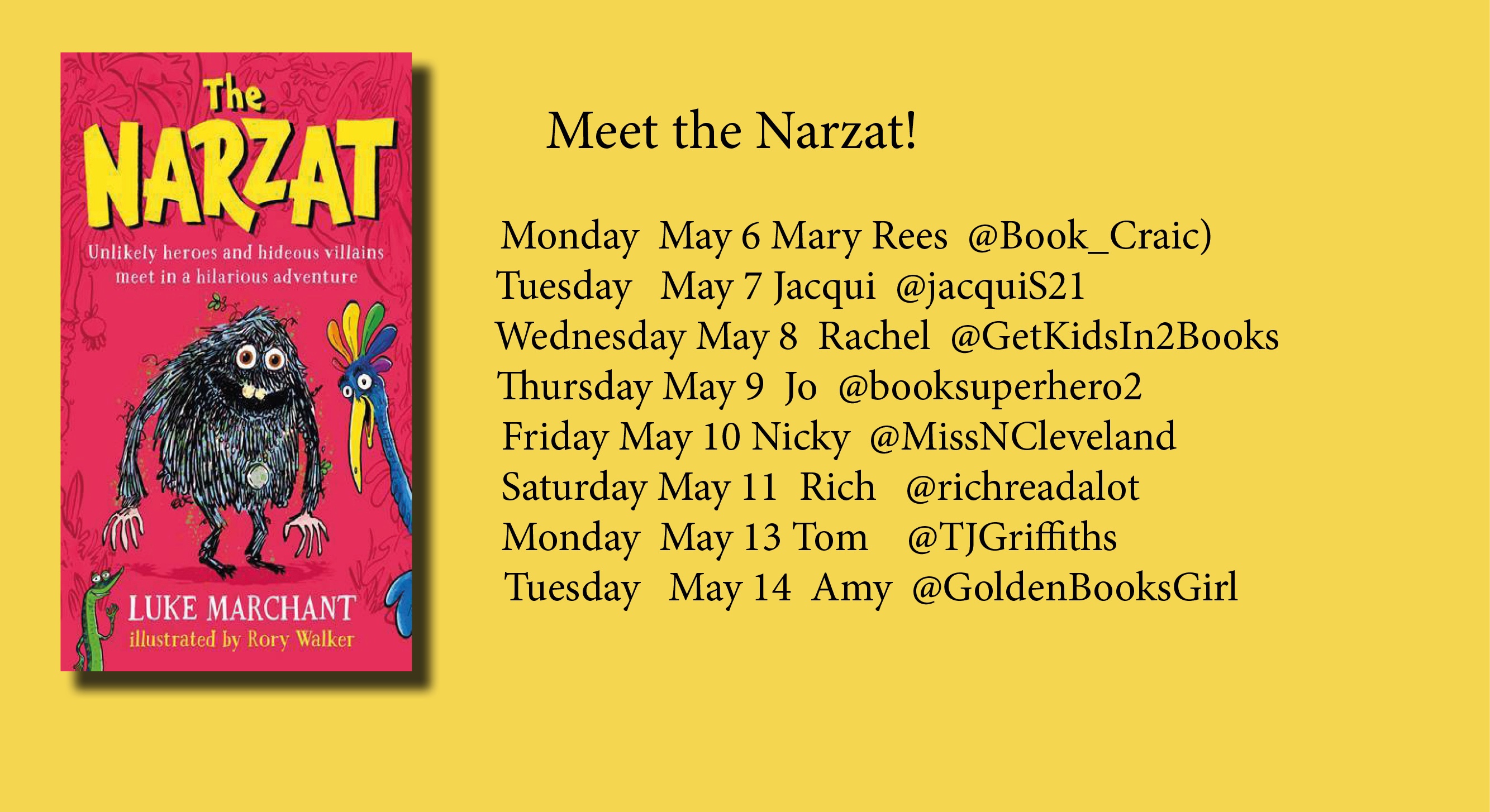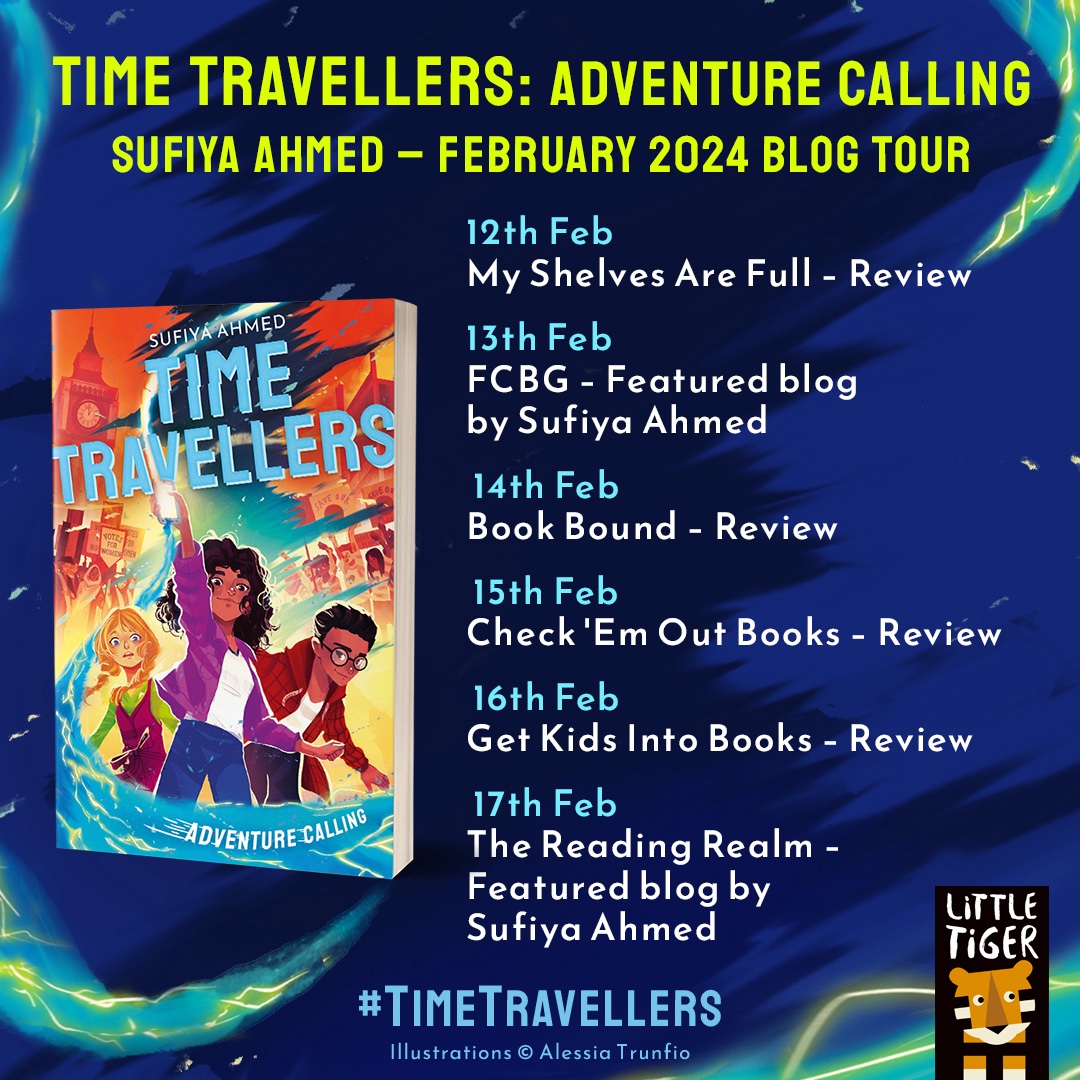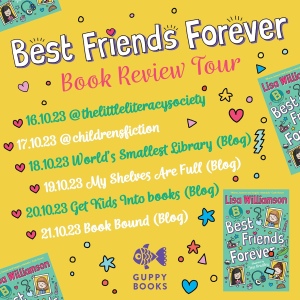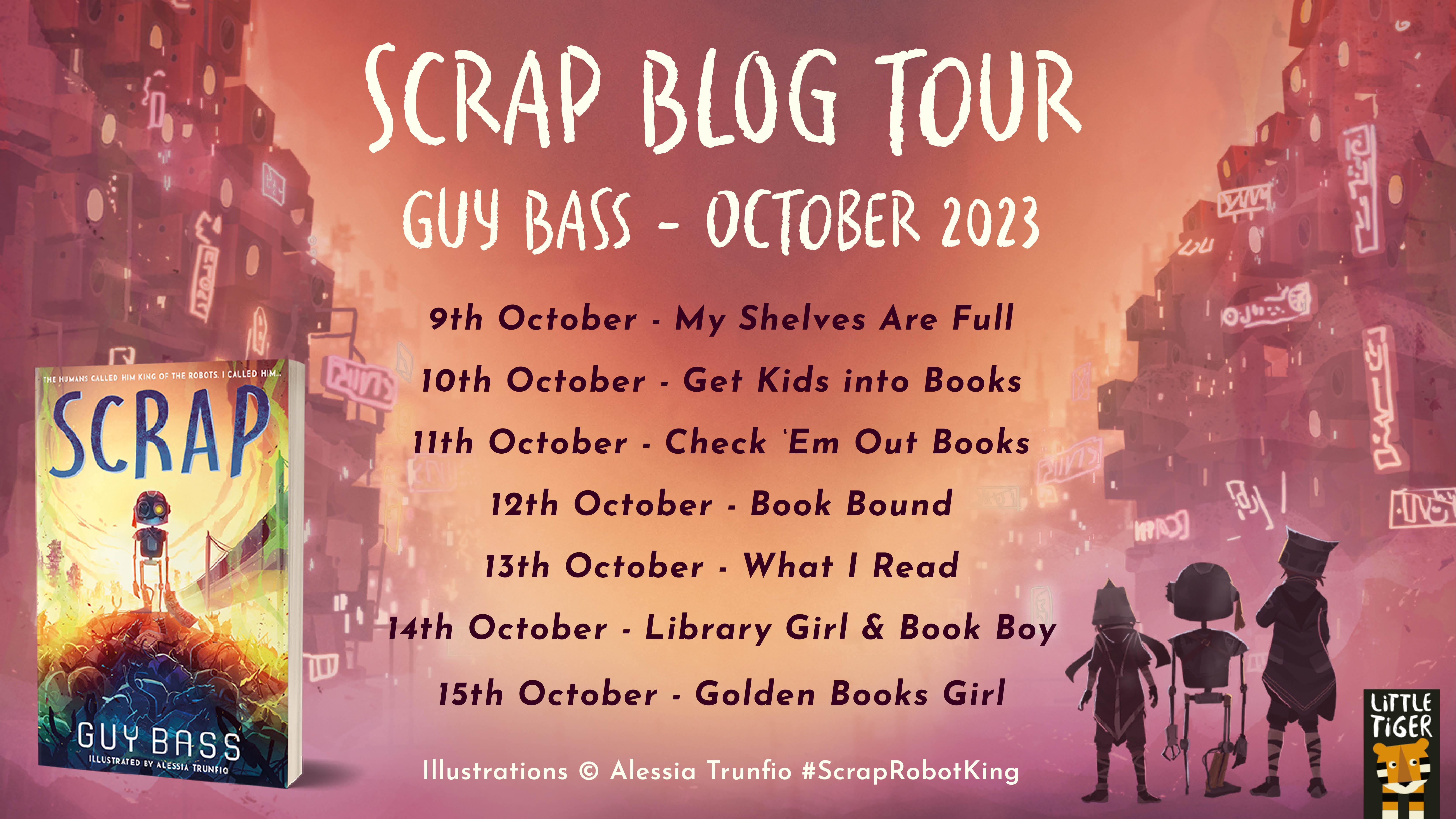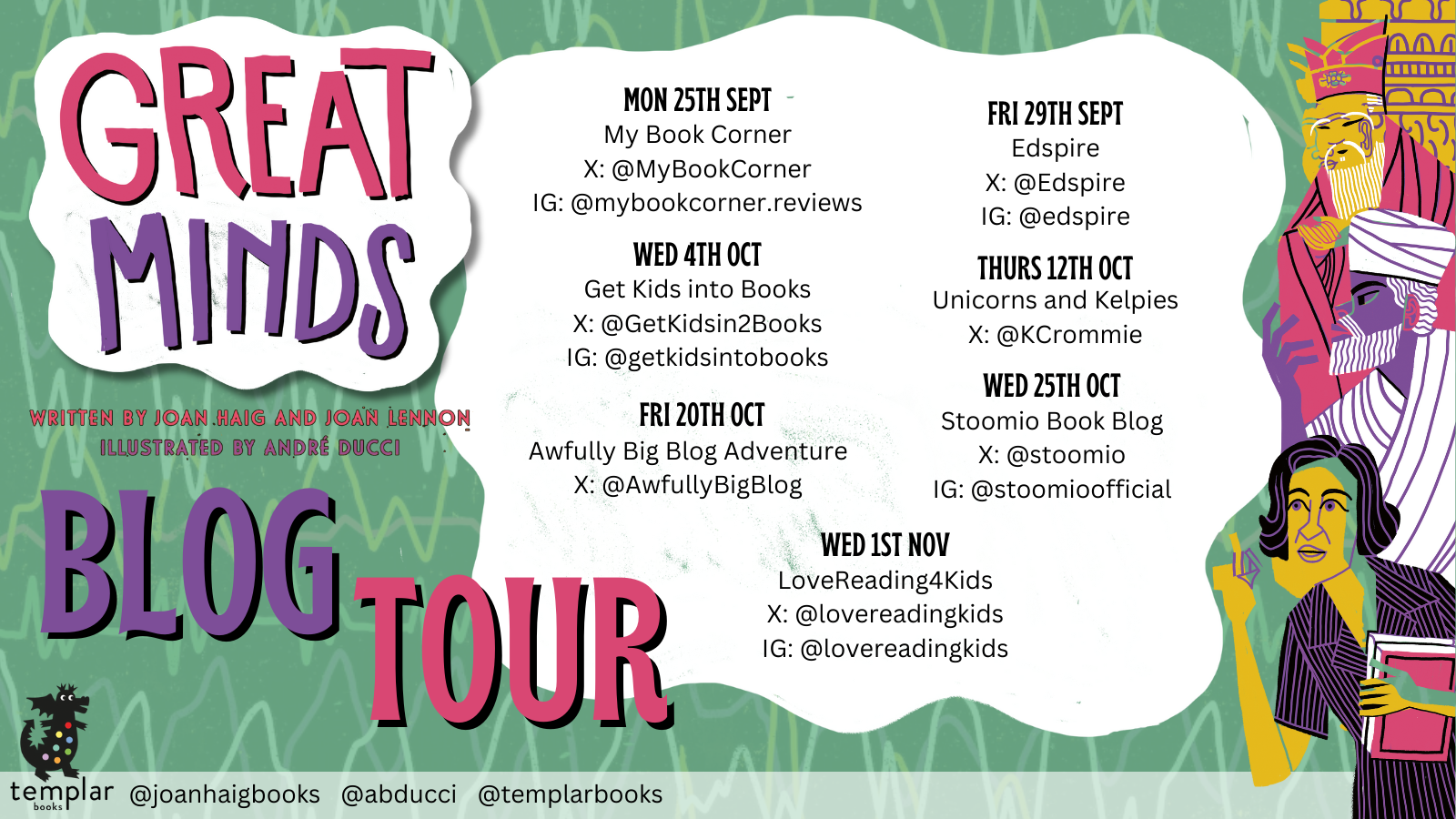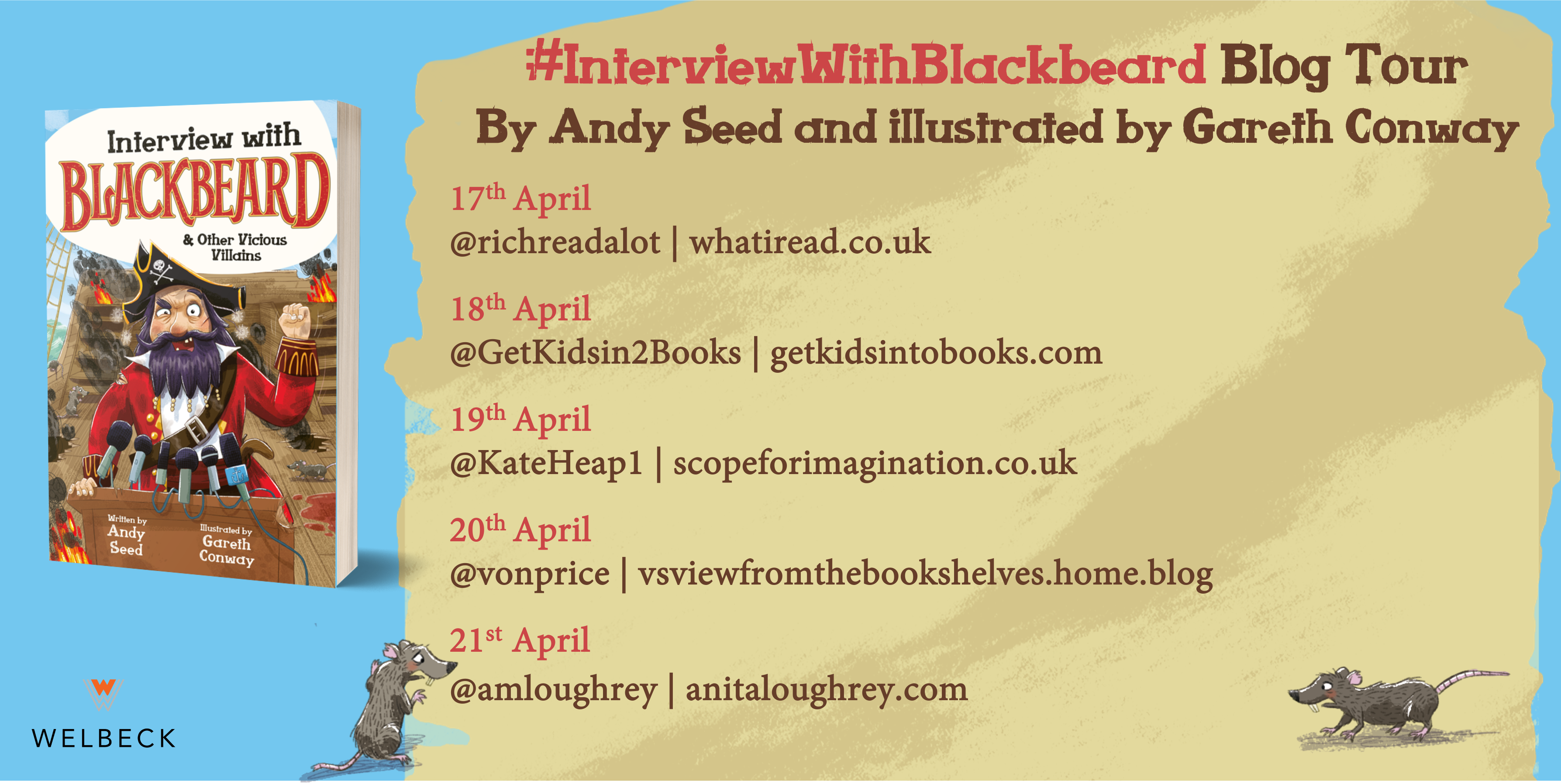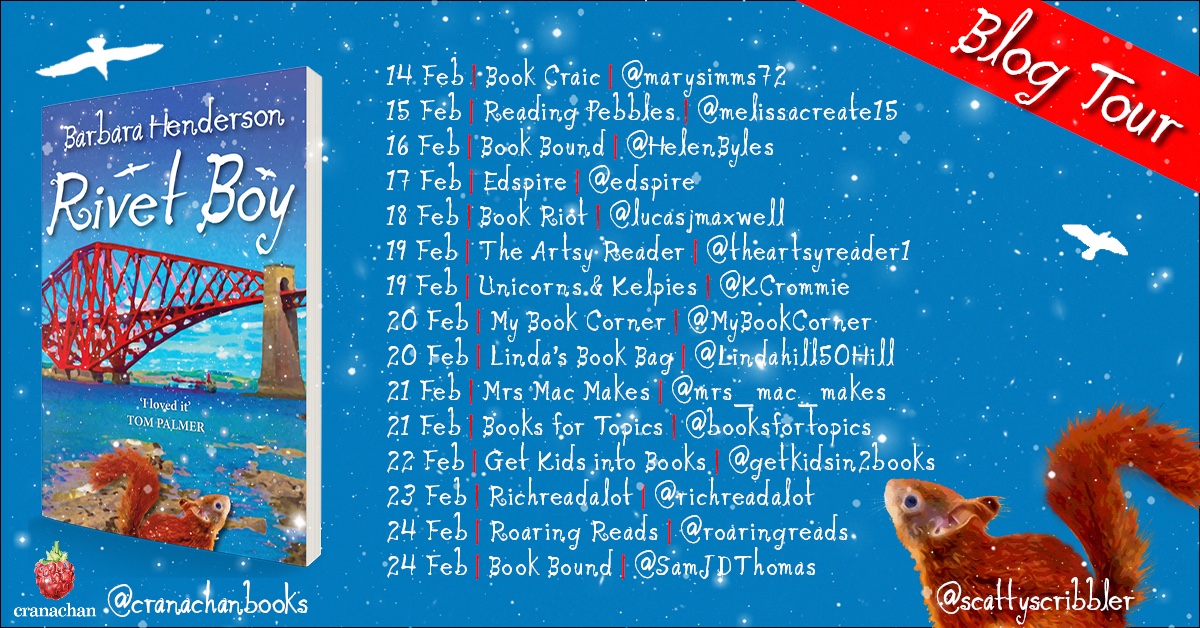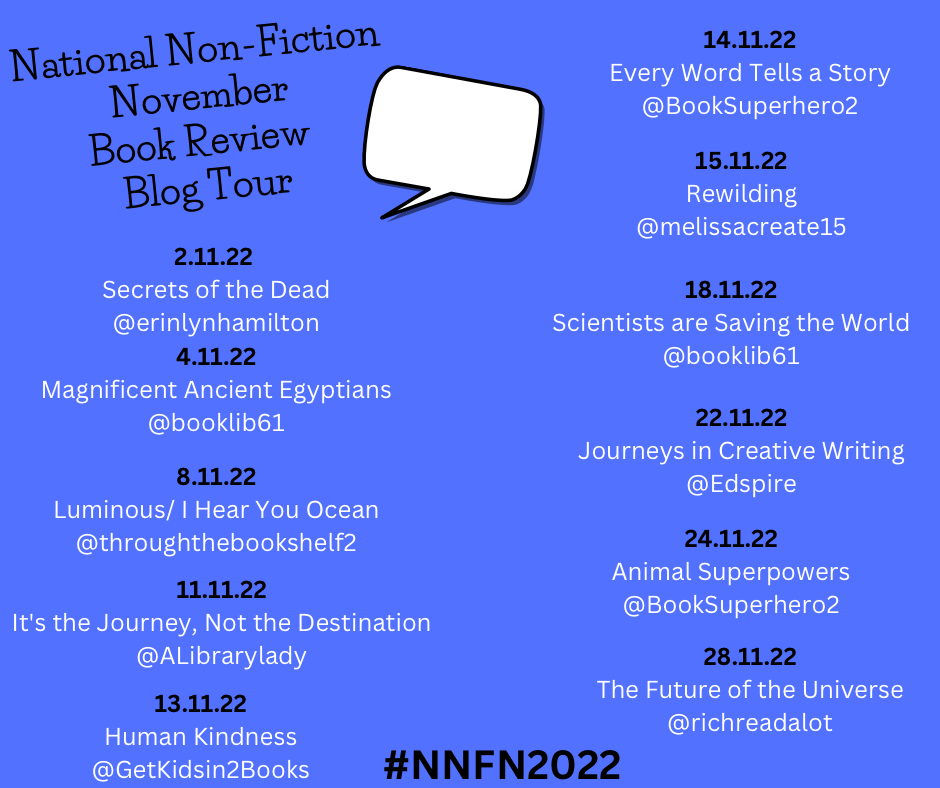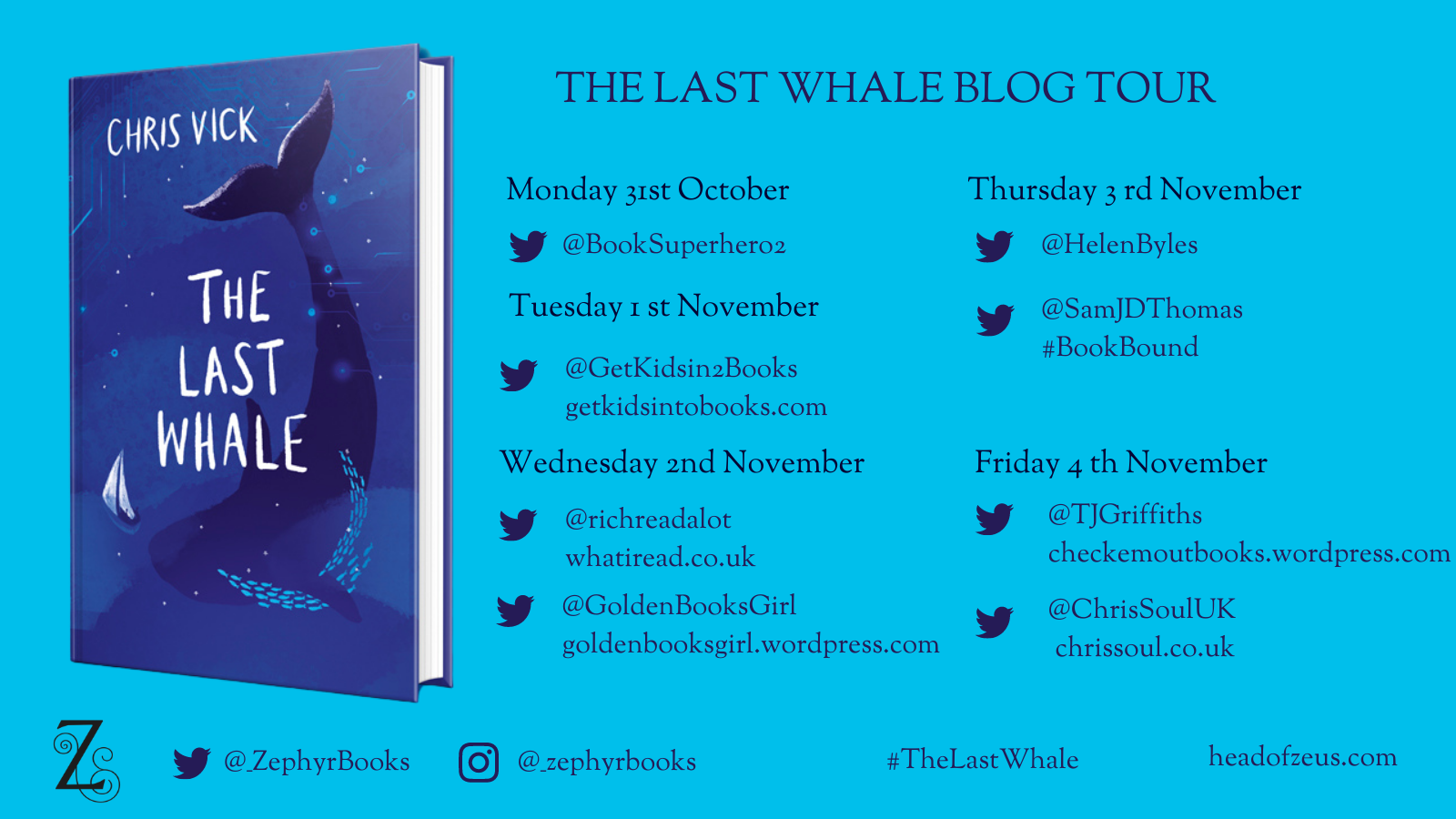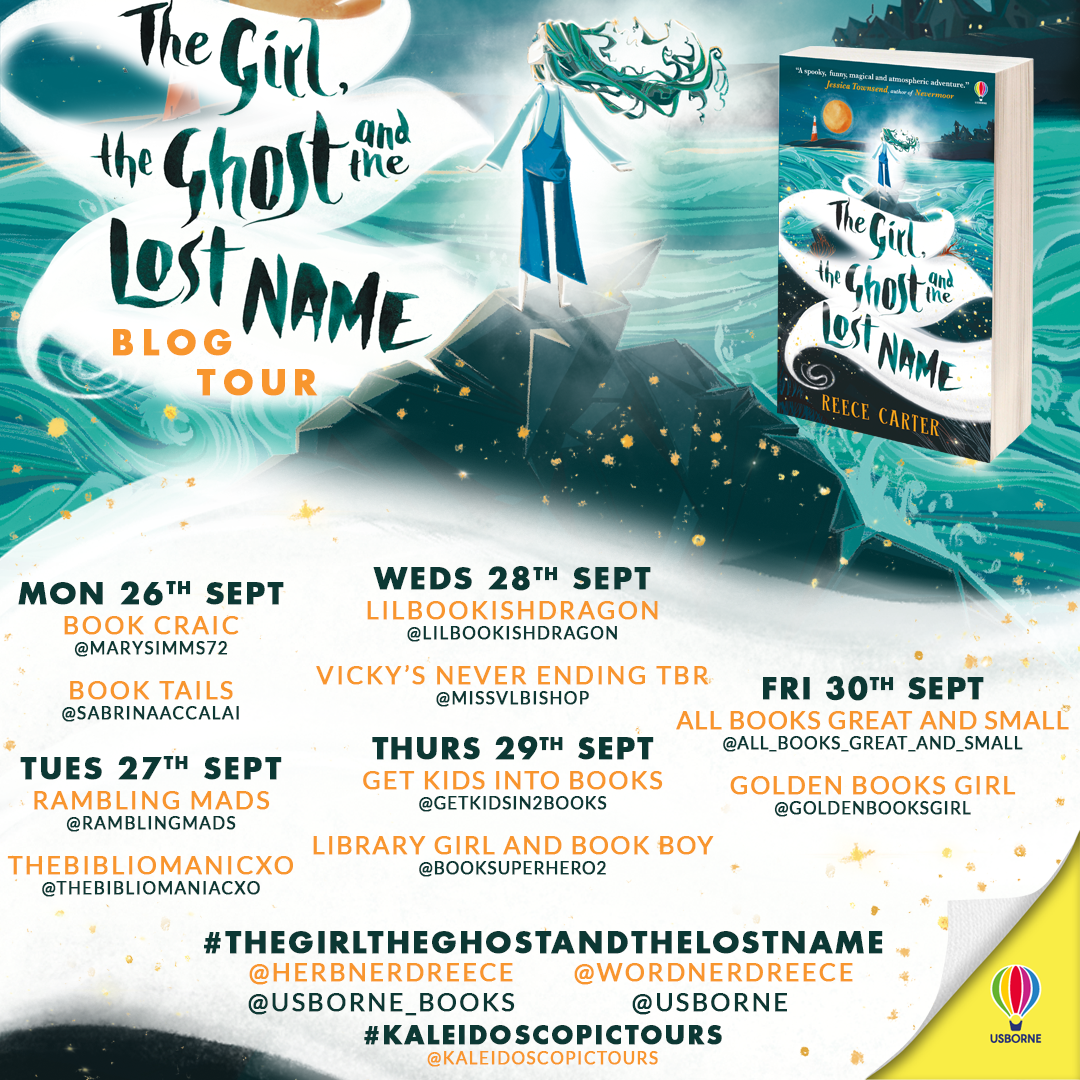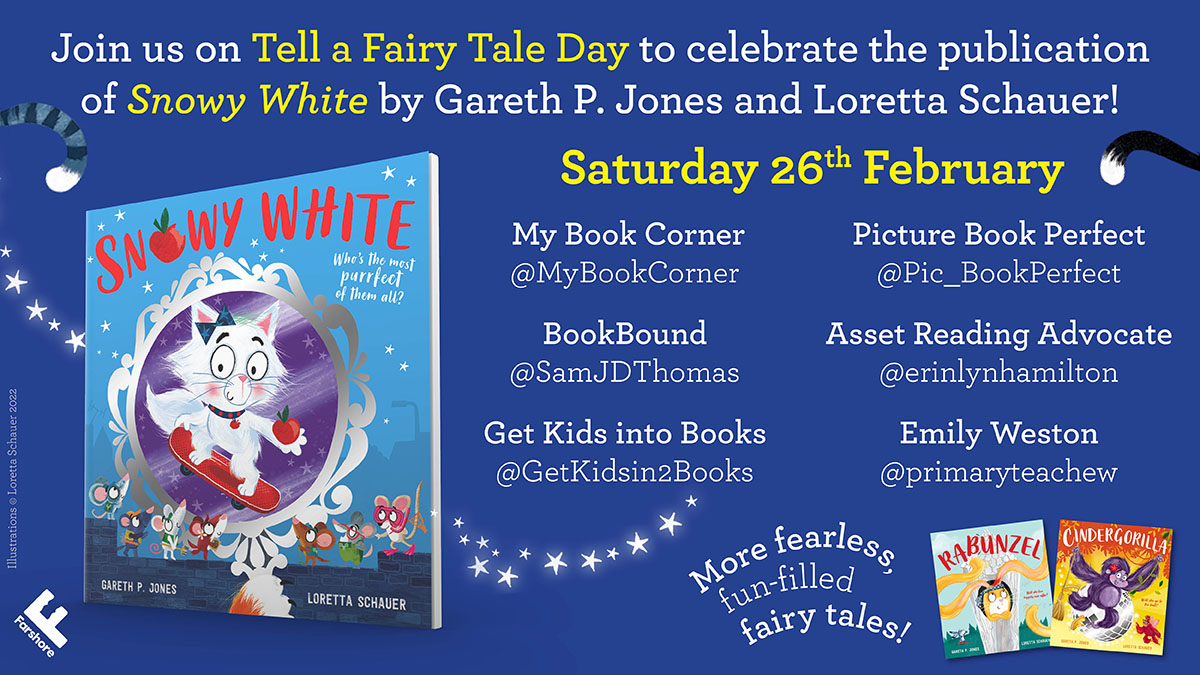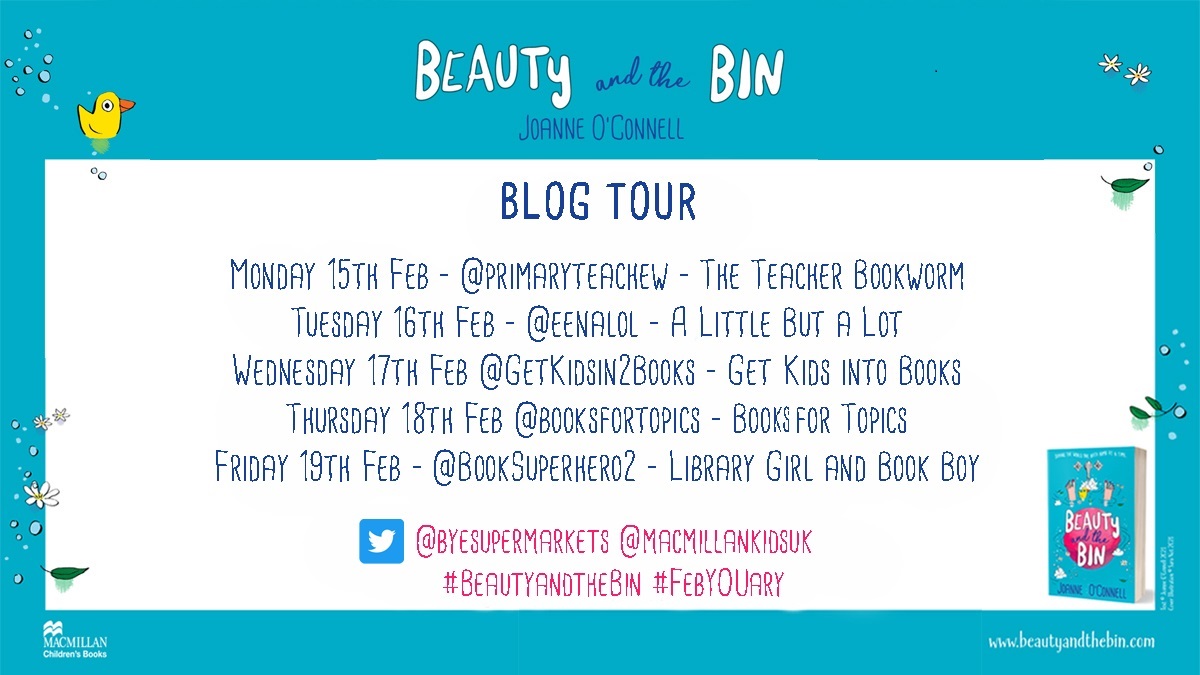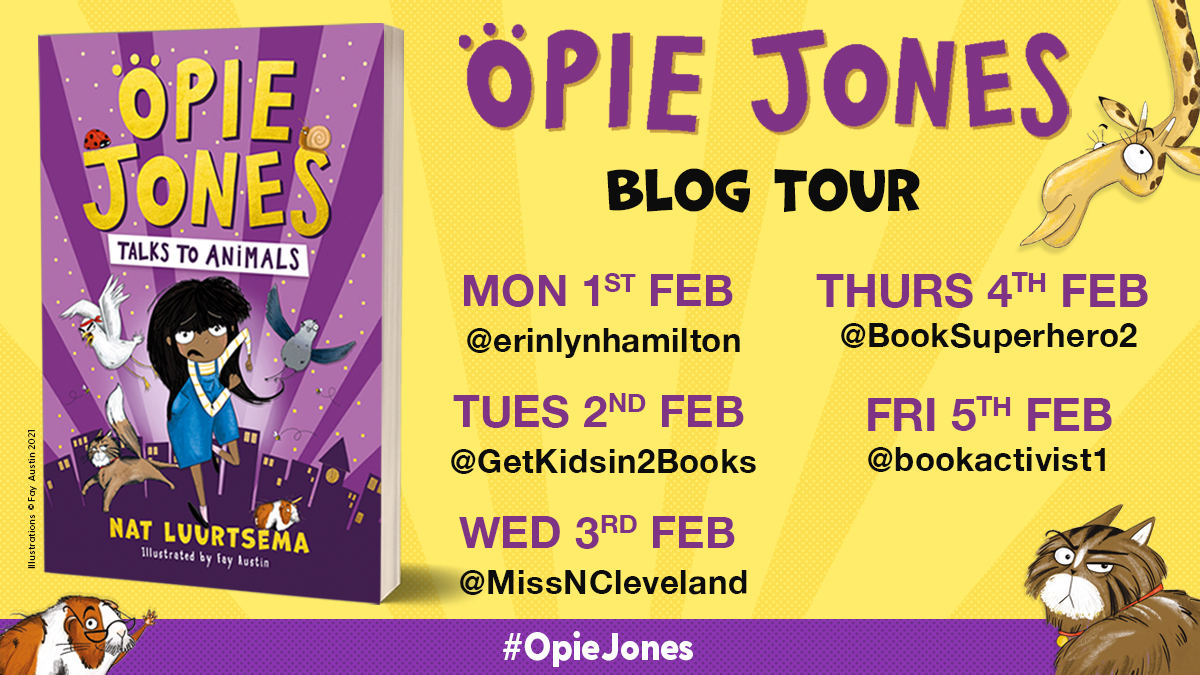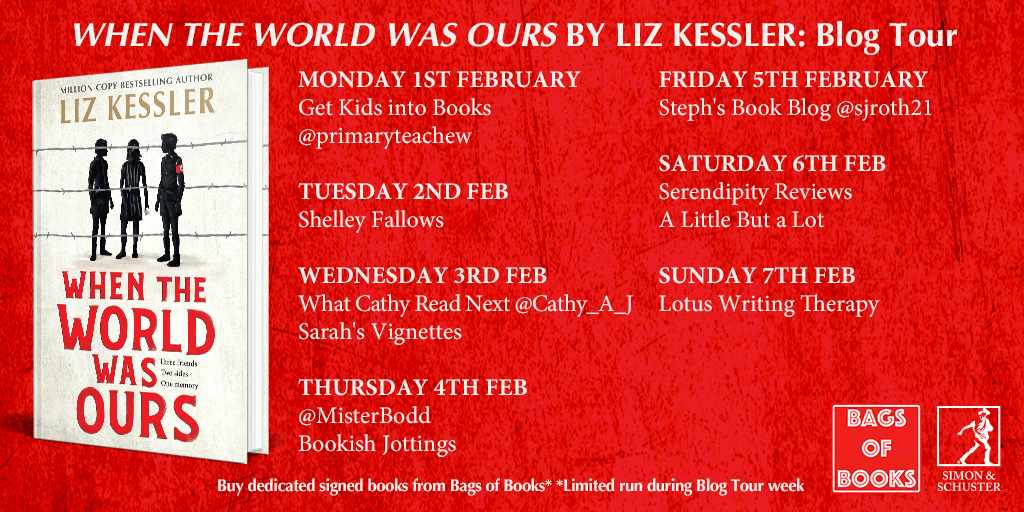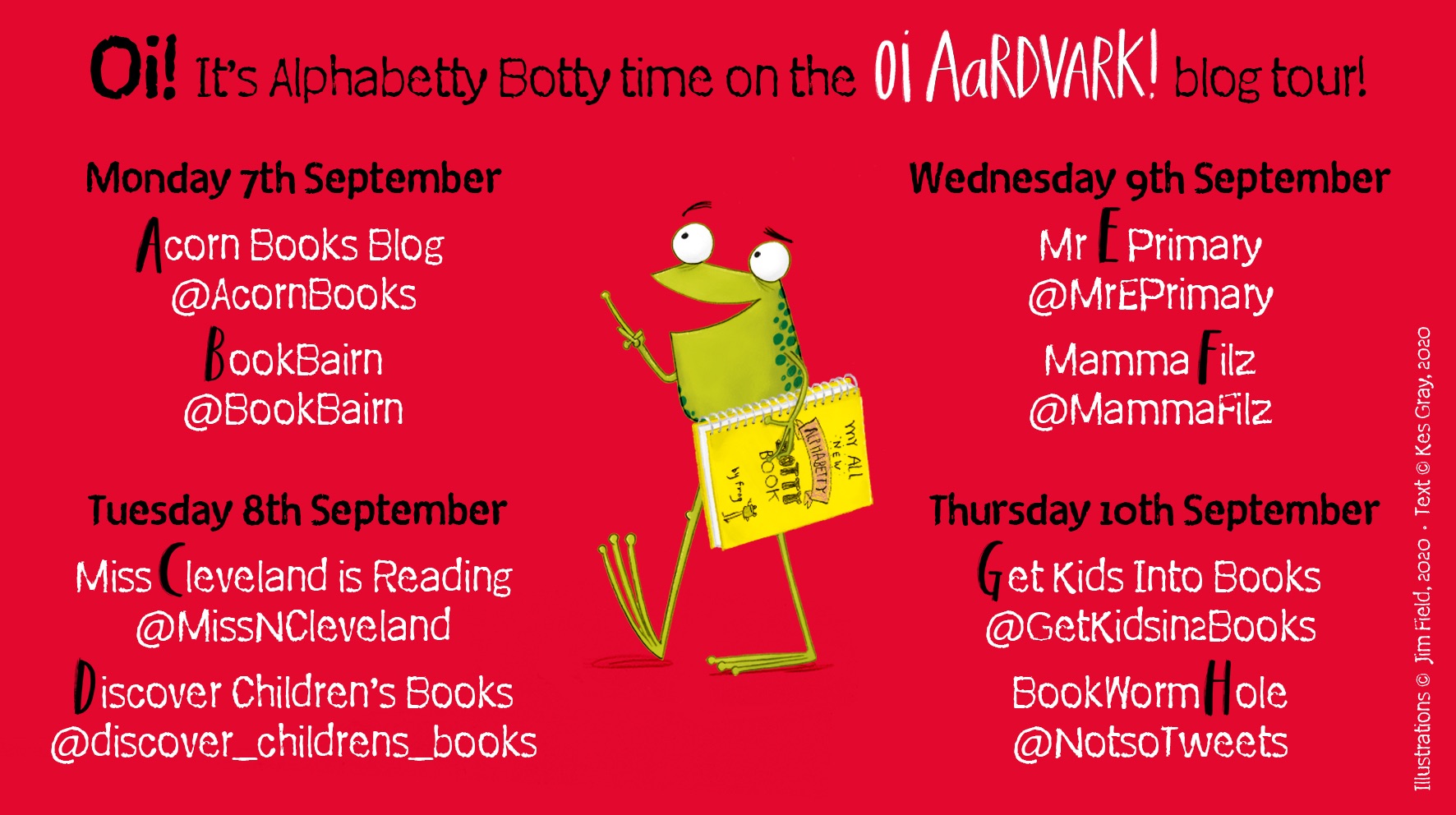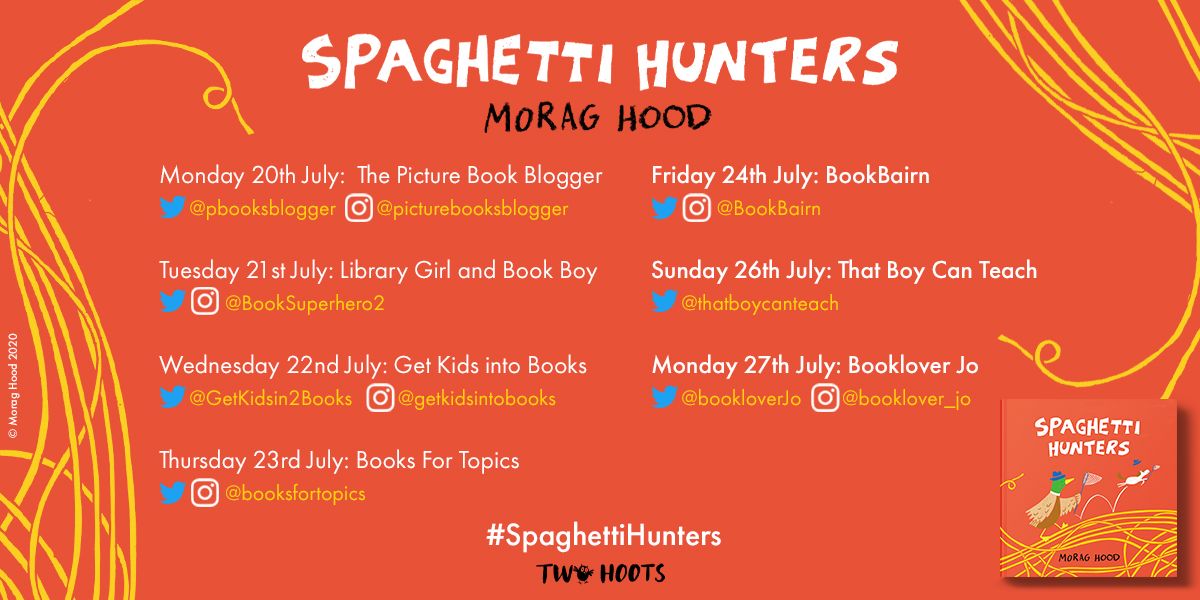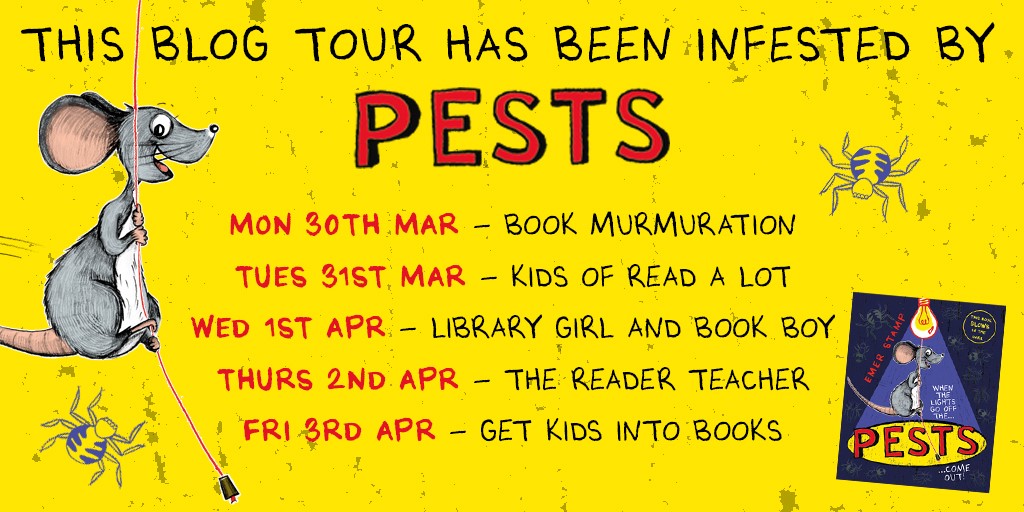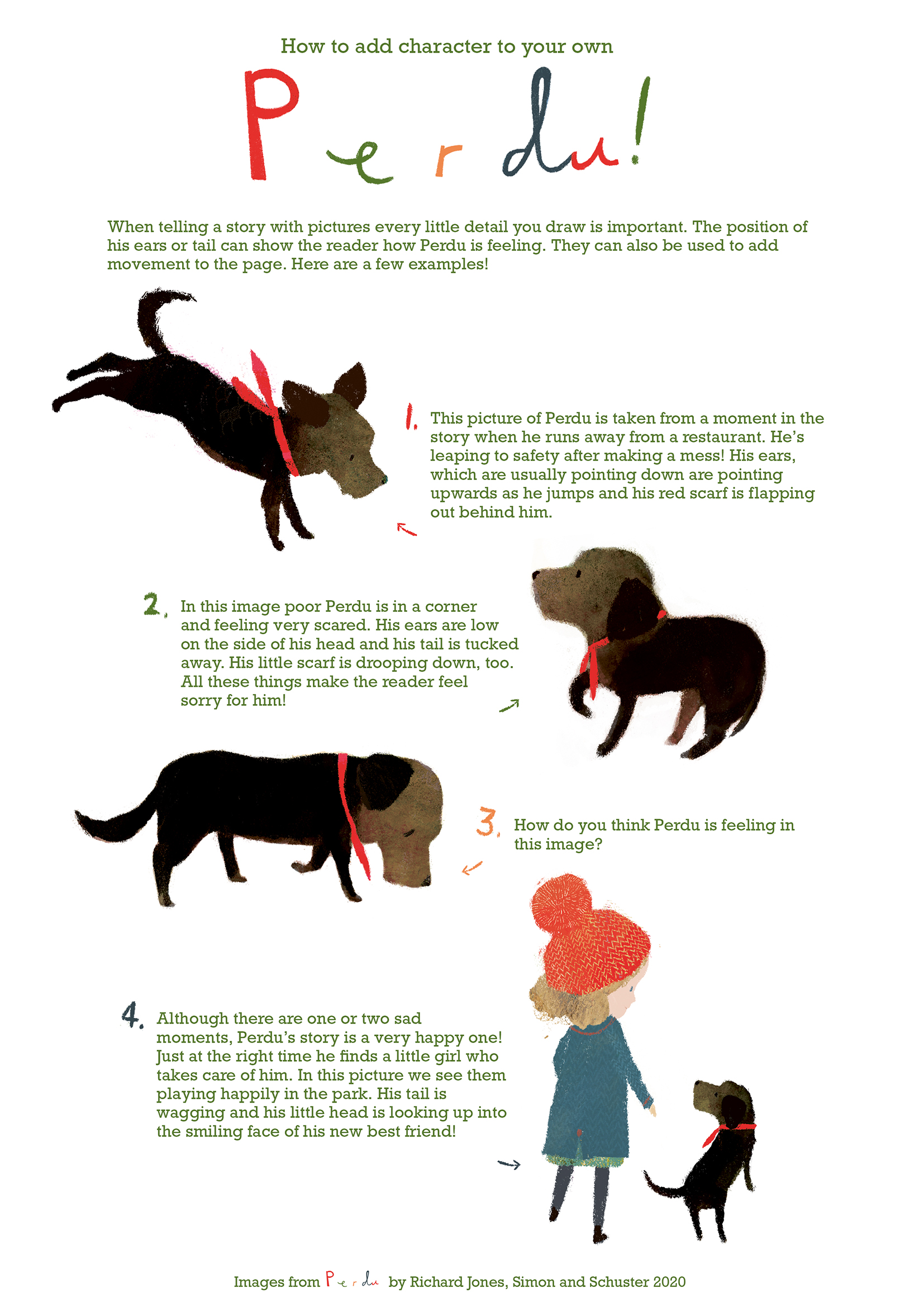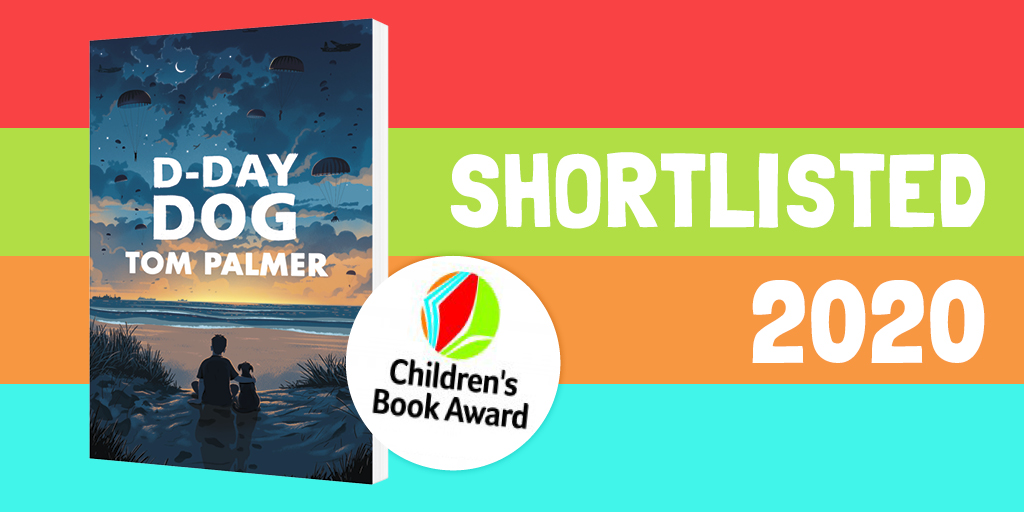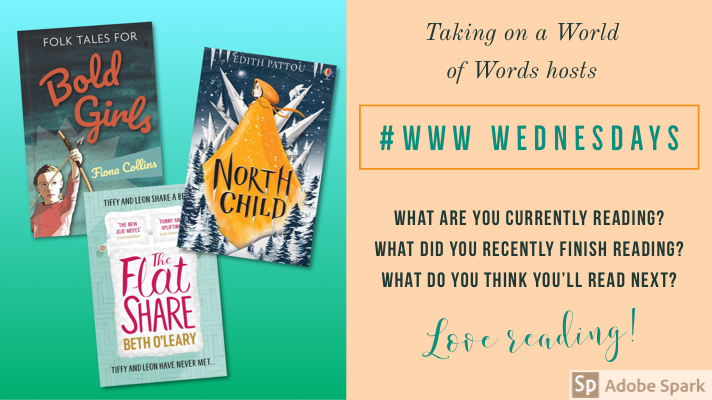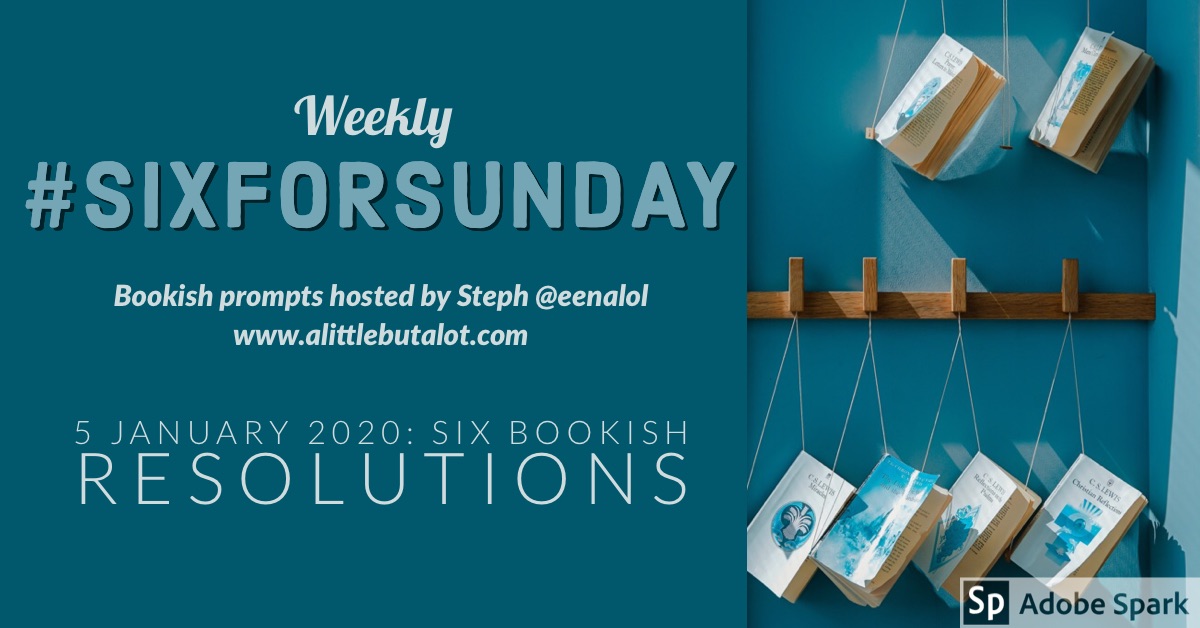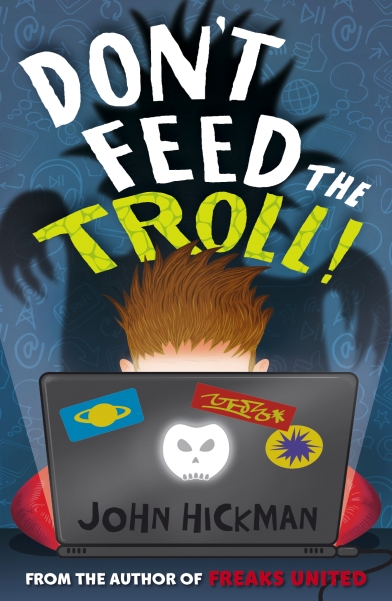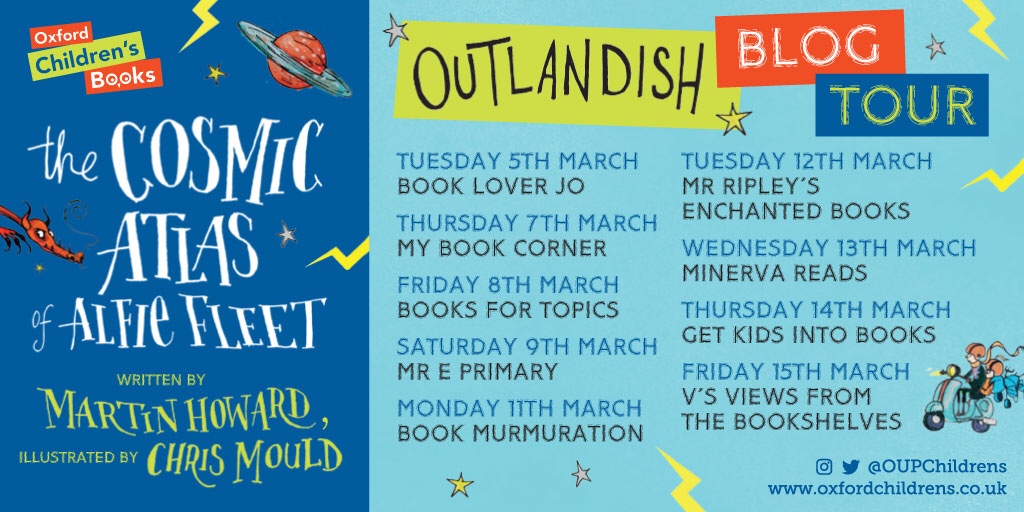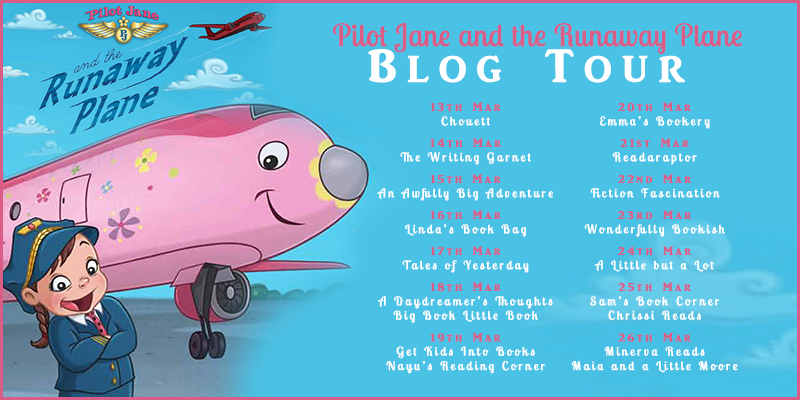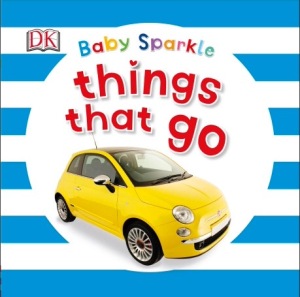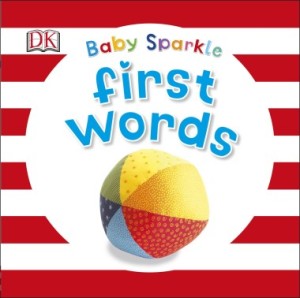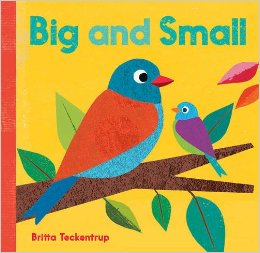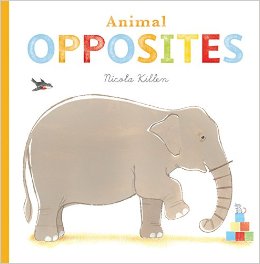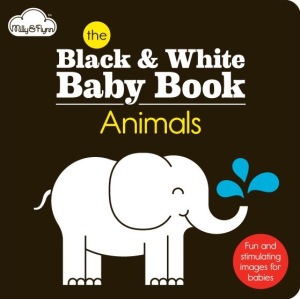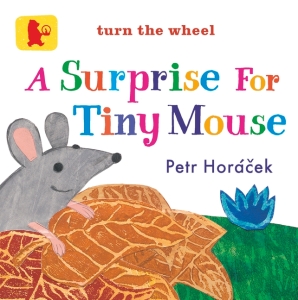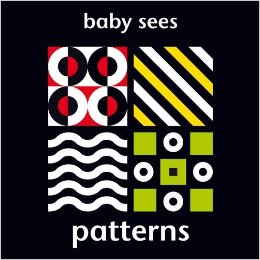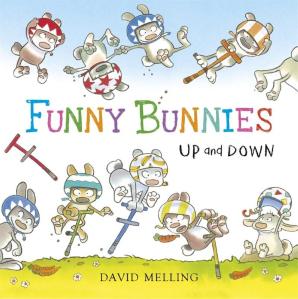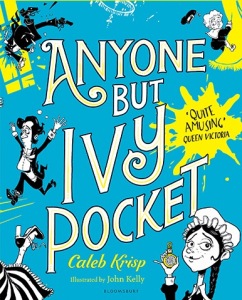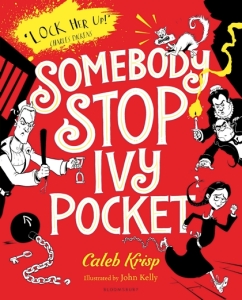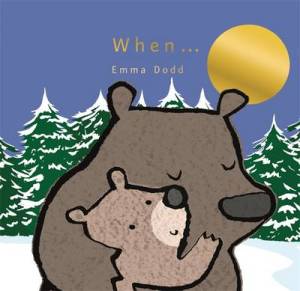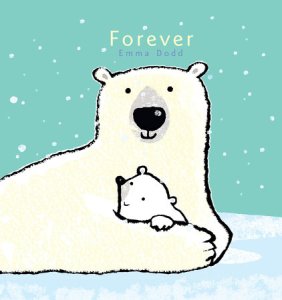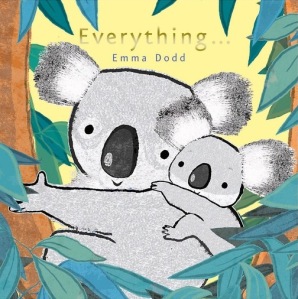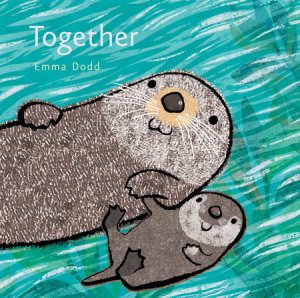The Narzat Blog Tour
8 May 2024
I’m delighted to welcome author Luke Marchant to my blog today. He’s written an exclusive guest post about working on his new chapter book, The Narzat, with illustrator Rory Walker.
Luke: Words cannot express the sheer joy I felt when seeing one of Rory’s illustrations for the first time (although I’m fairly sure Rory could draw my reaction).
He had sent me some early sketches of the characters to see if we were both thinking along similar lines. Straight away, I was met with the picture of Pertinax the gorilla chef—looking suitably surly and grumpy. I remember jumping on the spot with excitement—it was like seeing a photo of a long lost friend! Lord and Lady Snide swiftly followed and, for the first time in their lives, somebody felt pleased to see them! Again, I could not believe how Rory had captured the characters—the angular disdain of Lady Snide’s sneer, or the displeased frown of Pertinax simply brought them to life.
We had a few discussions with our publisher about a couple of very minor tweaks. I remember the Looky Lizard needed slight changes so she had more prominent hands for her sign language, and needing Polly to be a little bit older.
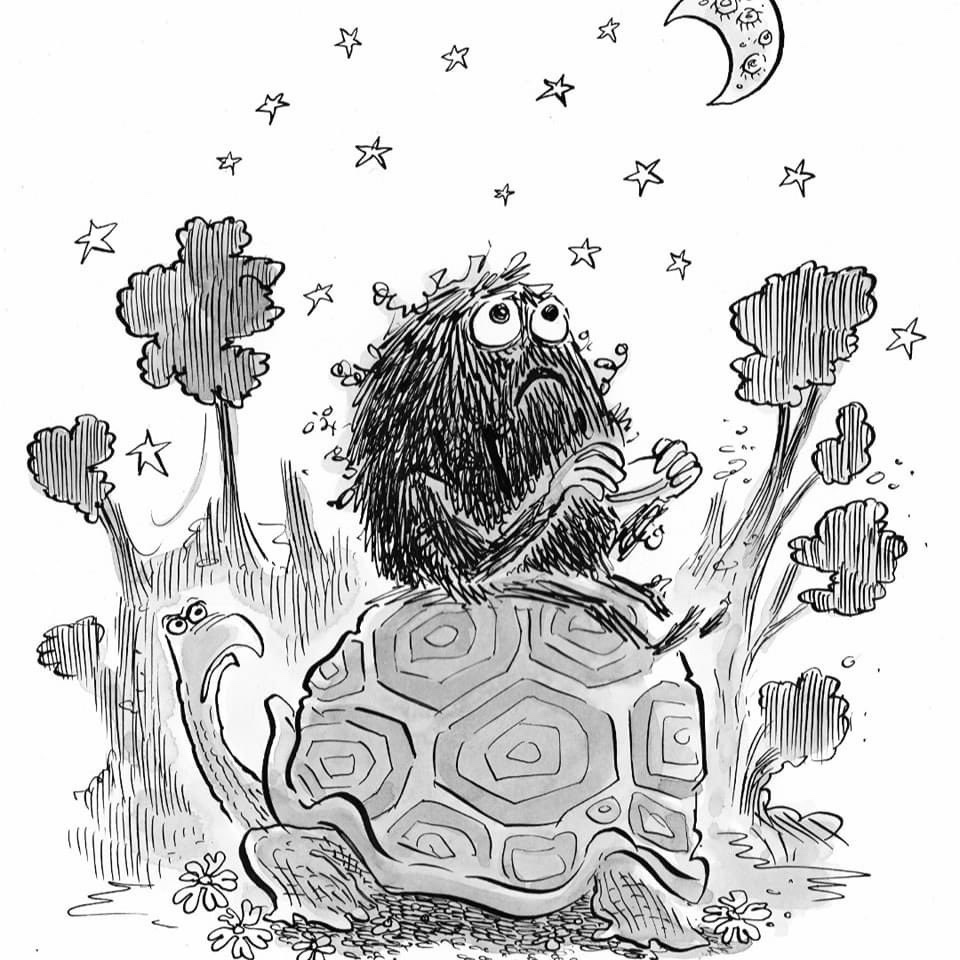 Then, a little bit later, some of the main illustrations came through. The level of detail and movement in them is absolutely astounding but, for me, the feelings that each picture evokes are truly fantastic. I cannot help but laugh at the comedy behind the illustration of a tuneless Chatty Chirper singing to a dismayed audience, or feel concern for the put-upon Polly as she is berated by the cruel Snides.
Then, a little bit later, some of the main illustrations came through. The level of detail and movement in them is absolutely astounding but, for me, the feelings that each picture evokes are truly fantastic. I cannot help but laugh at the comedy behind the illustration of a tuneless Chatty Chirper singing to a dismayed audience, or feel concern for the put-upon Polly as she is berated by the cruel Snides.
One of the most beautiful images for me is the Narzat, lonely and contemplative, staring at the stars… whilst sat on the back of a disgruntled tortoise. It captures Rory Walker’s ability to touch the heart and the funny bone in one image… and it is a sheer joy to see.
You can read my review of The Narzat here.
The Island at the Edge of Night
Blog Tour
3 May 2024

The Tower Ghost Blog Tour
23 April 2024
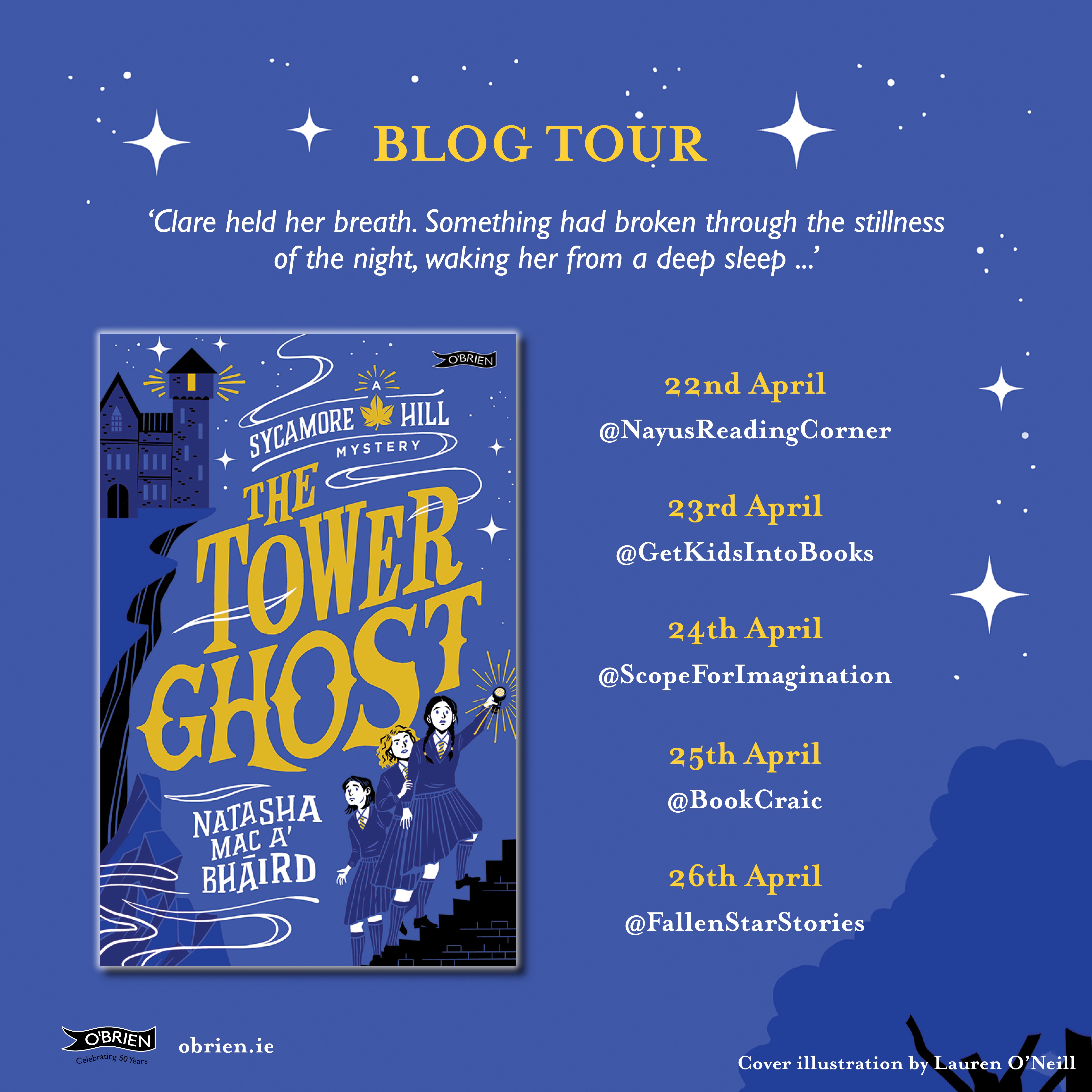
The Royal Jewel Plot Blog Tour
13 April 2024
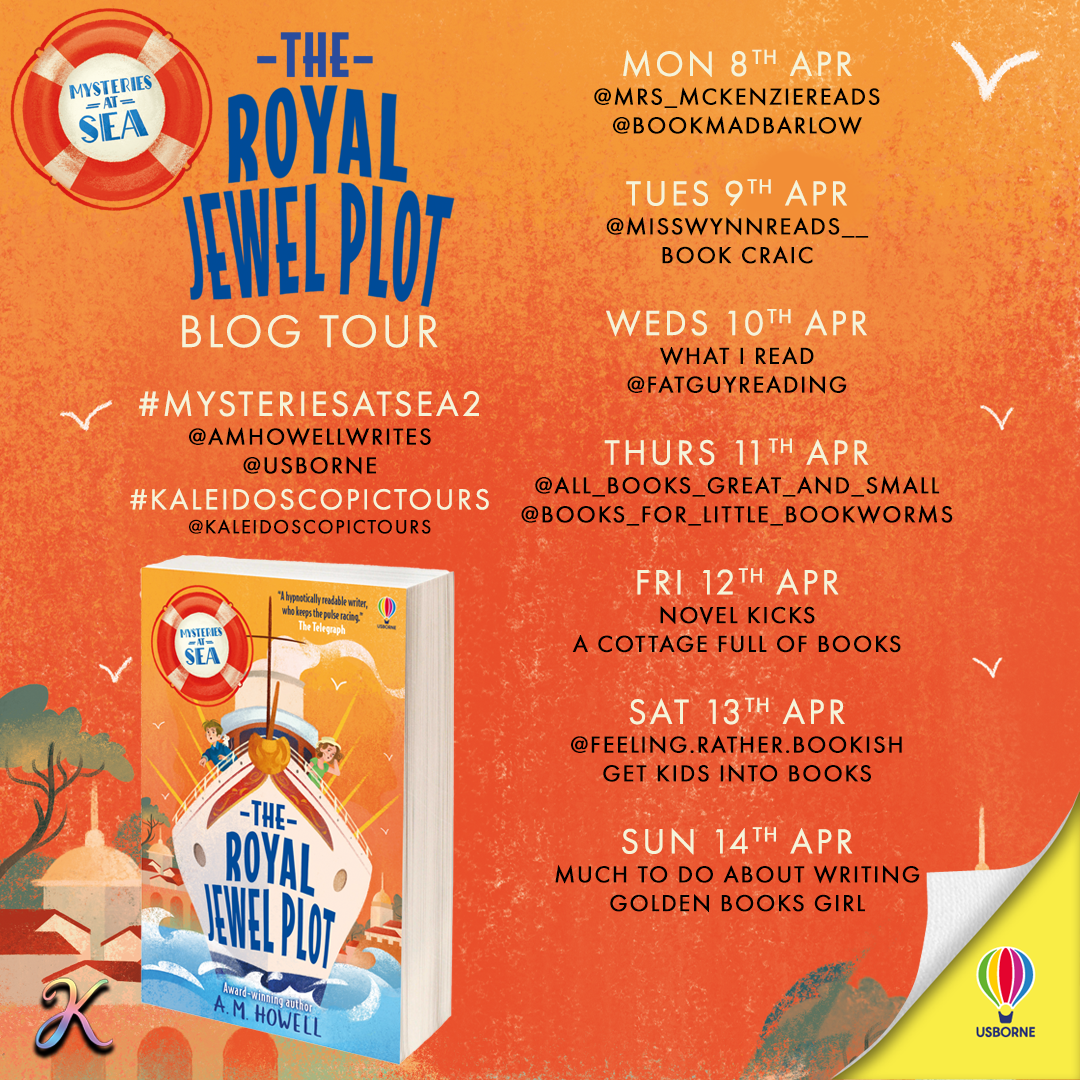
Kevin the Orange Blog Tour
15 March 2024
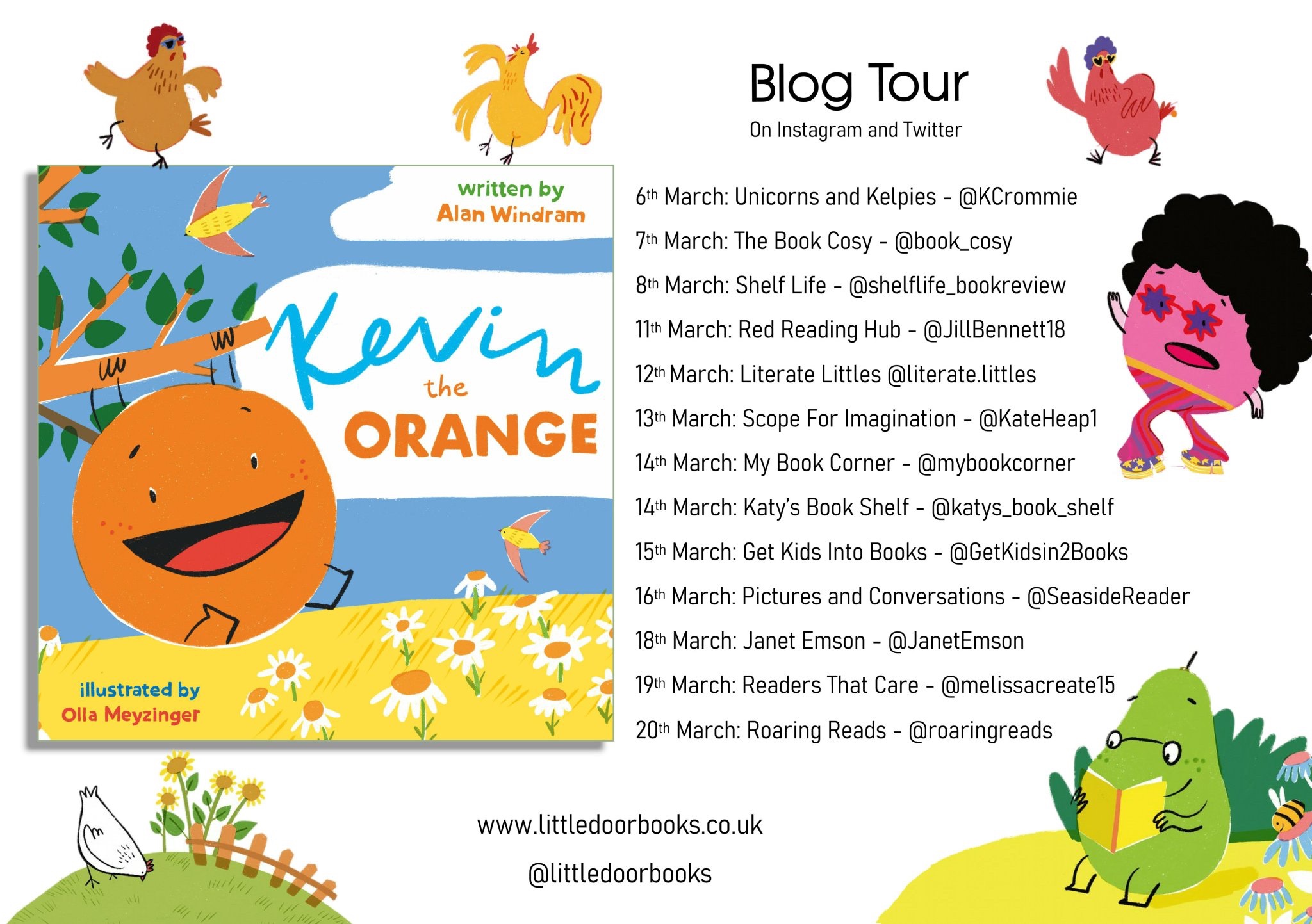
Hercules: The Diary of a (sort of) Hero
Blog Tour
7 March 2024
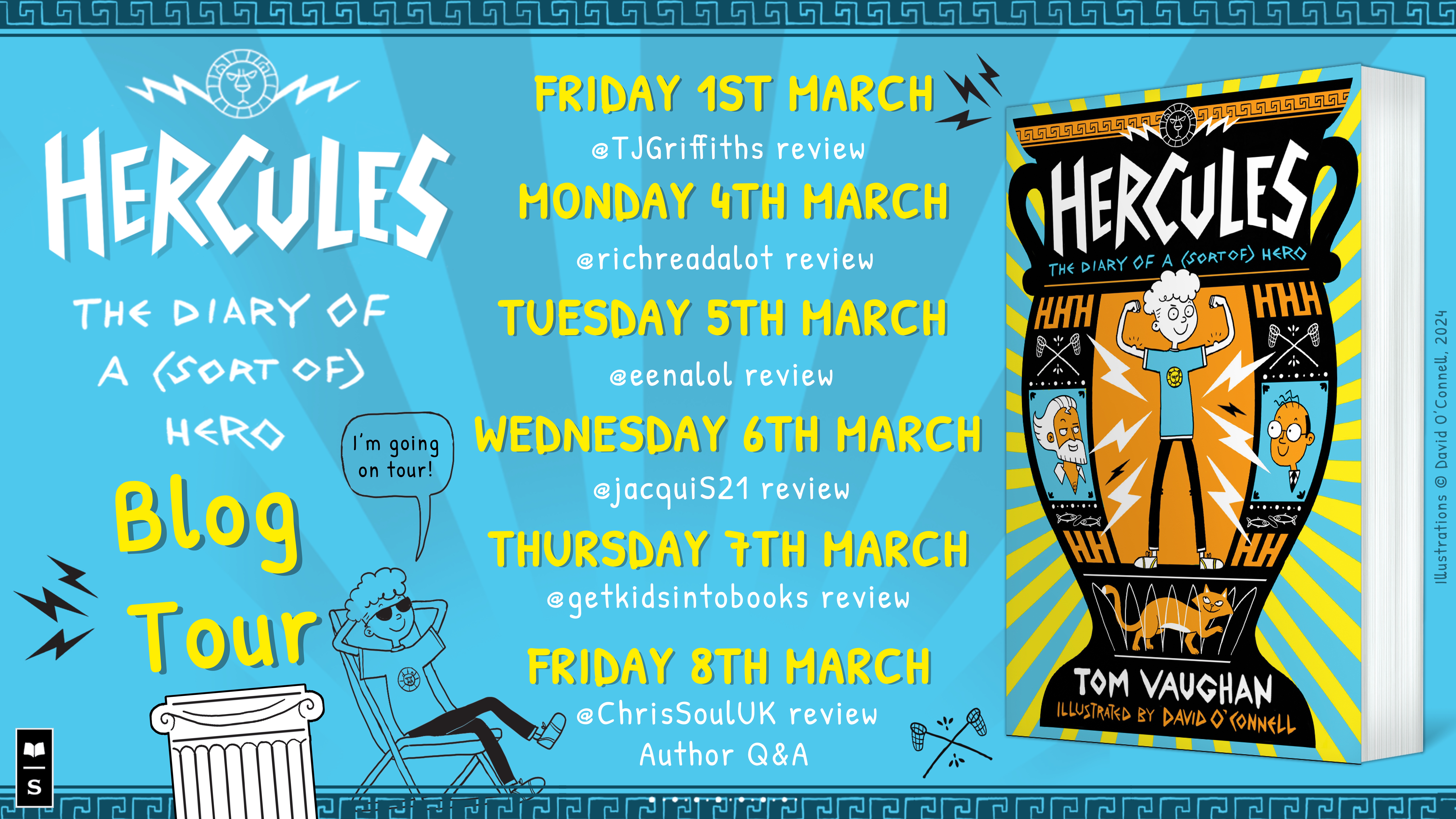
I’m excited to be part of the blog tour for this hilarious yet touching book which draws brilliantly on Greek mythology while challenging toxic masculinity and exploring father/son relationships. Read my full review here.
The Time Travellers: Adventure Calling
Blog Tour
16 February 2024
I’m delighted to share my review of the first book in this exciting new time travel series. Set against a backdrop of women’s suffrage, it has important messages about representation and shared history. Read my review here.
Paper Dragons Blog Tour
9 February 2024

I’m delighted to be part of the blog tour for this incredible debut by Siobhan McDermott. Paper Dragons, The Fight for the Hidden Realm is exactly the kind of book that I love: a fantasy adventure with a standout female lead. I also relished how Paper Dragons is steeped in Chinese folklore and myth – it adds another rich layer to an already deeply satisfying read.
When 12-year-old orphan Zhi Ging is invited to become a Silhouette – an apprentice to the Immortals – she jumps at the chance to pursue her destiny and escape the village where she has always felt like an outcast. With her strange new powers beginning to manifest, Zhi travels to the underwater school at Hok Woh to begin her training. There she meets age-shifting teachers, battles in hair-raising dragon boat races and competes in thrilling trials against her fellow students, all fighting for the chance to become a Cyo B’Ahon. But there are rumours of a growing dark force and the students who fail the trials are mysteriously disappearing… Will Zhi Ging master her new-found powers in order to uncover the truth – before it’s too late?
The world-building in Paper Dragons is really impressive; the underwater world, featuring fierce dragons and talking jellyfish, is highly original and utterly captivating. The story itself is fast-paced and very exciting – full of drama and twists and turns. It’s edge-of-your-seat stuff! I can’t wait for the next instalment.
 I’m really pleased to welcome Siobhan to my blog to talk about the writing process and the journey from first draft to published book.
I’m really pleased to welcome Siobhan to my blog to talk about the writing process and the journey from first draft to published book.
Plot changes in Paper Dragons
Before writing Paper Dragons I used to wonder just how much a story could change between an author’s first draft and the final copy found in bookshops. It turns out, at least for me, the answer is A LOT! Paper Dragons is 43 chapters long but only 3 of them have remained the same from the story I initially scribbled out over several notebooks. In my very first draft, Zhi Ging was forced to spend a lot more time in her village before joining the other children in Hok Woh training to become immortal. Not only was Iridill the Lead Glassmith’s daughter, but in that early version she was also part of a rather nasty group of village children determined to get Zhi Ging into trouble. To be allowed on the jade mountain, Zhi Ging had to take part in a series of secret dares, even though these had been banned by the Lead Glassmith years earlier. The story originally began with Zhi Ging dared by the others to create sand caricatures of all the senior Glassmiths right outside their workshop. These caricatures were to be sketched just before dawn, with bonus points for how long Zhi Ging waited before wiping the sand clean – the bravest option being to wait until the Glassmiths had already stepped into the workshop courtyard. Unfortunately for Zhi Ging, Iridill deliberately handed her a pouch filled with heat sensitive sand. This meant that once the dawn light hit the sand caricatures they solidified to glass, leaving no chance at all for Zhi Ging to erase any of the sketches as the Glassmiths began to arrive for work. Although Paper Dragons still begins with Zhi Ging getting in trouble, I much prefer that it’s now because she’s been brave and taken a risk, rather than being tricked by Iridill!
Get Kids into Books: Thanks for this fascinating insight, Siobhan.
Paper Dragons publishes on 15 February 2024.
Peng and Spanners Blog Tour
8 February 2024
Get ready to meet the latest superhero duo – Pengtastic and Spanners. An unlikely pairing, sure, but one which young readers are going to love. This new graphic novel series is going to be in high demand in my classroom (and with kids up and down the country). Click here to read my full review.
Diamond Jack Blog Tour
26 January 2024

I’m delighted to be part of the blog tour for this thrilling adventure of highwaymen, heists and hidden identities. Click here to read my review.
Snail in Space, Q & A with author Rachel Bright
18 January 2024
 Today is publication day for the fabulous Snail in Space and I’m delighted to welcome its author Rachel Bright to my blog to answer a few questions about the book.
Today is publication day for the fabulous Snail in Space and I’m delighted to welcome its author Rachel Bright to my blog to answer a few questions about the book.
Get Kids into Books: A snail is an unusual protagonist for a children’s book. Were any other underrepresented/underdog characters in the running?
Haha. I suppose it is! Though of course all protagonists who blaze a trail in a story – our great heroes – whatever their outer fur or shell, contain a kernel of our inner selves as humans – whether we are 2 or 102! Gail is a snailish representation of the grit and determination, passion and purpose, pluck and ability to persist, which lives inside us all. For this book in particular – which was inspired by Gail’s character (so brilliantly imagined by Nadia) in Slug in Love there could have been no other lead. As soon as I fully met Gail in all her illustrated glory in the first book Nadia and I created together – I knew I had to know her story – to imagine it and then to tell it! Snail in Space is the tale of how Gail got her grit. How she came to be who she is – someone who knows herself so well. A girl who knows what she wants and isn’t afraid to go after it! (or even when she is afraid – she finds resources to help her keep going).
Get Kids into Books: So, I’m correct in thinking this is the same Gail that featured in Slug in Love? Are we getting her backstory? Is Snail in Space the story of Gail in her youth?
You got it! I kind of gave the game away in my answer to your first question – but Snail in Space is a kind of prequel to Slug in Love. It tells the story of how younger Gail got her ‘Gailness’ and earned her (extremely stylish) spots.
Get Kids into Books: The book has very strong themes of resilience, perseverance and self-belief. Why was it important for you to share these messages in a picture book?
What lights me up as a writer is to take big ideas – universal ideas that connect us all – and find ways of telling the story of those big ideas in the small, hopefully perfectly formed package of a picture book – which is such a unique reading experience – shared between small person and grown-up, often out loud. Self-belief is something oft talked about but not easily nurtured. I would love for my kids – and all kids – to reach deep inside to find their unlimited strength. To feel confident in pursuing whatever really lights them up – even when the going gets tough. Every time I look back on life, it’s always when I’ve pushed over a difficult bit and found resources I didn’t even know I had, that something wonderful and huge and magical lay the other side – the gift of knowing you can . And even if you can’t – you tried your very best! And when you do that you are always winning
 Get Kids into Books: How does your writing/illustrating partnership work? And who thought of all the puns?
Get Kids into Books: How does your writing/illustrating partnership work? And who thought of all the puns?
It often surprises people to hear that we’re rarely (if ever) in the same room or on the same zoom call during the whole process! But we do get to ping things back and forth via the wonderful team at S&S who craft and create with the words I write and the pictures Nadia makes to form a beautifully paced, polished and perfected picture book at the end. People are also surprised that it often takes between 6 months to a year to finish one book too! But when we start out to create a picture book (shooting for the moon!) we never do it by half measures – we want every single word and brushstroke to earn its place on the page – so that the end result truly earns it’s place in the hands of the grown-ups and children who spend their precious time reading them It’s a beautiful process and a symphony not a solo (or a duet!). Many creative hands make great work.
Get Kids into Books: Can we expect more from Gail in the future?
I think we can always expect more from Gail! I guess we have to watch this space.
You can read my review of Snail in Space here.
Start Small, Think Big Series Blog Tour
22 November 2023
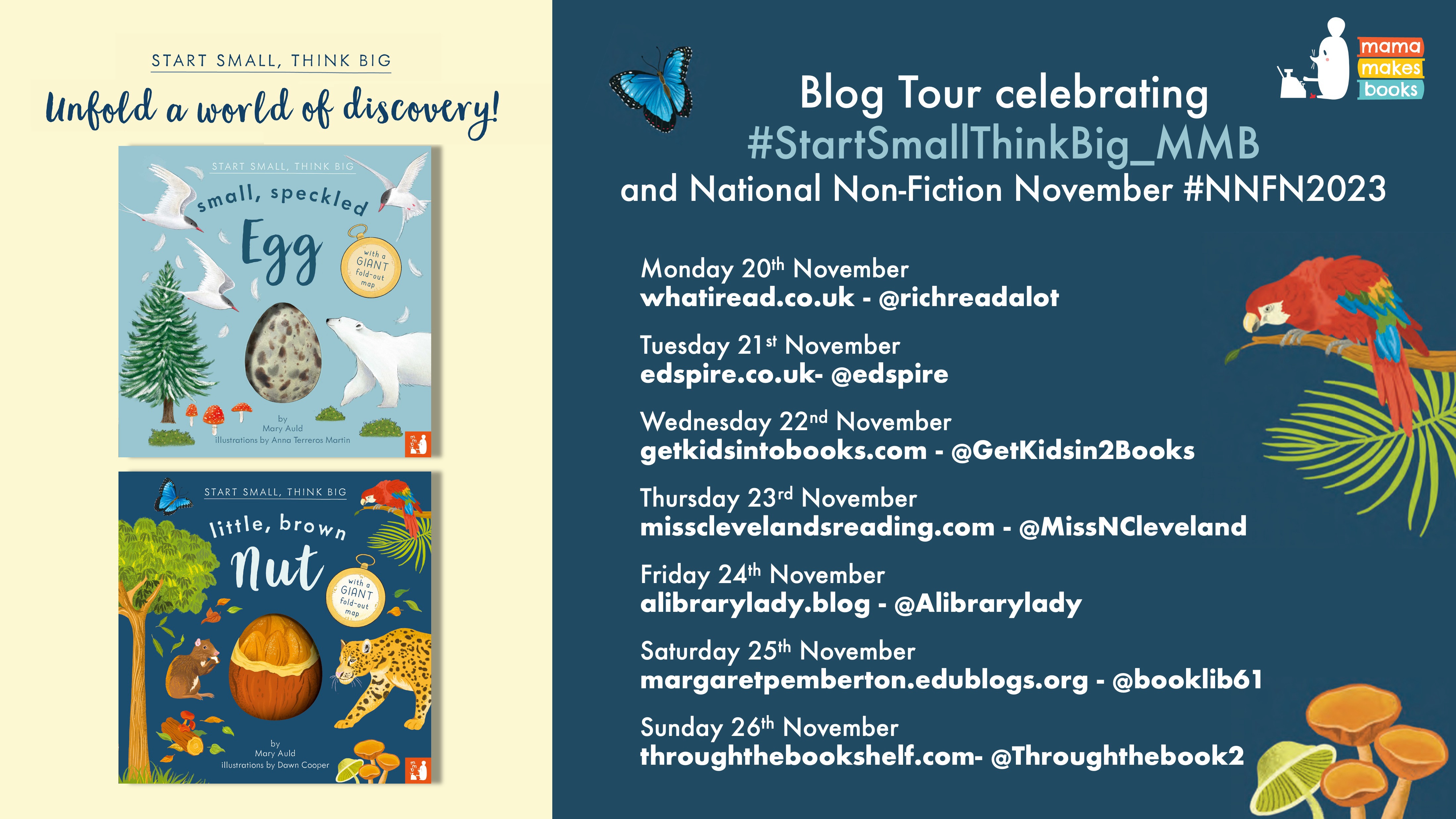
As part of National Non-Fiction November, I’m delighted to share my reviews of the first two titles in this fantastic non-fiction series aimed at 4-8 year olds. It’s a fascinating and extremely informative series with a wealth of factual detail in each book, fantastic illustrations, and giant fold-out pages. I love the concept of the books – starting on a very small scale and then widening the focus little by little until we get a global perspective.
Best Friends Forever Blog Tour
20 October 2023
For my stop on the blog tour, I’m thrilled to be able to share this guest post from author Lisa Williamson about the inspiration behind her new Bigg School series. You can read my review of the first book in the series, Best Friends Forever, here.
Lisa: I went to school so long ago that, when I started secondary school, there was no Year 7! We were known simply as ‘First Year’. However, despite the 30-plus year gap, the challenges that I faced as a nervous eleven year-old were (I’m guessing) very similar to the ones children up and down the country face every September. To put it lightly, I found year 7 a lot! My personal experiences were a big part of the reason I decided to write a series all about that exciting, nerve-wracking, confusing, emotional rollercoaster that is your first year in secondary school.
The Bigg School series takes place at the fictional Henry Bigg Academy, with each book in the series exploring the experience of a different child in year 7. The first title – Best Friends Forever – focuses on Lola and her first half term at the school. In many ways I was pretty fortunate. The junior school I attended was one of the main feeder schools into the nearest comprehensive so, in theory, the transition should have been relatively painless. Sadly, this was not the case! At 4’8’’, I felt dwarfed by my older classmates and found the sheer scale of the school grounds
overwhelming. Worse still, I was left devastated when I discovered I’d been placed in a tutor group with none of my friends. Lola suffers a similar fate, when she is separated from her BFF Evie.
Lola is left reeling when Evie makes friends with the snooty Cleo, especially when Cleo hints that she would quite like Evie all to herself! As Evie and Cleo grow closer, Lola becomes increasingly distressed as the fear of losing her BFF threatens to become a reality.
Although my experience was not identical to Lola’s, I can definitely relate to her pain. Over the course of my first year at secondary school, my friendship groups changed completely. The tight-knit group I’d previously been part of shattered pretty much overnight. Determined to forge new bonds to replace the ones I’d lost, I made the mistake of latching onto a girl in my class – a decision I later came to regret when she rather abruptly turned on me!
Friendship drama isn’t the only issue Lola is contending with. Her mum and dad have recently got divorced, her mum has just announced she is selling the family home, and her dad is getting text messages from a mystery number. The fact that the one thing Lola has always relied upon to stay the same – her friendship with Evie – is in danger makes everything feel so much worse.
It’s incredibly important to me that my books don’t sugar coat just how scary and upsetting it can be when your entire world is suddenly changing around you, apparently with no regard for your thoughts or feelings. Equally, Lola’s story is imbued with a lot of hope. Although change can be scary, I want my young readers to realise that nothing is ever fixed. Not only that, change can be fun and exciting too!
Looking back, I think eleven year-old me would have killed for a story like Best Friends Forever. I devoured books, but found very few that featured a school setting I recognised. I suspect I would have felt a lot less alone if I’d had access to Lola’s story and the knowledge that I wasn’t the only one struggling to adjust. As the Bigg School series progresses, it is my hope that every child who picks up a copy will be able to experience this same realisation.
Sally in the City of Dream Blog Tour
18 October 2023
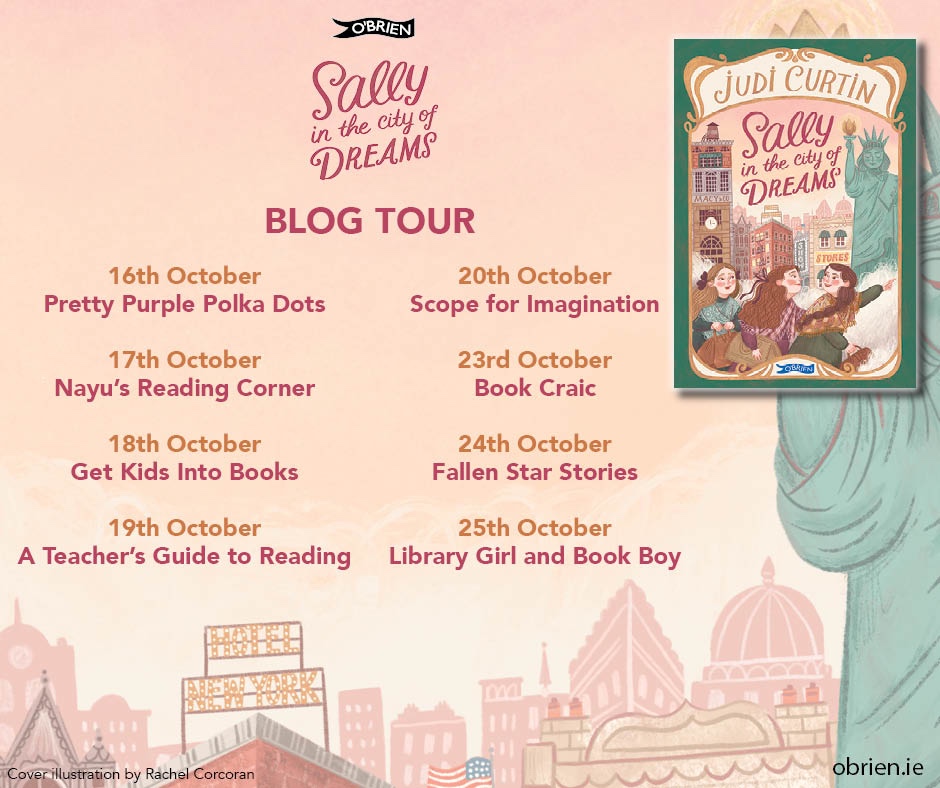
I’m delighted to be part of the blog tour for this lovely piece of historical fiction with loyalty, friendship, and the bonds of sisterhood at its heart. You can read my full review here.
Bella Bright and the Ghost Game Blog Tour
11 October 2023
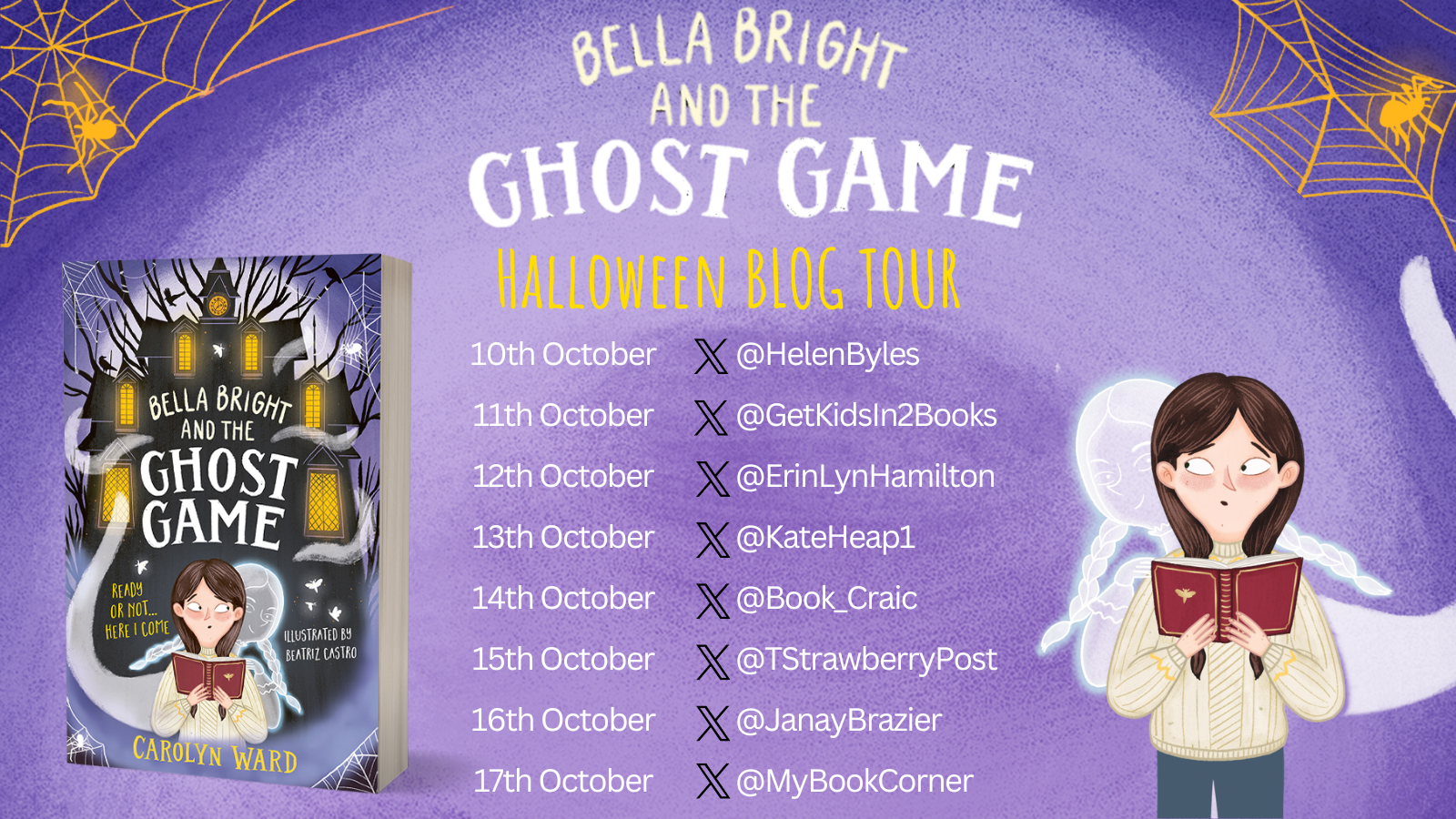
 It’s my pleasure to welcome Carolyn Ward to my blog today. Carolyn’s debut middle grade novel, Bella Bright and the Ghost Game, published this summer and is the perfect Halloween read.
It’s my pleasure to welcome Carolyn Ward to my blog today. Carolyn’s debut middle grade novel, Bella Bright and the Ghost Game, published this summer and is the perfect Halloween read.
Eleven-year-old Bella Bright has just moved into Darkling House in Castleton, an enormous and cavernous old house. On her first day at her new school, she organises a Halloween sleepover with her new friend Lex and mean girls Skylar and Regan. Things start getting spooky when the house’s huge front door appears to shut itself, their mobile phones lose signal, and they hear a hair-raising whisper… Their game of hide and seek starts to go terribly wrong when the ghost of a young girl appears. She has hidden Bella’s three friends somewhere in the house, and Bella has until midnight to find them or Alice will keep them as her playmates… forever. This certainly is a Halloween sleepover to die for!
Get Kids into Books: Please can you tell me a little about where the inspiration for Bella Bright and the Ghost Game first came from?
Carolyn: I wanted to write a book that I would have loved to read when I was 12, so I knew it had to be about a ghost somehow! I remembered an old tale about a bride who went missing during a game of hide and seek (for a brilliant version, read The Mistletoe Bride by Kate Mosse) and I realised hide and seek would be perfect as it’s such a terrifying childhood game. I had all these memories about holding my breath as I crouched in a wardrobe and so on, the hairs at the back of my neck prickling as the seeker got closer! The ghost and the game just seemed a perfect combination for a middle grade novel.
Get Kids into Books: Have you had any favourite moments as a debut author now that your first book is out in the world?
Carolyn: My dream was always to see my book in a book store, and that dream came true when I was invited into my local Waterstones to sign their copies. It was just amazing to see Bella on the shelf! I will never forget that moment… pure magic.
My friend has been reading Bella to her daughter, who was inspired to write her own story; instead of Bella she wrote about ‘Luna’ and some tricky ghost issues and I was near tears as I read what she’d written. So cool!
Get Kids into Books: Were you a reader as a child? If so, what were your favourite books to read?
Carolyn: My mum and dad were avid readers so we were taken to the library every week from a very young age and allowed to choose whatever we wanted. It made books seem fun, exciting and quietly taught me how stories worked. Beginnings, middles and ends, rising tension and character journeys – things like that.
I loved Enid Blyton, particularly The Faraway Tree and specifically the Land of Take What You Want – I really wanted some purple chickens! Also How Green You Are by Berlie Doherty – except for the goldfish bit!! The What Katy Did series, Nancy Drew, and Roald Dahl were all up there. I’m watching the Dahl short stories on Netflix at the moment – Henry Sugar was always one of my favourites.
Get Kids into Books: Do you have any advice for the parents or teachers in their lives who want to encourage their writing?
Carolyn: Allowing young people to be free to read and write what they like, for pleasure, gives the creative power back to them. Keeping it fun is key – play that game with the folding paper, Consequences. Adapt it to tell a story and pass it around. Let them see you read and write too – get a notebook each and then sit together with an idea, like ’Haunted House’, and see if you can create something. A list of descriptive words is amazing, a tiny story or poem is even better. Now illustrate it!
Get Kids into Books: Do you have any spooky book recommendations for young readers as we head into the Halloween season?
Carolyn: I LOVE reading spooky and scary books! For MG/KS2 try The Dark and Dangerous Gifts of Delores Mackenzie by Yvonne Banham, The Witchstone Ghosts by Emily Randall-Jones, and Welcome to Dead Town, Raven Mckay by Eibhlis Carcione. Jennifer Killick’s are all amazing, as are the creepy Aveline Jones series by Phil Hickes. For younger readers the Autumn Moonbeam books by Emma Finlayson-Palmer are adorable, and for teens: Someone is Watching You by Tess James-Mackey, and Bite Risk by S.J. Willis will scare your socks off. There is a YA that I’m too scared to finish! It’s Rules For Vanishing by Kate Alice Marshall. Can you read it? Are you braver than me!?
Get Kids into Books: Thanks Carolyn. There are certainly enough books there to keep us awake at night!
The publishers, Welbeck Children’s, have produced some fabulous classroom resources linked to the book. Here’s a link to where you can download the pdf.
Scrap Blog Tour
10 October 2023
I’m delighted to be part of the Scrap blog tour. This is an exciting science fiction book with lovable characters and powerful themes. Read my full review here.
The Wild Blog Tour
10 October 2023
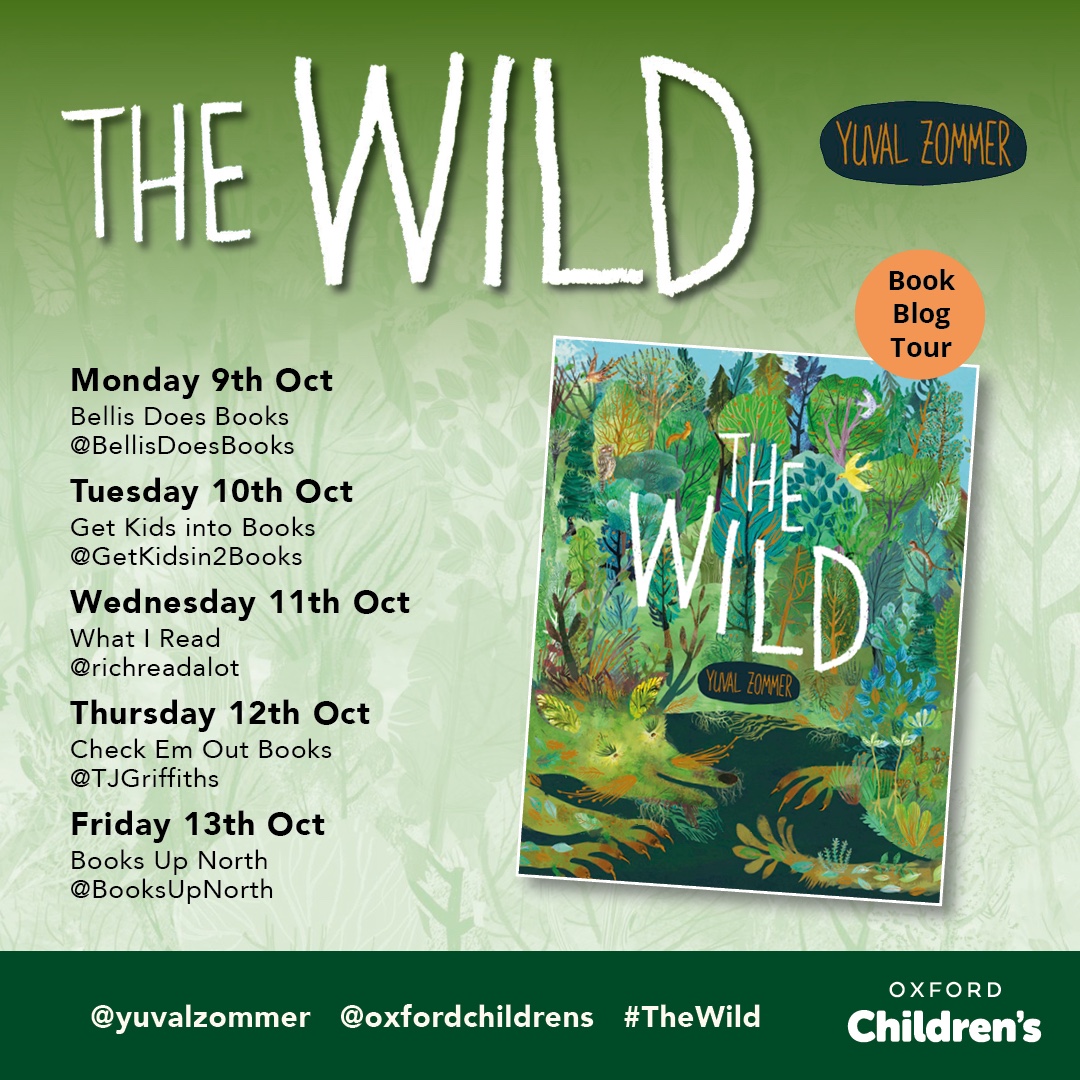
What a treat to be part of the blog tour for this beautiful picture book full of hope and the promise of change. Read my full review of this environmental fable here.
Great Minds Blog Tour
4 October 2023
I’m thrilled to be part of the blog tour for this utterly absorbing book which considers all of life’s big questions. You can read my full review here.
Infographica Blog Tour
3 October 2023
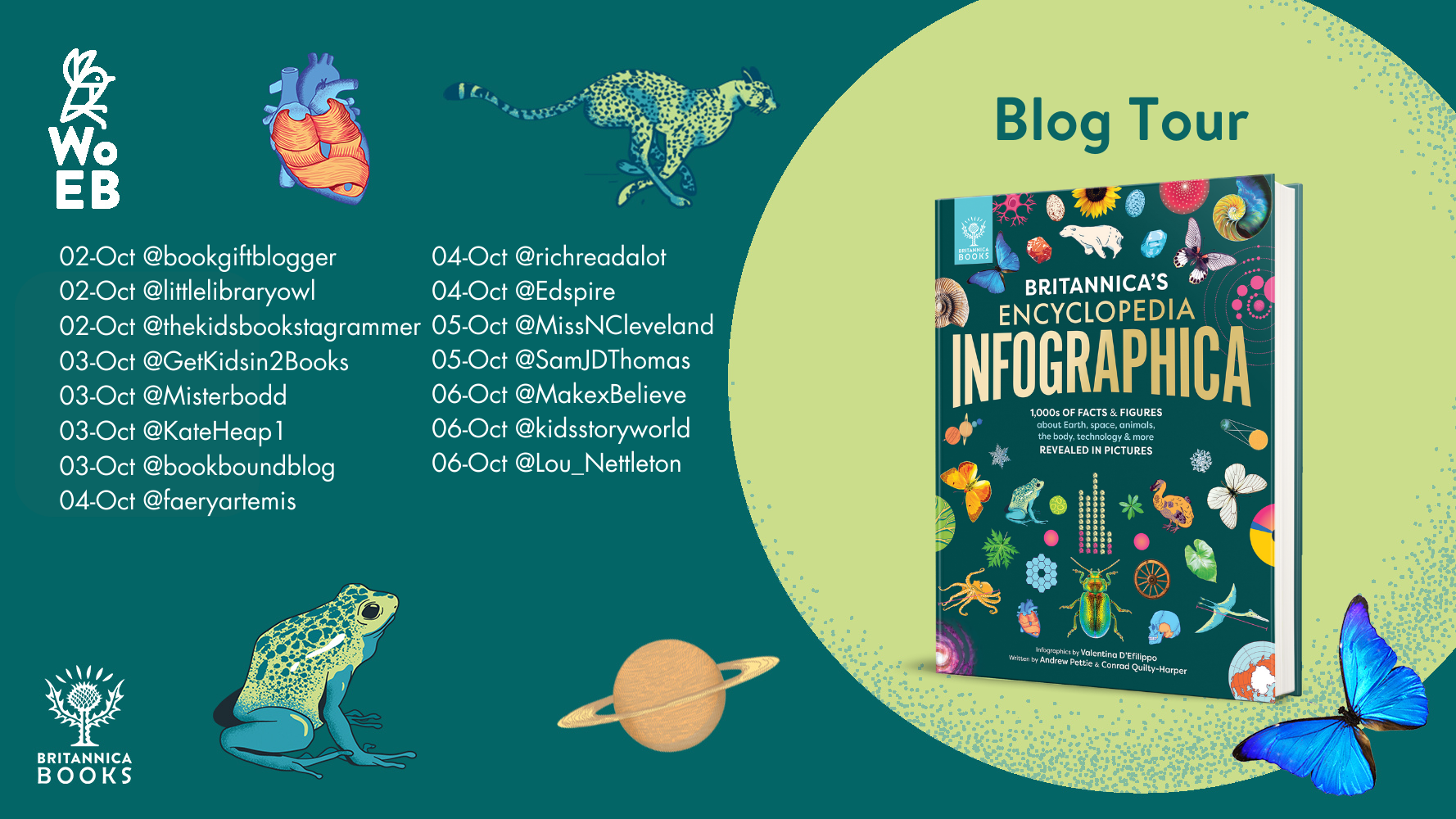
I’m delighted to be part of the blog tour for this stunning book which presents information in a captivating visual style and encourages us to marvel at the world around us. Read my full review here.
Strange Tales Blog Tour
27 September 2023

It’s my stop on the blog tour for this collection of strange tales. Sometimes grisly and macabre, sometimes mysterious and unnerving, always entertaining. Read my full review here, if you dare…
History FACTopia! Blog Tour
25 September 2023
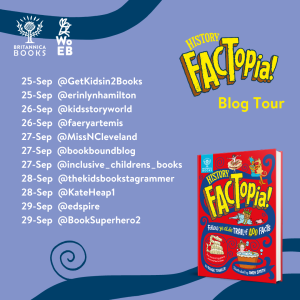
I’m very happy to be part of the blog tour for this fascinating and highly engaging non-fiction book which takes us on a journey through global history. You can read my review here.
Scareground Blog Tour
8 September 2023
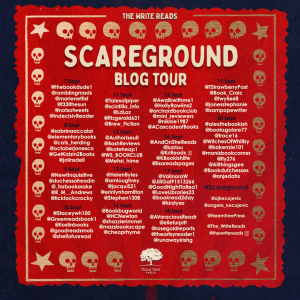
I’m delighted t be part of the blog tour for this wonderfully macabre tale. You can read my full review here.
The Wrath of the Woolington Wyrm
Blog Tour, 31 August 2023

I’m thrilled to be part of the blog tour for this fantastic mystery story. Unexpected monster hunter Mary-Kate is anxious and prone to catastrophic thinking and I just loved her. She also has an excellent stationery collection. My kinda girl! Read my full review here.
Norah’s Ark Blog Tour
26 August 2023
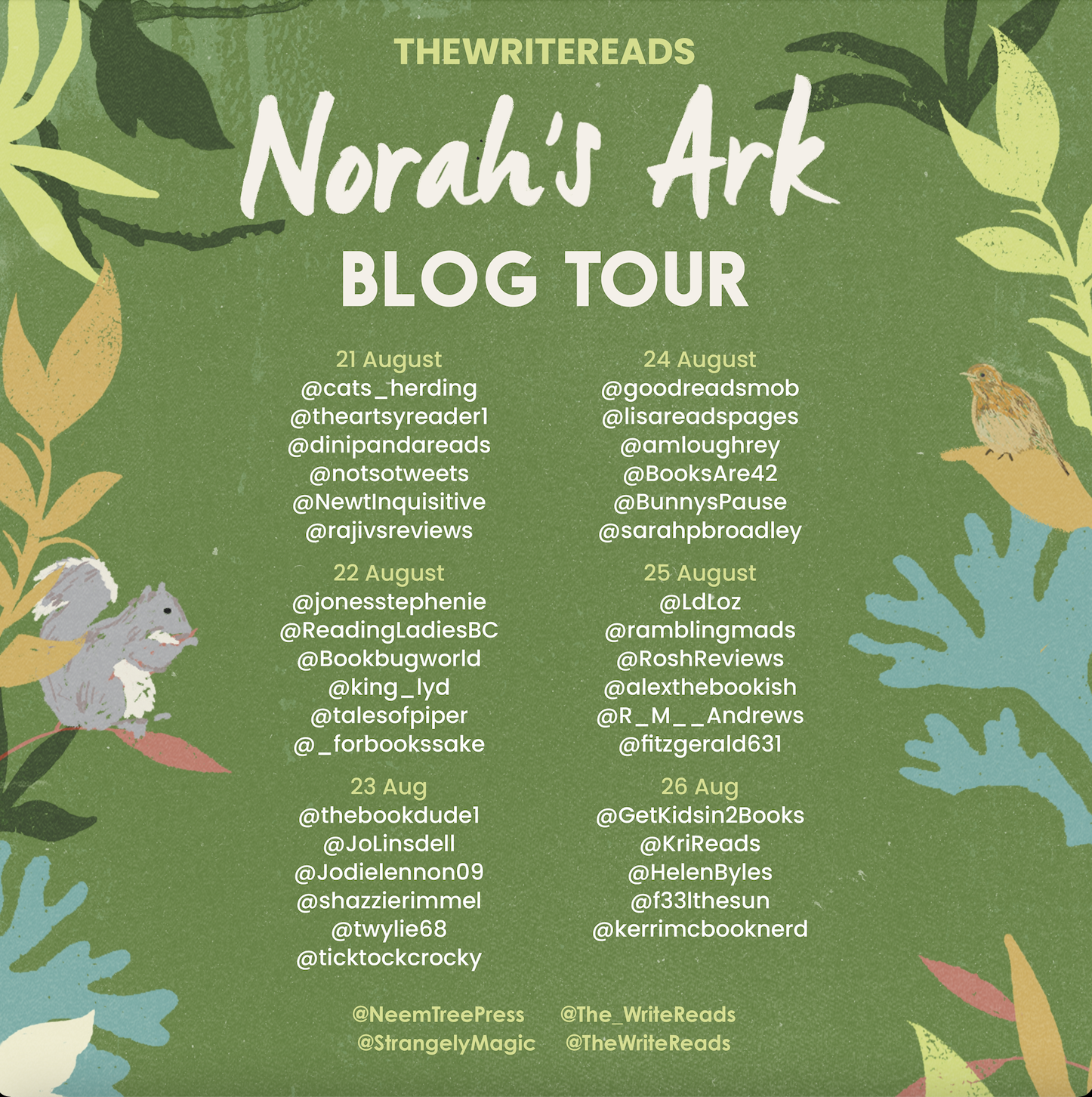
Thank you to The Write Reads for including me on the Norah’s Ark blog tour. Click here to read my review of this poignant and deeply empathetic novel which explores homelessness and childhood cancer through an uplifting central friendship.
Koku Akanbi and the Heart of Midnight Blog Tour
7 August 2023
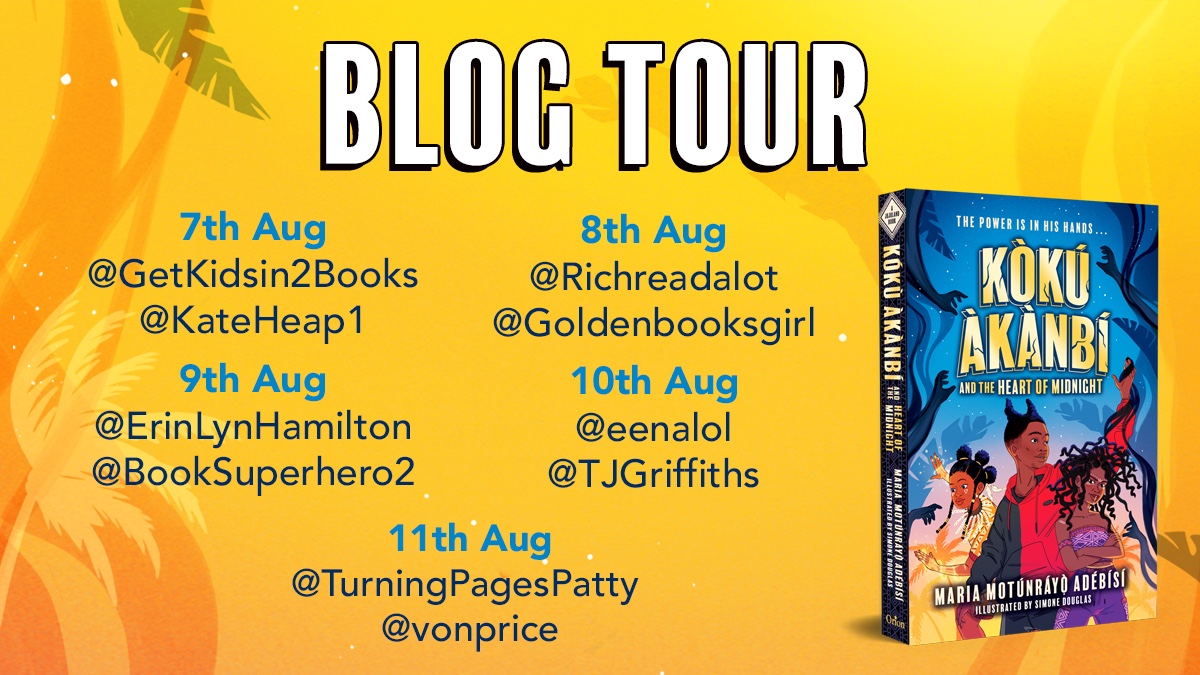
I’m delighted to share my review of this exciting fantasy adventure and coming-of-age story. It’s rich with West African mythology and takes us to a world that’s full of danger and magic.
Mysteries at Sea, Peril on the Atlantic
Blog Tour, 5 August 2023
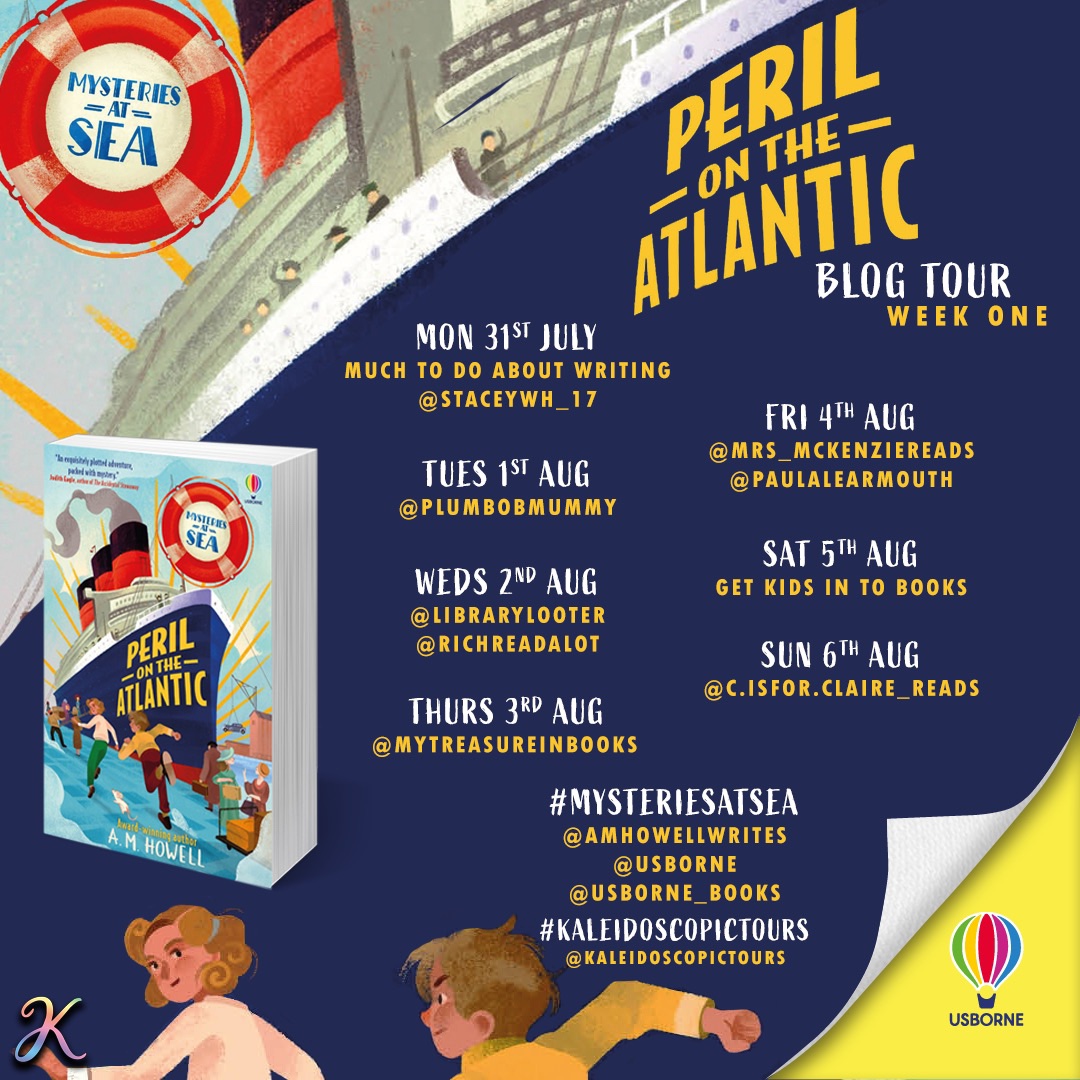
Peril on the Atlantic is an intricately plotted mystery-adventure set on board a magnificent ocean liner in the 1930s. It’s an exciting fast-paced story with lots of drama and tension. You can read my review here.
The Destiny of Minou Moonshine Blog Tour
29 July 2023
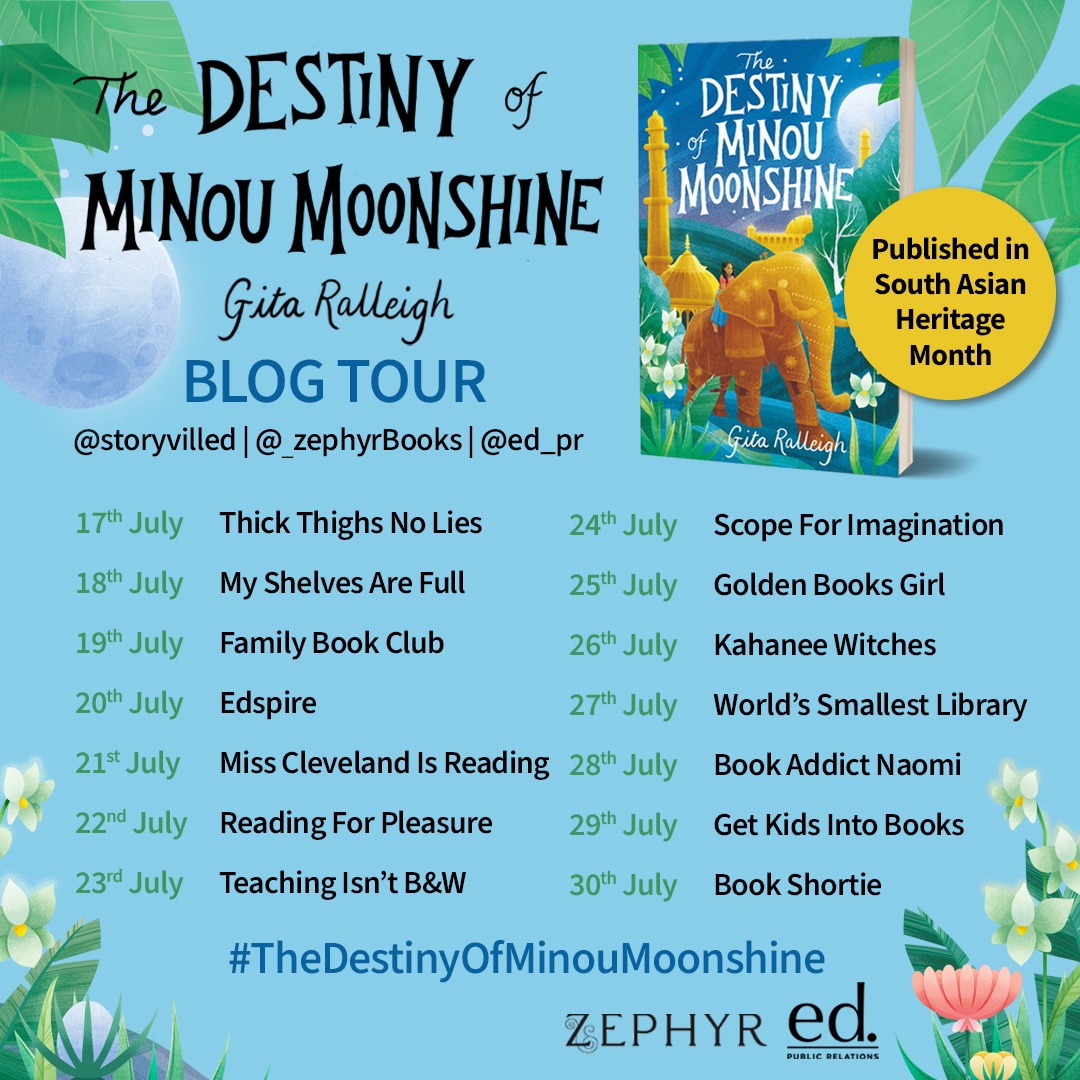
To celebrate South Asian heritage month and the publication of The Destiny of Minou Moonshine, I’m joining the blog tour to share my review. It’s an exciting adventure story that’s steeped in myth, faith and ancient powers, alongside themes of resistance and rebellion. Read my review in full here.
The Wonder Brothers Blog Tour
21 July 2023
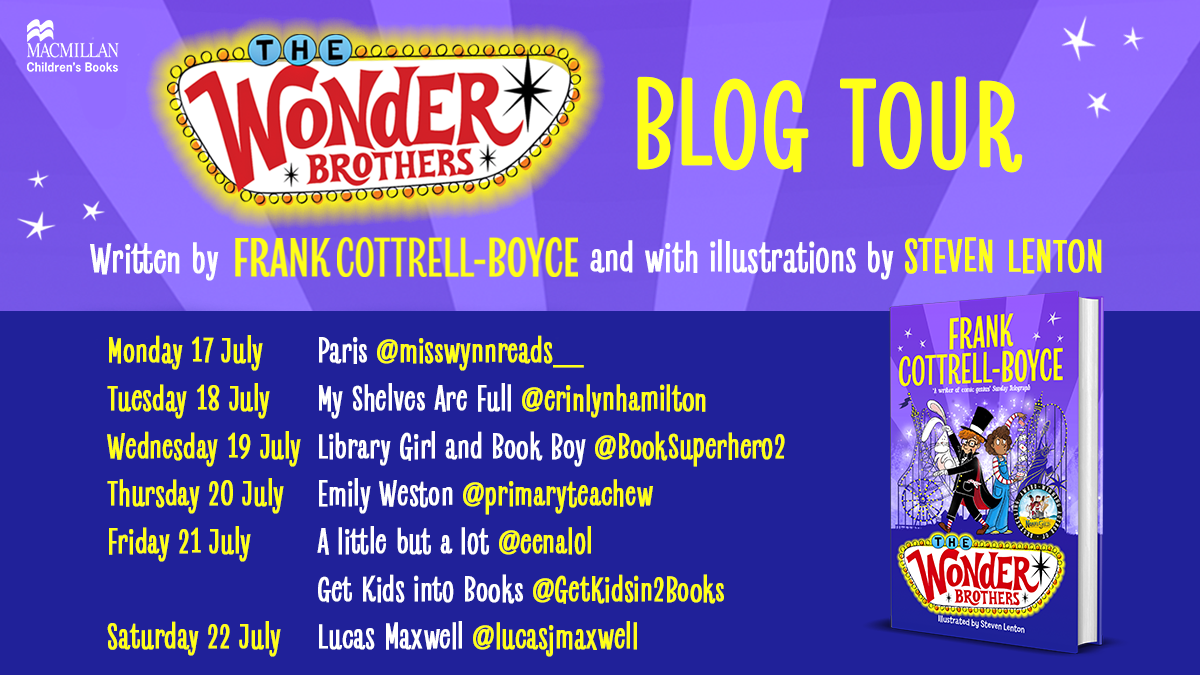
I really enjoyed Noah’s Gold, an earlier collaboration between Frank Cottrell-Boyce and Steven Lenton, so I was excited to see they’d worked together again on The Wonder Brothers. Starring sticks of rock, spangly capes, and plenty of surprises, The Wonder Brothers follows the unexpected adventures of two cousins Middy and Nathan. They love magic tricks, and together form a magic act called The Wonder Brothers. Middy uses magic skills to help her get out of tricky situations, whilst Nathan loves nothing more than showing off and creating spectacles to dazzle his audiences.
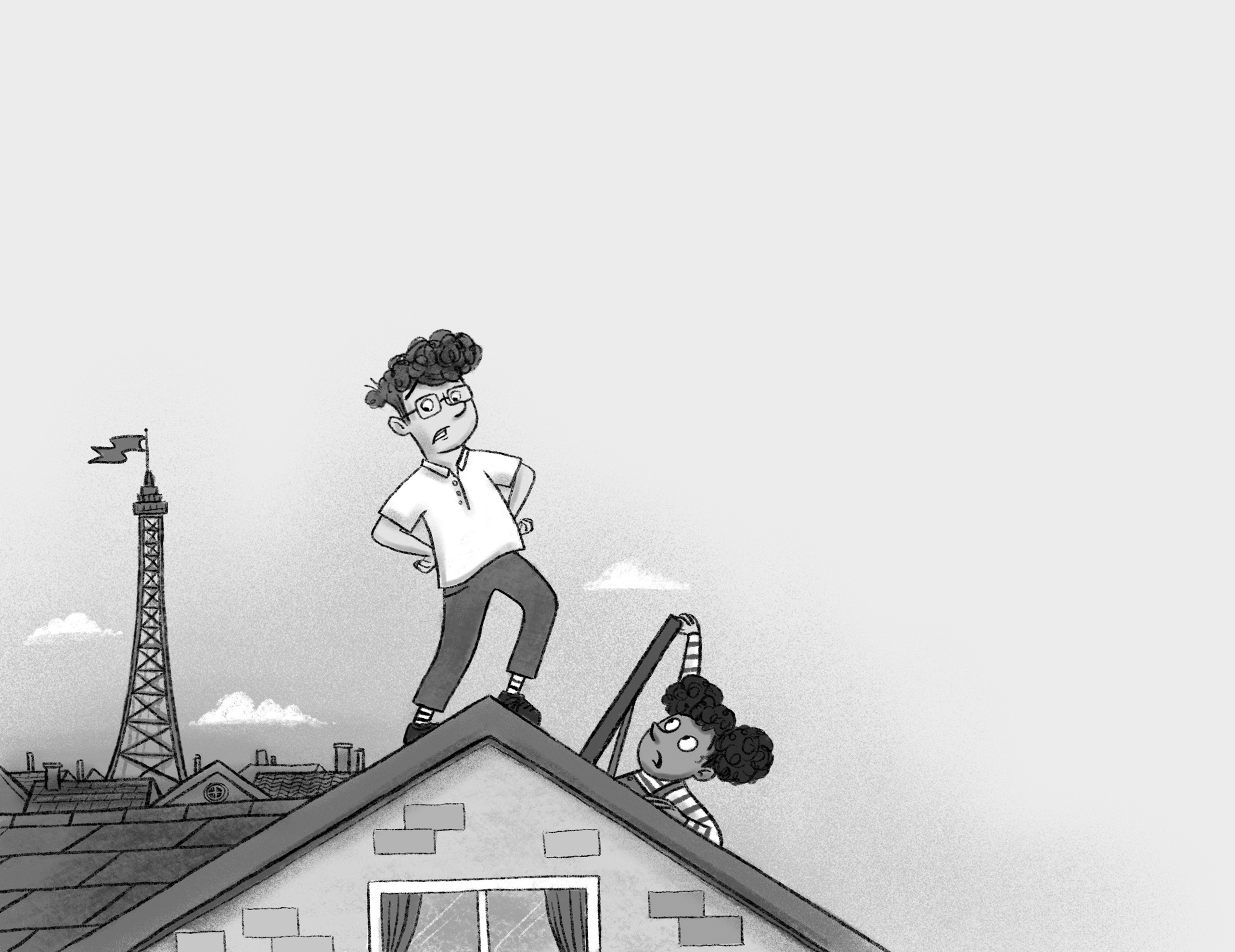
When the world-famous Blackpool Tower dramatically vanishes on the night of the Grand Lights Switch-On, Nathan announces live on TV that they will magic it back home. Soon, Middy, Nathan, their big cousin Brodie and a massive rabbit set out on a mission to retrieve the five-hundred-foot tower. As if by magic, they unexpectedly end up in Las Vegas, home of Perplexion, the Master of Mystery and the world’s greatest magician. Can Middy and Nathan do the impossible, and bring back the beloved Blackpool Tower?
Here’s an extract to whet your appetite some more:
CHAPTER TWO
AND NOW . . .THE TWO AND ONLY WONDER
BROTHERS!
NATHAN:
Captain Jimenez flashed her Las Vegas Metropolitan Police Department badge and said she wanted to record our interview for ‘training purposes’. And also just in case we turned out to be a threat to National Security. Middy thought this was a great idea. She said professional magicians often film themselves when training.
I offered to operate the stop start button.
MIDDY:
Captain Jimenez said that we were in trouble. ‘You’re in trouble,’ she said. ‘If you want me to help you, you need to give me the Truth and give it me straight.’
Sadly when she said this she was looking at Nathan. He jumped up, threw out his arms and said to the whole room . . .
‘Whoever you are . . .
Whatever you are . . .
Get ready to be astonished
Because we are . . .
THE WONDER BROTHERS!!!!!!‘
Captain Jimenez rolled her eyes. ‘Son,’ she said, ‘this is a police investigation, not a circus. Just give us the details. No razzmatazz. Just the facts.’
Saying ‘no razzmatazz’ to our Nathan is like saying ‘no swimming’ to Mr Nibbles the goldfish. Razzmatazz is how Nathan moves.
Some people can’t see colours. Some can’t remember their number bonds. Nathan can’t see consequences. He does what he feels like doing. His mum says he’s complicated. My mum says he ‘can be bouncy’. His teachers call him ‘a character’. Basically he’s mostly OK but can be a bit of a flapjack sometimes.
‘If it’s details you’re after,’ he said, ‘you’ve come to the right people. Officer, we’ve got more details than you could shake your badge at. We’ve got details about plumbing, stowaways, brushes with death, magic that will make your skin tingle and the most incredible robbery in the history of the world.. I mean where do we even start?’
‘Let’s start with your names, shall we?’
‘We are the two and only Wonder Brothers. We are . . .’ He stopped. I’d given him The Look. One thing you learn when you’re part of a magic act with someone is how to watch each other really closely. Close enough to tell what the other is thinking. Like mind-reading. Nathan could tell I was thinking, Nathan. Stop talking.
So he stopped talking.
Ta-dah!!!
‘The Wonder Brothers,’ I said, ‘is our stage name. Not our real name. We’re not really brothers. For one thing, I’m a girl. We’re cousins. I’m Middy McNulty and he is Nathan Wiley.’
‘And this is Queenie.’ That was Brodie interrupting.
‘Queenie’s a rabbit,’ he said, holding Queenie up so that the officer could see her.
The Captain sat up suddenly. ‘Are you sure that’s a rabbit?!’ she gasped. ‘She’s the size of a small child.’
‘She nearly won the Best Oversized Rabbit prize at the Lancashire show last year. Do you need to know her full name? It’s Queen of Tobago.’
‘No. I don’t need the rabbit’s full name. I need to know what three little British kids are doing wandering around Las Vegas, USA, with no adult supervision.’
Nathan said, ‘Like I said, we’re here to report a theft. Someone stole something from our town and we’re not going home until we’ve found it.’
She licked her pencil, ready to take notes. ‘OK, let’s have a description of your stolen property.’
I explained that the stolen property wasn’t exactly ours. ‘It belongs to our whole town. To the whole world, really.’
‘Just describe it.’
‘It’s tall and thin and mostly metal.’
‘How tall?’
‘Five hundred and eighteen feet and nine inches.’
Captain Jimenez got halfway writing that down before she looked up and said, ‘Five hundred and . . . What are you talking about?’
‘We’re talking about the World-Famous Blackpool Tower.’
‘How,’ snarled the officer, ‘would anyone steal a tower?’
‘Magic,’ said Nathan.
Captain Jimenez put down her pencil and gave him a bad look.
Nathan said, ‘You don’t believe me. Maybe you don’t believe in magic. Don’t worry, you will by the time we tell you what happened to us.’
——————————————————————————————————
Funny, engaging and lots of fun – The Wonder Brothers is perfect summer holiday reading.
And just check out this picture of Queenie the rabbit! (Another of Steven Lenton’s fabulous illustrations.)
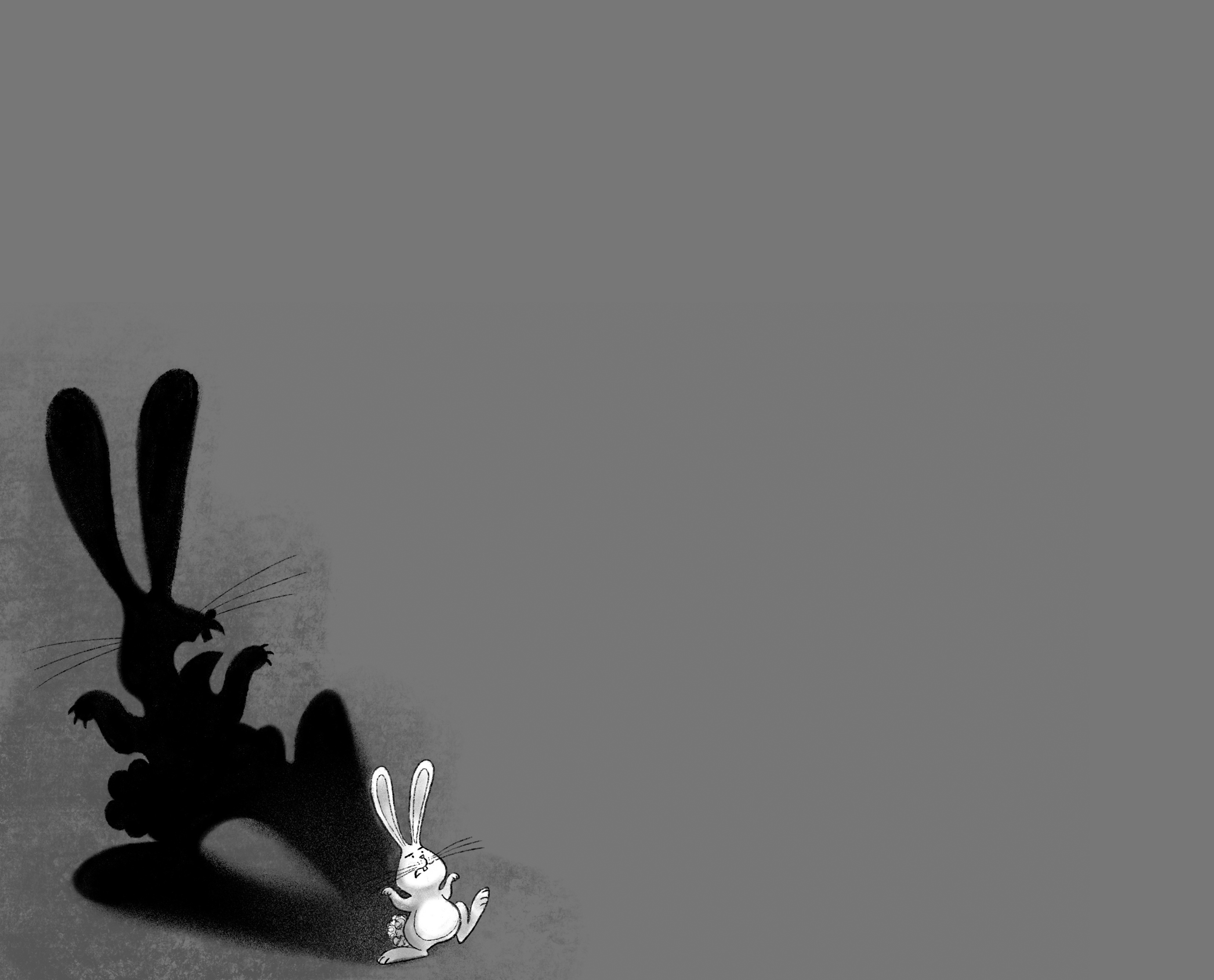
Zeina Starborn Blog Tour
12 July 2023
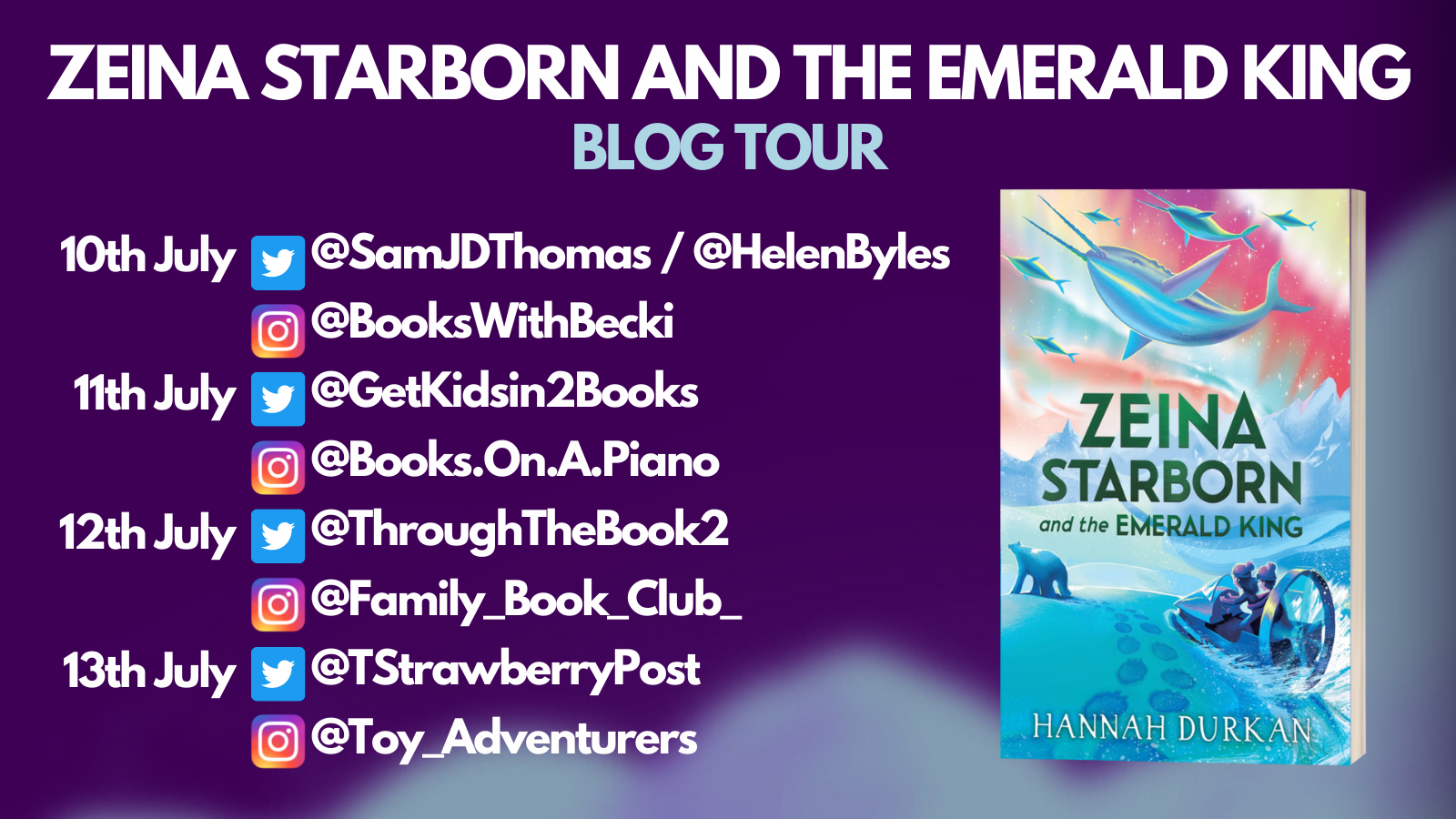
 I’m delighted to welcome author Hannah Durkan to my blog today to talk about the second book in her exciting Zeina Starborn series. These fantasy adventure books, with themes of ecological conservation and STEM, are perfect for readers aged 9+
I’m delighted to welcome author Hannah Durkan to my blog today to talk about the second book in her exciting Zeina Starborn series. These fantasy adventure books, with themes of ecological conservation and STEM, are perfect for readers aged 9+
Get Kids into Books: Please can you introduce us to your characters, Zeina and Jackson?
Hannah: Zeina Starborn is brave and adventurous; she knows what she wants and doesn’t worry too much about bending (breaking) rules to get it! As a Below, she should be happy to work in her polluted city for the rest of her life, yet she dreams of exploring the skies and is determined to do that, no matter the consequences. On the other hand, Jackson Willoughby can be quite sensitive and cautious. As an Above, he is destined to live a life of luxury aboard an airship or sky whale hotel, but what he really wants is to find friends and a family who cares about him. Zeina and Jackson clash completely as characters, but they must begin to trust and learn from each other if they are going to discover the hidden truths in their world.
Get Kids into Books: Can you tell me a little about your inspiration for Zeina Starborn and the Emerald King?
I wanted to write a story in a frozen world for a while, in part because I had watched a programme about ice hotels! The fact that some of them are built, completely from scratch each winter, including the interiors, statues and sculptures, only to melt each spring I found really interesting. The Emerald King’s Glacial Palace is built new each winter, just like an ice hotel and similarly, it too is threatened by pollution and climate change.
For the twin-tusked horned sky whales we have to go back to the Natural History Museum. There they have a real-life skull of a narwhal with two tusks!
Get Kids into Books: When did you know you wanted to be a writer?
Hannah: If you had asked me at 10 what I wanted to be, I would have said a writer, but that all changed as I got older. Spelling, grammar and handwriting were all things I got told off about at school and I think that really put me off. I had lots of different careers before I started writing again and it wasn’t until I became part of a creative writing group for new mums that I had the confidence to finish my first story.
Get Kids into Books: What, in your opinion, makes a good story?
Hannah: There are so many elements to this but at the centre you need strong characters – main characters you love despite their flaws and villains that are fun to hate! Personally I also love a good plot twist – something that makes you gasp when you read it.
Get Kids into Books: What do you hope readers take from this series?
Hannah: I hope that the series inspires its readers to be curious about the world around them, to ask big questions and to have the strength to make a stand when they don’t like the answers. Zeina, as a character, is far from perfect, but she’s brave, determined to follow her dreams, she cares for others and is learning all the time. I wrote her that way because that’s the advice I would give my children on how to best make their way in the world.
Get Kids into Books: Do you have any advice for young readers who would like to be authors or creative inventors themselves, one day?
Hannah: When you are thinking of ideas, follow your interests. It doesn’t matter if other people find them strange. If you are passionate about something you can spread that passion to others. An idea that might seem completely bizarre at the beginning can turn into something that makes perfect sense when it is created by someone who truly believes in it.
Get Kids into Books: Thank you, Hannah, for these brilliant answers.
For any primary school teachers out there who are interested in using the Zeina Starborn books in your classroom, you can download some fantastic teaching resources here. There are three extracts from the first book in the series, complete with discussion questions and ideas for follow-up activities. There are things to make, design and draw as well as ideas for research tasks and opportunities for making comparisons.
The Wall Between Us Blog Tour
23 June 2023
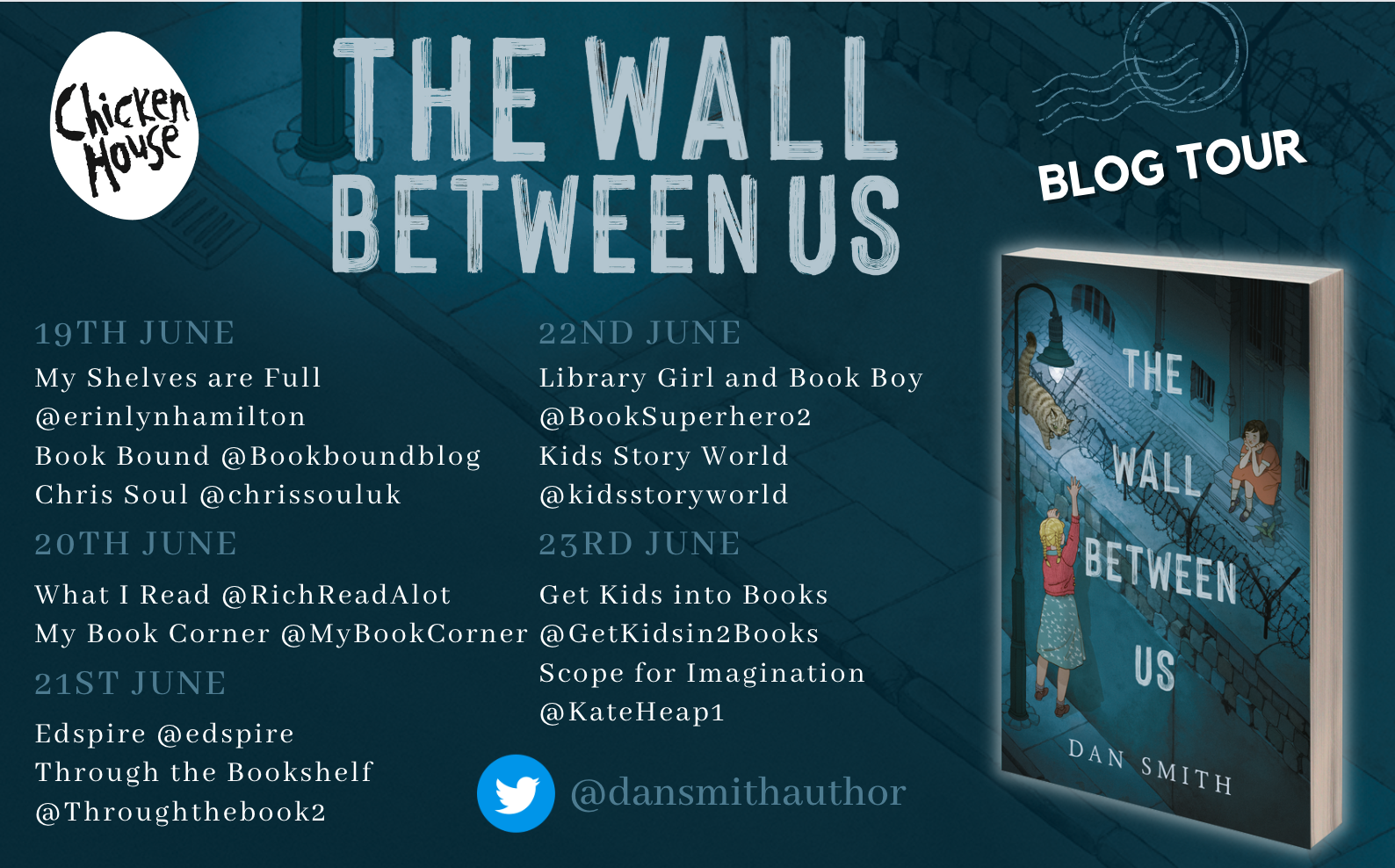
For my stop on the blog tour, I’m delighted to share my review of this pacy, high-stakes historical adventure set in Berlin in 1961.
Call of the Titanic Blog Tour
21 June 2023
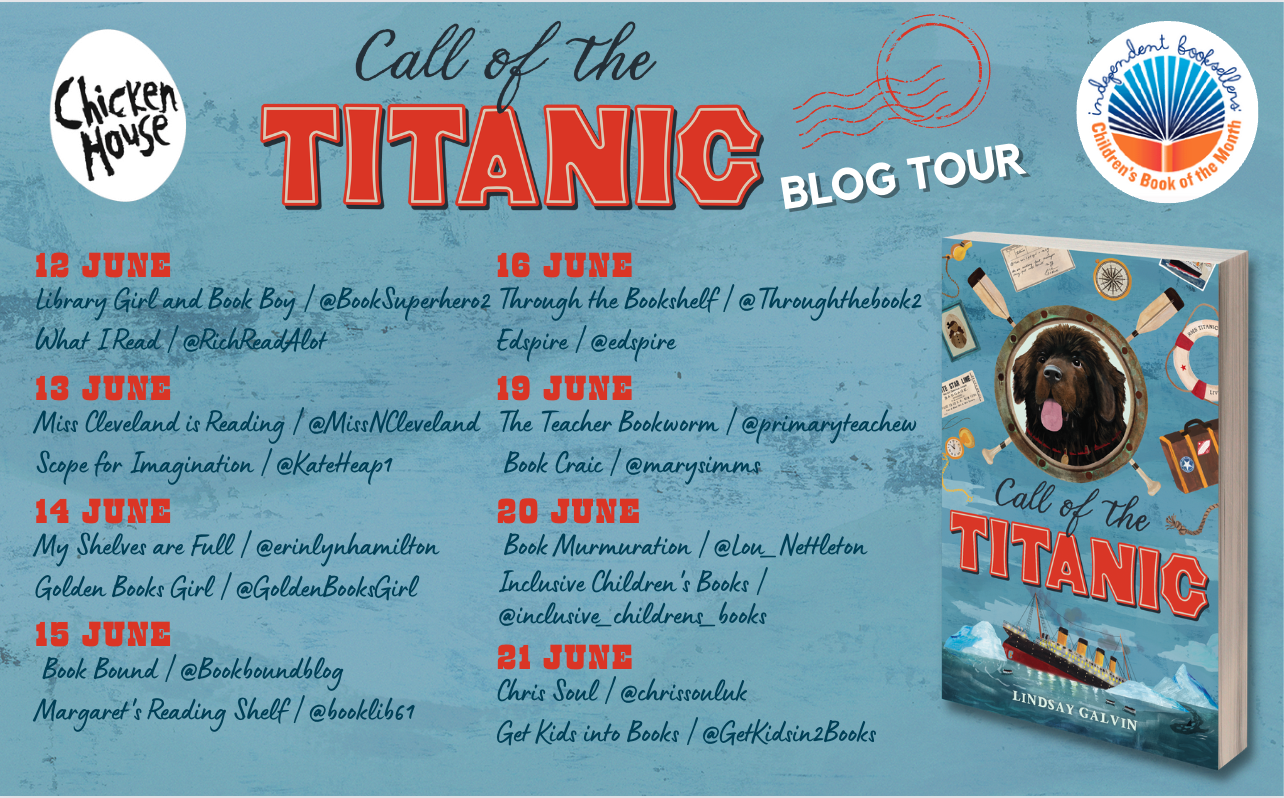
Call of the Titanic is a meticulously researched and wonderfully atmospheric period piece. It’s a tense and exciting adventure story which tells a very familiar story from a different perspective. You can read my full review here.
Bite Risk Blog Tour
13 June 2023
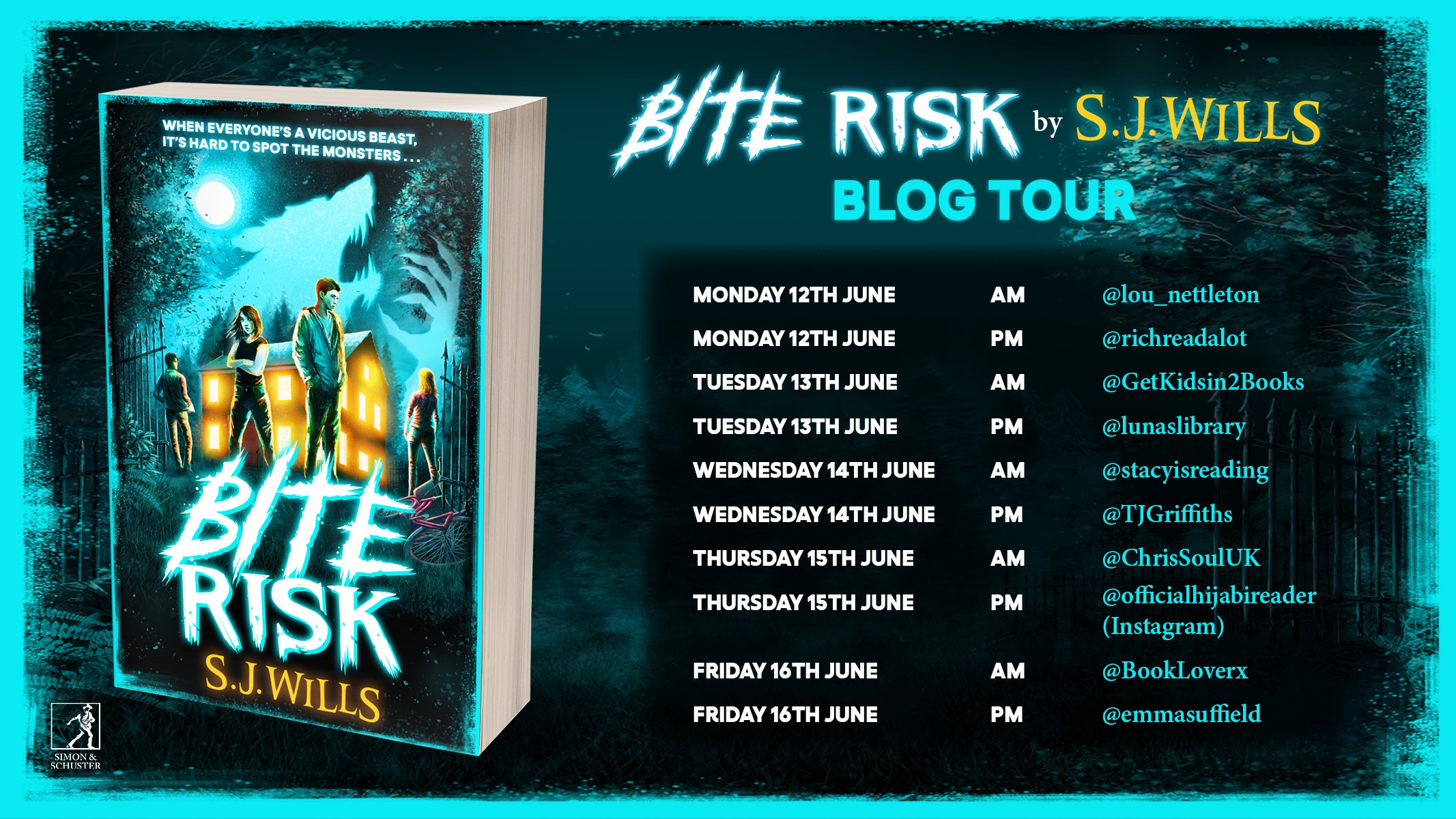
Bite Risk – the exciting new series for the pre-teen market – is out now.
When everyone’s a vicious beast, it’s hard to spot the monsters . . .
The first book in S. J. Wills’ blockbuster teen horror series is perfect for fans of Stranger Things, Fear Street and Skulduggery Pleasant. Sel Archer lives in a normal town with normal residents, except for one night a month . . . When the full moon comes out, almost all of the adults turn into werewolves and it’s up to the young people to protect themselves from danger. But, as this quiet life begins to unravel and the Turned start to escape, can Sel and his friends uncover exactly who – or what – is watching their every move, before it’s too late? Welcome, to the TOWN OF THE TURNED.
 I’m delighted to welcome Sophie, the author of this new series, to my blog today for a quick Q&A.
I’m delighted to welcome Sophie, the author of this new series, to my blog today for a quick Q&A.
Get Kids into Books: I’ve read that, when you were growing up, your parents let you choose any book you wanted to read from the library. Is this lack of censorship still something that you think is important for children choosing books today?
Sophie: Being able to pick out their own reading material from a really wide range immediately gives children a kind of ownership over the whole experience, and gives them the magic of discovery.
I think I was lucky that my parents didn’t step in to ‘correct’ me when I went through a phase of reading only my huge stash of TV Comics, over and over. For them, reading was about enjoyment, not progressing me onto ever more challenging texts. They could see I was enjoying them – why would they take that away?
I remember picking up a properly grown-up horror in the library when I was 11, among other choices. My mum raised an eyebrow and said “I really don’t think you’ll like that one. It will give you nightmares.” I insisted, took it home, started reading, gradually decided she was right, and put it down. She could have banned it from the house, I suppose, but she judged that it was probably wiser to let me figure it out for myself. I love that she respected I was capable of doing that. We always talked about the books I was reading, though, and I think that was key. I’m in favour of guidance and bookish conversation rather than bans.
Get Kids into Books: What is it about Bite Risk (and the rest of your new series) which appeals to a pre-teen/young teen market?
Sophie: I suspect the idea of caging all the adults one night a month holds a lot of the appeal. It sets up a thrillingly dangerous environment but with a lot of potential for fun, too.
Get Kids into Books: What were your main influences when creating the town of the Turned?
Sophie: I’ve never lived anywhere as isolated as Tremorglade – and wouldn’t want to. I can’t give too much away but one of the communities of rabbits in Watership Down gave me similar vibes.
Get Kids into Books: Thank you so much, Sophie, for joining me today.
An Adventure for Lia and Lion Blog Tour
6 June 2023
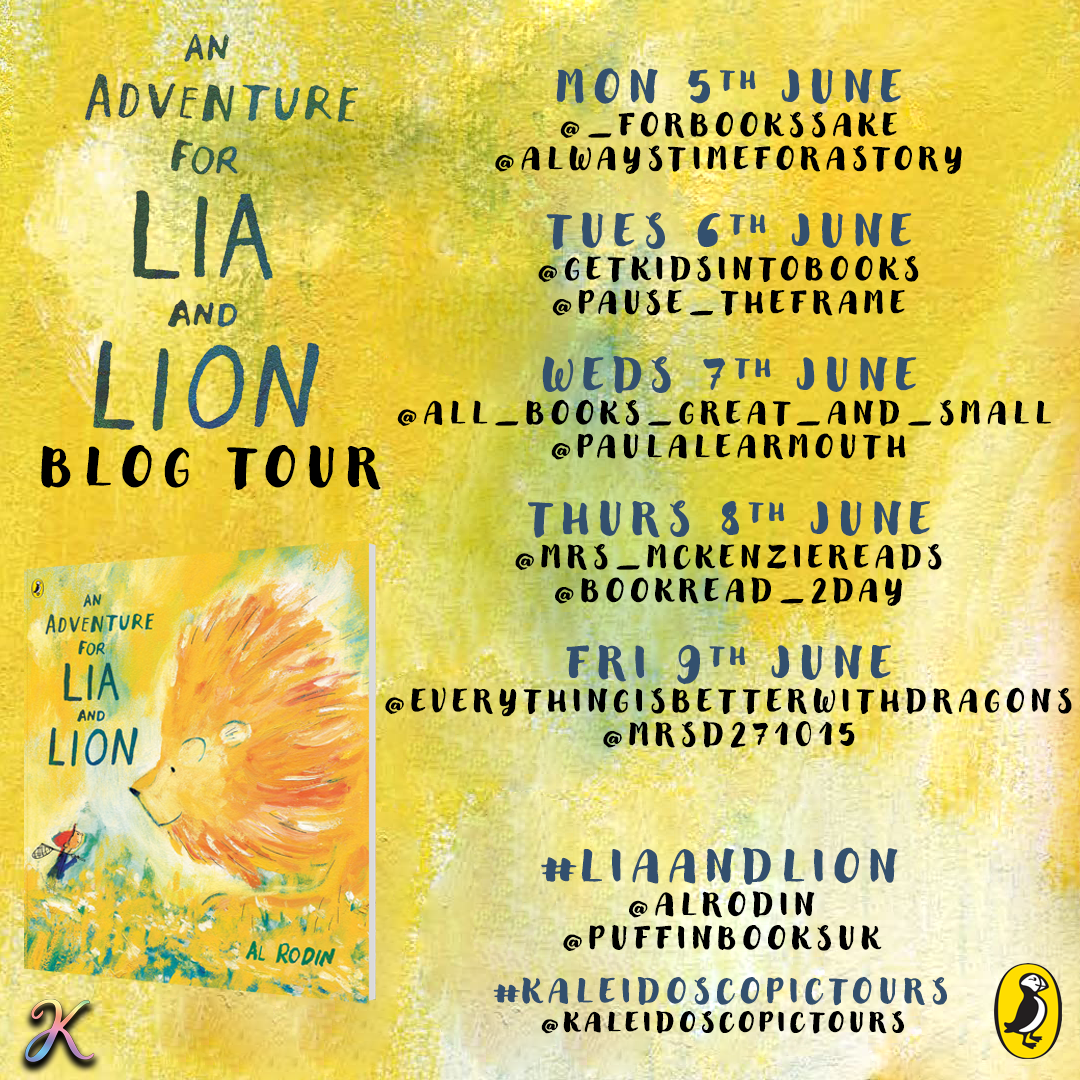
For my stop on the blog tour, I’m sharing my review of this wonderful picture book. An Adventure for Lia and Lion is a wonderful story of a developing friendship accompanied by illustrations that are vivid explosions of colour and texture. You can read my full review here.
Greenwild Blog Tour
5 June 2023
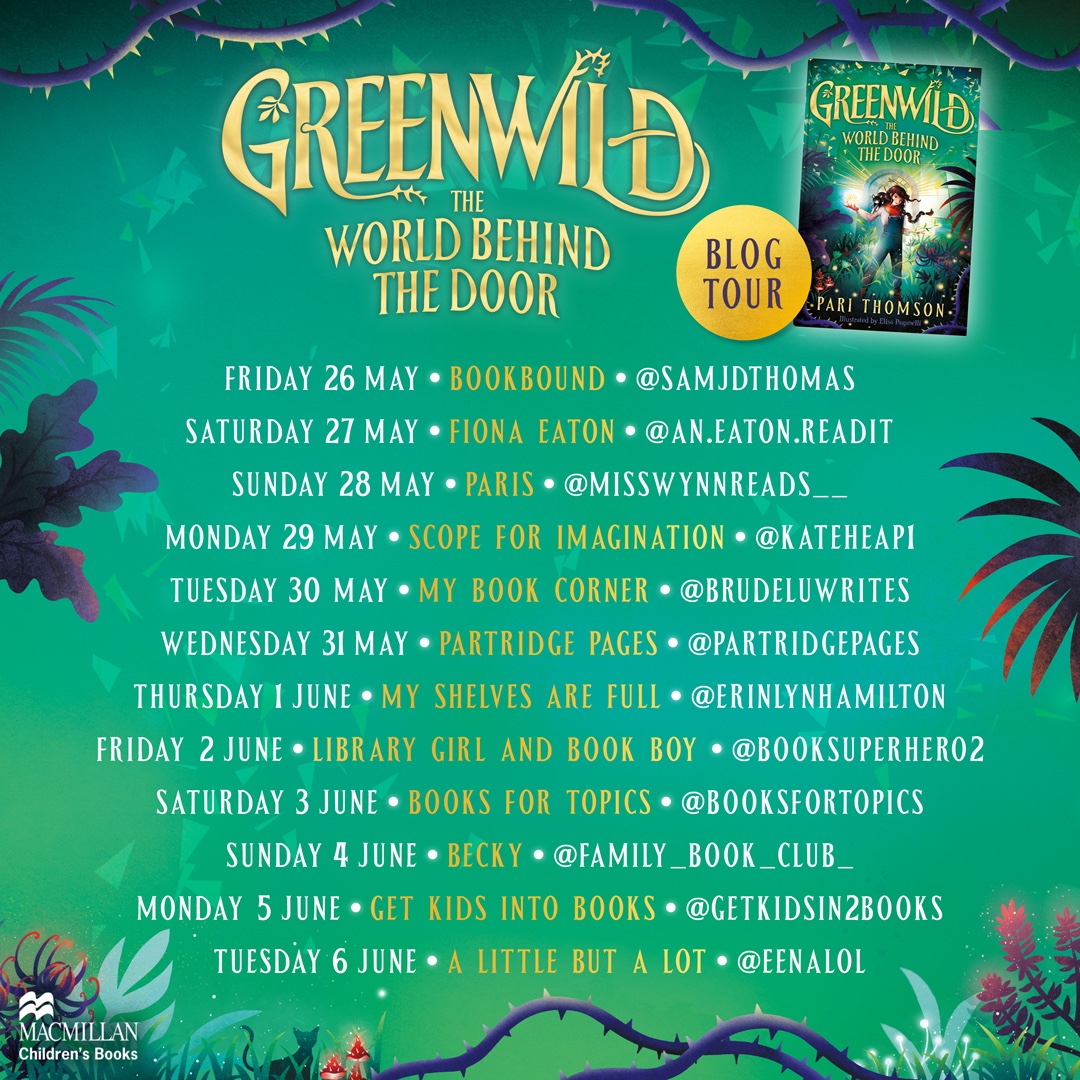
I’m delighted to share my review of this brilliantly imaginative eco-adventure.
Welcome to Dead Town, Raven McKay
Blog Tour, 22 May 2023
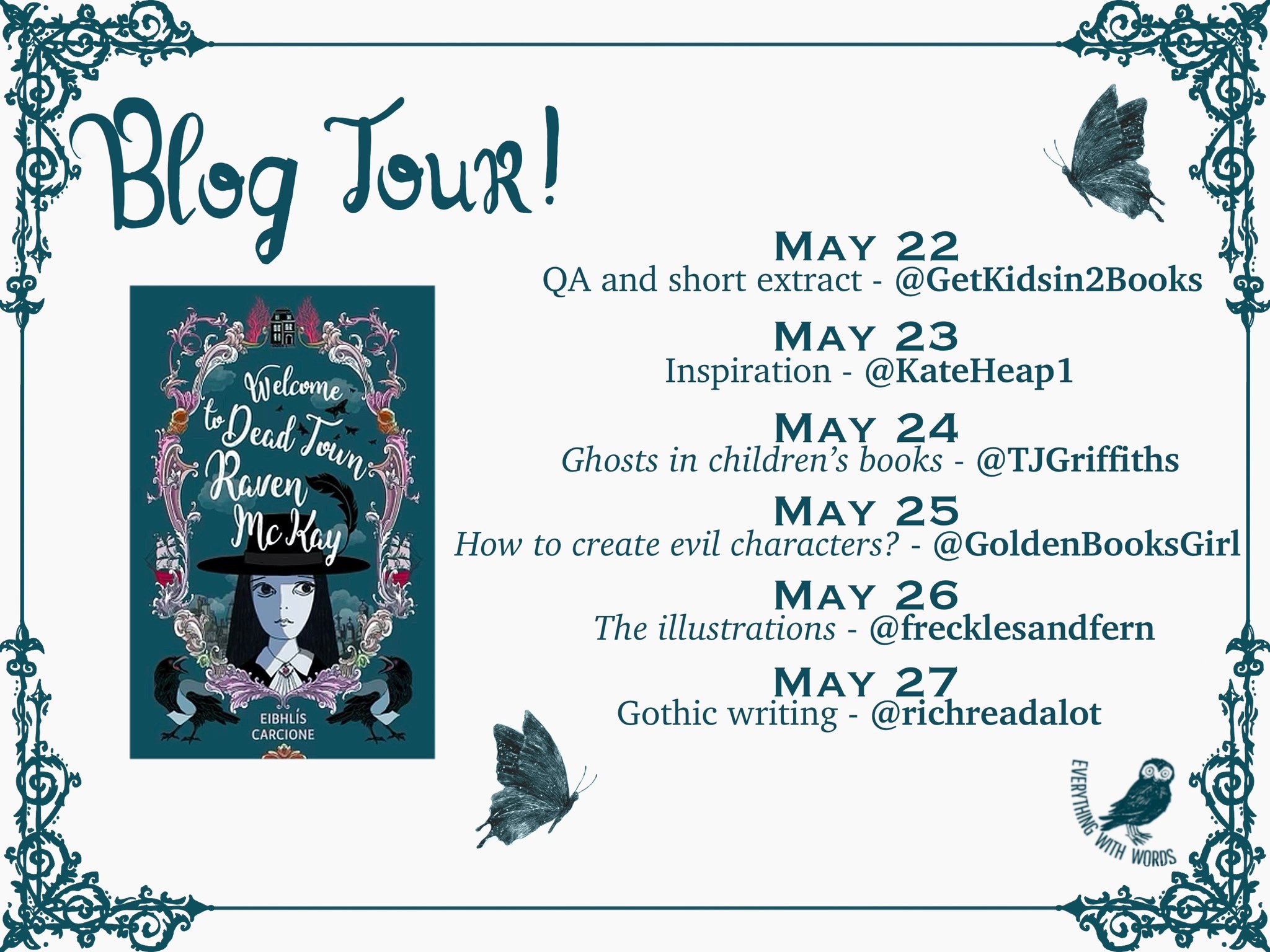
 It’s an honour to kick off the blog tour for Welcome to Dead Town, Raven McKay – a brilliantly creepy book that’s steeped in mystery and gothic darkness. Author Eibhlís Carcione joins me for a Q&A.
It’s an honour to kick off the blog tour for Welcome to Dead Town, Raven McKay – a brilliantly creepy book that’s steeped in mystery and gothic darkness. Author Eibhlís Carcione joins me for a Q&A.
Eibhlís: I have always loved ghost stories, Rachel. I went through a stage of being very afraid of the dark as a child. But I still continued to relish ghost stories. Over the years my appetite has increased. I also enjoy creepy films like American Werewolf in London, Interview with the Vampire, Beetlejuice and The Wolfman (1941). I have an affinity with gothic styles of writing. Some of my favourite writers are Daphne Du Maurier, Ray Bradbury and Shirley Jackson. There are children’s novels in this genre that I love; The Witches by Roald Dahl, The Dark is Rising by Susan Cooper and The Wolves of Willoughby Chase by Joan Aiken. I loved writing Raven’s story. The idea of setting a novel in a town where the living and the dead live side by side had been in my mind for a while. I drew on Irish folklore and mythology for this story. I certainly had fun, selecting some of my favourite creepy characters. I’ve always been fascinated with the white lady, a truly wicked female ghost with long white hair. So she was a must from the start. In Celtic mythology, black butterflies symbolise the souls of the dead. The black butterfly plays an important part in my book.
Get Kids into Books: The book deals with some heavy themes – life in foster care, grief and loss – how important do you think it is for children’s books to tackle subjects like this?
Eibhlís: All of these things are a part of life. I had the experience of teaching children who were in foster care. Some of them had suffered much loss. They were very upbeat resilient kids. A trait they all shared was thoughtfulness. They had dreams, big dreams. They told me lots of stories, a mix of heartbreaking and uplifting. Their stories definitely influenced this book as did the other children I’ve taught who experienced loss. I don’t want to overwhelm readers with heavy themes but I’ve tried to address them in a subtle way, while keeping the book creepy and fun. One never knows what’s around the corner in life and it’s the same for Raven in Dead Town. It’s the same for all of us.
Get Kids into Books: Raven McKay is a brilliant central character. What came to you first, the plot or the characters?
Eibhlís: Raven McKay came to me in a dream. I saw her on a hilly town, clutching her suitcase with the faded sticker of the black butterfly. She stood there and looked at me. It was as if she was asking me to write her story. This was both a powerful catalyst and an emotional moment. The first few pages came quickly. At that stage I went back to plotting. I let things grow and flourish. I thought about the other characters. When I could see the story unfold like a film in my head, I knew I was ready to write it. I soon found myself in the heart of Dead Town
Get Kids into Books: It’s an incredibly stylish book, from the striking cover to the dramatic black and white illustrations. As an author, how much involvement did you have with this side of things?
Eibhlís: I chatted with Mikka, the publisher and Ewa Beniak-Haremska, the artist over zoom. We also exchanged some emails. What’s interesting is that Ewa said the cover of the book came to her in a dream also, which in itself is mysterious. I’m very grateful to Mikka for her passion about my book and her insight and for choosing Ewa as the artist. A perfect match. Ewa loved Raven’s story. She even said Raven reminded her of her younger self. I think she went deep into her own imagination for these illustrations. Sublime and wondrous. They’ve added another gothic layer to the book.
Get Kids into Books: What can we look forward to reading from you next?
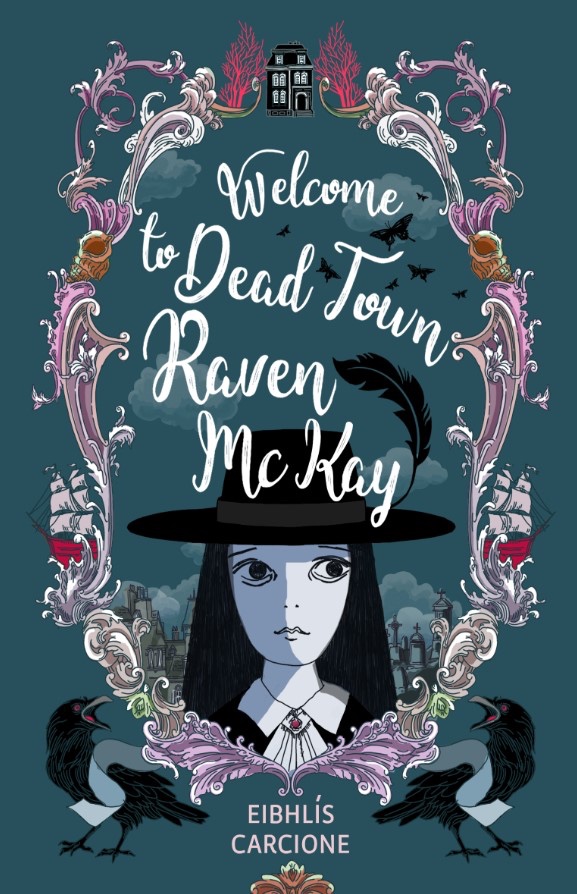 Welcome to Dead Town Raven McKay by Eibhlís Carcione, Chapter 1
Welcome to Dead Town Raven McKay by Eibhlís Carcione, Chapter 1
On her first day in Grave’s Pass, Raven McKay spotted pooka horses chasing goblins in a vacant lot, three banshees on a bus, a zombie in ripped jeans staring in the window of a phone shop, a bogeyman walking a labradoodle, a ghost on a ladder cleaning windows, a ghoul sipping coffee at an outdoor café.
Raven McKay with black hair as silky as a raven’s wing and eyes as piercing blue as
the sea in the sandy coves around Grave’s Pass, sat in the social worker’s car outside No. 28 Flower Hill. She clutched her battered beige suitcase with its faded sticker of a black butterfly and missed her parents terribly. This was her third foster home in six months. She had been in and out of Kim’s green Fiat so much, the very cherry jellybean air freshener hanging from the rear view mirror had lost its tang.
“Look Kim,” screeched Raven. “Those are pooka horses.”
The ghostly stallions galloped in the lot by an old factory, fiery smoke billowing from
their nostrils. “They’re harmless, Raven. Once you leave them be. We’ve already spoken about this.”
The shimmering coats of the horses stung her like vinegar in the eyes. What a welcome, Raven thought. One of the horses stopped and scratched the earth with a black hoof, kicking up dust, sparks, clouds of sulphur. Raven rolled down the window and pinched her nose, overcome with the stench of rotten eggs. Where was the very cherry jellybean air freshener when you need it?
“You must be warm in those clothes,” Kim said.
“A little. But you know I love these clothes.”
“Do as you wish dear. But you should take off the hat and jacket. It’s scorching.”
Raven sighed and stuck her hand out of the window. It felt heavy in the thick, sticky air. Kim was right – it was scorching but there was no way Raven was going to take off her favourite hat and jacket. She brought in her hand and sniffed her wrist. Rotten eggs. She wrinkled her nose and touched the breast pocket of her coat.
Raven took out a neatly folded paper from the pocket of her brown velvet jacket. The note her mum left. The note that was now her anchor. It kept her grounded and safe. Often just before bed, when the night seemed darkest, she would trace her mother’s handwriting with her finger. She read the words, although she knew them by heart.
Dearest Raven,
Don’t open the suitcase until the time is right. You’ll know when that is.
Love Mum xx
But of course she couldn’t help herself on the first night in her first foster home. She opened it a little. Her stomach knotted like a pretzel. She looked around at her new room in her new foster home. She was a stranger who would have to face school and a new town. She ripped it open. She ran her hands over the white, silky lining. There was nothing there.
“Oh mum.. oh dad,” Raven whispered. “Where are you? What happened to you?” She knew Kim heard her but Kim said nothing. Raven didn’t mind. Kim was a nice lady but Raven often thought Kim was tired of shunting her around from foster home to foster home. Anyway, there was nothing to say. What could she say? She didn’t know where Raven’s parents were either.
Raven never told anyone about the note. All the world knew was that Raven came home one day and her parents were gone. Vanished into thin air. The house like the Mary Celeste. The police were stunned, a mystery in a world of mysteries.
And now Raven was about to step through the doorway of another foster home. In another town. But at least this time was different, Raven thought. Kim discovered that Raven’s father’s third cousin once removed lived in Grave’s Pass. Raven was shocked to find out she had a relative, even a distant one.
Grave’s Pass was a town on a hill with narrow streets, some cobbled with ornate archways with carvings of wolves and snakes. Some streets were brightly-painted like smarties. Others were the shades of cola bottles and liquorice and some as black as the pooka-horses. Some streets were so dark and wicked that you would want to fold them like a deck of cards and put them in your pocket and forget about them forever.
Kim had already told her that Grave’s Pass wasn’t an ordinary town. Those pooka horses were probably just the tip of the iceberg, Raven thought. Raven couldn’t believe it when Kim told her about Grave’s Pass over breakfast earlier. How come her father never said where he was from? Did mum know? Was she from there? They were having breakfast in Kim’s office, eating cold, soggy takeaway pancakes from the café across the street. It was a windy, wet day, full of grey. Raven felt as miserable as the weather. Kim’s office was chock-a-block with cabinets and files of other children like Raven.
The more Kim told her, the more the pancakes felt like rocks in her mouth. How could such a town exist? A town where the living and the dead live side by side? If she didn’t see the pooka horses and the other creatures on the drive in, she wouldn’t have believed it. She wasn’t sure she believed it anyway. Now, some people might think that it wasn’t a suitable place for a foster child, but Kim kept telling Raven anywhere with family was the best place, even if that family was a distant cousin she had never met.
“Let’s go. Kitty’s waiting,” said Kim, turning off the ignition. The Fiat coughed.
Raven stepped out into the withered autumn sunlight with her suitcase and looked up at her new home, a two storey white house with a blue door. Flower Hill was so steep, there were steps on the footpath. She didn’t like the idea of trudging up such a hill but when she saw a pink-haired girl pushing a pink bicycle up the hill without breaking a sweat, Raven felt better.
The girl nodded and walked by Raven. She had only gone a few steps when she stopped and turned around. She looked cool in her polka dot top and bell bottom trousers.
“Welcome,” the girl said. “I’m Hannah.”
“I’m Raven McKay.”
“Of course you are. You look different though.”
“What? What do you mean? I’ve never met you.”
The girl smiled and Raven flashed an uneasy smile. Raven put out her hand but Hannah stared at her with ghostly grey eyes and a never-ending ear to ear grin. She flashed a peace sign with two bony fingers and continued on her way. Raven watched until Hannah and the bicycle disappeared over the top of the hill. The girl was well out of sight, those grey eyes were still crawling all over Raven.
“All set?” Kim said, nudging her. “Remember what I said?”
“I’m sorry, Kim. I didn’t want to be rude to the girl. The girl. Oh my! Is she one of them?”
Kim shrugged. “Who knows? Just leave her be.”
Kim thundered up to the doorway and knocked. Raven stood behind her and brushed off the last of Hannah’s grey eyes. A tall, thin lady with sandy hair and large freckles, in jeans and a black cardigan opened the door. There was something in her smile that put Raven at ease.
The other foster homes were like solitary confinement. She spent her time in her box- sized rooms except for meal times when her legs shook so much the cutlery rattled and she thought the table would break and everything would end up on the floor in a big mess. Her stomach was so nervous she didn’t taste the food. But she had to eat. She had to have energy to sit in a class with strangers all day. There was a foster girl silence, which meant that as soon as the other kids had gobbled their food, which was different to hers ( all the things she liked — pizza, pasta, couscous and curry) they rushed from the table to the sofa to watch TV, usually having tea and chocolate biscuits there. Why were mincemeat and gravy-soggy, mashed potatoes, the staple food for foster kids? Why did the custard and strawberry jelly never taste like the custard and jelly she had at home?
“Hello Raven. I’m Kitty Stromsoe. Welcome to Grave’s Pass. Welcome to Flower Hill. Welcome to your new home.”
“Hi Kitty. Thanks for having me.” Raven knew the routine by now. Smile and be polite.
Thank them for everything, but don’t tell them everything. She didn’t tell her that she cried most of the way. Never let them see you cry. This would be her third foster home in six months and she would be going to another new school. Raven had been mocked about her one crooked front tooth in her last school. One tooth, one little thing, one little imperfection that made her school life a misery.
Kim whispered something to Kitty. Kitty laughed. Raven was sure it was about her. All she wanted was to be back home in Glentown with her mum and dad. Where had Ross and Aria McKay gone? She hoped they weren’t in danger. They wouldn’t just abandon their 12- year-old daughter. She thought of all the nights they tucked her into bed and kissed her goodnight. She thought of the heavy snowfall last winter and the giant snowman they made together.
“She’s very excited,” said Kim, handing Raven’s purple rucksack to Kitty. Raven carried her beige suitcase to the door.
“I have margarita pizza and garlic bread for you, Raven. I know it’s your favourite dinner.”
Kim turned to Raven and shook her hand. Raven wasn’t expecting a hug or anything but a handshake seemed cold. “Good luck Raven,” said Kim. “I know you’ll be happy in your new home.”
Raven suppressed a sigh. Kim was just doing her job rehearsing lines she probably practiced in front of an office mirror. Before Raven knew it, the Fiat spluttered into life and Kim was off with a sickly beep beep of the horn. Raven stood alone on a new doorstep. She squeezed her eyes. She didn’t want Kitty to see her cry on the first day.
Small Bites Back Blog Tour
16 May 2023

I’m delighted to welcome author Hannah Moffatt to my blog today. She’s the author of the brilliant Small series – hugely funny books featuring Harvey Small, an ordinary boy muddling along in a world of giants, trolls and vampires. Hannah has written a brilliant guest post about the joy of watching characters grow.
 Hannah: When I finished writing SMALL! I knew there was still plenty of story for a sequel. After all, I’d deliberately left the door wide open for the Ring Mistress of the Unspeakable Circus to come back and cause trouble.
Hannah: When I finished writing SMALL! I knew there was still plenty of story for a sequel. After all, I’d deliberately left the door wide open for the Ring Mistress of the Unspeakable Circus to come back and cause trouble.
But I was less sure I’d left room for Harvey to go on another emotional journey. I’d loved taking him from the worrying boy who blamed himself for his parents’ divorce to the giant-saving hero he became at the end of book one. So, where next?
It took a while for me to realise that believing you’re meant to be a hero could be just as tough (if not tougher) than believing you’re bad luck. Eventually, it was learning to live up to the fortune-teller-in-the-cellar’s heroic prediction, and realising that he didn’t have to solve every problem solo, that gave Harvey room to develop in the sequel.
I love watching characters grow – in my own stories and other people’s. Here are three emotional character journeys I’ve really enjoyed recently.
Charlie finding the fire to be a big brother in The Last Firefox, by Lee Newbury
The Last Firefox is positively brimming with heart. When we first meet Charlie, he’s anxious he won’t have what it takes to be a good big brother if his dads adopt again. By the end of the story, he’s fought a magical monster (and his own worries) to become a de facto big brother to a firefox cub. It’s a joy.
Michael learning stars and sidekicks need each other in Michael the Amazing Mind-Reading Sausage Dog, by Terrie Chilvers
Michael the sausage dog believes he’s got star quality, even before he learns to read minds. But his bumpy road to Hollywoof fame teaches him valuable lessons – including the ability to share the limelight, bounce back from setbacks and be a good friend to his utterly adorable assistant, Stanley Big Dog. It’s the perfect growth mindset story. (I was lucky enough to get an early read of this one, but it’ll be officially out in the world on 8 th June.)
Leeza, somehow saving the town in HappyTown Must Be Destroyed, by James Harris
When we first meet Leeza, she can’t even decide which flavour ice cream to order – let alone hatch a plan to save her entire town from an alien invasion. But as the alien take-over grows and sensible grownups are in short supply, Leeza eventually learns how to step up. It’s an hilarious read, with surprisingly heartfelt musings on what it really means to be happy
Get Kids into Books: Thank you so much for joining me today.
The Pawnshop of Stolen Dreams Blog Tour
9 May 2023
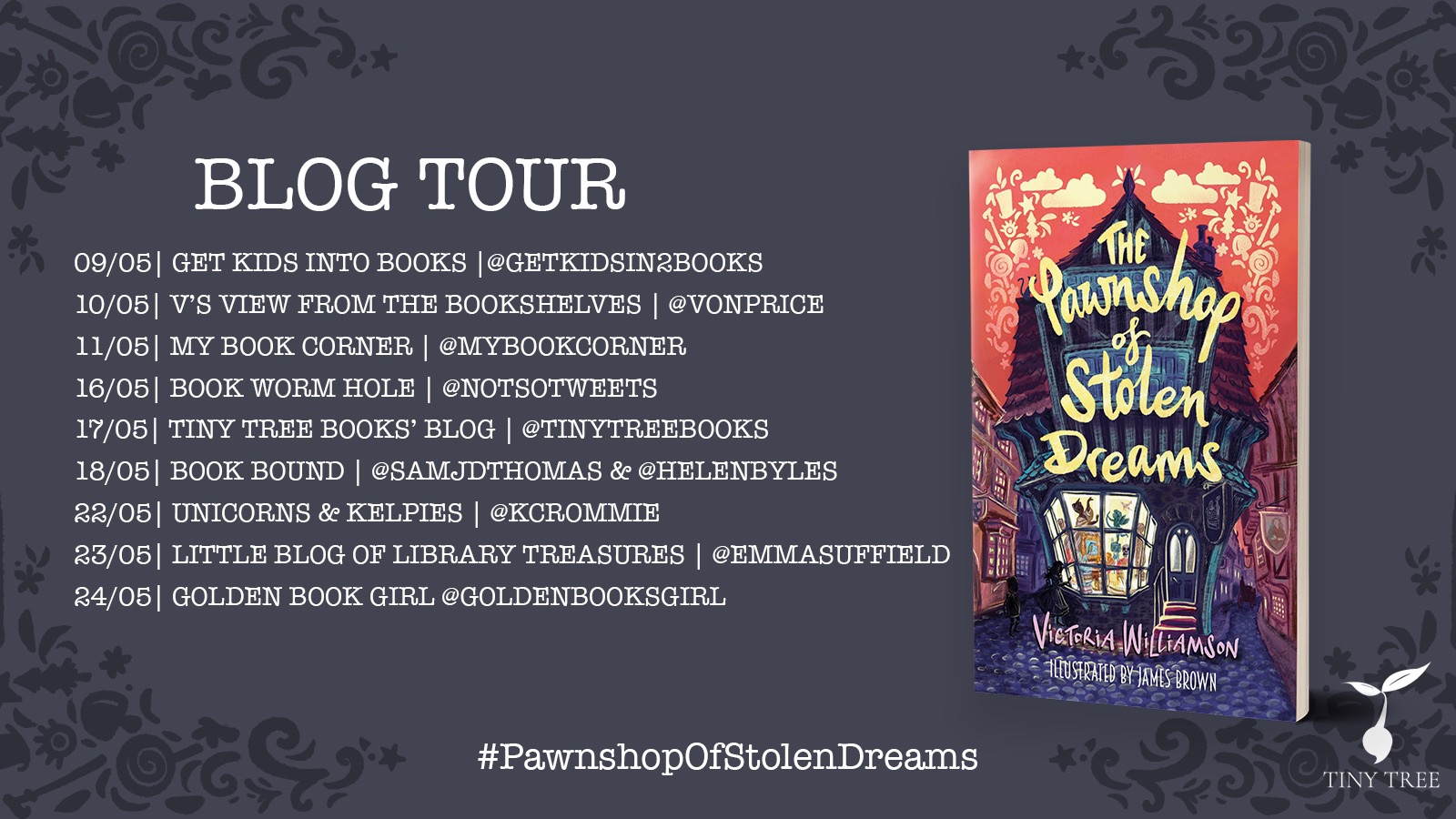
I’m honoured to kick off the blog tour and share my review of this original, eerie, fantasy adventure.
The Rescue of Ravenwood Blog Tour
27 April 2023
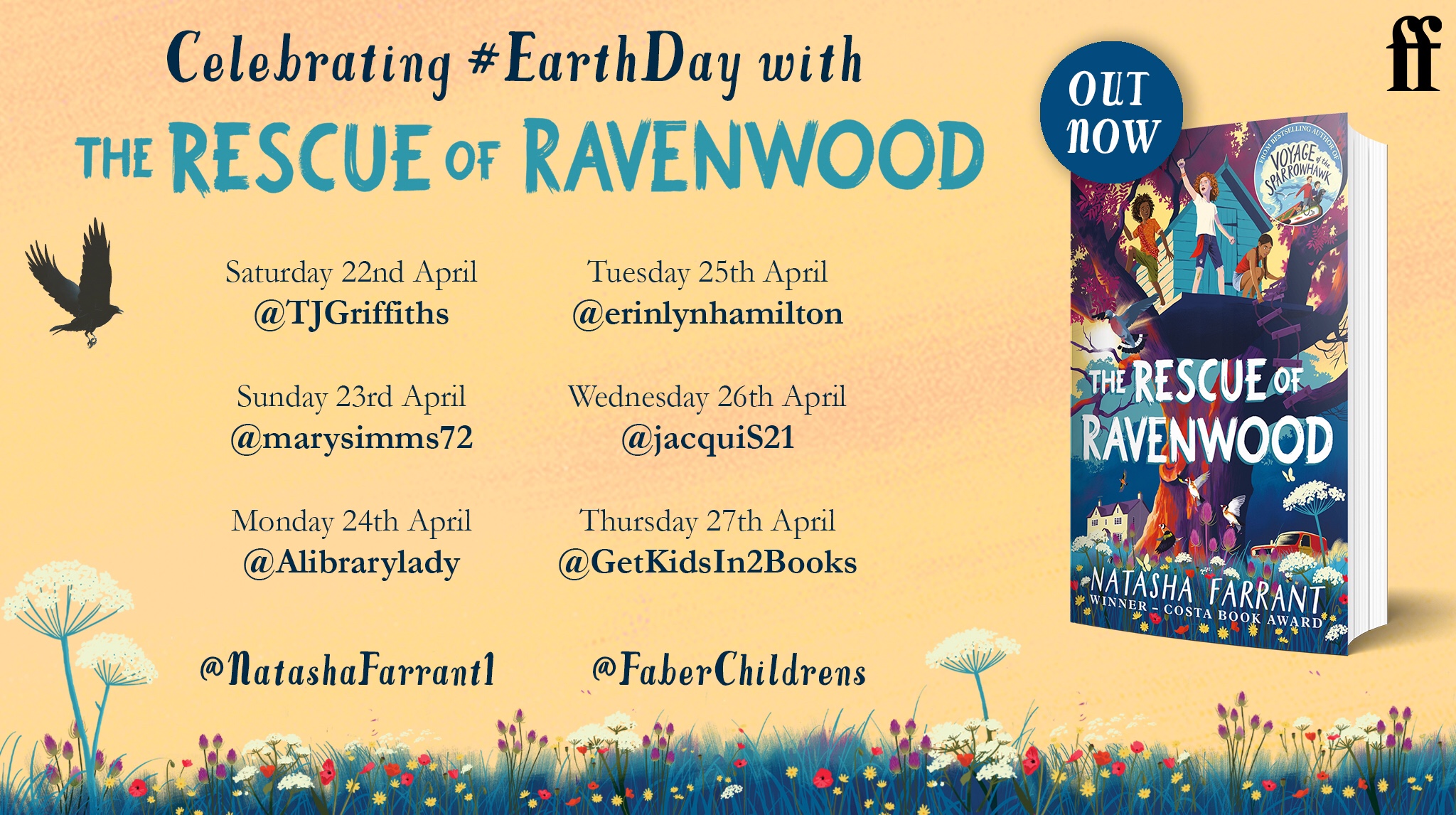
I thoroughly enjoyed this wonderful story of friendship and family, and the meaning of home. It’s a privilege to be part of the blog tour. Here’s my review in full.
Lost on Gibbon Island Blog Tour
22 April 2023
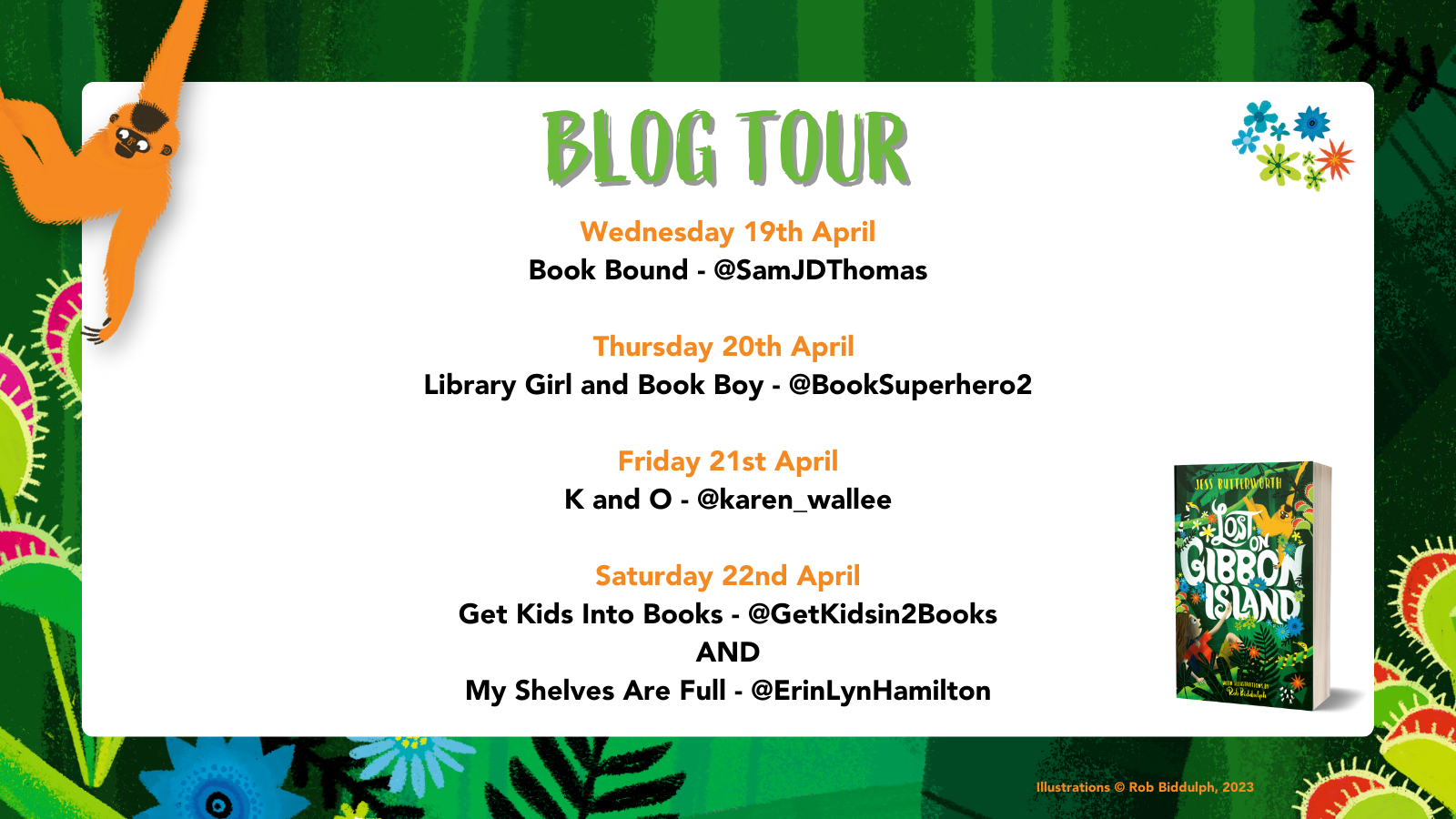
I’m delighted to be part of the blog tour and share my review of this exciting, action-packed eco-adventure.
Interview with Blackbeard Blog Tour
18 April 2023
I’m delighted to welcome Andy Seed to my blog today to talk about the latest book in his Interview With… series.
Get Kids into Books: This book is part of a very popular series, why do you think the interview format has been so successful?
Andy: Interviewing someone is a great way to find out about their life, which is why interviews are so popular on TV, radio etc. They work in books too, and one of the things that makes them so appealing is that we, as readers, get to hear the interviewee’s POV. So, for example, with a villain such as Guy Fawkes, we find out why he’s trying to blow up the king, or we discover how gangsters such as Bonnie and Clyde got into crime (they grew up in extreme poverty, as it happens). The Q&A format is also easy to read, fun, and allows for the subject’s personality to shine through too. The pictures by Gareth Conway are great, too.
Get Kids into Books: Which interview did you have the most fun writing?
Andy: I really enjoyed meeting the powerful Chinese pirate commander Zheng Yi Sao, even though she ordered her men to chop my arm off! She was amazing, leading a fearsome force of 17,000 pirates and 227 ships in the early 1800s. She was clever too, never being captured. One of the joys of these books is playing with the time-travel element. So, for example, the Royal Navy were Zheng’s enemy so when she hears my British accent on her ship at the start of the interview she assumes I am a spy and orders her henchmen to hack me to pieces. They start lopping limbs but I manage to get to my tranimalator (time travel machine) just in time and go back another hour, so disappearing, then reappearing – with 2 arms and once more unknown to Zheng, to try again with the interview in a disguised voice. Tons of fun!
Get Kids into Books: Were there any villains that you wanted to include but who didn’t quite make the cut?
Andy: Most definitely. People like Al Capone, Lord Haw Haw, and gangster Ma Barker were considered but we wanted to make sure we covered lots of places and different periods of history too.
Get Kids into Books: How do you set about doing your research?
Andy: It’s all about reading lots of different sources and making notes. The internet cannot be trusted with information at times, so it’s essential to check your facts with a trustworthy source such as a history book written by an expert. The public library service is invaluable for authors like me! Once I have lots of good notes I go about selecting the parts that I think are vital to include, plus other bits which will make for some entertainment and a wow factor.
Get Kids into Books: If you could interview anyone alive today who would it be?
Andy: Personally, I think dead people are much more interesting! Especially those who lived long ago because, of course, the world was very different then and we can learn so much from their lives. But, to answer the question I think that some of the most fascinating people alive today are very old people who’ve lived through all kinds of events such as wars and the changes brought about by the arrival of things like TV, cars and computers. It’s so interesting when they tell you about their childhood.
Get Kids into Books: Who do you plan to interview next?
Andy: Ah, I love art, so my next interview is with the amazing Vincent Gogh, plus other spectacular artists such as Mary Cassatt, Leonardo da Vinci and Hokusai. They’re all staggered when I tell them how popular and famous they are in the future. It’s also fun to learn how they created their wonderful pictures.
Get Kids into Books: Andy, thanks for joining me today and for sharing such a fascinating insight into your writing.
The Way of Dog Blog Tour
22 March 2023
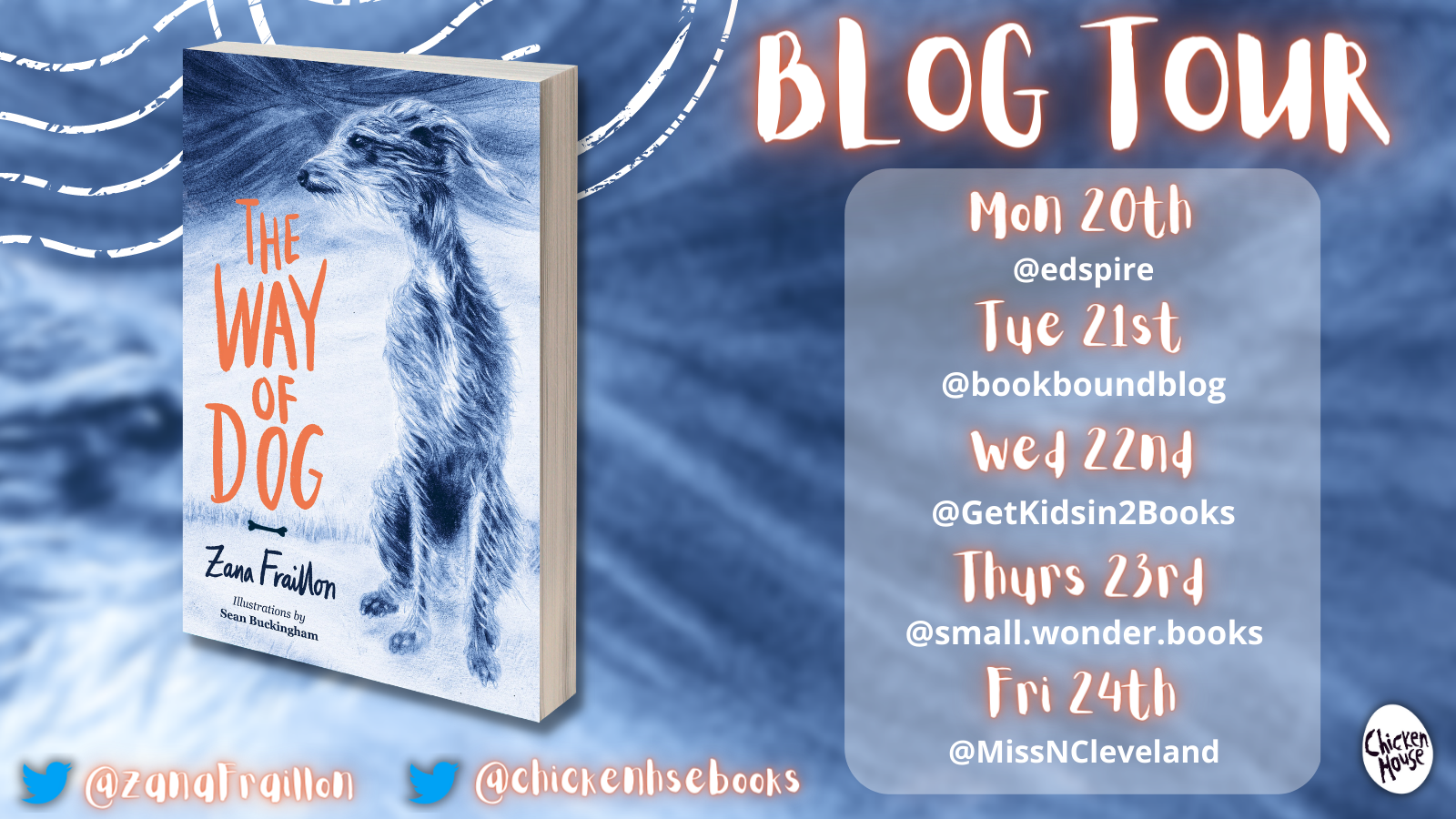
It’s a privilege to be part of the blog tour for this remarkable book. The Way of a Dog is told in verse from the point of view of an amazing orphan puppy called Scruffity. It’s a heart-breaking and deeply poignant novel. I loved it. You can read my full review here.
Rivet Boy Blog Tour
22 February 2023
It’s a pleasure to be part of the blog tour for Barbara Henderson’s latest historical novel for midddle grade readers. Rivet Boy is a terrific story about finding courage, facing your fears and forging your own future. Read my full review here.
The Time Tider Blog Tour
15 February 2023

 I’m delighted to welcome author Sinéad O’Hart to my blog today. Her latest MG book, The Time Tider, is an exciting and original fantasy story set in Ireland. Here she talks to me about story settings and why her books usually have some connection to Ireland.
I’m delighted to welcome author Sinéad O’Hart to my blog today. Her latest MG book, The Time Tider, is an exciting and original fantasy story set in Ireland. Here she talks to me about story settings and why her books usually have some connection to Ireland.
Sinéad: Along with character and plot, a book’s setting is vital to its functioning. Every aspect of making a new story is fun (at least, I think so – there’s nothing I like better than coming up with a tale never told before), and for me, getting to know my characters is probably the best part, but not far behind that is deciding what sort of world these newborn characters are going to live in. Will it be basically contemporaneous (set at the same time and place) as your own reality? Will it be futuristic? Will it be set in the past, with all the research that might entail? Will the world be entirely fantastical, or will it have realistic elements, or a mixture of both? You’ve got to think about power structures, ways for people to earn a living, the logic and rules behind your setting, what sort of environment and conditions your characters find themselves in and how they deal with that, the limitations and advantages of your setting – even if most of this doesn’t make it on to the page. It all helps to create and sustain a world for your characters that seems as real as they do, and which breathes along with them.
Sometimes, the same or similar settings can be used over and over in books, by which I mean different authors make similar choices in the sort of world they put their characters in. Victorian England is a popular choice – and why not? It was a time of immense social and economic development and excitement, when the world seemed like a well-oiled machine and innovation was in the air (at least, for some…) So, a setting like this naturally lends itself to writing books full of adventure and invention, conquest and discovery and newness. In recent years, too, we’ve had children’s books which take the Victorian England setting and use it thoughtfully, as a way to critique social and economic inequality, and to examine the dark side of success on the home front, which was the spectre of colonialism and the toll it took on other parts of the world. So, on lots of levels, using a setting like Victorian England, even if you embellish it – as many have, with great success – into a time in which things existed that didn’t exist in reality, can work extremely successfully. My own books The Eye of the North and Skyborn have a sort-of Victorian feel, though it’s a Victorian era that didn’t exist in any reality on Earth. It’s a Victorian setting where mythical creatures are also found, and where elaborate airships, including one that runs on clouds, are used to get characters from A to B (with a quick detour to the outskirts of space!)
But what my books have, as well as a sort-of Victorian feel, is a sprinkle of Irish in their setting. The Eye of the North sees our heroine, Emmeline Mary Widget, living with her family in Widget Manor, which is situated near Belfast, in Northern Ireland. Most of the rest of the action takes place in other countries, but it was important to me that Emmeline came from the same island (or, as it is in my book, more of an archipelago) as myself. My second book, The Star-Spun Web, is wholly set in Ireland; in fact, it’s set entirely in one Irish city – the capital, Dublin. In the book, we have a ‘real’ version of Dublin as it was in 1941, the year the story takes place, and a fictionalized, fantasy, alternate Dublin, where it’s also 1941 but where almost everything else is different. This city is called ‘Hurdleford’, because when you translate the Irish name for Dublin (‘Baile Átha Cliath’) into English, you get ‘town of the hurdled ford’, and one of the main sites of the action in the book is a place called Fairwater Park. In Dublin, there is a park known as the Phoenix Park, which is (to my knowledge) the largest enclosed urban green space in Europe– and in Irish, this park is called ‘Páirc an Fhionnuisce’. ‘Fhionnuisce’ sounds a little bit like ‘Phoenix’, but its actual meaning is ‘fair water’ or ‘bright water’. There are several of these linguistic references in the book, and I had a lot of fun imagining what Dublin would look like if several major historical events had not happened, including Ireland’s separation from British rule. And then in Skyborn, a book which accompanies the story told in The Eye of the North, we have a character named Cornelius Crake who works as a circus strongman. He has a tattoo of his home country, which is called Hibernia in the story – Hibernia is an old name for Ireland. The country is shown as being a series of islands, instead of one larger island, because of rising sea levels. If I had to pick a favourite character out of all the fictional people I’ve created, I think Crake would be somewhere near the top. For me, his Irishness is as much a part of who he is as his performance leotard, and his beard-plaits, and the anvils he likes to throw around.
 When it came to finding a setting for The Time Tider, I knew it had to be Irish once again. It’s important to me, as an Irish writer, to show the landscape I’m familiar with in my books, and to depict my own country in the tales I tell. Lots of stories are set in Britain, or America, and I wanted to give my own little island a fair chance. So, the tale of Mara and her dad Gabriel and their strange, on-the-road life is based in Ireland. It starts off in Dublin; the opening chapter sees us meeting Mara on Dublin’s O’Connell Street, and she and her father drive to the wilds of Wicklow in the next chapter. Their journey continues south, until they pass the village of Bunclody, in Wexford, which is called by its former name –Newtownbarry – and on through Enniscorthy to Wexford town. In the book, Wexford is called ‘Whiteharbour’, as in Viking times, the town was called Veisafjorðr. This means something like ‘inlet of the mudflats’, but to me, it sounded like ‘White Harbour’, and so the name was born. Wexford still has those sandy mudflats, which are briefly described as Mara and her dad drive past them. The town of ‘Port Ross’ is the scene for some of the book’s action, too, and this is based loosely on the real town of New Ross. Wexford is my home county, and it gave me a lot of happiness to imagine my fantastical, time-bending tale taking place there.
When it came to finding a setting for The Time Tider, I knew it had to be Irish once again. It’s important to me, as an Irish writer, to show the landscape I’m familiar with in my books, and to depict my own country in the tales I tell. Lots of stories are set in Britain, or America, and I wanted to give my own little island a fair chance. So, the tale of Mara and her dad Gabriel and their strange, on-the-road life is based in Ireland. It starts off in Dublin; the opening chapter sees us meeting Mara on Dublin’s O’Connell Street, and she and her father drive to the wilds of Wicklow in the next chapter. Their journey continues south, until they pass the village of Bunclody, in Wexford, which is called by its former name –Newtownbarry – and on through Enniscorthy to Wexford town. In the book, Wexford is called ‘Whiteharbour’, as in Viking times, the town was called Veisafjorðr. This means something like ‘inlet of the mudflats’, but to me, it sounded like ‘White Harbour’, and so the name was born. Wexford still has those sandy mudflats, which are briefly described as Mara and her dad drive past them. The town of ‘Port Ross’ is the scene for some of the book’s action, too, and this is based loosely on the real town of New Ross. Wexford is my home county, and it gave me a lot of happiness to imagine my fantastical, time-bending tale taking place there.
I’m sure most books have a setting that their authors have thought deeply about. Maybe some of them even use puns, or translations of place-names, to good effect in their work, just as I have. So, next time you’re reading a story and the setting is interesting or different, make sure to do a little digging and see what you can find out. Hopefully, you’ll uncover some fascinating facts that will make the book even more wonderful!
Vita and the Gladiator Blog Tour
6 February 2023
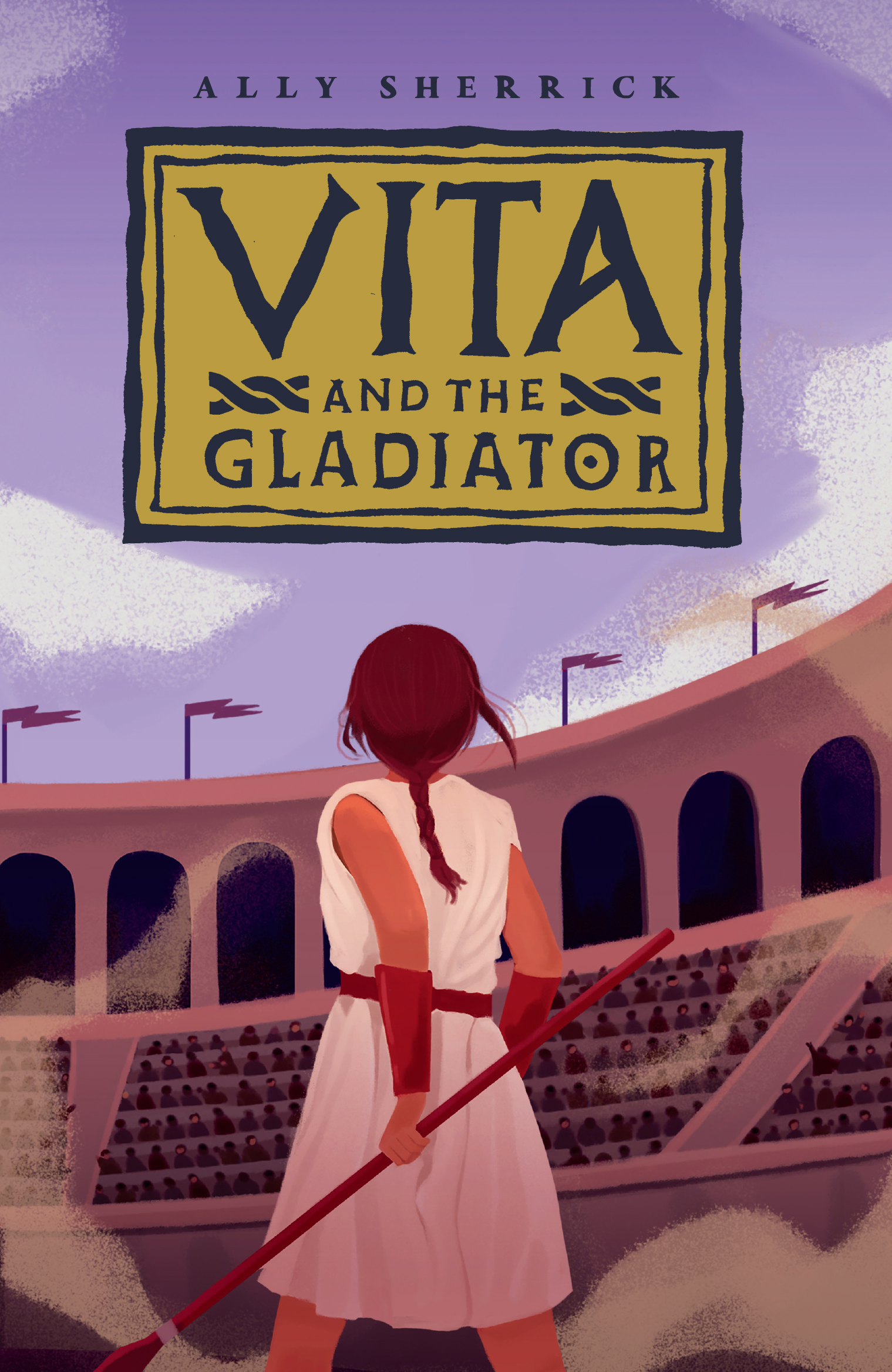
I’m delighted to kick off the blog tour for the gripping and action-packed Vita and the Gladiator. Click here to read my review.
The Song Walker Blog Tour
31 January 2023
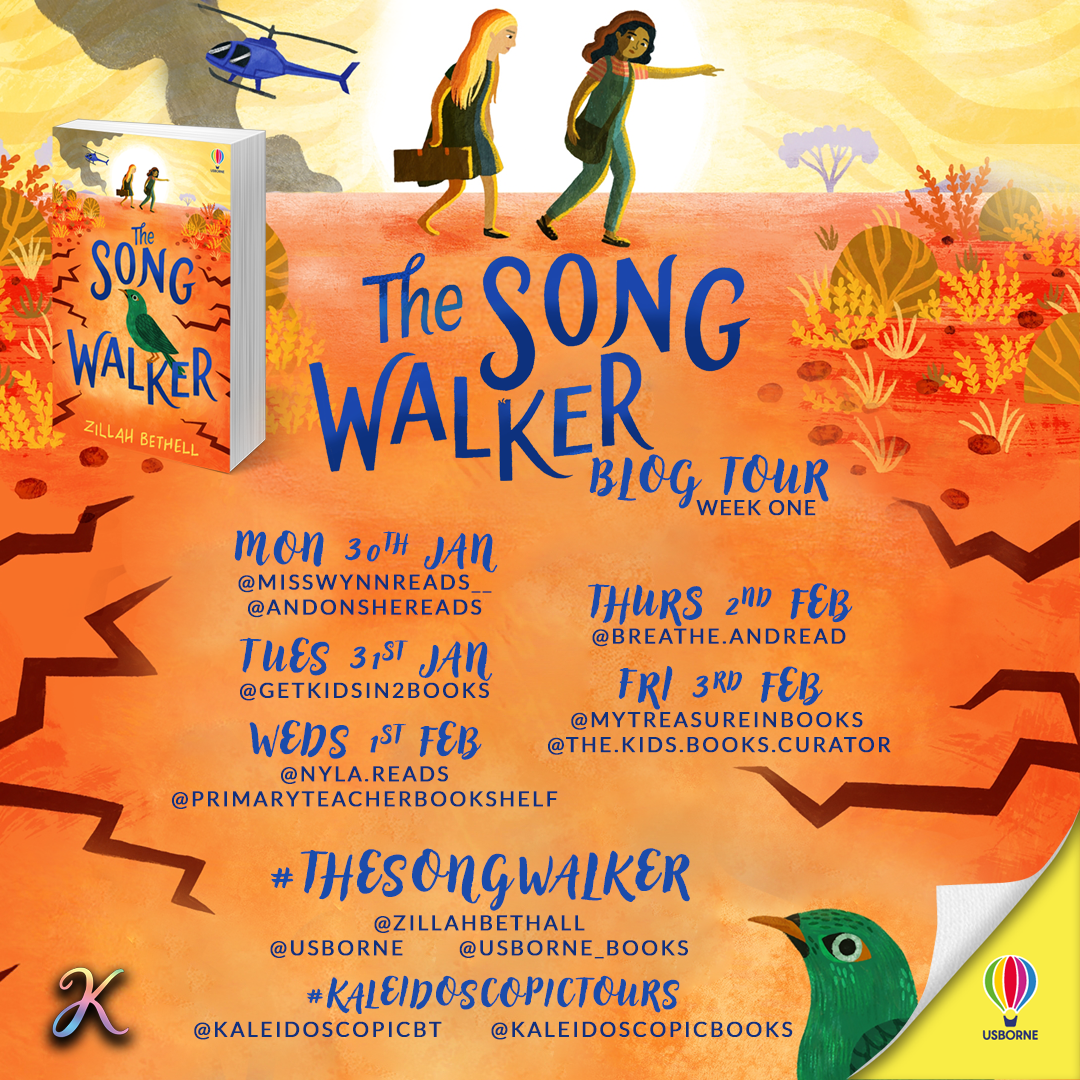
I’m honoured to be part of the blog tour for such an incredible book. Full of heart, heritage and what makes us human, The Song Walker is storytelling at its best. Read my full review here and get your hands on a copy if you can.
National Non-Fiction November Blog Tour
13 November 2022
Every November we celebrate the wonderful world of children’s non-fiction. I’m honoured to have been invited by the Federation of Children’s Book Groups to review Human Kindness as part of their book review blog tour for National Non-Fiction November.
The Faber Book of Bedtime Stories
Blog Tour, 11 November 2022
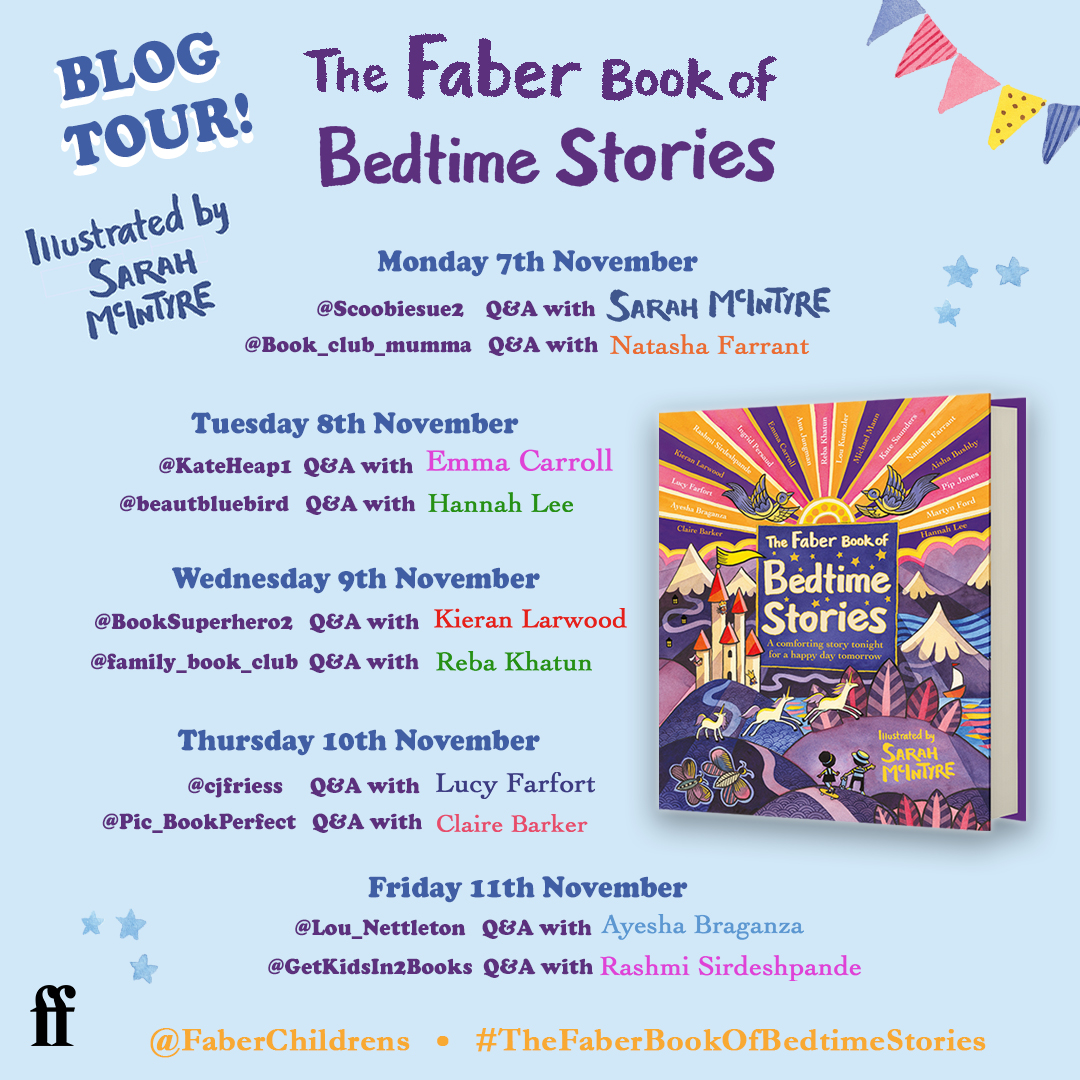
I’m delighted to welcome author Rashmi Sirdeshpande to my blog today. She’s one of the fabulous authors who have contributed to a brilliant anthology of bedtime stories that has recently been published by Faber & Faber. Rashmi’s story is the last in the anthology but was actually the first one that my son and I read. Its title and premise, When Bedtime was Cancelled, immediately appealed to us. As did the unicorns and their fabulous names. Partycorn, Snackicorn and Slumbecorn – what’s not to love?
 Tell us about your story
Tell us about your story
In When Bedtime was Cancelled, unicorns have always been in charge of bedtime, sending out sleepy vibes so we can all get some rest. But when the mighty Slumbercorn retires as The Boss of Bedtimes Absolutely Everywhere, the mantle passes to Partycorn who has her own ideas about how things should work. Yep, you can guess where this story is headed. It’s up to her little sister Sleepycorn to find the courage to stand up to Partycorn and SAVE bedtime before it’s too late!
What was your favourite bedtime story as a child?
At bedtime, I loved hearing about ancient Indian myths and legends – stories of gods and goddesses and incredible warriors!
Rashmi, thanks for popping by my blog today.
You can read my review of The Faber Book of Bedtime Stories here.
The Last Whale Blog Tour
1 November 2022
The Last Whale is an expertly plotted, character-driven story with a hugely powerful environmental message and taut action scenes. It’s a powerful environmental call to arms and an exciting, thought-provoking book. Read my full review here.
Tiggy Thistle and the Lost Guardians
Blog Tour, 31 October 2022
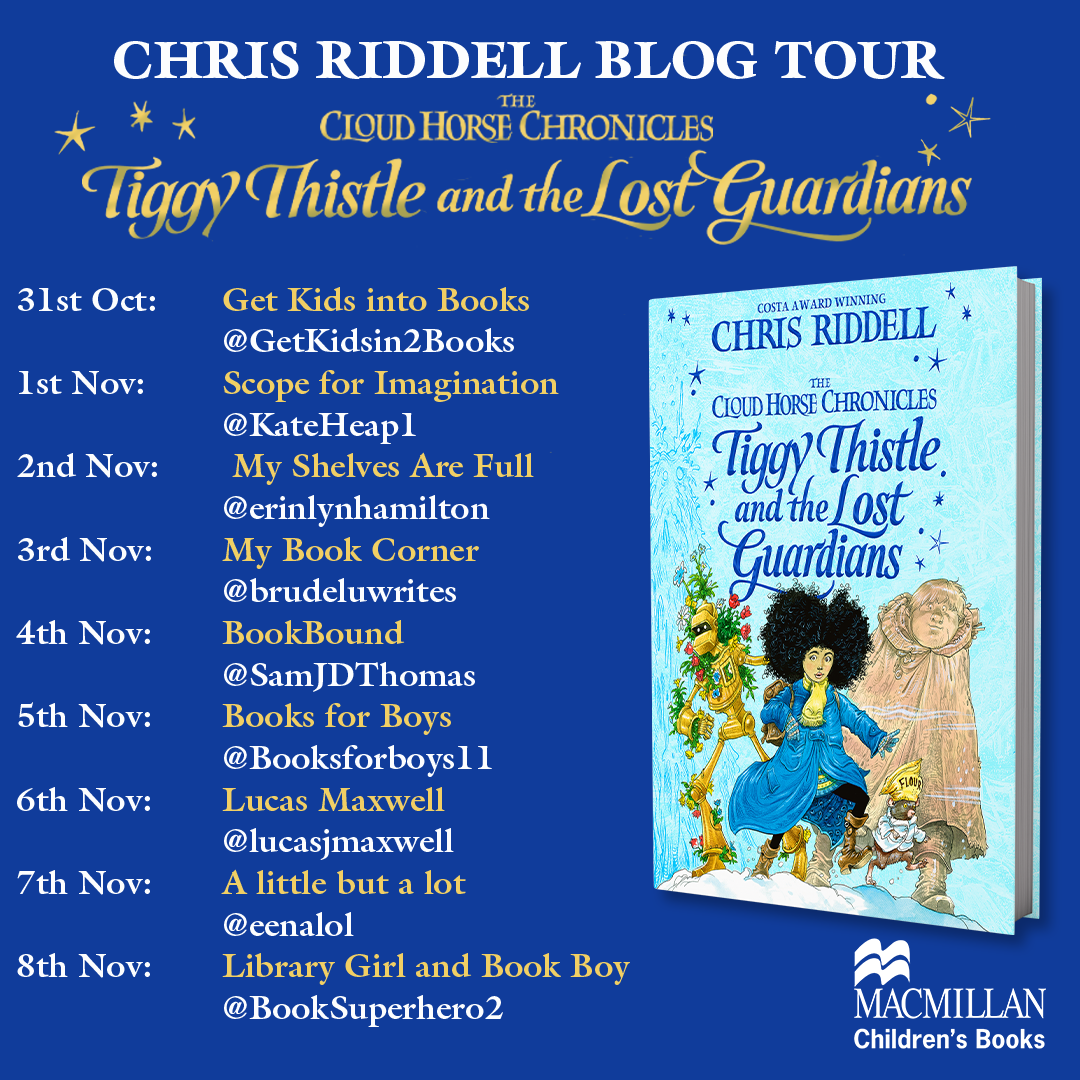
Chris Riddell has done it again: more incredible world building, magic, imagination and originality. I’m delighted to share my review of book two in the Cloud Horse Chronicles series.
Where Does My Food Come From?
Blog Tour, 14 October 2022
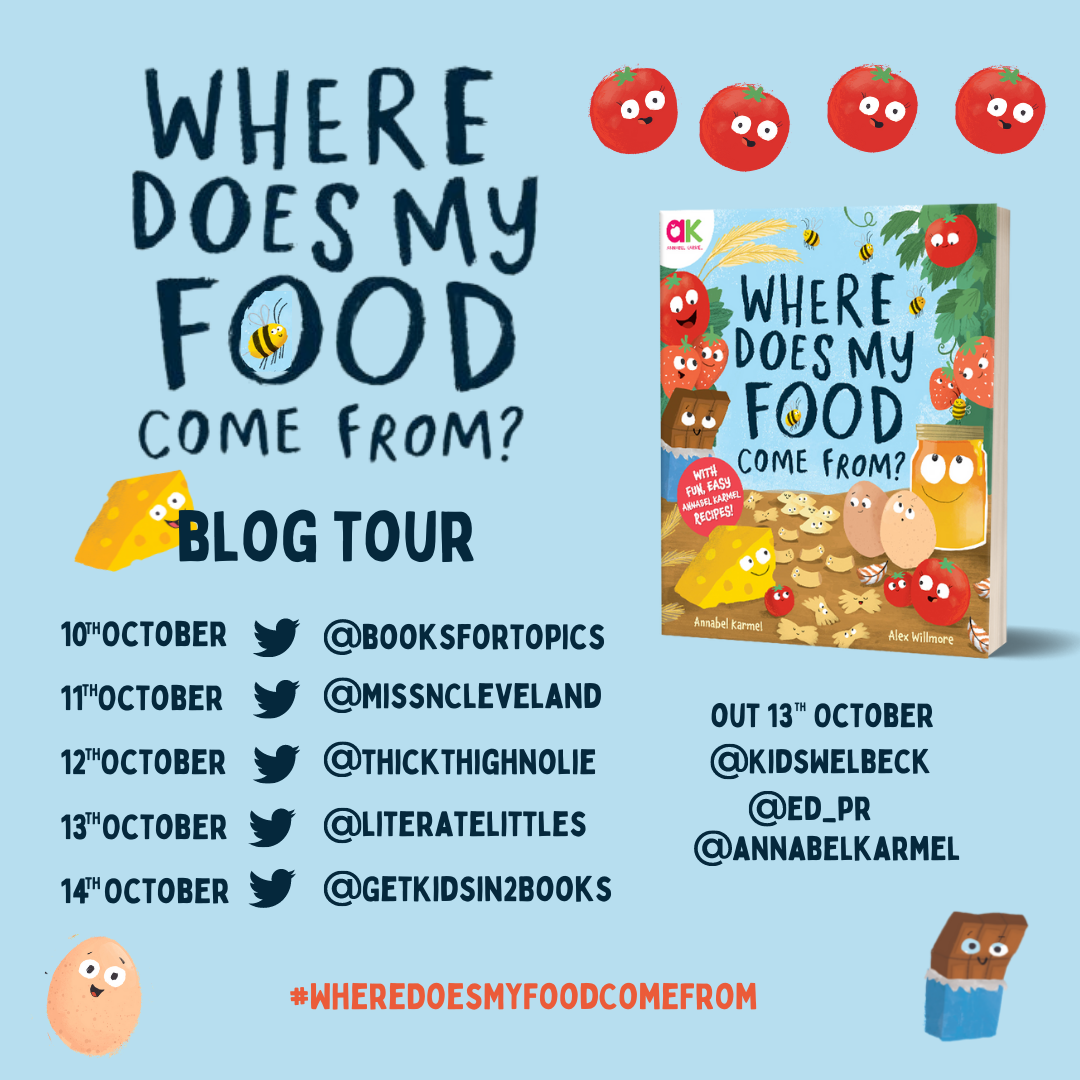
The guru of baby and toddler mealtimes, Annabel Karmel, has written a picture book which combines kid friendly recipes and craft activities, alongside information about where some of our food comes from. Hop over to read my review to get a taste of this brilliant book.
No Place for Monsters Blog Tour
13 October 2022

I’m excited to be part of the blog tour for this thrilling horror story with Stranger Things vibes. You can read my full review here.
The Boy Lost in the Maze
Blog Tour, 6 October 2022
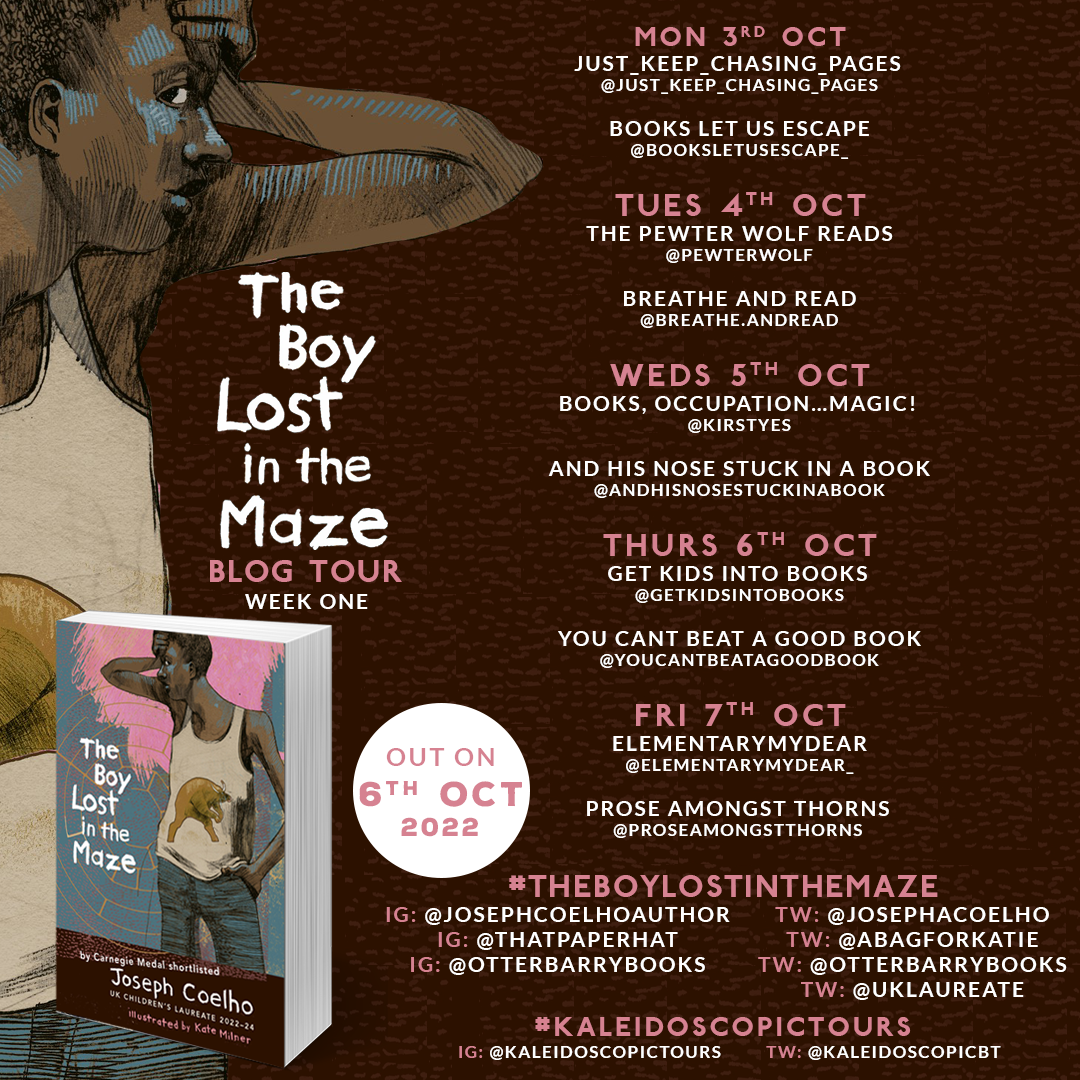
The Boy Lost in the Maze publishes today and I it’s a privilege to be part of the blog tour for such a fantastic book. First off, I love the premise for the story: two boys separated by time and place but treading similar paths through life. Both are searching for their fathers, and both are on a journey of self-discovery as they navigate the transition from boyhood to manhood. The blending of Greek myth with a contemporary quest story is really effective and I love that this is a verse novel. Powerful themes, important questions and compelling storytelling made this a book I couldn’t put down. My full review will be posted soon. Here’s a short extract from the book:
THESEUS
This is Theseus
son to a Hero king
who he nEver met
On turning Sixteen
truth is revEaled to him
his mind is tUrned to travel
he decides to Seek his father.
The Girl,the Ghost and the Lost Name Blog Tour
29 September 2022
Read my review of this gripping and hugely entertaining début here.
The Ultimate Seasonal Lunchbox
Blog Tour
28 September 2022

Lunches never need be boring again! Discover more about this recipe book on my stop on the blog tour.
Gender Swapped Greek Myths Blog Tour
18 September 2022

What a treat to champion the second book in this incredible series. You can read my review here.
The Story of Green River Blog Tour
6 September 2022

I’m delighted to welcome author Holly Webb to my blog today to talk about the setting for her wonderfully lyrical new book, The Story of Green River. I absolutely loved this book and was swept up in Silken and Sedge’s riverside world, which had echoes of The Wind in the Willows. Just like Holly, I grew up poring over the illustrations in Brambly Hedge and the cut throughs were – and still are – a particular favourite of mine too. It’s fascinating to hear how these also provided inspiration for the story setting.
Holly: I’ve been wanting to write about otters for a very long time – but I’m almost as excited about the river setting of The Story of Green River as I am about the characters. (Spoiler – the river is actually a character too…) My favourite literary river is in The Wind in the Willows (it’s no accident that the entrance to Greenriver Holt is in a huge and ancient willow tree). I live just outside Reading, within walking distance of the Thames, and not that far from Cookham, where Kenneth Grahame lived, and which inspired the riverbank setting in The Wind in the Willows. I love walking along the river – there are otters back in the Thames now, and one of these days I’ll see one…
So much of what I write is inspired by the books I read as a child (there were a lot of them), but I think that illustrations may have had more to do with creating the otters’ home than words. I spent hours and hours finding all the tiny details in Jill Barklem’s Brambly Hedge books, stories about mice who live in a hedgerow by a stream. I especially loved the cut-throughs, where you could see each tiny room in the Store Stump or Crabapple Cottage.
Both Brambly Hedge and The Wind in the Willows share a wonderful sense of security. I think it’s partly to do with the quiet, cosy nature of the homes hidden away in tree stumps and the riverbank. I was really excited to create a setting that seemed idyllic, but was hiding secrets and danger beneath the quiet surface. Sedge, my young otter growing up at Greenriver Holt, finds the safety of his riverbank home stifling. He’s desperate for adventure – and he knows deep down that the holt has never been as safe as it seems. He just can’t remember why.
I loved playing the beauty of the river setting off against the dangers of the water – particularly the danger for young otters, who aren’t born able to swim. They’re uniquely at risk when a river rises and floods their holt dug into the bank. The Greenriver otters’ beautiful home leads to another risk too – it’s so perfect that the otters have become complacent, and insular, and they see the other creatures along the riverbank as a threat.
Otters in my story particularly distrust the beavers who live further down the Greenriver – and the beavers think the otters are terrifying creatures. But the two groups hardly ever see each other, and rely on rumours and stories, often twisted to keep them apart. I spent ages researching beavers’ incredible engineering (far longer than I should have done really, I don’t have a good brain for technical diagrams, despite all those Brambly Hedge cut-throughs!) It’s fantastic that groups like the Beaver Trust and the Wildlife Trust have been so successful at reintroducing beavers around Britain. Beaver engineering reduces flooding, and they even help to create wetland areas that capture carbon! Working on The Story of Green River, it was wonderful to be able to write about two such different river communities that were both inspired by real animals that live here, often incredibly close to humans.
I’m so hopeful that readers will share that excitement about the river – when our rivers and seas, and the animals and birds that live in them are so at risk right now. Places that you feel you know, you love and you remember, are the places you want to protect.
Key Player Blog Tour
2 September 2022
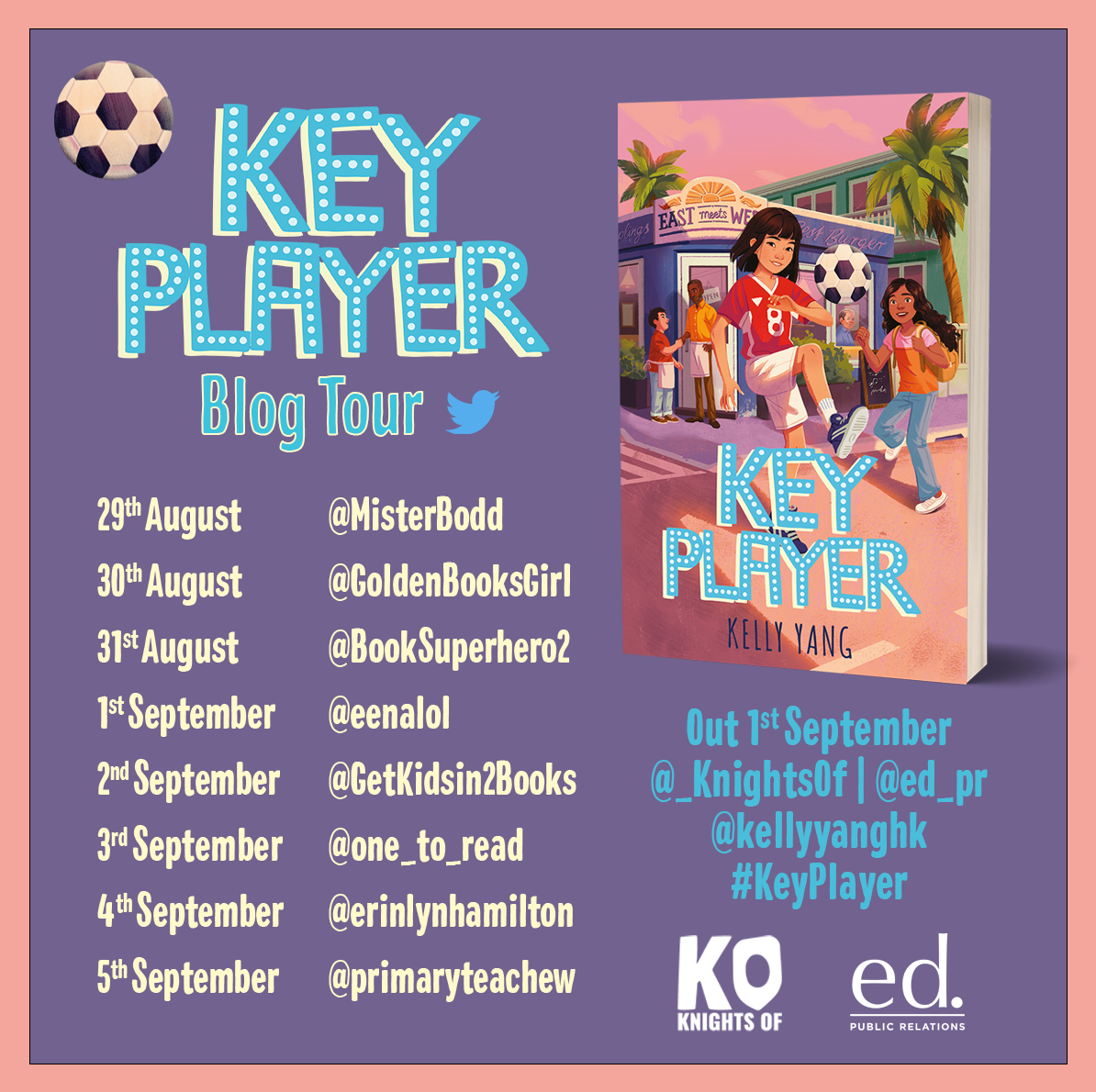
I’m thrilled to keep women’s football fever going and share my review of the fantastic Key Player.
Ember Shadows and the Fates of Mount Never
Blog Tour, 17 August 2022
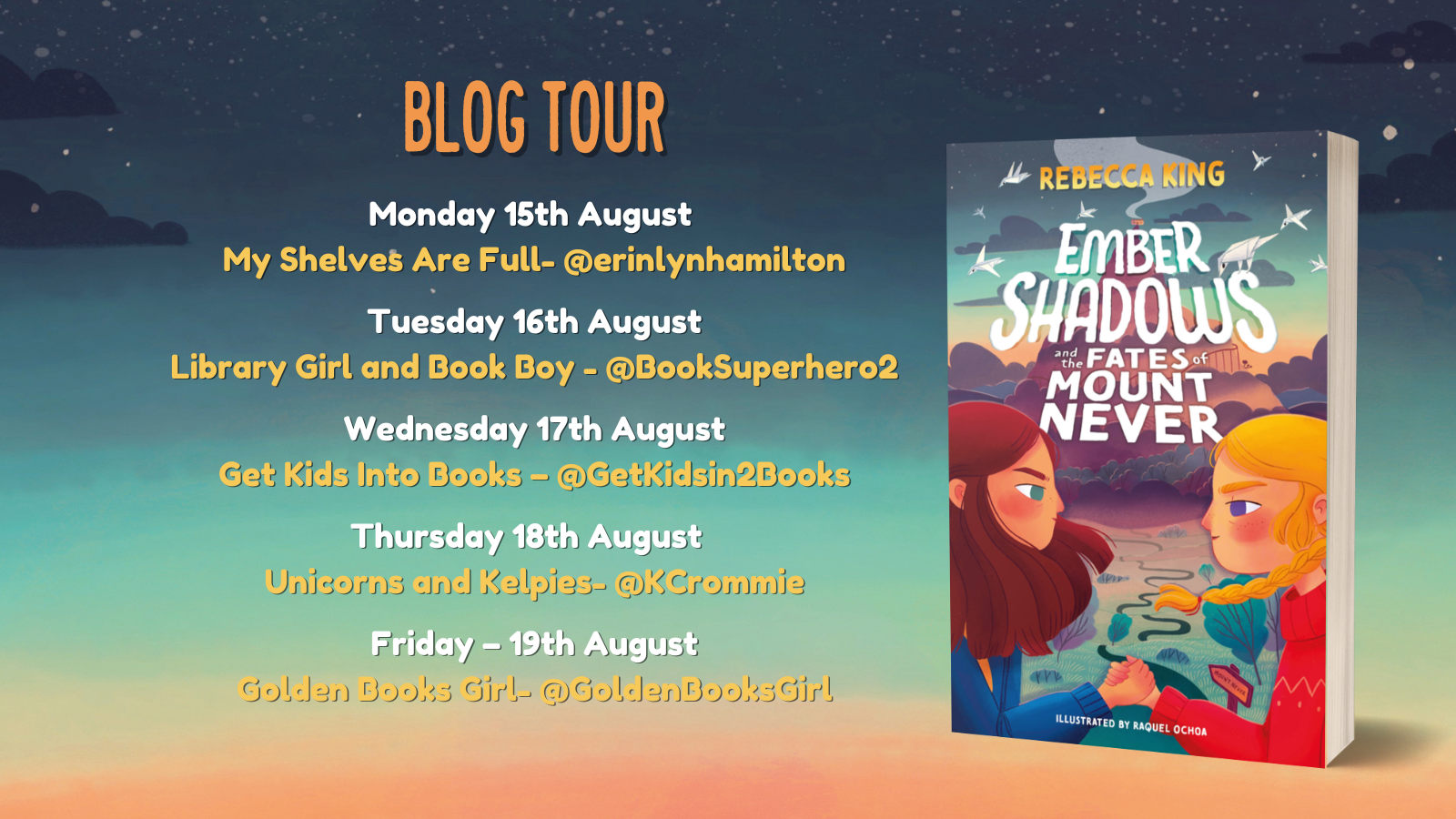
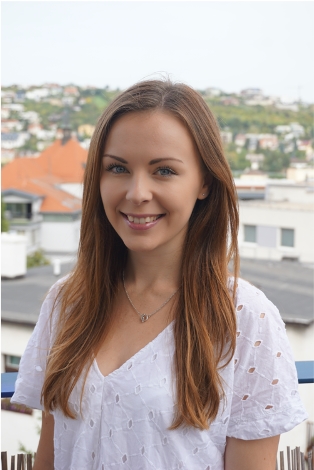 Ember Shadows and the Fates of Mount Never is built around the relationship between two sisters, Ember and Juniper. Today I’m delighted to welcome author Rebecca King to my blog to talk about the sibling relationships which inspired the book.
Ember Shadows and the Fates of Mount Never is built around the relationship between two sisters, Ember and Juniper. Today I’m delighted to welcome author Rebecca King to my blog to talk about the sibling relationships which inspired the book.
Rebecca: When I was about four years old and my sister six, we snuck out of bed early one morning and made our way to the kitchen. Carefully lining up our bears on the table, we took apair of scissors from the drawer and opened a hair salon. But styling bears got dull pretty quickly – there are only so many ways you can trim ear fur – and so I turned the scissors on my sister, Charlotte, certain I was going to make her look fabulous.
For six months, she had to wear a headband to hide the enormous chunk missing from her fringe. Bizarrely, twenty-odd years later, no one wanted me to cut their hair during lockdown.
It’s hard to say for sure, but that might have been a turning point in my relationship with Charlotte. From then on, we fought about anything and everything all the way through the arrival of our brother, our teenage years, and right up until she left for university.
Thankfully, we’re good friends now (possibly because I haven’t given her a haircut for a while). But growing up we simply couldn’t find any common ground. She was all maths and sport, I was English and drama. She was sensible and reserved, I was chatty and loud.
With my nose in a book while she played on the boys’ football team, I would read about fictional siblings like the Baudelaire orphans and wonder why Charlotte and I couldn’t be a tight-knit adventuring ensemble. Surely, we should be exploring the backs of wardrobes together like the Pevensies in Narnia?
But looking back, I can see it differently now. The Baudelaire orphans pushed each other’s buttons. The Pevensies said cutting words to one another without thinking. They might have been heading on adventures and saving one another’s lives, but they were still siblings; they still fought. The one common thread was that they always had each other’s backs.
The same was true for me and Charlotte, and later my brother. So, when it came to writing about Ember and Juniper, that was the most important thing for me.
On paper, the Shadows sisters are totally different: Ember’s perfect day would be spent in her treehouse, designing and inventing something new. Juniper would rather be tracking down her animal friends in the forest. Ember is logical and inventive, Juniper is outdoorsy and caring. They look different, have different hopes and dreams, and they don’t always understand one another. Ember is protective, Juniper doesn’t always appreciate it. Juniper says things that hurt Ember to the core, Ember builds a treehouse to have a space that is truly her own. They don’t always understand one another, and they both desperately want to be defined as individuals rather than simply being the sister of the other.
But even with all their differences, Ember and Juniper are fiercely protective and care about each other. While it might feel as though they have nothing in common, they respect each other’s talents. They make memories together, make sacrifices for one another, and tell lies to protect each other. Just like the Baudelaires, the Pevensies, and most other fictional families, the Shadows sisters have a bond that can’t be broken.
No matter how narrow their common ground may seem, they will always have one another. Ember won’t be defined as Juniper’s sister, nor vice versa, but their sibling bond will undoubtedly shape who they choose to be, and the fate they choose for themselves.
Brave Dave Blog Tour
11 August 2022
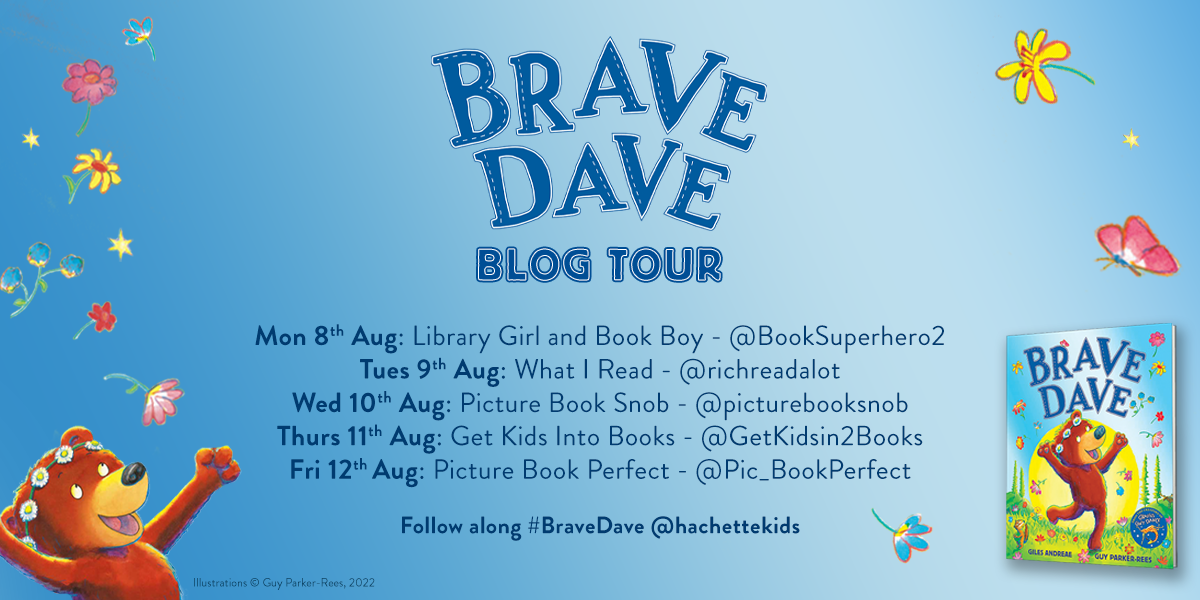
Today on the blog tour, I’m sharing my review of this empowering new picture book which celebrates difference and individuality.
Alex Neptune, Dragon Thief
Blog Tour, 4 August 2022
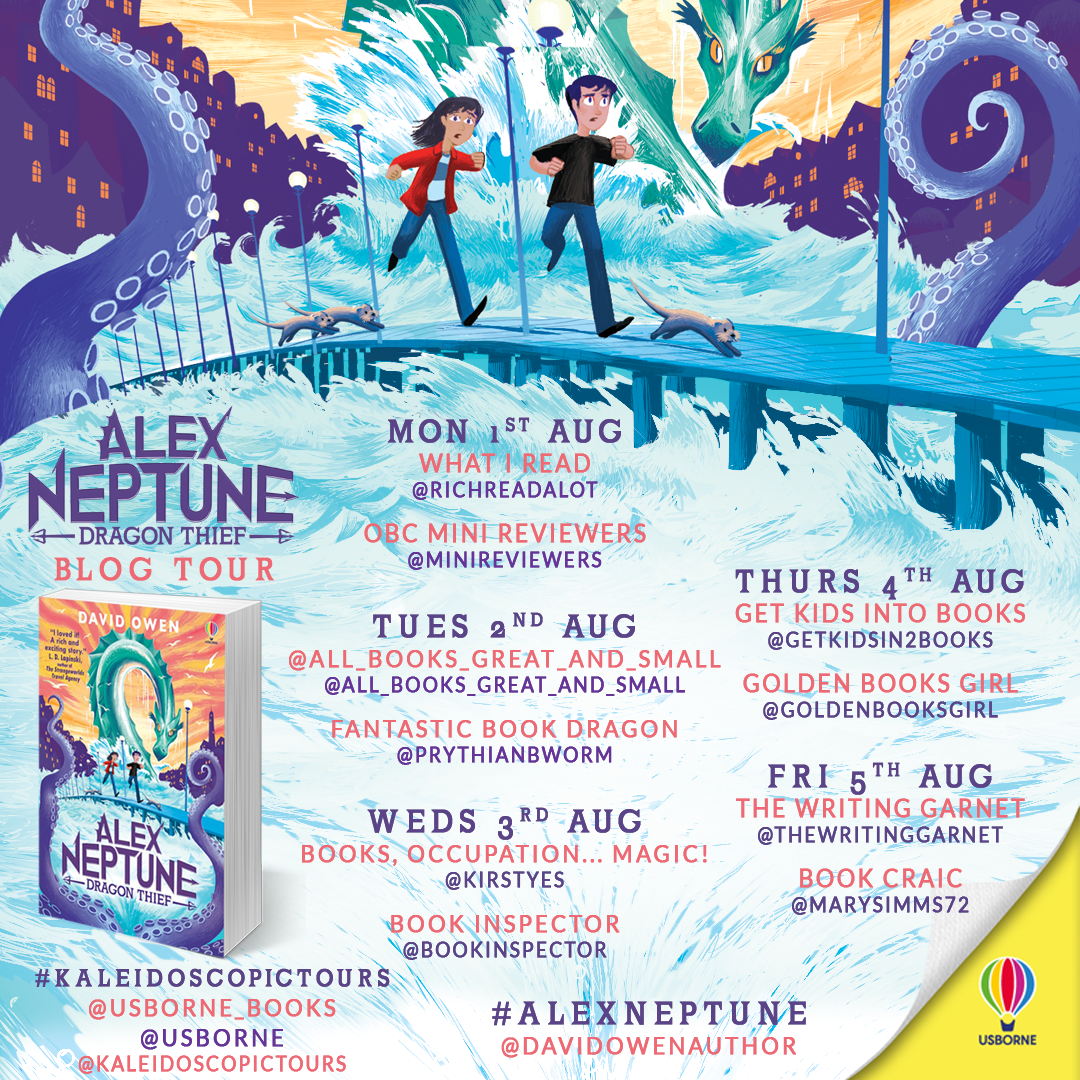
 I’m delighted to welcome author David Owen to my blog today to talk about the inspiration for his new children’s book Alex Neptune, Dragon Thief.
I’m delighted to welcome author David Owen to my blog today to talk about the inspiration for his new children’s book Alex Neptune, Dragon Thief.
Get Kids into Books: Where did the idea for the book come from?
David: The seed of the idea was a news story from Japan. A regional aquarium had abruptly gone out of business and the owners up and left without bothering to secure new homes for the many animals – including dolphins. Realising the animals needed help, local children broke into the abandoned park to feed and care for the inhabitants until they could be re-homed.
That was already a great story. Then I started to wonder what would happen if those kids discovered that the people taking the animals meant them harm. Would they band together to break them out of the aquarium and return them to the ocean?
The big-hearted quirkiness of that possibility, plus the complicated planning and logistics it would involve, had the makings of a really unique heist story. The first draft involved Alex and friends rescuing a variety of animals – dolphins, penguins, stingrays and more. This was fun, but it lacked a focal point, and the logistics of breaking out so many animals seemed almost too difficult.
I’m not sure when I hit upon the idea of having them rescue a sea monster instead, but it instantly pulled the story together. That small drop of fantasy allowed me to develop the back story of the town, which gave me the journey Alex would take in the book along with the motivations of the villain who opposed him. For some reason it seemed so much more sensible to have my characters rescuing a dragon instead of real animals, even if it does cause some unique problems along the way…
Get Kids into Books: Thank you, David, for this fascinating insight into your creative process. I really enjoyed your book and can’t wait for book two in the series.
You can read my review of Alex Neptune, Dragon Thief here.
Kitty Quest Blog Tour
27 July 2022
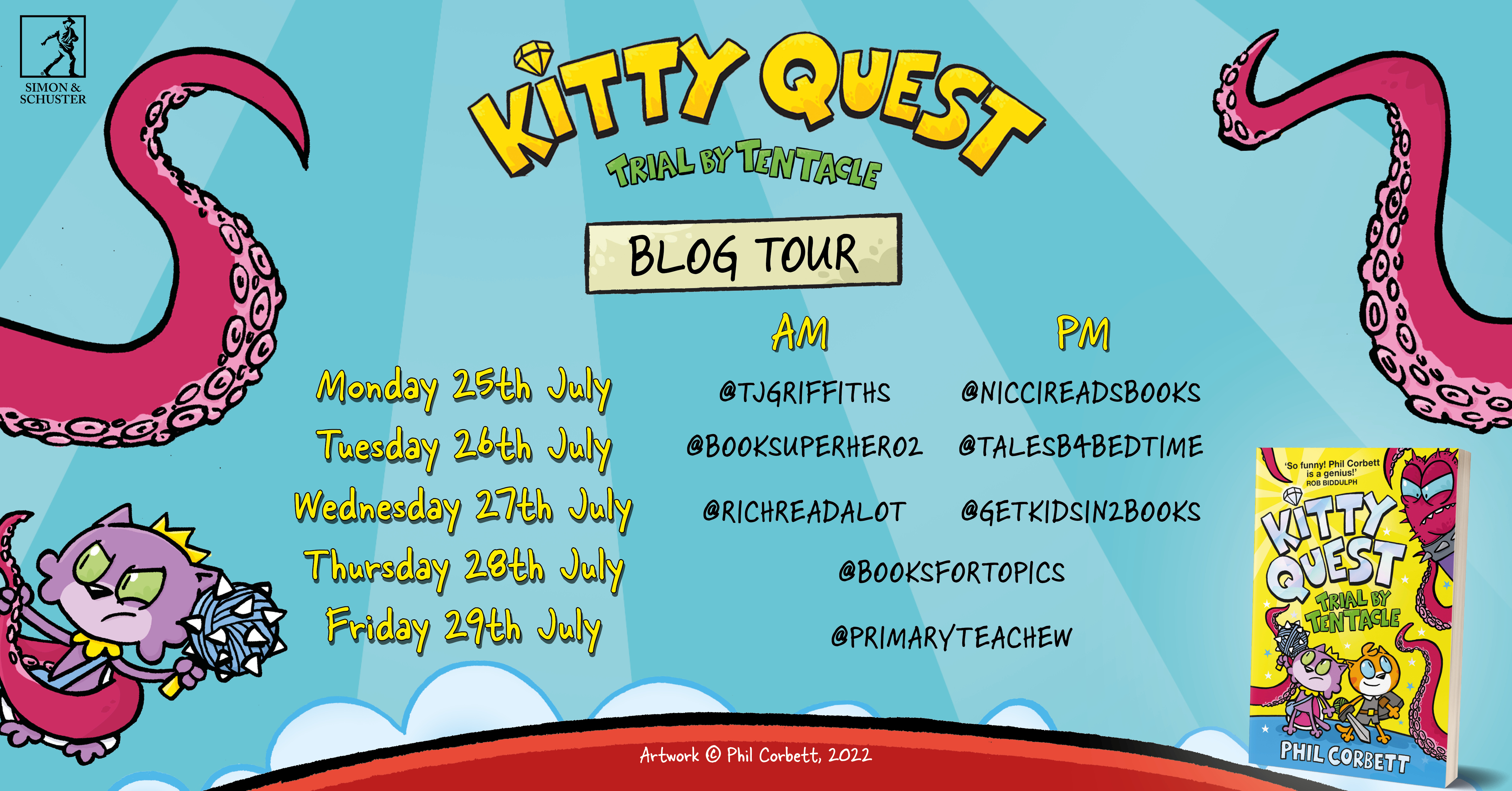
Kitty Quest, Trial by Tentacle is funny, often ridiculous, and a highly entertaining adventure. You can read my full review here.
Once Upon a Fever Blog Tour
21 July 2022
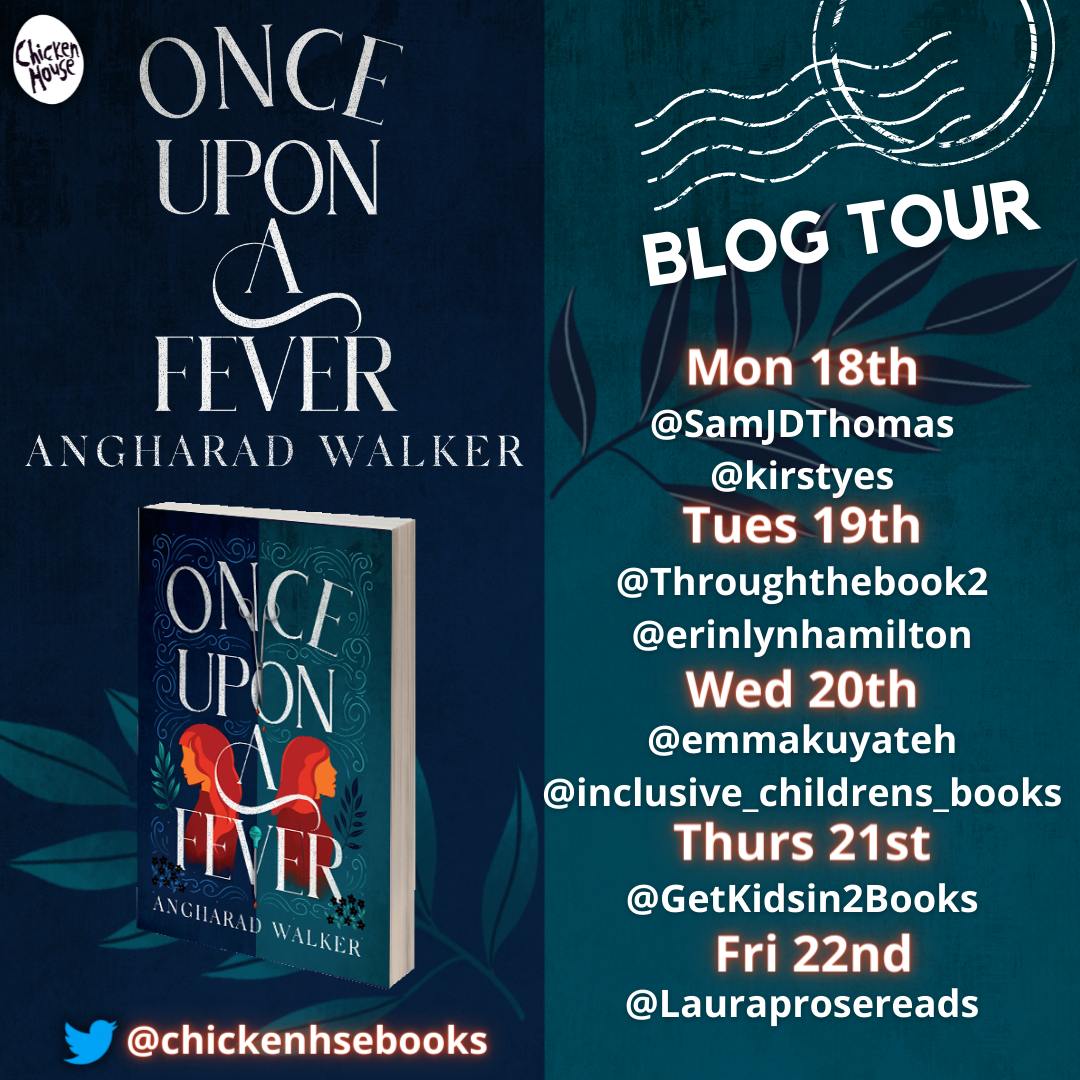
I’m delighted to be part of the blog tour for this original and absorbing book. You can read my review here.
The Dragon in the Bookshop
Blog Tour, 7 July 2022
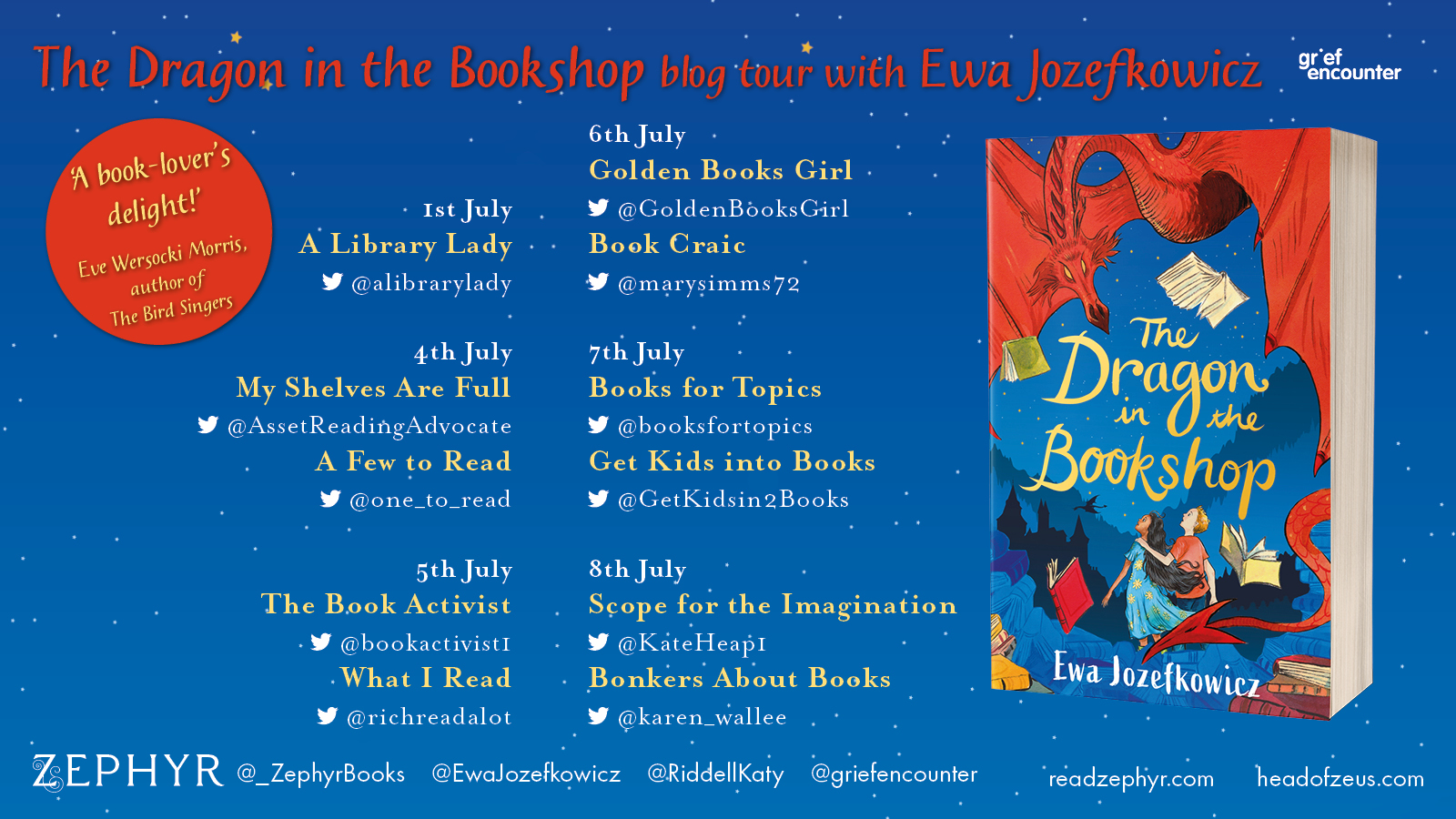
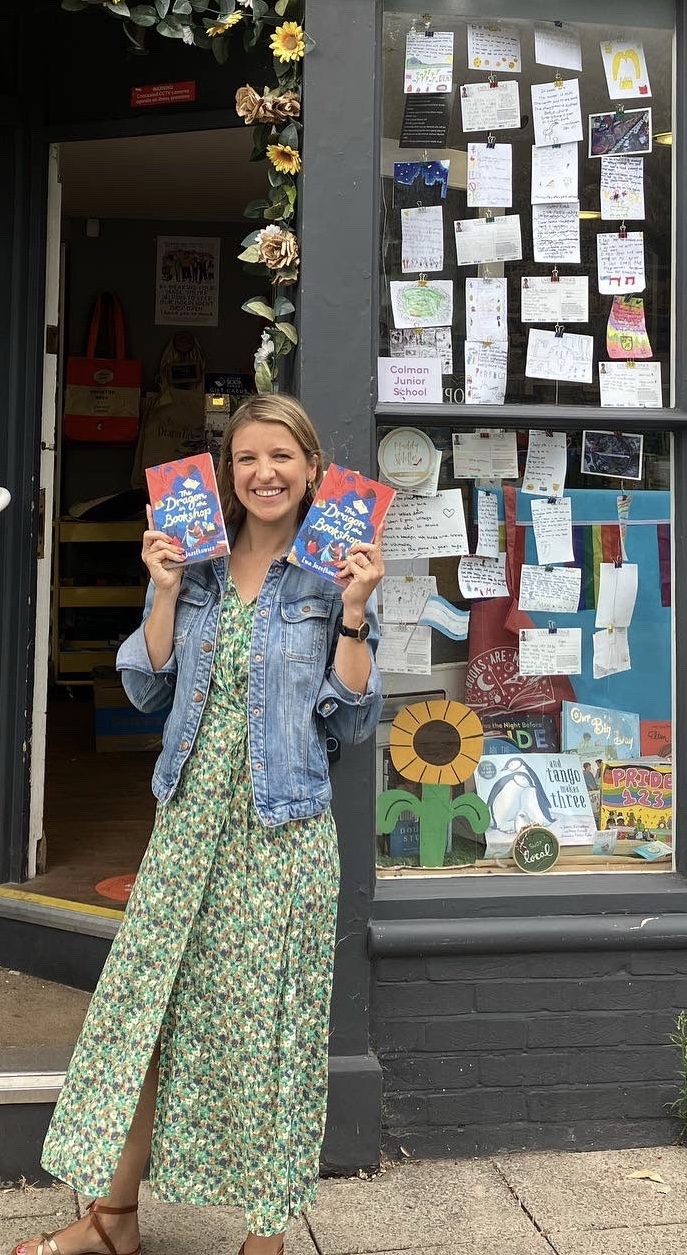 The Dragon in the Bookshop is a poignant and incredibly moving book about grief, healing, and the magic of books. I’m delighted to welcome author Ewa Jozefkowicz to my blog today to introduce the Polish legend of The Dragon of Wawel (a story that is central to the plot of The Dragon in the Bookshop). It’s also a story which is of huge personal significance to Ewa herself.
The Dragon in the Bookshop is a poignant and incredibly moving book about grief, healing, and the magic of books. I’m delighted to welcome author Ewa Jozefkowicz to my blog today to introduce the Polish legend of The Dragon of Wawel (a story that is central to the plot of The Dragon in the Bookshop). It’s also a story which is of huge personal significance to Ewa herself.
Ewa: The Dragon in the Bookshop is very close to my heart, as the inspiration for it came from my dad who passed away when I was a teenager. He was a bookseller and I would spend many days over the school holidays tucked away in a corner of his bookshop reading my way through the children’s section. He truly ignited my love of reading and I can honestly say I wouldn’t have become an author if it wasn’t for him.
The book features a famous Polish legend which my dad used to read to me when I was little. It’s about the dragon of Wawel Castle in Kraków – a terrible beast who made the whole city quake with fear. As a child I often wondered whether he was really as bad as everyone made out. Perhaps the legend could be read in a different way? Maybe there was an important piece of context that we were missing?
The book includes a modern English translation of the legend:
A long time ago, when King Krak ruled the lands, a dragon appeared in Krakow. He was a huge fire-breathing creature with warty green skin and evil yellow eyes. Nobody knew where he’d come from, but he settled in a cave under the Vavel castle and it soon turned out that he had an insatiable appetite. The townspeople brought him huge piles of pies, meat and cake. But the dragon was still hungry…
In the original version of the legend, a farrier’s apprentice, Skuba, takes on the task of ridding the town of the dragon, and he succeeds where many others before him had failed. He offers the dragon a ram stuffed with sulphur, and the poisoned beast is so thirsty that he drinks the nearby river dry and… eventually bursts.
I thought a lot about this legend as a child and remember asking my dad why the dragon had come to Kraków. Why did he settle there and not anywhere else? What did he want? “It’s just a legend,” my Dad would say, but that wasn’t enough for me. I imagined the dragon as a fully-fledged character, with thoughts, feelings and fears. And this sparked my decision to rewrite the legend in The Dragon in the Bookshop. Without giving too much away, the dragon is not who he appears to be, and it’s up to the main characters Kon and Maya to uncover his true motivations and in doing so, rid the town of his presence once and for all.
The Dragon in the Bookshop by Ewa Jozefkowicz (front cover illustration by Katy Riddell) is out on 7th July 2022 and will help promote Grief Encounter (www.griefencounter.org.uk) a wonderful charity that works with children who have lost someone they love.
Grief Encounter have a message for children and young people like Kon. As a charity they work closely with individuals, families, schools and professionals to offer a way through the anxiety, fear and isolation so often caused by the grief of losing someone close.
Grief Encounter provide immediate support with a FREEPHONE Grieftalk helpline 0808 802 0111 open Mon-Fri 9am-9pm, a live chat via their website or support by emailing grieftalk@griefencounter.org.uk.
Nura and the Immortal Palace Blog Tour
5 July 2022
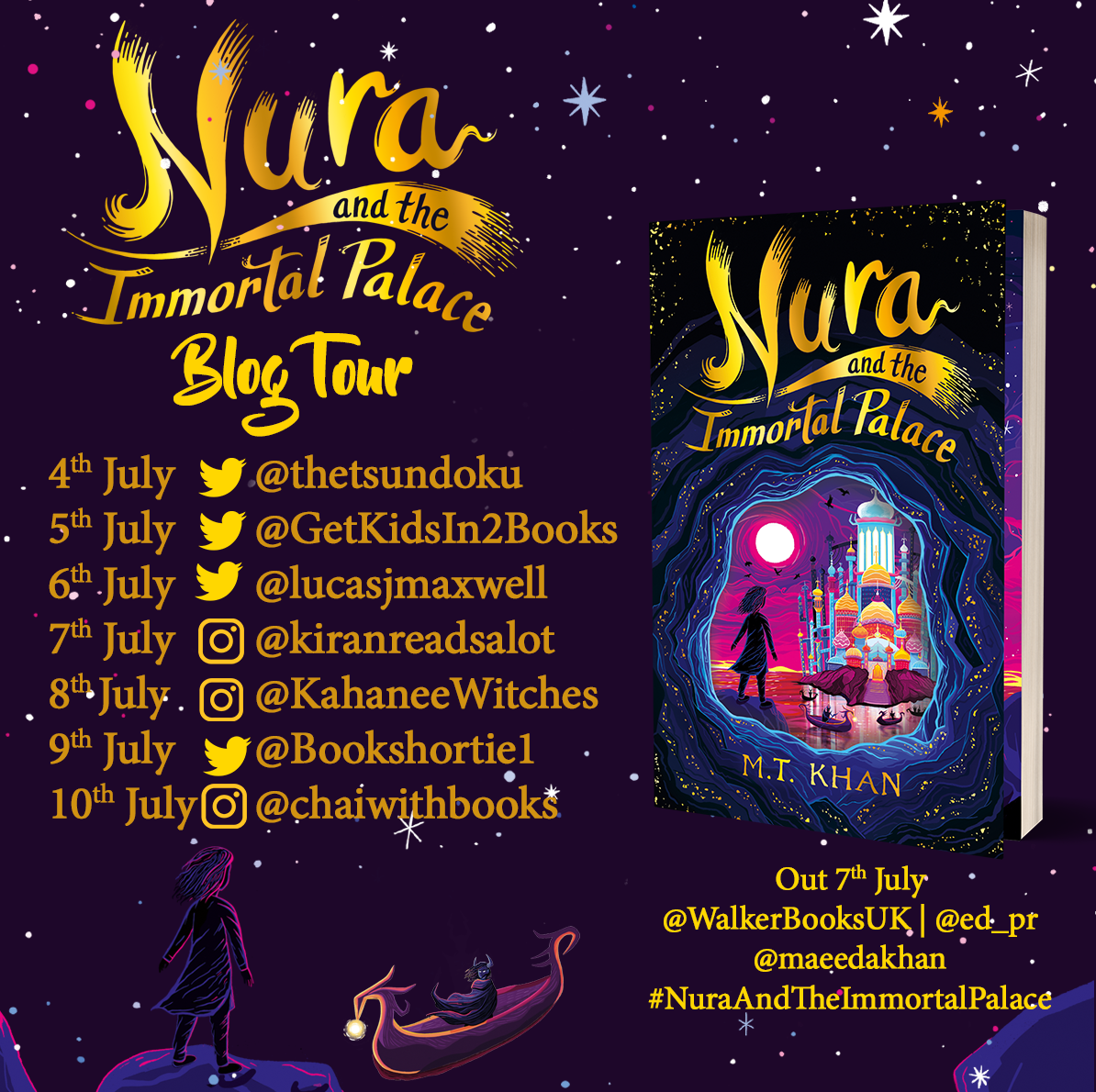
Nura and the Immortal Palace is a terrific story set in a dark and dangerous world of jinn and qareen. You can read my full review here.
Spellstoppers Blog Tour
4 July 2022
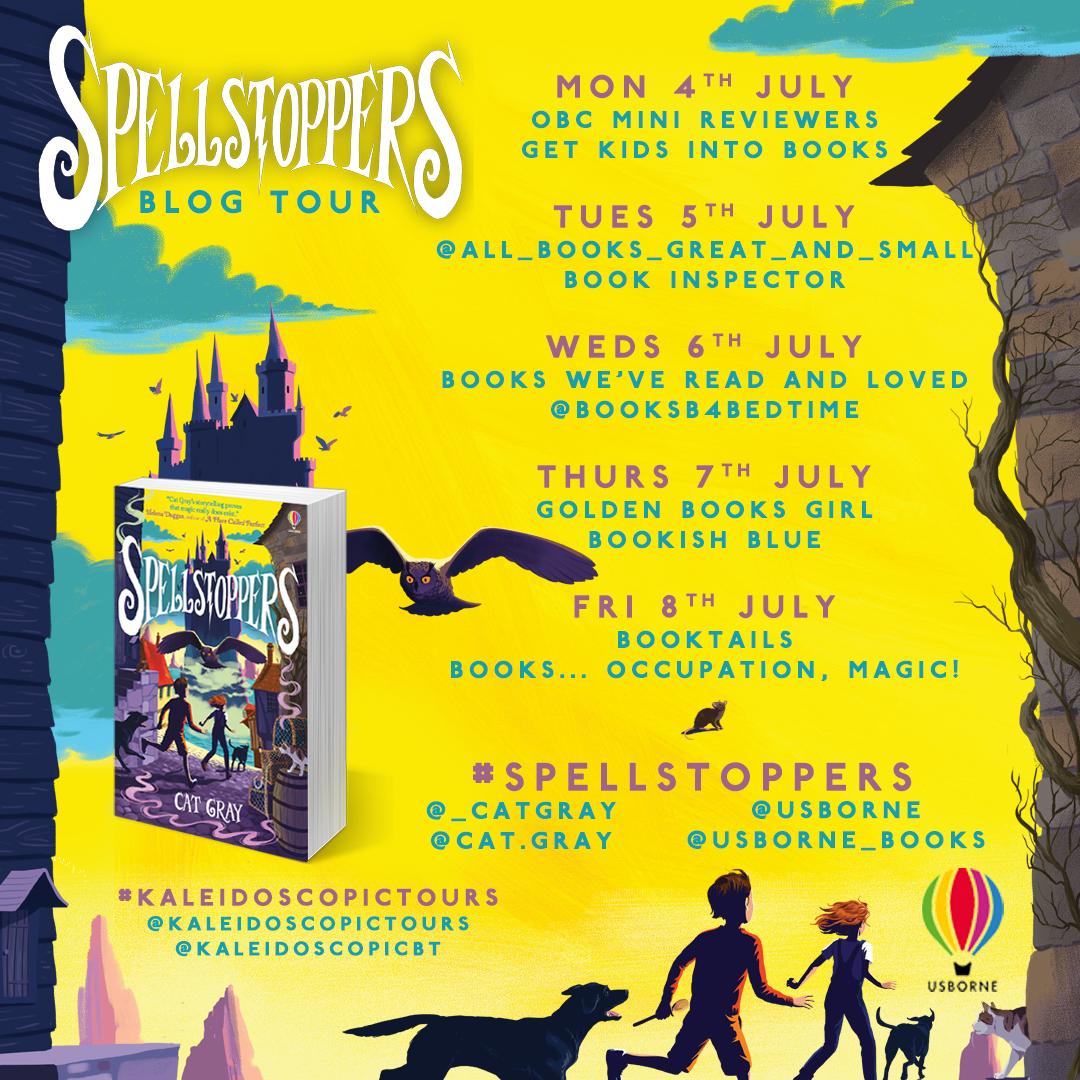
It’s a pleasure to kick of the blog tour by sharing my review of this terrific book about friendship, family, bravery and embracing your uniqueness.
The Midnighters Blog Tour
27 June 2022

The Midnighters is a wonderful book and I’m thrilled to share my review to kick off the blog tour.
My Friend the Octopus Blog Tour
20 June 2022
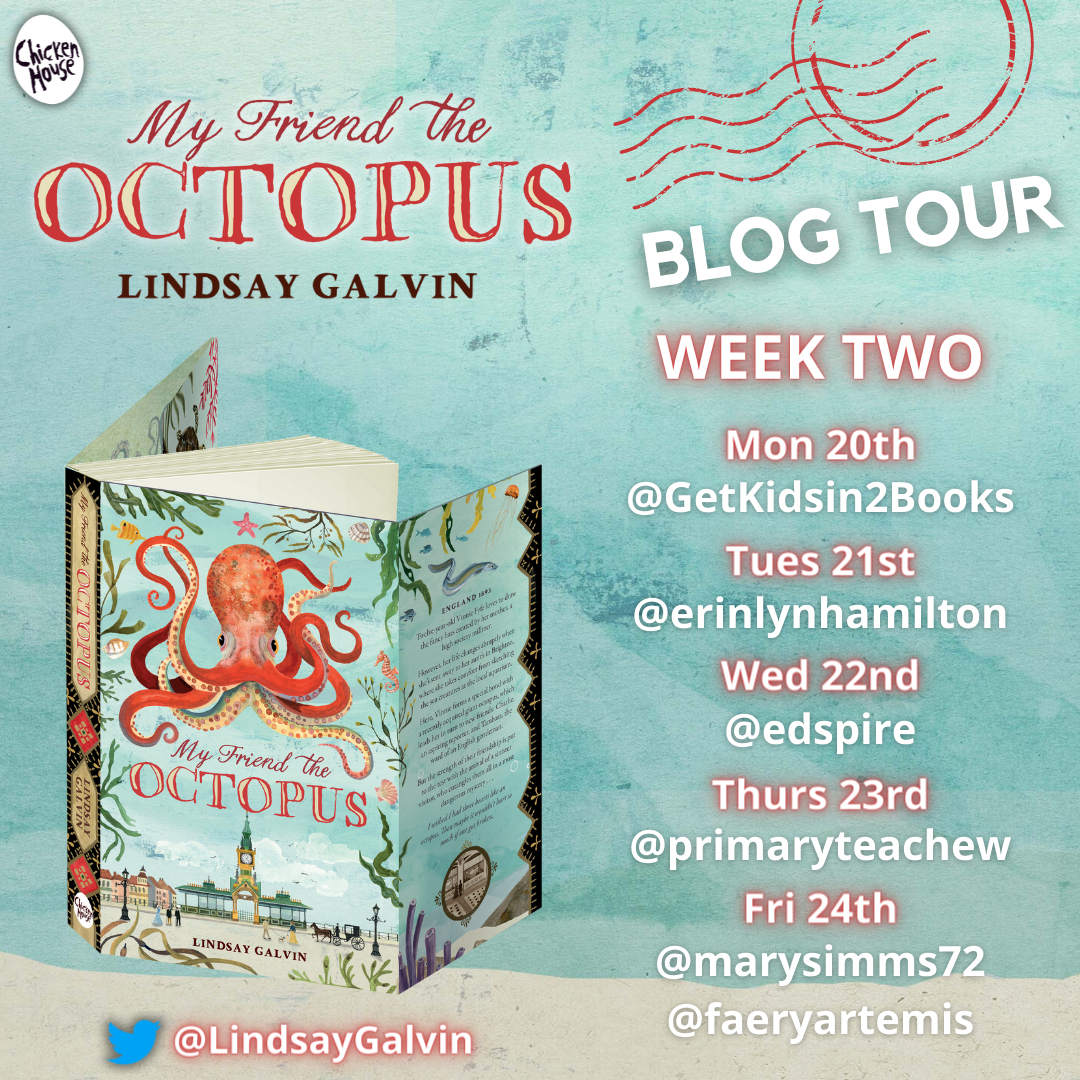
My Friend the Octopus is one of the best books I’ve read all year and I wholeheartedly recommend it. I’m delighted to share my review of this incredible book for my stop on the blog tour.
The Robber Raccoon Blog Tour
10 June 2022
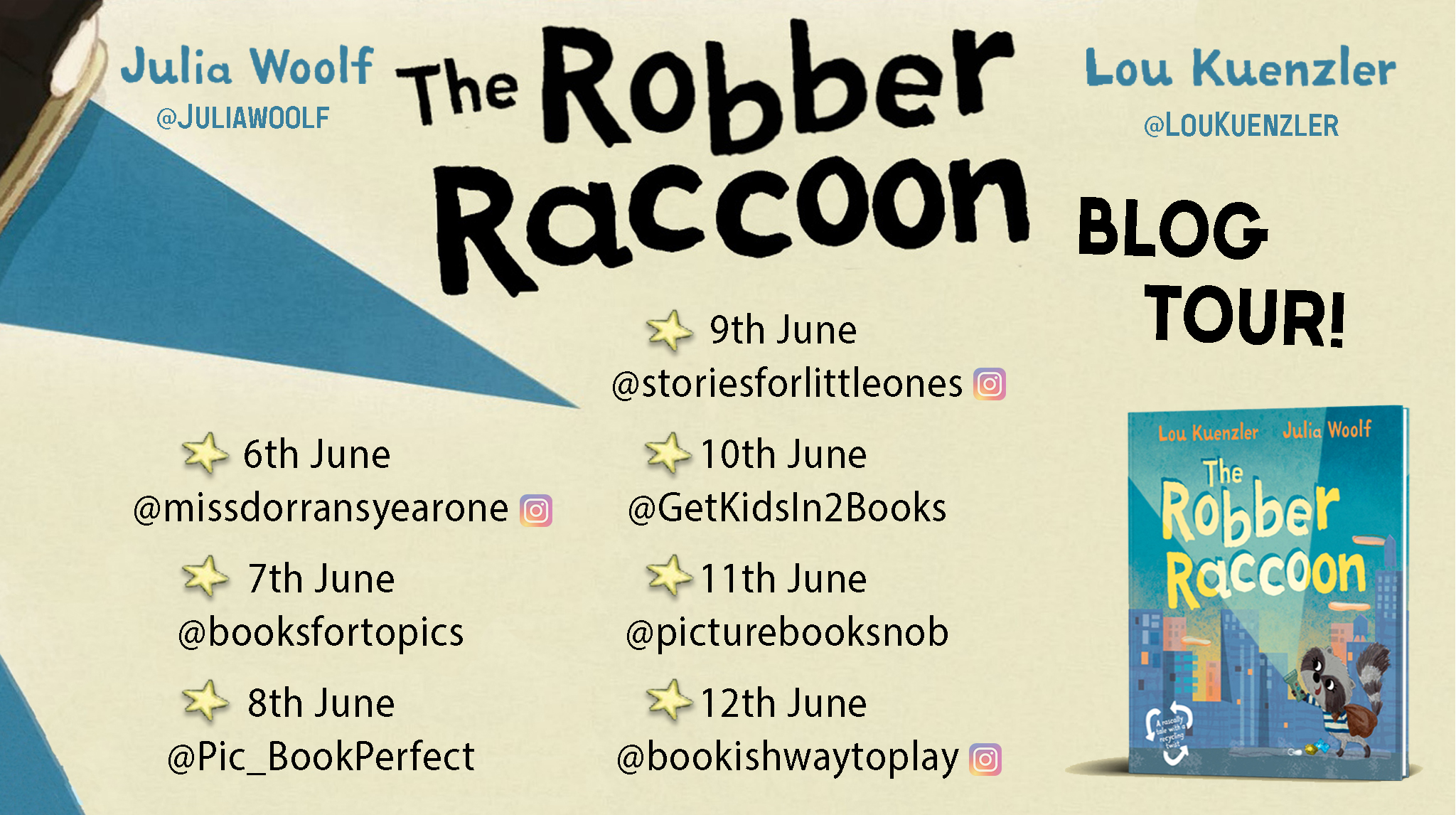
For my stop on the blog tour, I’m delighted to share my review of this fun new picture book with an eco-conscious message and a raccoon who isn’t all that she seems. Read my review here.
Zo and the Forest of Secrets Blog Tour
5 June 2022
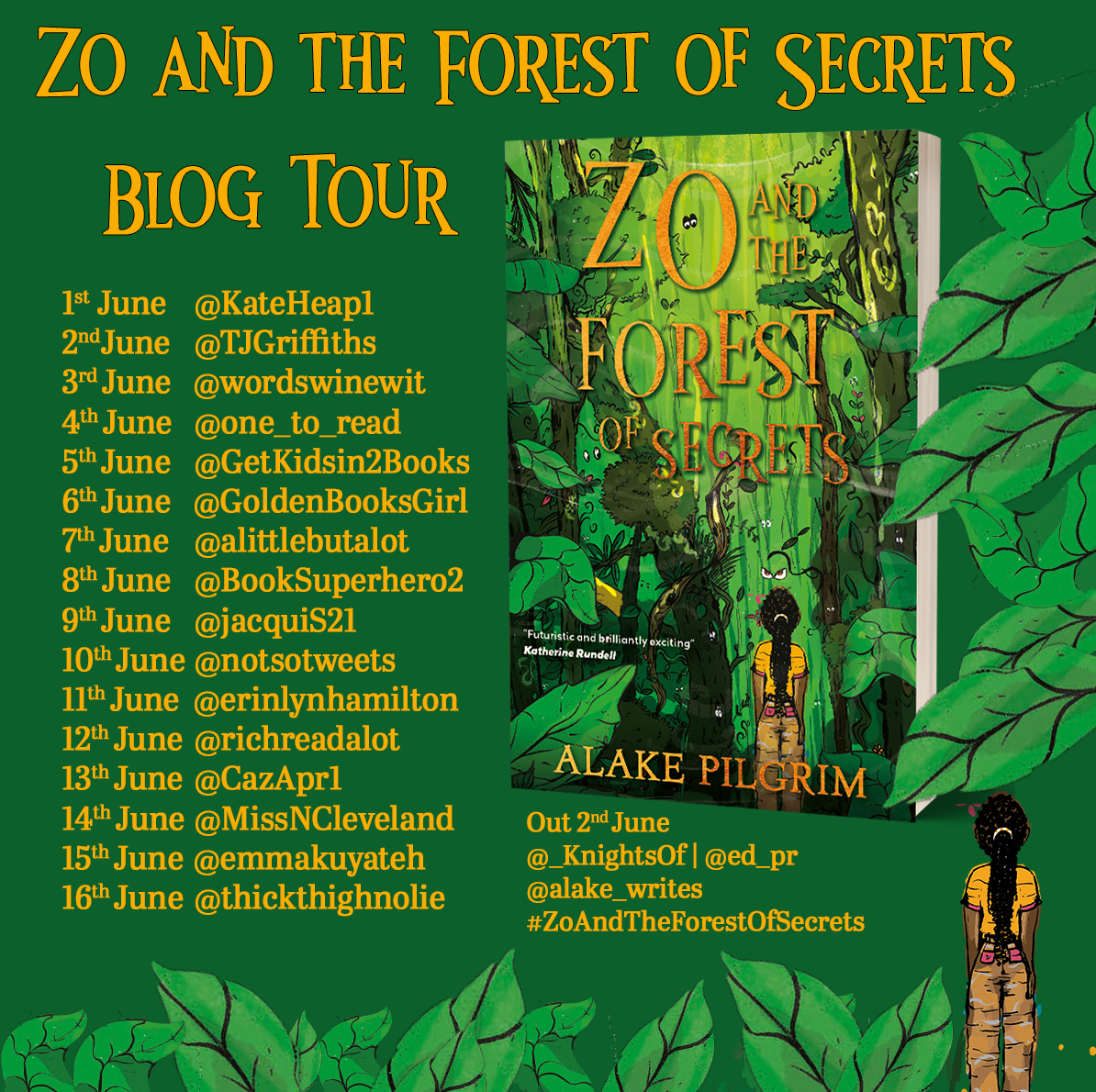 There’s mystery, adventure, suspense and sci-fi in this terrific middle grade début. I was hooked. You can read my full review here.
There’s mystery, adventure, suspense and sci-fi in this terrific middle grade début. I was hooked. You can read my full review here.
The Map of Leaves Blog Tour
20 May 2022
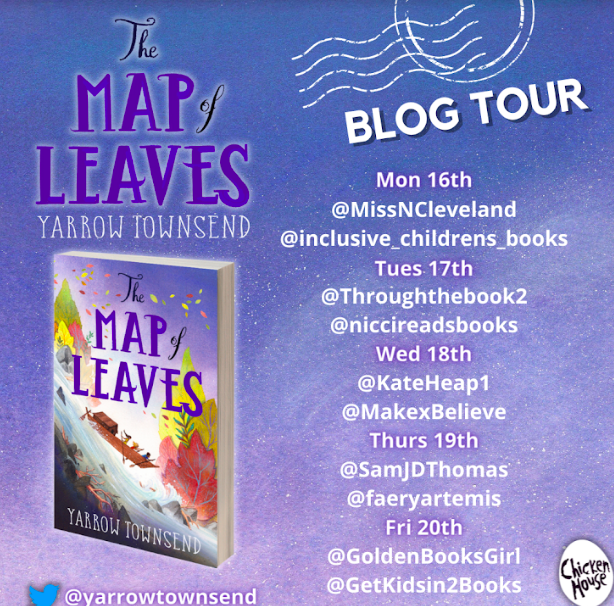
I’m delighted to share my review of this incredible book. The Map of Leaves is a thrilling adventure – exquisitely written – with an important environmental message and a modern-day resonance.
Funny Bums, Freaky Beaks Blog Tour
9 May 2022
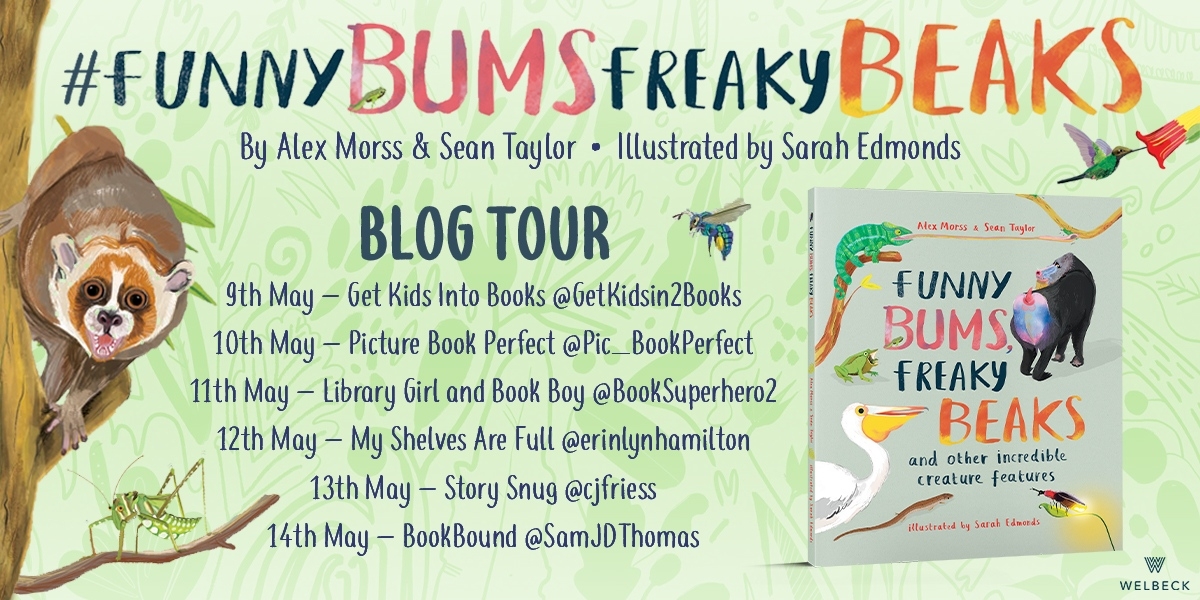
I’m delighted to kick off the Funny Bums, Freaky Beaks blog tour by welcoming illustrator Sarah Edmonds to my blog.
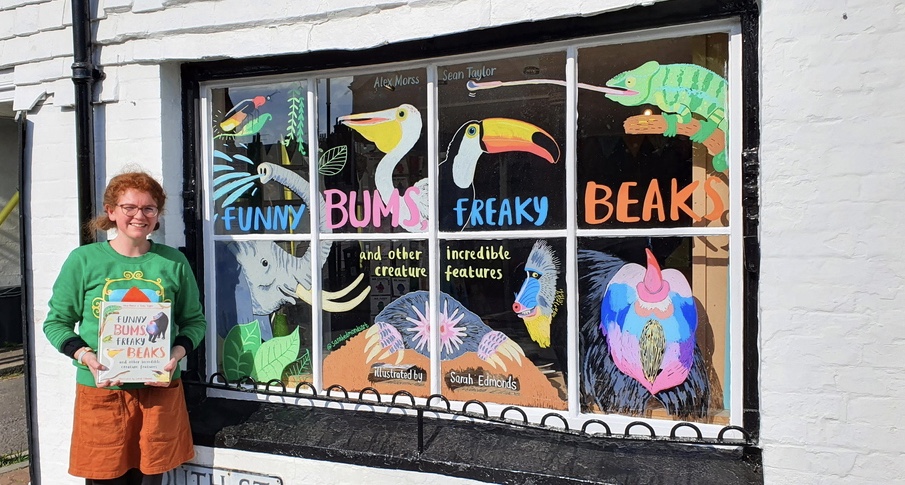
Get Kids into Books: Hi Sarah, thanks for joining me on my blog. Can you tell me what your creative environment is like?
Sarah: I use a blend of hand painted and digital techniques to create my work. I’ve therefore got a space for each – my computer desk and then a table with a small easel and a variety of paints, crayons and collage bits in easy reach. The notice board above is full of scribbles and cuttings and postcards and colours that inspire me. Though I often migrate to the dining room table where there’s a lot more space. And then if I’m out and about, my studio is just a pencil case and a sketchbook inside my rucksack!
Get Kids into Books: What’s your favourite medium to work in?
Sarah: Bright watercolour paint that’s dried, with coloured crayons and sketching pencils scribbled on top, for texture. I like to work in layers and mirror this process when working digitally. I often move between, scanning stuff in and piecing it together. For personal work, collage is my bag! Drawing with scissors and colours is so much more intuitive to me than line art.
Get Kids into Books: Are there any particular picture books you remember reading when you were younger that inspired you?
Sarah: Each Peach Pear Plum by the Ahlbergs – spotting all the details on each page was always fun. And Spot the Dog – especially the books with flaps.
Get Kids into Books: Which illustrators do you admire?
Sarah: I love the work of Eric Carle, Lois Ehlert and Charley Harper the most. They created so many vibrant books across their lifetimes. I always have an evolving list of contemporary illustrators who I’m currently into – Jarvis, Blexbolex, Helen Stephens and Joanna Rzezak are firm favourites right now . I love seeing how different illustrators capture nature and wildlife, whether with bold lines, painterly textures, watercolour, patterns, collage…. it’s fascinating! I have started an Instagram account, @cheekylionlibrary to document our young son’s bookshelf – it’s nice to keep a record of the books we enjoy together.
Get Kids into Books: How long did it take you to illustrate Funny Bums, Freaky Beaks?
Sarah: The bulk of the book illustrations were made between mid May and September 2020, although the initial cover development work happened in the February. Generally the work is tackled in batches of spreads that are first roughed out and then the colour artwork is created (my favourite bit)! Once all the spreads were more or less complete, we created the cover, introduction and conclusion using existing illustrations from the book. I was frequently in dialogue with my designer to make it all fit correctly and look just right, along with incorporating feedback from the authors and editor. Making a book is a team effort!
Get Kids into Books: What was your favourite bottom to draw?
Sarah: A glowing one! The baby planthopper has a disco for a backside – it squeezes sparkly spikes out to ward off predators. I gave this little creature a black background to make the display even more exciting.
I recently drew some creatures from the book on the Bags of Books window in Lewes and included the firefly along with the book’s key player – the magnificent mandrill and his rainbow bum!
Get Kids into Books: What’s been the best bit of being an illustrator so far?
Sarah: I’m constantly learning new things. Working on non-fiction book projects involves a lot of research about the subject matter – for Funny Bums I got to find out about over 100 different species and work out the best way to draw them. Creatively I get a lot of inspiration from online courses that prompt you to try new ways of working – and sometimes I’ll find a painting technique I like because of a happy accident. No matter what stage you’re at in your illustration career, it’s important to make time to play and learn.
Get Kids into Books: Thank you for these brilliant answers, Sarah!
The Super Questers Blog Tour
5 May 2022
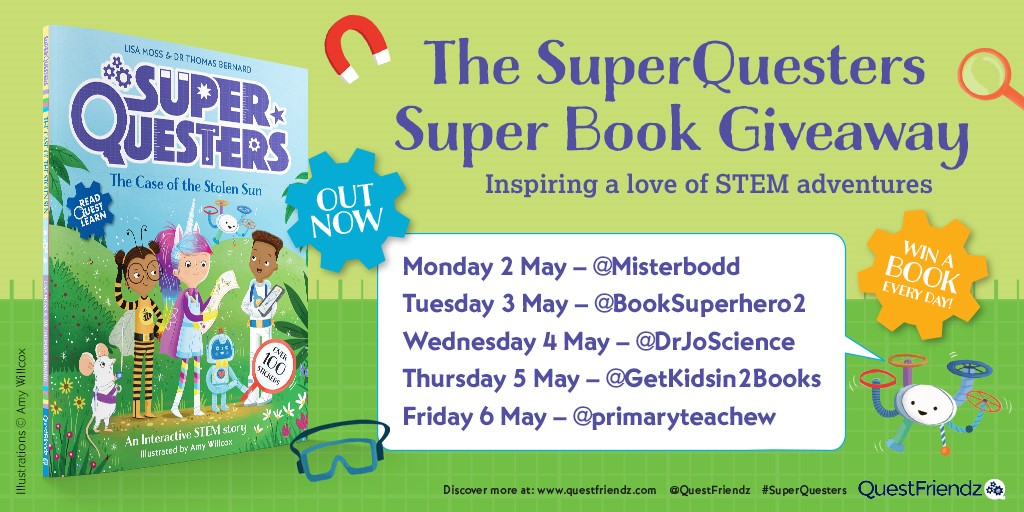
There’s an exciting giveaway over on my Twitter account! You could win a copy of this fab new interactive story book. Be quick, the giveaway ends on 8/5/22.
Rumaysa Ever After Blog Tour
4 May 2022
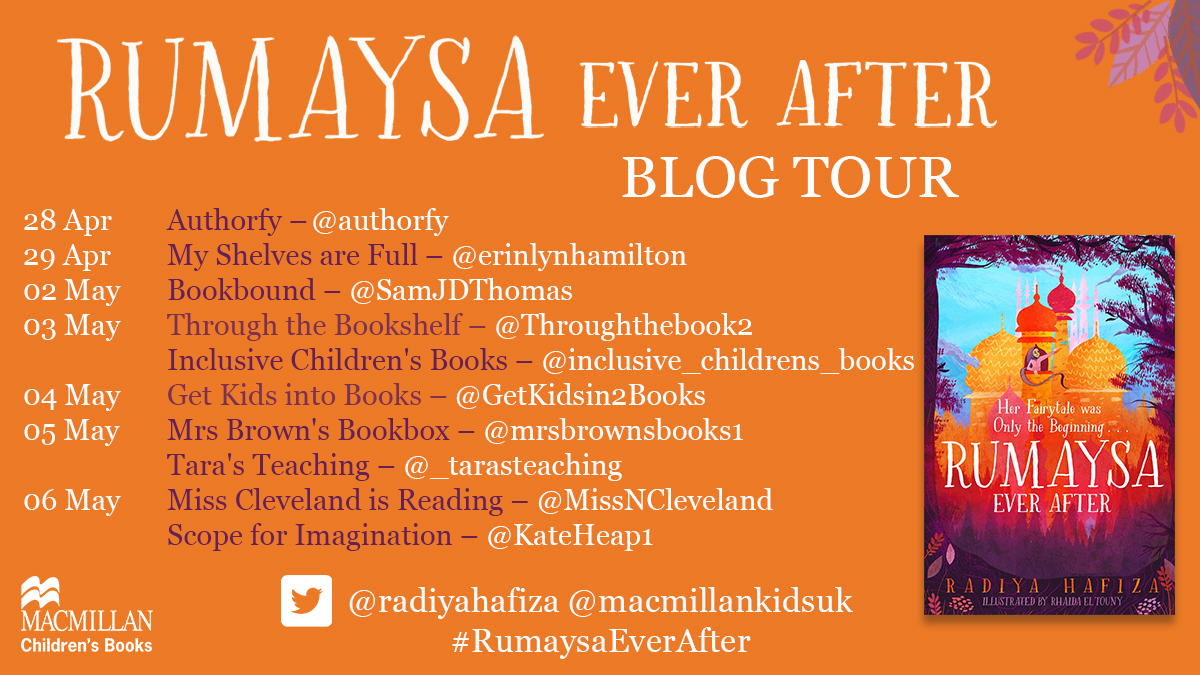
I’m delighted to share my review of Rumaysa Ever After for the blog tour. Funny, magical and feminist, it’s the fairytale we all need.
Wolfbane Blog Tour
26 April 2022
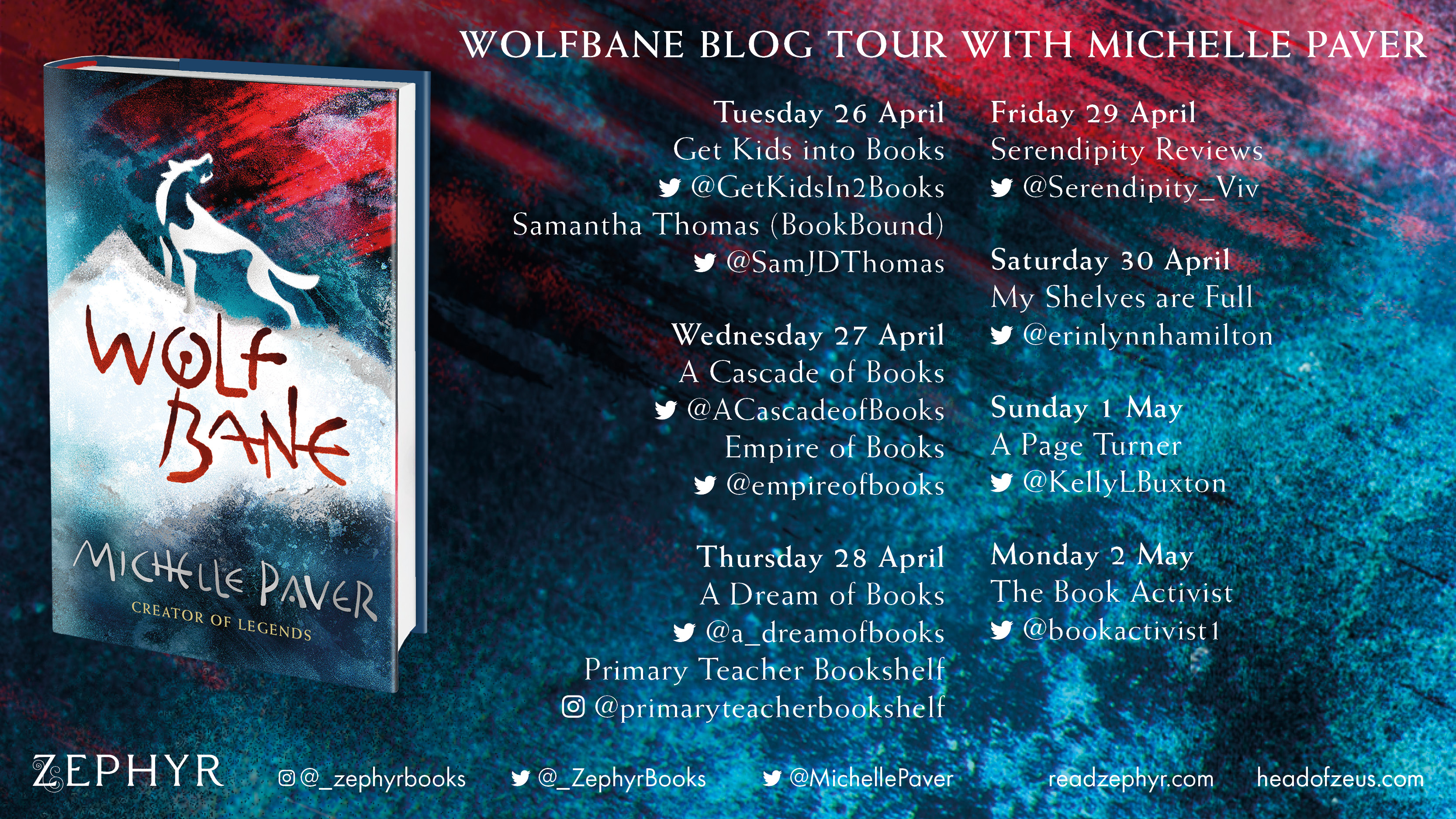
I’m honoured to kickstart the blog tour for the final book in this incredible series. You can read my review here.
Dread Wood Blog Tour
20 April 2022
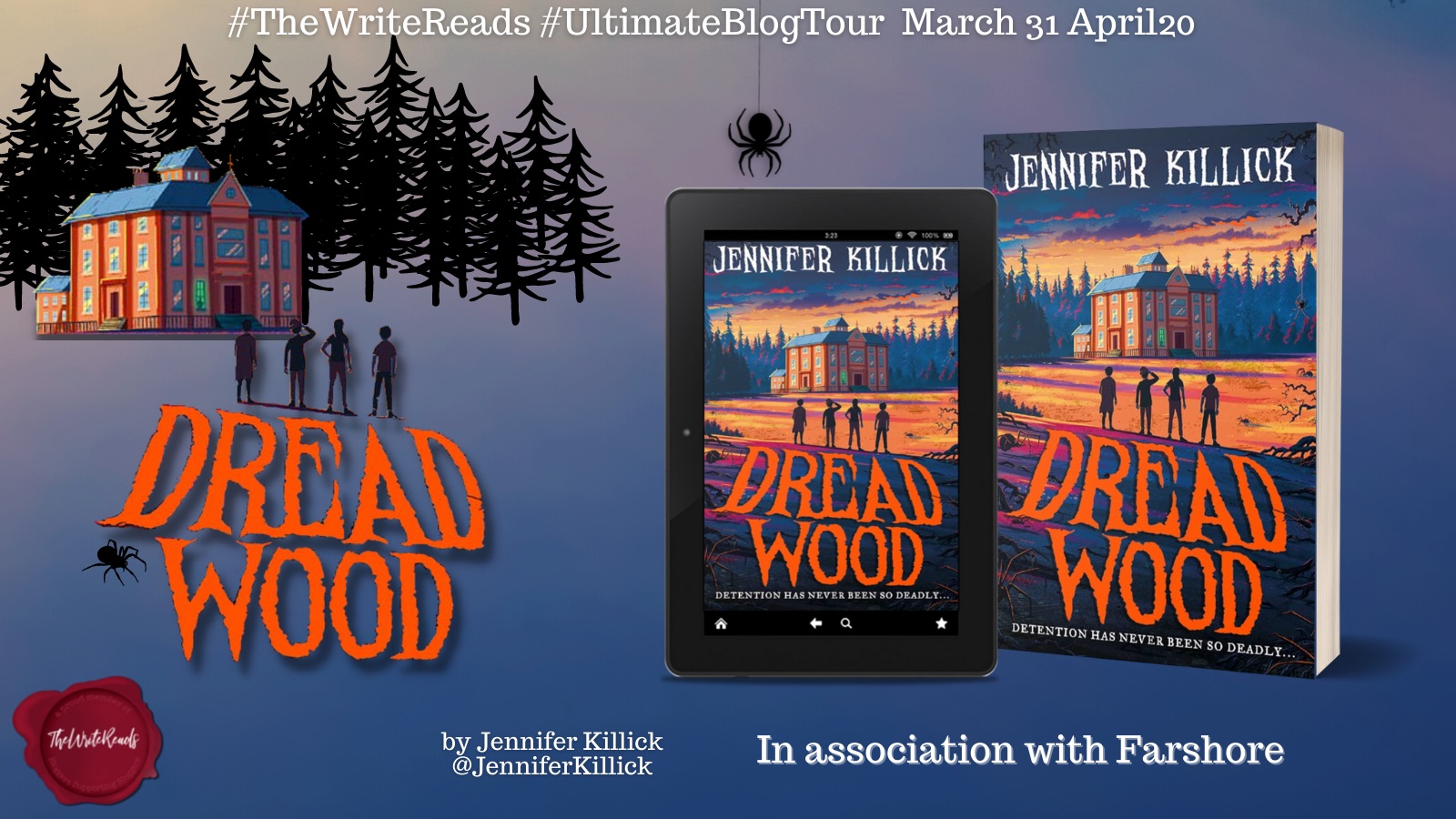
Jennifer Killick is the undisputed queen of MG horror and so I’m delighted to be part of the blog tour for her latest tension-filled adventure, Dread Wood. Prepare to face your arachnophobia and – be warned – you’ll never think of Incy Wincy Spider in the same way again… You can read my full review here.
Every Cloud Blog Tour
13 April 2022
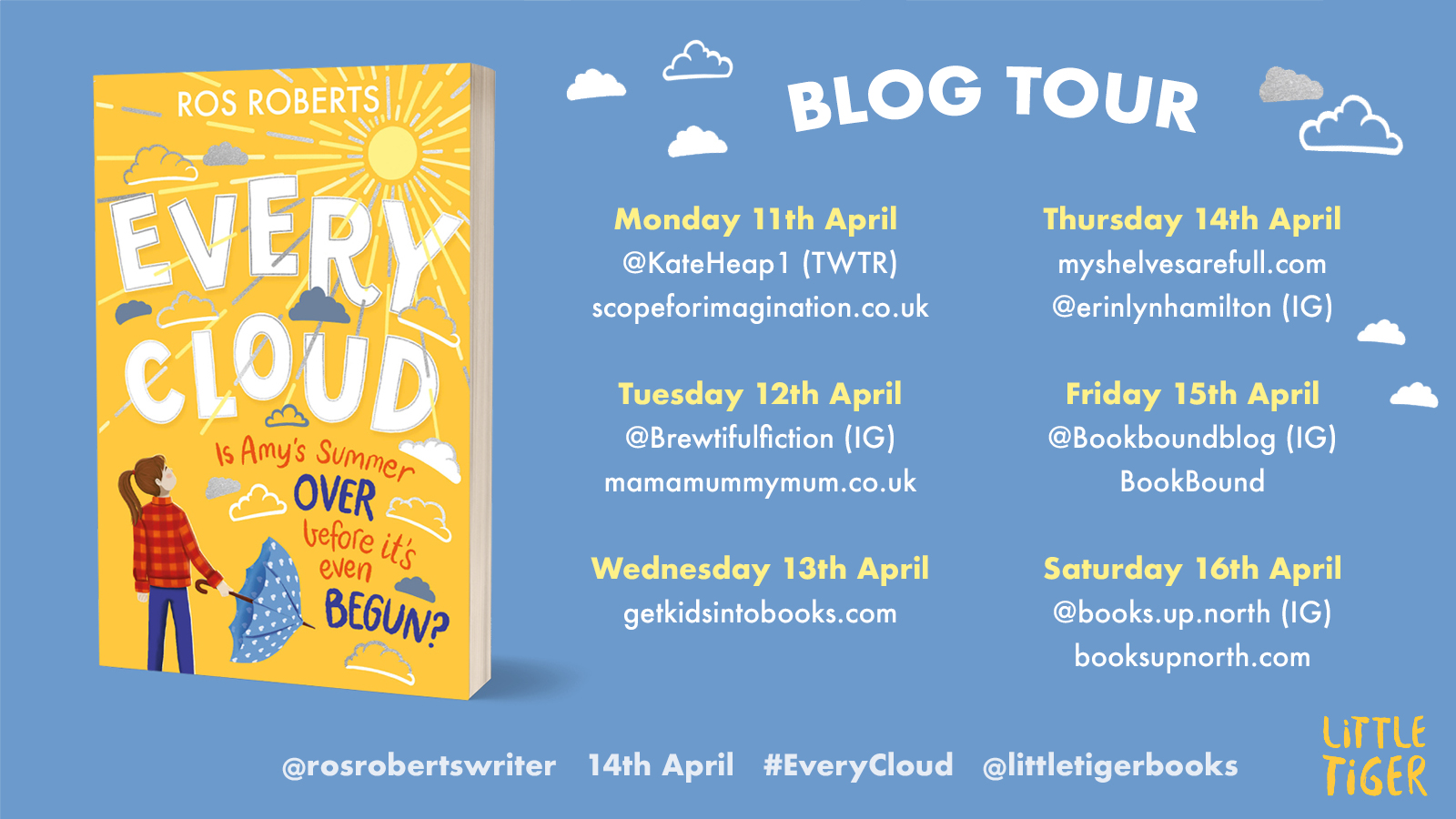
For my stop on the blog tour, I’m delighted to share a guest review written by one of the Year 6 pupils in my school book club. Click here for Ellie’s review.
Rewilders Blog Tour
8 April 2022
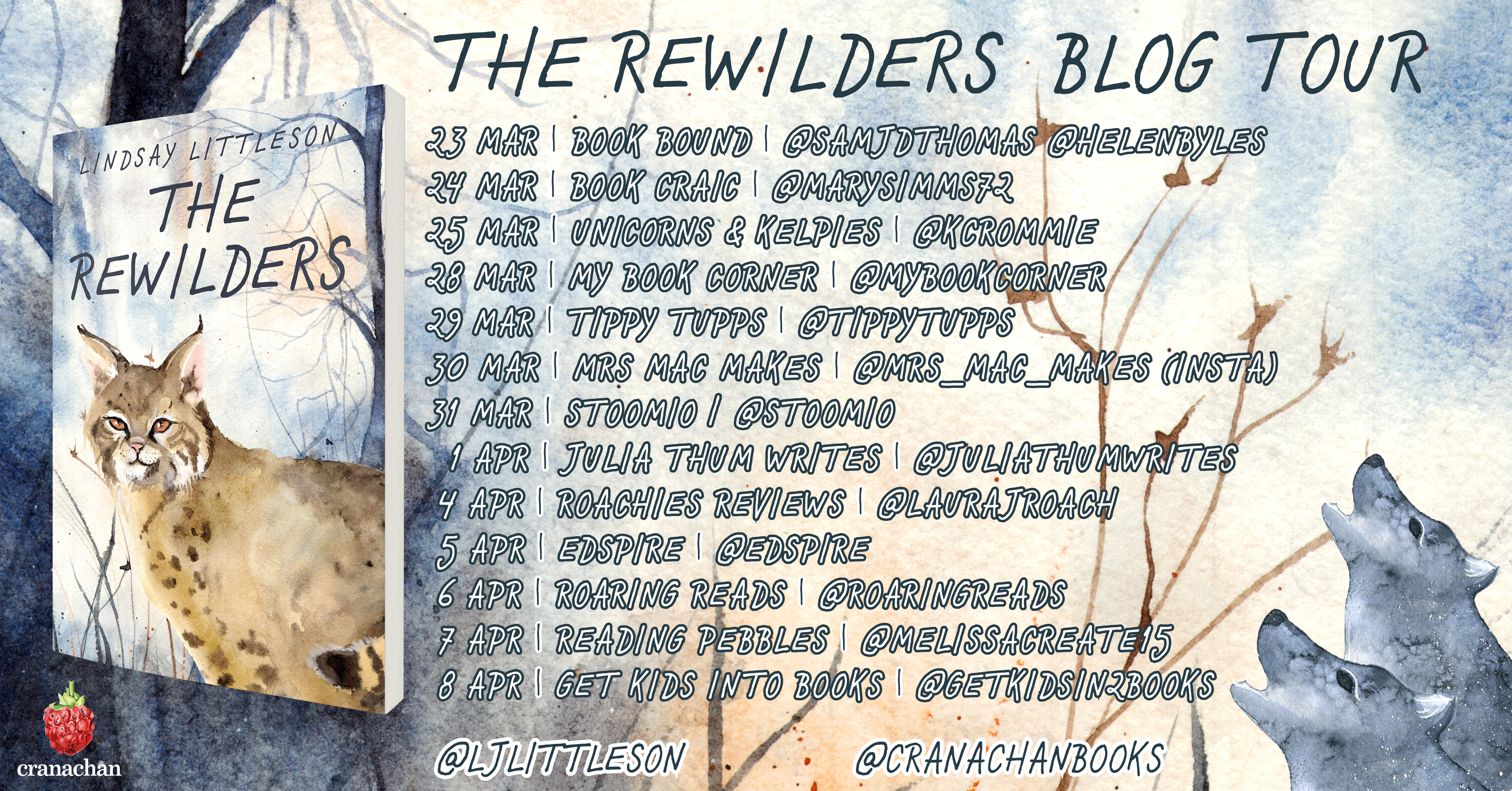
I’m delighted to share my review of The Rewilders – a terrific book full of tension and plot twists, interwoven with a very satisfying story of self-discovery.
Are Mummies Scared of Monsters?
Blog Tour, 29 March 2022

For my stop on the blog tour, I’m sharing my review of this eye-catching picture book with quirky artwork.
The Boy in the Post Blog Tour
9 March 2022
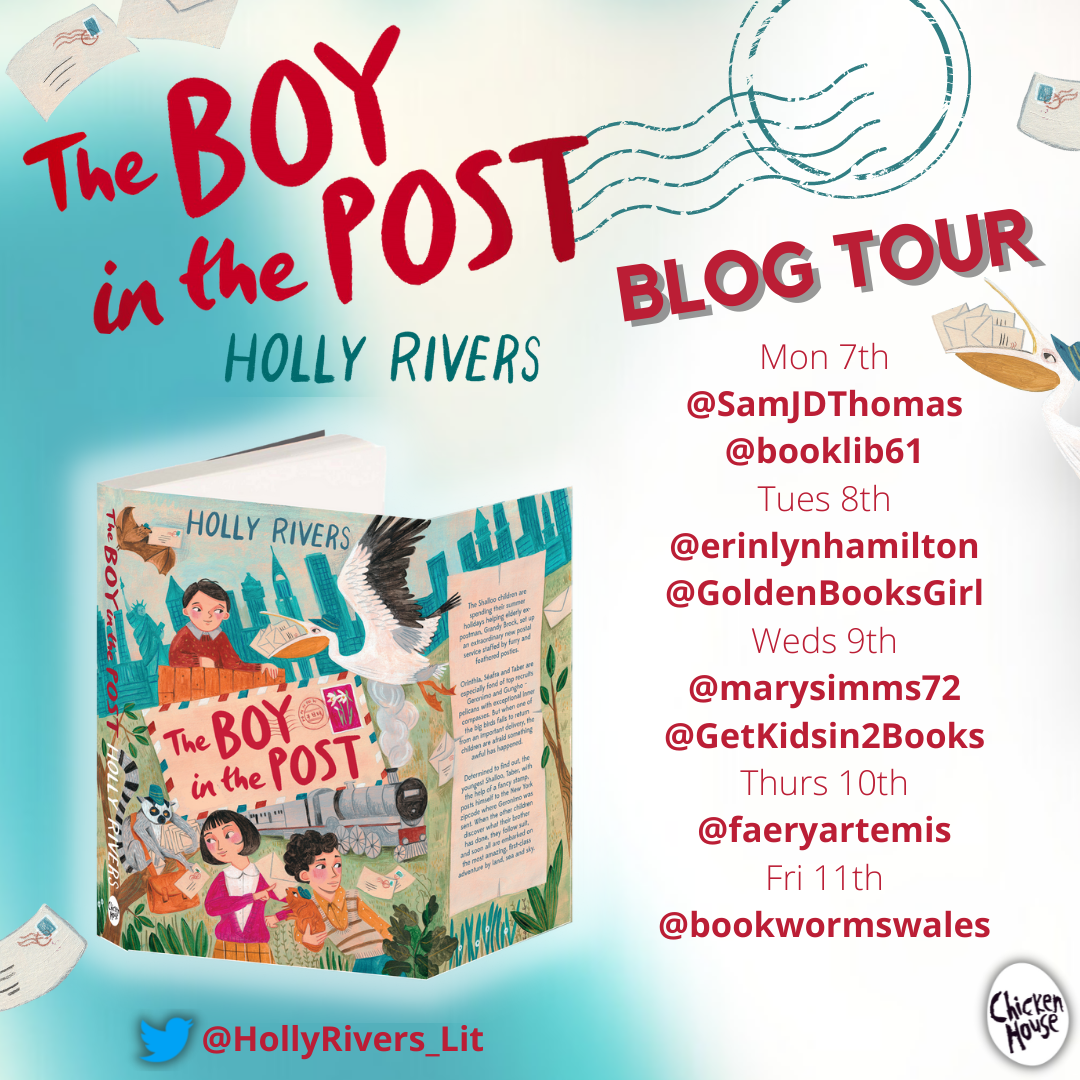
I’m delighted to be part of the blog tour for The Boy in the Post. The book is brilliantly imagined, wildly eccentric and lots of fun. You can read my full review here.
My Mum is a Lioness Instagram Tour
7 March 2022
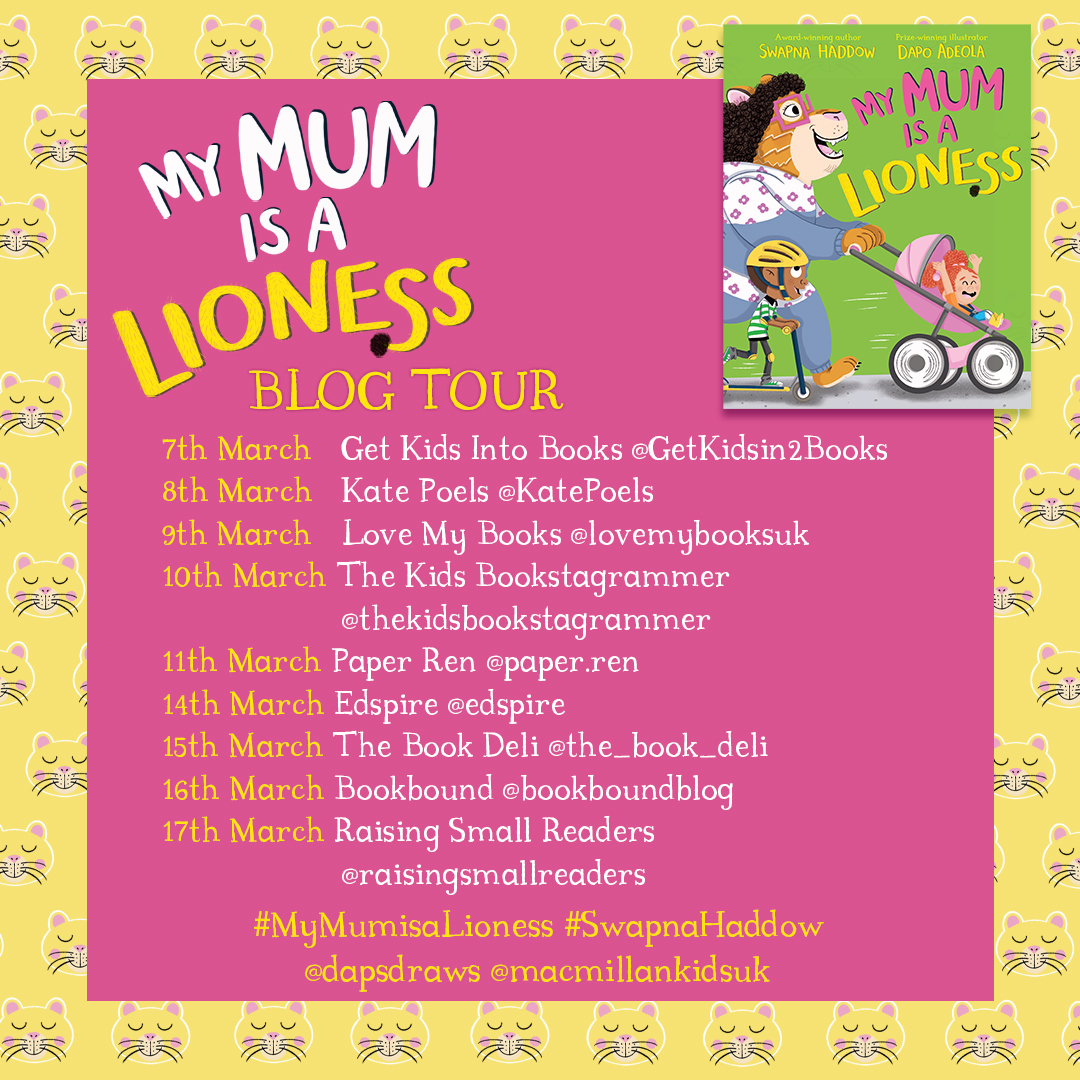
I’m delighted to kick off the blog tour for this vibrant and very relatable picture book that’s full of humour. You can read my review of My Mum is a Lioness here.
Snowy White on Tell a Fairy Tale Day
26 February 2022
I’m sharing my review of this twist on a fairy tale for Tell a Fairy Tale Day.
Luma and the Pet Dragon Blog Tour
24 February 2022
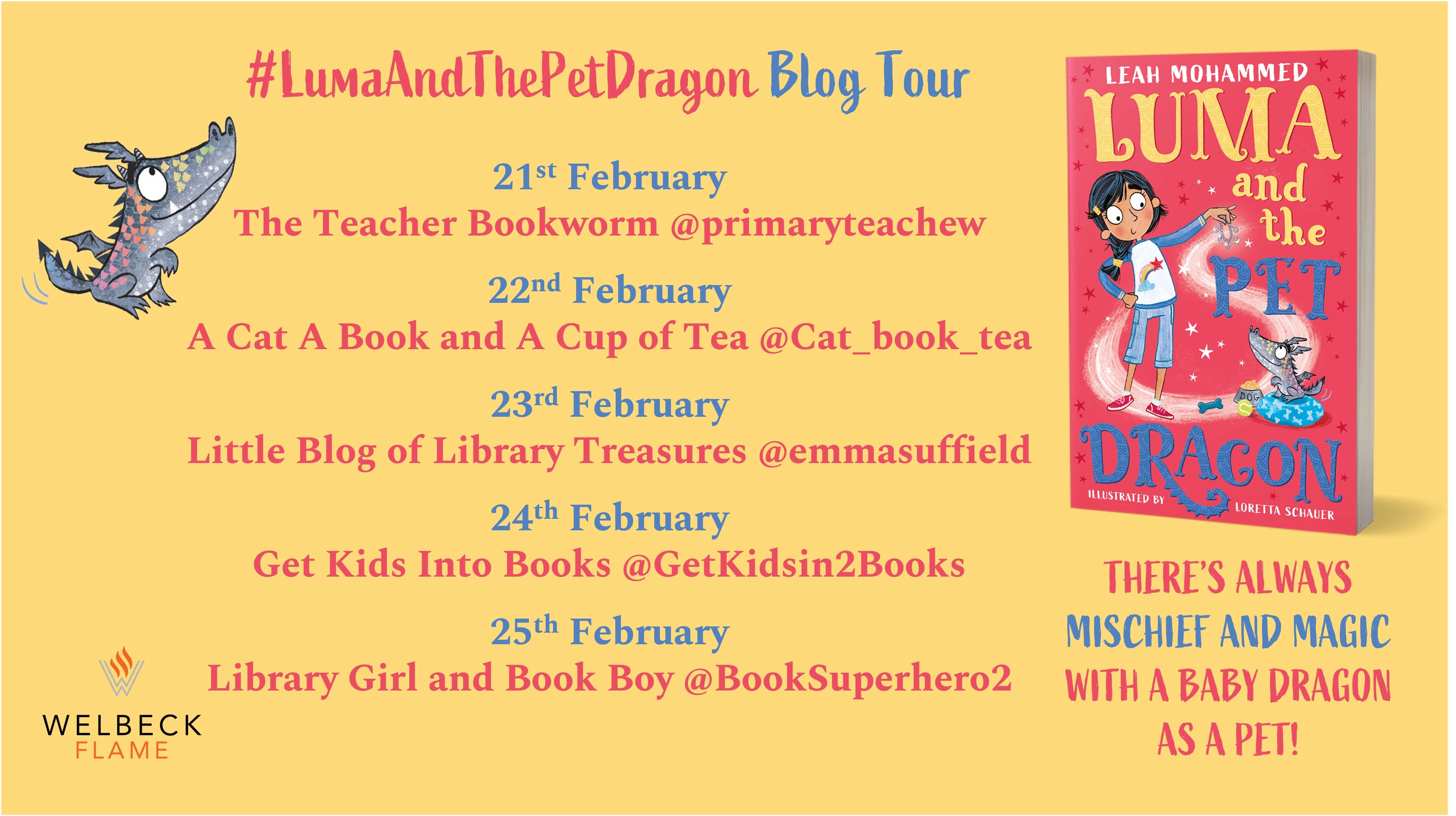
 Today I’m delighted to welcome author Leah Mohammed to my blog. Leah has written a delightful new series about a seven-year-old girl and her pet dragon, who magically transforms into a puppy when anyone else is around. Here Leah shares some advice for new puppy owners, drawn from her own experience as a dog owner.
Today I’m delighted to welcome author Leah Mohammed to my blog. Leah has written a delightful new series about a seven-year-old girl and her pet dragon, who magically transforms into a puppy when anyone else is around. Here Leah shares some advice for new puppy owners, drawn from her own experience as a dog owner.
Top Tips for New Puppy Owners by Leah Mohammed
 As Luma soon finds out with Timir, raising a puppy is definitely hard work! I am no expert by any means, but I have been lucky enough to look after several puppies over the years, my own and my family’s. We currently have five dogs between us – quite the sight when we get together for walks!
As Luma soon finds out with Timir, raising a puppy is definitely hard work! I am no expert by any means, but I have been lucky enough to look after several puppies over the years, my own and my family’s. We currently have five dogs between us – quite the sight when we get together for walks!
There is so much to prepare before a puppy arrives, from the fun trip to the pet shop to buy a new bed, blankets, harness, food, treats, toys and the much needed puppy mats, to making sure your house is safe. As we tend to go for little dogs, we always make sure gaps where they can get stuck are covered up, along with electrical wires and moving anything fragile. Another thing to consider is the timing of when to get the puppy. They can’t be left alone for the first several weeks, so arrangements with friends and family to puppysit is a must. Once, we were caught out and ended up sneaking one of our dogs into a supermarket using a toy doll baby carrier and blanket – luckily he slept through the whole thing!
Puppies, of course, need heaps of attention and interaction – toys are great for distracting them, especially ones that you can put little treats or a spoonful of peanut butter inside. Just like babies, puppies teethe too, so be prepared for painful nips and chewing of everything in sight. One technique we used to teach our dogs not to pinch fingers and toes, is to do a high-pitched howl – this is supposed to mimic another puppies’ cries when the other goes too far. It worked most of the time…

I think overall, the first year especially is always going to be full of ups and downs. There are going to more than a few ‘what have I done!’ moments, but these are swiftly counteracted with a little warm bundle snoring on your chest, or the joy in watching their first zoomie round the garden! Dogs really are for life and for me, a very important part of my family.
Luma and the Pet Dragon by Leah Mohammed, illustrated by Loretta Schauer (£6.99, Welbeck Children’s) is available now.
Nisha’s War Blog Tour
7 February 2022
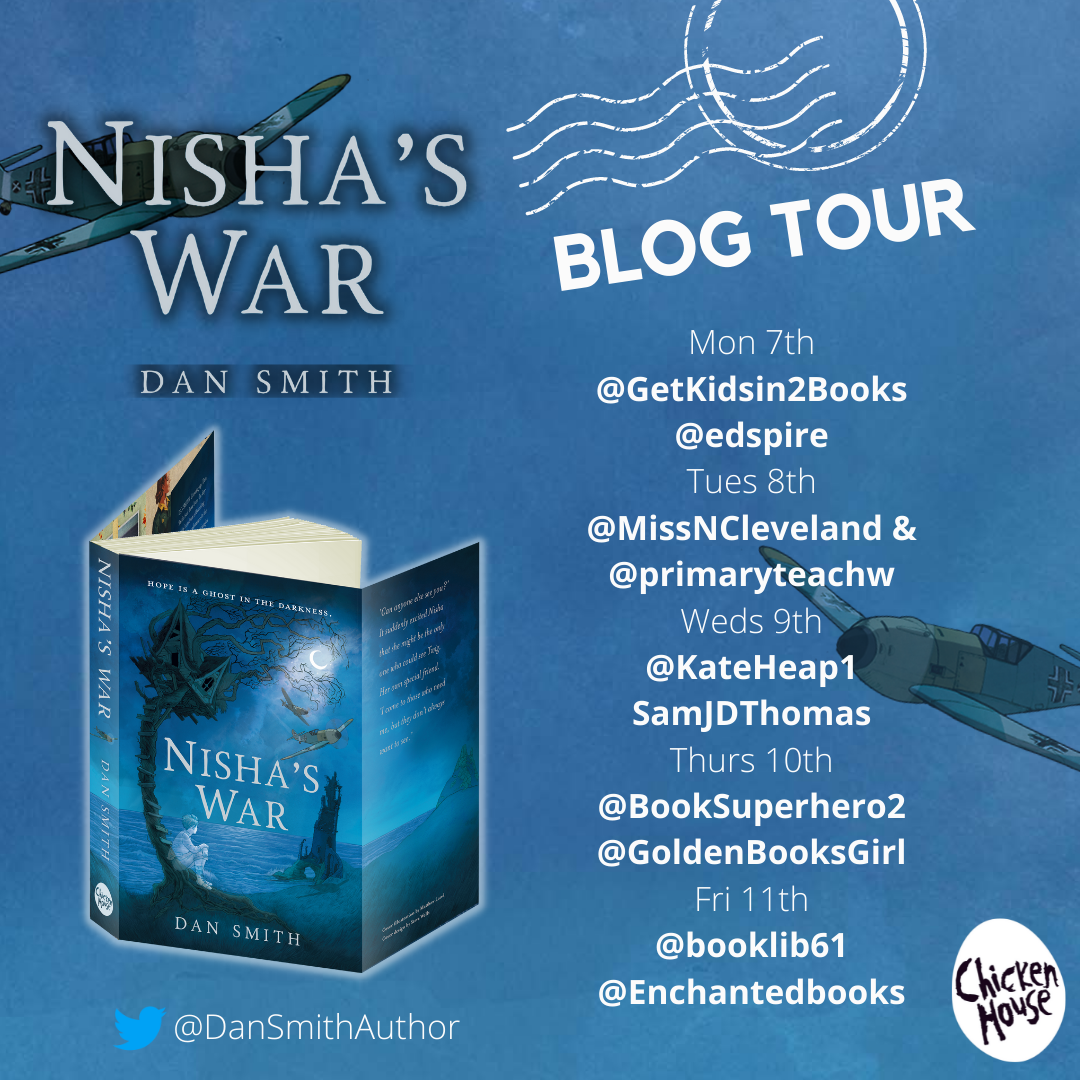
I’m thrilled to kick off the blog tour for this incredible book. Nisha’s War is an atmospheric and evocative wartime ghost story that had me gripped from the first page. Read my full review here.
Beast and the Bethany: Revenge of the Beast
Blog Tour 7 February 2022
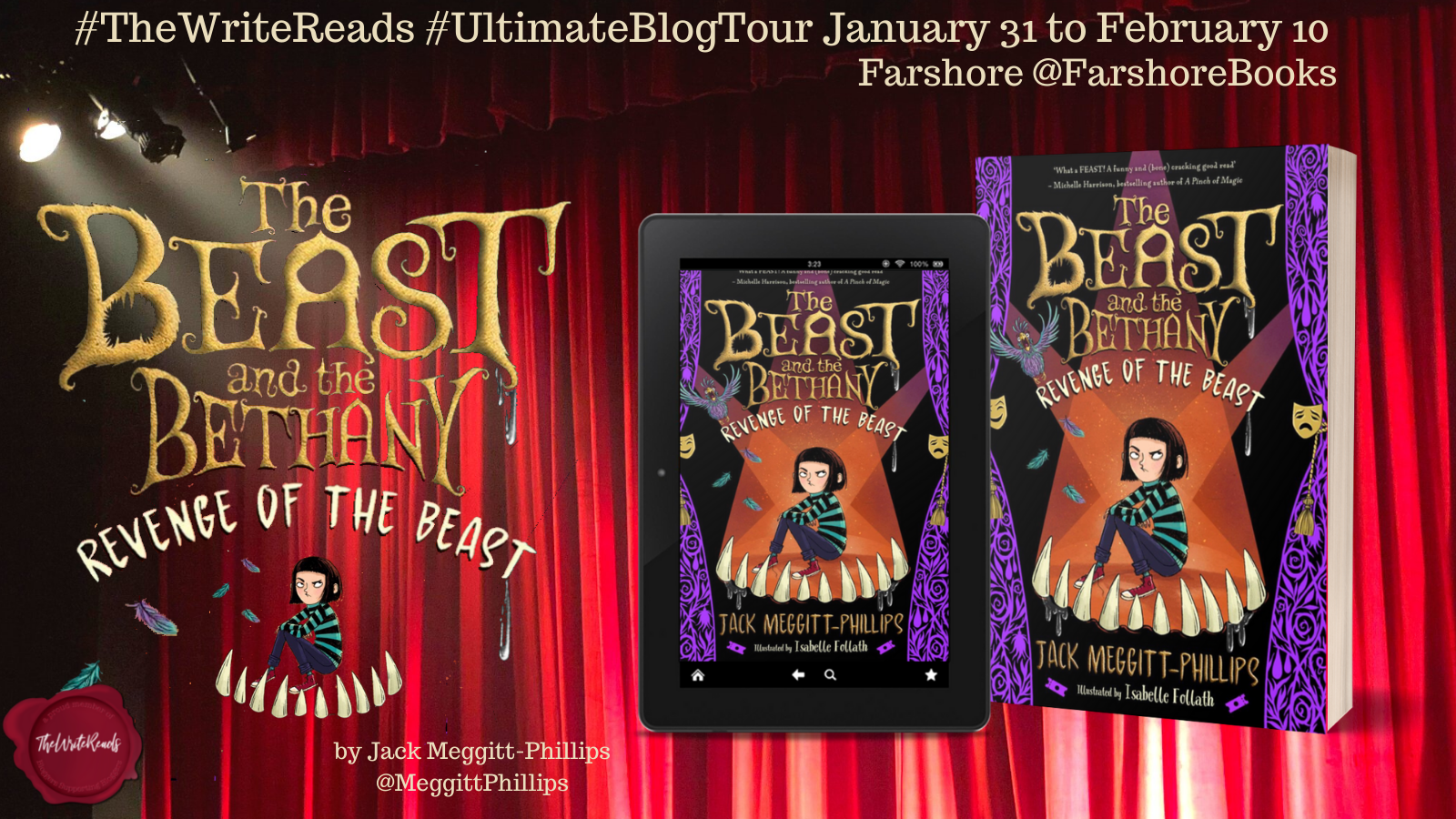
I’m delighted to be part of The Write Reads Ultimate Blog Tour for this wickedly funny book. You can read my review here.
Mayor Bunny’s Chocolate Town
Blog Tour
3 February 2022
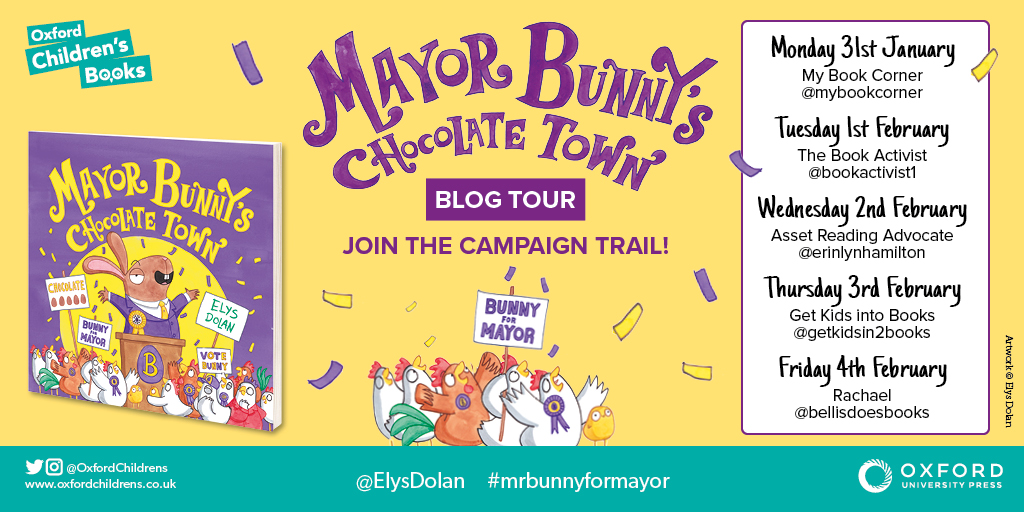
I reviewed this brilliantly funny picture book as part of the blog tour. It’s a book that will appeal to adults and children alike. You can read my full review here.
Jummy at the River School Blog Tour
19 January 2022
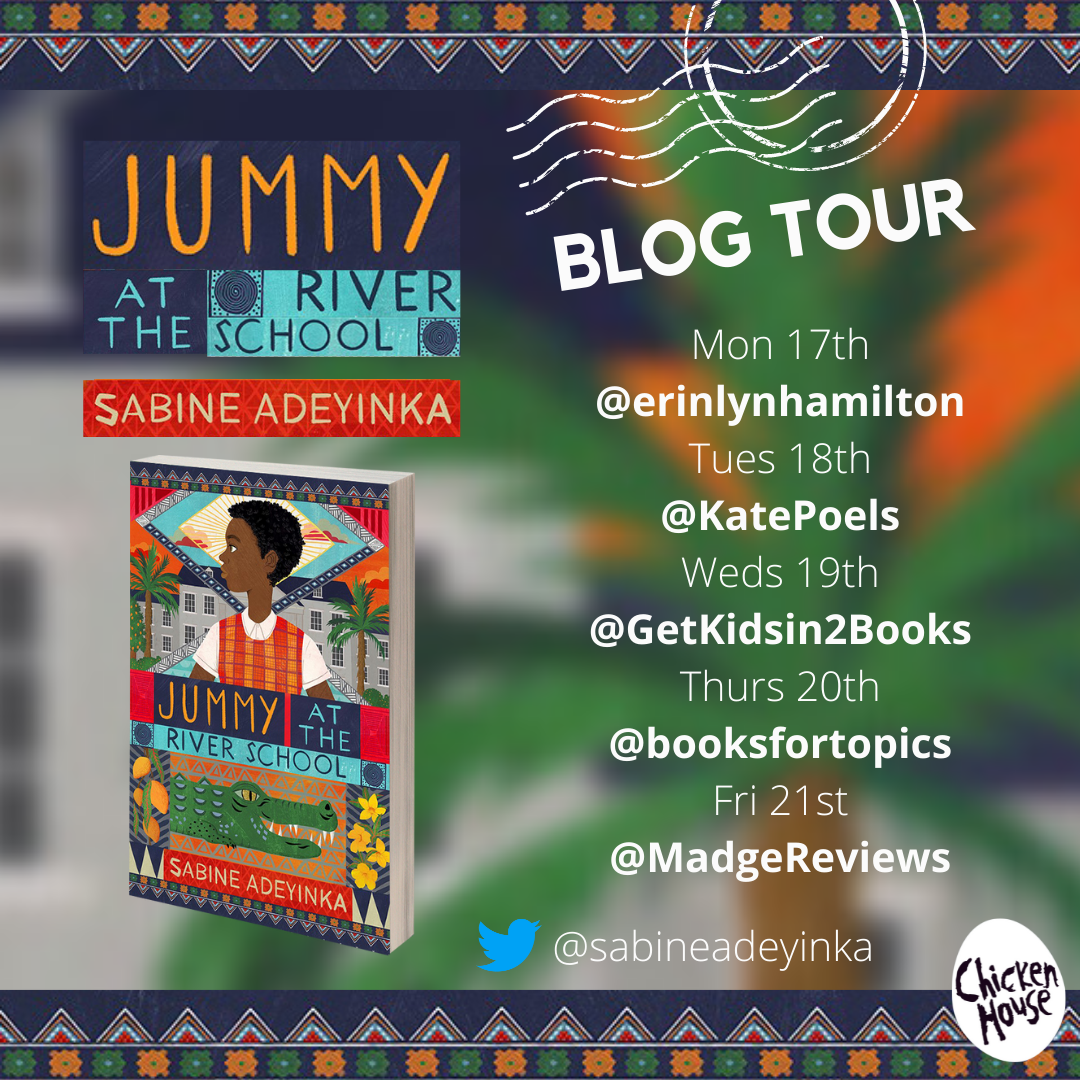
I’m delighted to share my review of this thrilling boarding school adventure, as part of the Jummy at the River School blog tour.
The Secrets Act Blog Tour
11 January 2022
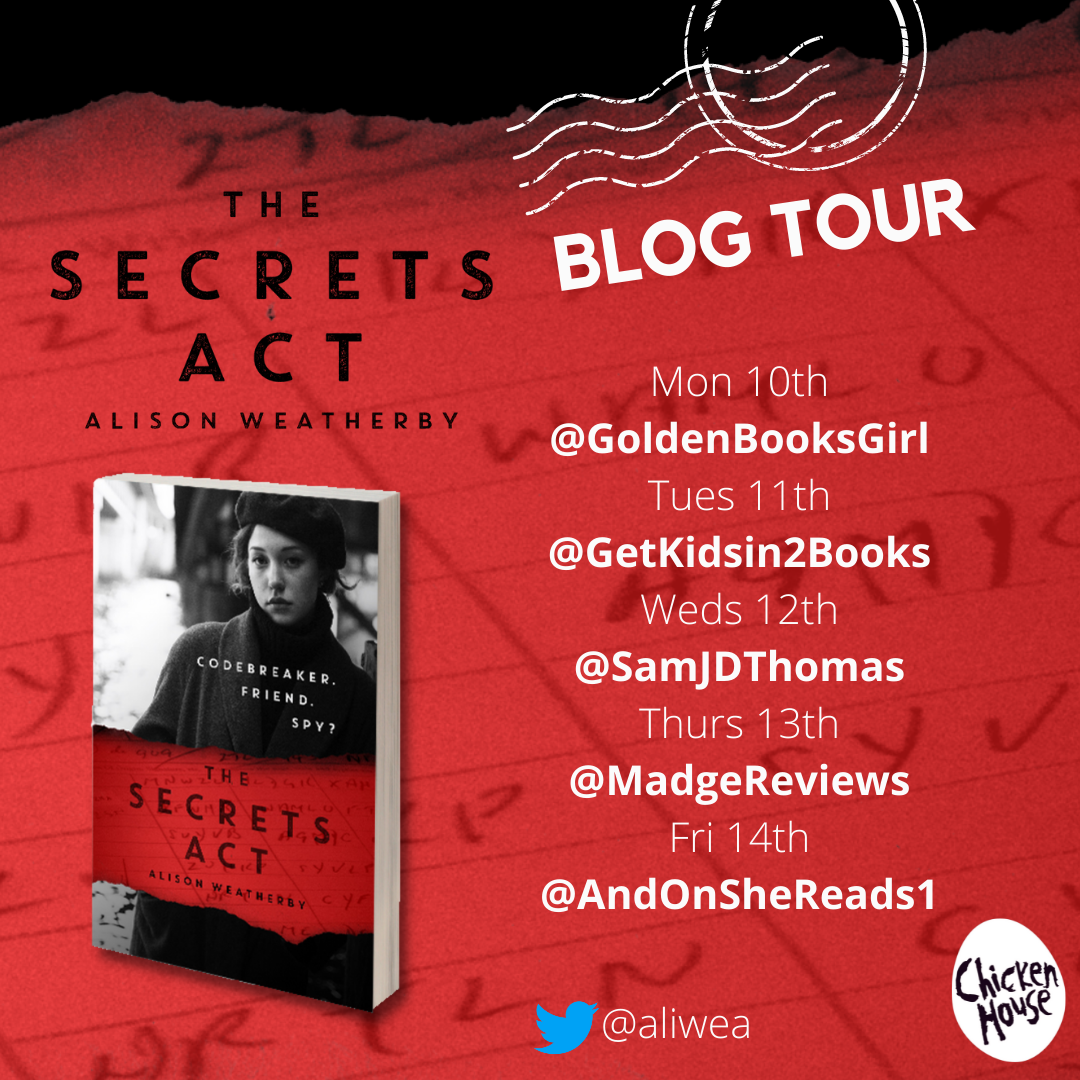
I’m delighted to be part of the blog tour for this thrilling tale of secrets and betrayal set amidst the code-cracking endeavours at Bletchley Park during the Second World War. You can read my review here.
Clementine Florentine Blog Tour
8 January 2022
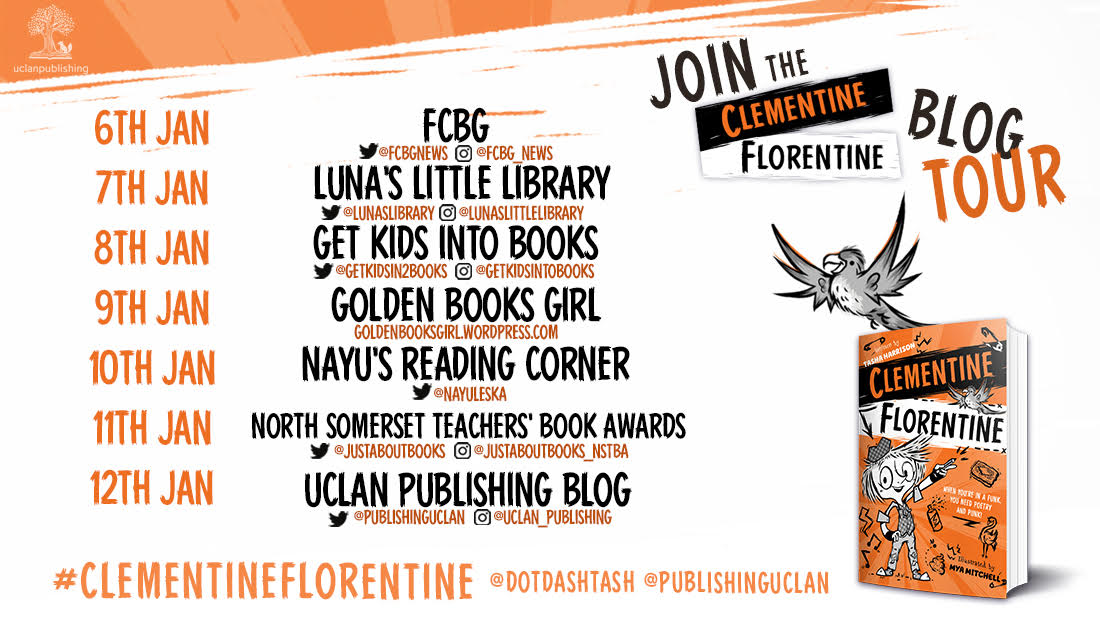
I’m delighted to welcome author Tasha Harrison to my blog today.

Get Kids into Books: Hi Tasha and welcome to my blog.
Tasha: Thank you so much for hosting me on your blog, it’s much appreciated!
Get Kids into Books: Clementine is a very relatable character. How easy do you find it to write from the perspective of a ten-year old?
Tasha: It can be challenging to always stay in character, but I have two handy tools to fall back on – my own children, who are now teenagers but were ten not so long ago, and my diary from when I was ten! I had to make sure Clem’s tone of voice was realistic for her age, so that meant considering what words she would use, and what understanding she’d have of various situations. Some of her more regrettable moments are taken from my own childhood, such as hurling mashed potato at a classmate and sticking chewing gum under the desk!
Get Kids into Books: Viv the parrot is a brilliant character! How much fun was he to write?
Tasha: Great fun! Viv is named after the character Vyvyan from the old 80s TV show, The Young Ones – which is showing my age! I went for a simpler spelling though. I knew before I started writing the story that Viv would say “Punk is dead” a lot, but I didn’t know he was going to say “Bing bong” just as regularly until I was writing the chapter where he first appears.
Get Kids into Books: What do you find usually comes to you first, the plot or the characters ?
Tasha: Generally for me it’s the characters who come first, with a few glimpses of plot. Before I started writing Clem I knew there was going to be an ageing punk rocker, a parrot, a cheeky, bubbly female protagonist, a young, cool teacher and a spoken word competition. It took a while for the main plot to show up! But as I started jotting down notes and ideas, I realised funny poems would be a big ingredient in the mix. Then, while I was writing some experimental chapters, I began to see that the conflict could come in the form of an unwanted parental romance as well as an unwanted rival poet.
Get Kids into Books: Did you have a favourite character to write?
Tasha: I loved writing Lyn Ferno. She doesn’t have much of a filter and tends to say whatever she’s thinking without a care in the world!
Get Kids into Books: Do you have a favourite place to write?
Tasha: Before lockdown I always used to write at the kitchen table, but then with family members drifting in and out every five minutes, productivity ground to a halt. Luckily we have a small spare room so I’m now in there, soaking up the moisture from the laundry rack and writing to the hum of a dehumidifier! I try to go out once a week for coffee by myself – I find it really helps to get away from my screen and sit there with my notebook and pen, scribbling down anything that comes to mind. That’s often when a scene or a bit of plot will come together.
Get Kids into Books: What’s been the best bit of being an author so far?
Tasha: After 20 years of writing manuscripts, trying to get published, and amassing hundreds of rejections, just holding a copy of my book in my hands has been utterly surreal. It’s been a long, difficult journey to get here but I’m very glad I didn’t give up!
Get Kids into Books: Thank you so much for your brilliant answers to my questions and for joining me on my blog.
** You can read my review of Clementine Florentine here. **
The Bear who Sailed the Ocean on an Iceberg
Blog Tour
12 November 2021
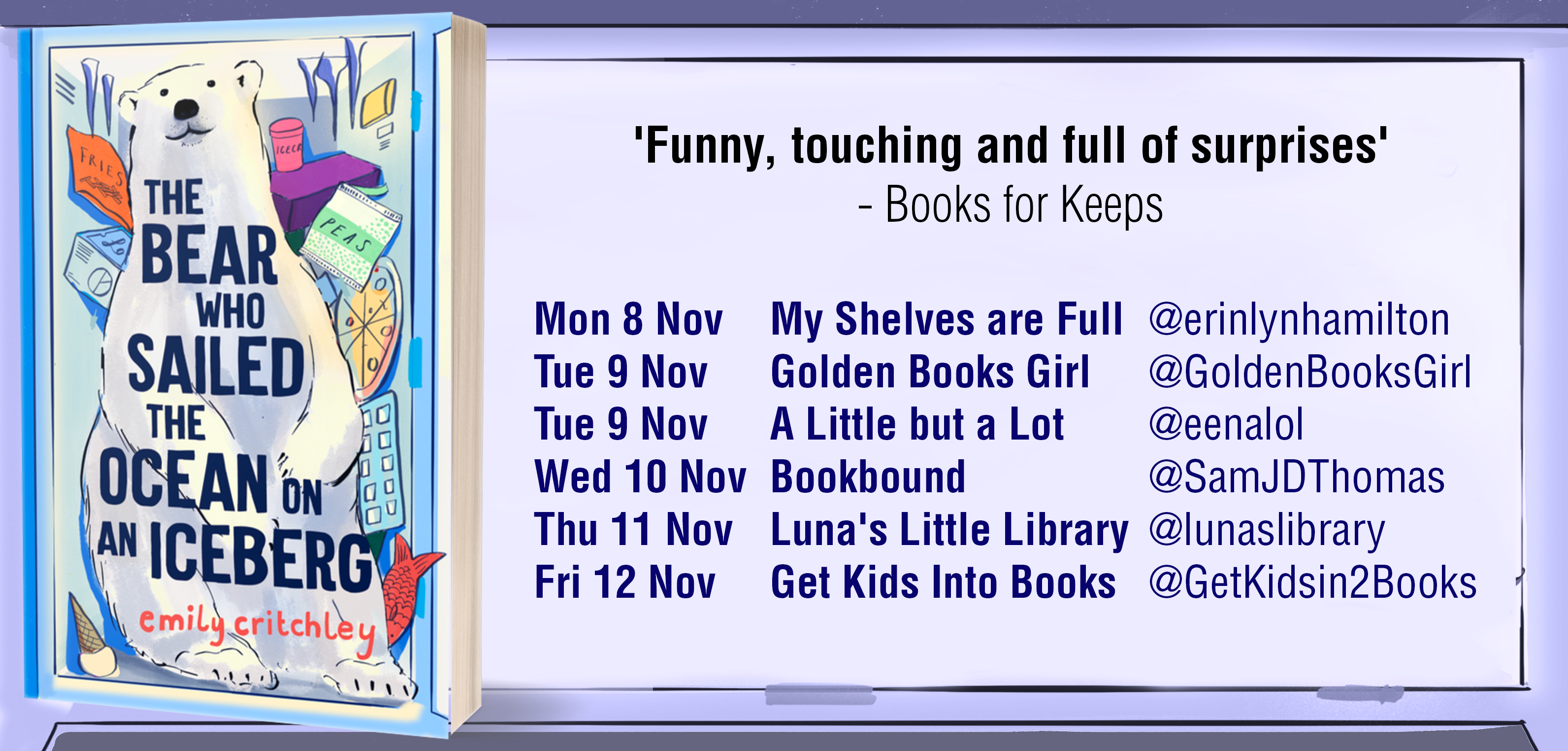 I’m delighted to share my review of this engagingly topical and heartwarming tale as part of the blog tour.
I’m delighted to share my review of this engagingly topical and heartwarming tale as part of the blog tour.
Hag Storm Blog Tour
2 November 2021
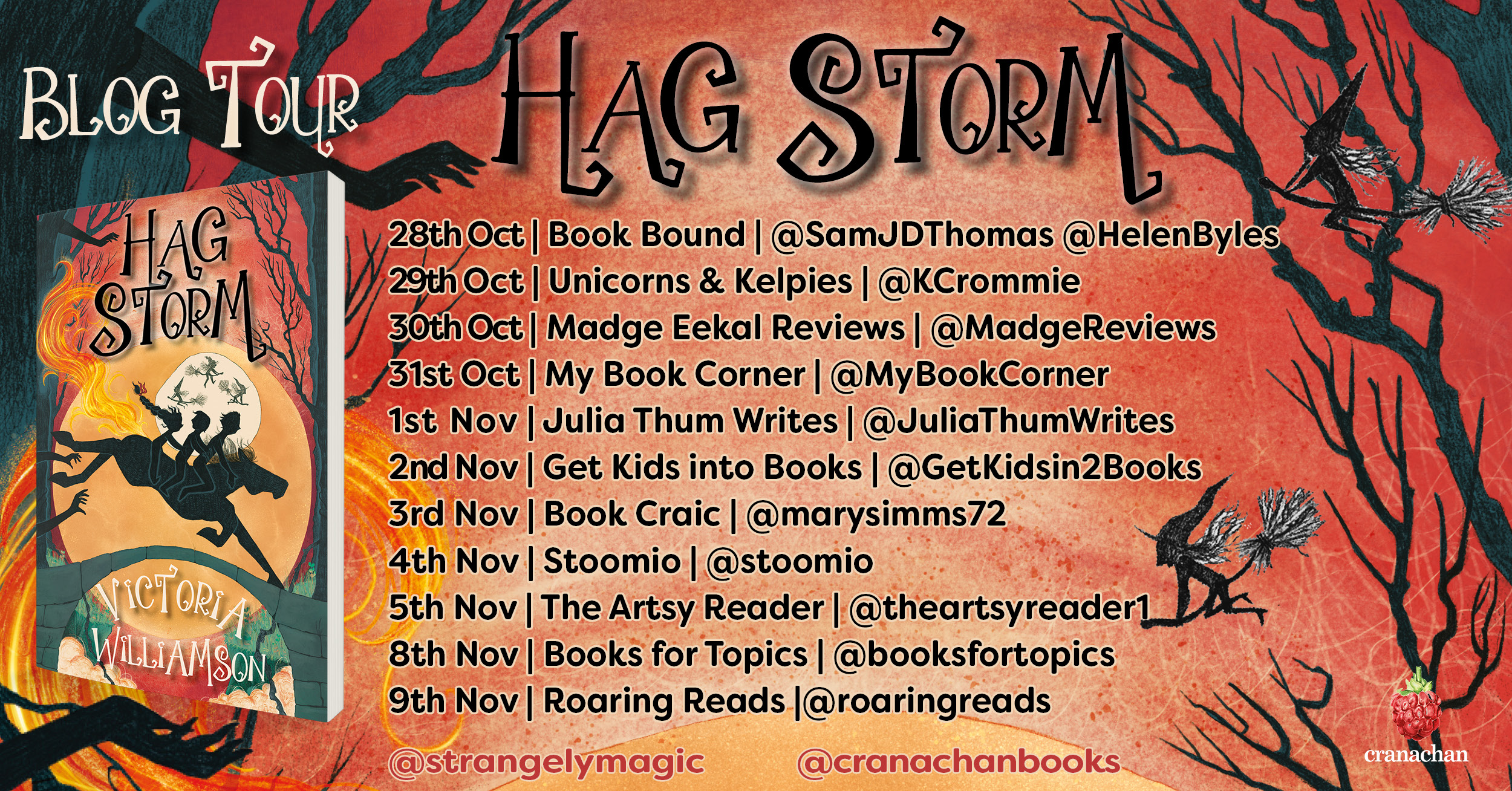
I’m delighted to host a guest post from author Victoria Williamson as part of the Hag Storm blog tour. She’s written about her love of witches, a fascination that began in childhood.
The Witches of My Imagination
Ever since I was a child, I’ve had a fascination with witches.
I’m not sure whether it was the thought of the spells, the magic potions, or the flying around on broomsticks that I loved the most, but there was certainly something about witches that captured my imagination like nothing else. My father liked to tell the story about how when he took me to see the Snow White Disney film when I was four, I burst into tears when the evil witch fell to her death from the mountain. Asking me what the matter was, I apparently said that she was the best person in the film, and the story wouldn’t be any good now.
Some of the earliest picture books I remember my mother reading to me were the Dorrie the Little Witch books. I don’t remember the details now of the stories about Dorrie getting into mischief with her wayward magic, but the atmospheric illustrations by Patricia Coombs clearly inspired my own childhood artwork. I might not have captured Coombs’ whimsical style exactly in the early pictures I drew, but I certainly borrowed heavily from her!
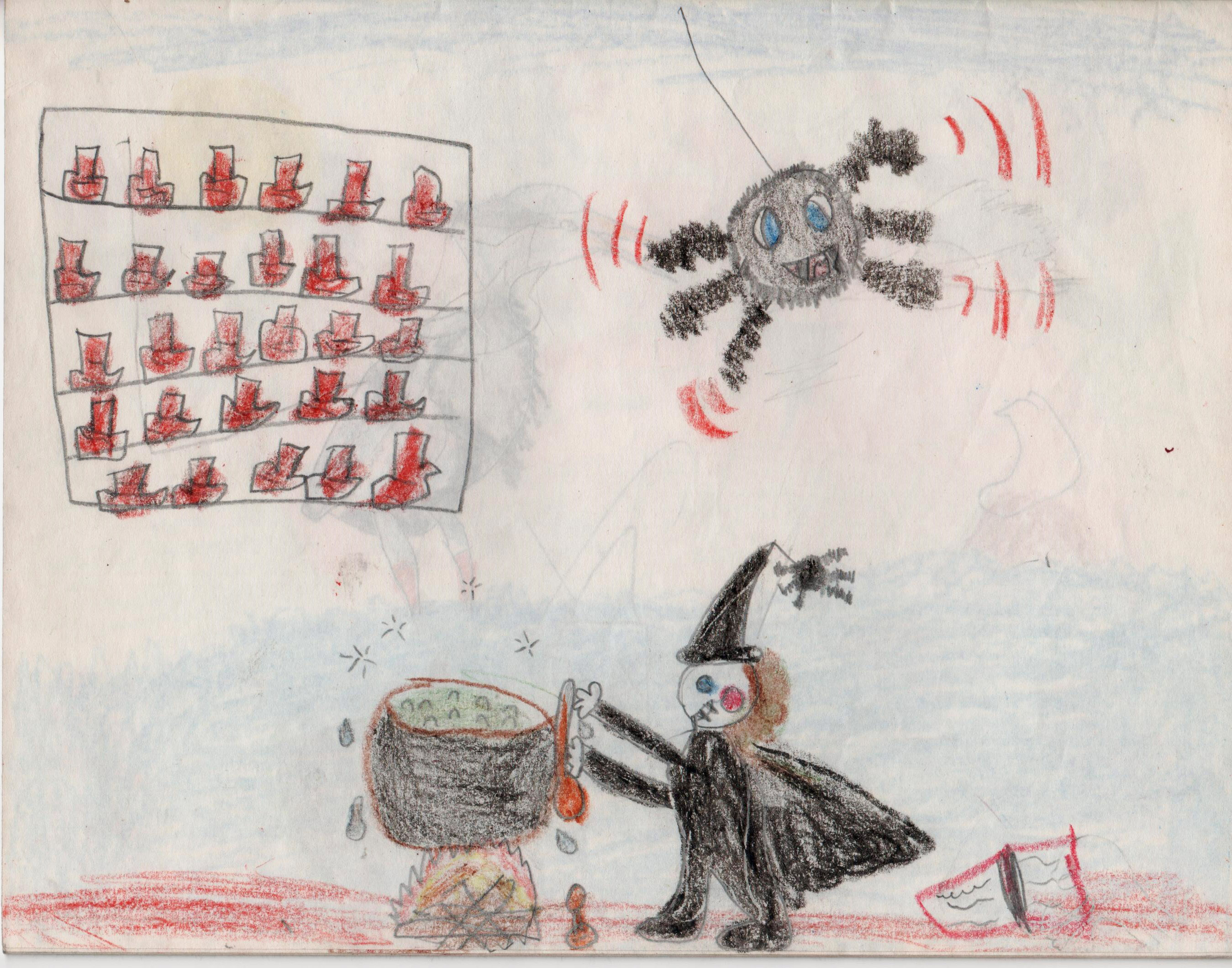
I didn’t like all witches in equal measure, though – some I was absolutely terrified of at a young age. For some reason I had a real fear of the pantomime-like witch Grotbags in Rod Hull’s Emu TV shows, and hid behind the sofa whenever she came on screen. I found the Grand High Witch in Roald Dahl’s The Witches equal parts scary and fascinating, and was enthralled by the White Witch in The Lion, the Witch and the Wardrobe, despite feeling the hair on the back of my neck prickle whenever she was mentioned on the page.
It wasn’t just witches’ magic and their ability to fly that captivated me as a child, it was the way they seemed to stand outside the humdrum boxes of everyday life we all had to fit into. They were powerful women, and their motives were unashamedly self interested, very unlike the ‘good little girls’ we were taught to aspire to be. My earliest heroes were the young witches who were initiated into this sisterhood, some with more success with others, and the first books and plays I wrote in the first years of primary school were retellings of these witch tales, such as a puppet play script of The Worst Witch I wrote in primary three.
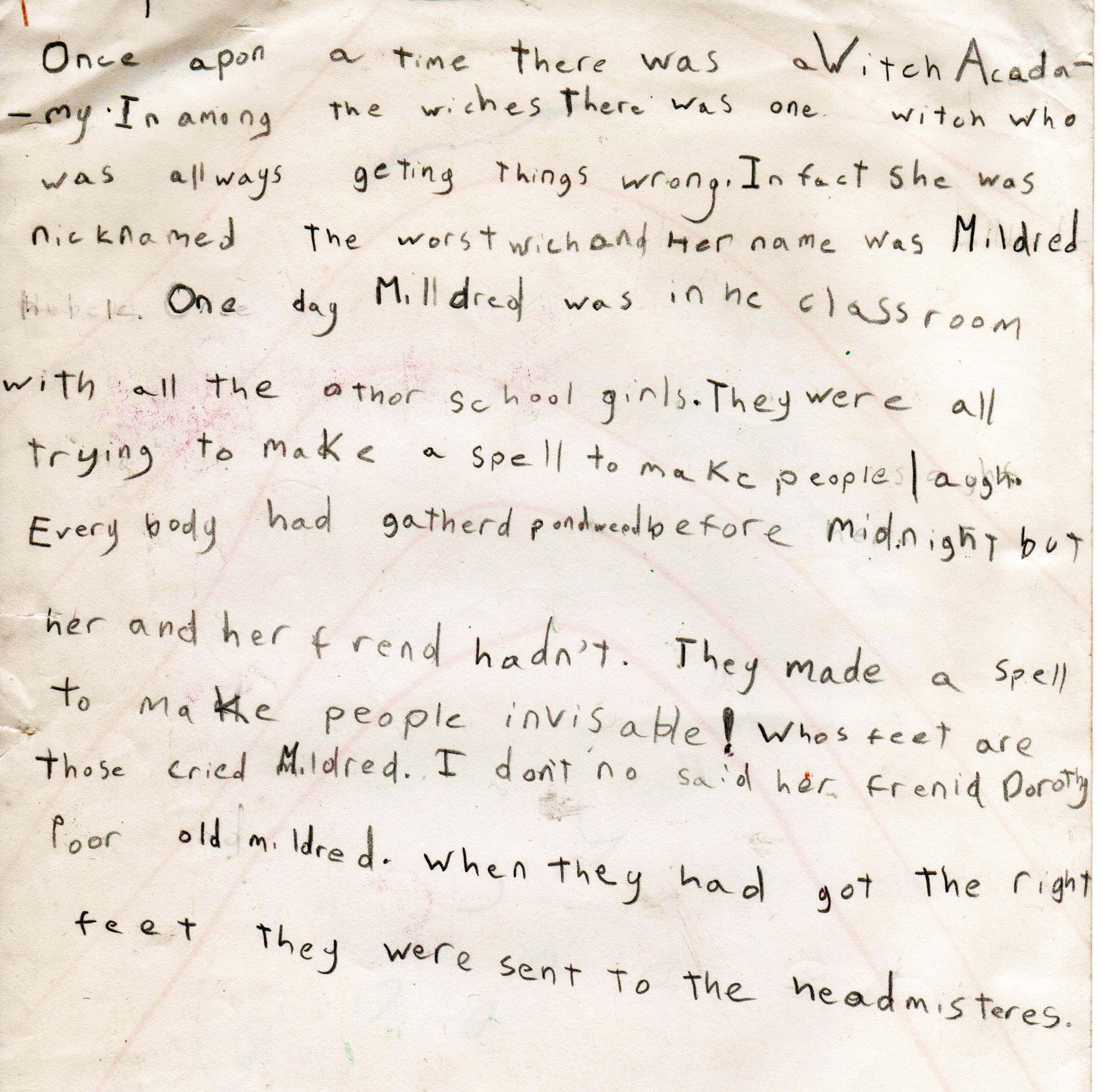
Studying the poetry of Robert Burns for the first time in primary four, I was spellbound by the tale of witches dancing in the Auld Kirk in Alloway, and every Halloween after that, I wanted to dress up as a witch despite everyone else thinking that was the most boring choice imaginable. Then of course, along came Hermione Granger. The first of the Harry Potter books wasn’t published until I was in my late teens, but I instantly identified with Hermione, who basically was me at school. My hair had been a frizzy mess from an 80s perm hangover, and my nose was forever stuck in a book. If I could at least have been able to console myself during dull classes that I was mastering magic spells instead of conjugating endless French verbs, I might have enjoyed school a whole lot more.
It’s no surprise then, that now as an adult author, witches feature prominently in my next book, Hag Storm. Inspired not just by my early love of witchy tales, but by Scottish history, folklore, and the poems of Robert Burns, Hag Storm weaves all of these together in a story of adventure and magic. You’ll have to read the book to see what happens at the end, but whether the witches win or meet their doom at the hands of the young Rab, I’ve had lots of fun revisiting the tales of witches that fired my imagination as a child.
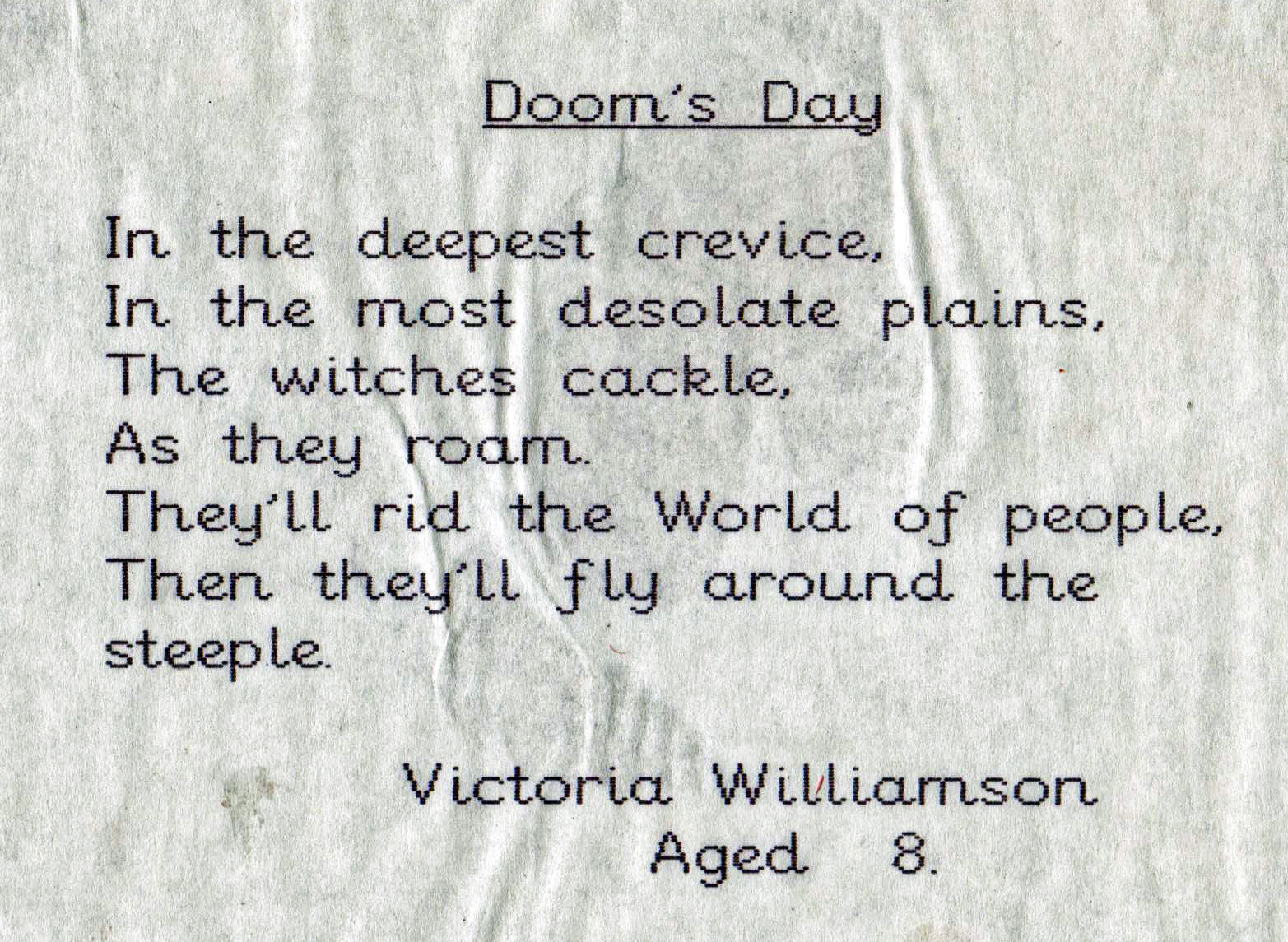
The Hideaway Blog Tour
1 November 2021
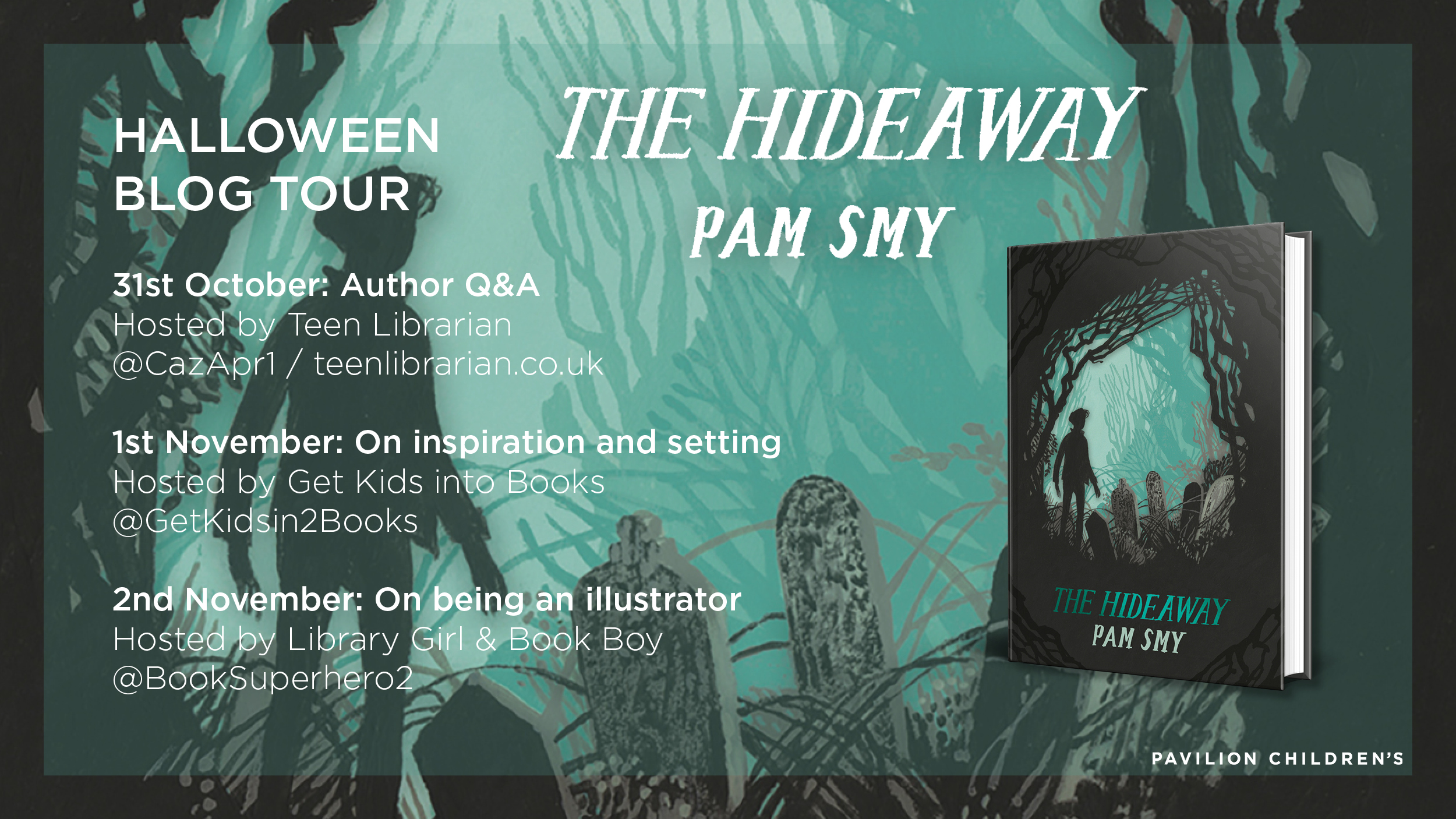
I’m delighted to share an interview with author Pam Smy about the inspiration and setting for her latest middle grade novel, The Hideaway.
Q: Can you tell us a little bit about the book – the story, characters, maybe something about themes of family and connection, finding where you belong?
A: The Hideaway is about a boy called Billy McKenna who is having a really difficult time at home, and decides to run away. The story intercuts between following Billy and what happens to him, and his mum, Grace, and her story as she tries to come to terms with the problems that have caused Billy to leave.
Billy himself is in hiding, not wanting to be found, but also their family situation has been hidden. As Grace finds the courage to ask for help, she finds a network of women who are there to help, in a professional capacity or as friends.
The underlying theme of the book is about the need for connection and the importance of loved ones and community to each of us.
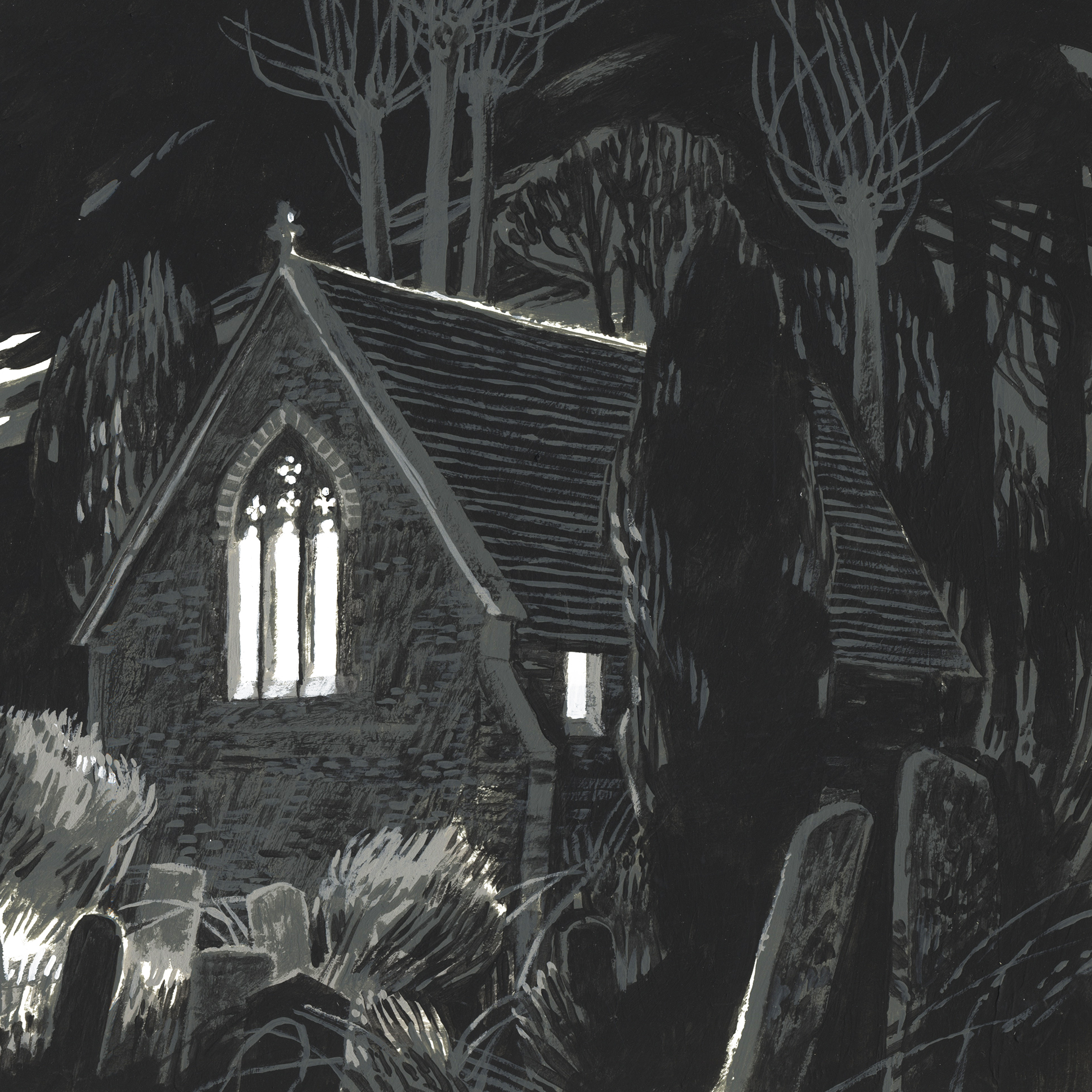
Q: What inspired the setting for The Hideaway?
A: Billy hides away in an old World War 2 pillbox which is overgrown on the edge of a graveyard. This is based on a real place – The Ascension Burial Ground – here in Cambridge.
I have a morning walk that I take my dog on. I pass through a well-managed, clipped and tidy graveyard at the top of my street, through a park, and then onto the Ascension Burial Ground. I walk round that, brushing past a pillbox that is covered with overgrown ivy to get out onto a field beyond.
This second graveyard is overgrown, and full of tangled brambles and ivy and yews that have grown around headstones. It is beautiful and full of wildlife
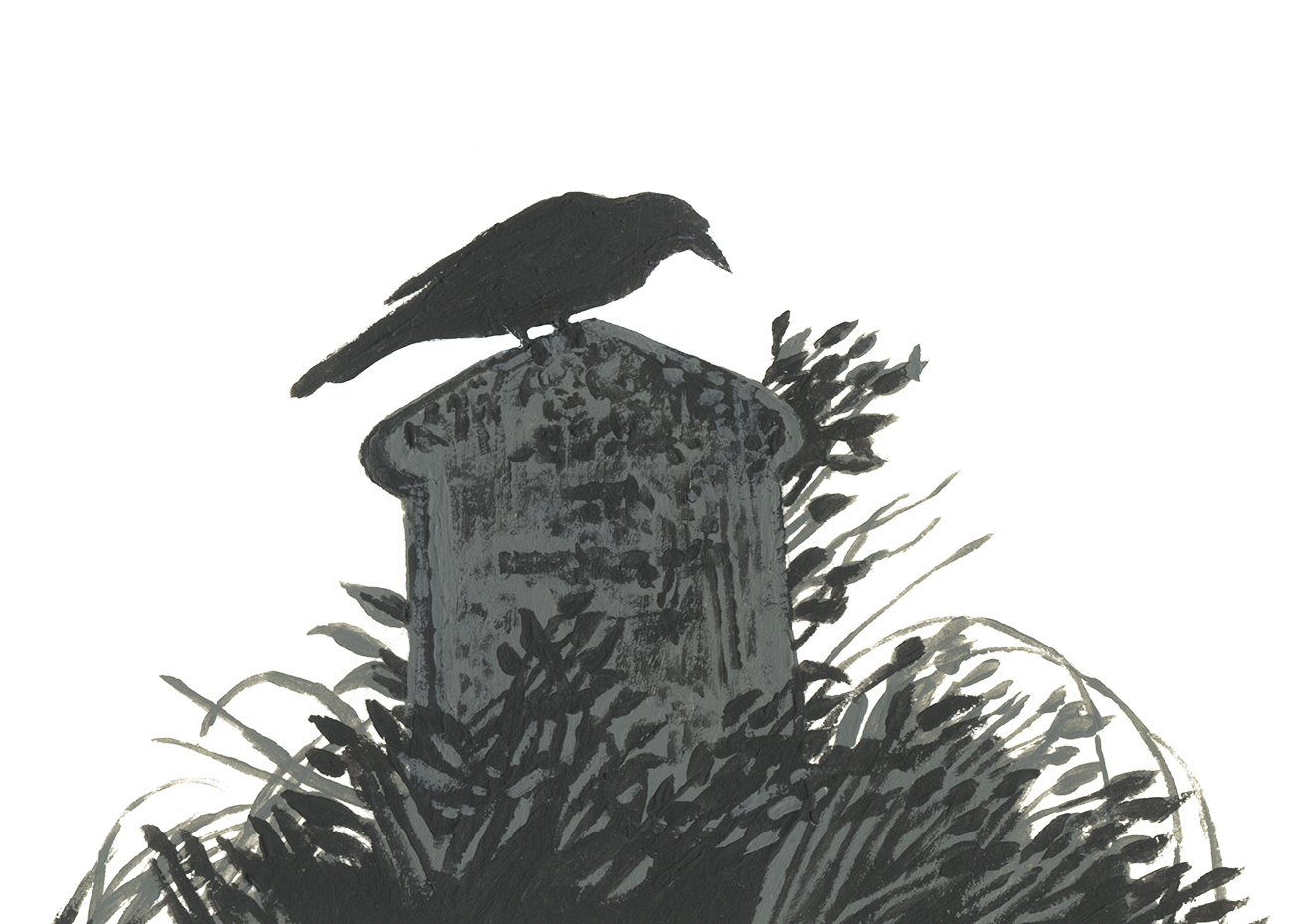 I know that graveyards can be places of sadness or fear for some people, but I associate this place with feeling calm, with the quiet, and with the beauty of nature. The headstones can be sad, but I also find them as statements of love and care – of how important people are to each other. In the winter months I am often walking through there in the darkness of the early hours and I never feel spooked at all.
I know that graveyards can be places of sadness or fear for some people, but I associate this place with feeling calm, with the quiet, and with the beauty of nature. The headstones can be sad, but I also find them as statements of love and care – of how important people are to each other. In the winter months I am often walking through there in the darkness of the early hours and I never feel spooked at all.
Q: What or who inspired the characters and the dynamics between them?
A: Billy and his mum, Grace, are completely invented and are not based on anyone I know. But the old man that Billy befriends in the graveyard is based on the old chaps that I knew when I was growing up in Suffolk. These men were gruff and no-nonsense and often worked outside, and were kind and knowledgeable and practical. I couldn’t name one of them now, but I have drawn on my memories of them for the book.
Q: Why did you chose All Souls’ Eve as the event around which everything in the story would culminate? Did you do any research around the festival for writing this book?
A: I didn’t know anything about the tradition of All Souls’ Eve, except for some foggy notion that it was linked to Halloween and the rising of the dead at that time of year. But in the graveyard this story is inspired by is a carving of a poem by Frances Cornford called All Souls’ Night* that is about two lovers being re-united on a November evening. I am not a great reader of poetry, but this struck me as an atmospheric and tender poem, so I did a swift bit of reading online to learn more about it.
Once I had associated that poem with the carving of it next to Frances Cornford’s grave and the idea that the dead wanted to be re-united with those they loved, the story fell into place for me.
From that point I used All Souls’ Eve for my own purposes – and didn’t research it at all in case the reality didn’t match what I wanted to write in my story.
Q: Why have you used a dual narrative? Did this come about in the early planning stages, or later on?
A: I love a dual narrative, or even multiple narratives, be that in a novel or in a crime drama or film. I enjoy being immersed in one character’s story and then, just when I want to know what will happen next to them, I am picked up and taken somewhere else. I enjoy the tension it builds, and how the combination of those narratives can fuse or contradict and make a story greater than the sum of its parts. I also enjoy the technical challenge of it.
The idea that I would use this for The Hideaway was there at the outset, the difference between Grace’s real world problems, and Billy’s experience in the protected space of the graveyard.
Q: You worked with a domestic violence charity when researching this book – can you say any more about that?
A: I needed to make sure that this story that would reflect the reality of victims of coercive control and domestic violence, so that it would ring true for those who may experience it, have friends or family or neighbours that are experiencing it, or who want to understand more. As I was writing this I met with someone who works with vulnerable families and she taught me so much about process, personalities, warning signs, procedures and the laws around domestic violence. She then was generous enough to read through the manuscript and correct me when I had made mistakes and I am hugely grateful to Amanda at the Cambridgeshire and Peterborough Domestic Abuse and Sexual Violence Partnership for her time and insight.
Q: Do you have a routine or favourite spot for writing and illustrating?
A: When I am writing I tend to get up at 5am and make a cup of coffee and sit on the sofa in lamplight and write for an hour. I try and set myself a few hundred words each morning. At 6am I go out and walk the dog, and I won’t look at the text again until the next morning.
I can paint anywhere as long as I have the pots of paint and my sketchbook with me.
Q: Do you ever get creative block?
A: I usually have one idea in waiting as I finish the current project – whether that is a story or a self-initiated illustration project. I can be excited about what I am working on and the next thing at the same time.
But since the first lockdown here in the UK I haven’t had any ideas for anything, and my focus has been much more geared towards my job as a lecturer in an art school as we try and adapt to constantly shifting circumstances. I am not worried, as I know that it is the external situation and once things return to ‘normal’ there will be space for my imagination to flow again.
I do believe in long walks, going to the cinema, time with friends and reading as inspiration.
The Hideaway by Pam Smy is published by Pavilion Books, out now, £14.99 hardback.
*All Souls’ Night by Frances Cornford
My love came back to me
Under the November tree
Shelterless and dim.
He put his hand upon my shoulder,
He did not think me strange or older,
Nor I, him.
Rita Wong and the Jade Mask Blog Tour
6 October 2021
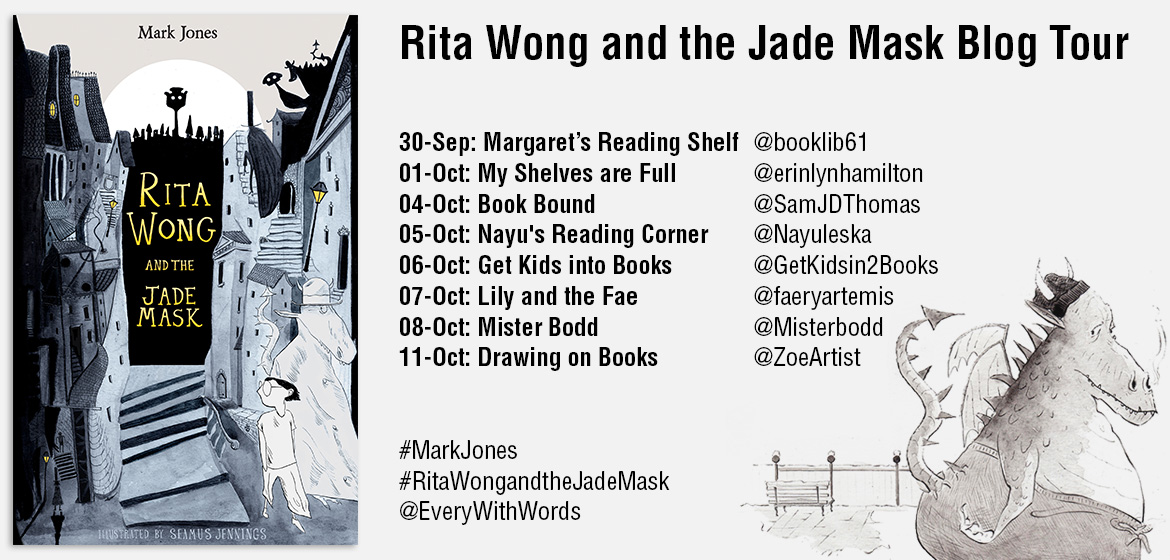
As part of the blog tour for Rita Wong and the Jade Mask, I shared my review of this sophisticated crime thriller with a case for you to crack. Read my full review here.
Earth is Big Blog Tour
28 September 2021
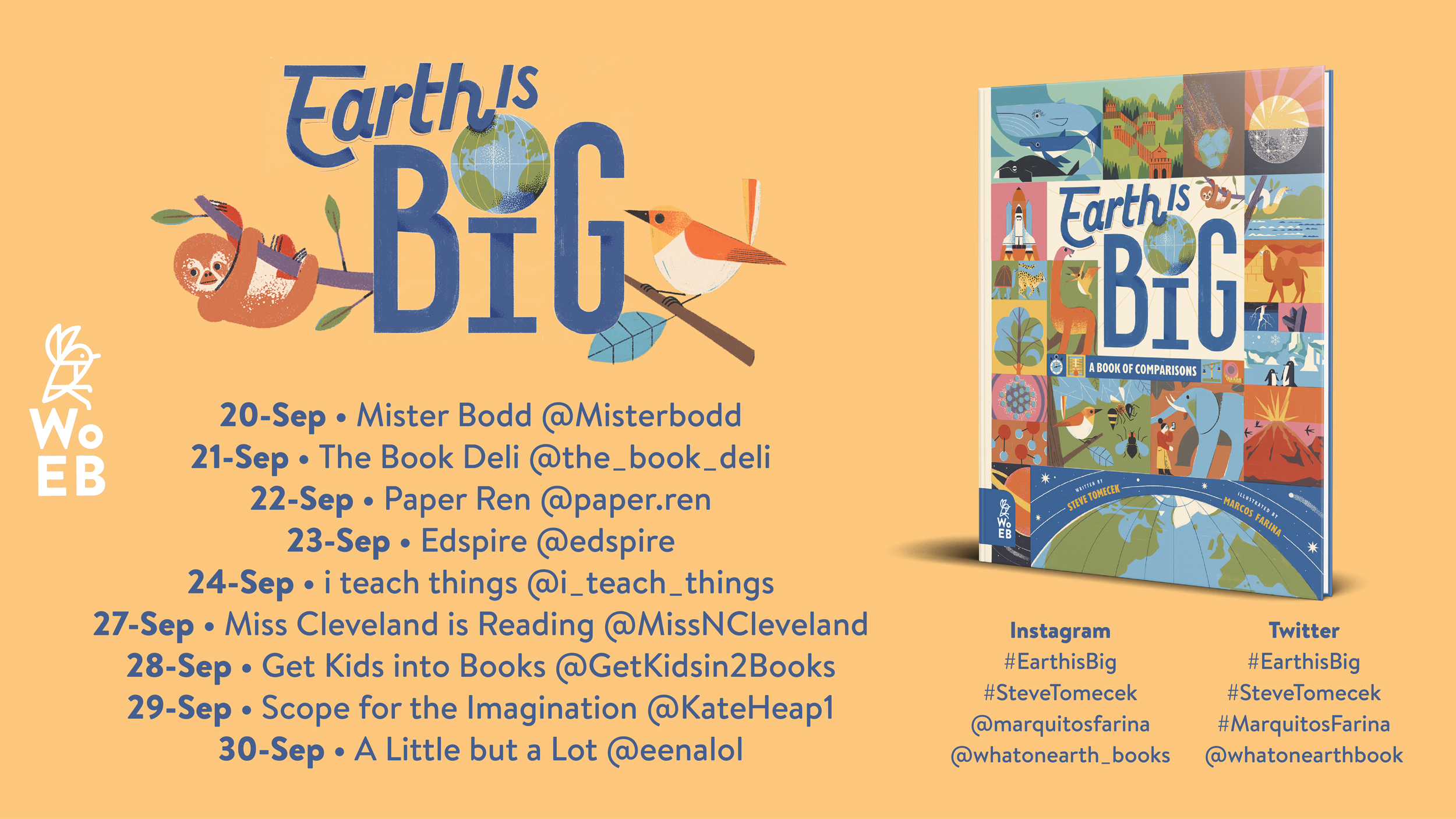
I’m delighted to be part of the blog tour and share my review of this fabulous non-fiction book. Earth is Big: A Book of Comparisons is stunningly designed and richly informative, allowing us to learn incredible facts about our world and to discover how it compares against other objects – big and small. Click here for my full review.
Peanut Jones Blog Tour
5 September 2021
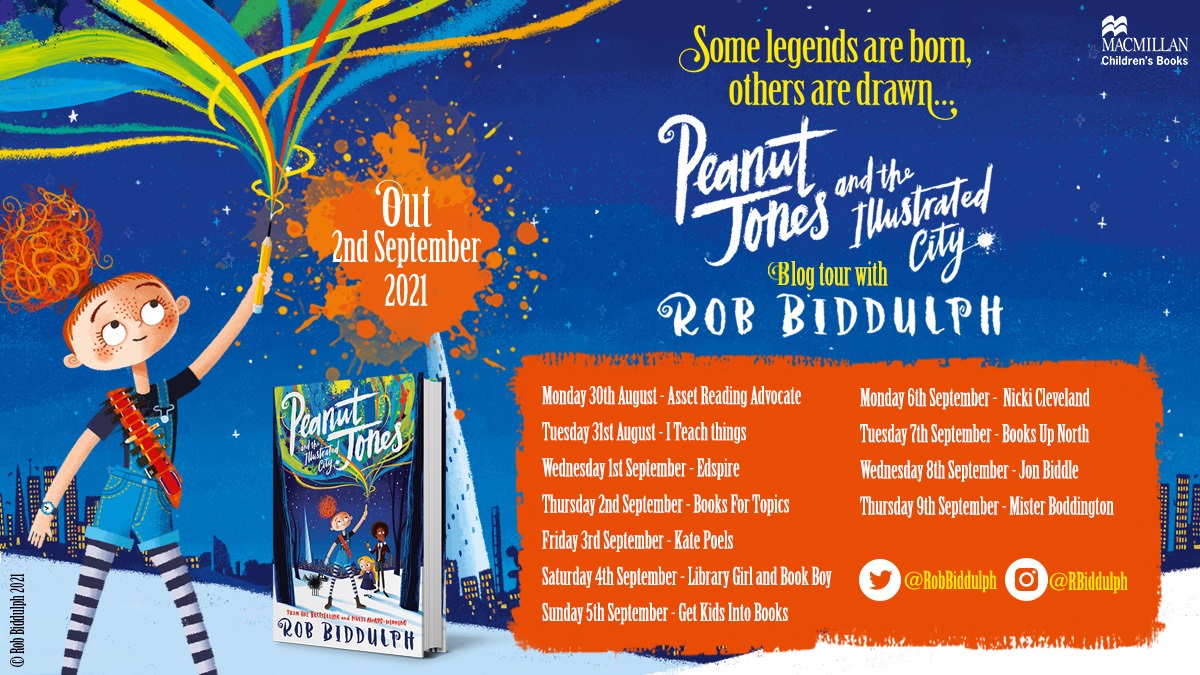
I’m thrilled to be part of the blog tour for Peanut Jones and the Illustrated City. It’s an absolute cracker of a book! You can read my review here.
Scaredy Bat Blog Tour
24 August 2021
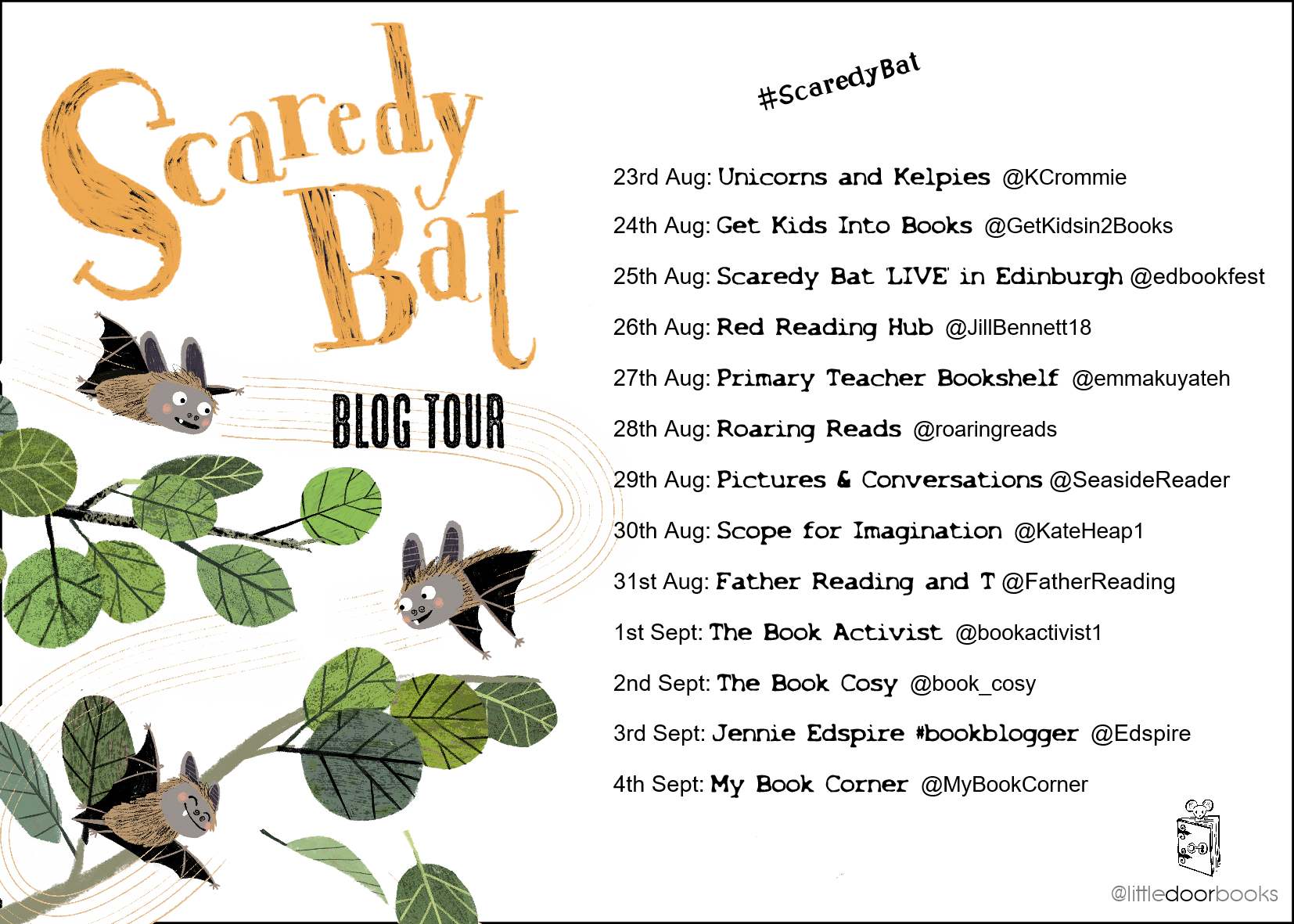
I’m delighted to share my review of this charming new picture book as part of the Scaredy Bat blog tour. You can read more about this adorable bat’s adventures here.
How to Survive Without Grown-Ups
Blog Tour
21 August 2021
I loved this debut children’s novel by Larry Hayes and was delighted to review it as part of the blog tour.
The Wild Before Blog Tour
17 August 2021
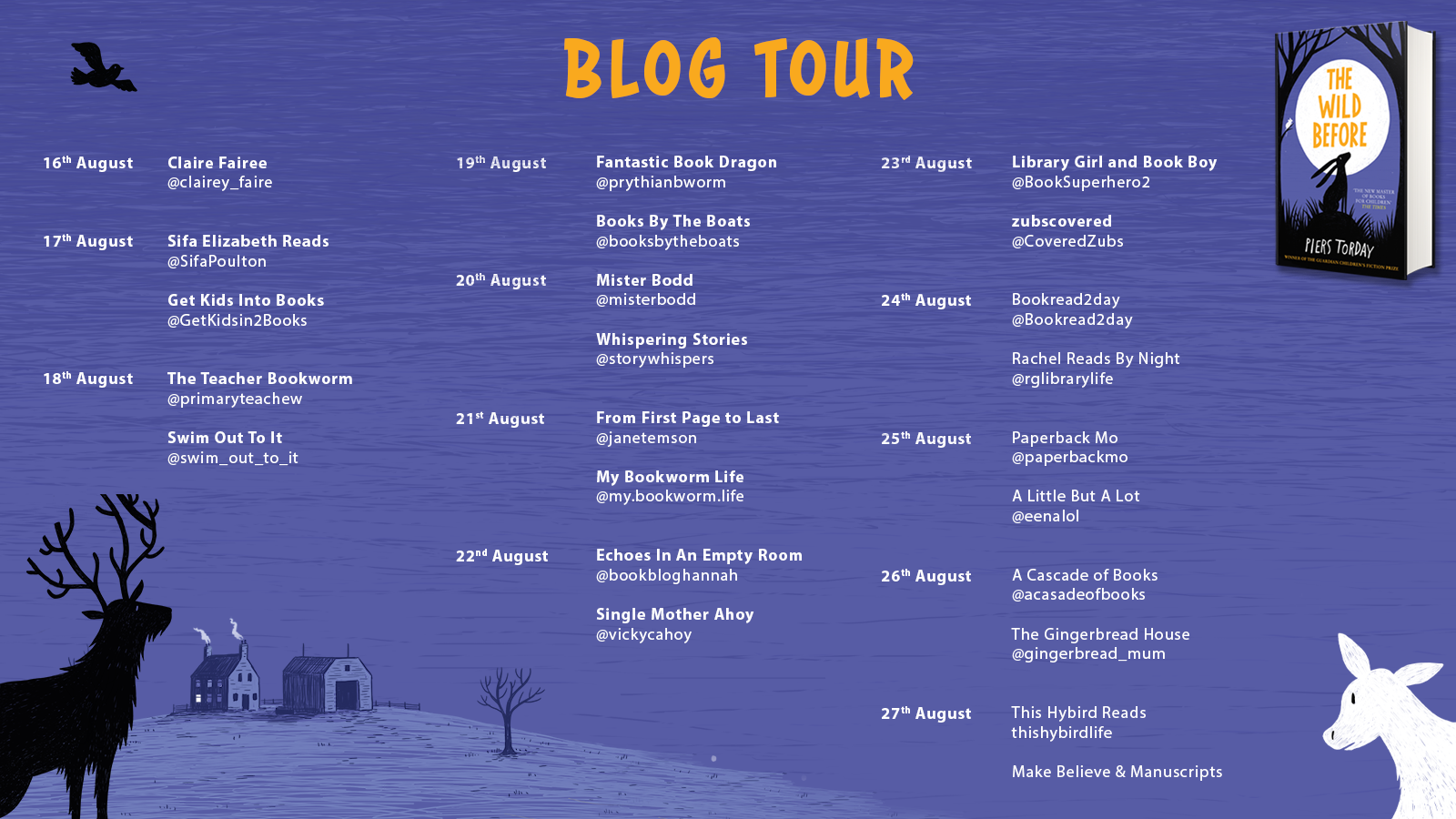
I’m delighted to be part of the blog tour for such a timely and special book. The Wild Before is a stunning prequel to the bestselling and beloved The Last Wild trilogy, exploring the topical yet timeless themes of environmental awareness, friendship, and hope.
Author Piers Torday explains why he wanted to return to the series:
“I first had the initial idea for The Last Wild in 2002 – now, twenty years later and inspired by the urgency and fearlessness of Greta Thunberg, I knew it was time to return to the climate change debate. As we face a race against time, the power of stories can change and save our world – one of wildness, beauty, and love. In The Wild Before that tale begins with quite possibly the bravest little hare that ever lived.”
I’m excited to be able to share a sneak preview of the book (which publishes on 19 August).
“Get out of my way,” says Little-Hare.
The wolf throws her head back, howling with laughter.
“I’m sorry, what did you say?”
“I said, get out of my way.”
The other wolves join in the laughter, shaking with mirth. They are too amused to even tear his soft belly open with their claws, as they were about to.
“Give us one good reason why we should,” says the first wolf.
Little-Hare is not laughing. His watchful amber eyes never leave the wolves for a second. He sighs, and delivers the message that has been burning in his belly since he left the valley he called home.
“Because our world is about to end. There is nothing you wolves can do to stop the enemy chasing me. I was chosen, I tried, and . . . your wild is my last chance. Our last chance. Sounless you want to die, get out of my way. Now.”
Then, before they can reply, he is off, bounding further and further into the deep oak wood.
For he is not just any hare.
He is the hare of all hope.
Fireborn The Write Reads Blog Tour
9 August 2021
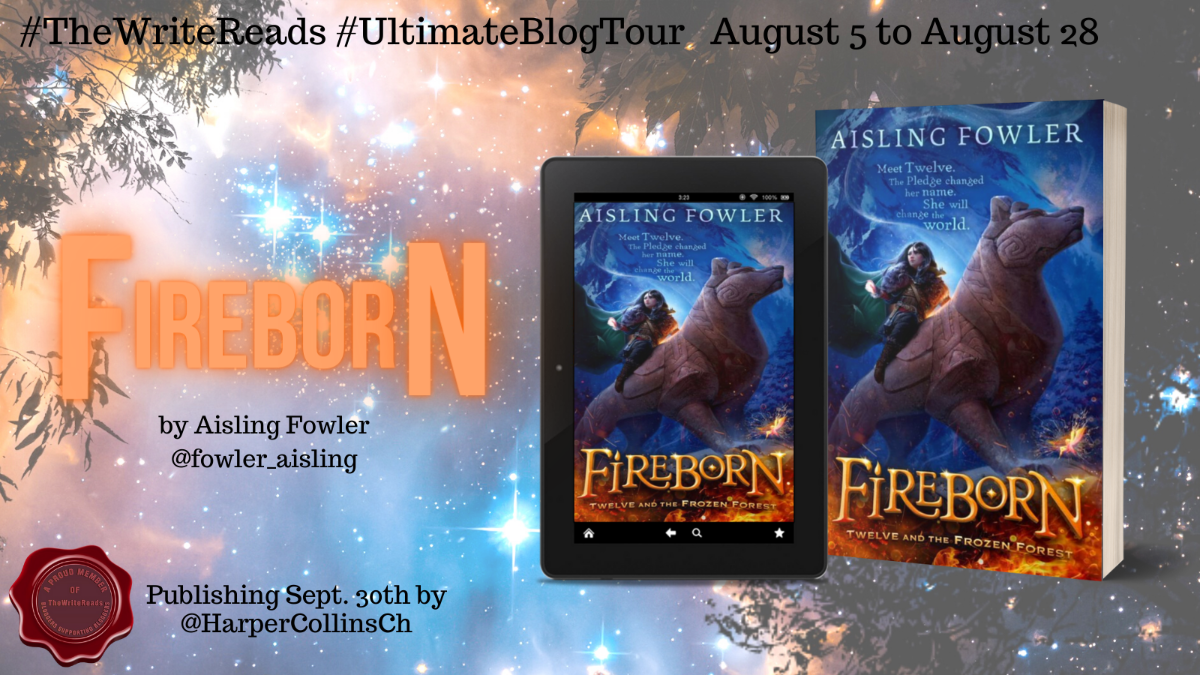
I absolutely loved Fireborn. Here’s my review.
Three Little Vikings Blog Tour
28 July 2021
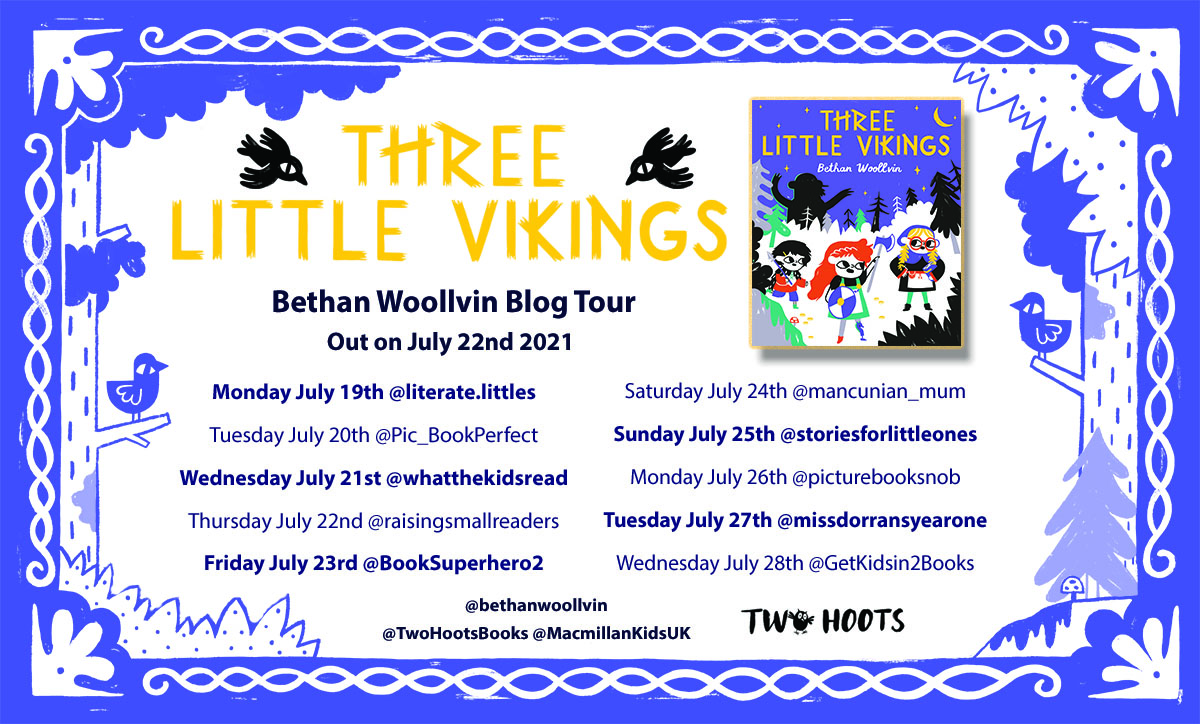
I’m so thrilled to be part of this blog tour and to champion another of Bethan’s books. Read my review of Three Little Vikings here.
The Most Important Animal of All
Blog Tour 15 July 2021
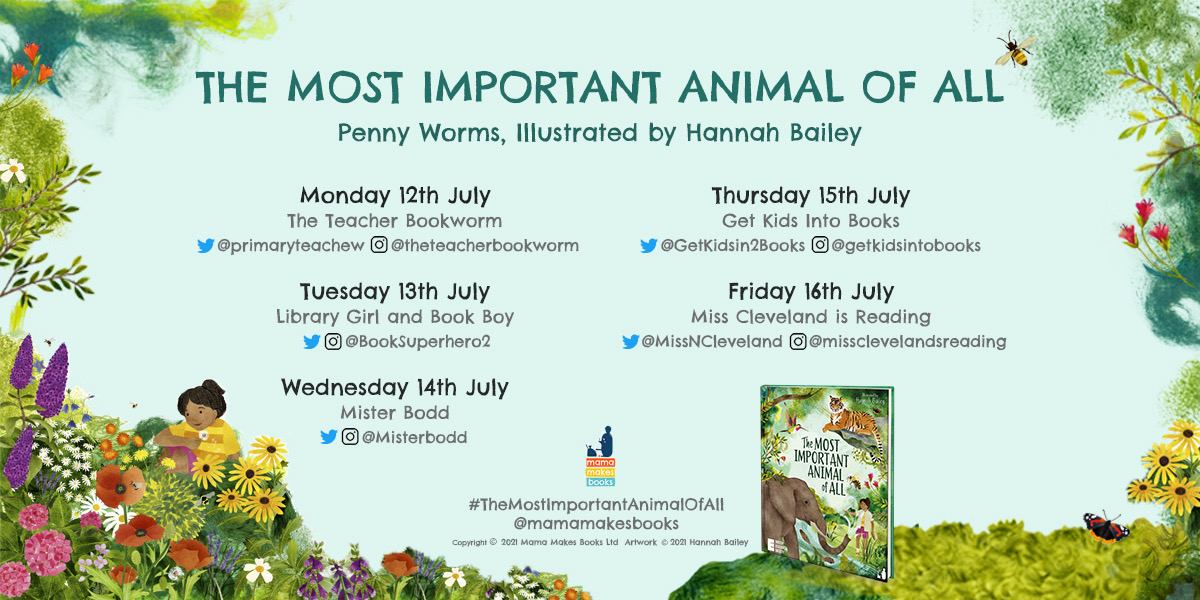
I’m delighted to be part of the blog tour for The Most Important Animal of All – a fascinating non-fiction picture book which explores scientific concepts in an accessible and engaging way. Read my full review here.
The Cartoons That Came to Life Blog Tour
8 July 2021
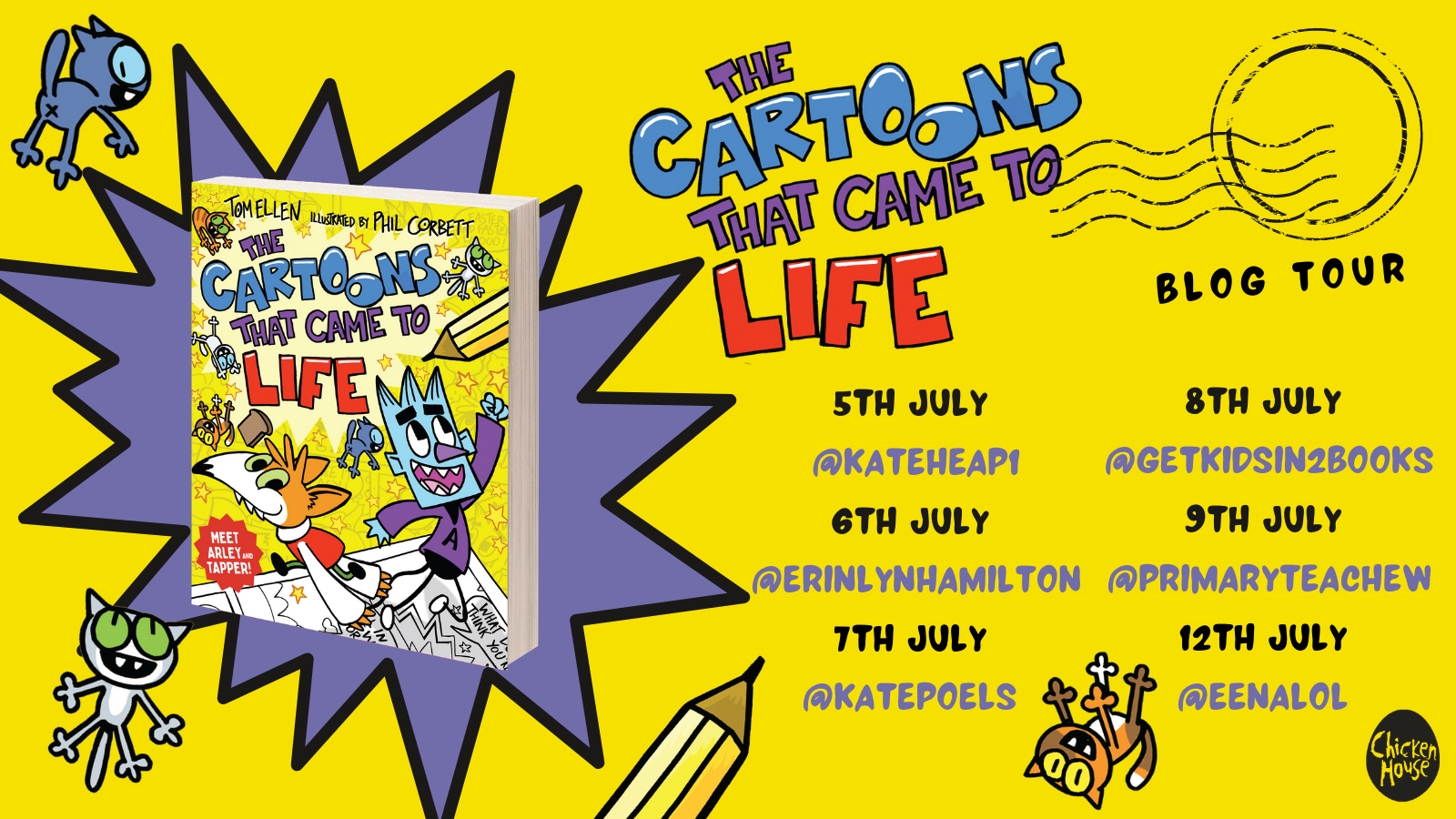
The Cartoons That Came to Life is bursting with madcap adventure, witty dialogue and loads of laughs. You can read my review here.
A Dinosaur Ate My Sister Blog Tour
29 June 2021
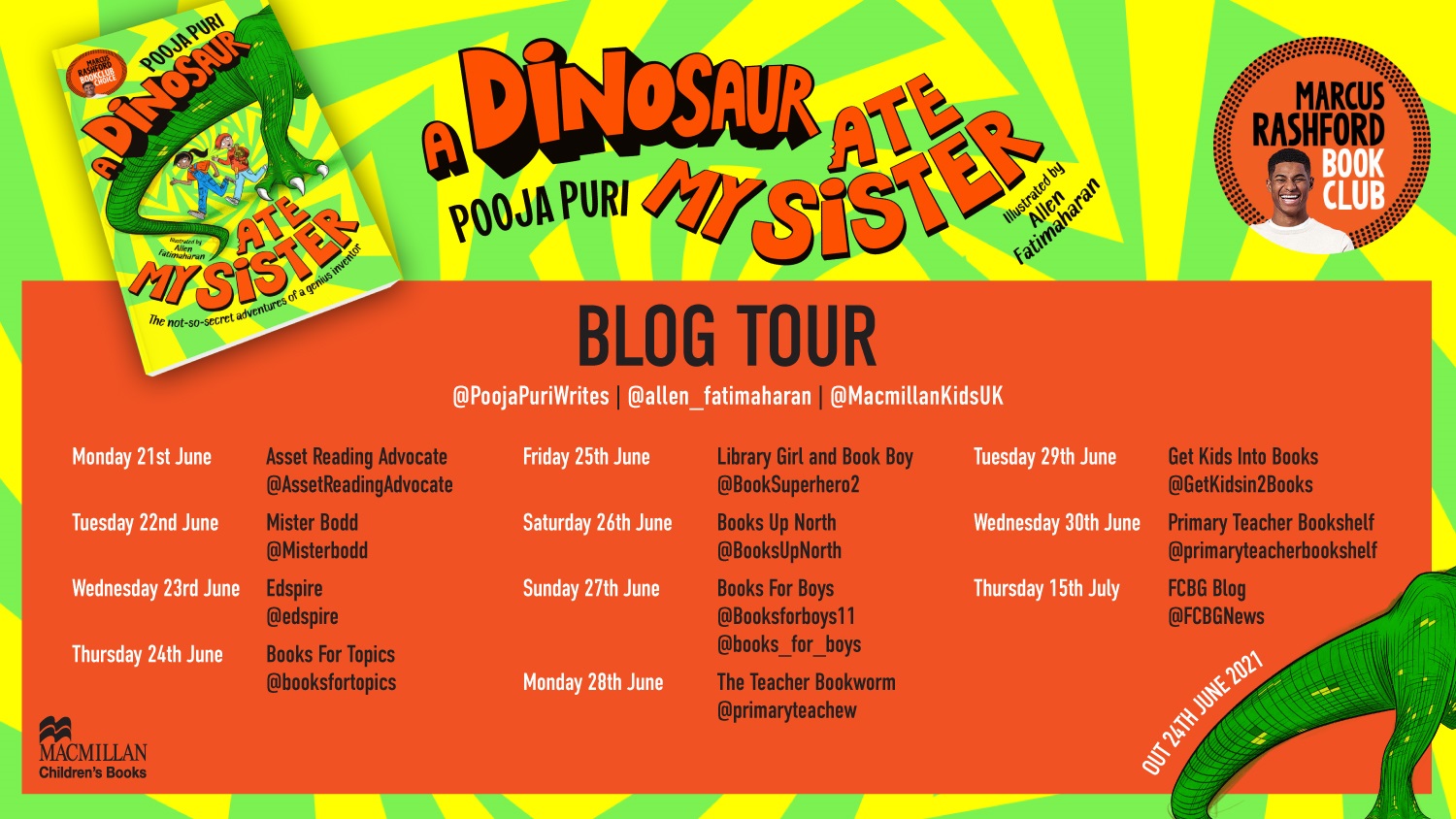
I’m delighted to welcome author Pooja Puri to my blog today. I asked her about how she created a relatable and inspirational female lead character for her latest book, A Dinosaur Ate My Sister.
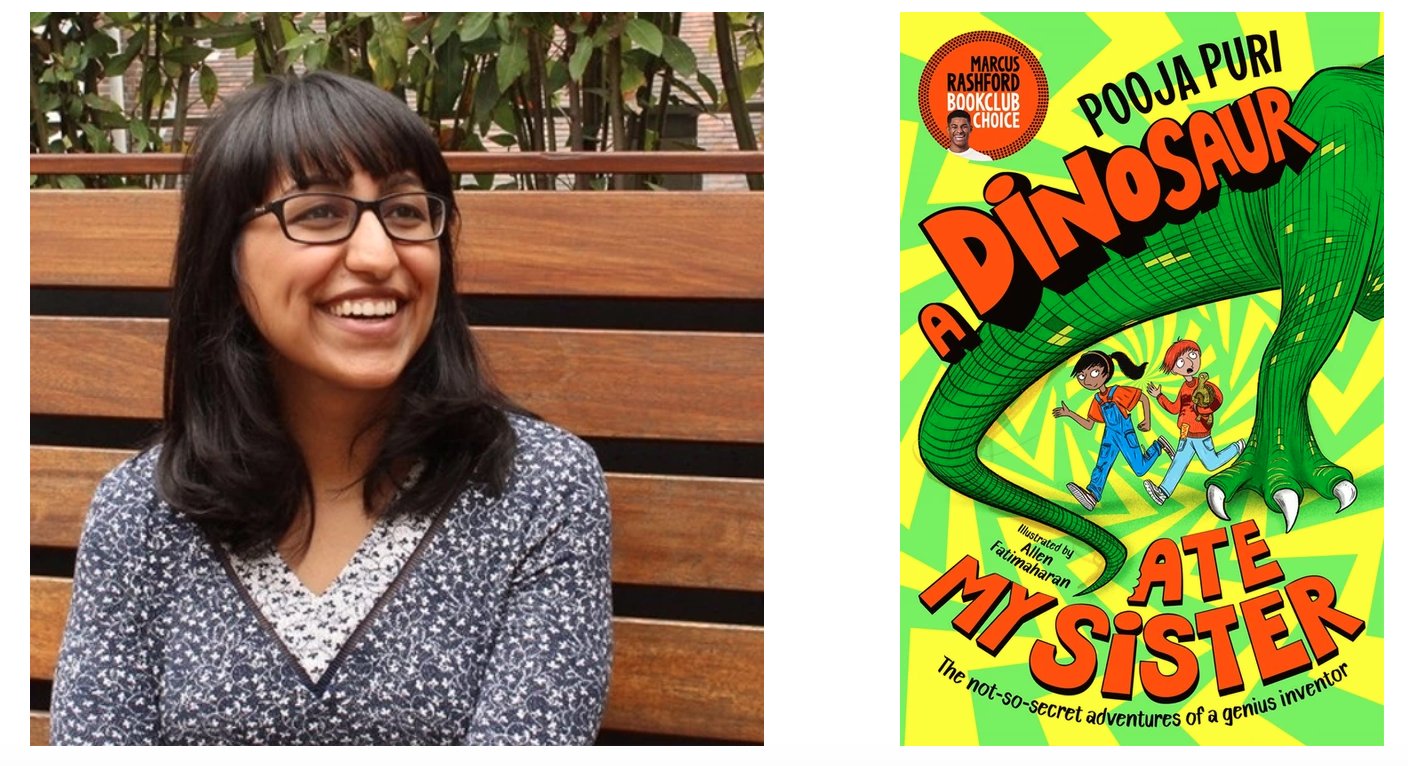
Before you start reading, there are a few things you should know:
1. I, Esha Verma, am a genius inventor extraordinaire.
2. There is nothing I cannot invent. This includes words.
A Dinosaur Ate My Sister is a time travel adventure about Esha Verma, a genius inventor extraordinaire, who invents a time machine in her bedroom (with the help of her apprentice, Broccoli, and his tortoise, Archibald). Unfortunately, things get a little complicated when her big sister, Nishi, accidentally zaps herself to the Cretaceous Age…
Ever since I was a child, I’ve always loved the idea of time travel. I think there is a SPINGLY kind of magic in the thought of adventuring across all of time and space. I’d been juggling a few different ideas for a time travel story, but none of them really felt right until, one afternoon, whilst staring out the window, a question flew into my head: what if you accidentally sent someone through time? And what if that someone just so happened to be your ANNOYING big sister?
PZZZINNG! It was the BRAIN-SPARK I’d been waiting for. With lightning-fast speed, Esha Verma, genius inventor extraordinaire, popped into my head, complete with bags of enthusiasm, unwavering perseverance and an Inventor’s Thinking Hat! Finding the ‘voice’ of your character can often be one of the hardest parts of writing any story, however there are also rare (and wonderful!) instances when the character’s voice appears, ready to go. Esha’s voice was the latter. As soon as I began writing, I knew that she was going to be bold and full of confidence – who else would dare fight a dinosaur with a doughnut?
Like many of her inventor predecessors, Esha takes her inspiration from what she finds around her, whether that’s outdoors or from the kitchen cupboards. I was keen for the reader to be able to relate to her inventing exploits so many of her genius inventions are a twist on the familiar and every day. Of course, Esha’s passion for inventing is not limited to her technological enterprises. Rather, she approaches the whole world with the same curious and creative mindset – the desire to reimagine and apply her own Esha twist to everything around her, including words. Whilst writing A Dinosaur Ate My Sister, and indeed, Esha’s character, I was keen to show readers that creativity can take many forms – whether you are building your own vernacular or an invention!
Esha’s perseverance is another extremely important part of her character. I wanted to show readers that creativity and experimentation isn’t necessarily about getting things ‘right’; rather, it’s about having a go and trying your best no matter what the result might be! Although her inventions might not always turn out quite as expected, Esha never gives up. Not even when she is faced with terrifying time-space monsters and blood-curdling dinosaurs… if anything, that only spurs her on to invent a little more quickly.
I hope that Esha will inspire readers to try their hand at some inventing of their own.Who knows? You might just build yourself a time machine…
Antigua de Fortune Blog Tour
22 June 2021
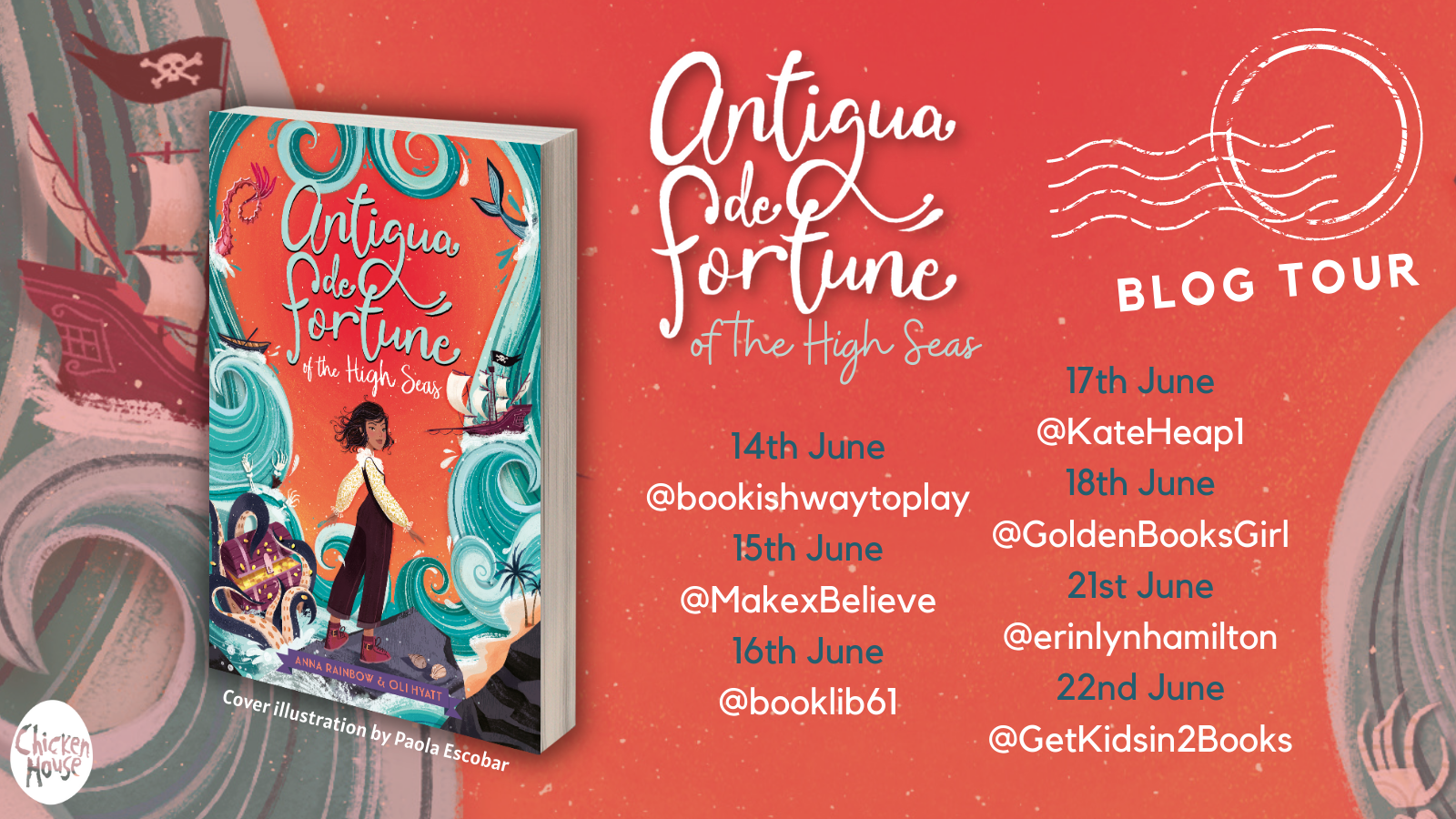
I’m delighted to be part of the Antigua de Fortune blog tour and share my review of this wonderfully exciting seafaring adventure packed with pirates, mermaids and the magic of the ocean.
How to Mend a Friend Blog Tour
19 June 2021
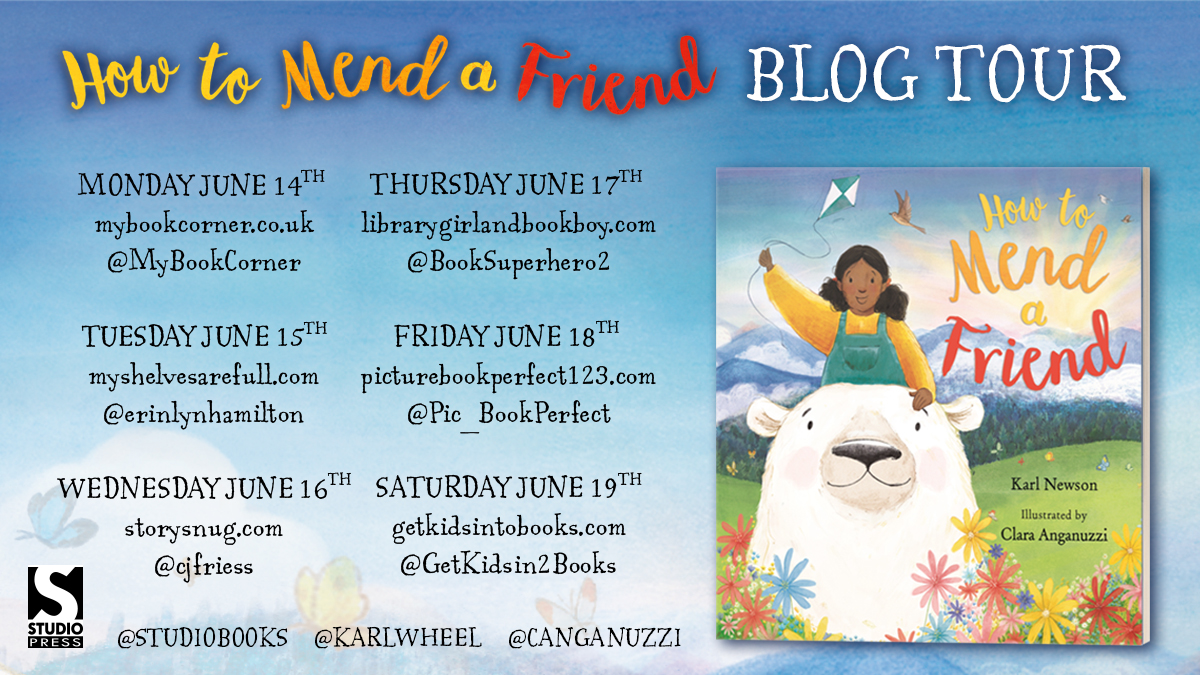
I’m delighted to be part of the blog tour for this wonderfully uplifting and hopeful book about kindness and what it means to be a friend. You can read my full review here.
The book is beautifully illustrated with warmth and tenderness by Clara Anganuzzi. I’m honoured to be able to share some of Clara’s early sketches and character work with you. It’s a fascinating insight into her creative process.
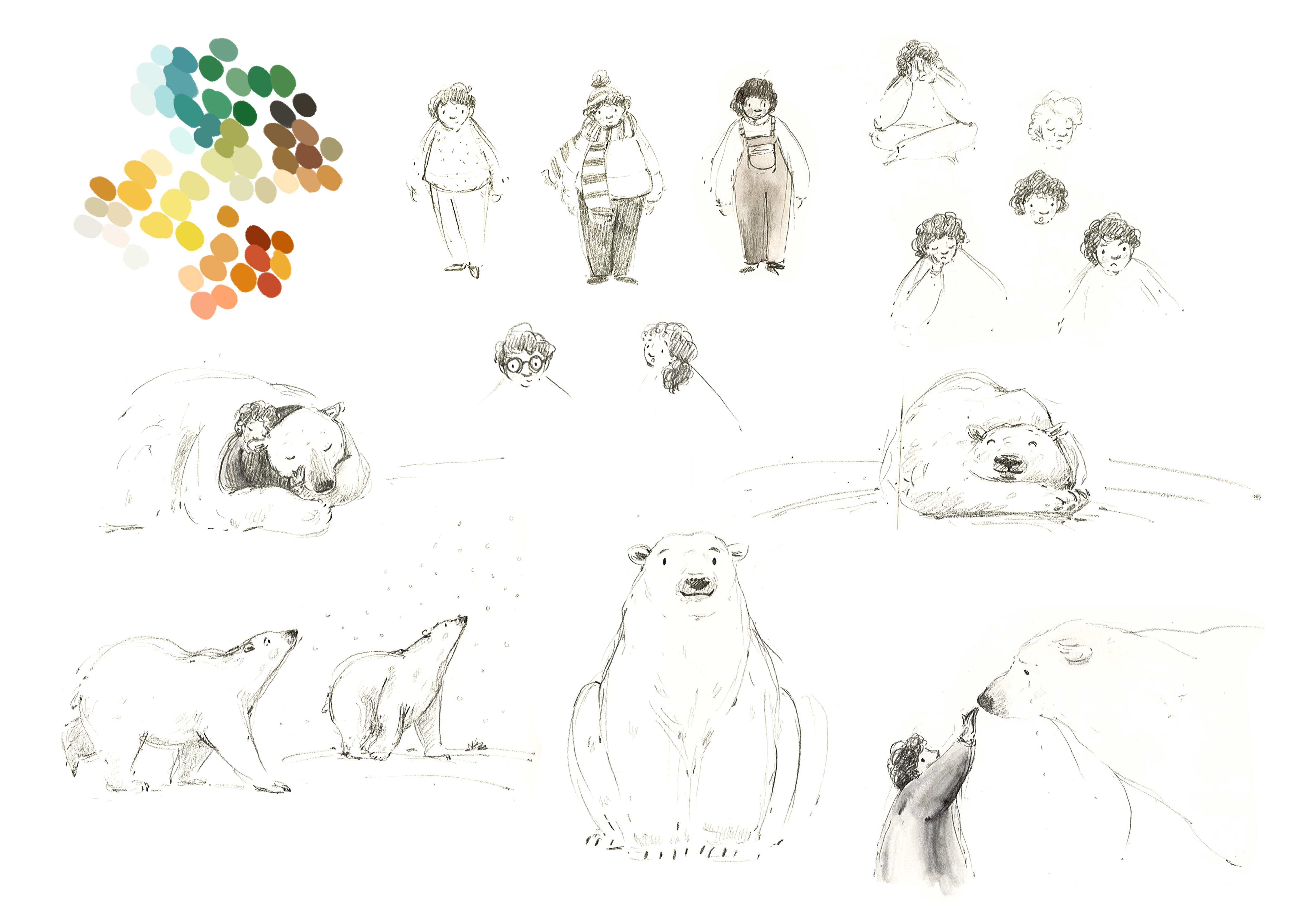
I love the connection between the little girl and the polar bear and it’s wonderful to see that being worked out and developed here.
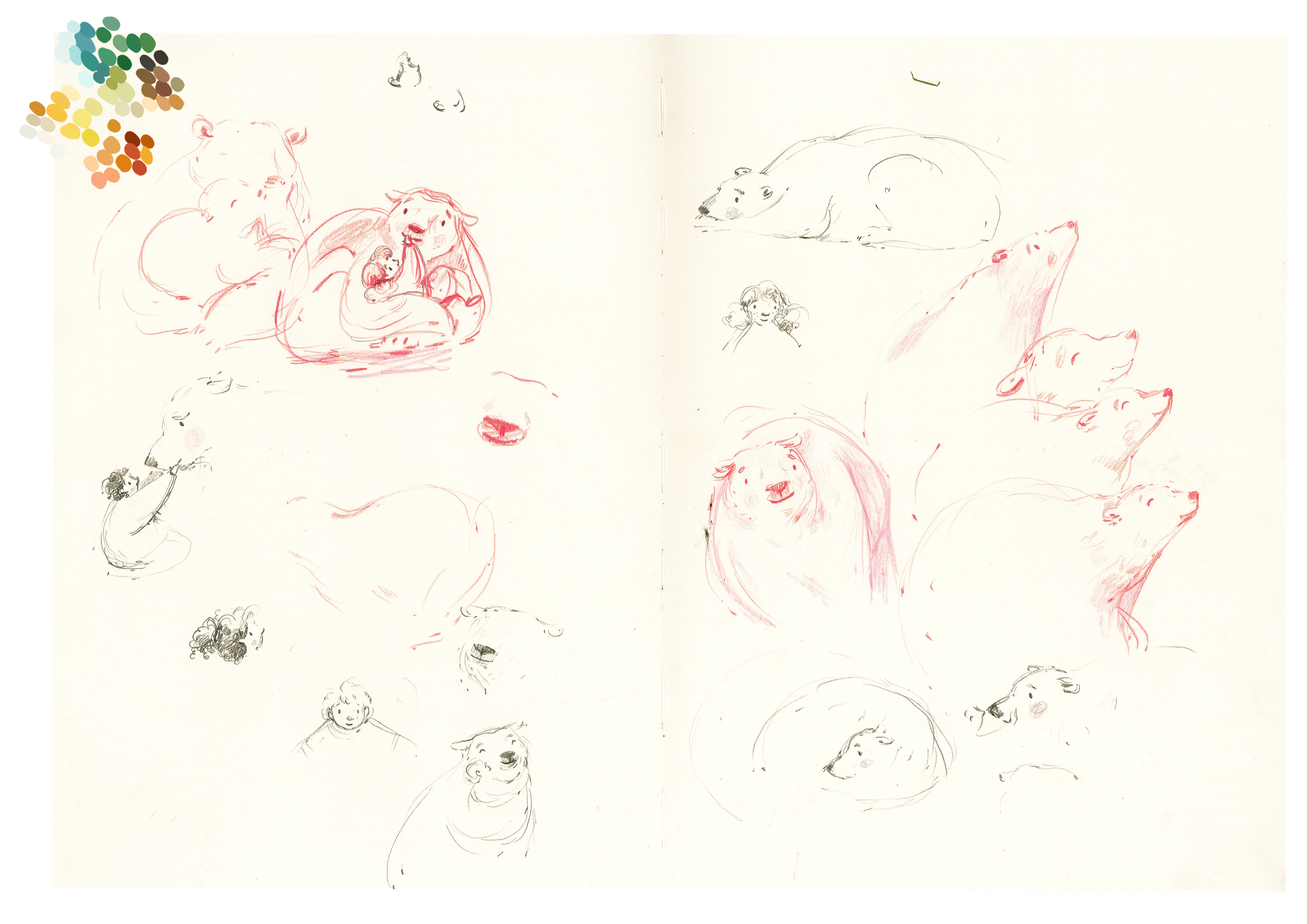
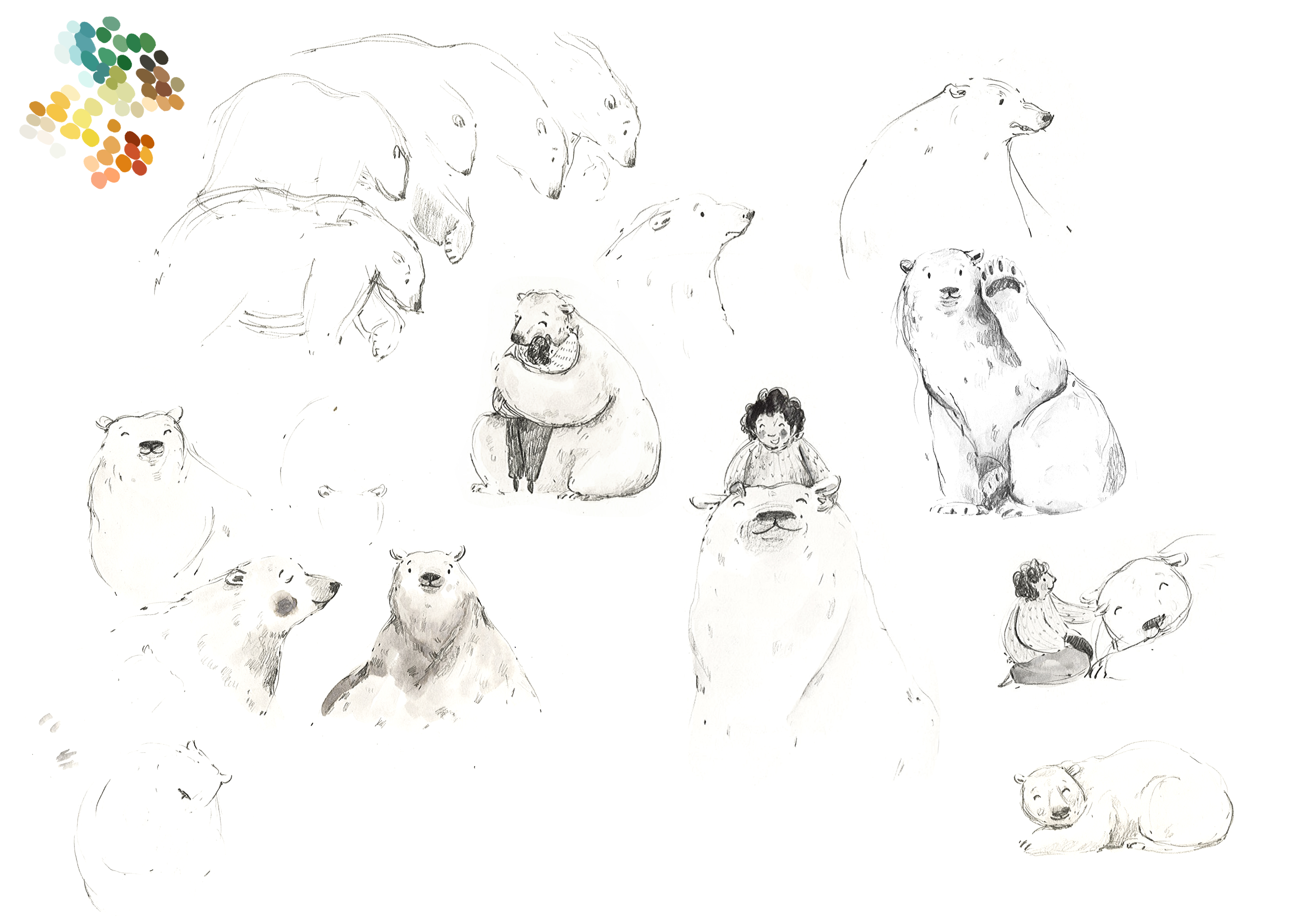
One of my favourite pages shows the little girl swimming with beluga whales. Look at the incredible movement in these sketches!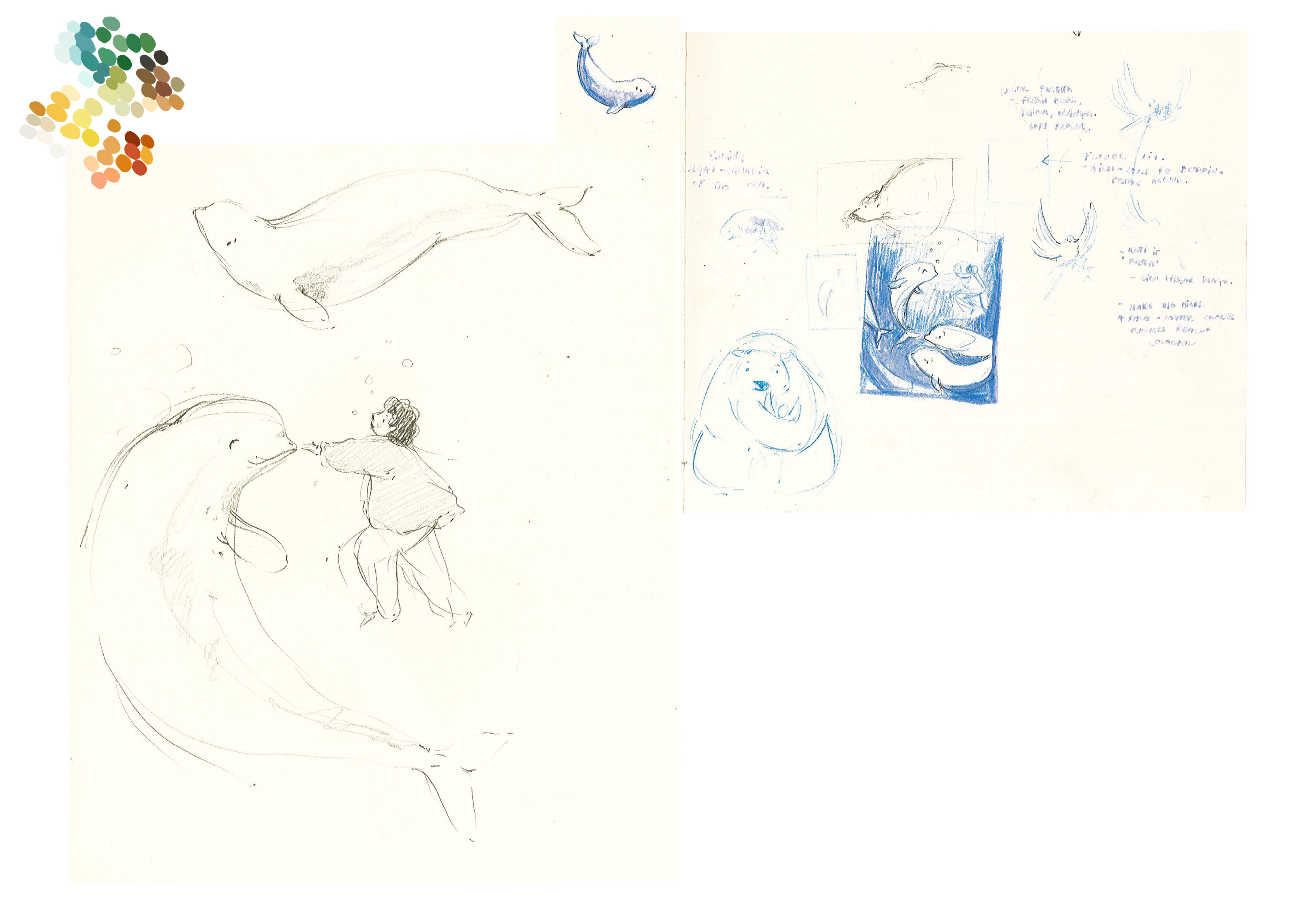
Indigo Wilde Blog Tour
12 June 2021
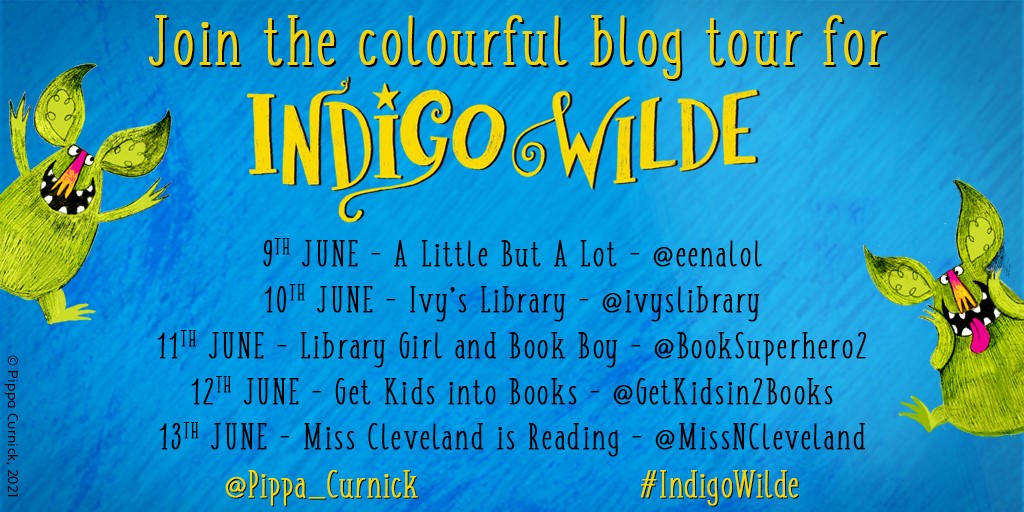
I’m delighted to be able to share my review of this brilliant book as part of the Indigo Wilde blog tour. Read it here.
The Screen Thief! Blog Tour
10 June 2021
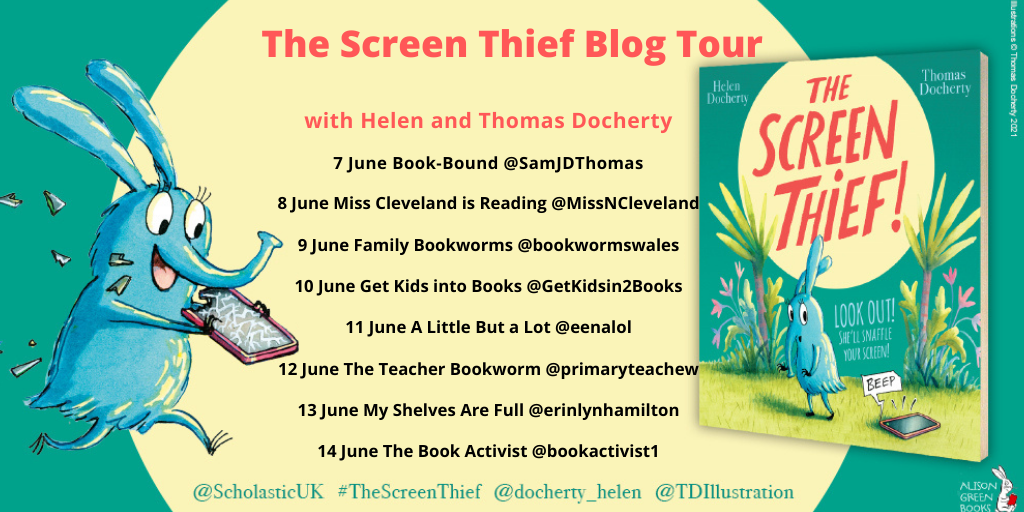
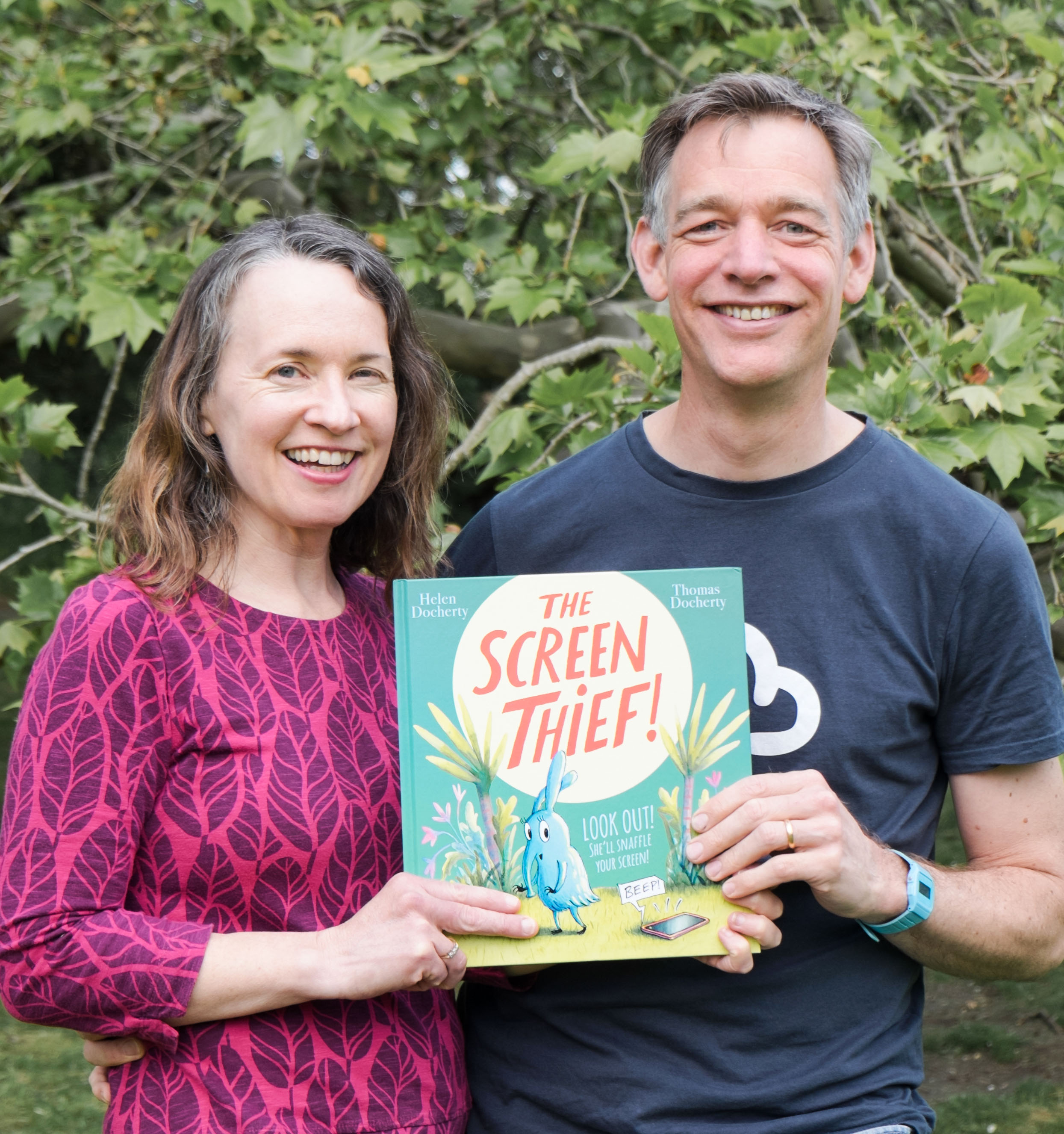 Today I’m delighted to welcome author Helen Docherty to my blog. To celebrate the publication of her latest picture book, The Screen Thief!, she’s written me a fabulous guest post packed full with tips for enjoying screen-free time with your children.
Today I’m delighted to welcome author Helen Docherty to my blog. To celebrate the publication of her latest picture book, The Screen Thief!, she’s written me a fabulous guest post packed full with tips for enjoying screen-free time with your children.
Helen: Over the last year, we’ve all come to rely on screens more than ever. For busy parents, they are instant babysitters (and lifesavers) – but there are so many other things we can do with children, when we have the time. Here are a few ideas from when our kids were little (and not so little).
Get outside! Go for a walk – at your child’s pace. It doesn’t matter where, but anywhere in nature is best. When our youngest daughter was a toddler, I used to take her to our local cemetery, which had some lovely peaceful paths through the trees. She used to potter along very slowly, picking up leaves as she went. Take water and snacks to keep you going and talk to your child while you’re walking about the things you see and hear together. Let them explore the world around them; don’t rush them.
Even on a wet day, a welly walk can be fun. Who doesn’t love a muddy puddle? All-in-one waterproofs can keep your kids dry while they splash to their hearts’ content.
Read to your kids every day – right from the start. Even before they understand all the words, babies and toddlers love looking at the pictures, listening to the story and being snuggled up with you. Soon they will know their favourite stories off by heart. Visit the library as often as you can and let your child choose a pile of books. Make sure they always have access to books at home, so they can pick them up, look at the pictures and ‘read’ them.
Make a den. All kids love dens; they are great for encouraging imaginative play. All you need is a blanket to cover your den, something to hang it over (a washing rack; a table), some cushions to go inside and (preferably) some smallcups, plates and toy food (or real food if you want to give them a snack) so your child can have a feast inside the den. Let them invite their toys to the feast and feed them all in turn.
Get the paints out. Yes, it can get messy, but if you lay down plenty ofnewspaper and put an apron on your child, you can limit the damage. Kids love the tactile nature of paint, and they love making marks; with their fingers, a stick, a cut potato, a sponge… Let them experiment and mix colours together, and encourage them to talk to you about what they are painting.
Young children also love playing with water; pouring it from one cup into another is a serious business, and can keep them busy for a long time.
Bake with your kids. Let them do as much as possible, even if they make a mess. Experiment with different ingredients (for example, adding chopped apricots to flapjacks, blueberries or chocolate chips to cupcakes).
Older children can be harder to tempt away from their screens, but they like novelty and a challenge. Our kids still love 5-minute Lego challenges: make a giraffe, seagull, goblin, etc. from random Lego pieces. The contents of the recycling box can provide inspiration; make something that floats, or an underwater / winter / jungle scenein a shoebox. Ours once spent a happy afternoon creating a spoof travel brochure using pictures they’d cut out of a real one they found in the recycling, complete with a nightmare travel agent (‘Dave’) who would accompany you on every holiday.
We hope our new book, The Screen Thief!, will inspire lots of fun away from screens!
The Caravan at the Edge of Doom
Blog Tour
3 June 2021
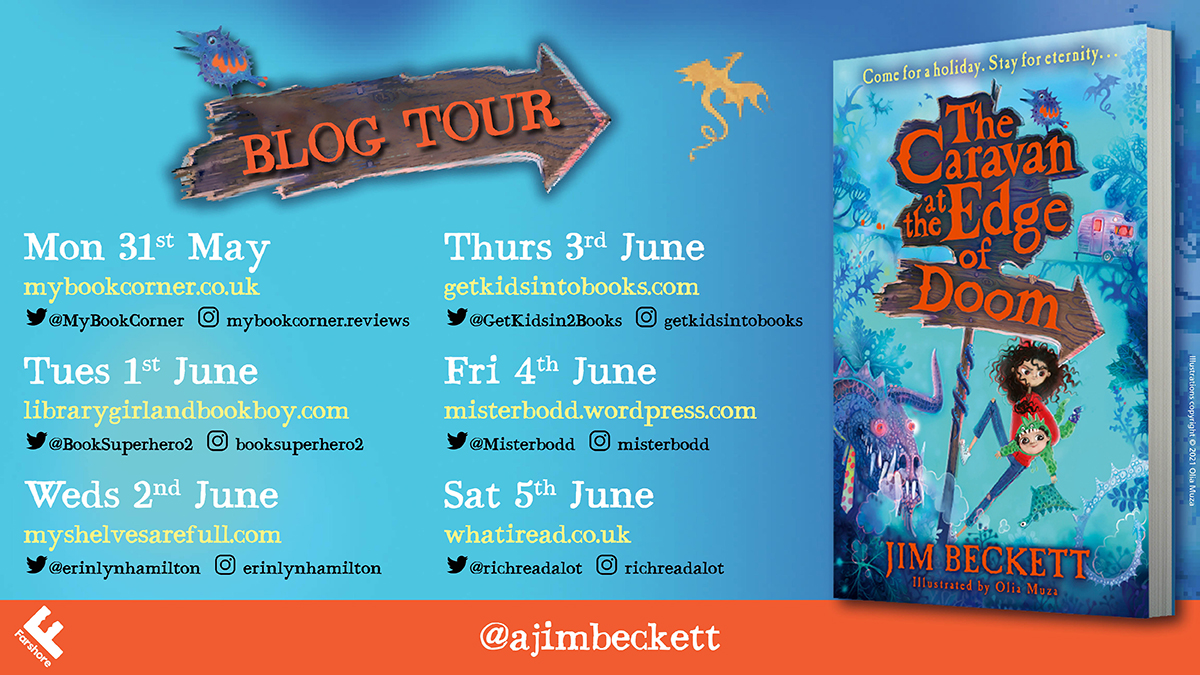
I’m delighted to welcome illustrator Olia Muza to my blog today as part of the blog tour for The Caravan at the Edge of Doom. 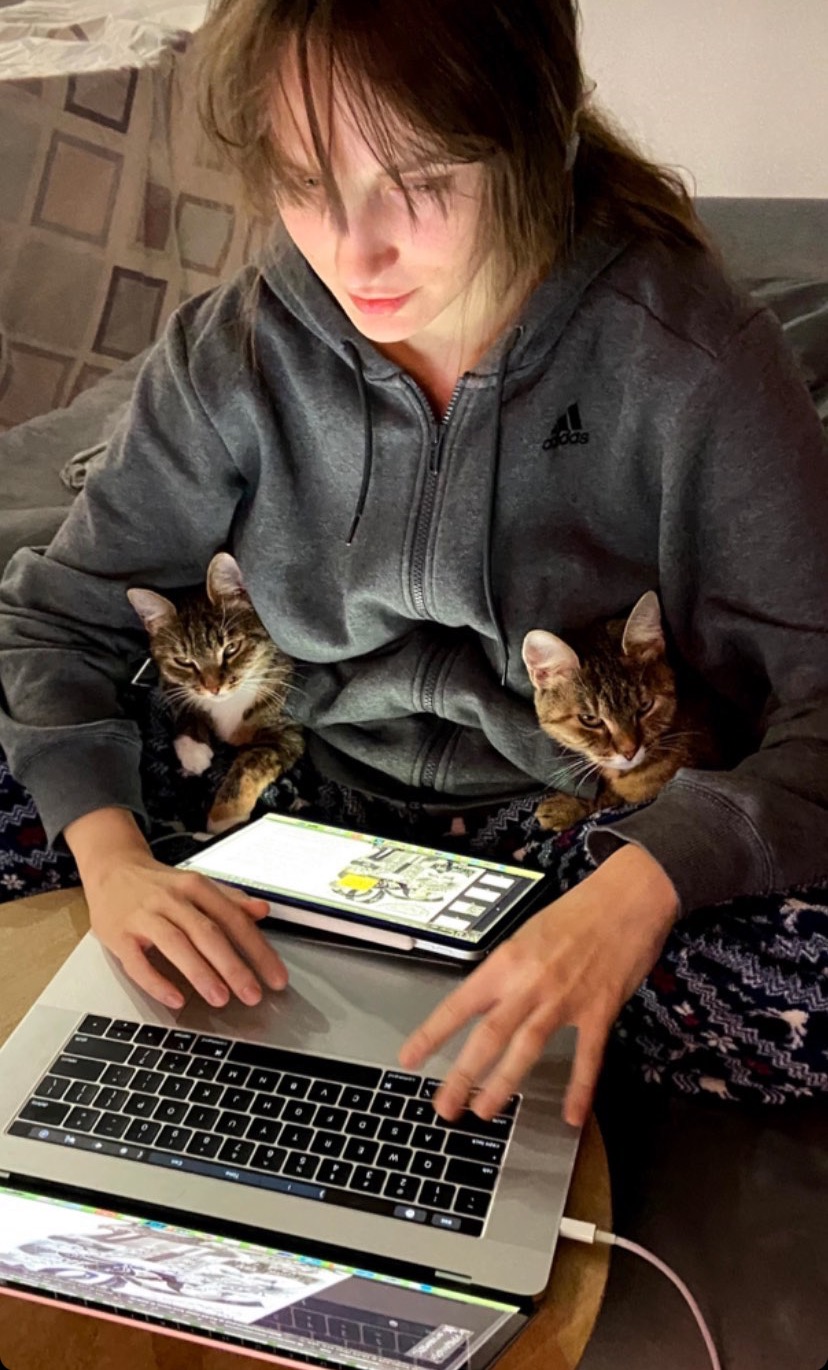
The Caravan at the Edge of Doom is a brilliantly funny adventure written by Jim Beckett and aimed at readers aged 8+. Right from the very first page, the book is absolutely hilarious! It frequently had me laughing out loud.
When her grandparents unexpectedly explode in their caravan toilet late one night, twelve-year-old Harley discovers a surprising truth: their toilet is a gateway to the Land of the Dead, and they are its Guardians. Well, they were. But there’s no time to mourn their passing because Harley’s baby brother has accidentally gone with them to the Land of the Dead. And Harley only has 24 hours to rescue him before he’s trapped there FOREVER!
This is one epic quest which Harley unexpectedly finds herself a part of. No-one is more surprised than her to discover that she’s been cast as a Legendary Hero either. To return to the Land of the Living with baby Malcolm, Harley must navigate the Path of Heroes, avoid being eaten by monsters, and try not to plummet to her doom in the Beneath, all while completing the nigh-on-impossible Twelve Tasks. Amusingly these mythical tasks turn out to be a series of domestic chores ranging from pairing up socks to tackling a mountain of ironing.
The fantastic black and white illustrations which appear throughout the story really set the book apart. There are some glorious double-page spreads which show incredible vistas of the Land of the Dead. I particularly loved Olia’s depiction of the “Back of Beyond”. Other illustrations bring us face to grisly face with the various beasts and there are terrific pictures of the book’s eccentric cast of characters too. I’m thrilled to be able to feature some exclusive artwork as part of the blog tour. Olia has kindly shared some of her early sketches which give us a fantastic insight into her creative process. All illustrations are copyright © 2021 Olia Muza.
First up, there’s an early version of the book’s cover, followed by the final published version.
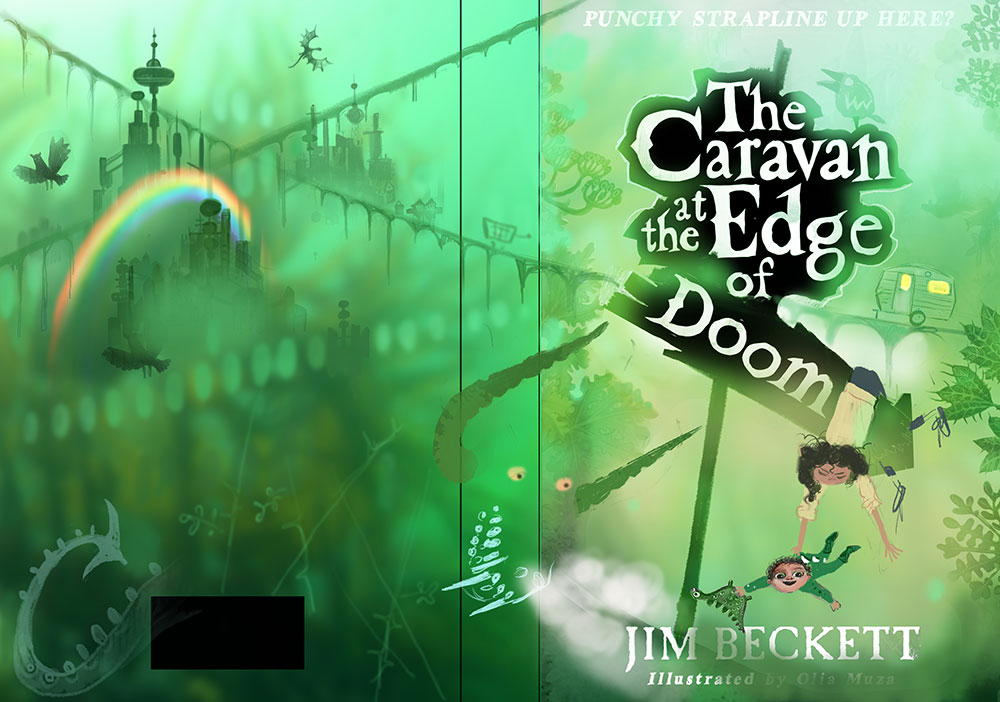
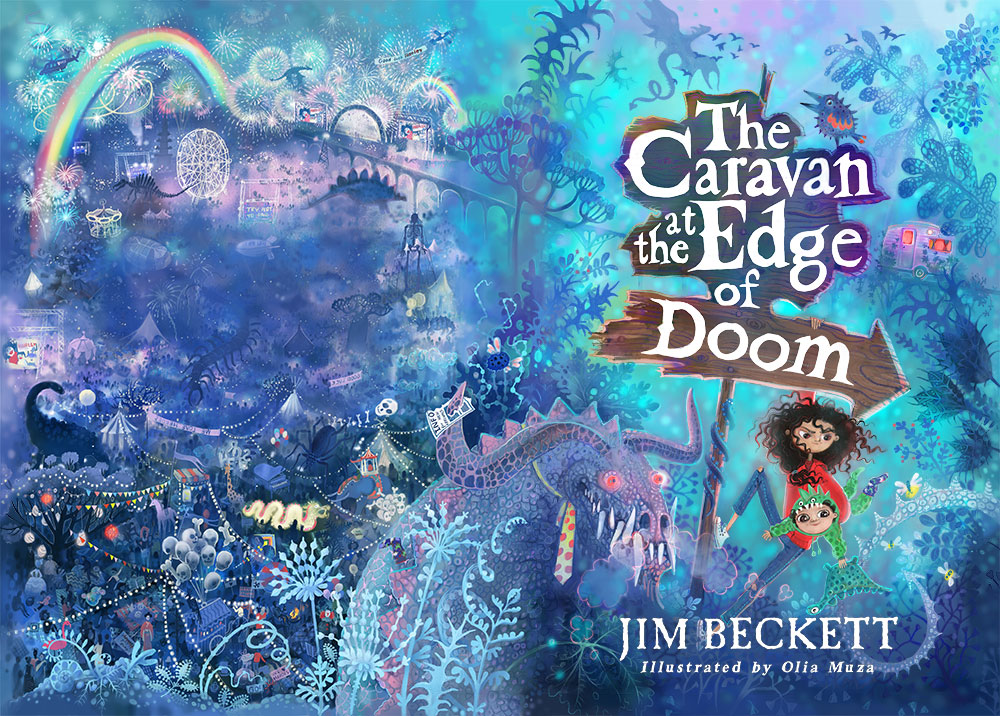
Next are some wonderful character sketches of Harley.
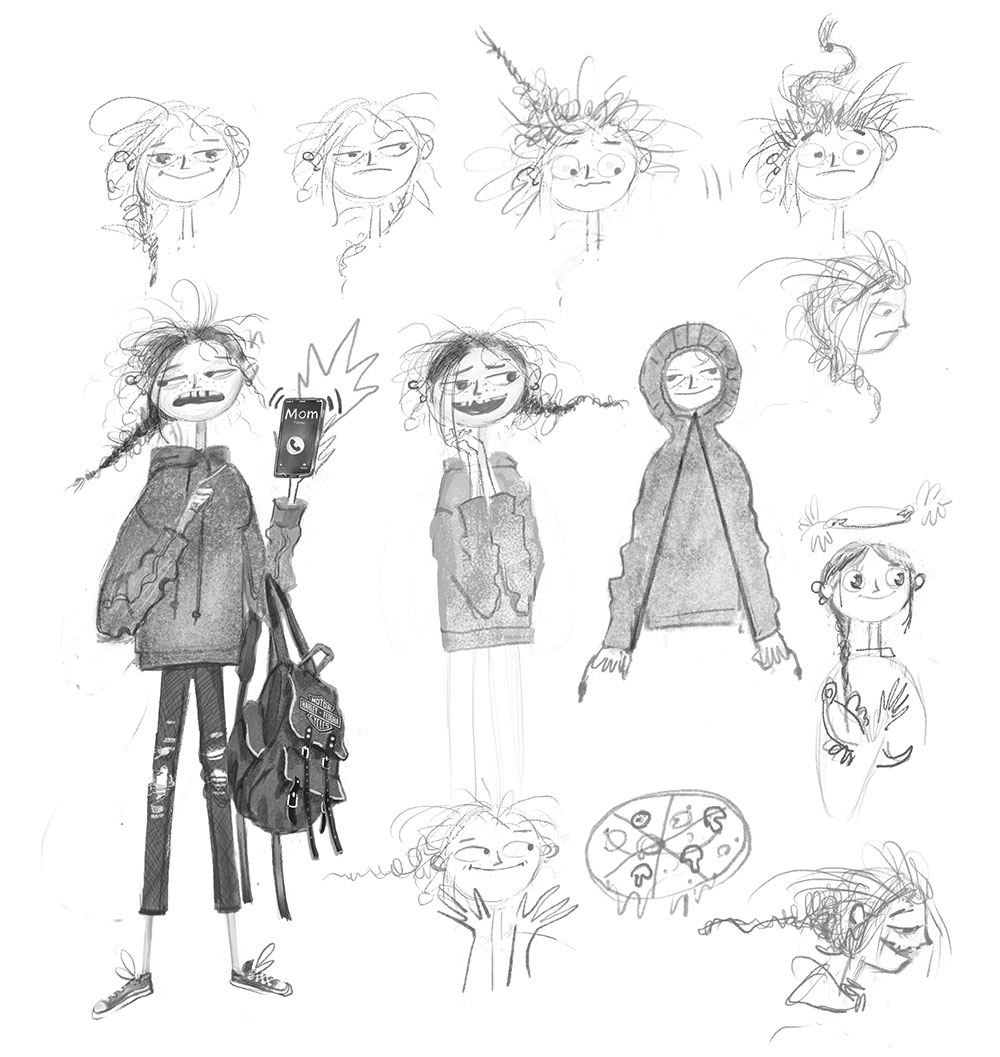

Finally, there’s an early sketch of one of the scenes from the book followed by the final published illustration of the same scene.
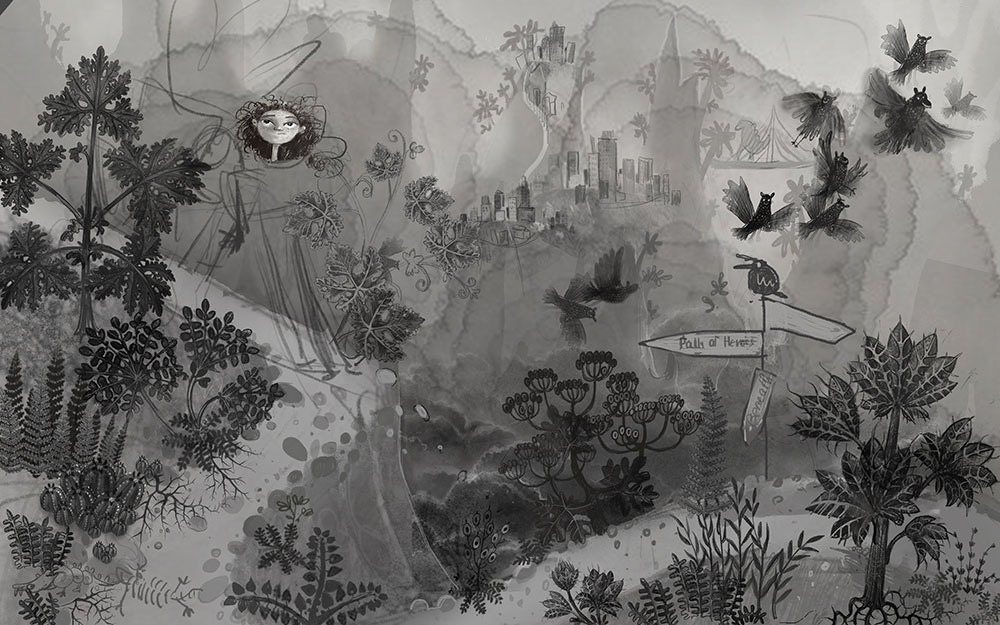
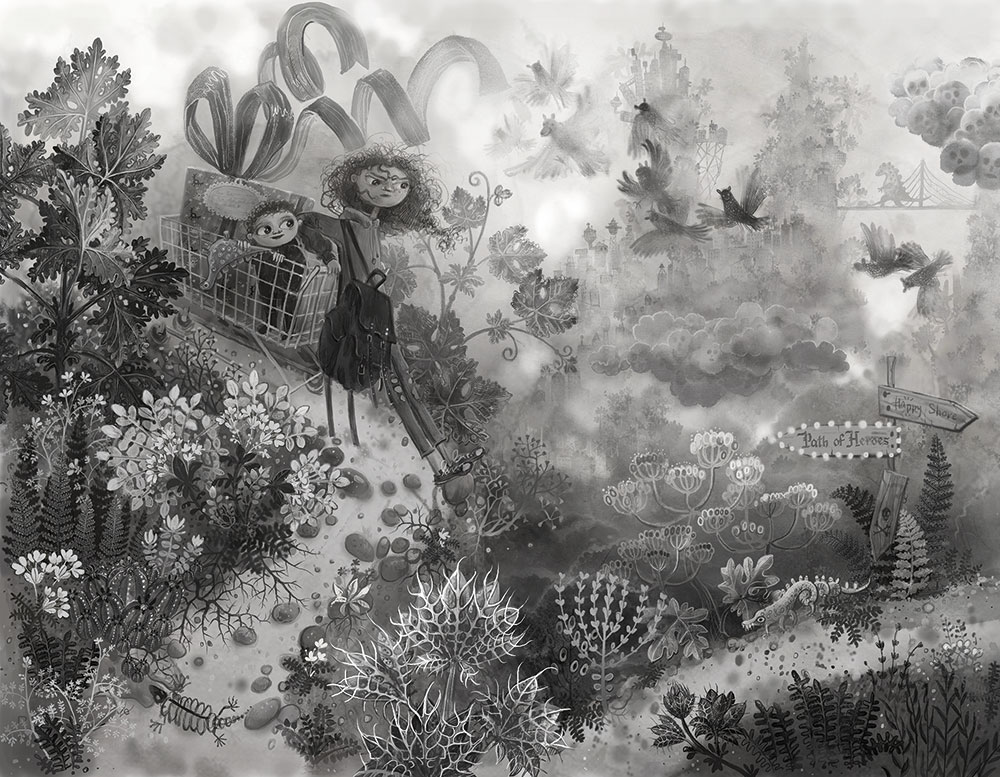
I’ve loved seeing how an illustration progresses from its initial idea to the final artwork. Thank you Olia for so generously sharing your pictures.
Rainbow Grey Blog Tour
29 May 2021
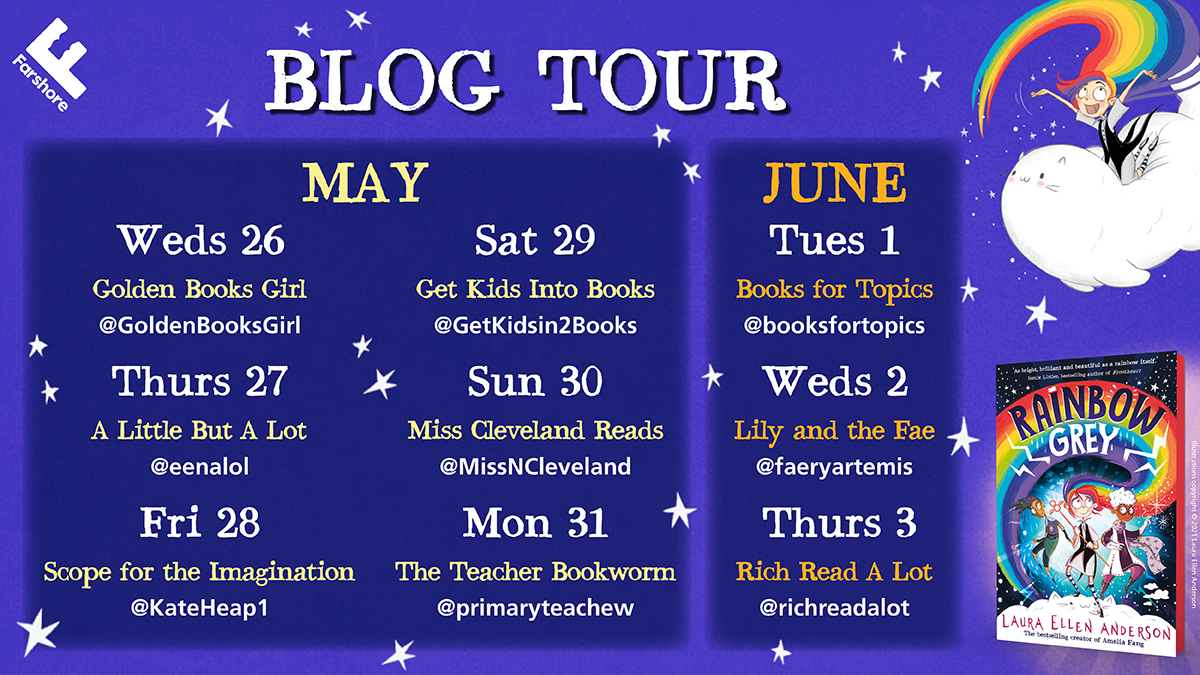
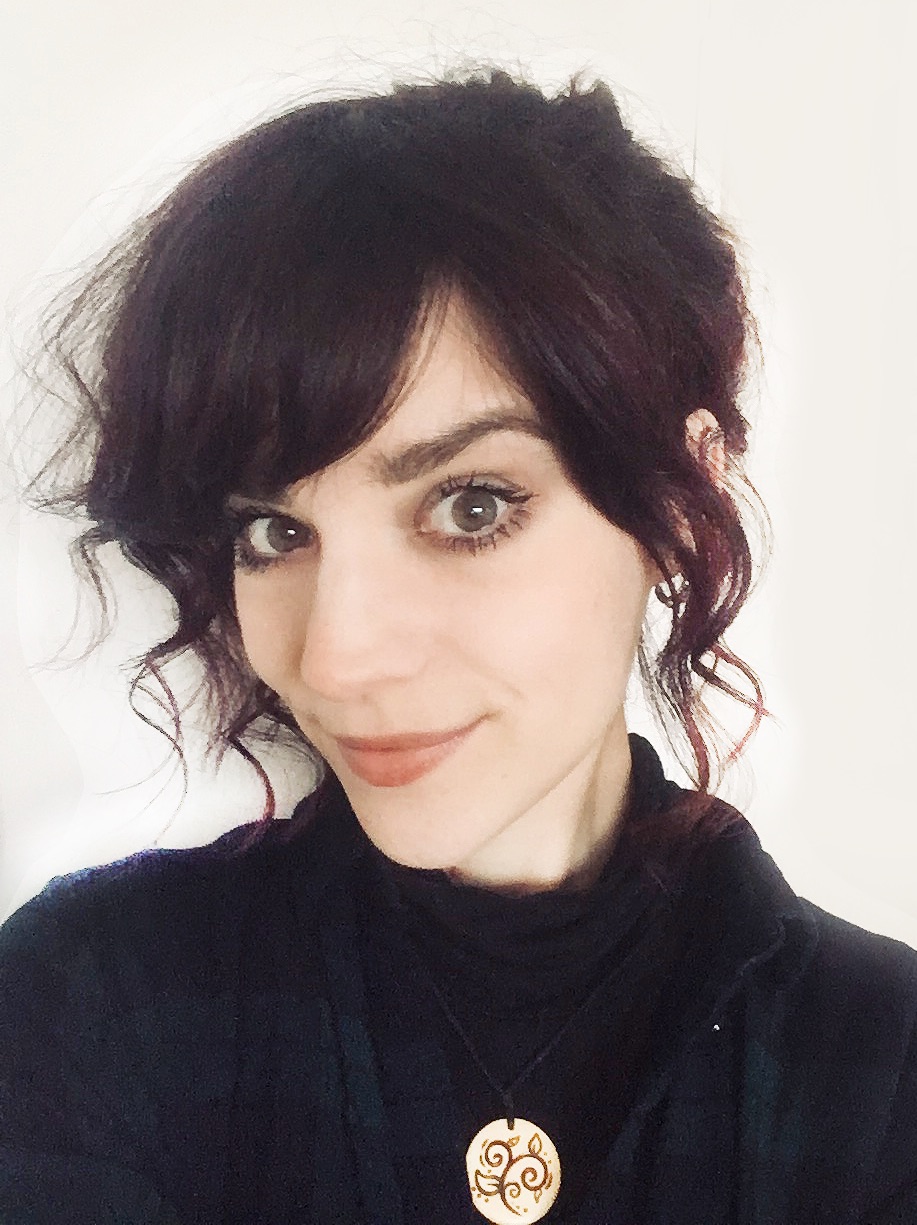 I’m delighted to welcome author/illustrator Laura Ellen Anderson to my blog today. Her new book, Rainbow Grey, is full of fun, friendship and mayhem. It’s the first book in a new illustrated adventure series aimed at readers aged 7+.
I’m delighted to welcome author/illustrator Laura Ellen Anderson to my blog today. Her new book, Rainbow Grey, is full of fun, friendship and mayhem. It’s the first book in a new illustrated adventure series aimed at readers aged 7+.
With Rainbow Grey, Laura Ellen Anderson has given us a wonderfully imagined world. We’re transported to a land in the sky where people can puddle-port from place to place and homes dangle suspended from clouds.
Another especially wonderful detail is all the fabulous food that’s described, especially the confectionery treats from the Rising Bun Bakery. There are pitter-patter pancakes, rumblebuns (eat them quick before they erupt) and lightning scones. Here, I can exclusively reveal the five bestselling confectionery items from the Rising Bun Bakery.
The Rumblebun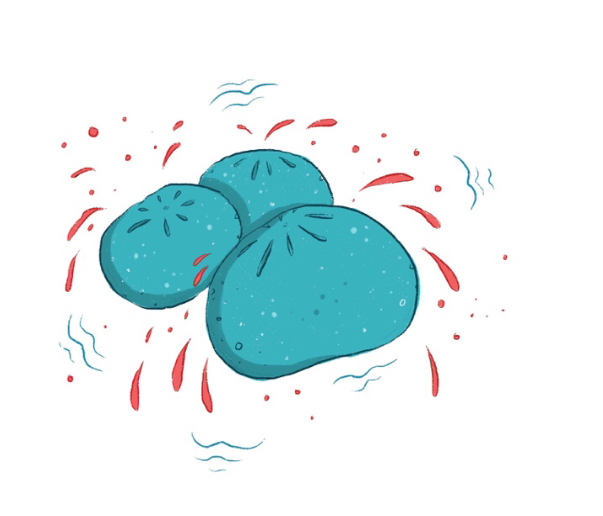
A bright blue syrup–filled bun made to be eaten quickly! The moist blue dough offers hints of sour snowdrop, while the bright pink skyberry syrup inside compliments the snowdrop tang with its sweet and succulent flavour. If not eaten quick enough, bun will erupt.
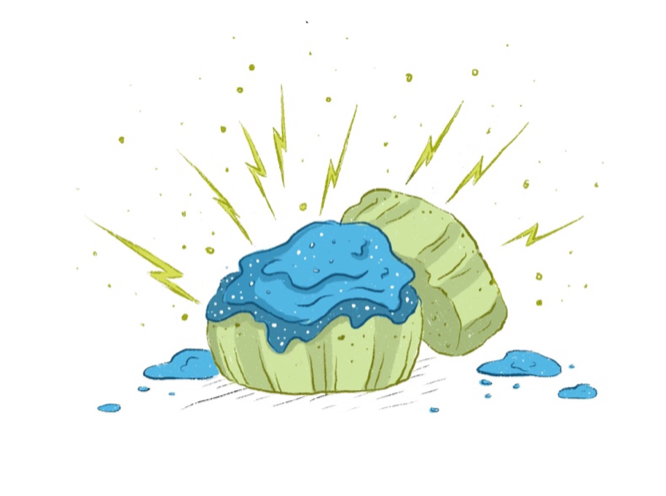 Lightning Scones
Lightning Scones
A Rising Bun Bakery delight! Lightning Scones arethe bakery’s best-selling bake, zapped to perfection by Sky-class baker, Streak. Perfect with a dollop of skyberry jam on top! Warning: nose hairs may be zapped during consumption.
 Pitter Patter Pancakes
Pitter Patter Pancakes
A fluffy orange snack to be enjoyed savoury OR sweet! These pancakes are perfect with sunflower syrup or strawberry snowflakes and are positively bursting with purple rain. Be sure to have an umbrella to hand!
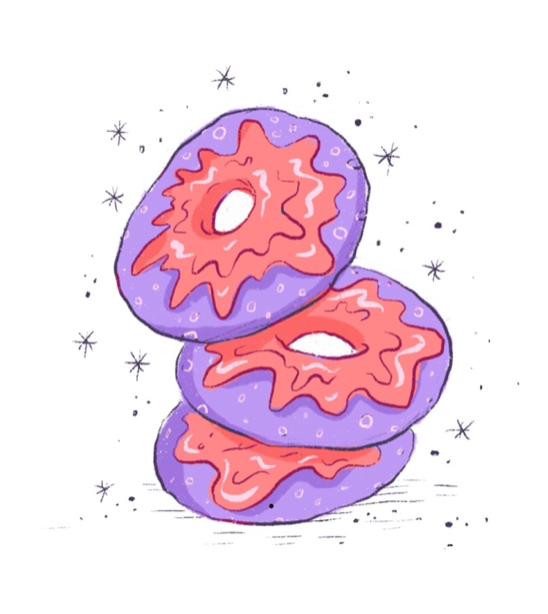 Drizzle Doughnut
Drizzle Doughnut
Small but filling! Constant drizzling with a puddle-glaze, these Drizzle Doughnuts are a great addition to any weather event. They LOOK good and they taste even better. The berry sponge soaks in the delightful drizzly flavours of the silky glaze on top. Oh, and they SPARKLE.
 Lunar Loaf
Lunar Loaf
In honour of the Moon King and his big plate of cheese, this savoury loaf is a favourite among Sun weatherlings. Speckled with moon-dust, this loaf is the perfect evening treat with a steaming cup of Ozonian Tea. Some have even said that a slice of Lunar Loaf helps them sleep better at night.
Pinkie and Boo! Blog Tour
24 May 2021
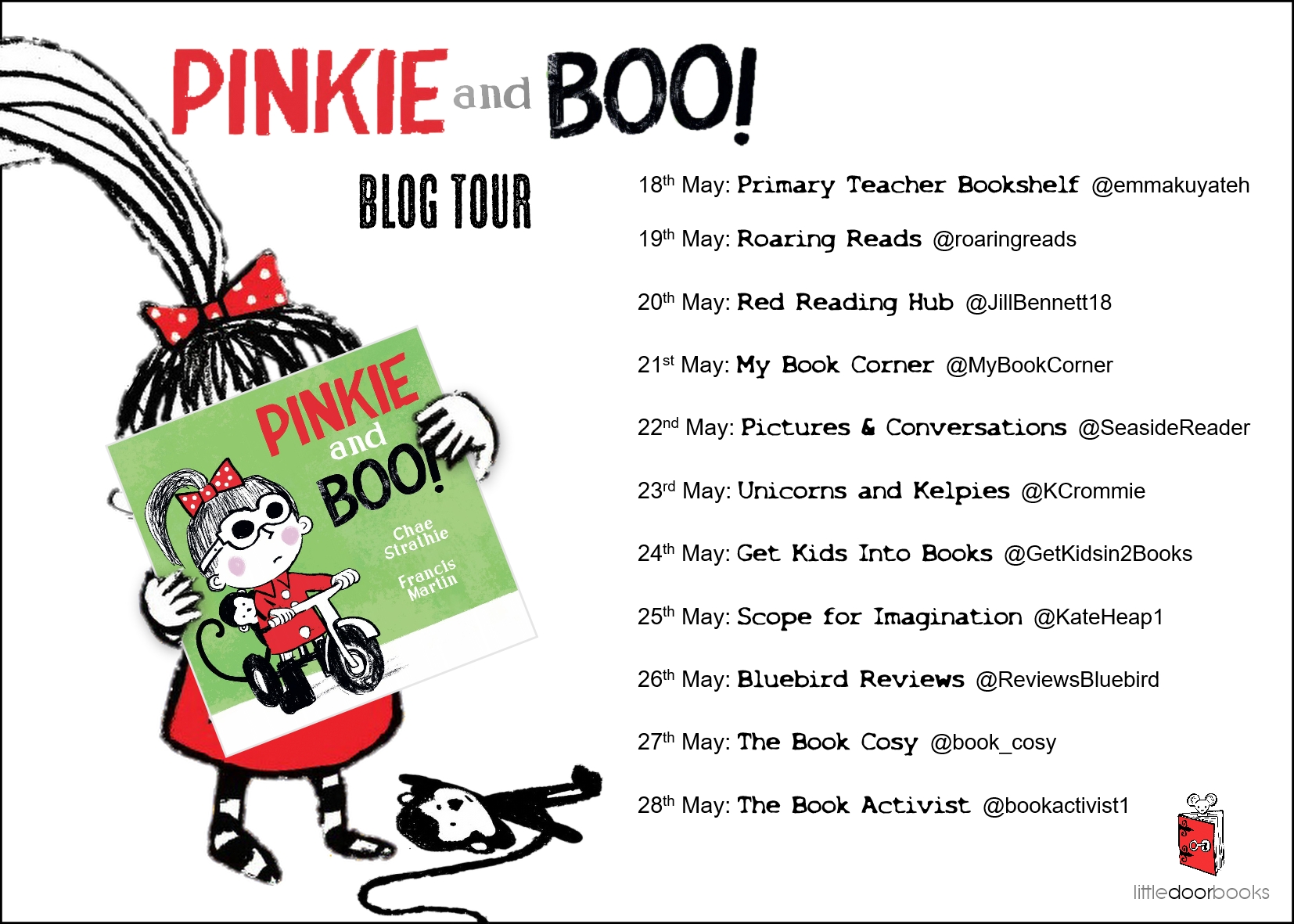
Today it’s my stop on the Pinkie and Boo! blog tour. I loved this fabulous, fun- (and mischief) filled picture book which explores sibling jealousy and what it feels like to have a new baby in the family. You can read my full review here.
Noah’s Gold Blog Tour
18 May 2021
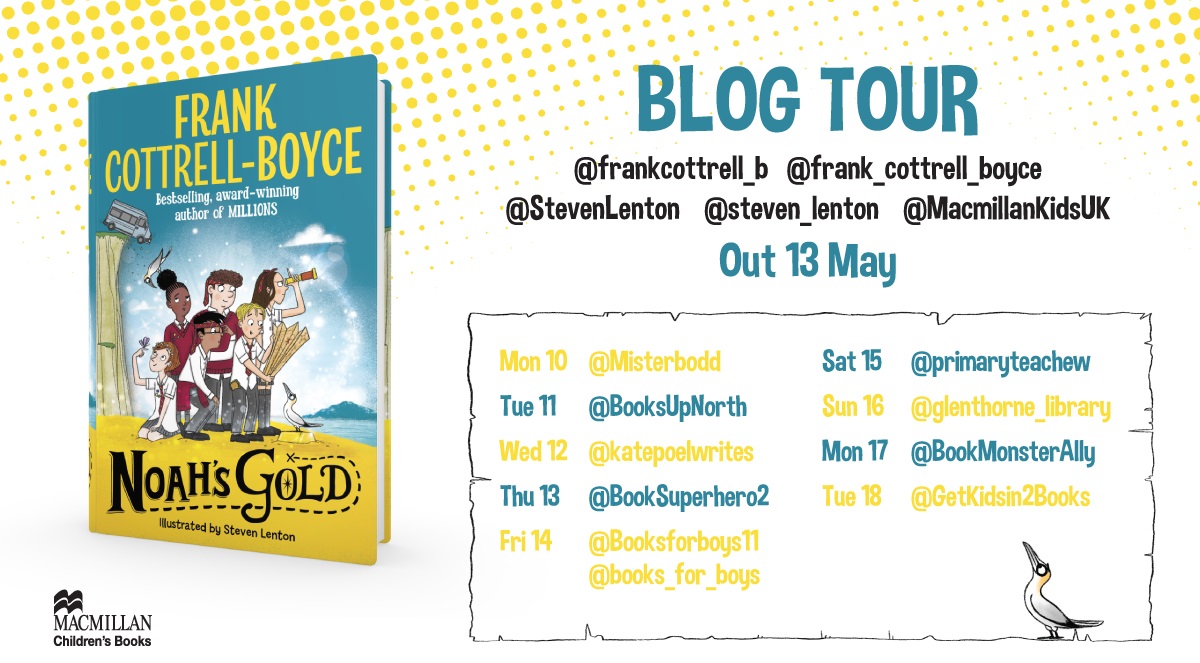
I was thrilled to be able to review this brilliantly funny adventure story and take part in the Noah’s Gold blog tour. You can read my full review here.
Uncle Pete and the Boy who Couldn’t Sleep
Blog Tour
13 May 2021
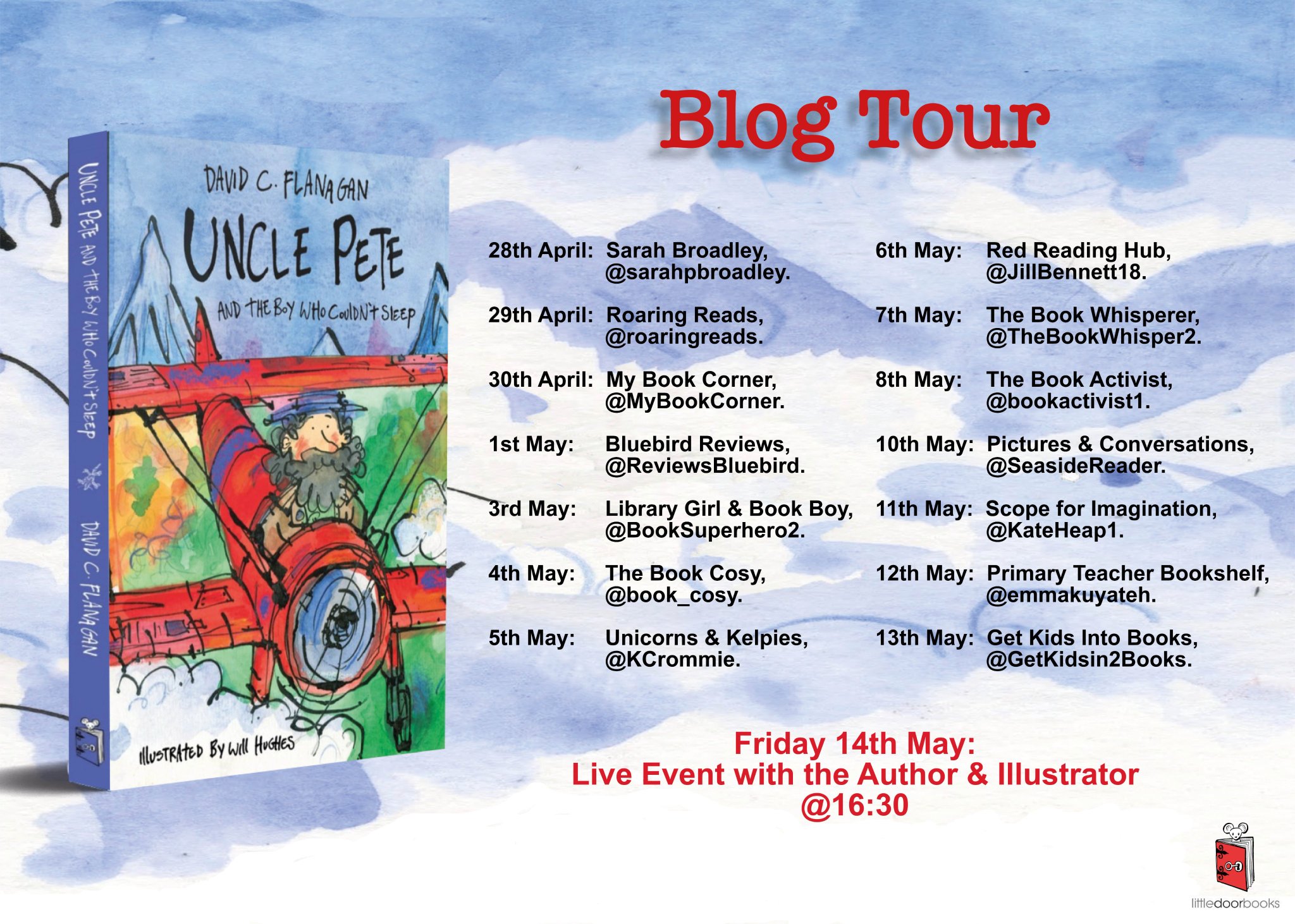 I’m delighted to be part of the blog tour for this fantastical adventure for younger readers. Click here to read my full review.
I’m delighted to be part of the blog tour for this fantastical adventure for younger readers. Click here to read my full review.
Pop! Blog Tour
11 May 2021
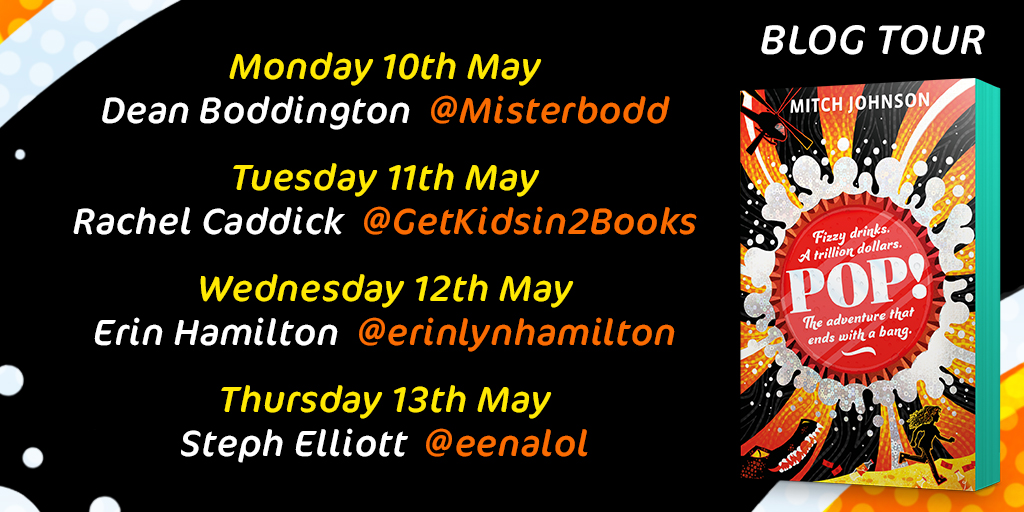
I’m absolutely delighted to be part of the blog tour for this pacy, adrenaline-fuelled adventure. You can read my full review here.
My Dad is a Grizzly Bear Blog Tour
1 May 2021
 My Dad is a Grizzly Bear is a bold and playful picture book with a gorgeous father/son relationship at its core. You can read my full review here.
My Dad is a Grizzly Bear is a bold and playful picture book with a gorgeous father/son relationship at its core. You can read my full review here.
Llama on a Mission Blog Tour
30 April 2021
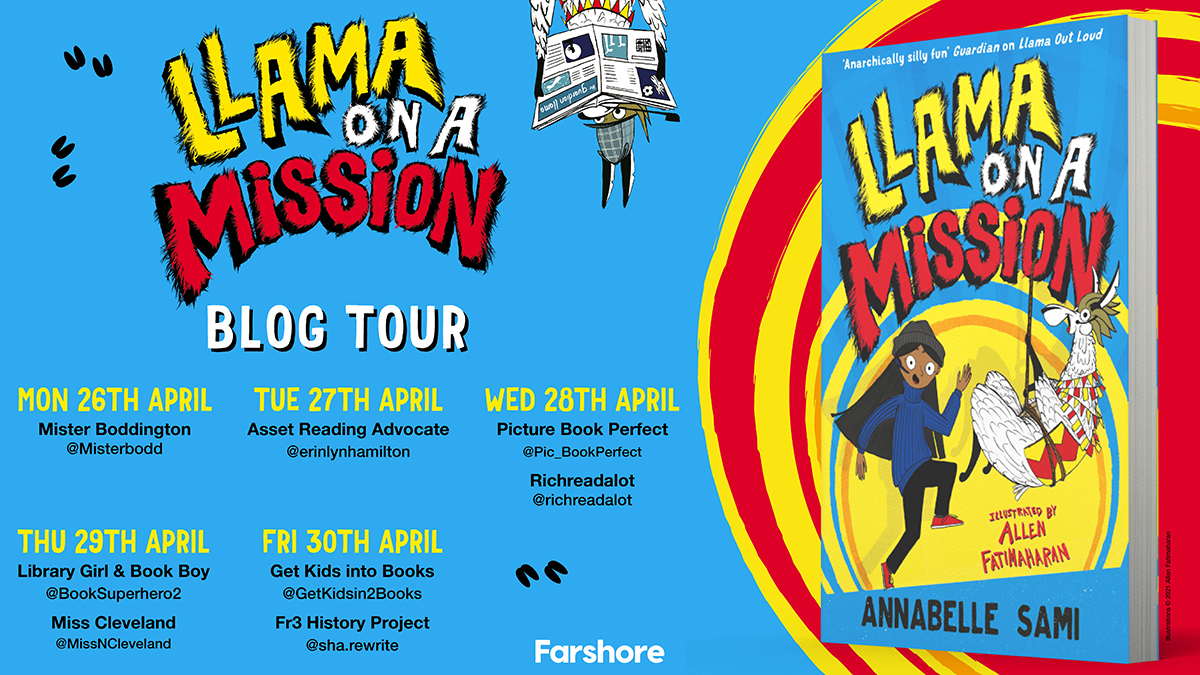
I’m delighted to be part of the blog tour for the hilarious Llama on a Mission. You can read my review here.
Ten Little Dogs Blog Tour
29 April 2021
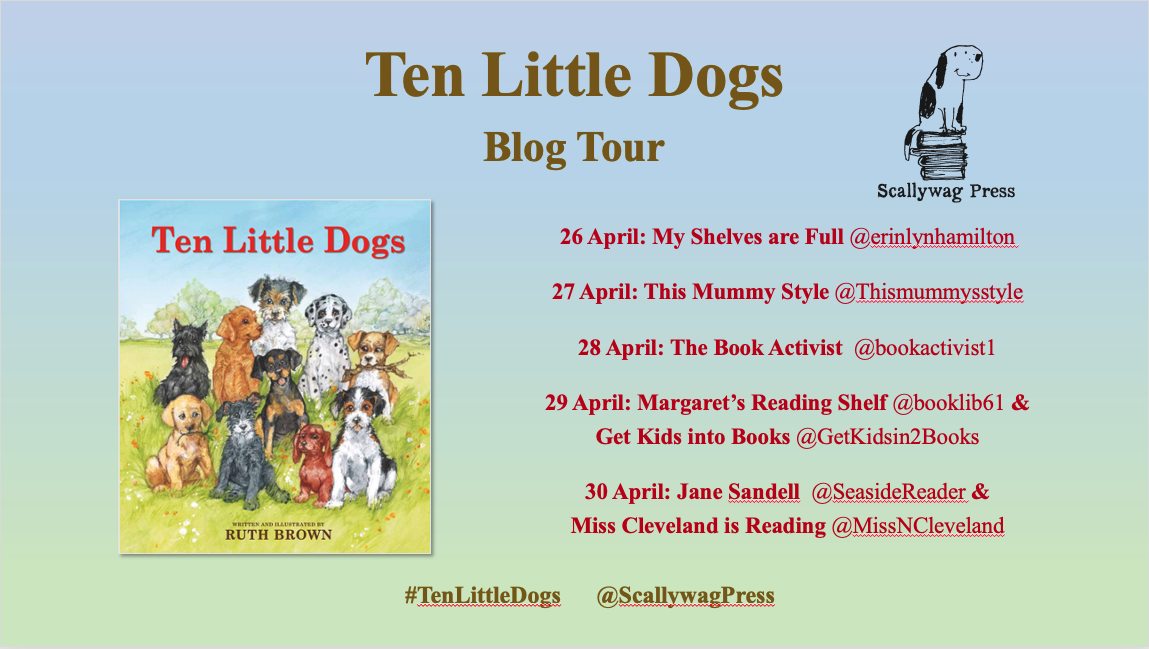
Ten Little Dogs is a beautifully illustrated count-down book which would be a welcome addition to any pre-schooler’s bookshelf. I’m delighted to share my review as part of the blog tour.
Jane Austen Investigates, The Abbey Mystery
Blog Tour
21 April 2021
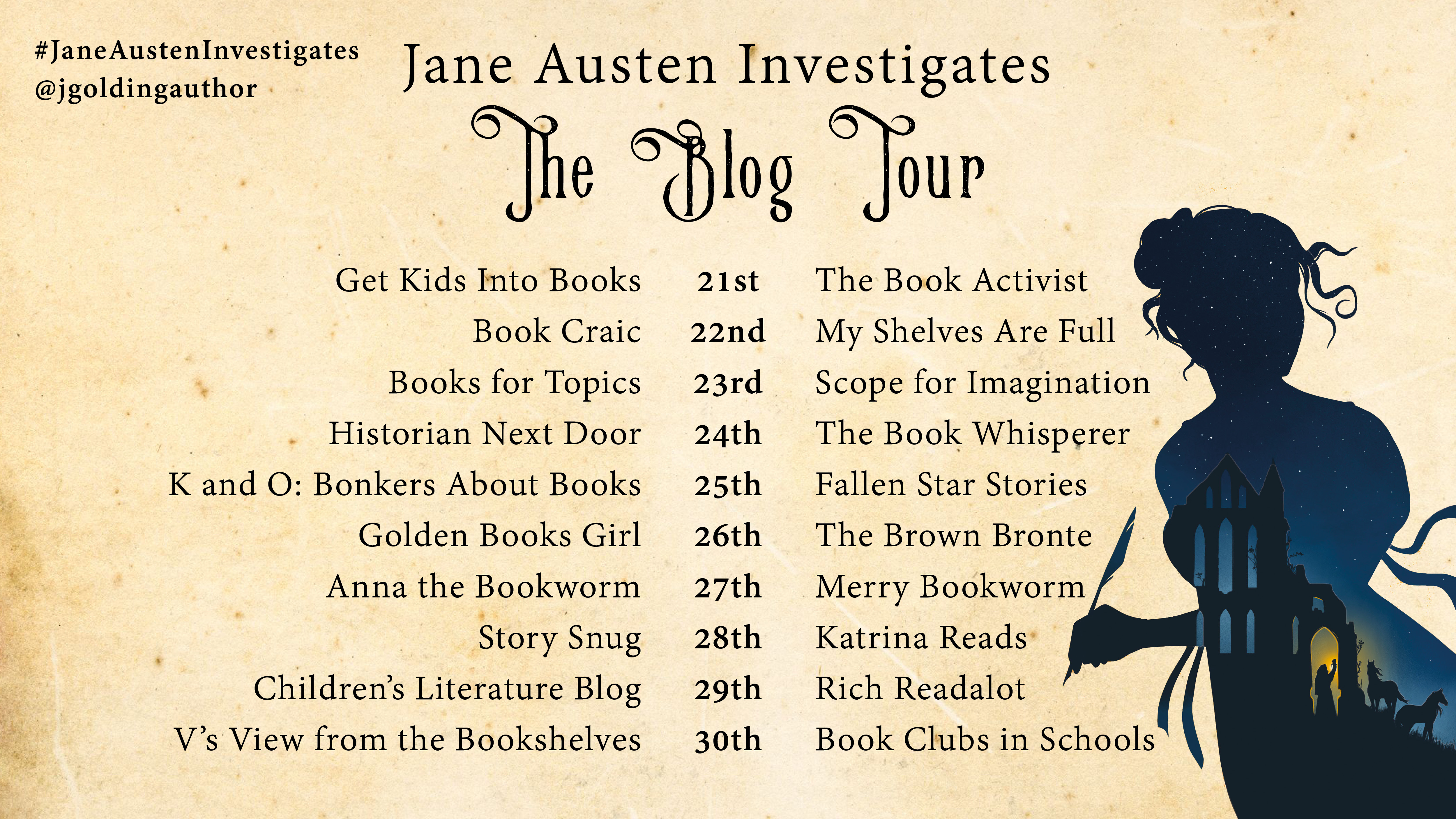
I’m thrilled to kick off the blog tour for Jane Austen Investigates, The Abbey Mystery – the first in a new historical detective series. The book is cleverly plotted and full of intrigue and suspense. There’s plenty of drama and excitement and I found it to be a real page-turner. Read my full review here.
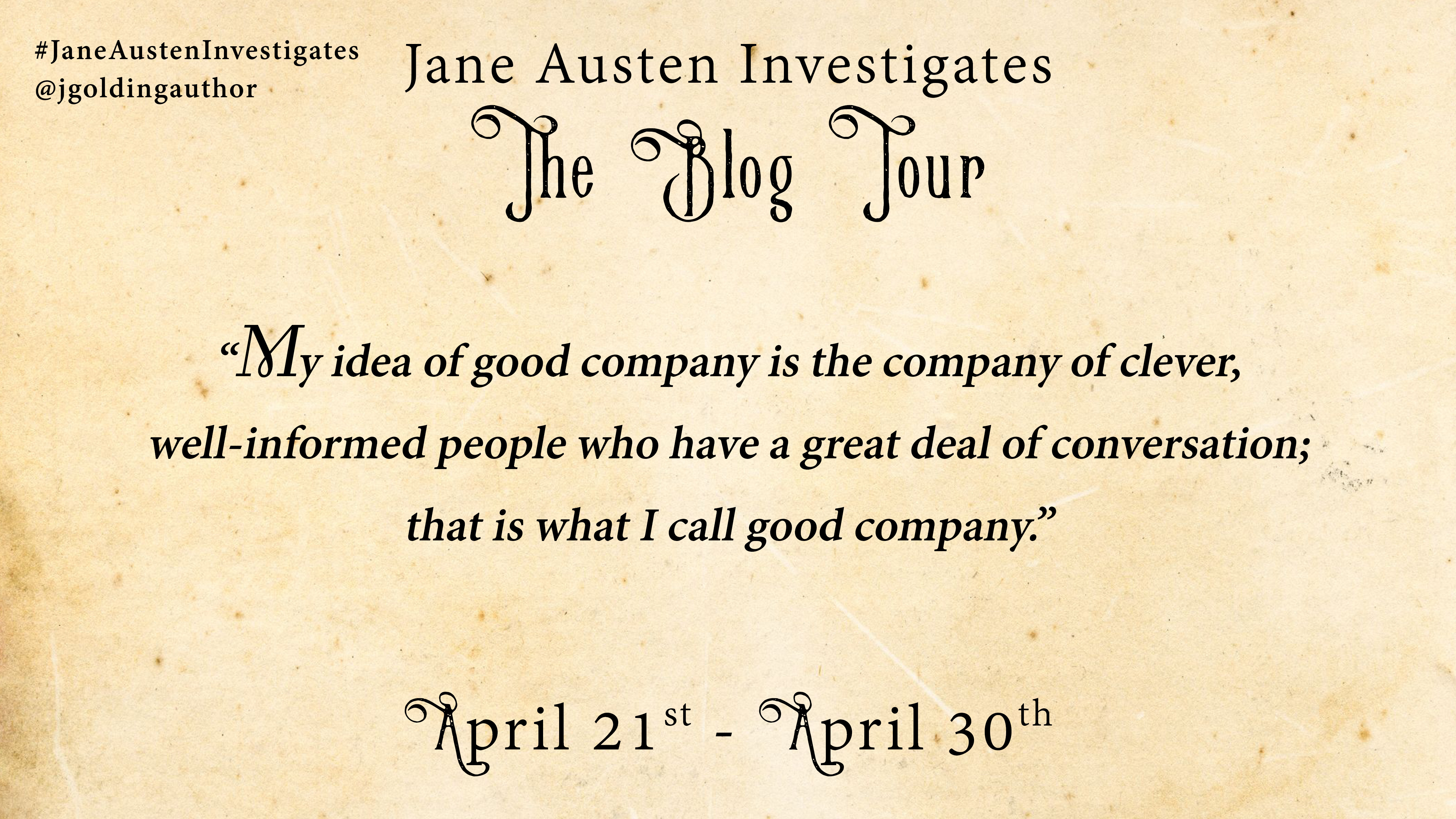
Skin Taker Blog Tour
31 March 2021

I’m delighted to be part of the blog tour celebrating the latest instalment in Michelle Paver’s Wolf Brother series. You can read my review of the brilliant Skin Taker here.
The Forgettery Blog Tour
19 March 2021
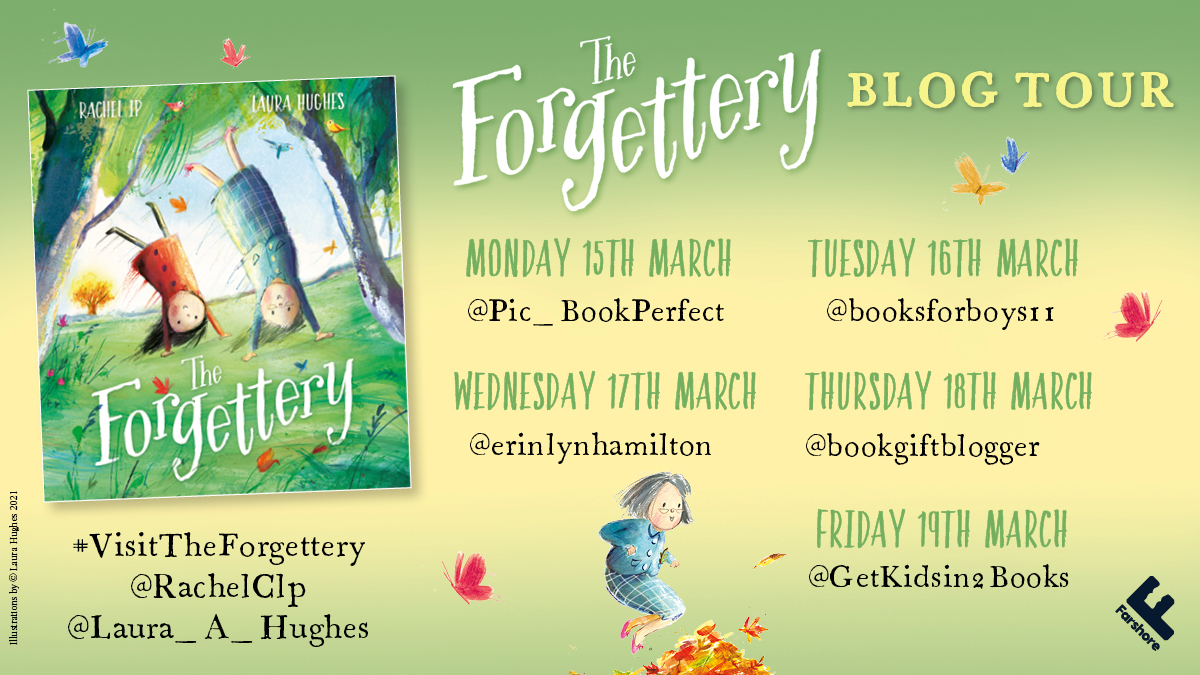
I’m delighted to be part of the blog tour for this wonderful picture book which deals sensitively with memory loss and dementia. You can read my full review here.
The Perfect Fit Blog Tour
12 March 2021
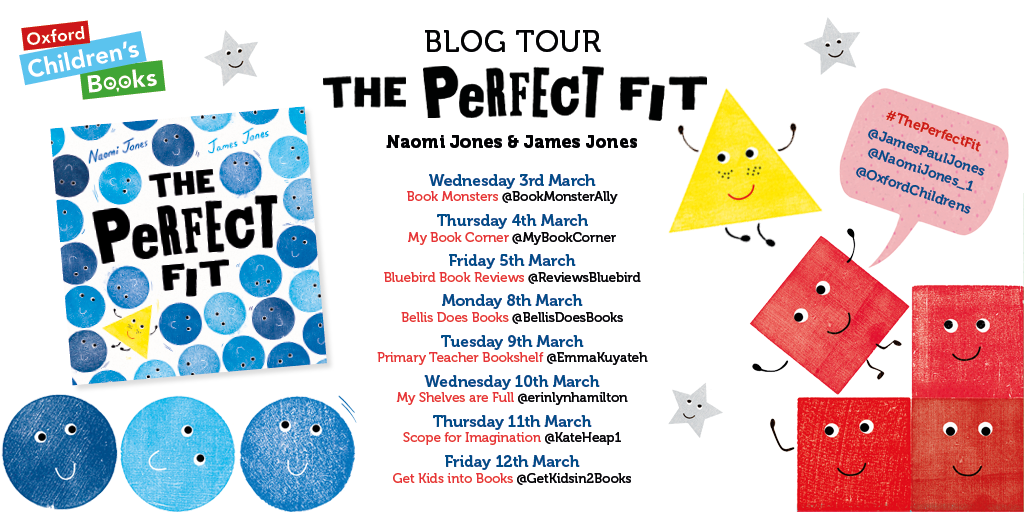
The Perfect Fit is a lovely picture book about belonging and individuality. Triangle is trying to fit in. She plays with each group of shapes in turn but always feels self-conscious about being different. She worries that she’s spoiling the fun. Even though the other shapes try to reassure her, she leaves each group, on a quest to find somewhere that she fits perfectly. Read more of my review here.
Show Us Who You Are Blog Tour
11 March 2021
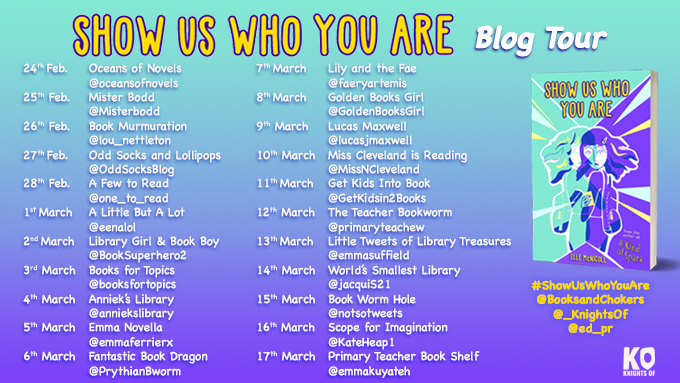
Show Us Who You Are blew me away. It’s an incredible book – powerful and full of compassion. I’m recommending it to everyone. Read my full review here.
Vampirates Blog Tour
8 March 2021

Today I’m delighted to kick off the blog tour for Justin Somper’s brilliant Vampirates series, which has recently been re-published by uclan publishing. Here’s an exclusive video from Justin where he discusses the five key ingredients of an adventure story.
The Dragon and Her Boy Blog Tour
25 February 2021
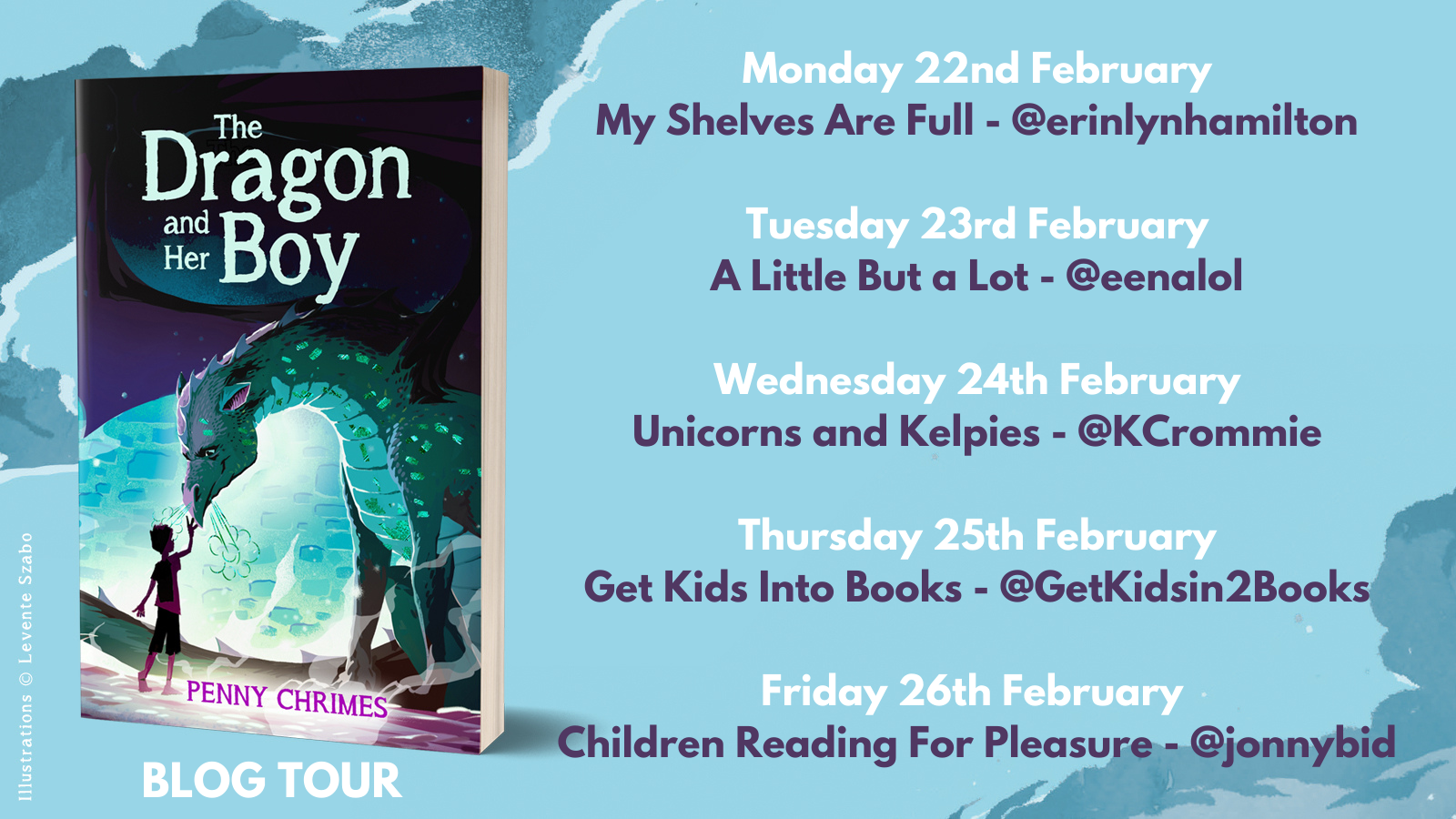
 I’m delighted to welcome author Penny Chrimes to my blog today. Penny’s latest book, The Dragon and her Boy, is a heartwarming adventure steeped in myth and magic. Here, Penny shares her favourite dragons in literature.
I’m delighted to welcome author Penny Chrimes to my blog today. Penny’s latest book, The Dragon and her Boy, is a heartwarming adventure steeped in myth and magic. Here, Penny shares her favourite dragons in literature.
What is it about dragons?
Why has everyone – way before anyone got round to writing things down – always loved a dragon story?
Is it a memory of some mighty creature that ruled the earth before us? An attempt to explain the unearthed bones of long-dead dinosaurs? Or are dragons just the shape we give to the monsters that lurk in our darkest nightmares?
Dragons vary from Fire-drakes to Gold-hoarders to sneaky, snaky Wermes. Some are greedy, some are vicious and some are lazy and would rather just be left in peace.
There are dragons who are no more than a little local nuisance – like the Dragon of Wantley in Yorkshire who could be seen off by a hard kick from a steel-tipped boot. But others require a ready supply of local maidens and can only be vanquished by the likes of Saint George.
But in the end dragons are why we need heroes.
Whether it’s our oldest hero Beowulf – whose story may have been first told in the 700s and was first written down more than 1000 years ago – or Hiccup Horrendous Haddock III, we have to believe that someone, somewhere will be brave enough to face down our most terrible fears.
My favourite dragons
Smaug – the star turn in The Hobbit by J.R.R. Tolkein
Smaug is described by Thorin as ‘a most specially greedy, strong and wicked worm.’ You’ve got to love a dragon that curls itself round its gold and would rather die than part with even a solitary goblet from its precious hoard. I feel like that about biscuits.
The Jabberwock from Alice Through the Looking Glass by Lewis Carroll
Was the Jabberwock a dragon? Well, any creature that has eyes of flame and jaws that bite and claws that catch and whiffles through the tulgey wood – burbling as it goes – is a dragon by my book, and clearly best avoided. And it takes a hero to stop it –
‘One, two! One, two! And through and through
The vorpal blade went snicker-snack!’
And off comes its head …
A Wizard of Earthsea by Ursula le Guin
There is a good sprinkling of dragons to be tackled by Sparrowhawk, the hero of the first in the four Earthsea books.
His first job out of wizard academy (nothing like so much fun as Hogwarts) is in the dragon-infested isle of Pendor, where he has to take on nine of the pesky beasts – one of them being the ancient dragon Yevaud: ‘Lean as a hound he was, and high as a hill.’
Rather cuter are the dear little pet dragons on the island of Iffish, which can perch on your arm and are partial to cake.
How to Train your Dragon by Cressida Cowell
Now here is the finest selection of beasts a dragon-fan could ever hope to meet.
From the Common-or-Garden, which are most suitable for family pets, (although best not left unsupervised with small children) to the ancient and cunning Sea Dragons which are ‘gobsmackingly vast’.
My favourite is the little dragon with an attitude problem, Toothless, who is described rather unkindly as a ‘newt with wings’.
But this is where we find our most unlikely hero – Hiccup Horrendous Haddock the Third – and what it truly means to be brave.
Farthing from Darwin’s Dragons by Lindsay Galvin
The newest recruit to my Dragon Hall of Fame.
Farthing has to be the cutest, most endearing little chap who has ever called himself by the name of dragon. With eyes of shining copper, and a steadfast loyalty to his siblings and the hero, Syms Covington, Farthing comes from the gentler tradition of fire-breathers. He is a hero in his own right.
How Do You Make a Rainbow? Blog Tour
20 February 2021
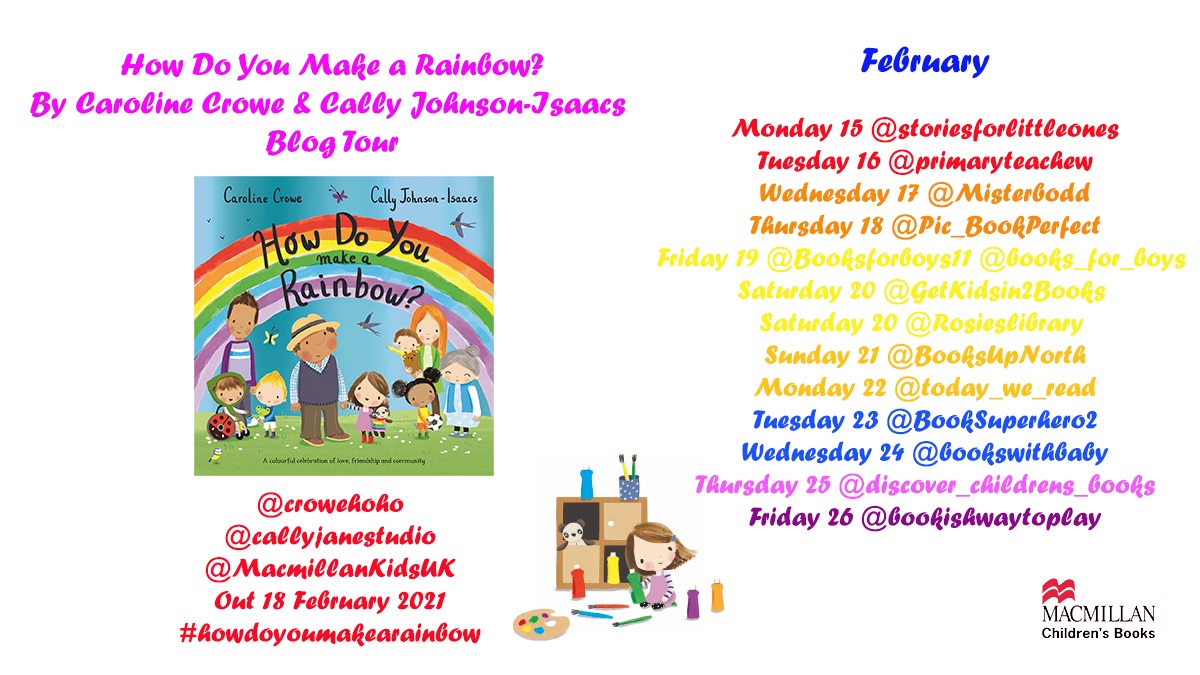
This joyful story, full of hope and colour, is just the tonic we need right now. Read my full review of How Do You Make a Rainbow? here.
Corpse Talk, Dead Good Storytellers Blog Tour
19 February 2021
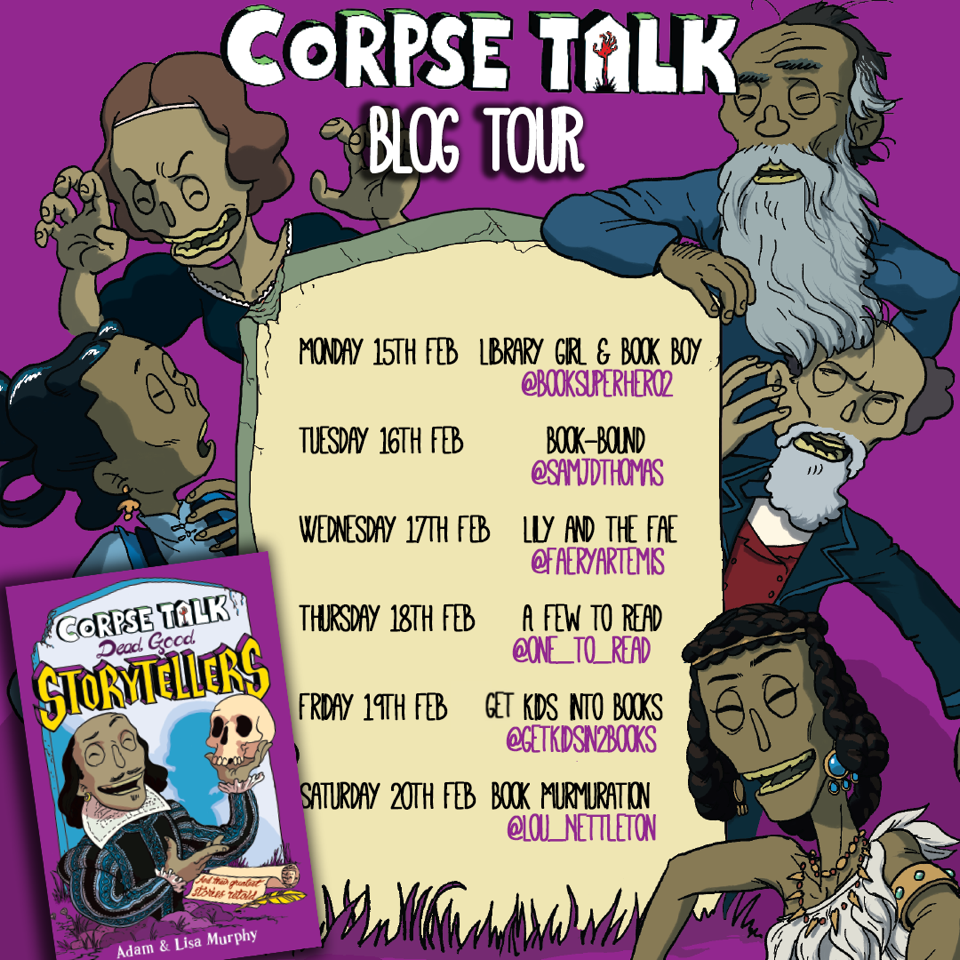
Corpse Talk: Dead Good Storytellers is a non-fiction graphic novel by award-winning husband and wife team Adam and Lisa Murphy, who ‘interview’ history’s most groundbreaking storytellers and create comic adaptations of their most famous stories. Today I’m delighted to welcome Adam and Lisa to my blog.
Get Kids into Books: Which storytellers would you most like to meet?

Lisa: Mary Shelley, I find her courage and resilience in the face of some truly terrible life experiences inspiring. Also, I love a good ghost story – cosying up around a fire and telling scary stories. Wouldn’t she be amazing to get wrapped up in knitted blankets, turn out the lights, light some candles and have hot cocoa with? Or going for a long, windswept walk, arm-in-arm, swapping where we get inspiration for our stories.

Adam: Enheduanna. I’m always interested in beginnings, so who better to speak to, to find out about where it all began, than the first known writer in history!? Plus hers is an utterly fascinating story, but one that we only have the barest clues about. In Corpse Talk, I often have to, not make up what happened – we are trying to be a non-fiction comic – but interpret the facts in the best way possible. It would be great to be able to ask what happened for real. Honourable mentions: Rumi to learn to live into heartbreak. Homer to hear The Odyssey performed (sure, I’d need to learn Ancient Greek first but this is fantasy, right?). Dumas for a truly world-class night out.
The Ocean Squid Explorers’ Club Blog Tour
18 February 2021
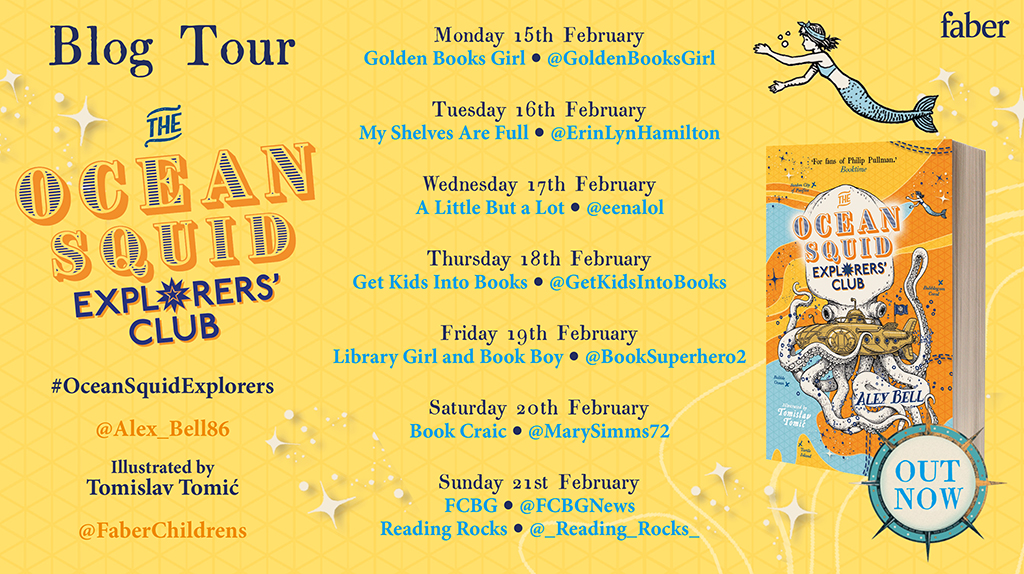
I’m thrilled to be part of the blog tour for The Ocean Squid Explorers’ Club, the fourth instalment in this hugely popular fantasy adventure series by Alex Bell. This time we’re taken by submarine on an underwater adventure and it’s an exhilarating ride, full of edge-of-your-seat excitement. Read my full review here.
Beauty and the Bin Blog Tour
17 February 2021
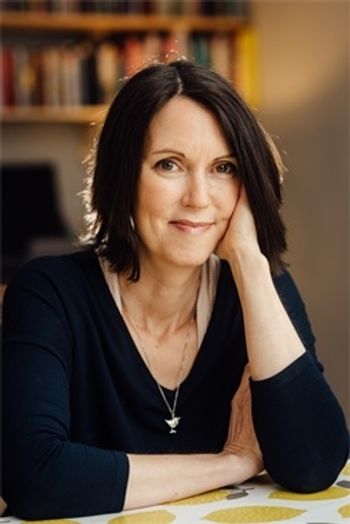 Today I’m delighted to welcome Joanne O’Connell to my blog. Joanne is the author of Beauty and the Bin (which publishes on 18 February).
Today I’m delighted to welcome Joanne O’Connell to my blog. Joanne is the author of Beauty and the Bin (which publishes on 18 February).
Get Kids into Books: Can you tell me more about the book and share your top eco beauty tips?
Joanne: Beauty and the Bin is about a girl called Laurie who makes gorgeous, plastic-free beauty products from ingredients she finds in the kitchen (and in the bin!). While I haven’t personally made hair conditioner from avocadoes I’ve pulled out of a Biffa, I do love making plant-based face packs and lip balms, and finding ways to look after the planet as well as our skin and hair. Here are some of my favourite beauty hacks.
Ditch the face wipes and cotton wool
Disposable face wipes and make up remover pads are causing havoc by polluting our sewers and our seas. Switch up your cleansing routine by using organic, reusable pads, or have a go at making your own. There are lots of tutorials online. Once you’ve made a few you’ll save money as well as the planet.
Make your own beauty products
Making your own products can save packaging (all that plastic!) as well as money, and it means you can use safe, natural ingredients. It only takes minutes to make lip sugars or a face pack (this can be as simple as mashing a banana with a spoon of oats and syrup), or simply try using cold camomile tea as a toner, as part of your skincare regime.
Take a five minute shower
Long soaks in the bath are brilliant. But for every day, a quick shower can save water and energy. Have the first few minutes with warm water, and the last two with the water a bit cooler. This saves energy, and the drop in temperature is better for your skin and hair.
Try a shampoo bar
While many cleaning products, and packaged foods have clear labels about recycling, toiletries still have a way to go. One small step we can take to make our bathrooms as #plasticfree as possible is ditching the shampoo bottles and trying a solid shampoo bar. You might need to experiment (they can act differently depending on whether you have hard or soft water, for example) so buy small bars at first. But once you find one that works for you, they leave your hair super soft and silky and your bathroom plastic free.
Recycle packaging
From lipsticks to hair serum, there’s a lot of packaging in the beauty industry. When you buy products, try and opt for packaging that’s clearly labelled as recyclable, and remember to either recycle glass, plastic and cardboard into your household recycling bins, or find a cool, upcycling use for it. Glass pots of skin cream are a pretty way to store jewellery for example.
Get Kids into Books: Thanks for these fab tips. I’m going to start by having a go at making reusable make-up remover pads.
Milo Imagines the World Blog Tour
9 February 2021
 Milo Imagines the World is an outstanding picture book, bursting with life and love. Milo is on a train journey through the city with his older sister, looking at the faces of the other passengers and drawing pictures of the lives he imagines they lead. It’s a story that develops empathy and opens up the possibility for discussions about prejudice and bias. Read my full review here.
Milo Imagines the World is an outstanding picture book, bursting with life and love. Milo is on a train journey through the city with his older sister, looking at the faces of the other passengers and drawing pictures of the lives he imagines they lead. It’s a story that develops empathy and opens up the possibility for discussions about prejudice and bias. Read my full review here.
The Shark Caller Blog Tour
5 February 2021
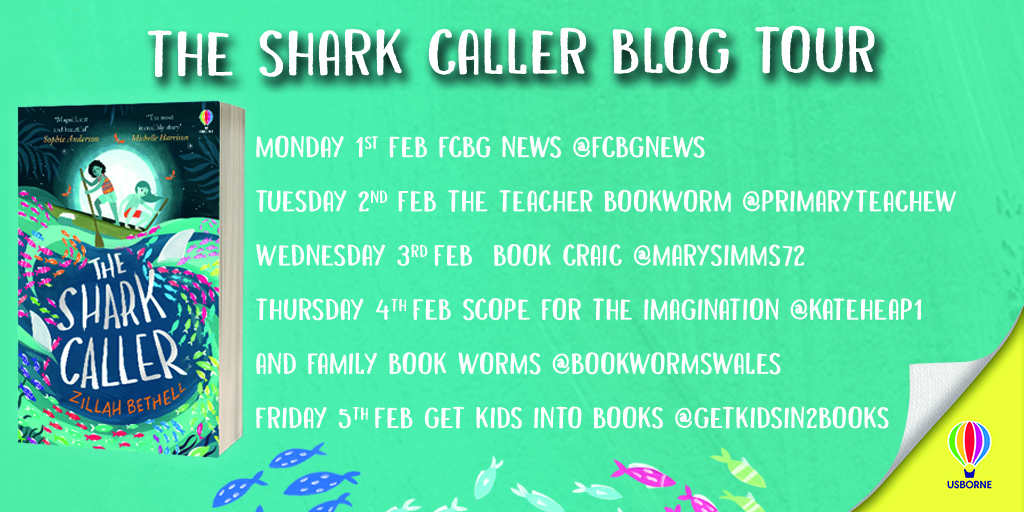

I’m delighted to welcome author Zillah Bethell to my blog today. Zillah has penned a spell-binding new middle grade novel set against the beautifully-woven backdrop of her childhood home of New Ireland in Papua New Guinea. The Shark Caller is an astonishing story of friendship, forgiveness and bravery which fellow children’s author Sophie Anderson describes as “magnificent and beautiful.” It’s a magical story – full of emotion and truth, and steeped in tradition. I absolutely loved it! My full review will follow later today.
Here, Zillah writes exclusively for my blog about her interwoven childhood memories of time and clocks. It’s a fascinating piece which really struck a chord with me.
CLOCKS
I’d like to talk about clocks. There weren’t any in Papua New Guinea. I suppose we didn’t really need to tell the time. We got up at sunrise, went to bed at sunset, ate when we were hungry or when we’d caught or collected something, washed when we were dirty in the sea or the freshwater creek. There was no timetable, no scheduling, no ballet class at four, piano lesson at six, favourite TV show at seven. We occupied the moment, I guess.
I first got a watch when I was fourteen. My father bought me a black, plastic, digital one from the garage. I disliked it immensely. I remember someone asking me the time in school and I said 14:50. They said, why don’t you just say ten to three and I didn’t like to admit that I wasn’t quite sure what 14.50 was. I simply knew it was nearly home time and for that I was grateful.
It’s hard to live in the moment. I often feel like I live in a future perfect tense – when such and such happens everything will be fine kind of thing. Or I inhabit the dark regions of a past that needs fixing. Ghosts of if–only, I call it, setting up realities of what could have been, should have been, in place of a reality that was. There’s a saying in Ewa ge (the language of the sea people) that the angels travel at their own speed which may be ponderous to humans! It’s interesting how a question at twentyis answered say at thirty in a way which gives a whole new understanding of the question. My mother used to say, apparently, that life is very short and you don’t remember much of it. I thought this was pretty depressing and strange from a person so full of joy, but as I’ve gotten older, I’ve found it to be true. We seem to remember best the shining moments of illumination, the pegs on which we hang the wash days of our lives.
I remember the first time I heard the chime of a grandfather clock in my grandmother’s antique shop in the UK. What a monstrous invention, I thought, announcing the time and thus taking us out of it, slicing my life into hourly chunks! And then there were the church bells up the street, pealing for what seemed like an eternity. I didn’t know which was worse, the grandfather clock or those church bells, me who’d only known silence and the soft lullaby of the waves. In the end I came to love those sounds, the clock like some benevolent old man saying you too will grow old and sit in a corner but it doesn’t really matter and the church bells proclaiming the infinitude of heaven. I love that in 1984, Winston Smith hears fragments of Oranges and lemons say the bells of Saint Clement’s – scraps of songs from a half–forgotten childhood. And that these things matter.
In a book about time, memory and redemption, it felt necessary to go back to the start of time for me – the shores of Papua New Guinea. The grandfather clock made its way into Hamelin’s hut, of course, as a bridge from one land to another, one time to another. I used a present tense narration because I wanted to give an immediacy to an unfolding fictional experience (like the church bells drawing attention to time itself); and also to communicate my perception of otherworldly time where past and future are all contained in the present.
***
I own a small wooden Victorian clock (from my grandmother’s shop, Aggie’s Antiques). It has Roman numerals on its face and minarets on top. I used to wind it up with a key religiously every night. Until children came along and life got in the way of time. The hands are stuck at just before twelve and I like to think there are a few moments left to escape, a few moments to get lost in before the next strike.
“Quick! Here! Now!” A child’s voice worse than a chiming clock for pulling you into the present. My daughter stands before me.
The expression in her eyes is just like my mother’s.
And there’s something about the way she walks.
A heartbeat goes missing.
And I am out of time once more…
Get Kids into Books: thank you so much for writing this beautiful guest post. I love your reflections about how we are linked across time through the generations of our family. Your observations about occupying the moment really resonated with me too; it’s so very important to do this and it’s a practice which is easily lost as we dash frantically from one obligation to another in our busy modern lives or dwell on the what-ifs and regrets of our past.
Poppy Goes Wild Blog Tour
4 February 2021
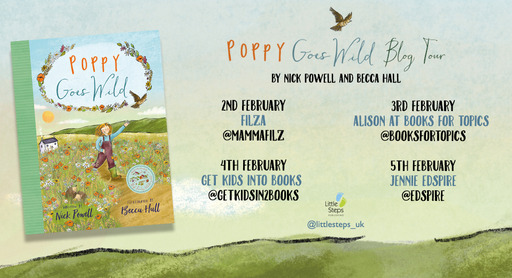
 I’m delighted to welcome Nick Powell to my blog today. Nick is a multi-award winning television producer whose credits include launching the series Supernanny, Escape to River Cottage and Nigella Bites. Born and raised in the Black Country, Nick grew up with a strong appreciation of the rivers, wild meadows and rolling hills of the surrounding countryside. Now he’s written a children’s book which champions the re-wilding of the British countryside and celebrates the beauty of our native wildlife.
I’m delighted to welcome Nick Powell to my blog today. Nick is a multi-award winning television producer whose credits include launching the series Supernanny, Escape to River Cottage and Nigella Bites. Born and raised in the Black Country, Nick grew up with a strong appreciation of the rivers, wild meadows and rolling hills of the surrounding countryside. Now he’s written a children’s book which champions the re-wilding of the British countryside and celebrates the beauty of our native wildlife.
Poppy Goes Wild is a tale all about a young girl on a mission to save her Grandad’s farm by returning the countryside to a time when flower meadows grew wild and native animals flourished.
The Process Behind the Writing Journey of Poppy Goes Wild by Nick Powell
As I embarked on writing a children’s book I found it very helpful to be able to draw on my experience of writing TV scripts for factual programmes. It struck me that both short form genres of writing place the same demands on the author to be both concise and entertaining in their storytelling. Lose your reader and they may put the book down and never pick it up again. Lose your channel hopping TV audience and they too are unlikely to come back.
Before I started writing, I settled on the broad story arc I wanted and stuck to it. But given that a strong motivation for me was to engage young readers in the wonders of British wildlife, striking the balance between conveying information and ensuring that the book was a fun read, was probably the biggest challenge. For it to work, I ensured that Poppy’s relationship with her grandad was cheeky with a playful dialogue, allowing me to insert facts about wildlife into amusing exchanges.
I spent more time on the dialogue than anything else in the book. I started by getting down the information exchange I wanted, before revisiting it a few times to ensure that it was both light and informative for the target age group. Above all, I wanted the young reader to look at Poppy and think…She’s great, I would really like to be like her.
As a new author I was unlikely to get a big book deal, so having researched the children’s market I decided to follow the publishing partnership route. It was the best thing I could have done as I received great professional advice while being allowed to write the book that I wanted, which I hope will inspire children to look after nature.
Opie Jones Talks to Animals Blog Tour
2 February 2021
Opie Jones Talks to Animals is the first book in a brilliantly funny new middle-grade series. Ten-year-old Opie Jones is just a regular kid and no-one is more surprised than her when she gets recruited to join The Resistance – a team of superheroes who can read minds and have a dastardly, brainwashing villain to defeat. However, it turns out that her superhero power is a bit disappointing. Opie can read animal minds, not human ones. However, maybe this might just be the skill set needed to overturn Hugo Varling… Read the rest of my review here.
When The World Was Ours Blog Tour
1 February 2021
I’m honoured to be part of the blog tour for this incredible book. When The World Was Ours explores the rise of the Nazis and the spread of fascism in Europe. It is hard-hitting and harrowing. The book is a split-narrative with chapters told from the points of view of three children, Elsa, Leo and Max. Leo’s story is inspired by the true story of author Liz Kessler’s father and his escape from Nazi-occupied Europe. When The World Was Ours is a devastating story and one which has had a profound effect on me. I will never forget the story of these three children. You can read my full review here. For the week of the blog tour, readers will be able to get dedicated and signed copies of When The World Was Ours from Bags of Books here.
Read for Empathy Book Collection Launch
26 January 2021
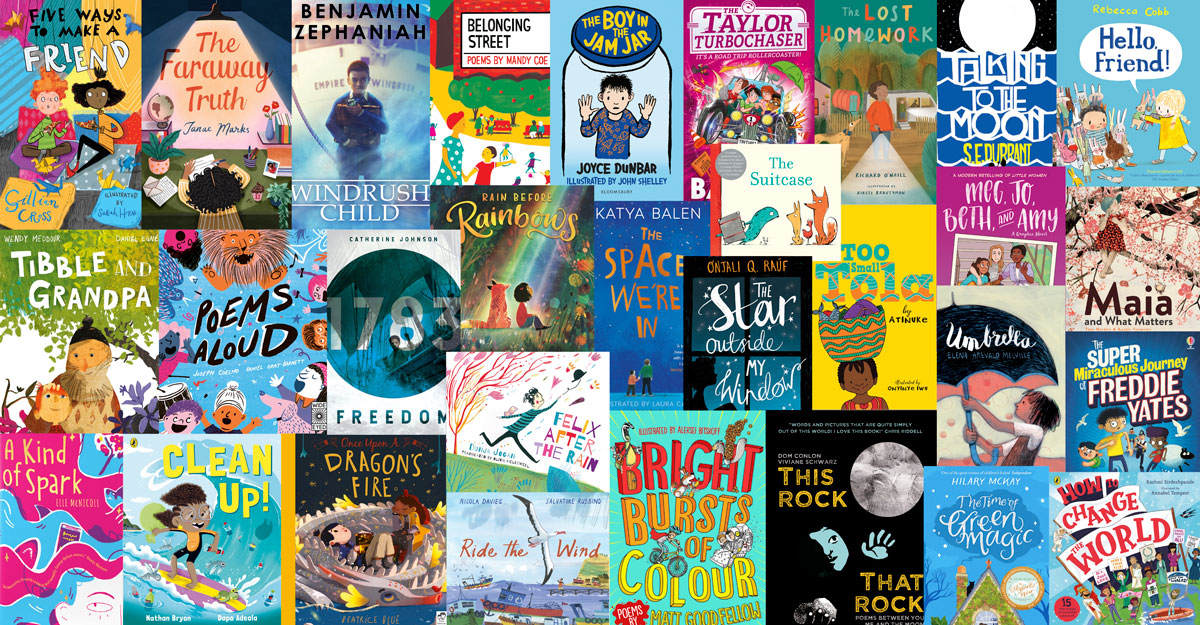
EmpathyLab have revealed the 2021 Read For Empathy book collection after an expert judging panel weighed up hundreds of publisher submissions to select 50 of the very best contemporary empathy-boosting books for 4-16 year olds.
The aim is for schools, libraries, families and community groups to use the books to help raise a generation with strong empathy skills. Free downloadable guides, with tips on how to use the books with children and young people at home or in school, are available online here. EmpathyLab’s work on the book collection is supported by specialist book suppliers Peters. Schools and libraries can order the books from them here.
The primary collection is for 4-11 year olds and consists of 30 books; the secondary collection features 20 books for 12-16 year olds. Many of the books help readers understand the lives of those experiencing tough situations, from witnessing domestic violence to becoming a refugee. Others gently explore everyday situations and emotions, like friendship problems. Several help readers understand the experience of living with autism. The fantastic range of creators, formats and genres helps expand children’s world view and understand others better.
The 2021 Read For Empathy book collection comes at a time when empathising with others has never been needed more. As the judges said, “We have an unprecedented chance to do things differently, building on the wave of community caring we’ve seen in the pandemic. This collection seizes that chance with both hands. The books will help children be their best selves; to think “we”, not “me”. Right now, what could be more important?”
EmpathyLab is a not-for-profit organisation whose aim is to harness the power of the word – of stories, graphic novels, non-fiction and poetry – to build a more empathetic generation. Each year EmpathyLab select a new contemporary Read for Empathy collection. They also deliver an annual Empathy Day to shine a light on this real life superpower. 2021’s Empathy Day is on 10 June.
Chocolate Milk, X-Ray Specs and Me
Blog Tour 13 January 2021
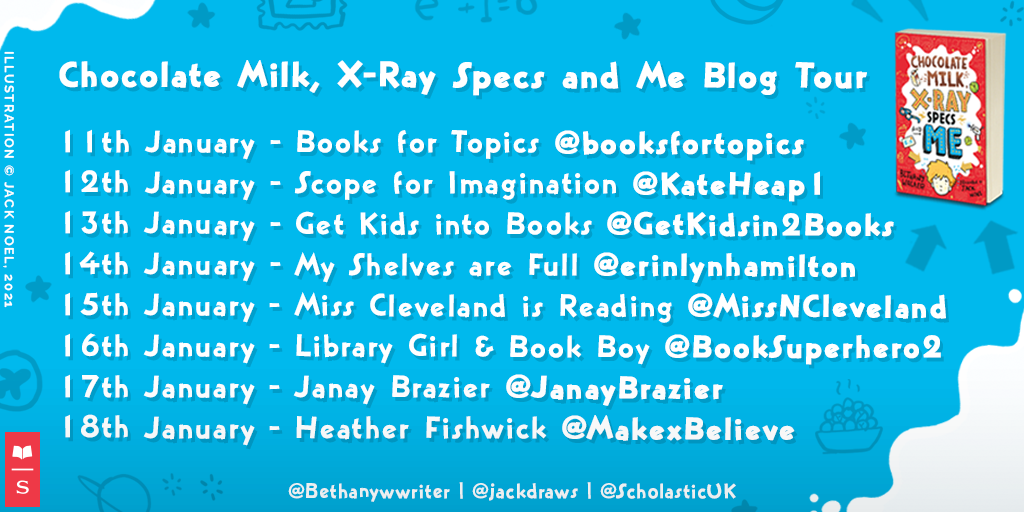
 I’m delighted to welcome author Bethany Walker to my blog today to talk about the editing process for her MG début, Chocolate Milk, X-Ray Specs and Me.
I’m delighted to welcome author Bethany Walker to my blog today to talk about the editing process for her MG début, Chocolate Milk, X-Ray Specs and Me.
‘We like this – now double it!’ Editing and Extending the Story – a guest post from Bethany Walker
The style in which Freddy was written was very much inspired by other letter/diary format books – in particular The Dragonsitter series by Josh Lacey, The Unbelievable Secret Diary of Pig by Emer Stamp, Little Wolf’s Book of Badness by Ian Whybrow and The Last Polar Bears by Harry Horse. All of these stories are amazing and, if you haven’t read them, I would heartily recommend them. They also have fairly low word counts, so when Chocolate Milk, X-Ray Specs and Me initially reached Scholastic’s desk, it was only c.9,000 words.
Thankfully, those 9,000 words were enough to make Scholastic think there was something to the idea but, from the off, my editor encouraged me to extend the book. Originally, the book was entirely made up of Freddy’s letters and they focused almost exclusively on the weird goings-on relating to the spy world (from Freddy’s own unique perspective). Freddy never received any response from his parents and the readers never knew what was actually going on with the spies. It was daunting to be asked to try to double the word count but, in actual fact, editing Chocolate Milk has been the most fun I’ve had as a writer.
I was asked to:
- include letters from the parents, as a reassurance for children that Freddy wasn’t just sending letters into the ether
- develop Freddy’s character and his school life more
- find a way to include communications from the bad guys
The way I organised myself to do this was to create a calendar of key events in the story and then see where other threads could be strung through. Importantly, the story had to work according to normal life – as all Freddy’s letters are dated, those dates had to fit in with real weeks and months – and, even more importantly, the story had to work according to school life. As an ex-teacher (who is married to a teacher and who has school-aged children), I have always lived my life based on the structure of the academic year, so it was vital that term dates, holidays and other school activities like sports day took place in as realistic a schedule as possible.
In the photo below, the original letters (in their original dates) are scribbled in black, the changes to Freddy’s letters are in red and the other, new voices (such as the parents and the baddies) are in other colours. Once the plot was worked out over the calendar, the additional words almost wrote themselves.
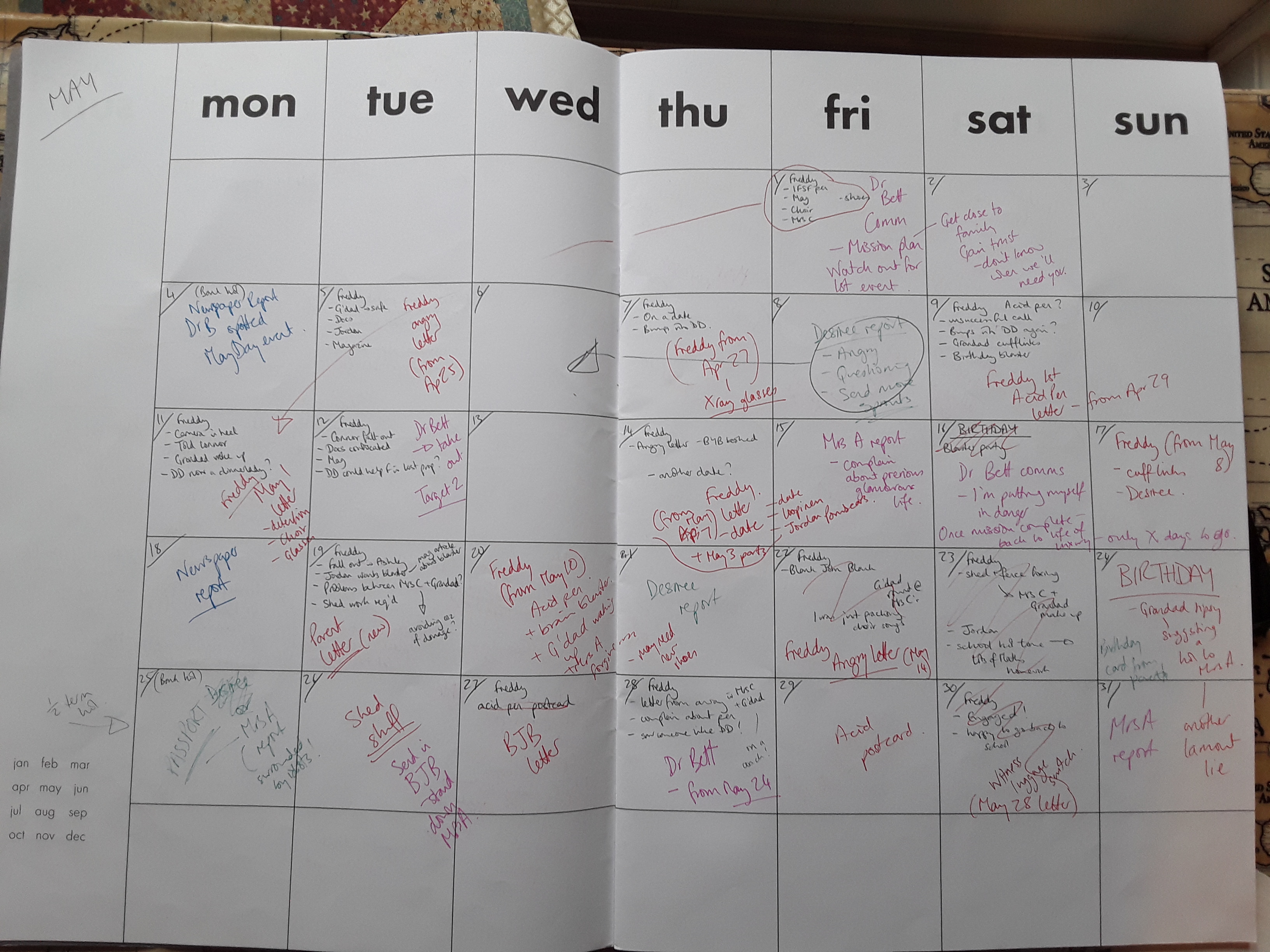
I wouldn’t necessarily hold this up as a paragon of story planning but I thought you might like to see it. Out of great fortune, this system worked for me and the daunting task of doubling 9,000 words became a joyful romp to 28,000 words. Thanks to clever editors who really know their stuff, what started out as a spy story where the main character happened to be in school turned much more into a story about fitting in, about absence and about friendship, that just happened also to contain some hilarious espionage shenanigans.
You can read my review of Chocolate Milk, X-Ray Specs and Me here.
Amari and the Night Brothers Blog Tour
13 December 2020
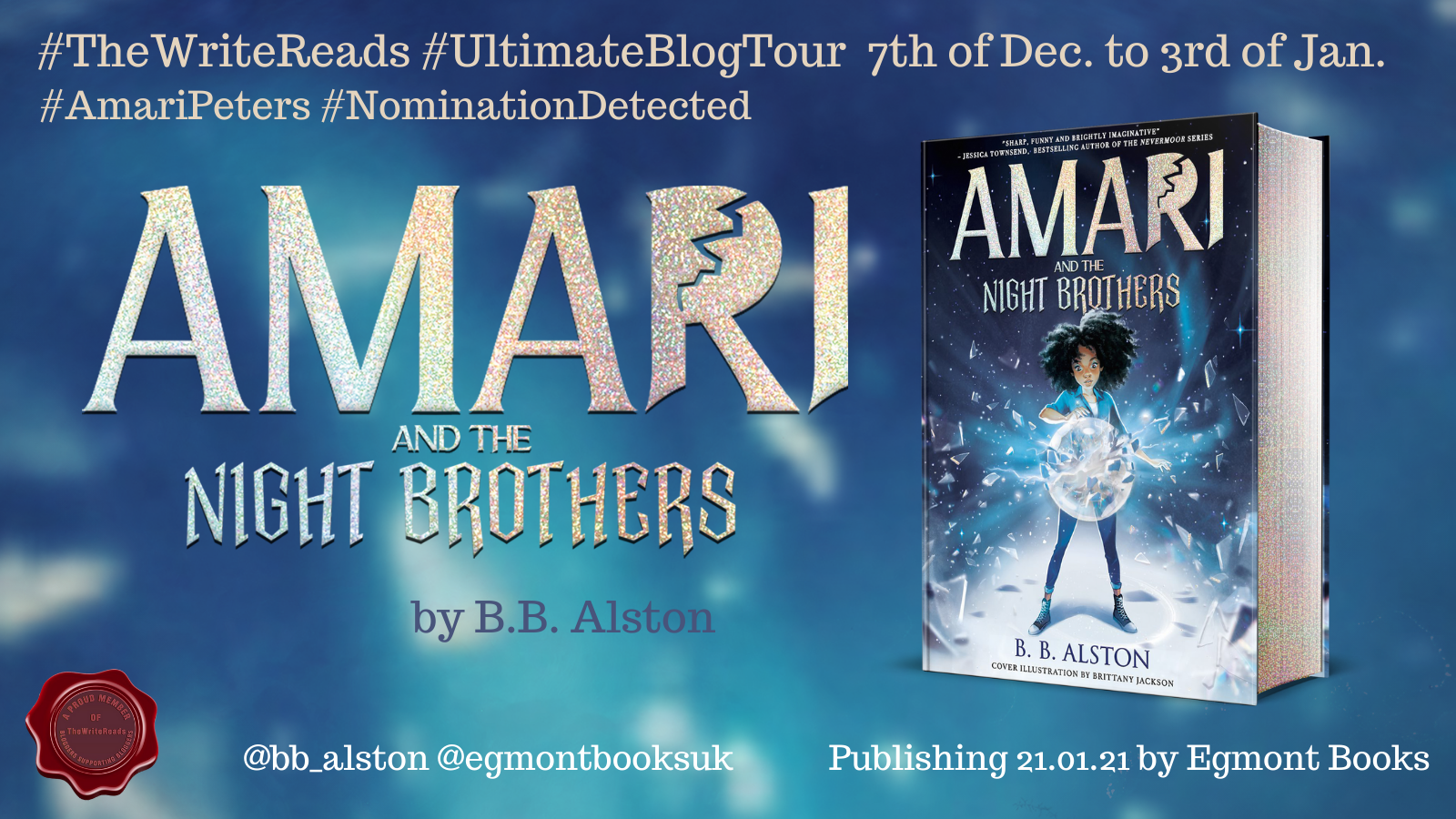
I am thrilled to be part of the blog tour for this incredible middle grade book! Amari Peters will be the hero for a new generation of readers. Find out all about the first book in this MG trilogy here.
Gender Swapped Fairy Tales Blog Tour
2 November 2020
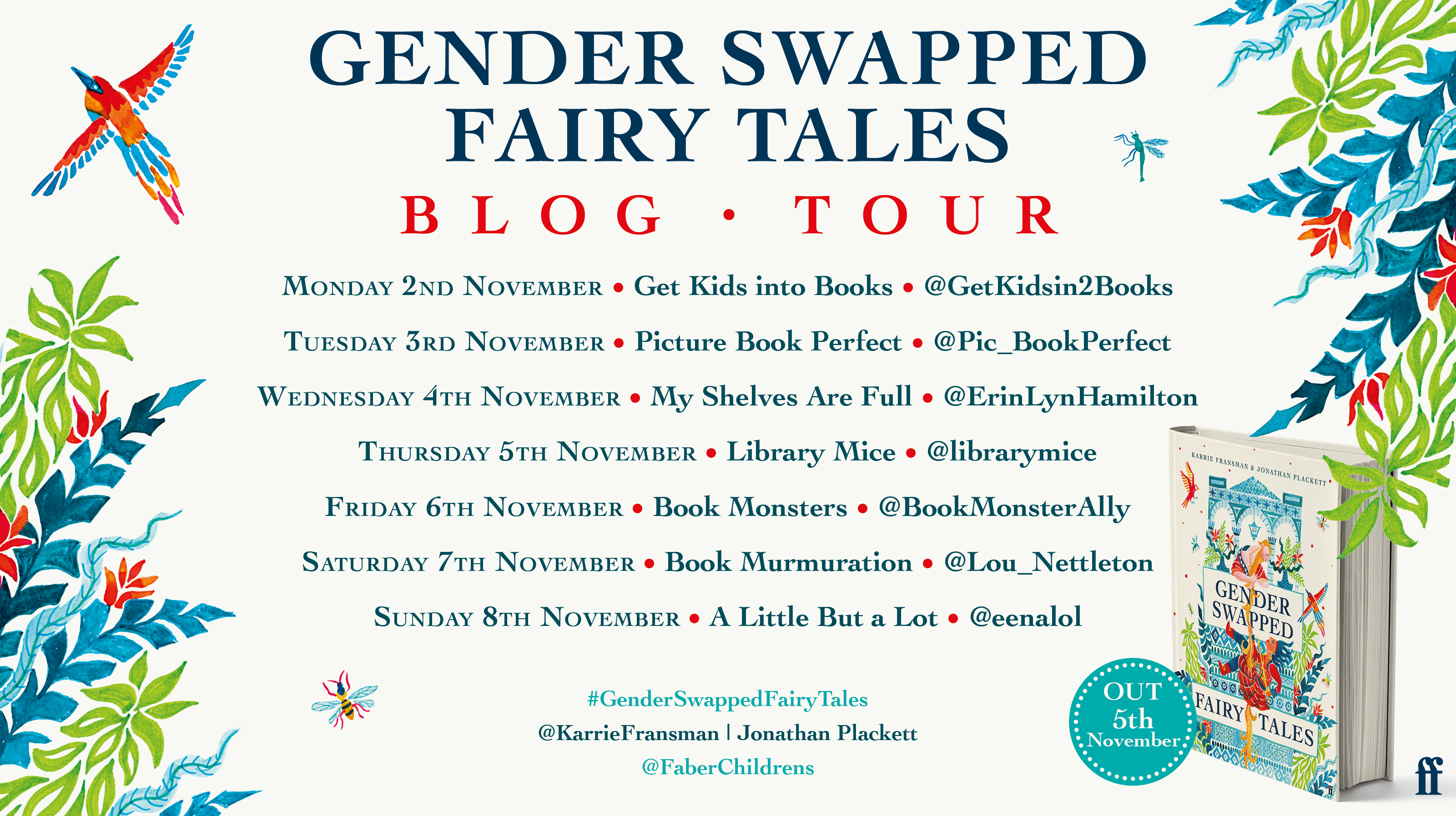
Click here for my review.
Fire Burn, Cauldron Bubble Blog Tour
7 October 2020
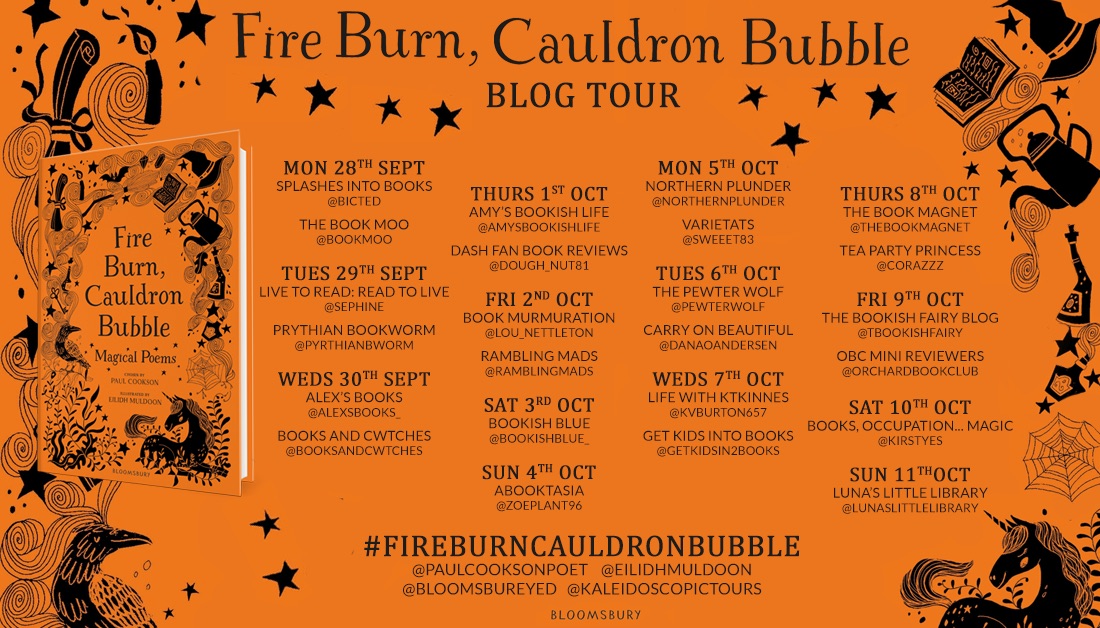
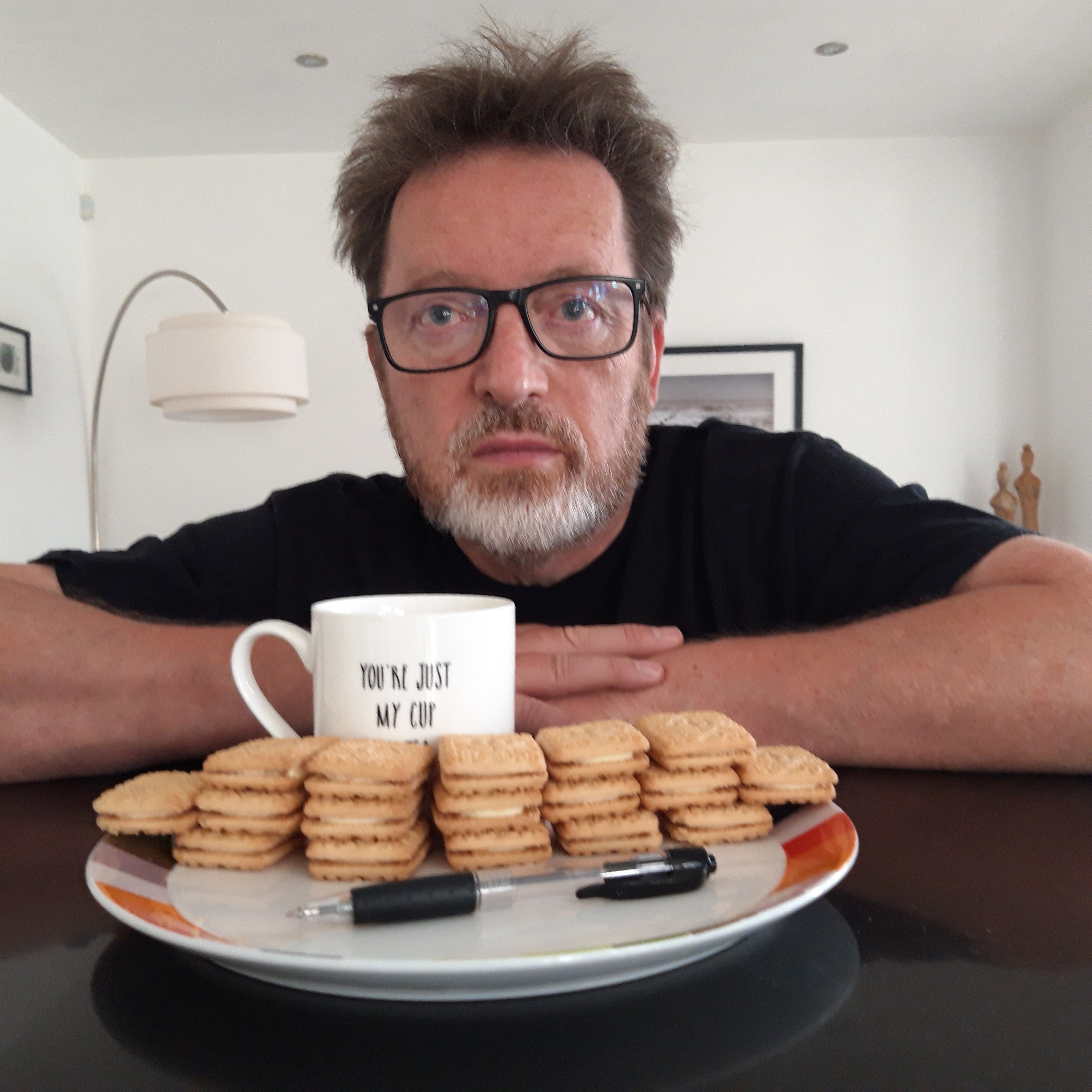 I’m delighted to welcome poet Paul Cookson to my blog today. He’s recently chosen a fantastic selection of magical poems to be included in a wonderful new poetry anthology entitled Fire Burn, Cauldron Bubble.
I’m delighted to welcome poet Paul Cookson to my blog today. He’s recently chosen a fantastic selection of magical poems to be included in a wonderful new poetry anthology entitled Fire Burn, Cauldron Bubble.
Get Kids into Books: Hello Paul, can you tell me about your five favourite poems of all time?
Paul: To choose five favourite poems – wow, what a difficult choice! I suspect if you asked me on another day it would be five different poems but here we go …
- Roger McGough – Emus
To be honest there are hundreds of poems by Roger that I could choose. Whenever I buy a new collection, I read it and think “Wow, I have so much still to learn”. Roger’s poems have immediacy, depth, resonance, humour, accessibility, charm, empathy, wit and … and … everything you could wish for in a poem and from a poet. What I love about Emus is that it’s short, memorable and funny
To amuse
Emus
On hot summer nights
Kiwis
Do
Wiwis
From spectacular heights
And it’s got the word “weewees” in! What’s not to like?
- John Cooper Clarke – Ode To The Coast
John was the first poet I saw perform and I loved – still love – his style and delivery. An itinerant rhymer with machine gun precision. He’s probably the king of rhyming poetry. Often, with great humour.
What I love about Ode To The Coast is that it’s a poem that rhymes beautifully but is in no way funny. Rhymes and rhyming poetry are often associated with humour and jokiness so it’s wonderful to see / hear one of his poems that has all his trademark traits but is just a great rhyming poem. He was commissioned by The National Trust to write it and there’s a great video of him performing it on You Tube. When I heard it, I knew I would include it in a collection somewhere so when I edited 100 Brilliant Poems For Children it was first on my list.
- David Harmer – Mister Moore
I’ve known David for nearly thirty years and spent twenty of those performing with him in our double act “Spill The Beans” so I’m biased. But … one thing is undeniable, Mister Moore never ever fails with an audience.
Yes, it’s simplistic in structure. Yes, the rhymes are obvious. Yes, a couple of them don’t rhyme properly ( “brush” and “much” ). Yes, it looks a little ordinary on the page but – but – BUT – when it is performed and the audience join in with the chorus …
Mister Moore – Mister Moore
Creaking down the corridor
uh – uh – eh – eh – uh
uh – uh – eh – eh – uh
It is magic. The “uh ….” is the audience making creaking sound and doing the actions. It never fails. So much fun and laughter to be had – and all because of poetry!
A perfect performance poem. Performance poetry is often overlooked or looked down upon, mostly by poets who can’t perform if the truth be known, or critics who rarely visit schools and are “snobby” about what “real poetry” is … I don’t really believe in “good” or “bad” poetry, more some poems I like and some I don’t. Anyway, I digress! There is a real skill to writing something that works out loud. Indeed, all poems should sound good when they are read aloud – apart from maybe shape poems. Mister Moore – oh I wish I’d written it! I’ve copied it lots of times though!!
- Michael McDermott – When The River Meets The Sea
Strictly speaking it is a lyric. It’s a great song by a great songwriter – very hymnal. Few songs work as poems, but this one does. A few years ago when I was editing 100 Brilliant Poems For Children I included this. It’s a very strong and somehow prayerful image that I really love.
When the river meets the sea
And my Lord comforts me
I know someday we’ll be
Where the river meets the sea
- Paul Cookson – Let No-one Steal Your Dreams
I know it’s a little self-indulgent but I’ve chosen one of my own. The story of this one is interesting. If anything, I’m probably known as “a funny poet”. I often describe my shows as like a “pantomime – but with better rhymes” – and I love that. But what I love most about poetry is that it can take on many shapes, forms, genres and moods.
I wrote this poem many years ago – just before I was due to meet Slade at an event. If you don’t know who Slade are, think that Christmas song from the seventies! They were the first band I really loved – and I was getting to meet them. At the same time, things were taking off a little for me as a poet in schools and with various collections.
Somehow the poem was used on a poster given away with Junior Education magazine ( I think ) and since then it’s sort of grown into an assembly poem, particularly a Year 6 Leaver’s Poem.
It’s also been turned into two completely different songs, by Hythe Primary School and Sing Together respectively. They can both be found on You tube and I love them. I was present at occasions were these were performed and it brought a tear to my eye to hear those words sung so beautifully on both occasions.
So, this poem has a very special place in my heart. They all do but this one especially. I once read that Malorie Blackman said that this was the poem she wished her younger self could have seen. That’s good enough for me …
Let no-one steal your dreams
Let no-one tell that you can’t
Let no-one hold you back
Let no-one tell you that you won’t
Set your sights and keep them fixed
Set your sights on high
Let no-one steal your dreams
Your only limit is the sky
Get Kids Into Books: Thank you Paul for this brilliant selection and the fascinating insight into the reasons behind your choices. Emus is a particular favourite of mine too – for years I had it pinned to my fridge!
Interview with a Tiger Blog Tour
27 September 2020

Today it’s my stop on the blog tour for this terrific new non-fiction book. I really enjoyed the book’s format – animal facts presented as answers to interview questions. A range of wild animals are interviewed, from tigers and snow leopards to honey badgers and sloths. Click here to read my full review.
The Beast and the Bethany Blog Tour
24 September 2020
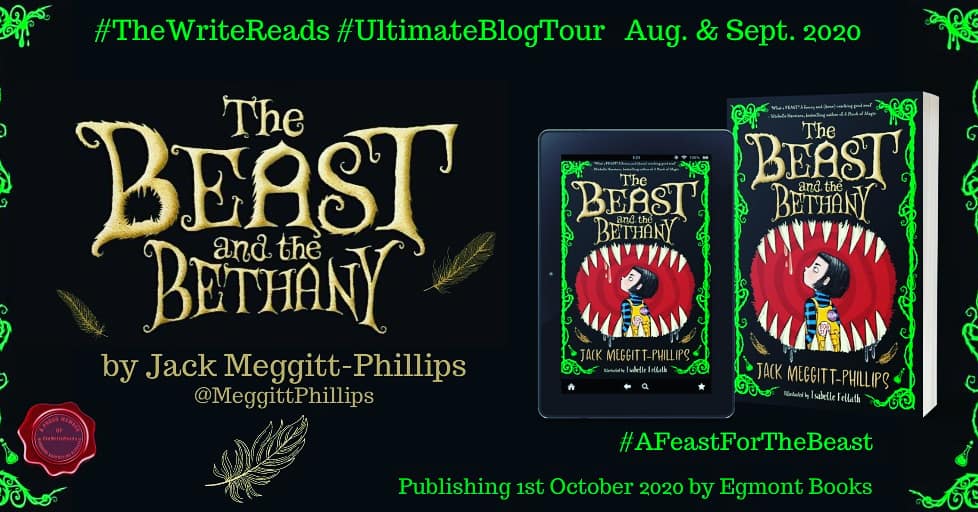
I was super excited to receive an advance proof copy of The Beast and the Bethany and I wasn’t disappointed. The story is a riot! Brilliant characters and loads of fun. You can read my full review here.
Pirate Nell’s Tale to Tell Blog Tour
21 September 2020
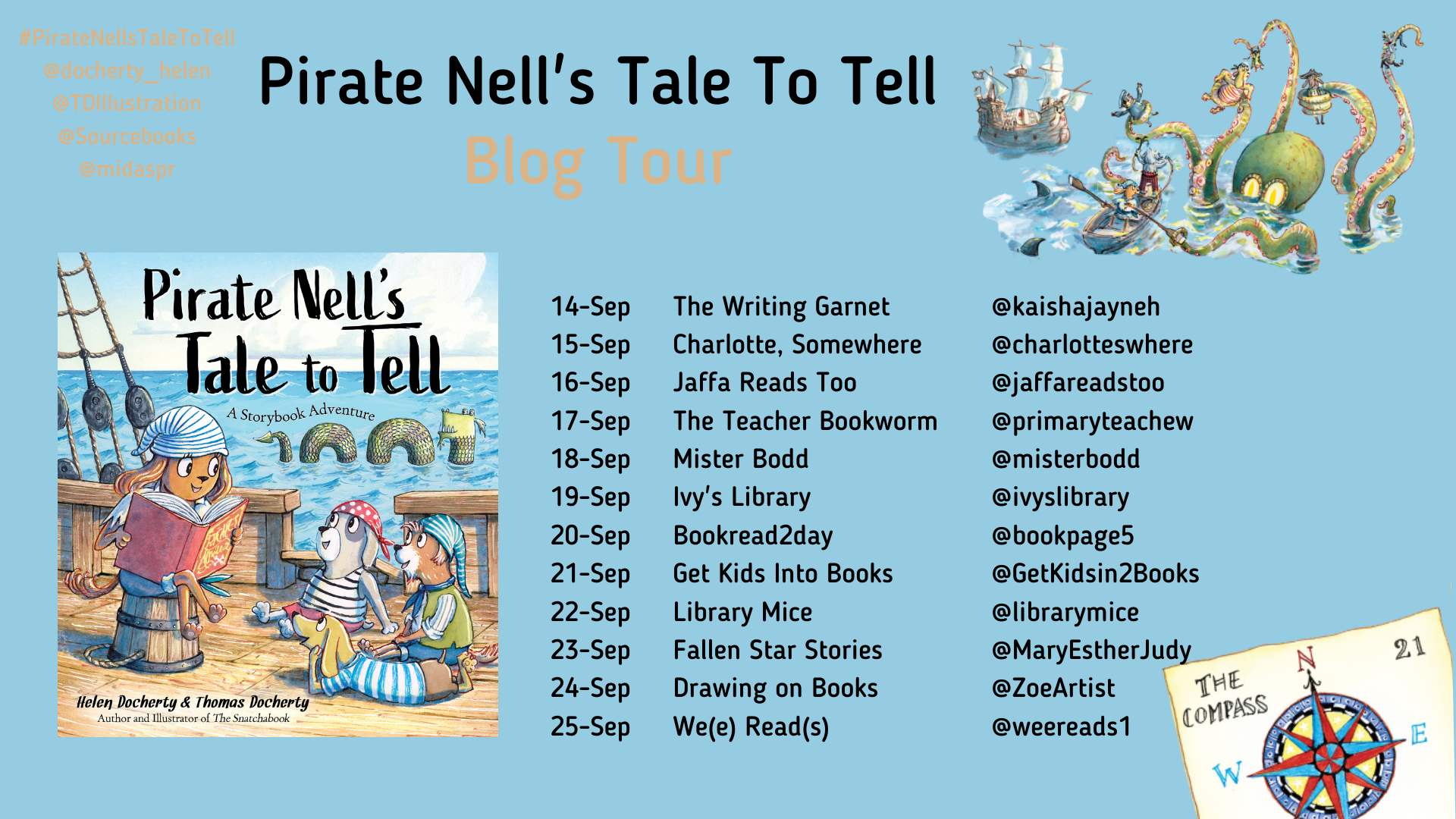
A terrific picture book, Pirate Nell’s Tale to Tell celebrates reading and the knowledge and joy it brings. Plus, it features one of the best fictional libraries that you’ll ever encounter. Click here to read my full review.
The Tigers in the Tower Blog Tour
19 September 2020
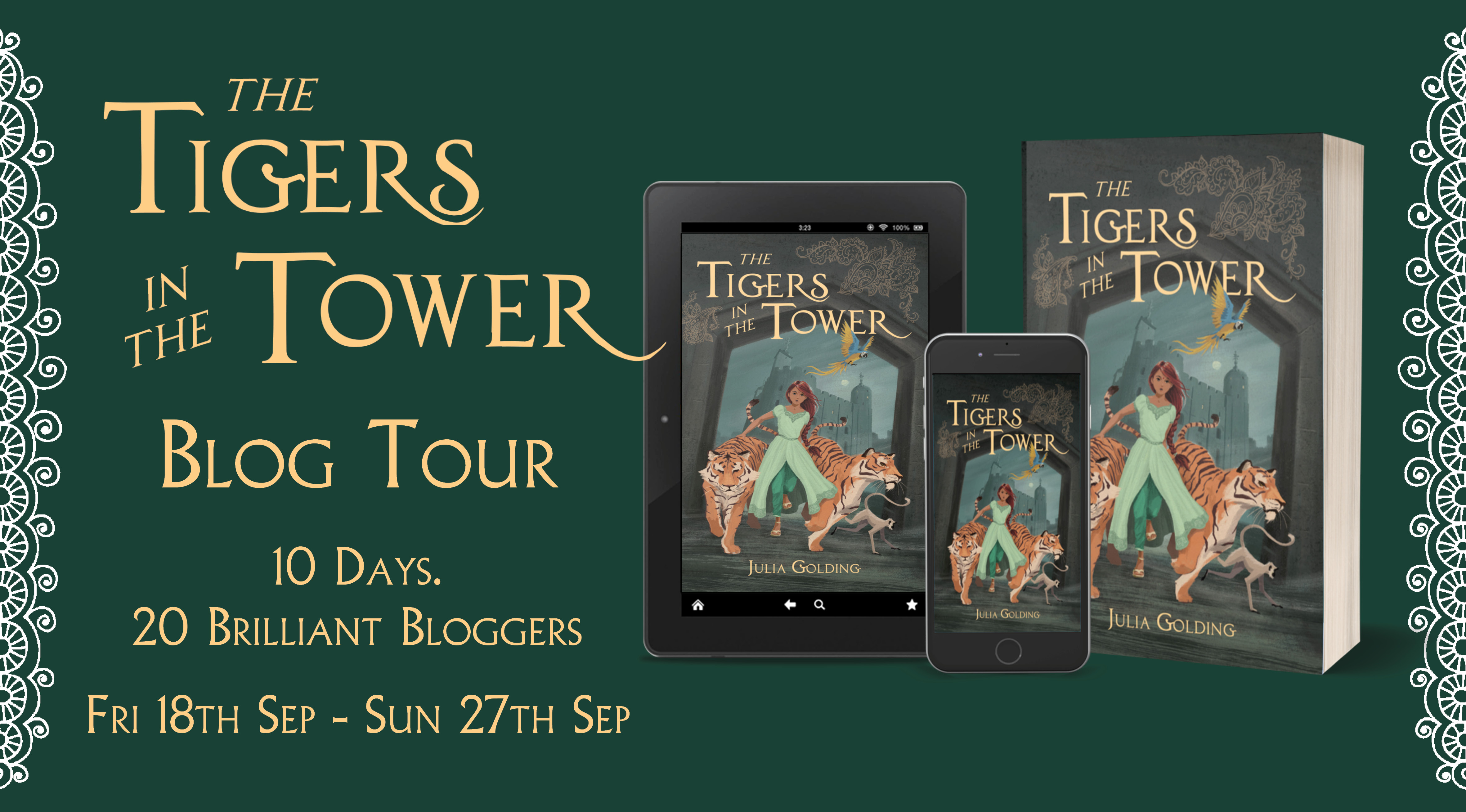
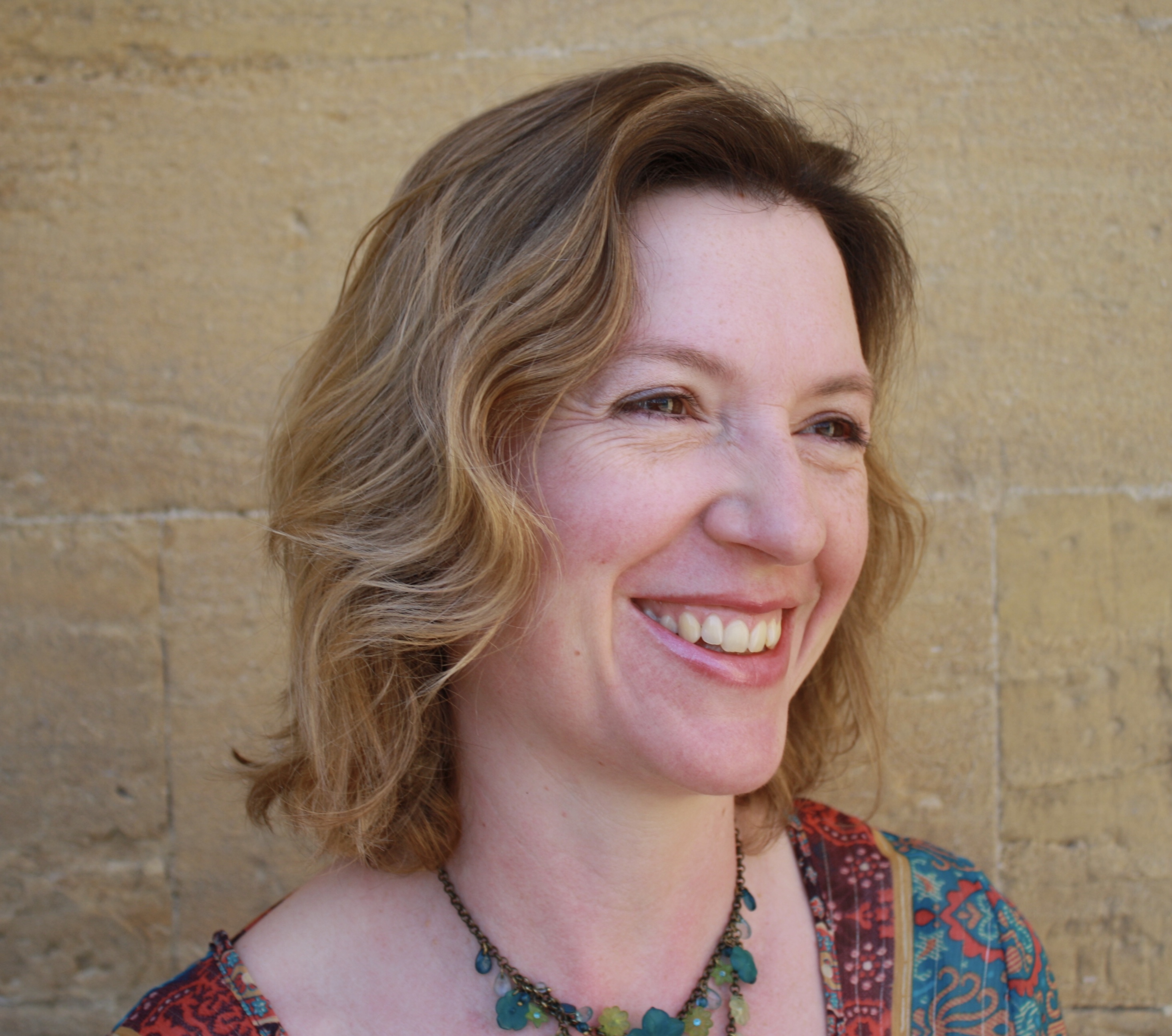
Today I’m delighted to welcome author Julia Golding to my blog. I absolutely loved her latest middle grade adventure, The Tigers in the Tower.
Get Kids into Books: What sparked your interest in historical fiction and why did you want to write about this particular aspect of British history?
Julia: Writing historical fiction has many of the same pleasures as fantasy. Once you’ve done your research and know enough about the world, you can time-travel back to that period and go on adventures. It’s no mistake that Dr Who travels in space and time!
The Tigers in the Tower is set in 1830 at the very end of the Georgian Period. I know a lot about this world as I did an English literature doctorate that covered the period of 1790 to 1830. What this really means is that I have a lot of stuff up in my mental attic that can be dusted off to upcycled into new things!
I’ve also been working more recently on the history of science (see The Curious Science Quest) and this led me to an interest in how animals were studied and treated in the nineteenth century. The story focuses on the menagerie in the Tower of London that had existed since medieval times but was reaching the end of its life as attitudes to animals changed and became more scientific.
I am also interested in understanding the diversity in British history that has often been left out of traditional curriculums so I wanted to make a girl from an Indian-British marriage my heroine –Sahira Clive. She comes from India at the time when the country was more or less run by the East India Company – it’s a fascinating part of British history with some traditional heroes, such as the Duke of Welllington, seeming to be more like villains. It’s good to see history from different perspectives and challenge the narratives we inherit.
Get Kids into Books: If you had to describe each of the characters in a couple of words, what would they be?
Julia:
- Sahira – bold, cultured and imaginative.
- Rama – princely tiger.
- Sita – beautiful tigress.
- Ned – streetwise, funny, loyal.
- Mr Cops, the Keeper of the King’s Lion – animal-lover, kind but with a bit of temper.
- Tommy Newton – one of the villainous twins, scheming, greedy, clever.
- Alf Newton – the other twin, wild but cowardly.
- Ann – sensible ally.
- Emily – aspiring actress, dreamer.
Get Kids into Books: What do you find usually comes to you first, the plot or the characters?
Julia: That varies book to book. In this case it was a location – the menagerie in the Tower of London. I started reading about the wild animal collectors of the nineteenth century and that led me to researching India and the British empire at the time. New animals were coming in from all over the world and no one had a clue how to look after them. This mixed with ideas about animals and evolution – the start of modern zoology. Once a promising story area begins to gather, you need a character to draw it all together so Sahira is my lightning rod bringing the tale to the ground.
Get Kids into Books: What is your writing environment like? Do you have props and objects to inspire you?
Julia: At the moment I’m writing at home because of COVID-19. My study is great – full of books. I’m lucky to have it to myself because I need a private area at home to lose myself in my writing. Before the pandemic though, I was fond of writing in cafes as I liked the alone among a crowd feeling. As for props, other than books, I have a cappuccino to get going. My computer rests on a desk topper which is a map of London – very useful for Tigers!
Get Kids into Books: What sort of research did you do for the book?
Julia: I read non-fiction works about the subjects that come up – India, animal collecting, the Duke of Wellington, Darwin and his predecessors in evolutionary theory etc. Particularly helpful were histories of London Zoo and the Tower of London. As for site visits, I already knew the Tower and London Zoo from previous visits but one of my publishers happens to have a great view across to the Tower so I could sit and have a bird’s eye view of the modern location and imagine how it was in the past. Old maps are also invaluable.
Get Kids into Books: What are you working on next?
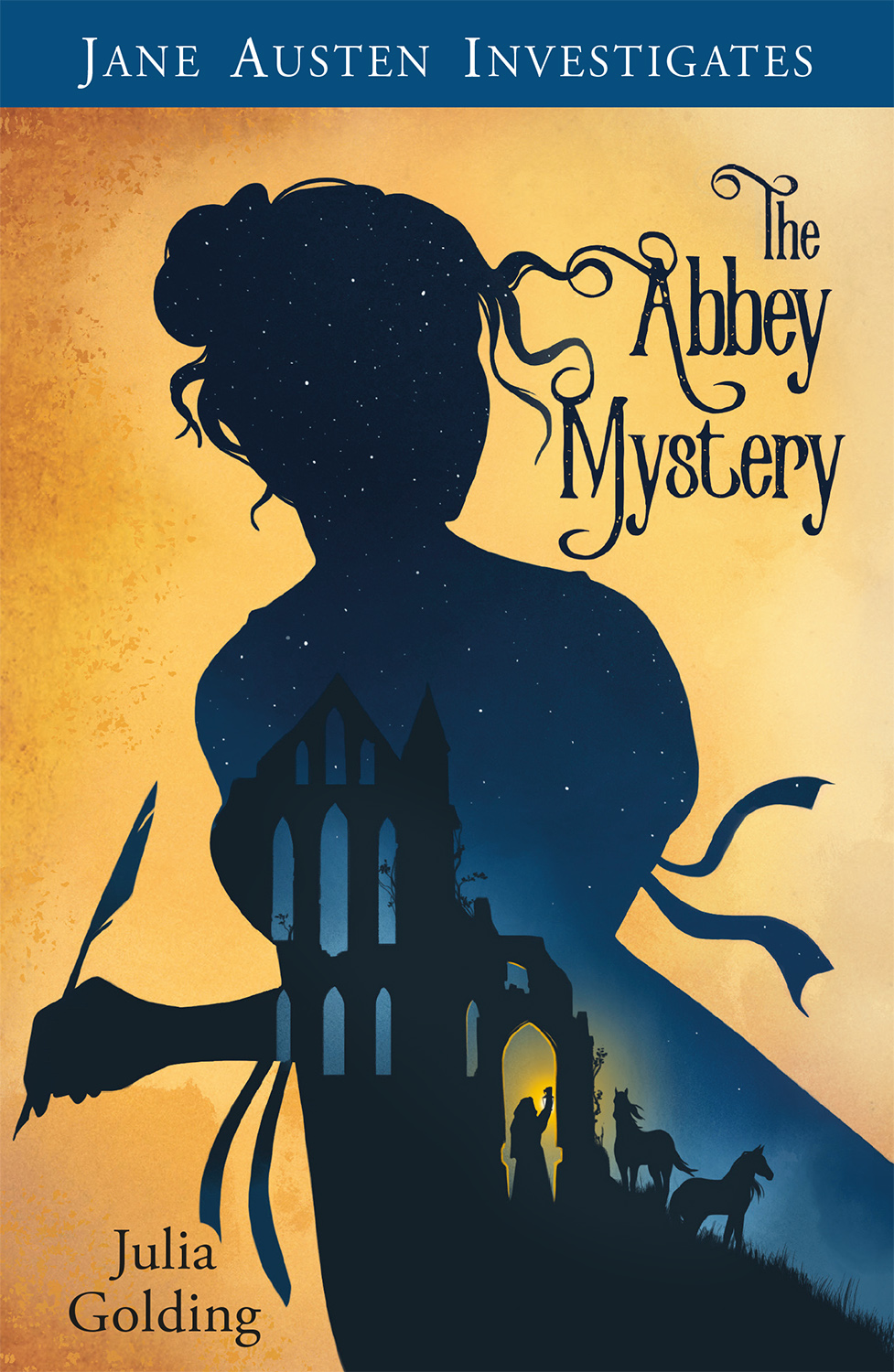 Julia: Writing The Tigers in the Tower reminded me how much I love writing historical fiction so my next project is an historical detective story. It is a real passion project because it features my favourite author as the detective. Did you ever wonder what Jane Austen got up to in the ‘quiet’ years of her early teens when we all think she was stuck in the rectory at Steventon? Such an inquisitive and observant child, mind spinning with ideas, must have had all sorts of adventures. This is my imagined version of that. I’ve left all kinds of Easter Eggs to find where those who know her books can see clues that might lead to her later novels – so it is a detective story within a detective story! The first part is The Abbey Mystery (out next spring) where she investigates a monk haunting Southmoor Abbey. All is not as it seems, and it takes a very curious girl to solve the crime.
Julia: Writing The Tigers in the Tower reminded me how much I love writing historical fiction so my next project is an historical detective story. It is a real passion project because it features my favourite author as the detective. Did you ever wonder what Jane Austen got up to in the ‘quiet’ years of her early teens when we all think she was stuck in the rectory at Steventon? Such an inquisitive and observant child, mind spinning with ideas, must have had all sorts of adventures. This is my imagined version of that. I’ve left all kinds of Easter Eggs to find where those who know her books can see clues that might lead to her later novels – so it is a detective story within a detective story! The first part is The Abbey Mystery (out next spring) where she investigates a monk haunting Southmoor Abbey. All is not as it seems, and it takes a very curious girl to solve the crime.
For more information please find me at my website www.goldinggateway.com or on social media Facebook and Twitter @jgoldingauthor
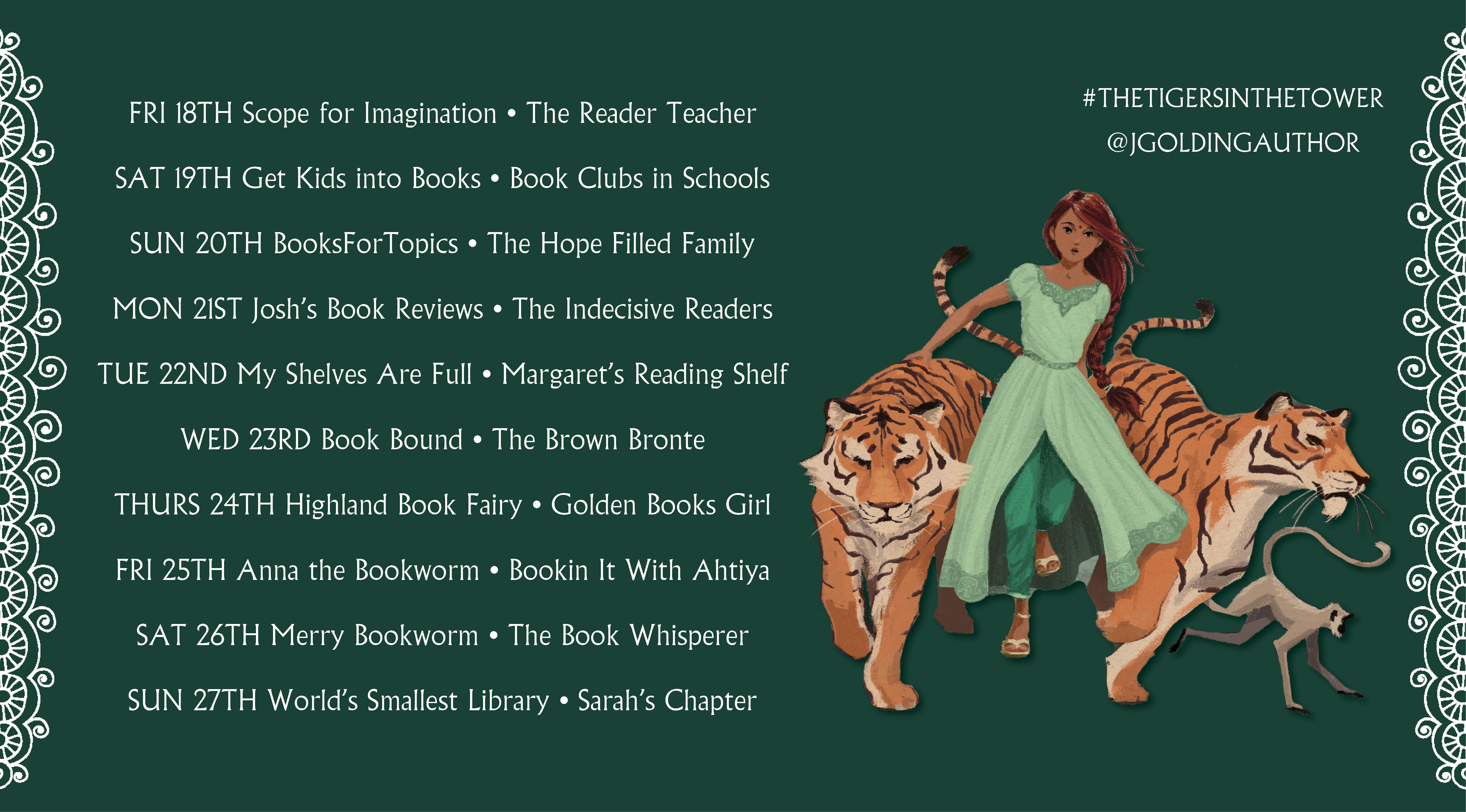
Little Bear and the Silver Star
Blog Tour, 17 September 2020
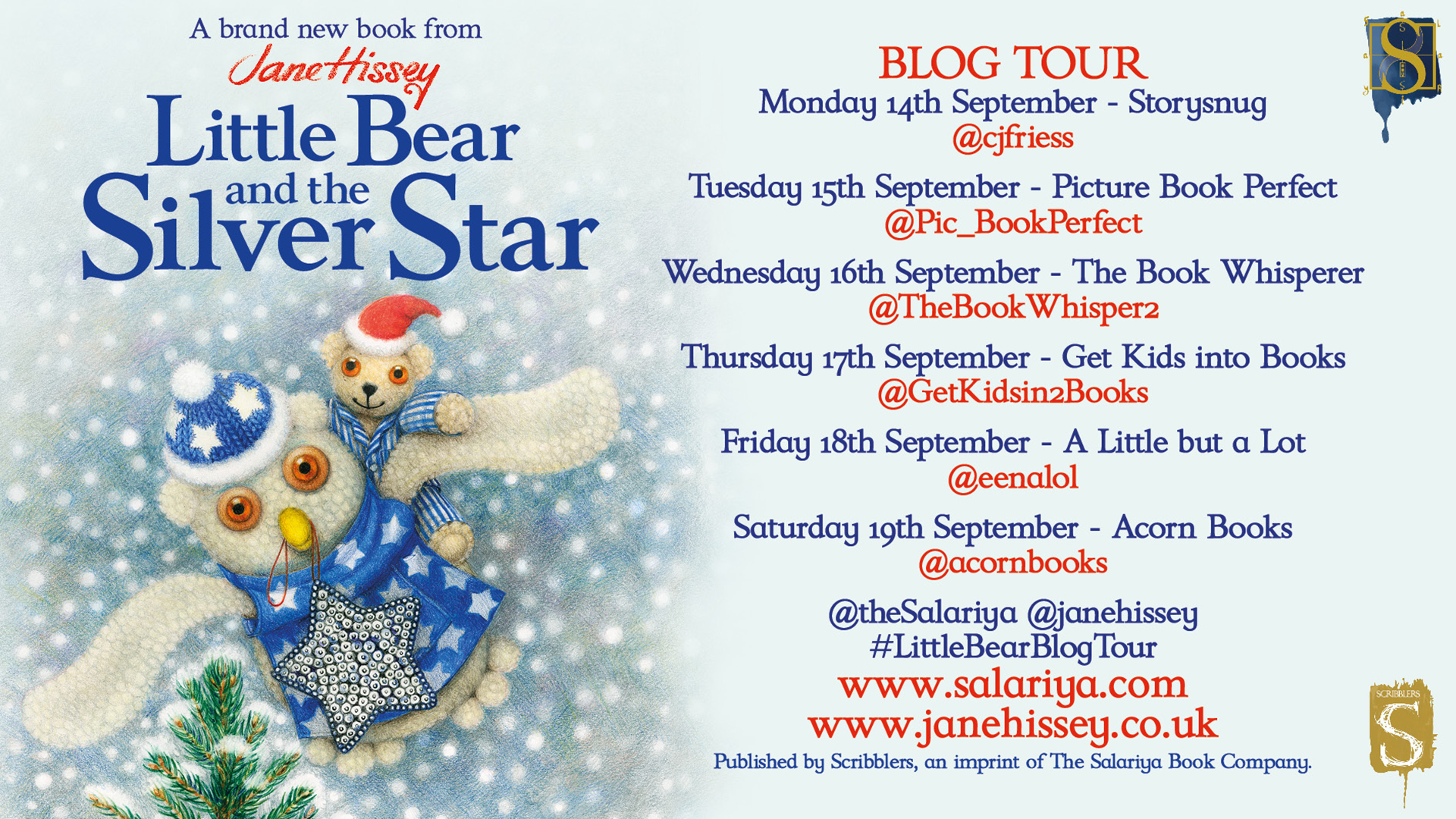
I’m delighted to welcome author/illustrator Jane Hissey to my blog today. She’s the creator of the beloved Old Bear books and her latest book in the series, Little Bear and the Christmas Star, publishes next month.
Get Kids into Books: Hi Jane, I’m really interested to learn more about your creative process. How do you move from your initial ideas to a finished book?
Jane: When I begin a new book, there is a moment when I have to stop procrastinating and just jump in! I have to drag myself away from weeding the gardening, baking yet another cake, phoning a friend or even cleaning out the kitchen drawers. I have to make myself grab a piece of paper and a pencil (any paper, any pencil!) and start drawing.
After writing the story, I find planning out the book (doing the rough sketches and making a dummy book) by far the hardest bit. This is probably because I normally work from ‘still life’; I set up the toys or objects and have them in front of me when I am drawing. Setting them up takes ages so I don’t really need to do that for the rough version but I find it hard to give the illustrations ‘life’ without having anything to look at.
So in the end I have the toys and objects around me to refer to, and, after counting the pages over and over again to make sure I have the right number of spreads to illustrate, I begin. And then the momentum of the book takes over and I have to work straight through ’til the dummy is complete. I often find long train journeys perfect for this stage; uninterrupted concentration and a time limit (arrival time!)
I have the images already in my head and have to get them down on paper so they look familiar and as I have imagined them ever since writing the story. The images below are the first rough, roughs for Little Bear and the Silver Star, my latest book.
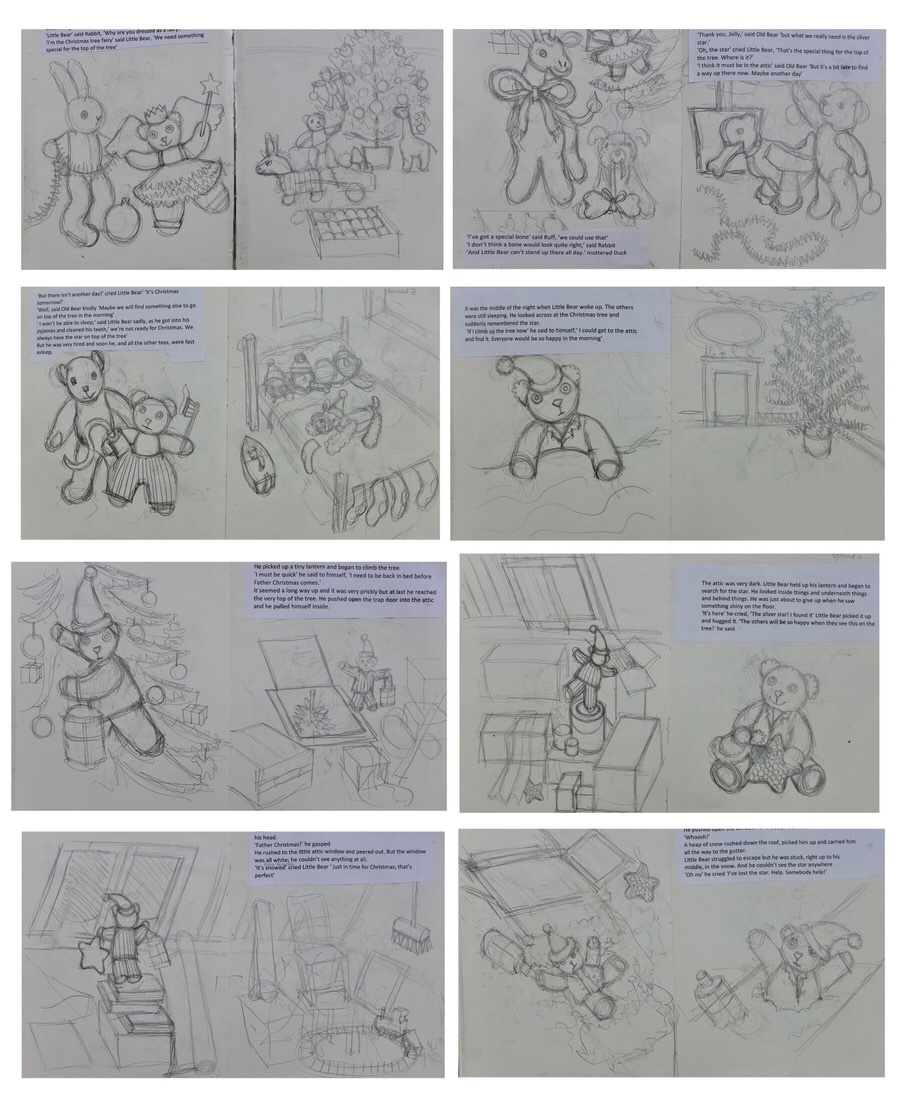 Once the dummy book is sketched out, I can then begin the bit I really enjoy: actually drawing the illustrations. And 9 months later (!) the book is complete.
Once the dummy book is sketched out, I can then begin the bit I really enjoy: actually drawing the illustrations. And 9 months later (!) the book is complete.
When I work on the final illustrations I find that, on the whole, I stick very closely to the initial scrappy, rough sketches. There is a life and vigour in those scribbly drawings that can easily be lost if I try and fiddle with them. Here is an example of how close the layout of my final illustration was to its very initial rough sketch.
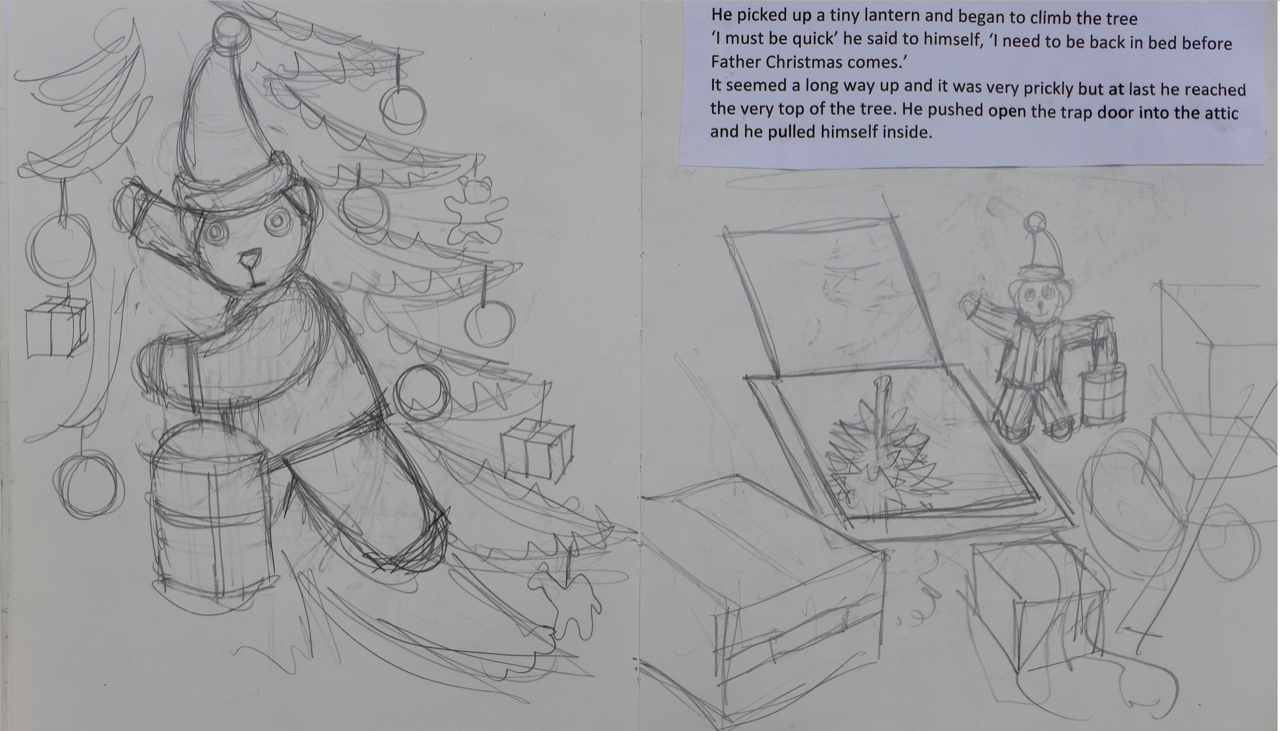
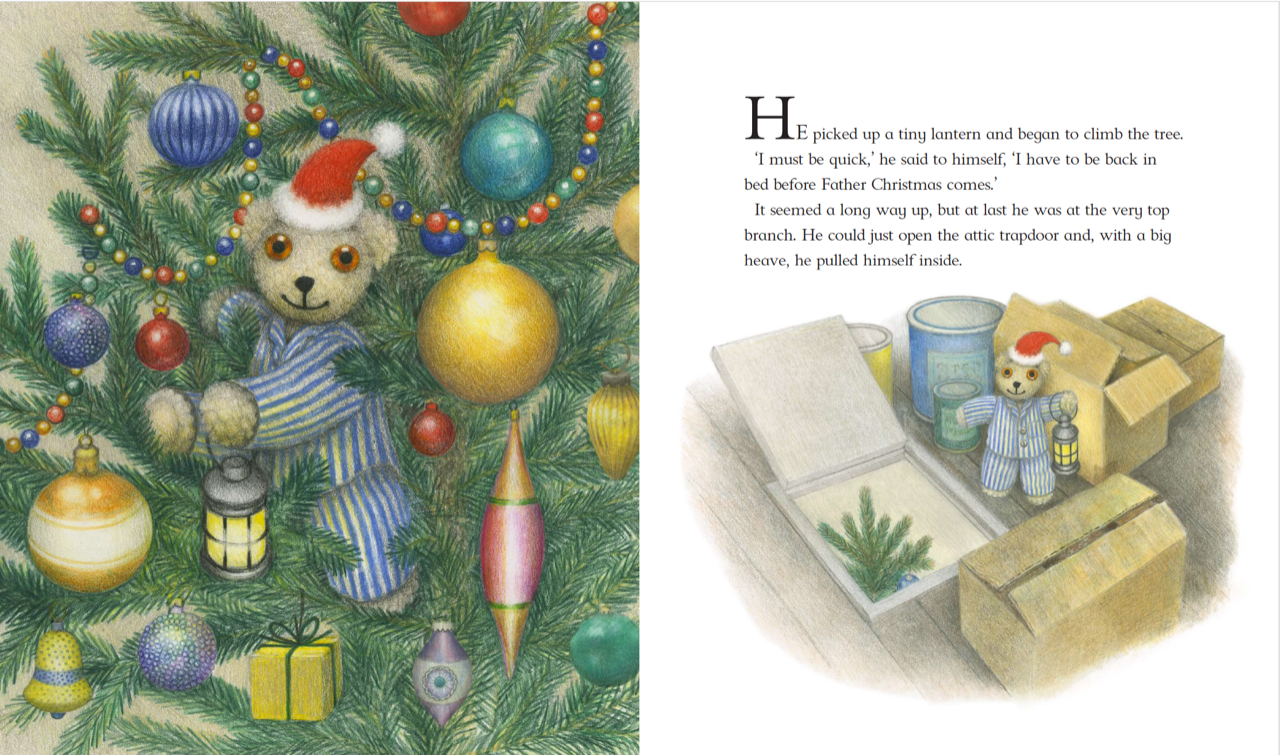
This year, with lockdown, I had the luxury of even more time to complete my illustrations. There were no school visits, no book fairs to create deadlines, no visitors and a very great need to do calming, peaceful and creative work. It was a bit lonely; there were no meetings to see how the book was going, no shopping trips to buy materials and no book shops to visit, but I did have some wonderful letters from children to remind me who my readers are and why I continue to write and illustrate picture books.
Get Kids into Books: Thank you Jane for this fascinating insight into how you work.
Mina Mistry Investigates Blog Tour
13 September 2020
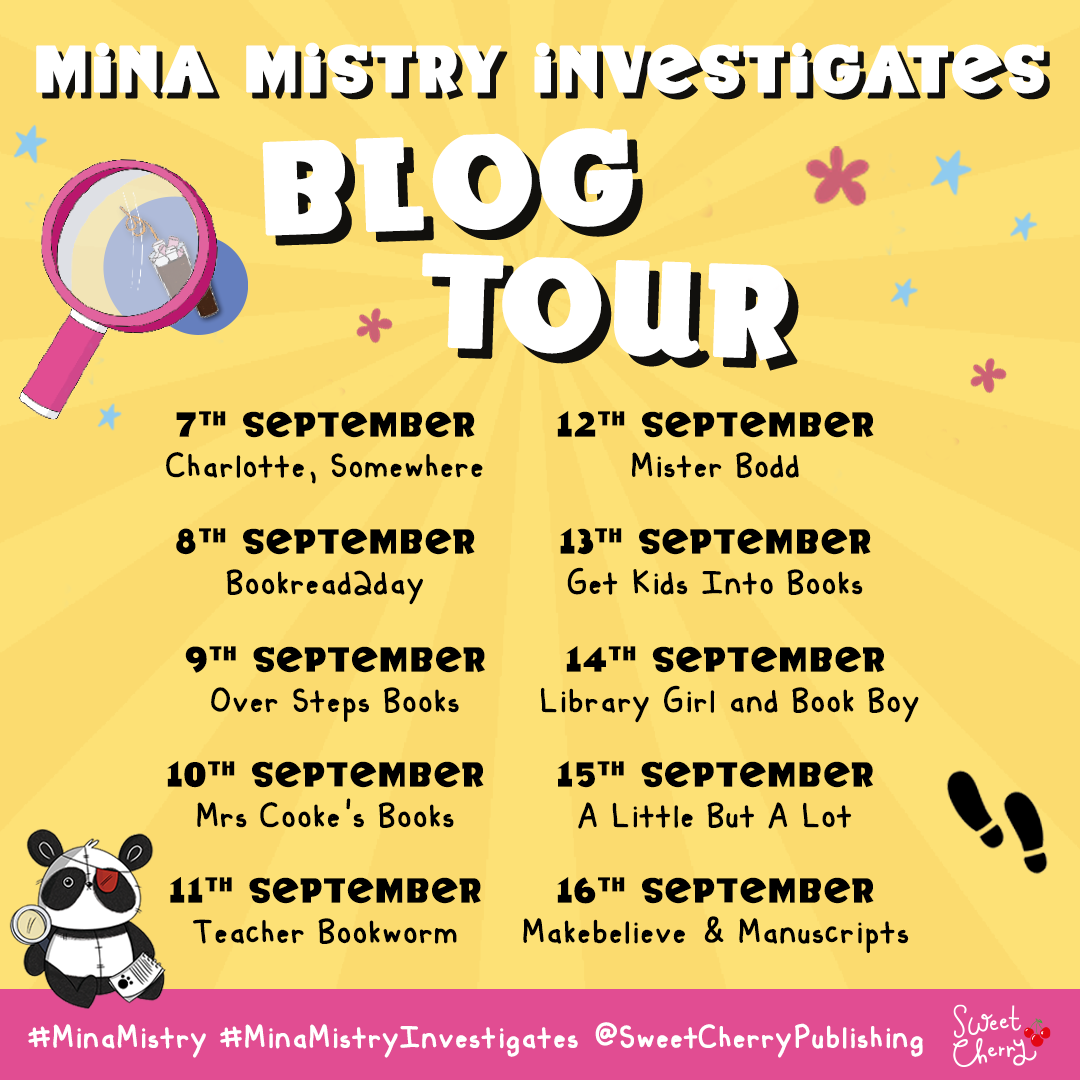
Mina Mistry Investigates, The Case of the Disgusting School Dinners is the first book in a new middle-grade detective series. Read my review here.
Oi Aardvark! Blog Tour
10 September 2020
I’m always super excited when another book publishes in the brilliant Oi Frog! series. Oi Aardvark! is a corker. It’s full of the trademark wit and hilarious illustrations that we’ve come to expect. This time, Frog has written a book – his Alphabetty Botty Book! It’s an alphabet book for animals he hasn’t told where to sit yet. Read my full review here.
To the Island Blog Tour
9 September 2020
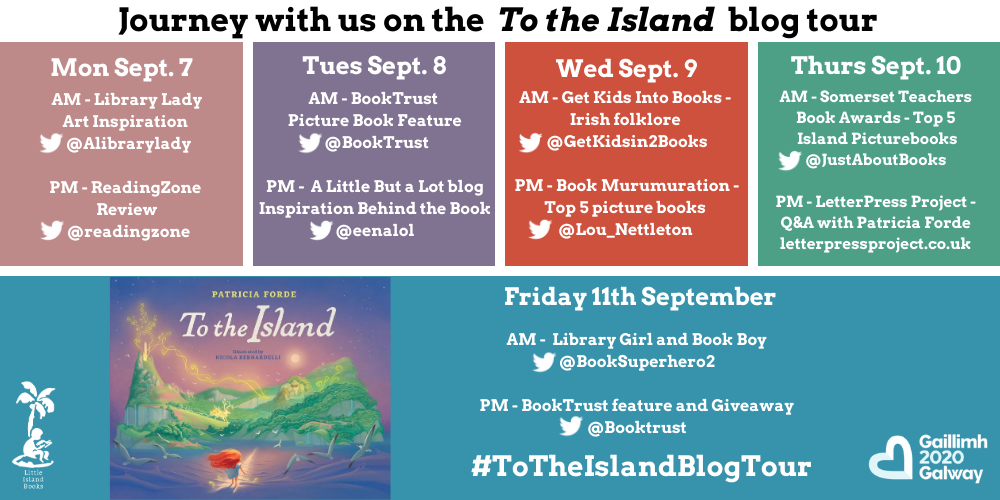
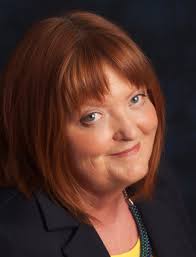 Today I’m delighted to welcome author Patricia Forde to my blog. She’s the author of To the Island, a magical picture book with strong roots in Irish folklore and mythology. Here she talks to me about the influences on her writing.
Today I’m delighted to welcome author Patricia Forde to my blog. She’s the author of To the Island, a magical picture book with strong roots in Irish folklore and mythology. Here she talks to me about the influences on her writing.
Patricia: I grew up in Market Street in the heart of Galway cityGalway is a medieval town, on the edge of the Atlantic Ocean, in the west of Ireland. Looking out across Galway Bay, the next parish to us, is America. It is a town that is steeped in history and mythology, and I was fascinated with stories all through my childhood. There were stories all around me. Our house, had once been owned by one of the fourteen tribes of Galway, who ruled the roost in the west from the 13th century to the 19th century. From our upstairs window, we looked down on a cobbled yard, where once the horses from Lynch’s castle, were exercised. From neighbouring Mayo, we had a famous pirate, called GráinneMhaol or Grace O’Malley, stalking the bay in the 14th century, and driving the British crazy attacking their fleets. Grace went on to meet Queen Elizabeth the First to complain, and after a conversation in Latin, Grace was sent home under the Queen’s protection. Oliver Cromwell, the bad boy of Irish history, sent his forces to lay siege to the place in the 17thcentury, and after many months of holding the line, the citizens were forced through starvation, and an outbreak of the Bubonic Plague, to surrender. Down in Kirwin’s Lane, where my sisters and I played hopscotch on summer evenings, was the home of Dick Martin (or Humanity Dick) who fought for animal rights, in the 19th century. On one famous occasion, we were told, he brought a donkey into court as a witness. Whether or which, he was responsible for the first prosecution for animal cruelty in the world.
Story upon story, history, legend and probably bare faced lies,have been handed down from generation to generation. Why? Because these stories ignite people’s imagination, and satisfy a craving to use a familiar pattern, to make sense of a world,that is mostly unknowable.
At around the age of ten, I went through a phase where I read a lot of folklore and mythology. I loved old maps of Galway,and Enid Blyton style, I was always hoping to find a secret passage, in our three hundred year old house.
I can’t remember when I first heard about Hy Brasil, but it feels like I’ve known that story all my life. Hy Brasil is an island that is said to appear off the west coast of Ireland every seven years. For the remainder of the time, it is shrouded in a mysterious mist, which conceals it from the eyes of mortals. What child would not be intrigued by that? I regularly went down to the Claddagh, to gaze out on the broad Atlantic, in the hope that one day, I would see this magical place. I can still remember that longing.
When Galway became European Capital of Culture in 2020, I was commissioned to write a Picture Book that would be given free to every child who started school in Galway in 2020. It was a great honour to be asked, and I wanted to make a book, that would say to those five year olds, that this is important. Books are important, stories are important, believing in something that you can’t always see is important, and most especially in this momentous year for Galway, children are important.
In Irish we say ó ghlún go glún (from one generation to the next) which literally means from one knee to the next knee. Hy Brasil has inspired generations of children to daydream, to imagine, to create. It has been passed on at the knee of a grandmother or a grandfather, a mother, a father, or a teacher.
I hope this book will do something to keep the magic of storyalive for another generation. I hope to see children queuing up at the Claddagh in the hope of getting a glimpse of a magical place shrouded in mist.
As long as they don’t block my view…
Get Kids into Books: Thank you Patricia for this fascinating insight.
You can read my review of To the Island here.
The Key to Finding Jack Blog Tour
6 September 2020
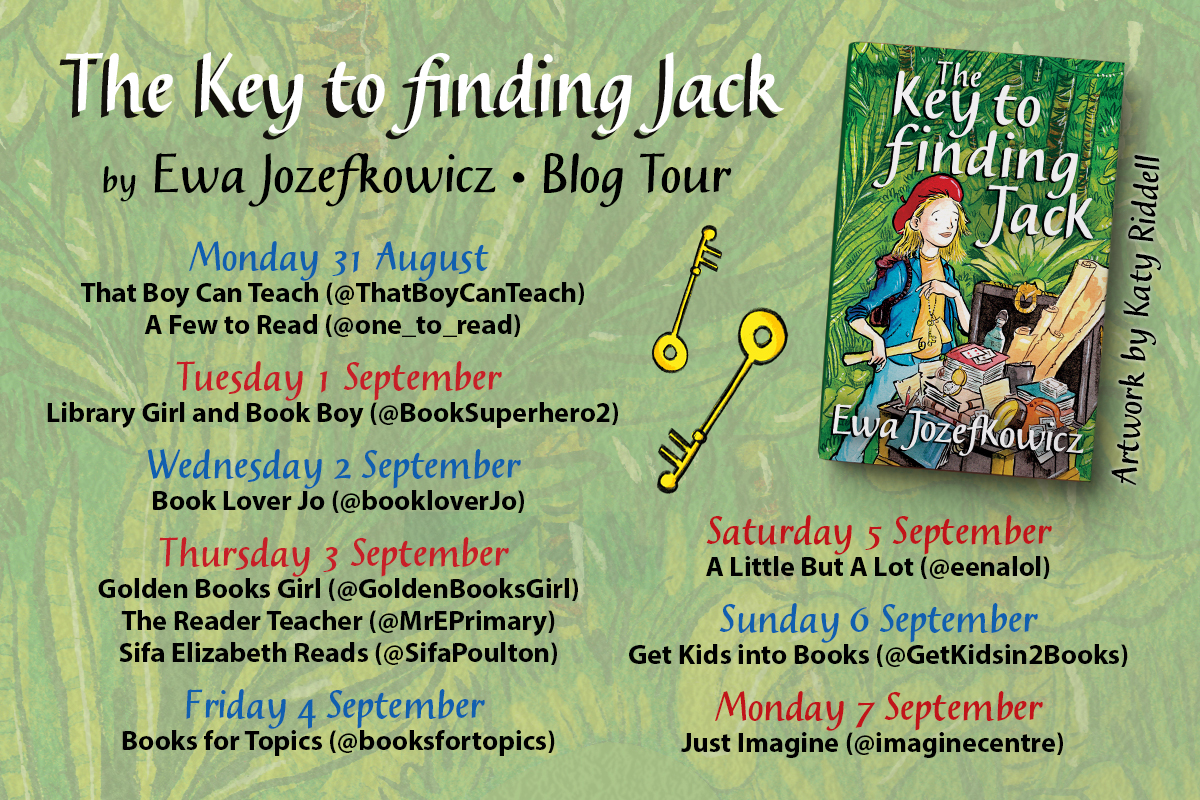
The Key to Finding Jack is a brilliant mystery story. It’s full of heart, with important messages about following your own path and being true to yourself. Read the rest of my review here.
Voyage of the Sparrowhawk Blog Tour
4 September 2020
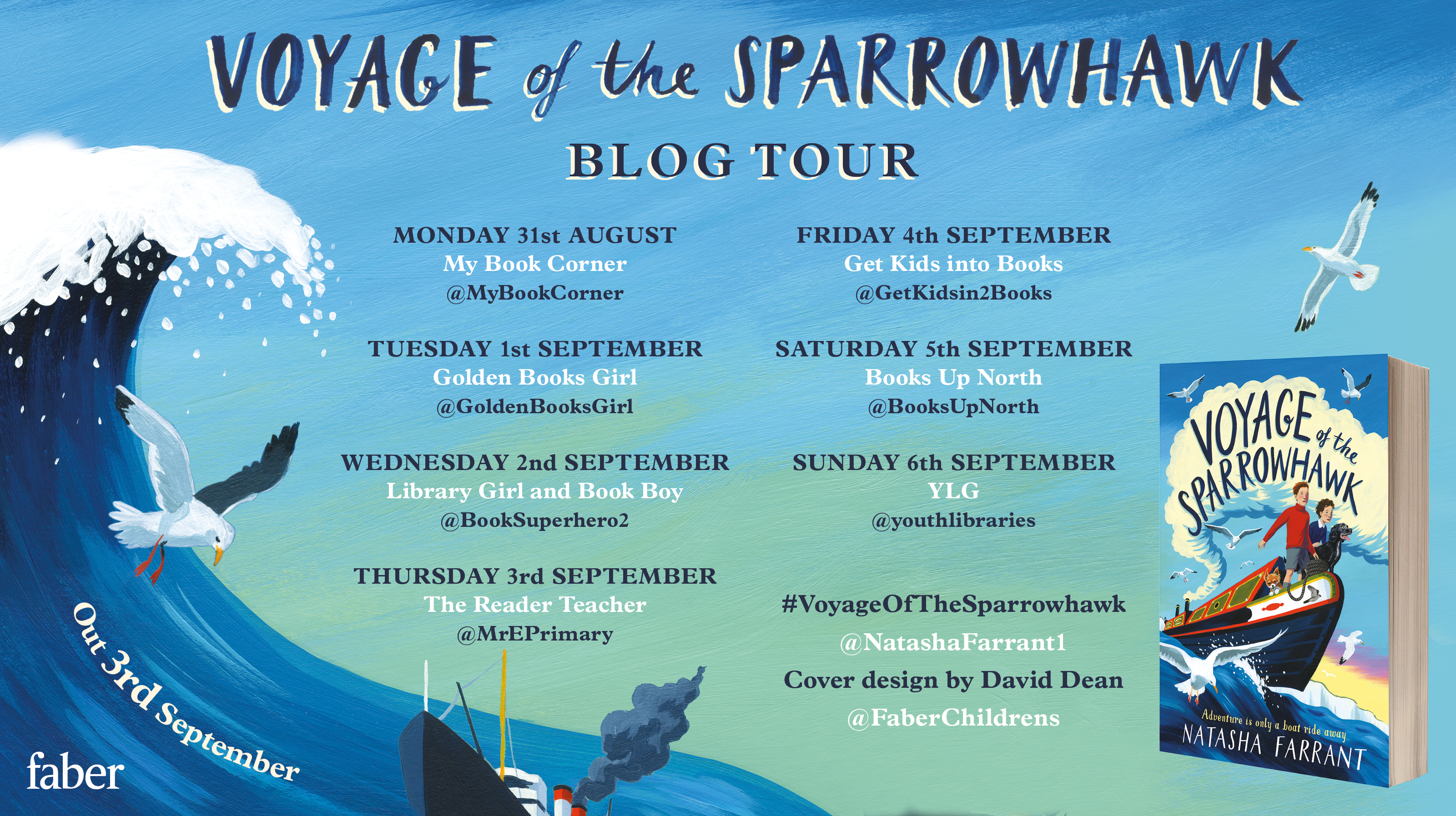
Voyage of the Sparrowhawk is a wonderful story of friendship and courage. I absolutely loved it! It’s the story of two plucky children, Lotti and Ben, who journey by narrow boat across the English Channel to France in search of lost loved-ones. It’s the adventure of a lifetime. Read the rest of my review here.
A Mummy Ate My Homework! Blog Tour
12 August 2020

A Mummy Ate My Homework! is an extremely funny book. It’s a time travel adventure story which sees 11-year-old Henry transported from his maths lesson back in time to Ancient Egypt. For my stop on the blog tour, I’m delighted to be able to share the opening chapters of the book. Click here to read them.
My full review of the book is here.
Moonchild Blog Tour
5 August 2020
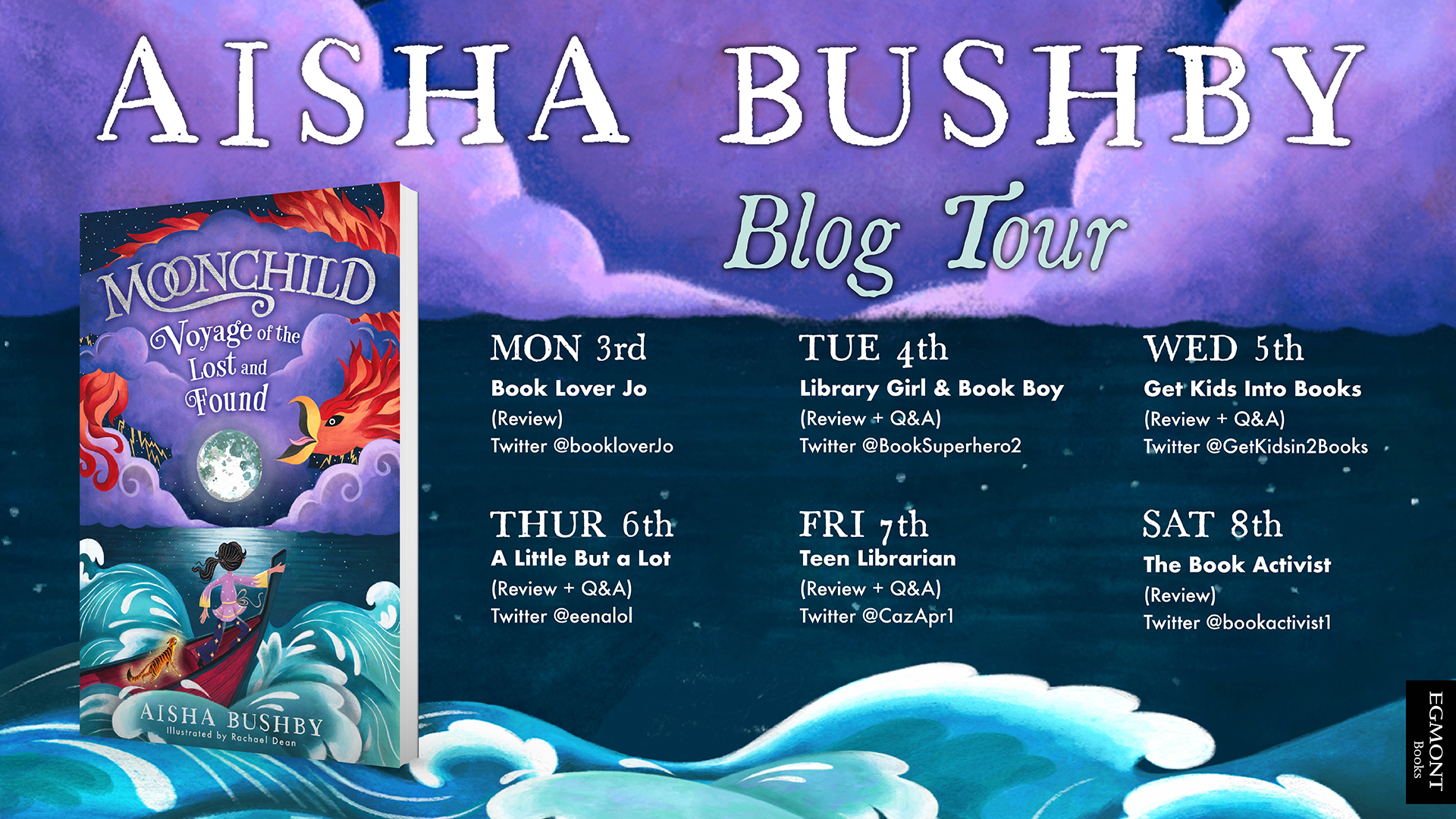
Today I’m delighted to welcome author Aisha Bushby to my blog. Her second book, Moonchild: Voyage of the Lost and Found, is a magical adventure story. I loved it! You can read my full review here.
 Can you talk about why you used The Arabian Nights as inspiration?
Can you talk about why you used The Arabian Nights as inspiration?
I had the idea of a story featuring sea witches with a cat on board a ship, but wanted to ground it in the middle east, where I was born, particularly because Kuwait (which features in A Pocketful of Stars) was originally a trade port.
Naturally, I started researching Arabian mythology, some of which I had heard about in different iterations growing up. This led me to The Arabian Nights.
I fell in love with the structure and knew I wanted to emulate it in my own way, and I borrowed from some of the legends – jinn, roc, and a spoiler I can’t mention.
If you had to describe each of the characters in a couple of words, what would they be?
Amira – angry and passionate
Leo – nervous, but brave
Jamila – headstrong and funny
Dunya – smart and focused
Farah – curious and thoughtful
What do you find usually comes to you first, the plot or the characters?
It’s a mixture, but I’m very theme driven. I knew my second book was going to be about emotions and what happens when we repress them, and I tried lots of different ways to write it (including a contemporary story, along the lines of A Pocketful of Stars). Setting and character combined came next, and finally plot.
What is your writing environment like? Do you have props and objects to inspire you?
My ideal environment, if I’m being totally honest, is tucked beneath blankets in the dark. Far from Instagram-worthy! That said I’ve written on trains and pretty much anywhere I can take my laptop.
What sort of research did you do for the book?
I researched into Arabian mythology, including The Arabian Nights for both plot and structure.I also did research into emotions, but applied the second law of ecology quite loosely to the mechanics of it, as well as old navigational tools which I added a magical touch to.
Your début novel, A Pocketful of Stars, was incredibly well received. Did you feel a lot of pressure writing your second book?
This is a very kind thing to say, thank you! I do feel a lot of pressure with this book, particularly as it’s a slight departure from A Pocketful of Stars, and the start of a series.
But all I can control is the writing side of it, so I need to let it go (as Elsa would) and hope people like it!
What are you working on next?
Book 2 in the Moonchild series, which I’m excited about. There’s a different character leading the story this time…
My Name is River Blog Tour
4 August 2020
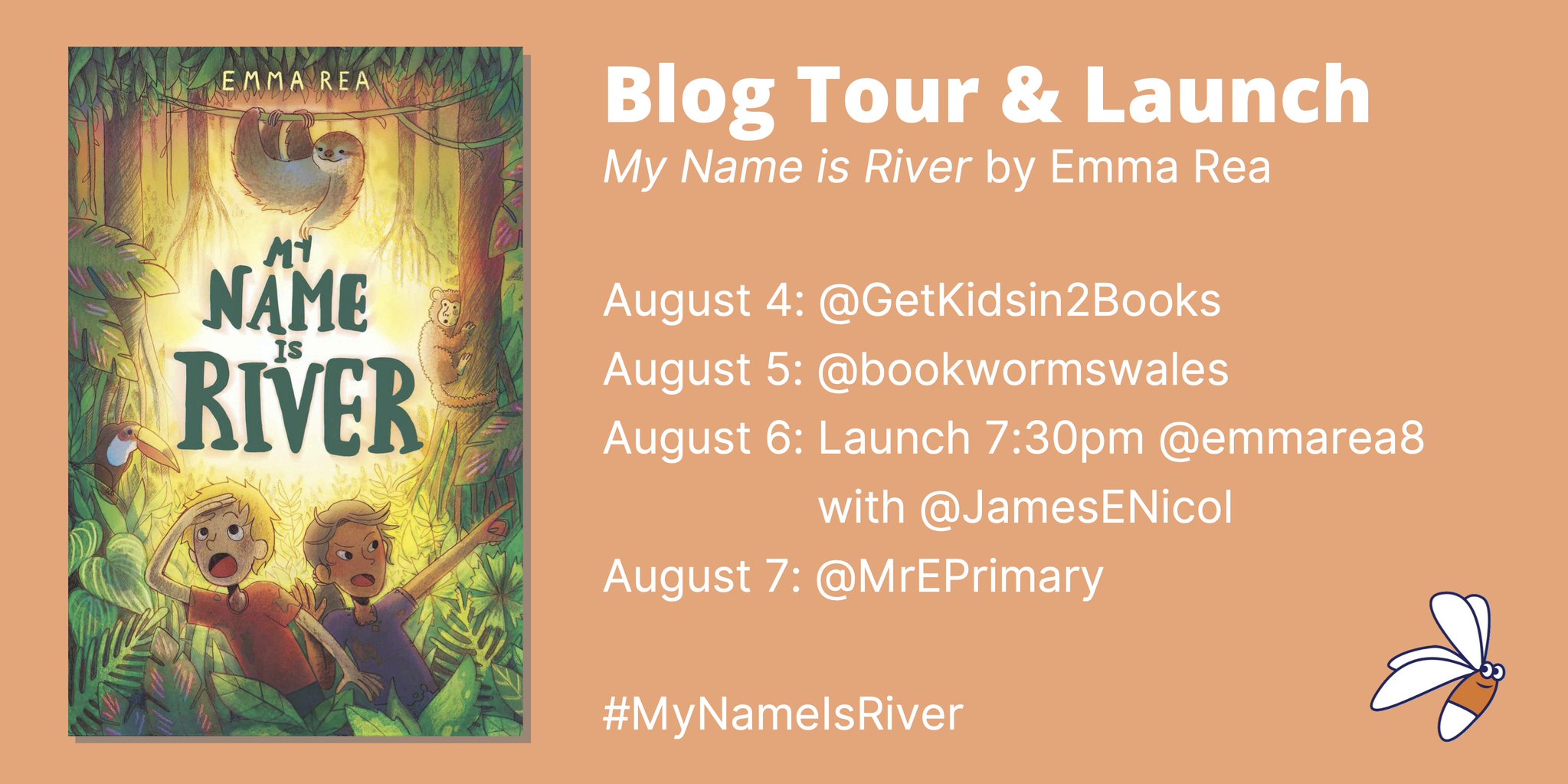
 Today I’m delighted to welcome author Emma Rea to my blog. I absolutely loved her exciting ecological adventure, My Name is River. You can read my full review here.
Today I’m delighted to welcome author Emma Rea to my blog. I absolutely loved her exciting ecological adventure, My Name is River. You can read my full review here.
Get Kids into Books: Can you talk about why you wanted to set part of the story in Wales?
Emma: My Name is River is the sequel to Top Dog (Gomer Press) and the reason they’re both set in Wales is because I have many happy memories there. I went on a road trip once with my Granny, back to Mumbles where she grew up, and about which she always told magical stories about people coming by on New Year’s Eve with a horse’s head (I was never told whether this was real, skeletal or fabric and I didn’t really want to know). I lived near Haverfordwest as a child and remember birthday parties on Broad Haven and Little Haven beaches, and when I had children we moved from London to Machynlleth for five years to give them the space and fresh air we couldn’t have given them in the city. I gave my children a richly rural setting to grow up in, and I wanted to give my characters the same. I thought I could use the rolling Welsh landscape and the relative freedom that rural children have to create stories that might open children’s minds and take them beyond the confines of their homes.
Get Kids into Books: Why do you think it’s important to write children’s books with ecological themes?
Emma: If children have been entranced – however briefly – by sloths, pink dolphins, howler monkeys, jungles, huge rivers and fantastical trees, I think there’s a chance they might care about looking after the planet when they’re in a position to make choices. I wanted to write a realistic adventure so that children could imagine themselves getting to the other side of the world, and feel completely immersed in the Amazon rainforest, the smells, sounds, colours. But it’s also well known that time spent in natural surroundings is hugely beneficial for mental health, so I was keen to write characters who spend a great deal oftime outside and have plans such as building a treehouse, or a bike track, in the hope that subliminally, my readers might want to do the same. I heard of three kids who built bike tracks after Top Dog was published, so maybe the treehouse idea – or some sort of den – in My Name is River will catch on, too!
Get Kids into Books: If you had to describe each of the characters in a couple of words, what would they be?
Emma: That’s easy! My hero Dylan has an unusual power – he can see what flows in people’s veins. He gets a strong sense of people straight off, and this helps him work out who to trust – which is an important aspect of life that middle-grade readers have to navigate. So: Floyd – blue ice, Lucia – dark molasses, Mac – minestrone soup, Anton –sour cream. Dylan – well, he doesn’t know the answer to this until the last page, so I can’t possibly give it away here.
Get Kids into Books: What do you find usually comes to you first, the plot or the characters?
Emma: A tricky one because they are so entwined. If different characters were placed in the same situation, you would have a different plot, because no two people will behave in exactly the same way. But I have a stronger feel for character, so I write a ‘discovery draft’ where my main characters go to various places and do various things without very strong reasons, then I rewrite, creating sound reasons to fit around the characters. Plotting is hard work and my brain does somersaults trying to work out why everything has happened. One trick is to write the story with all the convenient coincidences you like, then go back and really nail why these things happened, and why they were not coincidences at all, but part of some character’s master plan. Minor (or bad) characters with their own agendas are great for this.
Get Kids into Books: What is your writing environment like? Do you have props and objects to inspire you?
Emma: I write at home on a laptop, on the sofa with my legs up, partly because my arms hurt when I type at a desk, partly because this position makes me feel as if I’m not working, but playing. It feels like time off – a secret guilty pleasure, rather than a JOB which has to be done. I get more written if I trick myself into thinking I’m not working. I wouldn’t want a study. I have a pencil sharpener in the shape of an aeroplane to inspire me, which my son gave me before I was published, to help my writing take off. And I have a strange piece of shell, which I bought thinking was a marlin spike because my dad always said ‘every finger a marlin spike’ (always) and it reminds me of him. However, I looked it up recently and the shell has got nothing to do with a marlin spike at all. Never mind.
Get Kids into Books: What sort of research did you do for the book?
Emma: I was lucky enough to make a trip to Brazil, to stay in a lodge right up the Amazon river, in the Mamiraua Conservation Reserve. Here I learnt about how the people live, hunt, fish and communicate over distance. I was also taken to one of the poor communities in Salvador by a guide who had grown up there, and I asked him about my idea for Lucia, a resourceful homeless girl. He told me about Carolina de Jesus’s book, Child of the Dark, written in the 1950s, an autobiography by a woman who scavenged scrap paper to sell to feed her children. She also wrote her observations of the community on these scraps, and was published and made enough money to move out of her shelter in the community and buy a house.
Get Kids into Books: What are you working on next?
Emma: I’m writing a story about Thomas, an accident-prone boy who accidentally wins an art trip to Venice, where he will make a mask and take part in the Carnival. He comes from Aberdovey and loathes the sea, so of course he has to fall into a Venetian canal, in February. You have to make your heroes suffer! It’s a caper – two girls have been kidnapped and he goes off intent on rescue, only to be very much rescued straight back.
Spaghetti Hunters Blog Tour
22 July 2020
You can read my review of this funny new picture book by clicking here. Download some terrific activity sheets linked to Morag’s books here. Pop over to my Instagram account to enter a giveaway to win a copy of the book.
The Sky Pirates Blog Tour
20 July 2020
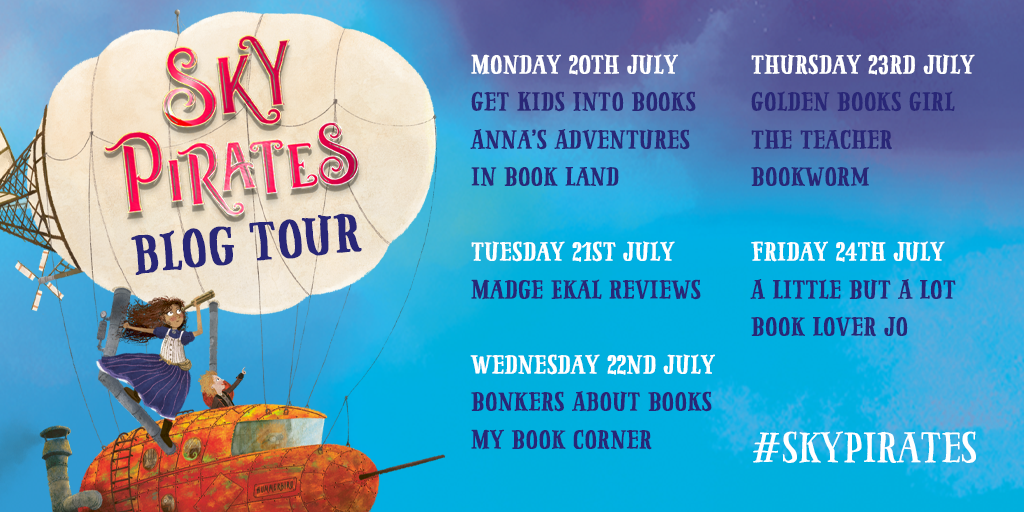
 I’m delighted to welcome Sky Pirates author Alex English to my blog today to talk about the transition from picture books to middle grade.
I’m delighted to welcome Sky Pirates author Alex English to my blog today to talk about the transition from picture books to middle grade.
Alex: Although my first books to be published were picture books, I always wanted to write middle grade fiction. There’s something very special about books for this age group – they’re full of the sort of big-hearted, epic adventures that I love. But, although I’ve been working on stories for both pre-schoolers and 9-12s for several years, I got a bit lucky with my first picture book and it’s taken me a lot longer to get my middle grade fiction published!
Writing picture books is very different to writing middle grade in a lot of ways. A good picture book is a snappy 500-words or so, whereas Sky Pirates: Echo Quickthorn and the Great Beyond is over 65,000 words. Middle grade needs you to sit at your desk for the long haul, while picture books are more concept driven and rhyming picture books can be more like putting together a puzzle.
While picture books are very different beasts to middle grade, writing them has taught me many useful things that apply equally well to both forms. Picture books have to be very tightly plotted. You have only around 12 double-page spreads to work with, so your story can’t run over and has to have a complete beginning-middle-end within a tiny word count. Plotting picture books definitely helped me to plot Sky Pirates. It’s exactly the same principle, just on a larger scale.
Another crucial part of a picture book text is the page turn, where tension builds and surprises are revealed as a parent turns the page. The equivalent in middle grade is a snappy chapter end. I love a cliffhanger and I try to make sure my chapters end with questions that leave children wanting to read on.
Another way I try to capture children’s imaginations is by making my writing vivid. Although I don’t illustrate, by writing picture book texts I’ve had to learn to be a visual writer. Each of those 12 spreads needs to look different from the last and a great picture book text will give the illustrator lots of scope to have fun. I’ve tried to carry this over into my middle grade work too, and I make sure there are several cinematic ‘set piece’ action scenes in every part of the story. I’m lucky enough to have Mark Chambers illustrating the series and he has done a brilliant job at bringing the world to life.
A final and maybe less obvious connection between my picture books and middle grade is my use of rhyme. I write many of my picture books in verse, and although it’s not a huge part of Sky Pirates, I do like to slip in the odd rhyming prophecy, or a funny little song for Professor Daggerwing to sing.
l find writing one type of book can act as a refresher when I’ve been working hard on the other sort for a while. I plan to continue writing both types for as long as I’m allowed!
Get Kids into Books: Thanks Alex, for this fascinating insight into your writing.
You can read my review of Sky Pirates, Echo Quickthorn and the Great Beyond here.
I Can Catch a Monster Blog Tour
16 July 2020
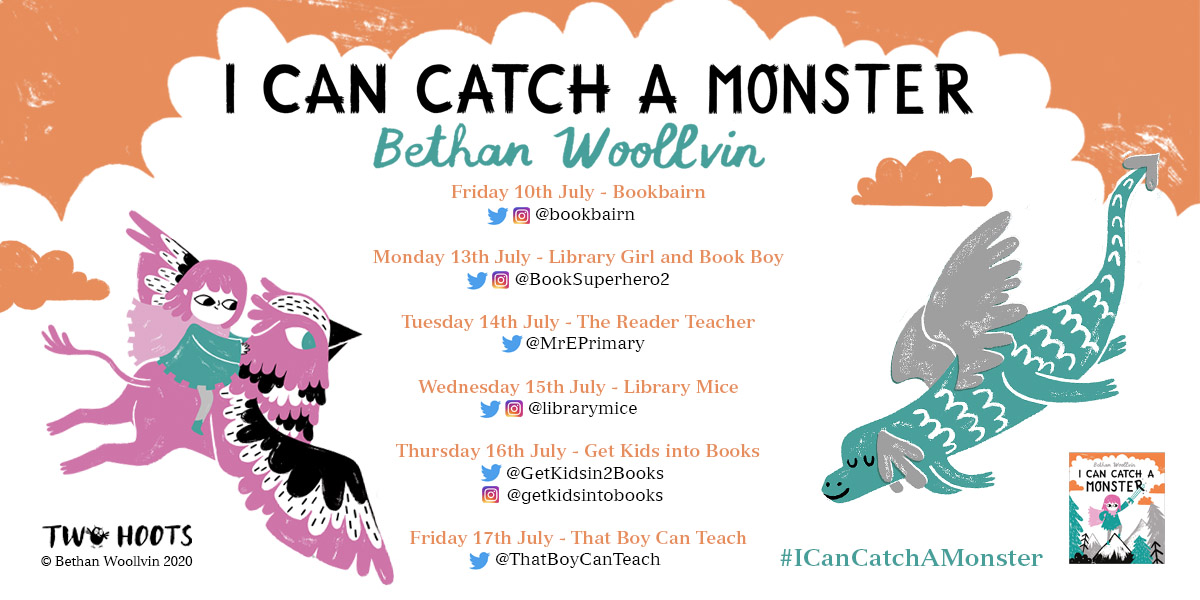
Bethan Woollvin has done it again! With her new picture book I Can Catch a Monster she’s given us another brilliantly feisty, rebel girl lead character – Bo the Brave. I’m really excited to be able to share Bethan’s step-by-step instructions showing you how to draw Bo. What are you waiting for? Grab your pens and some paper and draw along with Bethan!
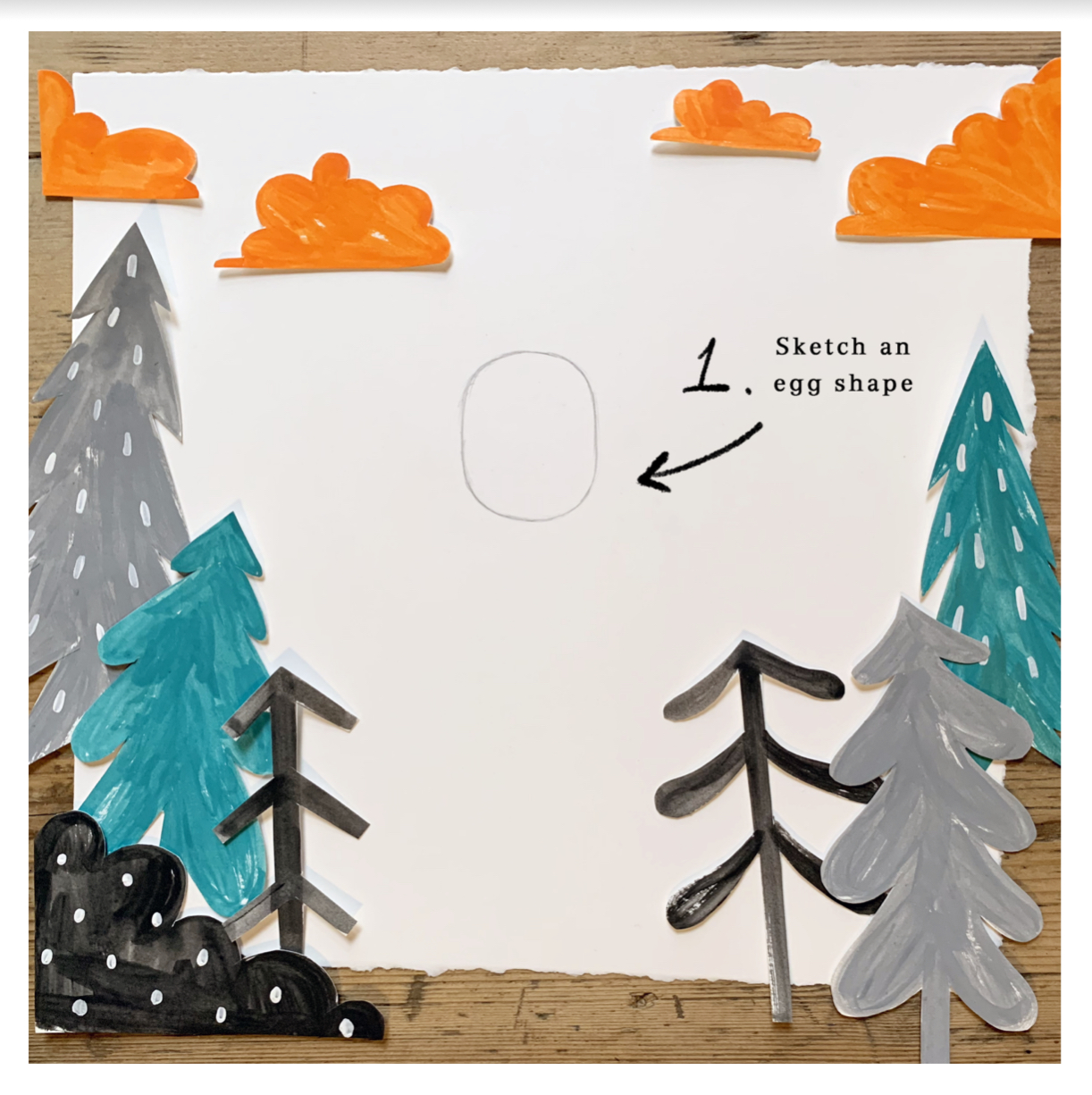

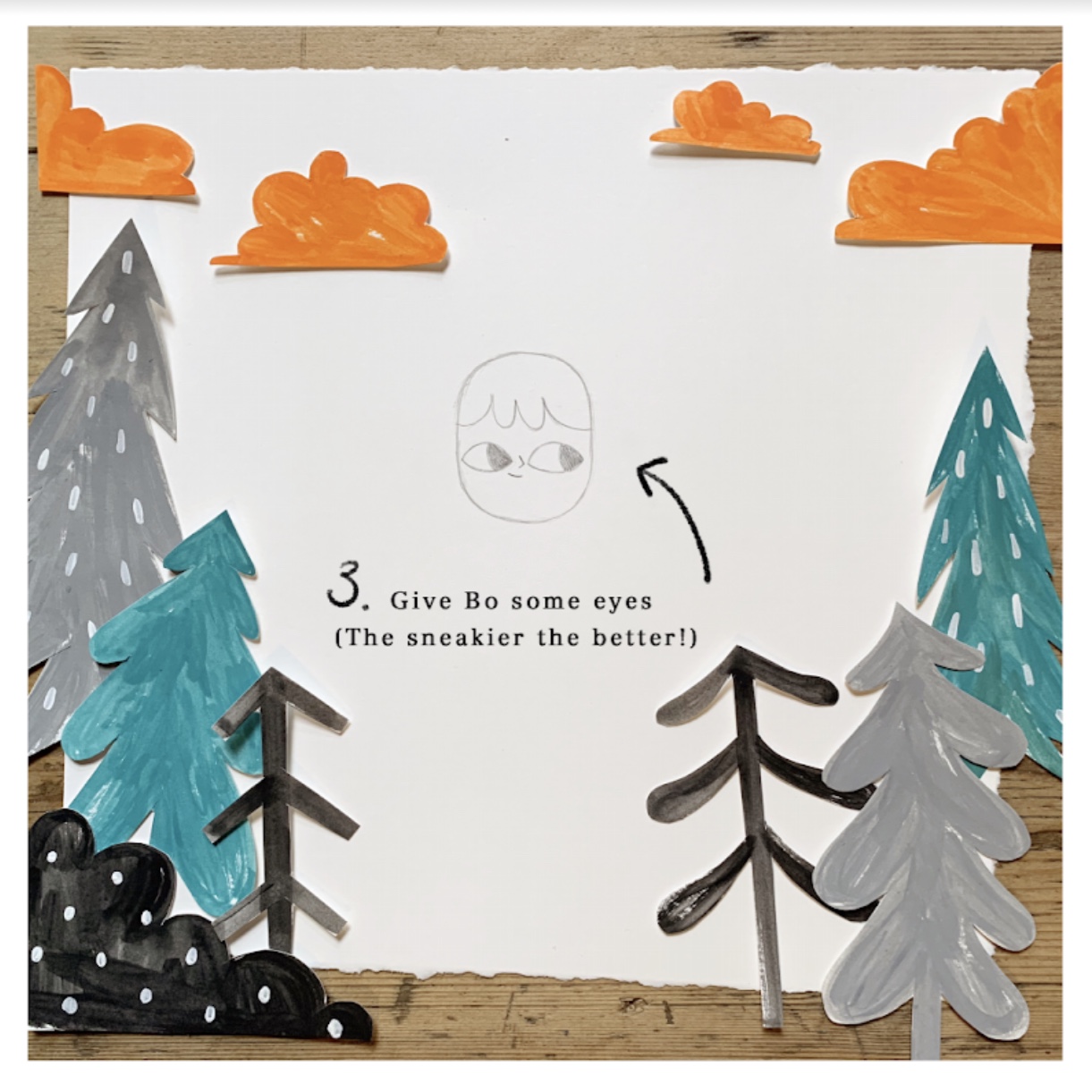
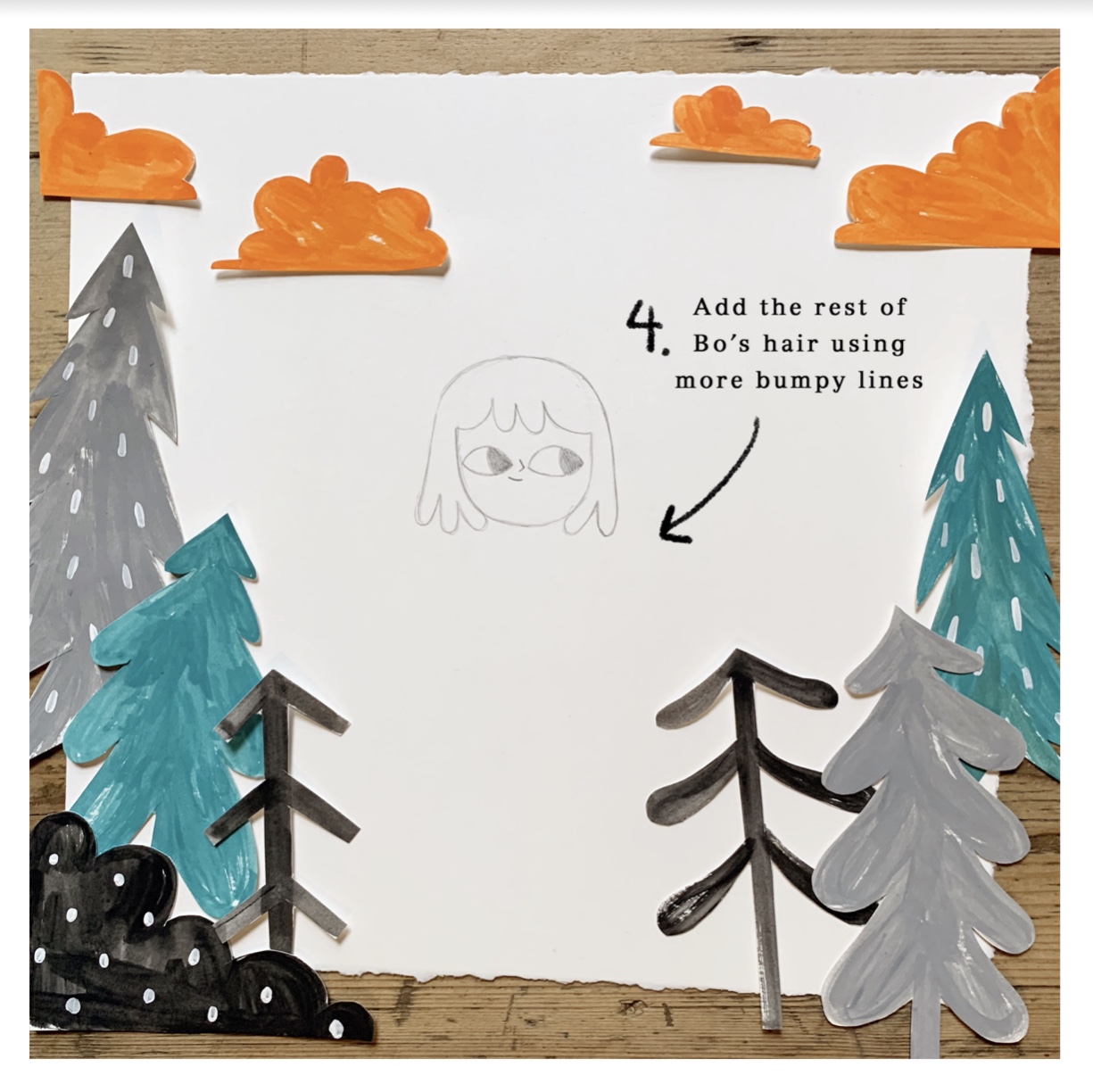
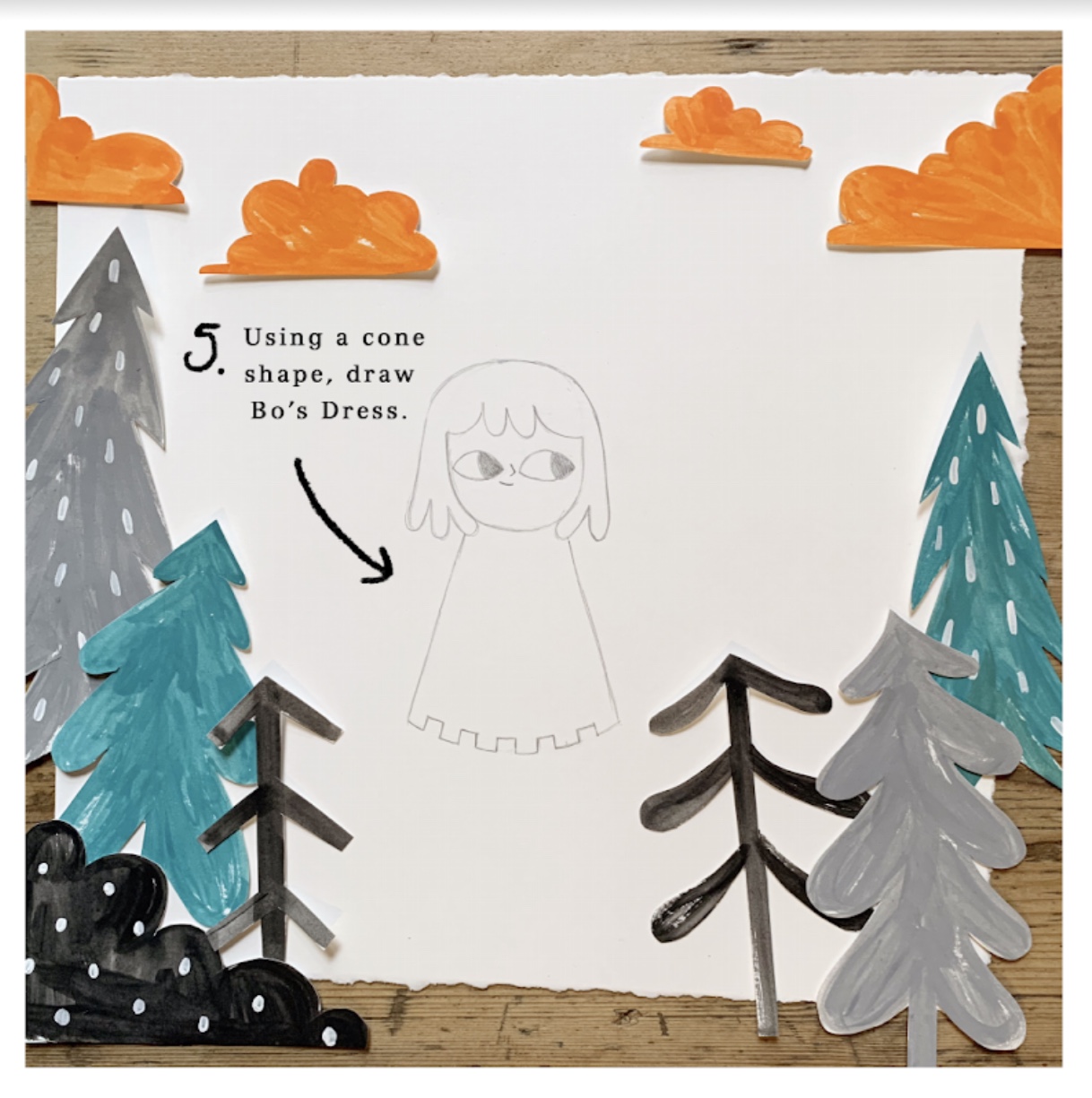

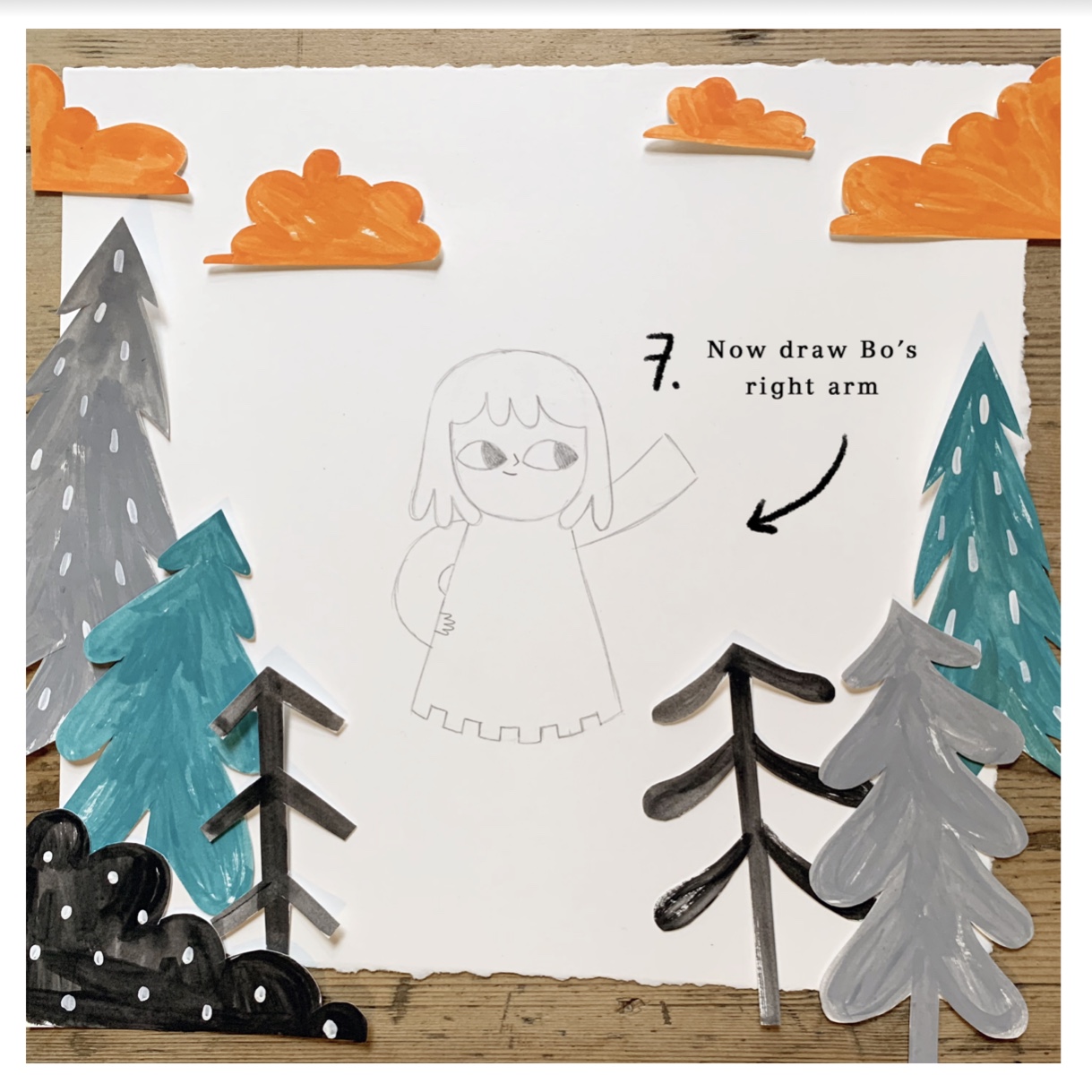
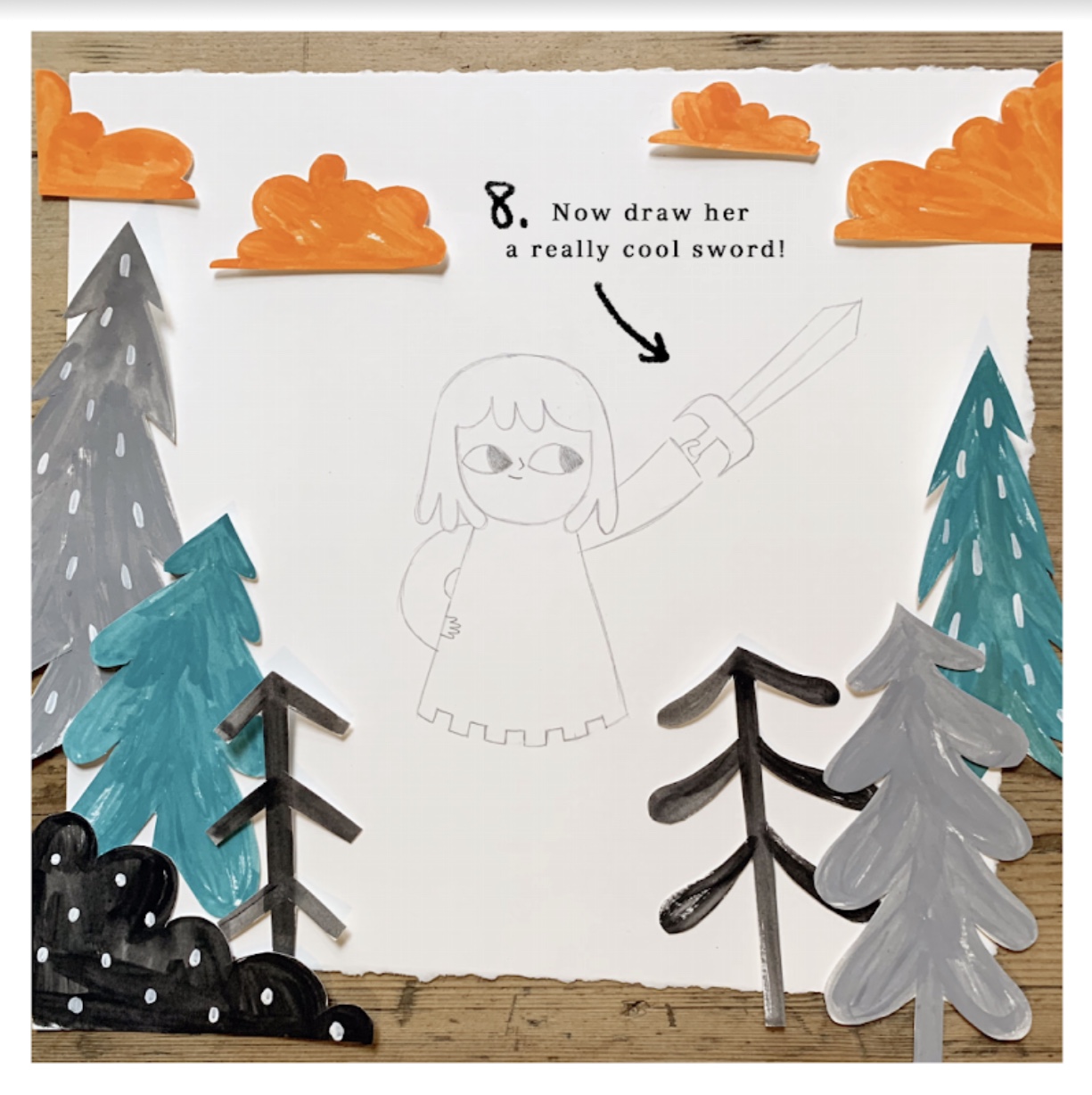
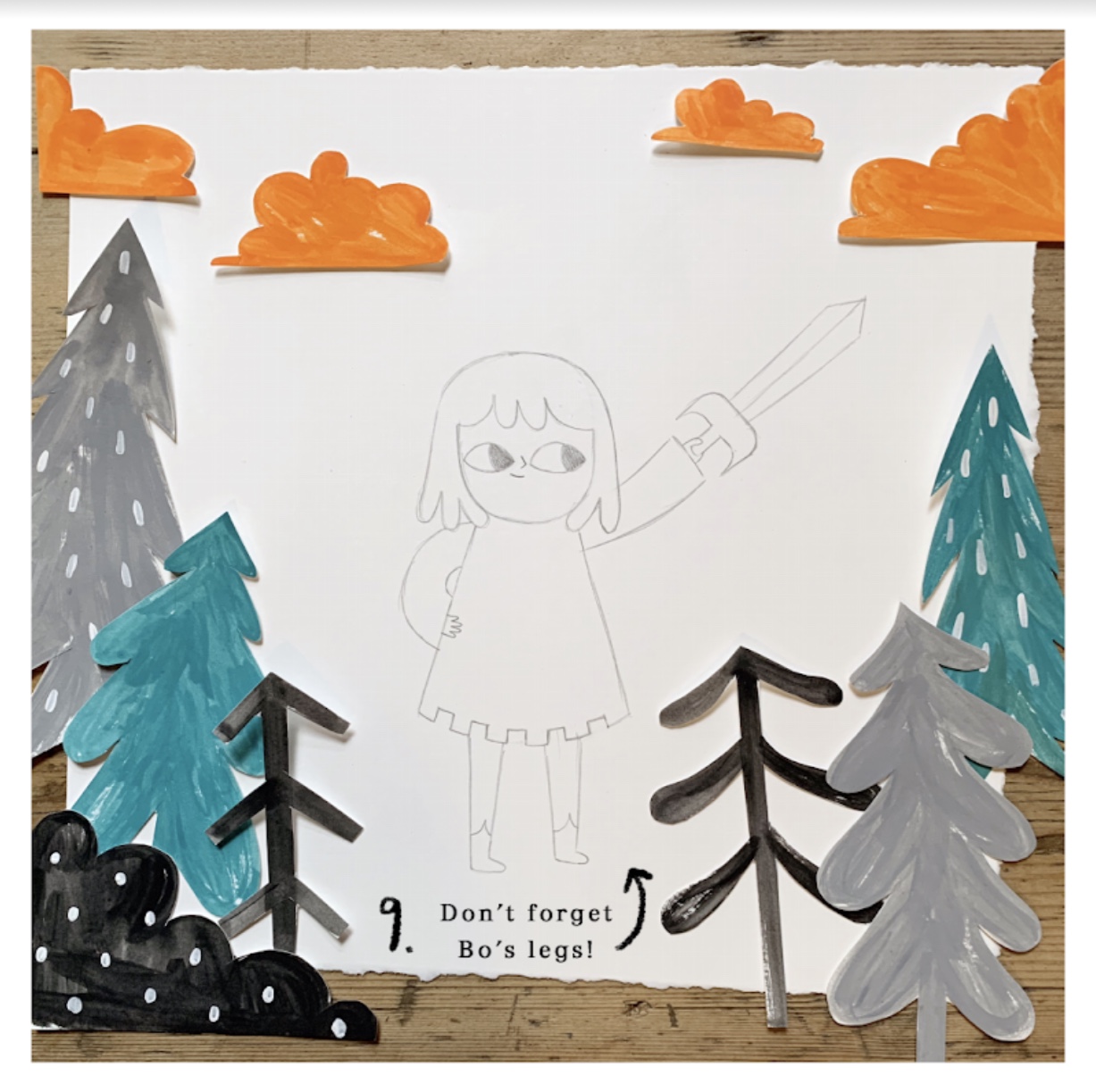

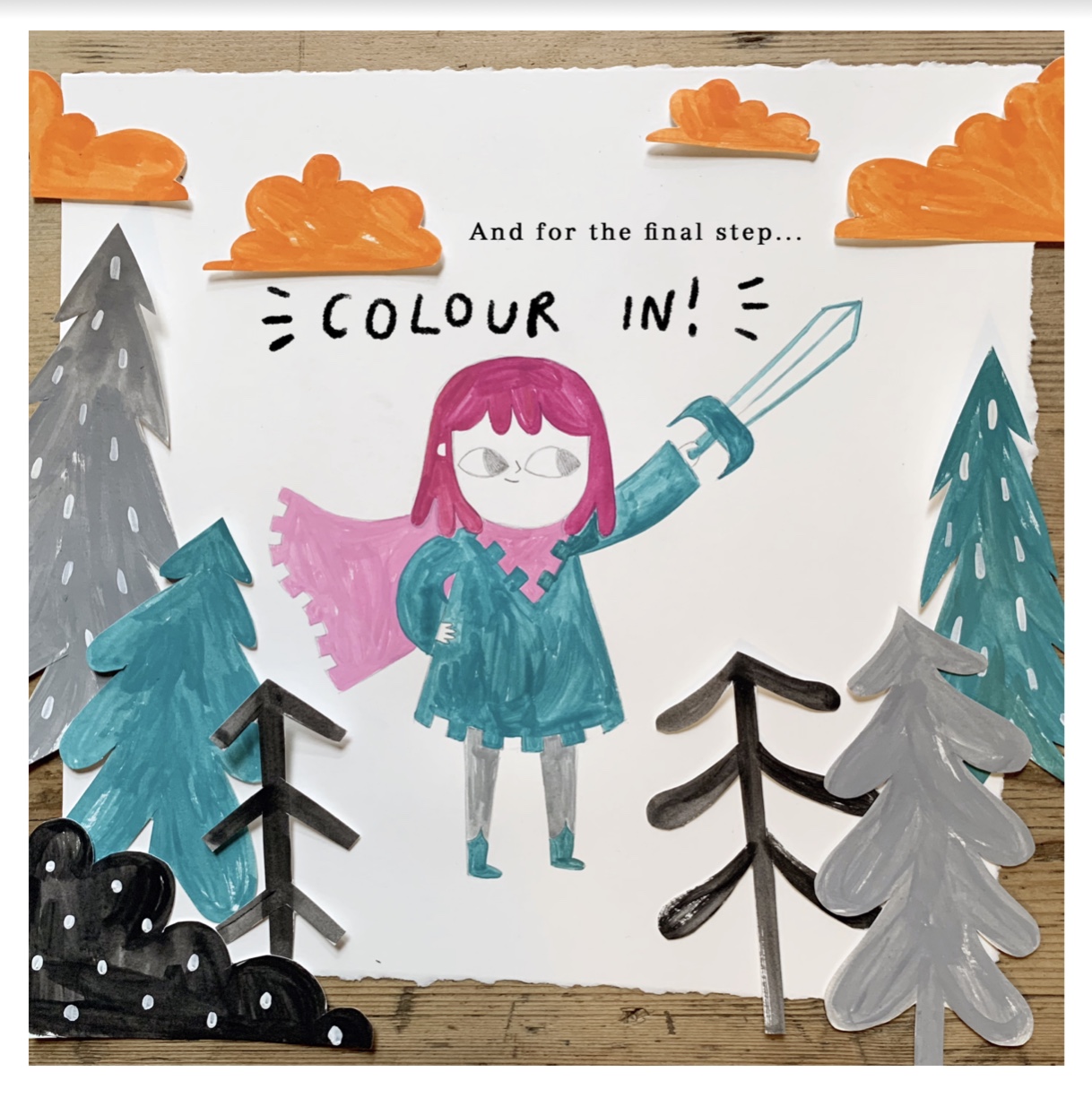
I’d love to see your pictures. Please share them with me on Twitter @GetKidsin2Books. You might also like to tag Bethan too @bethanwoollvin.
The Ship of Shadows Blog Tour
14 July 2020
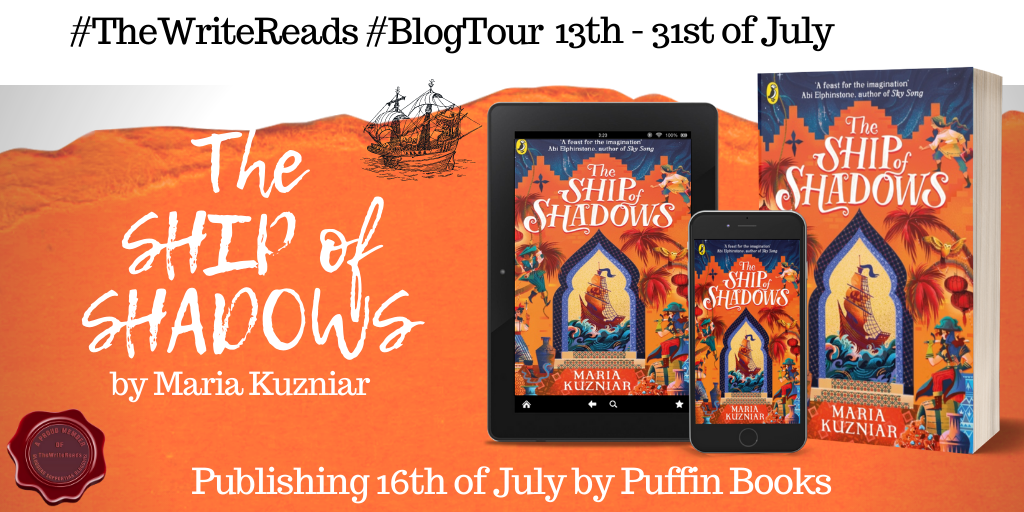
The Ship of Shadows is a vividly imagined pirate adventure, bursting with magic and mystery. You can read my full review here.
The Perfect Shelter Blog Tour
26 June 2020
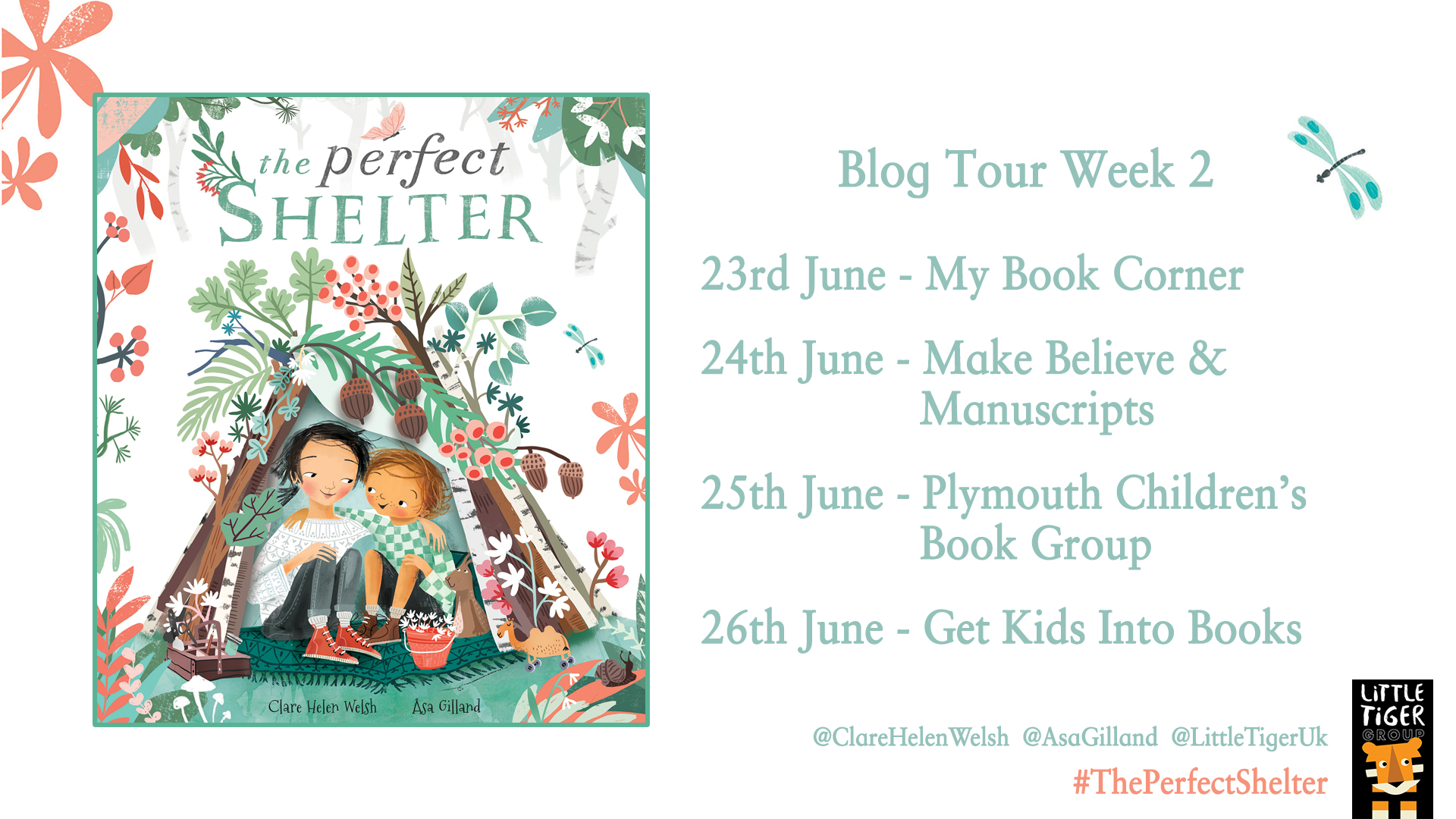
I’m delighted to welcome illustrator Åsa Gilland to my blog today to talk about creating The Perfect Shelter. It’s a beautiful picture book which deals with the heartbreaking subject of serious childhood illness. You can read my full review here.
Get Kids into Books: How did you feel when you first read Clare’s text for The Perfect Shelter?
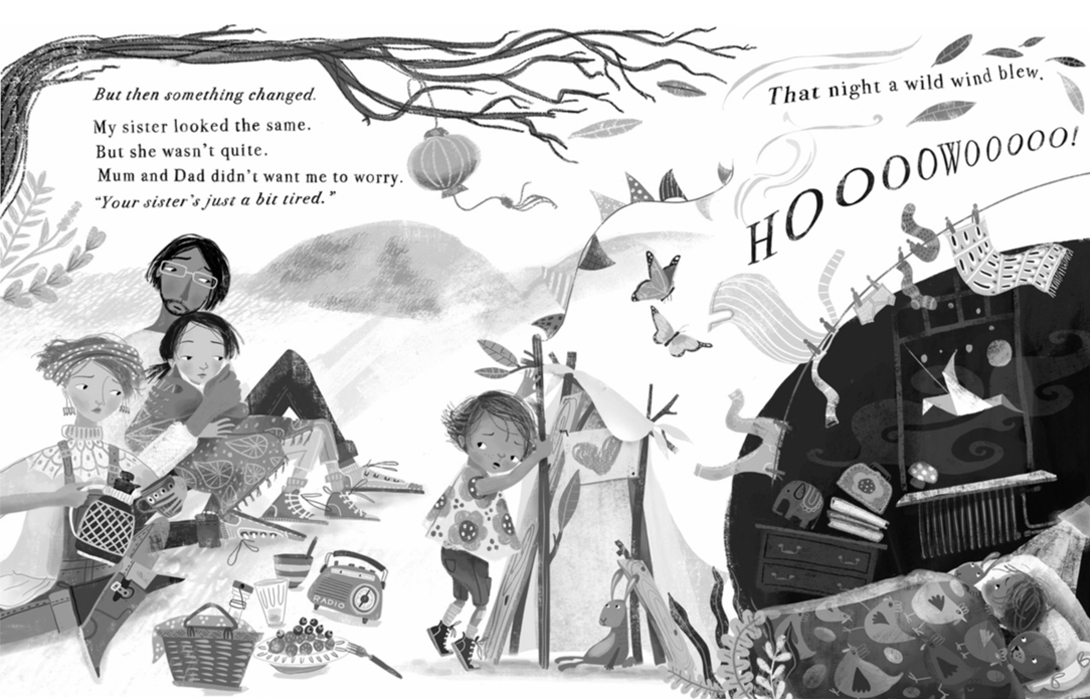
Åsa: I fell in love with this story at first sight. I really liked how tenderly the relationship between the sisters and their family was described. Clare’s use of the weather and the den-building to symbolize the turmoil surrounding them is so beautifully done too.
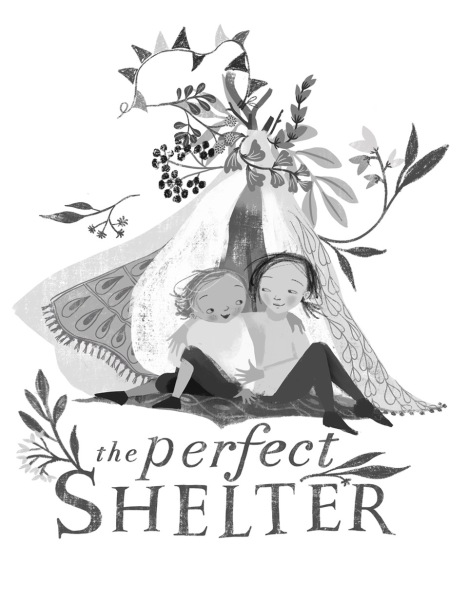
It also felt like it was a story that many could relate too, whether a family has battled cancer or other uncertainty. When I was around five years old, my older sister became very ill and had difficulties breathing. She spent some time in hospital and I only remember the fear and confusion that it brought. She was so suddenly brought away that I wasn’t sure she was coming back. I think Clare portrays this subject matter so beautifully and I love that it takes into account what it’s like to be a sibling to someone seriously ill.
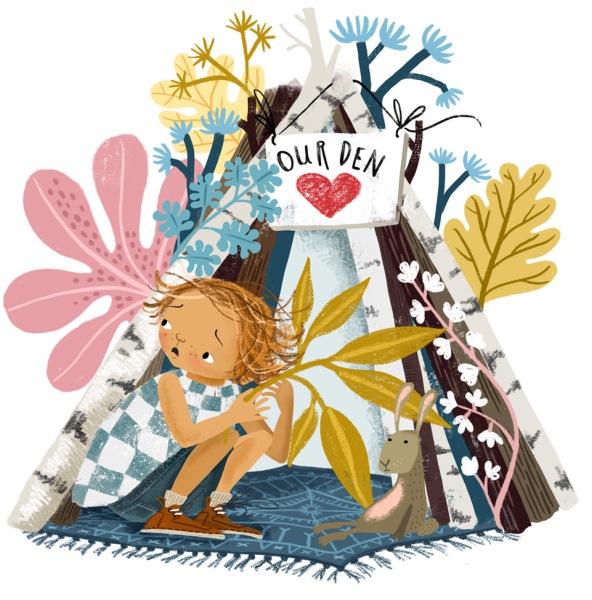
Get Kids into Books: Could you envisage how the shelter would look immediately, or did you have to try a few different versions?
Åsa:I did try a few versions and had a lot more fabrics before settling on a more natural den with lots of flowers and branches in the end.
Get Kids into Books: And what about the characters? Did they come to mind as they are or did you play around?
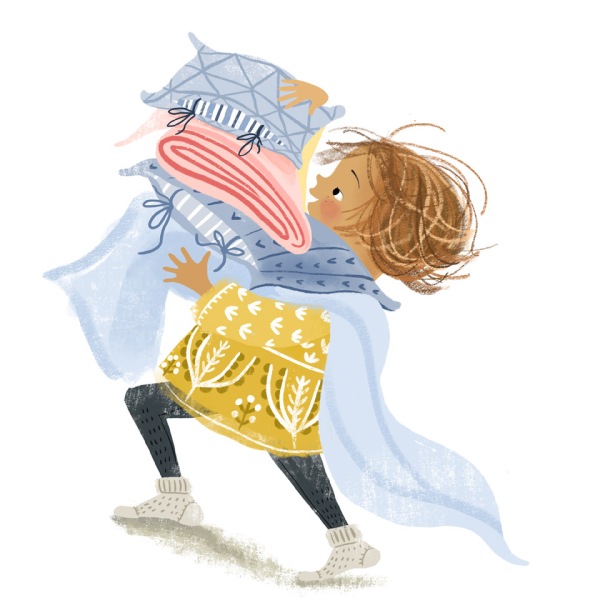
Åsa: They came about pretty quickly. My main aim was to portray a tenderness between the family members and especially the sisters so I hope that comes across.
Get Kids into Books: What medium did you use to create the artwork for the book?
Åsa: I drew it from start to finish digitally on a drawing pad though I tried to give it a rough, hand-drawn look with lots of textures.
Get Kids into Books: Which is your favourite spread in the book, and why?
Åsa: I really like the first spread where the family is seen from above with them all lying around in the grass in the sunshine. It turned out like I hoped it would and it just makes me feel warm and happy.
Comprehension Ninja Workbooks
Blog Tour, 25 June 2020
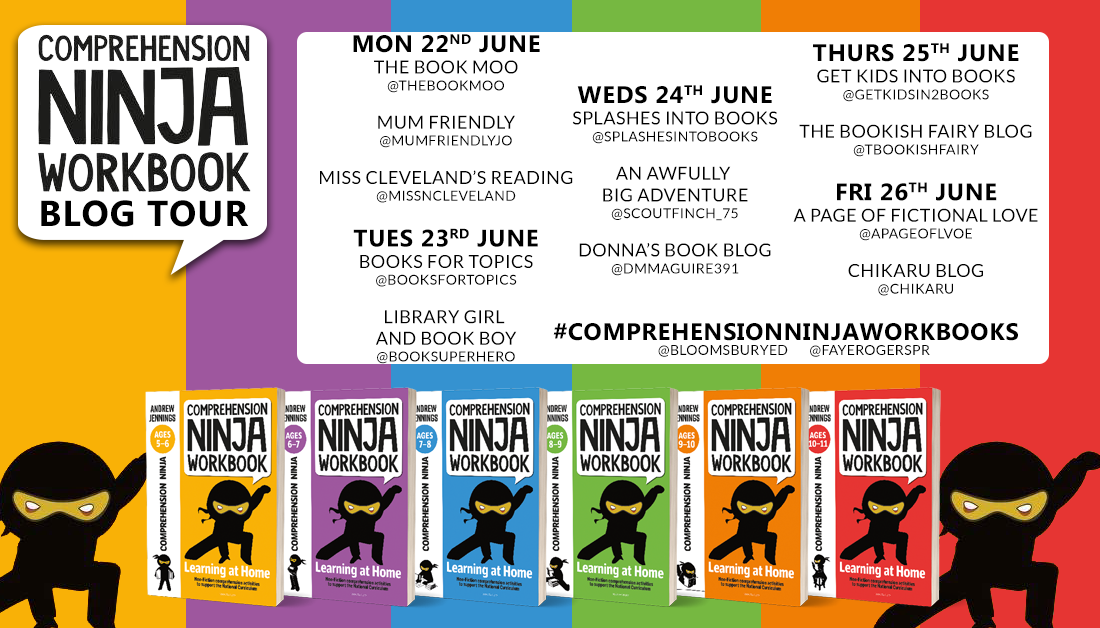
The Comprehension Ninja Workbooks have been published for parents and carers to use at home with their children. They focus on the key skills required for reading comprehension success at primary school level. For my stop on the blog tour, I reviewed the workbooks aimed at 7-8 year olds and 8-9 year olds. Click here to find out more.
Mohinder’s War Blog Tour
18 June 2020
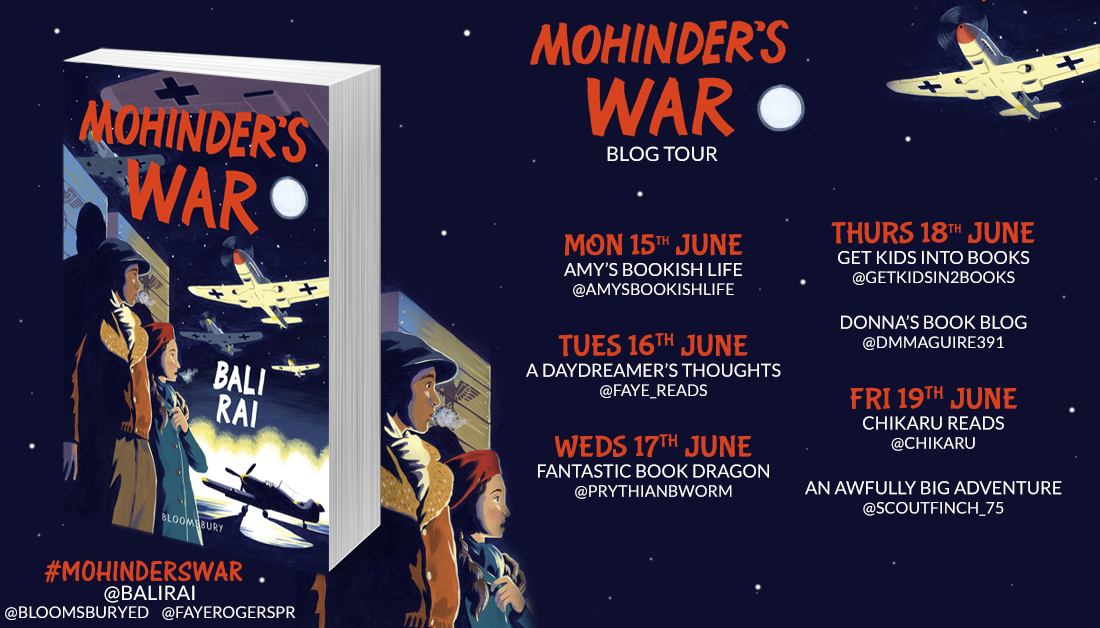
I’m delighted to be part of the blog tour promoting this exciting wartime adventure. You can read my full review here.
Llama Glamarama Dance Party
Blog Tour, 12 June 2020
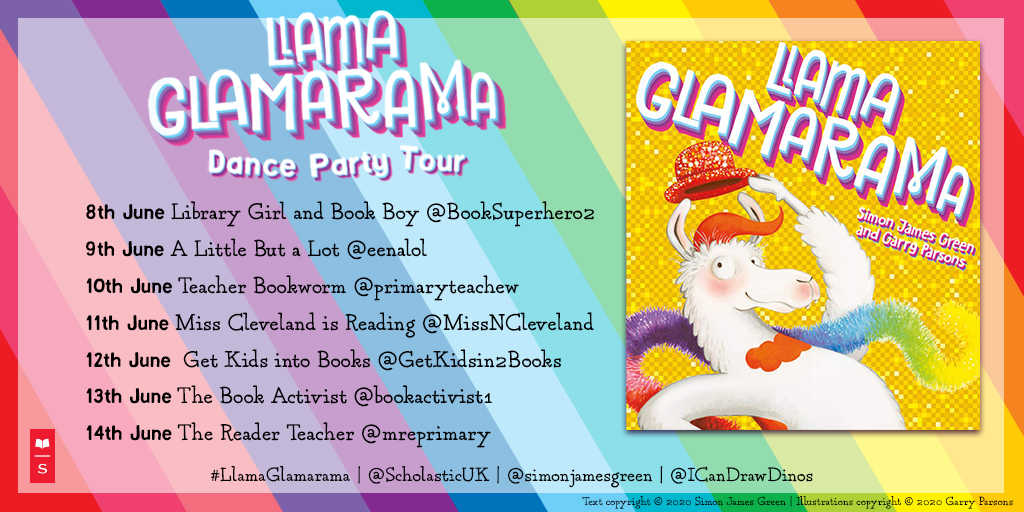
Larry the Llama is the star of fab new picture book, Llama Glamarama. He’s a llama who loves to dance. To celebrate the book’s publication, author Simon James Green has made a special Dance Party Tour Playlist. I’m very happy to be hosting the Britpop Party as these tunes provided the soundtrack to my university years and Britpop still gets me up on the dance floor (or jumping around in the kitchen) all these years later.
BRITPOP PARTY
Simon: If you grew up in the 90s, these were the tracks that probably had you heading for the dance floor. Here are some classics to take you back to your teenage years! (Ooh, I can almost smell the Lynx Atlantis right now!)
- Disco 2000 – Pulp
- Mulder and Scully – Catatonia
- Girls and Boys – Blur
- Common People – Pulp
- Sale of the Century – Sleeper
Here’s a link to the full ‘Llama Glamarama Dance Party Tour’ playlist.
Simon has asked me to complete a dance party challenge (thankfully no actual dancing is required), so here goes:
Dance Party Challenge
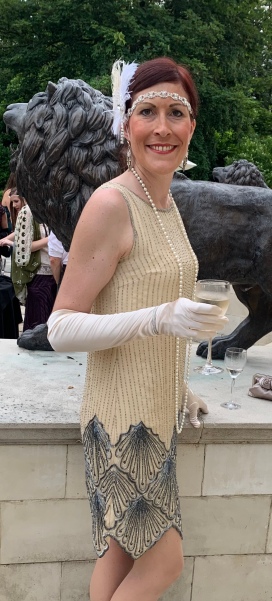 What’s your favourite dance move?
What’s your favourite dance move?
The Charleston hands. Sadly I’m not good enough to do the fancy footwork.
Favourite song to groove to?
Tiffany – I Think We’re Alone Now.
Favourite song for a slow dance?
Lover by Taylor Swift – such a beautiful song.
Ballet or hip-hop?
Ballet, especially if it’s been choreographed by Matthew Bourne.
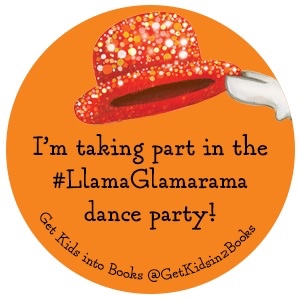 Jive or tango?
Jive or tango?
Jive. This is always one of my favourite dances on Strictly. I love the speed and the sharpness of it.
Flossing or flamenco?
Flamenco – it brings back happy childhood memories of Spanish holidays. Plus, I’m absolutely useless at flossing; I just can’t get the knack!
You can read my full review of Llama Glamarama here. Do check out the other stops on the tour too and bust some moves to the playlists!
Iggy Peck and the Mysterious Mansion
Blog Tour, 16 May 2020
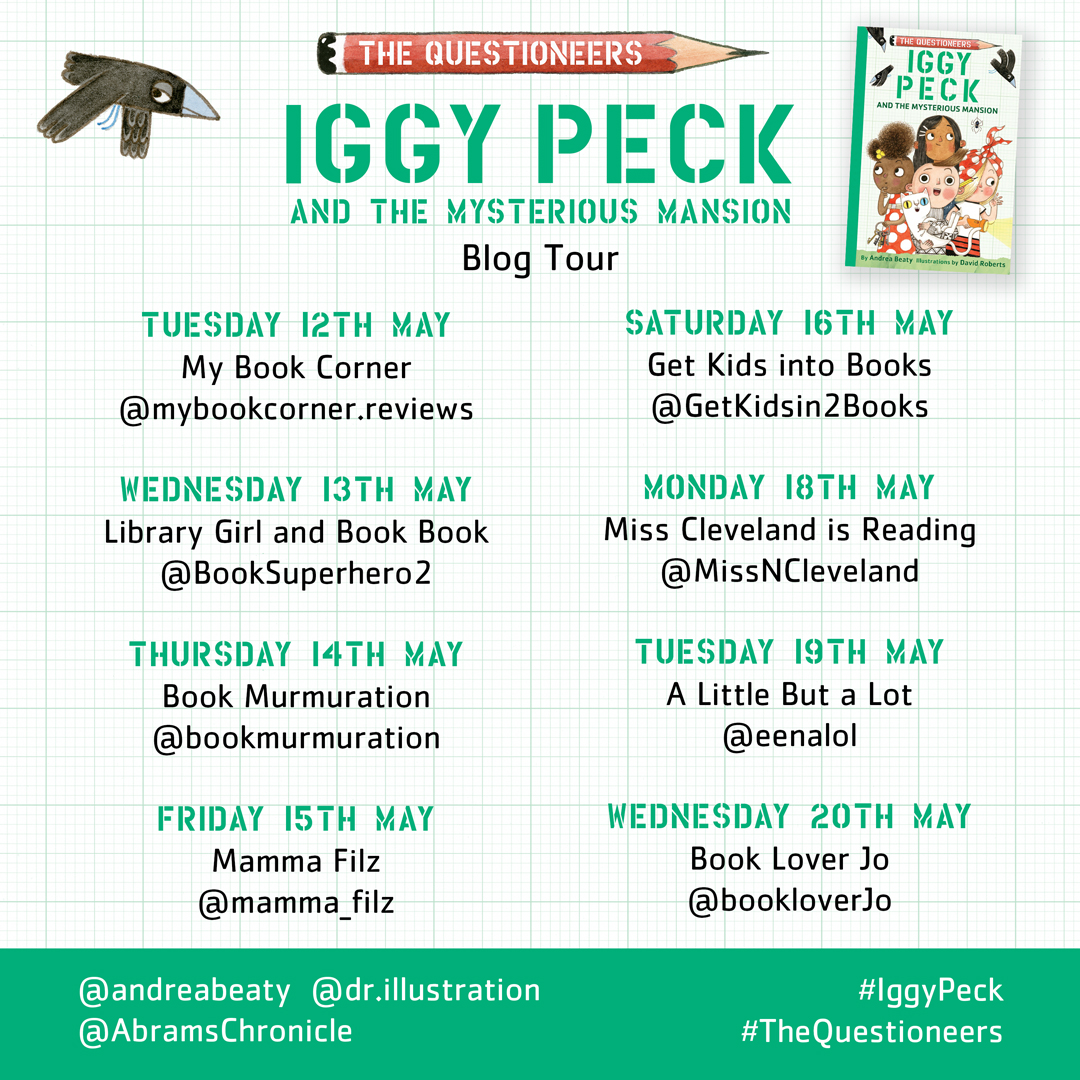
The Questioneers (Ada Twist, Iggy Peck, Rosie Revere and Sofia Valdez) are perhaps best known for their successful picture book series. More recently, the characters have begun having adventures in their own illustrated chapter books. In Iggy Peck and the Mysterious Mansion, Iggy takes the lead and the focus is on architecture – the fabulous Art Nouveau and Art Deco periods in particular. It’s a really engaging mystery for newly confident readers. You can read my full review here.
To celebrate the book’s publication, I’m running a giveaway. The prizes are:
To enter, either like my review or retweet and like my pinned tweet on Twitter (@GetKidsin2Books). You can enter twice. The competition is open to residents of the UK and Ireland. The deadline for entries is 8pm on Saturday 23 May 2020.
Why not try this fun drawing activity too? Can you be an architect like Iggy and design a treetop building? Here’s a link to a pdf version if you’d like to download and print the image.
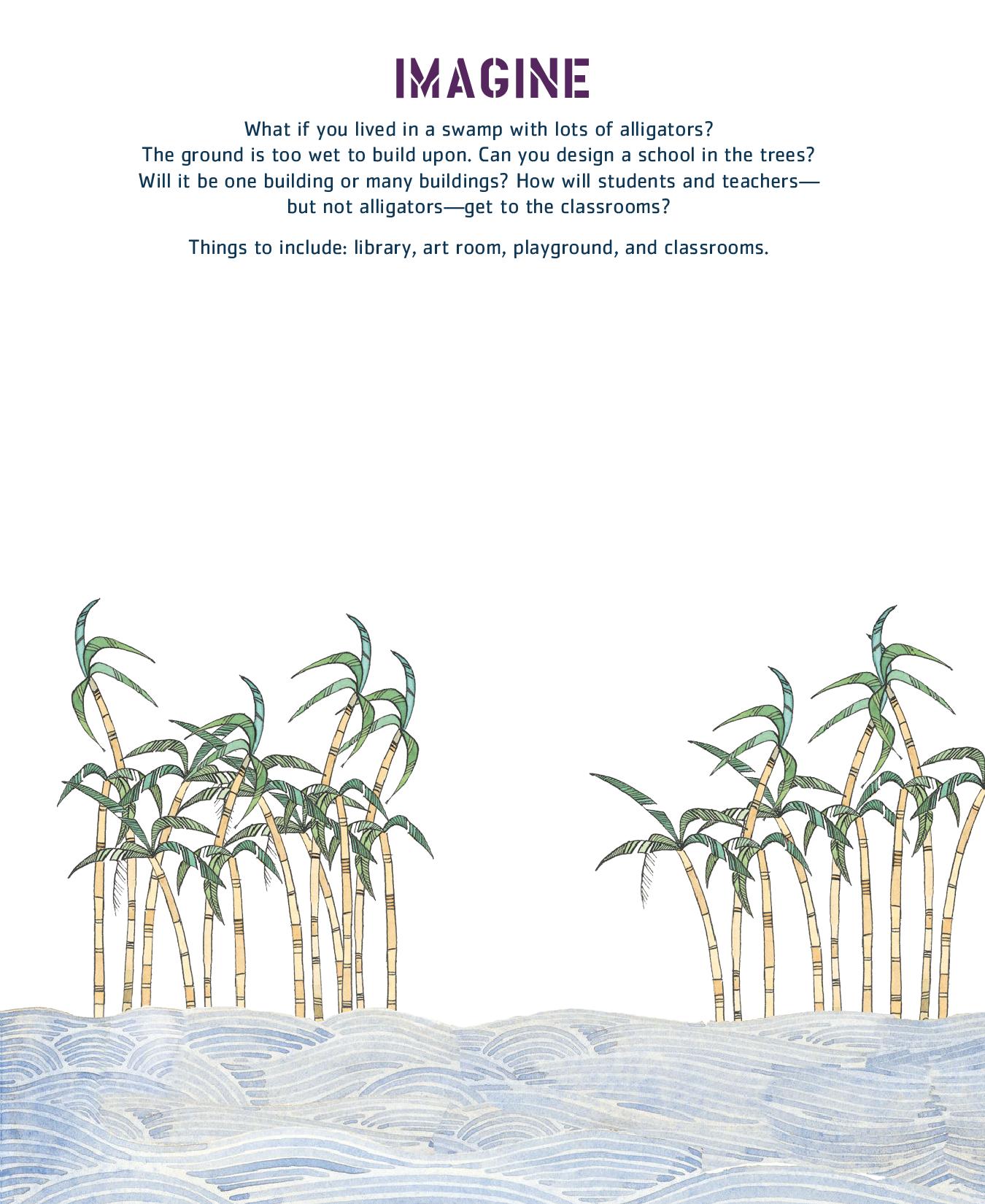
Check out some of the other stops on the tour too for more fabulous content.
The Adventures of Pinocchio Blog Tour
14 May 2020
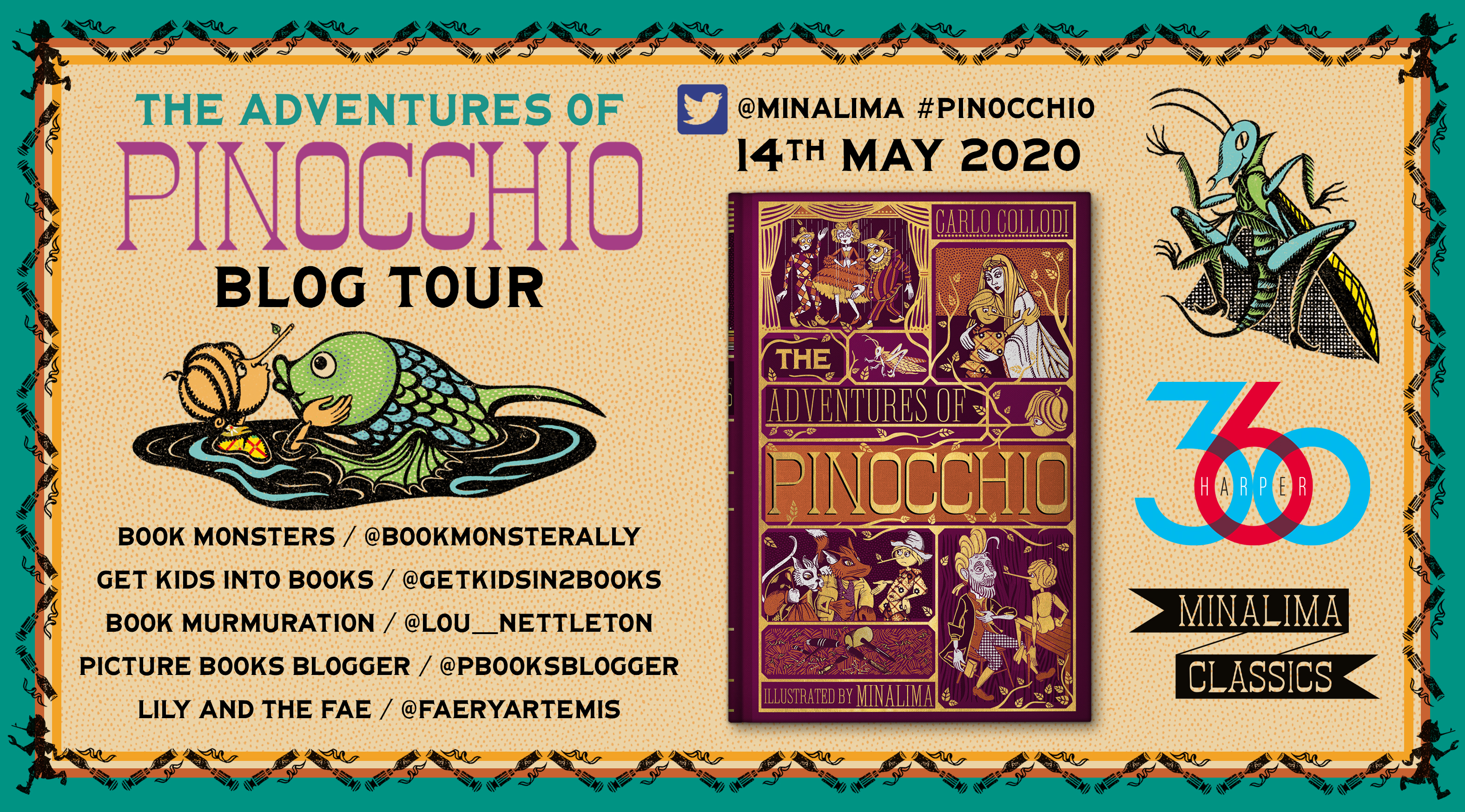
The Adventures of Pinocchio is a sumptuously illustrated and highly interactive version of this children’s classic. You can take a look inside and read my review here. The book is illustrated in spectacular fashion by MinaLima Design, the award-winning graphic design studio founded by Miraphora Mina and Eduardo Lima. They are best-known for their ten-year involvement in the Harry Potter film franchise, where they established the visual graphic style of the film series.
The Super Miraculous Journey of Freddie Yates
Blog Tour
2 May 2020
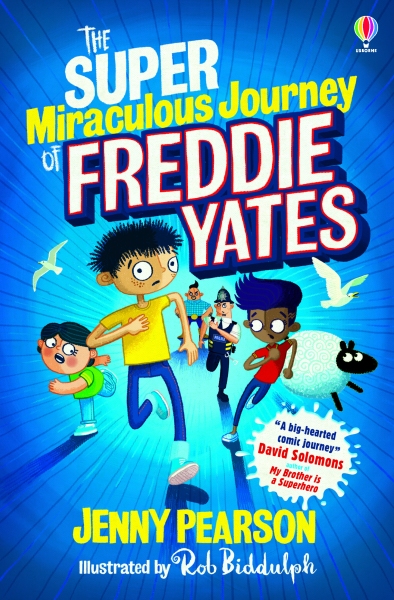 I am thrilled to have been invited to take part in this blog tour! The Super Miraculous Journey of Freddie Yates is one of the funniest books I’ve ever read and I want everyone to read it. It’s a madcap adventure involving an onion eating competition, superheroes on bikes, a miracle sheep called Sheila, loo-exploding potato-and-pear turnovers, and a spot of breaking and entering. It published in the UK this week and you can read my full review here.
I am thrilled to have been invited to take part in this blog tour! The Super Miraculous Journey of Freddie Yates is one of the funniest books I’ve ever read and I want everyone to read it. It’s a madcap adventure involving an onion eating competition, superheroes on bikes, a miracle sheep called Sheila, loo-exploding potato-and-pear turnovers, and a spot of breaking and entering. It published in the UK this week and you can read my full review here.
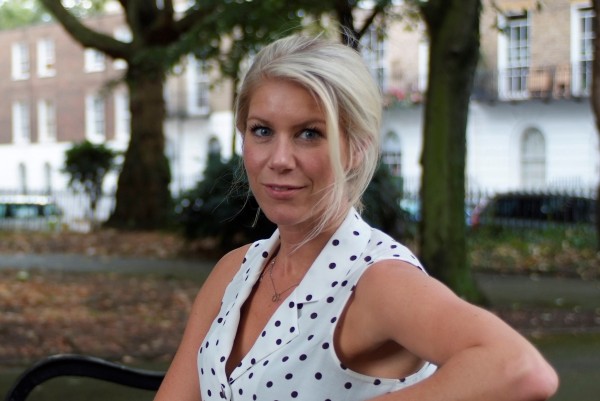 Today I’m delighted to welcome author Jenny Pearson to my blog. Freddie has never known his mom as she died when he was young. For years he’s been keeping a record in a notebook of all the things he’s done that would have made his mom proud. Here Jenny explains a bit more about what Freddie includes in his book and shares some of the things she’s most proud of.
Today I’m delighted to welcome author Jenny Pearson to my blog. Freddie has never known his mom as she died when he was young. For years he’s been keeping a record in a notebook of all the things he’s done that would have made his mom proud. Here Jenny explains a bit more about what Freddie includes in his book and shares some of the things she’s most proud of.
Jenny: There’s all sorts in there – from his performance as the cow in his school nativity to making it onto the B football team.
Today in the great words of Heather Small, I want to ask, what have you done today to make yourself proud? I think this question is one we should all stop to consider from time to time. Why do I think it’s important to do this? Well, two reasons really. The first is that it is good to recognise your achievements, to take a moment and realise how truly awesome you are! Because you are! Secondly, if we don’t ask ourselves, we might forget to do the stuff that matters – things that help others or challenge ourselves. I’m not saying that you can’t have the occasional day where all you do is sit about in your jimmers watching Disney movies and eating Pot Noodles – those days are important, no essential, too. But I do think it is good to check that, every now and then, you’re doing something that counts.
So like Freddie, why don’t you make a note of the things that you have done that you are proud of. I am going to share some of the things I have done which I think deserve a mention in my ‘Things I have done which make me proud’ notebook.
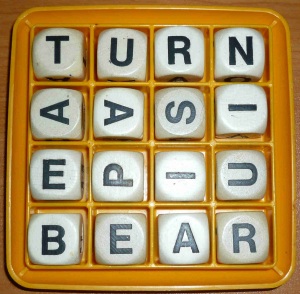 1. Boggle champion – I am very proud of the fact that I have never been beaten. It is true lots of the games I have played have been against much younger contestants, namely children in my class, but a win is a win in my book.
1. Boggle champion – I am very proud of the fact that I have never been beaten. It is true lots of the games I have played have been against much younger contestants, namely children in my class, but a win is a win in my book.
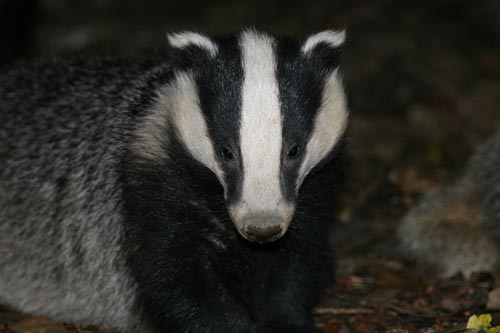 2. Cycling around the Isle of Wight – I realise this won’t be that impressive to some bicycly people, but the first time I tried, my friend and I got ourselves so lost. It got very late and very dark and as we didn’t have lights on our bikes, we ended up being picked up by search and rescue. They told us we were very lucky not to be attacked by the badgers who come out at night. I’m not sure if they were joking, but we were determined to try to do it. So, even though everyone told us not to, we put thoughts of ferocious badgers out of our minds and ignored our saddle-sore bottoms and tried again AND – we made it! Hurrah!
2. Cycling around the Isle of Wight – I realise this won’t be that impressive to some bicycly people, but the first time I tried, my friend and I got ourselves so lost. It got very late and very dark and as we didn’t have lights on our bikes, we ended up being picked up by search and rescue. They told us we were very lucky not to be attacked by the badgers who come out at night. I’m not sure if they were joking, but we were determined to try to do it. So, even though everyone told us not to, we put thoughts of ferocious badgers out of our minds and ignored our saddle-sore bottoms and tried again AND – we made it! Hurrah!
 3. Writing The Super Miraculous Journey of Freddie Yates! This is a constant source of surprise to me. Never ever ever did I think I would ever write a book ever. I wasn’t really very good at writing stories at school and I’ve always thought of myself as being sporty and not a creative type. I suppose it just goes to show you that you don’t always know what you can do until you give it a go.
3. Writing The Super Miraculous Journey of Freddie Yates! This is a constant source of surprise to me. Never ever ever did I think I would ever write a book ever. I wasn’t really very good at writing stories at school and I’ve always thought of myself as being sporty and not a creative type. I suppose it just goes to show you that you don’t always know what you can do until you give it a go.
I’d love to hear some of the things that you have done that make you proud. And if you can’t think of anything, go and ask someone who loves you, because I bet, they’ve got a list of things you’ve done that is so long, you’ll need more than one notebook.
Get Kids into Books: Thanks Jenny. I’ll be starting a thread on Twitter about this. I’d like to hear people share the things they’re most proud of.
The blog tour continues over the next few days and there’s already been a week’s worth of fabulous content so do check out some of the other stops on the tour.
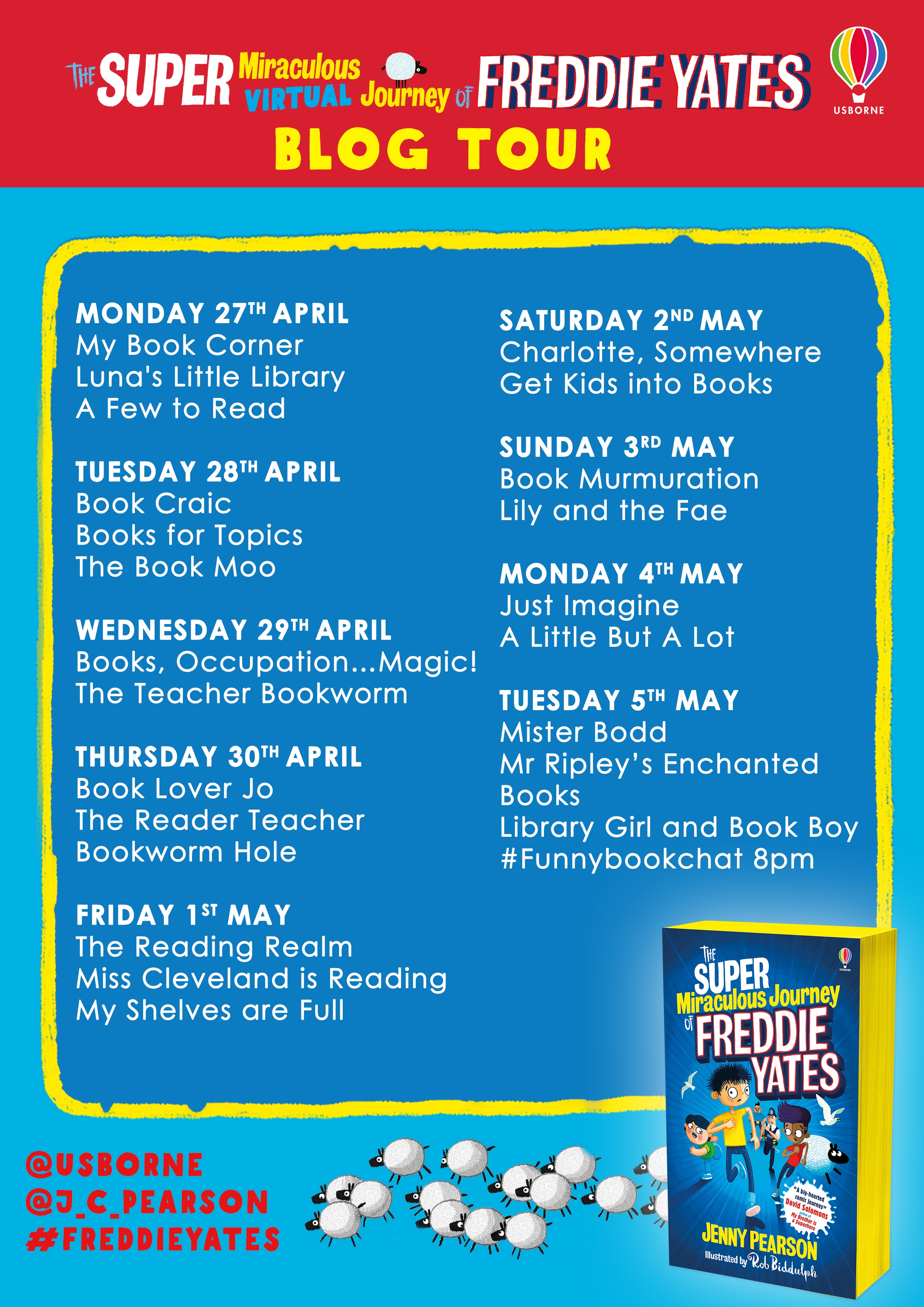
The Vanishing Trick Blog Tour
29 April 2020
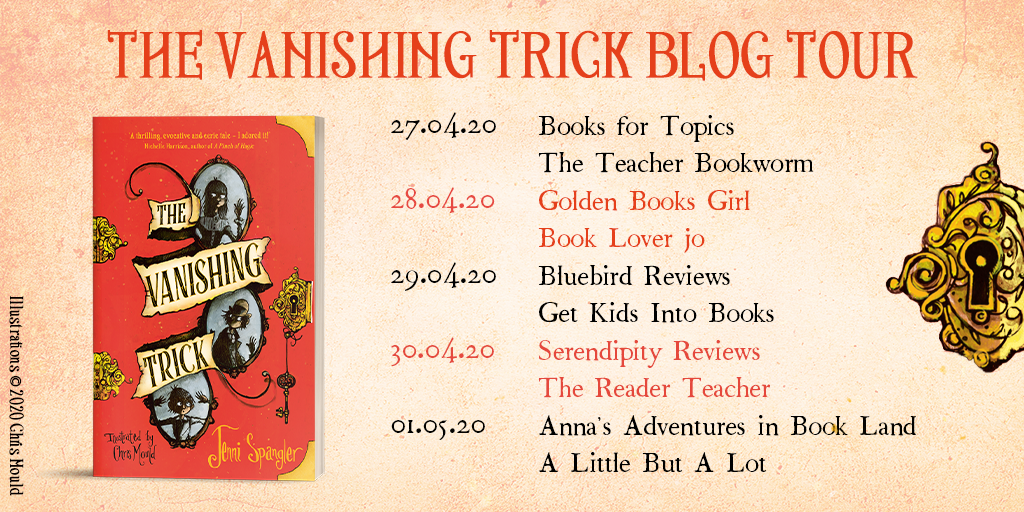
The Vanishing Trick publishes in the UK on 30 April and I can’t recommend it highly enough! It’s an atmospheric page-turner packed full of otherworldly magic and mystery. With a magnificently menacing female villain, three plucky children and plenty of spooky goings on, this is one not to miss. You can read my full review here.
 Today I’m delighted to welcome author Jenni Spangler to my blog.
Today I’m delighted to welcome author Jenni Spangler to my blog.
Get Kids into Books: Hi Jenni, thanks for joining me today. I loved The Vanishing Trick! One of the things that struck me about the book was the blend of folklore and superstitions with all the magic and mystery. Can you tell me more about your interest in this?
Jenni: Hi, thanks for having me. The Vanishing Trick includes mentions of some local folklore and old British superstitions. There’s the hag-stone (a rock with a hole in it made by running water) which is said to reveal hidden magic and lost things when you peer through it. There’s the Cunning Man – a combination healer, curse lifter, fortune teller and advice giver – who used a mixture of prayer, herbal remedies and magic to solve people’s problems. And there’s a quaint old Midlands tradition of writing letters to rats.
During my research I came across a lot of interesting regional myths which I couldn’t put into the book. Here are three of my favourites.
The Gytrash – Huge ghostly black dogs are a popular theme in folklore, and lots of towns have their own version. The Gytrash haunts lonely roads in northern England. It can be kindly, guiding a lost traveller back onto the right path, or wicked, leading people astray to be lost forever. Some stories say it is a goblin which takes the shape of animals and may appear as a horse or donkey instead. This creature is even mentioned in Jane Eyre, when she is unnerved by the sudden appearance of Mr Rochester’s dog.
The Wizard of Alderly Edge – The story goes that a farmer was approached by a man in grey robes, asking to buy his white horse. When the farmer agreed, the man led him to a hillside, where great iron gates opened in the rock. Inside was a great chamber filled with sleeping men and white horses. The man in grey explained that they were sleeping warriors and would rise up to fight when England was in peril. He paid the farmer from a great chest of gold and sent him away. Some say the men were King Arthur and his knights. Actual bars of gold were found in the area by metal detectorists in the 90s – could this be the wizard’s hoard?
Molly Leigh – Perhaps my favourite character on this list, Molly Leigh is the only one known to definitely exist. She was accused of being a witch, turning milk sour, destroying businesses and making the vicar appear drunk. She died before being tried, and her grave can still be seen in Burslem, positioned at a right angle to all the others in the churchyard to stop her spirit terrorising the town. It seems poor Molly was targeted as a witch because of a disagreement with the local vicar, and the fact that she was an outspoken and successful unmarried woman. In her will, Molly said that her land should be used to build a shelter for needy women, and her money should go to provide food and clothing for the poor – the exact opposite of the spiteful witch she is claimed to be.
I love learning about these magical stories because it makes me feel connected to a place and the people who have lived there over the years. Writing local folklore into The Vanishing Trick was my way of continuing a centuries-old tradition and passing on some of these old ideas. I hope it makes some young readers curious about the stories that dwell in their particular corners of the world.
Get Kids into Books: This is fascinating stuff! Thank you for sharing.
The blog tour continues tomorrow. Do check out the other stops on the tour.
The Thirteenth Home of Noah Bradley Blog Tour
6 April 2020

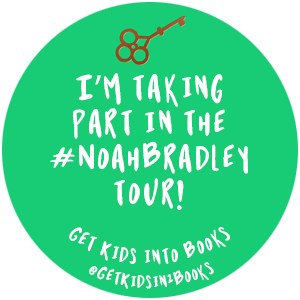 The Thirteenth Home of Noah Bradley published last week. It’s a terrific middle grade adventure about a family who are cursed to forever be chased from their homes, never able to make one place home for much longer than a year. You can read my full review here.
The Thirteenth Home of Noah Bradley published last week. It’s a terrific middle grade adventure about a family who are cursed to forever be chased from their homes, never able to make one place home for much longer than a year. You can read my full review here.
 Today I’m delighted to welcome author Amber Lee Dodd to my blog. For each of the thirteen days of the blog tour she’s sharing a different historical or literary curse. Today, she’s talking about Macbeth, the Scottish play.
Today I’m delighted to welcome author Amber Lee Dodd to my blog. For each of the thirteen days of the blog tour she’s sharing a different historical or literary curse. Today, she’s talking about Macbeth, the Scottish play.
Amber: Back when I studied theatre I learned about all kinds of superstitions. One was that the last rehearsal should go terribly to ensure a good first night. Definitely not true. Another was to never wish an actor good luck, always tell them to ‘break a leg’ to ensure they aren’t jinxed. And the most serious superstition of all, was to never utter the name of the famous Scottish play Macbeth. This became a serious problem when we were performing Macbeth! According to folklore a coven of witches found out about Shakespeare using real spell incantations, so they put a curse on the play. The play since has rumoured to have faced many disasters. From actors getting injured or dying suddenly in the first production of Macbeth, to a stage weight narrowly missing the famous actor Lawrence Oliver when he played Macbeth. So, if you’re in the theatre never utter the name of the Scottish play.
Do make sure to visit the other stops on the tour to learn about lots of other fascinating curses.
Pests Blog Tour
3 April 2020
 Pests is the first book in a hilarious new series by Emer Stamp. Stix is a mouse with a talent for acrobatics. He’s forced to fend for himself when his Grandma is flushed down the toilet and pretty soon his life is full of danger and mayhem. You can read my full review here.
Pests is the first book in a hilarious new series by Emer Stamp. Stix is a mouse with a talent for acrobatics. He’s forced to fend for himself when his Grandma is flushed down the toilet and pretty soon his life is full of danger and mayhem. You can read my full review here.
In this video author/illustrator Emer talks about how she wrote Pests, from coming up with her ideas to using a story clock to plot the story, and working with an editor to perfect the finished book. Click the link for the video here.
Draw your own Perdu the dog
Step-by-step instructions from Richard Jones
2 April 2020
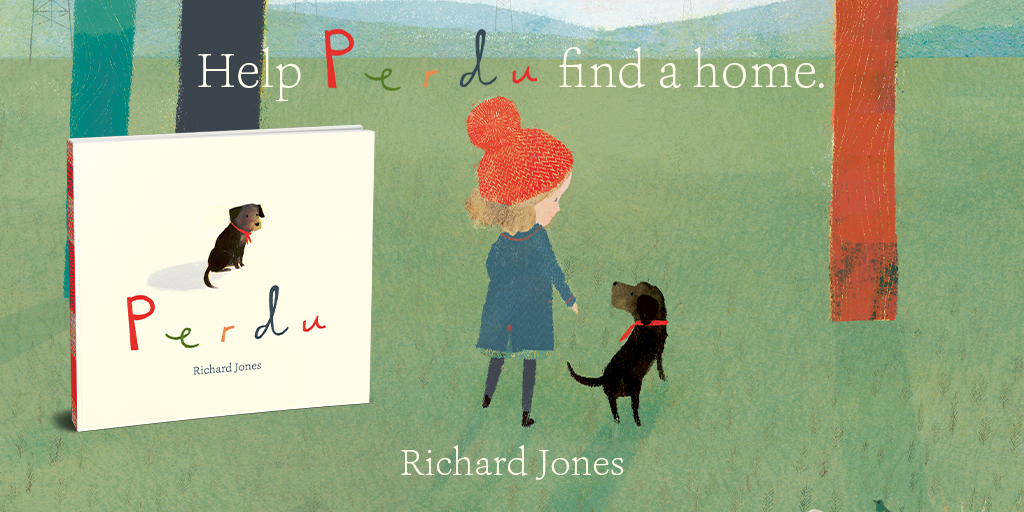
Perdu is published today by Simon & Schuster. It’s a beautiful picture book about finding a place to belong. The story is ultimately an uplifting one about hope and kindness. You can read my full review by clicking here.
Today I’m delighted to share some exclusive content from author/illustrator Richard Jones: his step-by-step instructions for drawing Perdu, the super cute dog at the heart of the story. I’d love to see what you draw. Please share on Twitter, tagging me @GetKidsin2Books
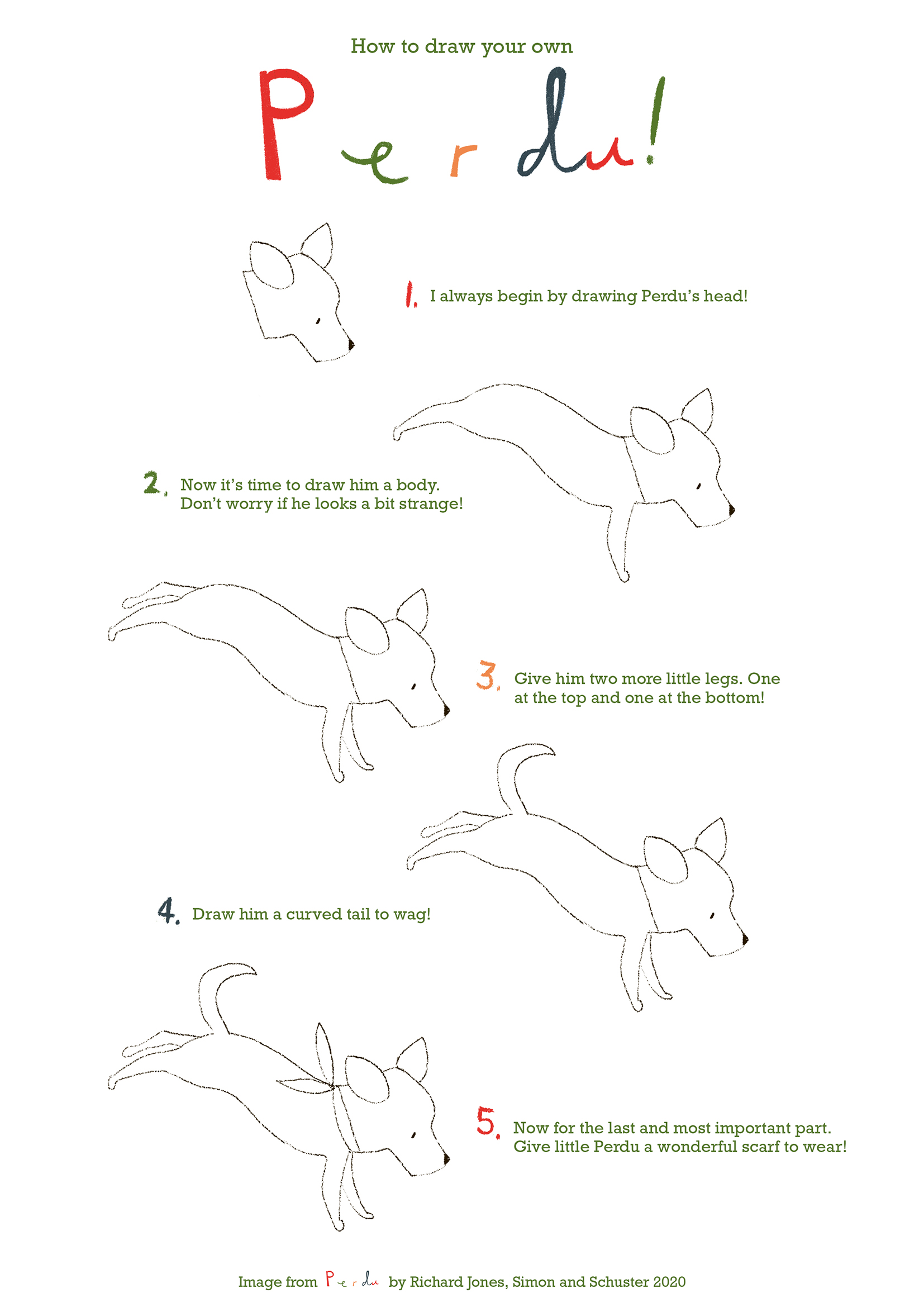
The FCBG Children’s Book Award Blog Tour
30 March 2020
I’m thrilled to be championing the brilliant D-Day Dog by Tom Palmer for the FCBG Children’s Book Award. D-Day Dog is one of the TOP 12 books that have been nominated for this year’s award.
D-Day Dog is the story of war-mad 11-year old Jack. Jack loves playing war games on his PlayStation. He’s fascinated by war and reveres soldiers and war heroes. He’s also extremely proud of his dad, a Reserve soldier. Understandably, he canʼt wait for the school trip to the D-Day landing beaches.
In preparation for the trip, his teacher has asked the class to research someone who’s buried in the Normandy war graves. They will then each place a cross on the grave of their chosen soldier when they visit.
As well as war, Jack has a passion for dogs – his own dog Finn in particular. So when he discovers that dogs, trained to sniff out land mines, were parachuted into France with soldiers as part of the D-Day campaign he’s very interested and he begins his research in earnest; it’s a natural match. Jack is drawn to a photo of a German Shepherd dog, Glen, and his handler Emile Corteil. However, what he discovers about their fate changes his mind about war.
The book sensitively handles the very complex issues surrounding war. Different perspectives are considered and the book offers a very balanced portrayal of war. Jack’s shifting viewpoint is carefully depicted and I found the final scenes in the graveyard to be particularly moving. The scope of the book is broad, covering historic and more recent conflicts, including the war in Syria and the plight of refugees.
Other strong themes in the book are those of friendship and family. I particularly enjoyed watching the friendship develop between Jack and Kasandra. Kasandra is a Syrian refugee in Jack’s class. Their relationship has a tense start but gradually Jack comes to understand the impact of war on civilians. Ultimately, he shows great empathy and kindness towards Kasandra.
D-Day Dog is a very readable story with relatable characters. It’s an engaging, thought provoking book that I highly recommend.
Author Tom Palmer had this to say about his nomination, “I am so happy that D-Day Dog is on the shortlist for the 2020 Children’s Book Award. The fact that the shortlist and winners are chosen by children means the world to us authors. Winning the 2019 award for Armistice Runner is the outstanding highlight of my career as a writer so far. So thank you, FCBG!”
D-Day Dog is published by Barrington Stoke.
Voting is now open (click here) and any child up to the age of 18 can visit to vote for their favourite books from the top 12.
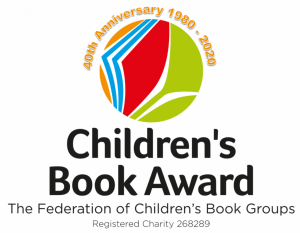 The Children’s Book Award is the only national award voted for solely by children from start to finish. It is highly regarded by parents, teachers, librarians, publishers and children’s authors and illustrators as it truly represents the children’s choice. Thanks to the support of the publishers, over 1,000 new books are donated to be read and reviewed by our Testing Groups across the country every year, with over 150,000 total votes being cast in the process. At the end of each testing year, nearly 12,000 books are donated to hospitals, women’s refuges, nurseries and disadvantaged schools by our groups.
The Children’s Book Award is the only national award voted for solely by children from start to finish. It is highly regarded by parents, teachers, librarians, publishers and children’s authors and illustrators as it truly represents the children’s choice. Thanks to the support of the publishers, over 1,000 new books are donated to be read and reviewed by our Testing Groups across the country every year, with over 150,000 total votes being cast in the process. At the end of each testing year, nearly 12,000 books are donated to hospitals, women’s refuges, nurseries and disadvantaged schools by our groups.
You can check out the rest of the shortlisted books by visiting these other fab blogs:
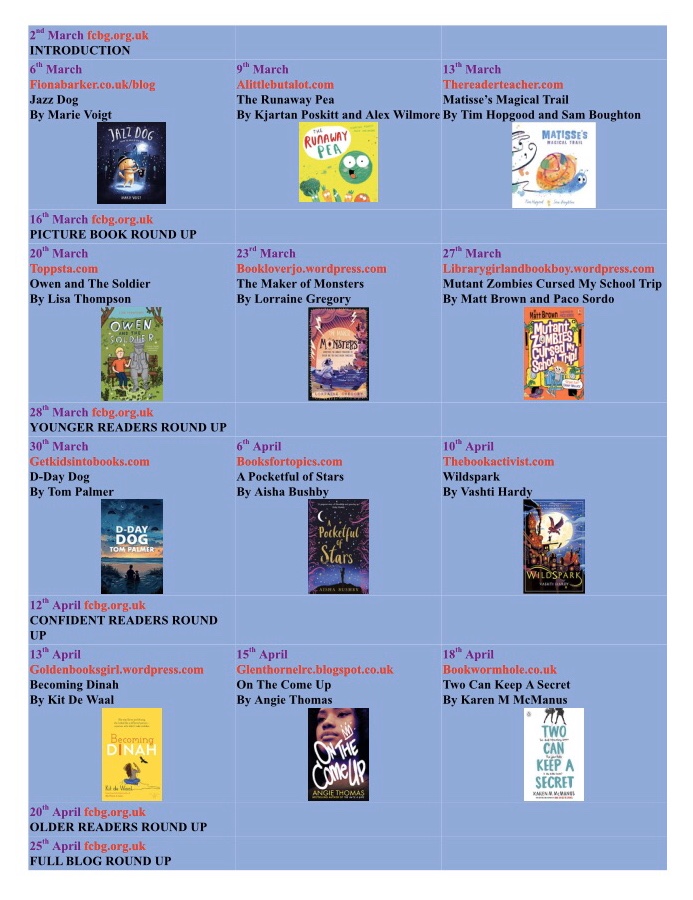
Fierce, Fearless and Free Blog Tour
3 March 2020
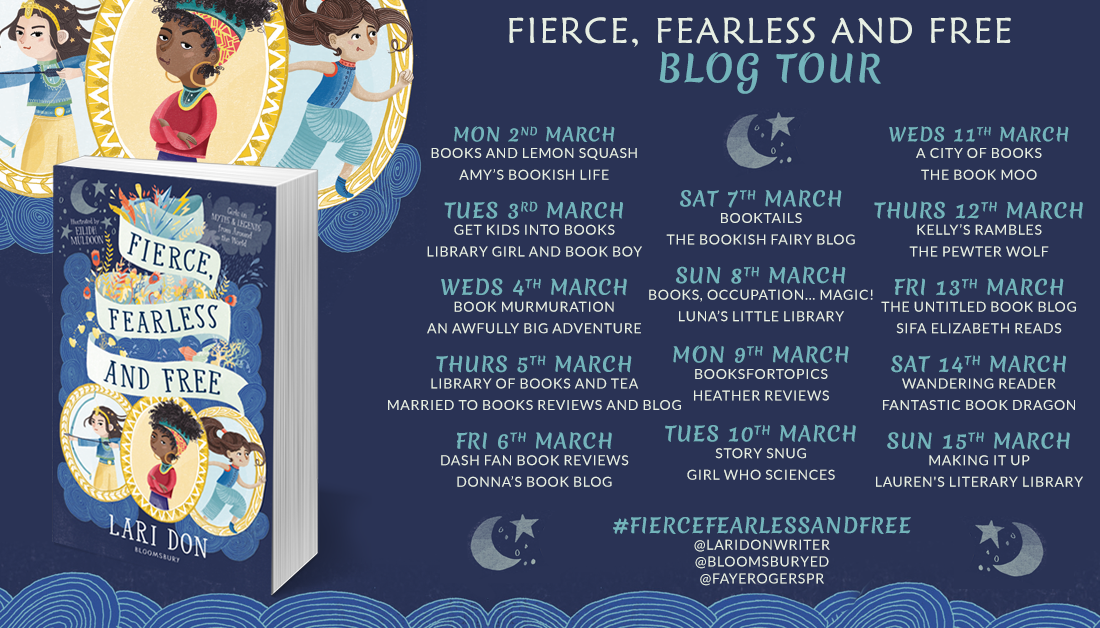
Fierce, Fearless and Free is a collection of 13 short stories with strong, female leads. The tales originate from all around the world. The women and girls in these stories are smart, capable and brave. They don’t need a prince or a knight in shining armour to rescue them. In fact, they’ll be the ones doing the rescuing thank you very much. Read more about these feisty females here.
Hop over to my Twitter account (@GetKidsin2Books) to enter a competition to win a copy of Fierce, Fearless and Free.
🦇 The Bat Book Blog Tour 🦇
24 February 2020
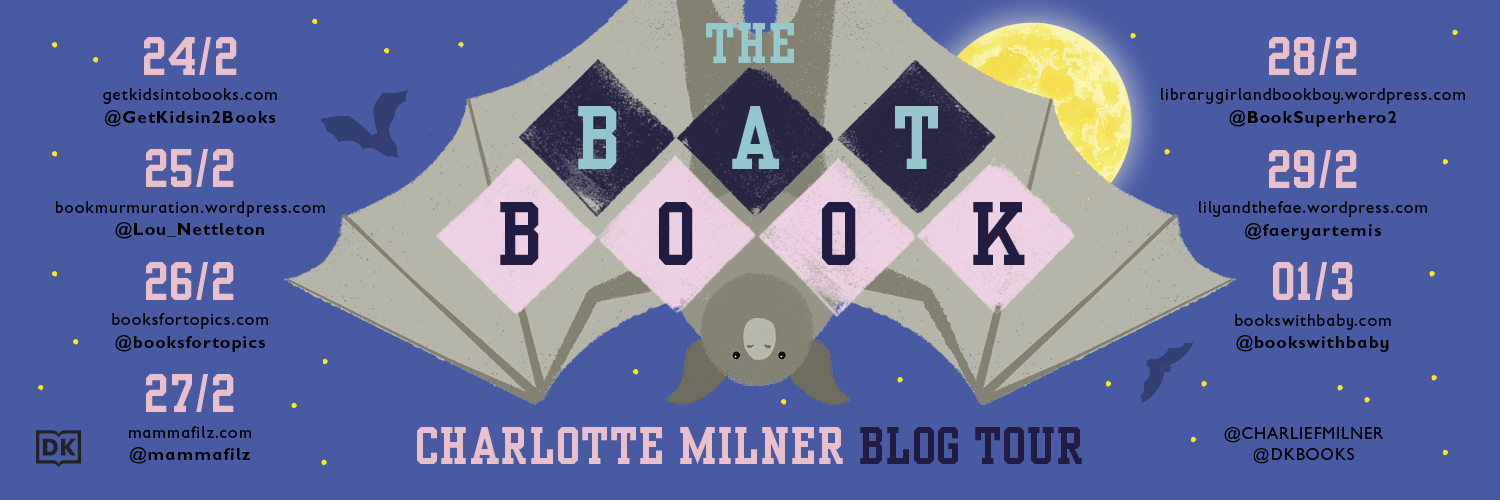
 Today I’m delighted to welcome author/illustrator Charlotte Milner to my blog. Charlotte creates books with playful designs to bring important information to young readers. She has a keen interest in the natural world and conservation.
Today I’m delighted to welcome author/illustrator Charlotte Milner to my blog. Charlotte creates books with playful designs to bring important information to young readers. She has a keen interest in the natural world and conservation.
Get Kids Into Books: Your latest book is The Bat Book. Why did you choose to write about bats?
Charlotte: With each of the books I make, my aim is to inspire a love of nature through showing the amazing ways that plants and animals survive. I wanted the book to be about an animal which has an important ecological role and that could be used as a way of explaining other topics to children such as ecosystems, pollination and food chains.
I started to study bats because I knew that they are known as an indicator species, which means that bats have such close connections to their environment that their presence tells us if a surrounding area has enough plants and insects to support other wildlife.
So to get started with my research, I booked myself on a bat walk, and like all of the others who attended the walk, I became fascinated by bats.
I love the secret nature of them, how they appear as the sun goes down but in the daytime we are completely unaware of them being around. The way that they navigate in the dark is also amazing to me. Using sound to build an accurate picture of their surroundings, a bat’s view of the world must be entirely different to ours.
As my research continued, I learnt more about the role that bats have in pollinating plants. It seemed that most people were unaware that bats actually pollinate over 500 species of plant, including those which grow mangos, guava and bananas. They are really important for seed dispersal in tropical areas too, and help to regenerate areas of cleared rainforest by dispersing the seeds of important pioneer plants.
As I learnt more about bats, I also became surprised at people’s reactions when I would tell them that I was working on a book about bats. People would say ‘I don’t like bats, they’re scary’. These sorts of comments made me feel like it was an even more important reason to do a book about them. When you understand how they live, you realise that there’s really no other animal like them. They are the only flying mammal and are important to pollination, seed dispersal and controlling the populations of insects across the world. As many bat species are in decline, I hope that through colourful illustrations and interesting facts The Bat Book will teach parents and children that’s bats are not scary, but they are animals to be admired.
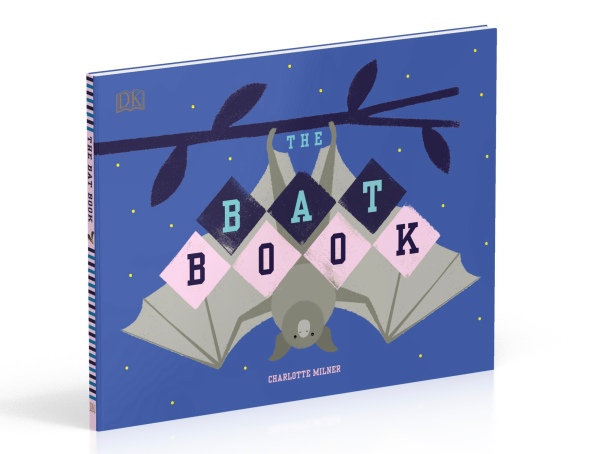 Get Kids Into Books: Well your book certainly has opened my eyes to how amazing bats are! Thank you very much for joining me today.
Get Kids Into Books: Well your book certainly has opened my eyes to how amazing bats are! Thank you very much for joining me today.
I loved The Bat Book. You can read my full review here. Oh, and don’t forget to check out the other stops on the blog tour.
Tiger Skin Rug Blog Tour
10 February 2020
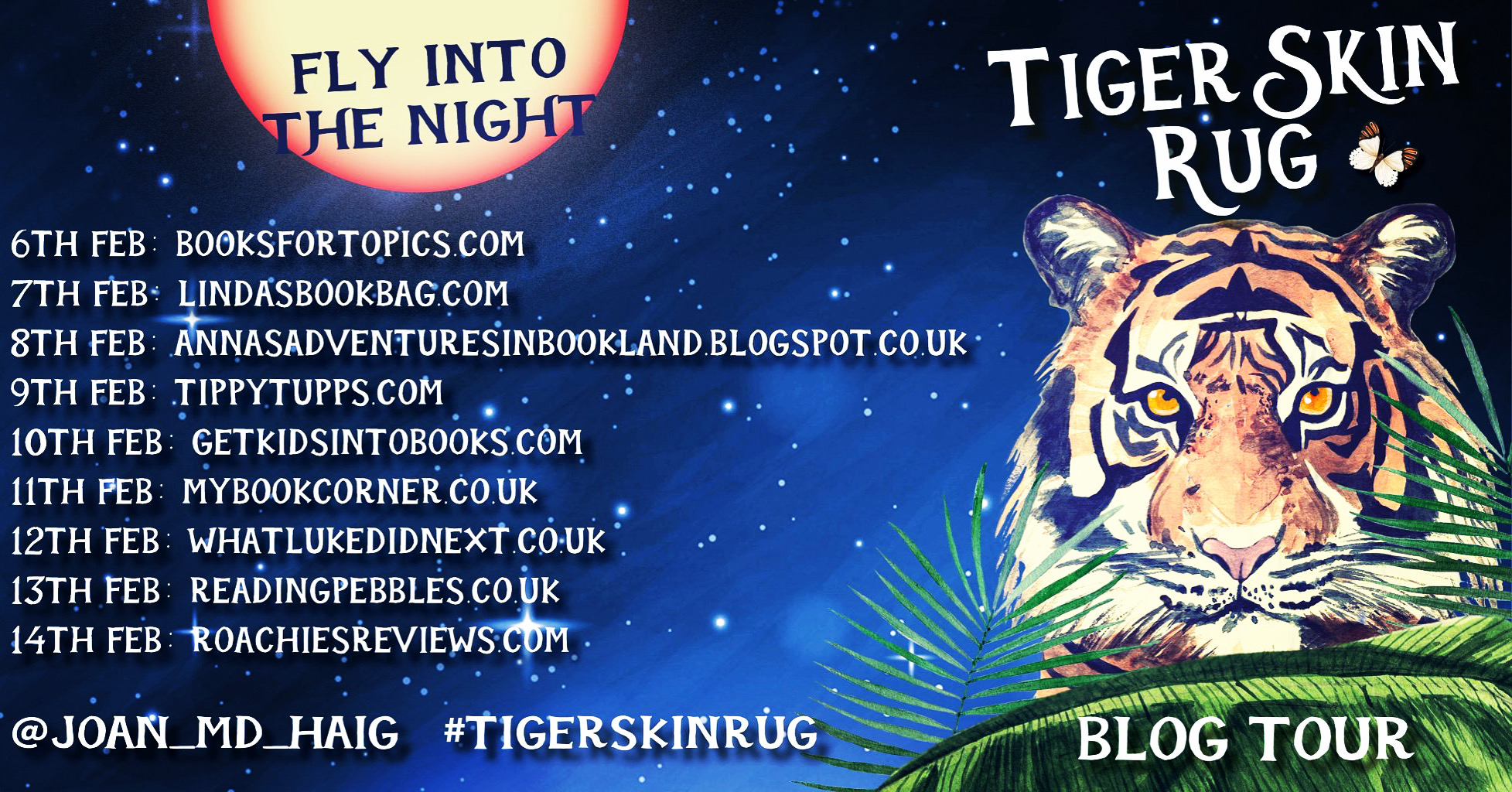
Today it’s my stop on the blog tour for this magical adventure story. You can read my full review here.
#SixforSunday
26 January 2020
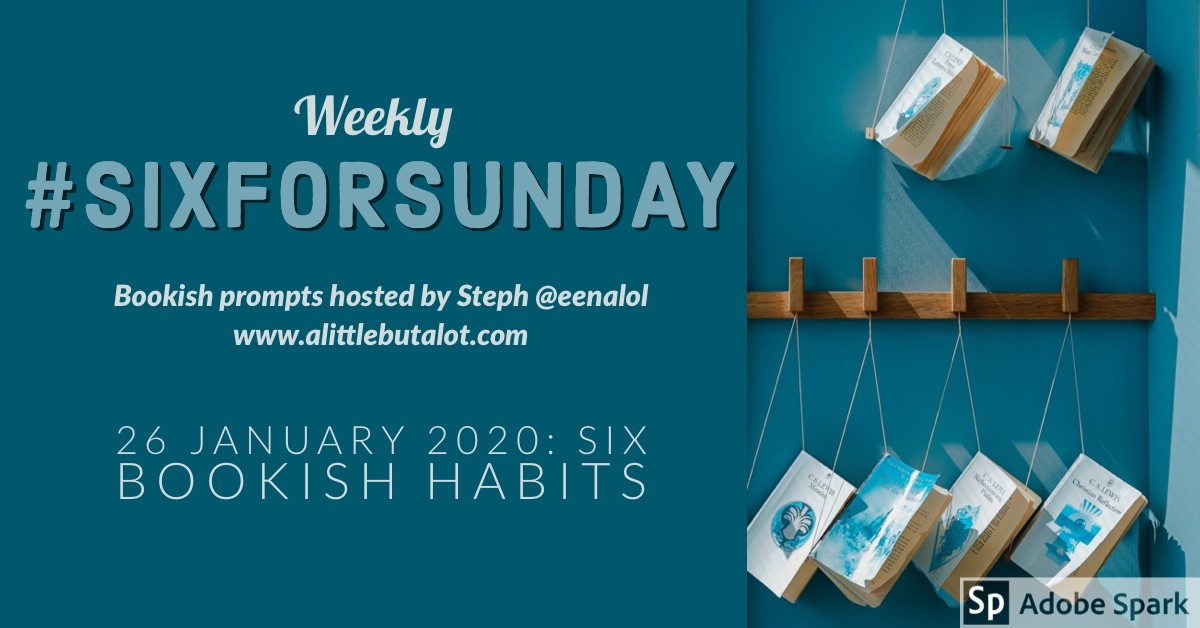
The theme for this week’s #SixforSunday is bookish habits. I think this is a really interesting one as I know that I’ve got lots of bookish behaviours and I’m guessing other readers do too. Here are mine:
- Keeping a book log Since 1992 I’ve kept a record in mini notebooks of all the chapter books I’ve read. There are no reviews, just the book title and author name. It’s like a diary and it’s lovely to look back through it from time to time.
- Using a bookmark I always use a bookmark when I read and have built up a great collection over the years.
- Visiting the library I was always at the library as a child and it’s a habit I have continued into adulthood. Now I have a son of my own, we go to our local library together a couple of times a month and always max out both of our library cards.
- Buying books or requesting review copies when I already have a huge TBR pile There are so many wonderful books getting published all the time that I just can’t resist getting more!
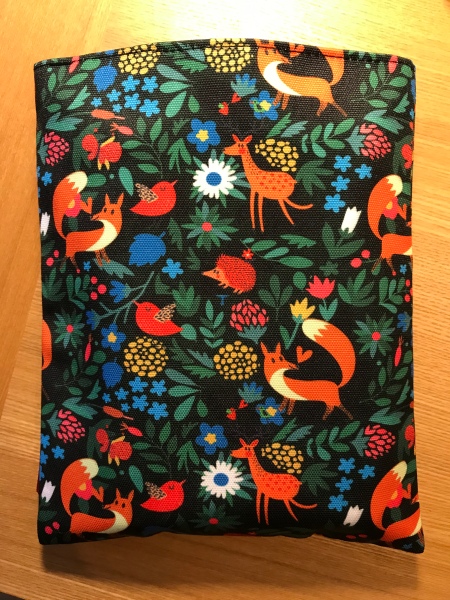 Always transporting my books in a protective plastic bag I like to keep my books pristine and hate the thought of them getting damaged. Recently I’ve upgraded from plastic bags and bought myself a gorgeous book sleeve with a lovely woodland design.
Always transporting my books in a protective plastic bag I like to keep my books pristine and hate the thought of them getting damaged. Recently I’ve upgraded from plastic bags and bought myself a gorgeous book sleeve with a lovely woodland design.-
Always checking out someone else’s bookshelves when I visit their home. Do we have any books in common? Are there any I might want to add to my wish list? How have they arranged their books?
WWW Wednesday
15 January 2020
#WWWWednesdays is a meme hosted by Taking on a World of Words. Each week it asks these three questions:
What are you currently reading?
What did you recently finish reading?
What do you think you’ll read next?
Currently reading
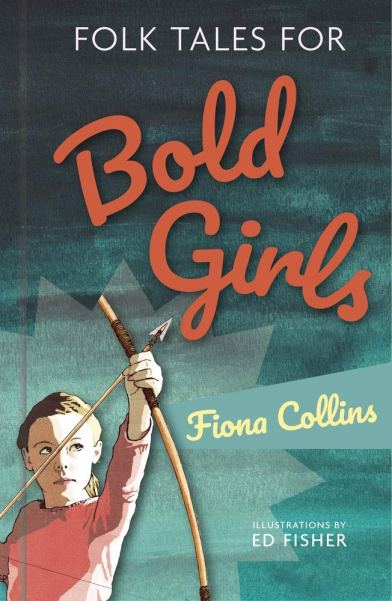 I’ve just started reading Folk Tales for Bold Girls, a collection of short stories from across the northern hemisphere. Each tale centres around at least one female protagonist. I was drawn to the book because I enjoy stories that give females a voice and I was interested to see if there was going to be any subversion of the traditional folk tale genre. As yet, the stories aren’t as radical as I’d hoped for but they are engaging and enjoyable nonetheless.
I’ve just started reading Folk Tales for Bold Girls, a collection of short stories from across the northern hemisphere. Each tale centres around at least one female protagonist. I was drawn to the book because I enjoy stories that give females a voice and I was interested to see if there was going to be any subversion of the traditional folk tale genre. As yet, the stories aren’t as radical as I’d hoped for but they are engaging and enjoyable nonetheless.
Just finished reading
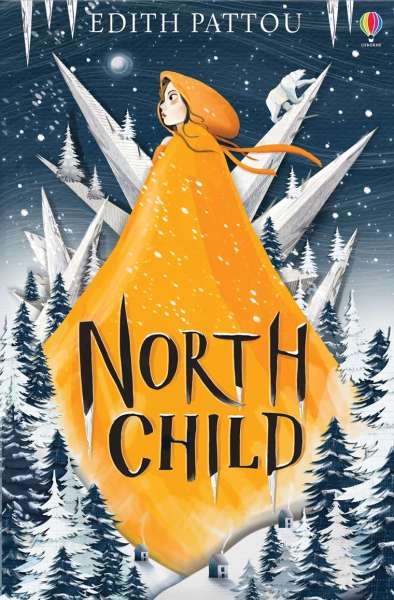 I’ve just finished reading North Child and I completely loved it! It’s an epic adventure set in the frozen north. Edith Pattou has adapted the Norwegian folk tale East of the Sun, West of the Moon and fleshed out the story with additional characters and detail. It’s the story of Rose, a young woman with a desire to travel and explore, and the White Bear she leaves her home with. It’s full of danger, excitement and magic; I was gripped.
I’ve just finished reading North Child and I completely loved it! It’s an epic adventure set in the frozen north. Edith Pattou has adapted the Norwegian folk tale East of the Sun, West of the Moon and fleshed out the story with additional characters and detail. It’s the story of Rose, a young woman with a desire to travel and explore, and the White Bear she leaves her home with. It’s full of danger, excitement and magic; I was gripped.
Reading next
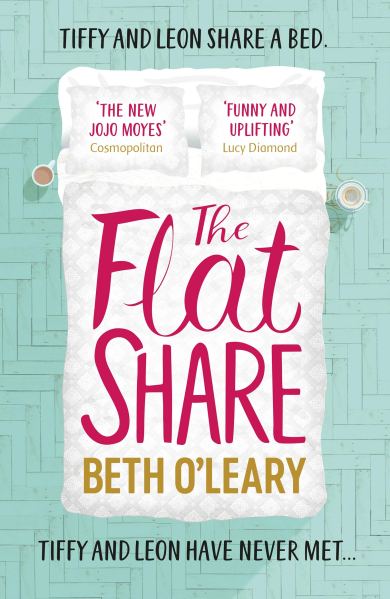 The book I’ll be reading next is The Flat Share; I’ve just collected it from the library. It’s a book that’s been on my radar for quite some time and I’ve seen lots of great reviews for it on social media. Since starting my children’s book blog four years ago, I’ve predominantly read children’s books. I made it one of my #SixforSunday bookish resolutions for 2020 to read some more adult fiction and so I’m starting with this.
The book I’ll be reading next is The Flat Share; I’ve just collected it from the library. It’s a book that’s been on my radar for quite some time and I’ve seen lots of great reviews for it on social media. Since starting my children’s book blog four years ago, I’ve predominantly read children’s books. I made it one of my #SixforSunday bookish resolutions for 2020 to read some more adult fiction and so I’m starting with this.
#SixforSunday book prompts
12 January 2020
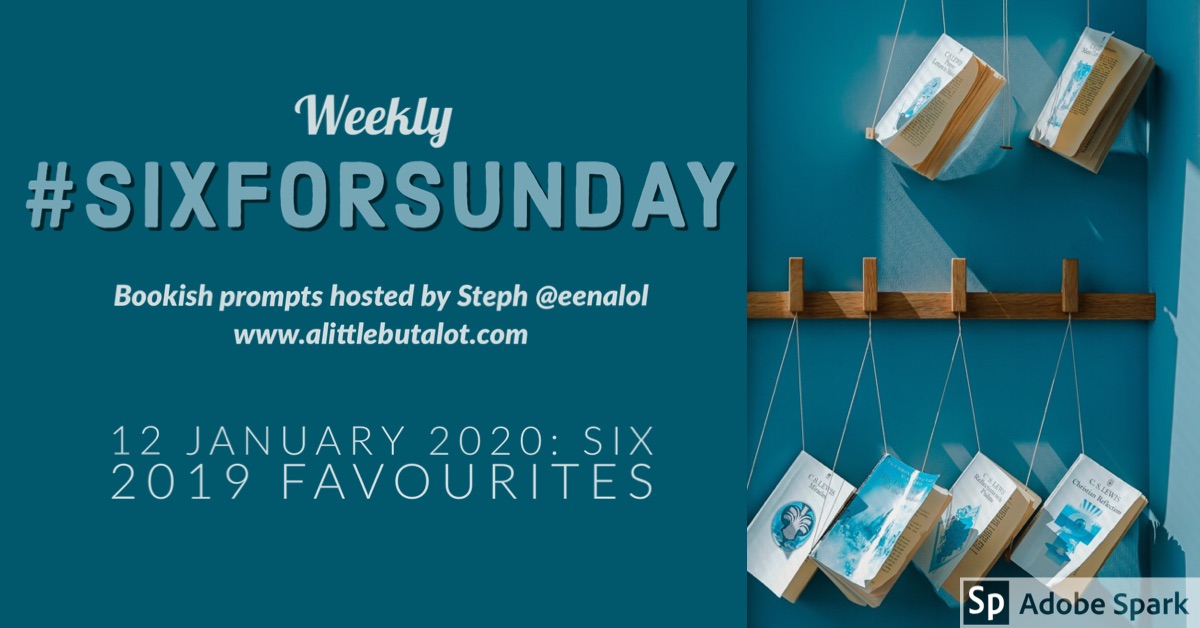
This week’s prompt for #SixforSunday is your six favourite books of 2019. I read so many great books last year but I’ve narrowed it down to my six favourites. Here are my choices:
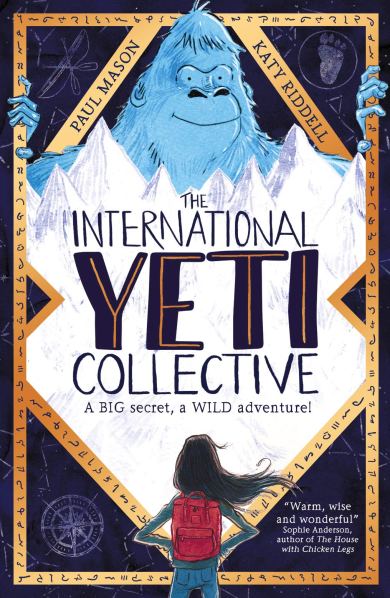 The International Yeti Collective is a wonderful middle grade adventure set in the Himalayan Mountains. It’s a powerful and important book. At a time of devastating climate change, it will strike a chord with young readers only too aware of the fragility of their future. Read more about it here.
The International Yeti Collective is a wonderful middle grade adventure set in the Himalayan Mountains. It’s a powerful and important book. At a time of devastating climate change, it will strike a chord with young readers only too aware of the fragility of their future. Read more about it here.
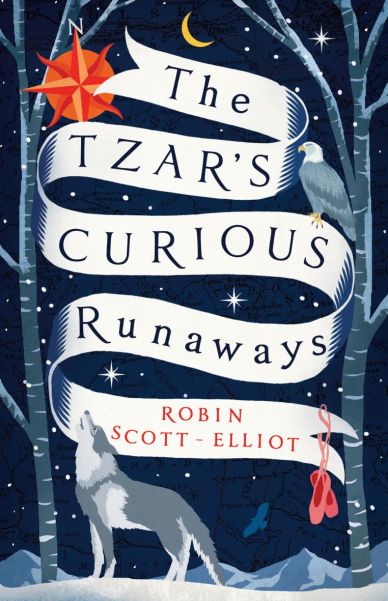 I absolutely loved The Tzar’s Curious Runaways. It’s set in Russia in the early 1700s and gives a fascinating insight into life at court at the time of Peter the Great. After escaping from court, the protagonists begin an epic adventure across the Russian steppe. It’s a gripping and suspenseful story. It’s also a celebration of friendship and a powerful example of inclusion and acceptance. Read my full review here.
I absolutely loved The Tzar’s Curious Runaways. It’s set in Russia in the early 1700s and gives a fascinating insight into life at court at the time of Peter the Great. After escaping from court, the protagonists begin an epic adventure across the Russian steppe. It’s a gripping and suspenseful story. It’s also a celebration of friendship and a powerful example of inclusion and acceptance. Read my full review here.
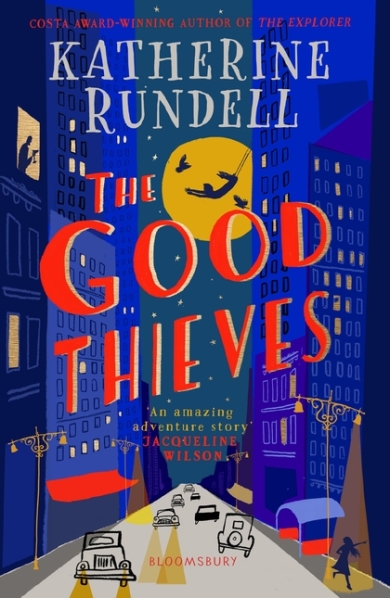 Ever since I read Rooftoppers, I’ve been a huge fan of Katherine Rundell. Her latest book, The Good Thieves, is another triumph. It’s set in 1920s New York and is an exciting, tense adventure – a real page-turner of a book. Here’s my review in full.
Ever since I read Rooftoppers, I’ve been a huge fan of Katherine Rundell. Her latest book, The Good Thieves, is another triumph. It’s set in 1920s New York and is an exciting, tense adventure – a real page-turner of a book. Here’s my review in full.
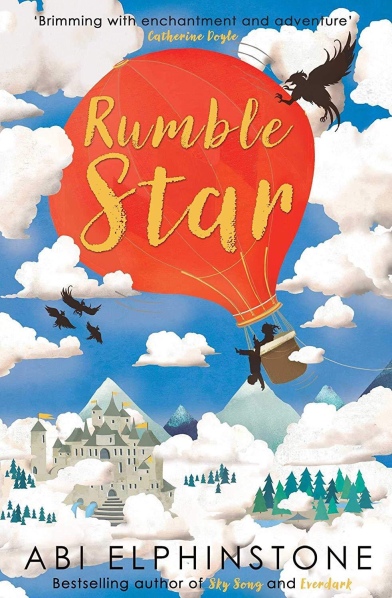 I thoroughly enjoyed Rumblestar; it’s a gripping, life-affirming book where loyalty, bravery and friendship triumph over evil. Take a closer look here.
I thoroughly enjoyed Rumblestar; it’s a gripping, life-affirming book where loyalty, bravery and friendship triumph over evil. Take a closer look here.
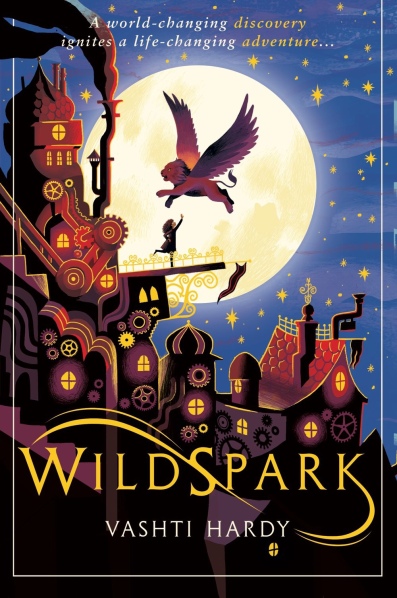 Wildspark is exciting, tense, thought-provoking and original. There are red herrings and unexpected twists. I really enjoyed it. Click here to find out more. The story ends poised for a sequel and I can’t wait to see what Prue and her friends will get up to next!
Wildspark is exciting, tense, thought-provoking and original. There are red herrings and unexpected twists. I really enjoyed it. Click here to find out more. The story ends poised for a sequel and I can’t wait to see what Prue and her friends will get up to next!
 A Pinch of Magic is a corker of a book! It’s got it all: adventure, mystery, magic and danger. Plus the Widdershins sisters – three of the best MG protagonists in years. A Pinch of Magic is incredibly exciting and packed with tension, especially as the story reaches its climax. You can read my full review here. The sequel, A Sprinkle of Sorcery, is published next month and it’s one of my most anticipated reads of the year.
A Pinch of Magic is a corker of a book! It’s got it all: adventure, mystery, magic and danger. Plus the Widdershins sisters – three of the best MG protagonists in years. A Pinch of Magic is incredibly exciting and packed with tension, especially as the story reaches its climax. You can read my full review here. The sequel, A Sprinkle of Sorcery, is published next month and it’s one of my most anticipated reads of the year.
#SixforSunday book prompts
5 January 2020
I’ve been following Steph’s #SixforSunday prompts for a while but never actually got round to joining in. Until now. Steph is a teacher and children’s book blogger – here’s her blog – and she suggests book themed prompts for every Sunday of the year. The first one for 2020 is six bookish resolutions. Here are mine:
- Get back into the habit of reading every night before bed. I find it way too easy to spend half an hour scrolling through social media on my phone when I could actually have been getting stuck into a book. I don’t always sleep that well and I think that swapping my phone for a book might really help with this.
- Read some books that have been written for adults. I absolutely love children’s books, especially MG fiction, and for the past couple of years have pretty much exclusively read children’s books. I’m probably missing out on some real book gems and so I’ve decided to read a few books for adults this year too.
- Interact more with other book bloggers. I want to get involved in more bookish conversations. I intend to comment more on other people’s blog posts and join in with blog linkups and book tags like this one.
- I want to post more on my bookstagram account. Recently, I think there’s been a shift away from book blogs towards Instagram and I don’t want to be left behind.
- I’d like to develop my book-related Pinterest account. I only post on here sporadically and I’d like to work on developing more content for it. I’m thinking of focusing on themed posts and bookish lists.
- I’m going to branch out a bit with the content on my blog. I mainly post individual book reviews and participate in blog tours. This year I’m going to write more themed posts where I highlight a number of different books in one post. I think this type of post might have a wider appeal.
The Laugh Out Loud 2020 Book Awards (Lollies)
Blog Tour
14 November 2019
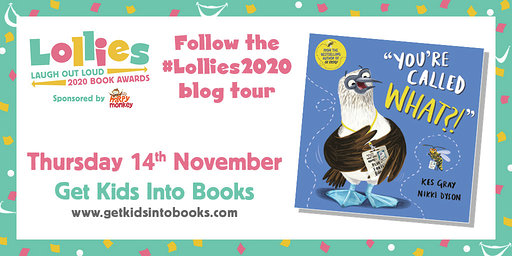
Everyone loves a silly name especially if it’s also vaguely rude. So what better premise for a picture book? You’re Called What?! is one of four picture books nominated for the Laugh Out Loud Book Awards (the Lollies) and it’s a huge hit with me and my three-year-old son. He finds it hilarious and calls it “the funny book”. Read more about it here. The Lollies celebrates the best and funniest children’s books in the UK and Ireland and is voted for entirely by children.
 The animals in You’re Called What?! are all completely fed up with their ridiculous names. Every time they introduce themselves they are met with laughter and incredulity. They are exasperated and have come to the Ministry of Silly Animal Names to change their names.
The animals in You’re Called What?! are all completely fed up with their ridiculous names. Every time they introduce themselves they are met with laughter and incredulity. They are exasperated and have come to the Ministry of Silly Animal Names to change their names.
Of all the laugh-out-loud names, our favourites are the Cockapoo, the Blue- Footed Booby and the Monkeyface Prickleback. Incredibly, these (and all the other animals in the book) actually do exist.
It’s prompted me to compile a list of other creatures with crazy names. Perhaps they’ll star in a sequel to You’re Called What?! In fact, we think we spotted a few of them in the queue at the Ministry of Silly Animal Names as un-named extras. Take a look at them below (by clicking on their names). Which one is your favourite?
Our Top 10 Silly Animal Names
6) Agra cadabra
10) Star-nosed mole
Voting is now open for the Lollies 2020 – it’s time to get reading and voting for your favourites! Click here to access the voting section on the Scholastic website.
The Lollies are awarded in three categories: picture books, books for 6-8 year-olds and books for 9-13 year-olds. Here are the shortlisted books in full:
Best Laugh Out Loud Picture Book
Baby’s First Bank Heist by Jim Whalley & Stephen Collins
Spyder by Matt Carr
Ten Fat Sausages by Michelle Robinson & Tor Freeman
You’re Called What?! by Kes Grey & Nikki Dyson
Best Laugh Out Loud Book for 6-8 Year-Olds
Bad Nana: Older Not Wiser by Sophy Henn
The Legend of Kevin by Philip Reeve & Sarah McIntyre
The Nothing to See Here Hotel by Steven Butler & Steven Lenton
The World’s Worst Children 3 by David Wallians & Tony Ross
Best Laugh Out Loud Book for 9-13 Year-Olds
Kid Normal and the Rogue Heroes by Greg James, Chris Smith & Erica Salcedo
I Bet I Can Make You Laugh by Joshua Seigal & Tim Wesson
I Swapped My Brother on the Internet by Jo Simmons & Nathan Reed
Planet Stan by Elaine Wickson & Chris Judge
Check out the other shortlisted titles by visiting the other stops on the tour.
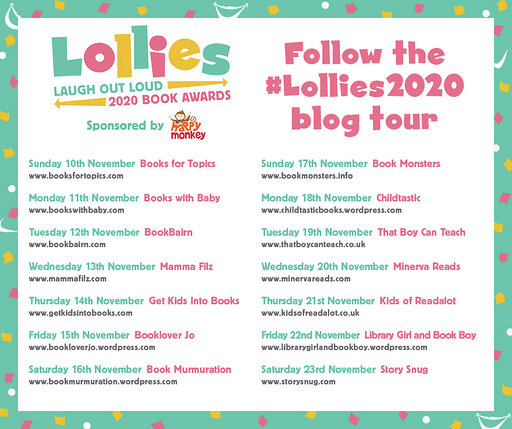
Don’t Feed the Troll Blog Tour
12 November 2019
 I’m delighted to welcome author John Hickman to my blog today. His latest book, Don’t Feed the Troll, tackles the issue of cyber bullying. You can find out more about the story and read my review here.
I’m delighted to welcome author John Hickman to my blog today. His latest book, Don’t Feed the Troll, tackles the issue of cyber bullying. You can find out more about the story and read my review here.
Get Kids into Books: Can you tell me a little bit about the book?
John: Jack really likes Chloe. She’s not like any other girl at school. But when Jack feels rejected by her, he does the unthinkable and becomes an online troll. But he soon finds himself in deep trouble, when an actual troll begins to stalk and insult him…
Get Kids into Books: What inspired you to write Don’t Feed The Troll?
John: There have been so many news stories about young celebrities and the abuse they have suffered online over recent years, and I know from experience – working as a social worker and in my own life, with my nieces – cyberbullying seems to be happening all the time. The thought of these “trolls” made me angry. How dare they say these terrible things. How dare they make young people feel awful about themselves. I wondered about these bullies – who were dishing out this abuse – and I questioned whether they’d say the things they said online in real life. My feeling was no. But what if they had no choice? What if their online antics caught up to them? The idea of an online troll getting stalked and abused by an actual troll then began to take shape…
Get Kids into Books: Do you think that schools have a responsibility to make students aware of the dangers of social media and cyberbullying? Or do you think it is a job for parents?
John: I think it’s everyone’s job – parents and schools, and I’d add the media into that as well. The internet and social media are such huge parts of our lives these days, it’s important young people have as much information as possible to look after themselves online.
Get Kids into Books: If you had to describe Jack in three words, what would those three words be?
John: Obsessive. Insecure. Smart.
Get Kids into Books: What would your advice be to someone going through similar situations to Jack, Chloe, and Isaac?
John: My advice to Chloe and Isaac, in terms of online trolling, would be not to give it any attention. While I know that can be easier said than done, if you don’t give trolls what they want – the attention – in most cases they’ll just give up. Starve them of that and they’ll wither away, much like Troll in my book. However, I think if anyone finds themselves subject to any sort of bullying, they should speak up and seek out help. It’s something most people have been through – myself included – so you’re not alone and people will understand. My advice to Jack would be don’t do it. Don’t be a troll. Would you say these things in real life, without the anonymity of the internet? No. You wouldn’t.
Get Kids into Books: If you could tell your younger self anything, what would it be?
John: Everything will work out! When I was young, everything seemed like such a big deal. And to be fair, at the time, maybe it was – because that was my life. But the older you get, and the more you see of the world, the more you realise that things will be okay. The things that are troubling you when you’re twelve and thirteen, you’ll look back at – and hopefully – laugh about. Of course, some kids do go through some awful stuff too – as did I growing up – so it’s not to underplay that. But for those kids, I guess it’s worth knowing, where you come from and the things that happen – they don’t have to define you. You can achieve the things you want. You’ll need to work hard, be tough and never give up – but you will get there.
Get Kids into Books: What is your favourite childhood book?
John: I read loads when I was a kid and I was a big fan of Roald Dahl books, like everyone else, and loved Fantastic Mr Fox. I read a lot of factual books and I was obsessed with robots and dinosaurs. I loved comics too – The Beano, Dandy, all that stuff, as well as Marvel and 2000 AD. I always wanted to be Flat Stanley from the Flat Stanley books. No idea why really, maybe I just liked the idea of being posted through letterboxes!
Get Kids into Books: What is the most difficult part of your writing process and why?
John: Making a living from it! That might sound like a joke, but it’s true. Making writing your day job takes a lot of hard work and sacrifices. It’s taken me years and I’m only just about there now!
Get Kids into Books: Describe your writing space.
John: I actually have an office at home, that’s filled with loads of retro gaming memorabilia – something I’m quite a fan of. However, I don’t work in there very often, and end up writing on the sofa most days, with my dog, Belle, sitting next to me. She’s actually sitting beside me as I write these very words!
Get Kids into Books: You’ve written a great number of things. Which piece is your most favourite and why?
John: That’s a tough question. I’m always really excited about my current project – whatever that is – which I guess you have to be. It’s hard to get stuff finished if it doesn’t excite you! As well as books, I write a lot of scripts for film and TV. One project I’m really proud of was a script called The Things. It was a children’s TV show about two care experienced siblings caught up in alien invasion, and won the BAFTA Rocliffe writing competition which, in turn, got me an agent and kick-started my screen–writing career. In terms of my books, The Football Trials were a series of books aimed at teens with reading difficulties. I’ve had several young people tell me the books really helped get them reading, which is something that makes me immensely proud.
Get Kids into Books: Thanks so much for stopping by my blog today.
Black Water Blog Tour
7 November 2019
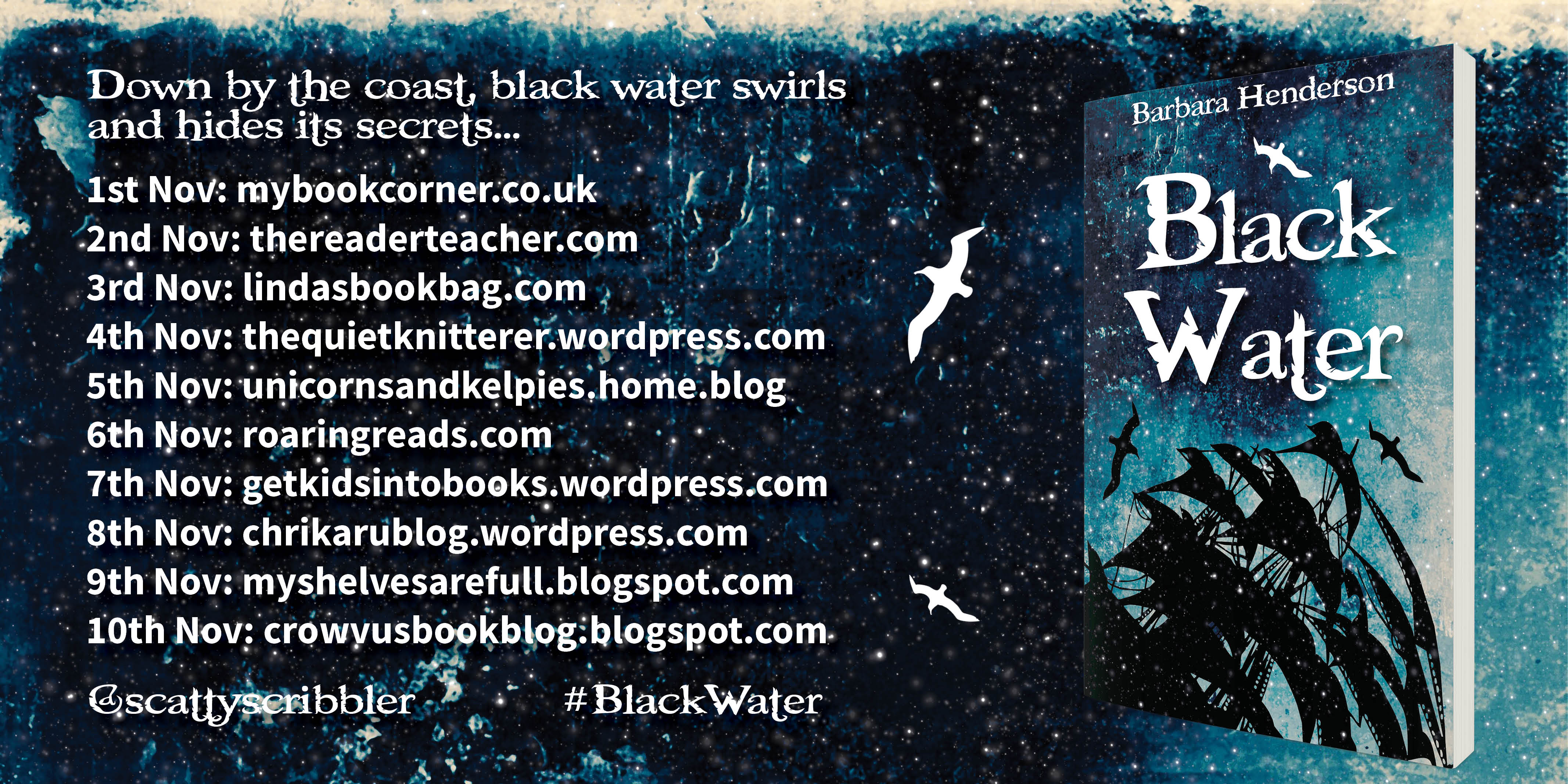
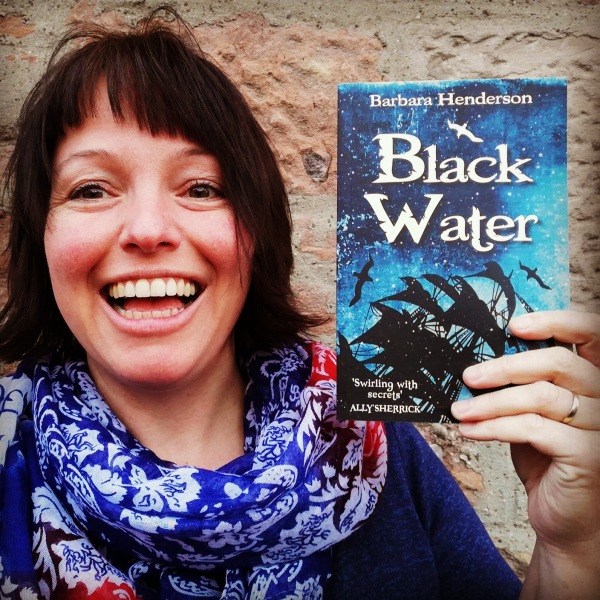 I’m delighted to welcome author Barbara Henderson back to my blog. Her latest historical novella Black Water is a fast-paced adventure full of peril and tension. She talked to me about the importance of pace in children’s fiction.
I’m delighted to welcome author Barbara Henderson back to my blog. Her latest historical novella Black Water is a fast-paced adventure full of peril and tension. She talked to me about the importance of pace in children’s fiction.
Barbara Henderson: I vividly remember studying Thomas Hardy as a teenager. Endless pages at the beginning of his classic novel simply described the lush English countryside: rolling meadows, cows, villages and the weather. Nothing happened at all.
Of course, Hardy’s novel wasn’t intended for young readers, but even the classic children’s books are a little slow to get started by comparison with their modern equivalents, aren’t they? We notice the difference when delving into the likes of The Hobbit and The Water Babies. Nowadays, we value pace in our stories, alongside a distinctive voice. We place less value on beautiful description, for example. Why is that, I wonder? Is it because reading books has to compete with all sorts of other fast-paced activities, and we are simply not used to waiting anymore? Is it because competition in the publishing industry is so fierce now, with writing, editing and submitting eased by technology, that only the paciest make it through?
One thing is certain, a child has always loved a pacey story; one where things actually happen. A bit of jeopardy and peril never goes amiss either. I’ll tell you a secret: I’m a bit of a fan of the wee chapter. I’m also rather fond of the wee sentence – these style choices lend themselves to maintaining the story’s pace, and for a children’s writer, this is especially crucial. Adults cut their books a bit more slack and don’t typically give up until around 50 pages in or so. A kid, given a choice, will not turn the first page if he or she isn’t interested to read on.
Take Black Water, my new novella for 8-12 year olds. As it is so short (only seven chapters) it was imperative to keep youngster’s interest. So yes, there are cliff hangers all over the place, not just at the end of those chapters. I want readers to be hooked as soon as possible, so we begin out on the water in the early hours of a February morning in 1792. It is pitch black. My hero is in a boat with his armed father in an operation to intercept a small smuggling boat. Their informer may have betrayed them, or he may not. Shots ring out, someone goes overboard, a confrontation ensues, someone flees – good, good, good. Plenty of pace here.
Now, the whole book couldn’t possibly maintain this type of intensity. As an editor said to me early in my writing career, you need to ‘manage your reader’s feelings’. It means that after an intense chapter like this, your reader will need a breather. Fair enough. I send my hero and his father home for a domestic scene for a page or two. But then the message arrives: there is a huge smuggling vessel, stranded nearby. Despite having been out all night, they will have to leave again. For a bit of small-scale drama, I have my hero Henry disobey an instruction and seek out an informer in another confrontation to maintain the reader’s interest. From then on, it’s haste and jeopardy and peril all the way till the end, mainly because the real events which are featured in Black Water demand it. I like to think that readers get a breather from time to time though. I describe the characters’ journeys, for example: riding along the coast, staying the night in an inn etc. I also hope I maintain the pace by introducing the reader to interesting new characters including the poet Robert Burns who actually took part in the real events I describe in Black Water. But essentially, this is an adventure story, set in an age where risks were high.
Fingers crossed that today’s readers will enjoy imagining themselves in Henry’s place, riding at speed, overhearing conspiracies, dodging quicksand and cannon-fire and wading into icy waters with a flintlock pistol held high over his head. I make no apology for squeezing all of this into my wee book.
Maybe I just love a good pacey story myself!
Fantastically Fiendish Fiction
🎃 Halloween 2019 🎃
The nights are drawing in. Halloween is just a couple of days away. It’s the perfect time of year for a spooky story. Here’s my round up of some recent fiction that will have you cowering under the covers.
 For older readers ready for a grisly read, look no further than The Dead World of Lanthorne Ghules. Set in a dingy, grey world where the inhabitants have a taste for rotting flesh, this is a tense and chilling tale that’s full of terror. Read my full review here.
For older readers ready for a grisly read, look no further than The Dead World of Lanthorne Ghules. Set in a dingy, grey world where the inhabitants have a taste for rotting flesh, this is a tense and chilling tale that’s full of terror. Read my full review here.
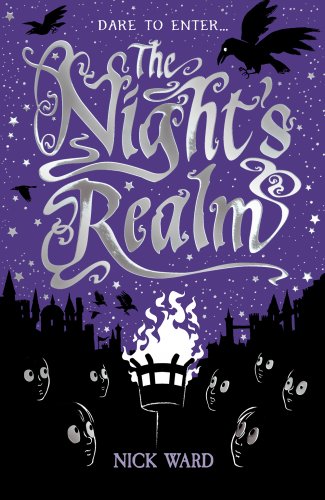 Another story that’s the stuff of nightmares is The Night’s Realm. Imagine being trapped in a world that’s populated by the creatures from your most terrifying dreams. This becomes reality for Billy as he’s plunged into a world of darkness where he must face his worse fears head on. Click here to find out more.
Another story that’s the stuff of nightmares is The Night’s Realm. Imagine being trapped in a world that’s populated by the creatures from your most terrifying dreams. This becomes reality for Billy as he’s plunged into a world of darkness where he must face his worse fears head on. Click here to find out more.
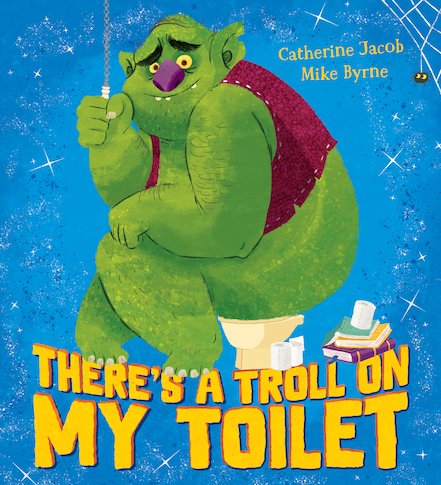 For younger readers, my three-year-old son and I can recommend three picture books which between them have a terrific cast of Halloween characters. To lighten the mood there’s the laugh out loud funny There’s a Troll on My Toilet. From stinky trolls to vampires and zombies, everyone’s turned up to party in this book. Read more about it here.
For younger readers, my three-year-old son and I can recommend three picture books which between them have a terrific cast of Halloween characters. To lighten the mood there’s the laugh out loud funny There’s a Troll on My Toilet. From stinky trolls to vampires and zombies, everyone’s turned up to party in this book. Read more about it here.
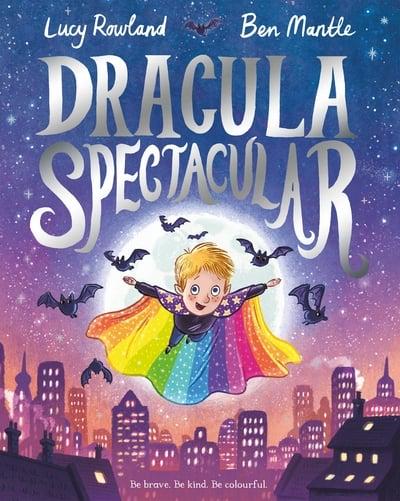 For a gorgeous story about having the courage to be yourself, we loved Dracula Spectacular. Dracula Boy is more giggles and glitter than evil villain. Will he dare to be different? Here’s my review in full.
For a gorgeous story about having the courage to be yourself, we loved Dracula Spectacular. Dracula Boy is more giggles and glitter than evil villain. Will he dare to be different? Here’s my review in full.
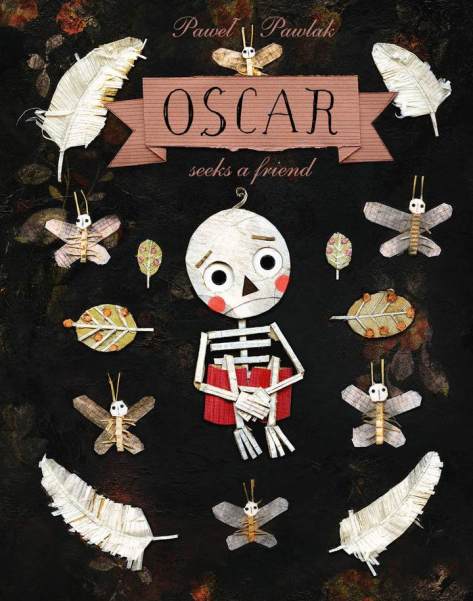 Finally, if you want a Halloween character without the chills, meet Oscar the skeleton. Quite possibly the most adorable skeleton ever. All he wants is a friend. Oscar seeks a friend is a stand out picture book with beautifully original illustrations and a heartwarming story. Take a closer look here.
Finally, if you want a Halloween character without the chills, meet Oscar the skeleton. Quite possibly the most adorable skeleton ever. All he wants is a friend. Oscar seeks a friend is a stand out picture book with beautifully original illustrations and a heartwarming story. Take a closer look here.
The Mist Monster Blog Tour
21 October 2019
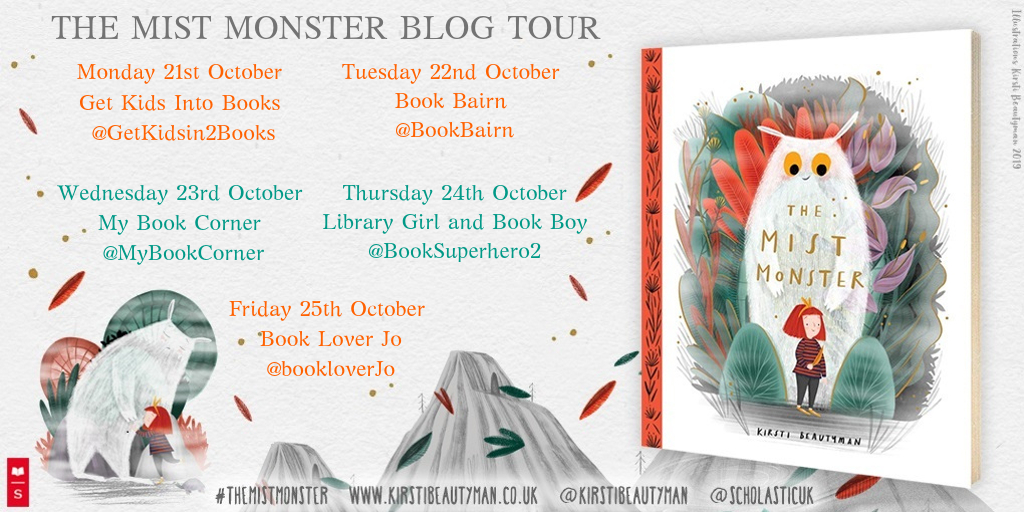
 I’m delighted to welcome author and illustrator, Kirsti Beautyman, to my blog today. The Mist Monster is the first book that Kirsti has written, as well as illustrated. It’s a beautiful story of friendship. Read my full review here.
I’m delighted to welcome author and illustrator, Kirsti Beautyman, to my blog today. The Mist Monster is the first book that Kirsti has written, as well as illustrated. It’s a beautiful story of friendship. Read my full review here.
Kirsti has joined me today to talk about the initial ideas for the story.
Kirsti: After I first graduated in 2016, I had this idea for a story book with a brave and adventurous little girl, and a monster made of mist in a forest. I decided to apply to the Picture Hooks Mentorship Scheme as I really had very little idea what I was doing. I knew I would like to write and illustrate a children’s book but didn’t have the first clue how to start or adapt my illustrations from being used for screen printing (which I spent most of my time in university doing) to illustrating for children. These images were my initial colour draft that I applied to the Picture Hooks Scheme with, and they are the very beginning of Penny and Morris’s creation!
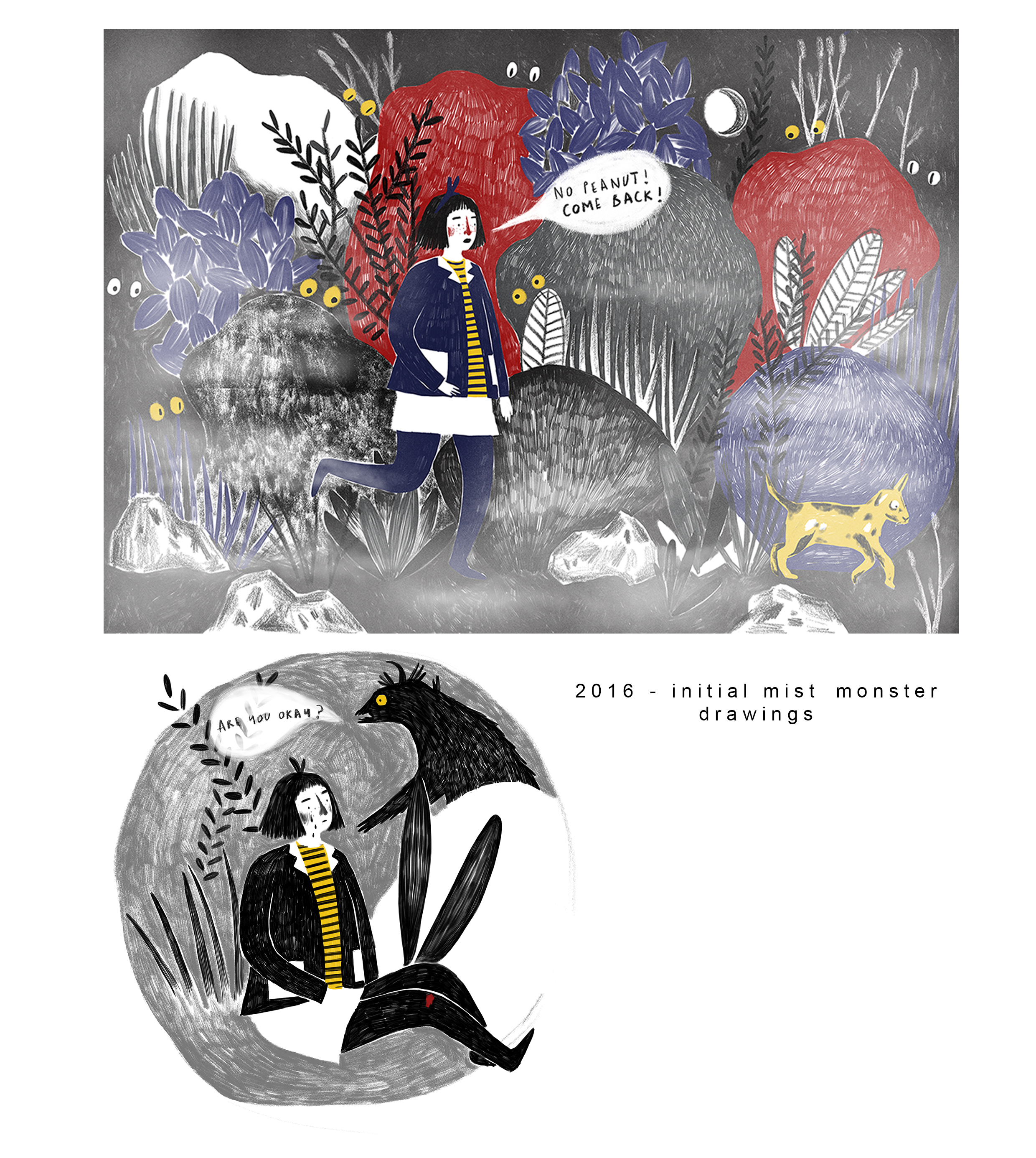
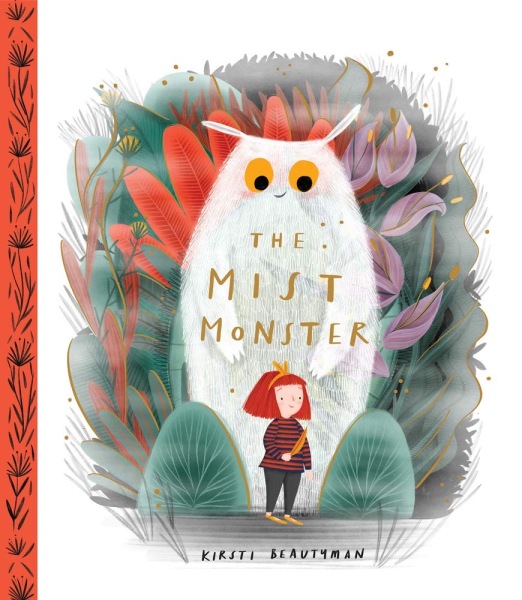 Get Kids into Books: Wow! Thanks for sharing these drawings, Kirsti. Morris has changed loads since his inception. Penny seems quite a bit older in your original drawings too, but you kept the same hairstyle and the stripy top. It’s fascinating to see how your ideas evolved. Thank you.
Get Kids into Books: Wow! Thanks for sharing these drawings, Kirsti. Morris has changed loads since his inception. Penny seems quite a bit older in your original drawings too, but you kept the same hairstyle and the stripy top. It’s fascinating to see how your ideas evolved. Thank you.
The International Yeti Collective Blog Tour
17 October 2019
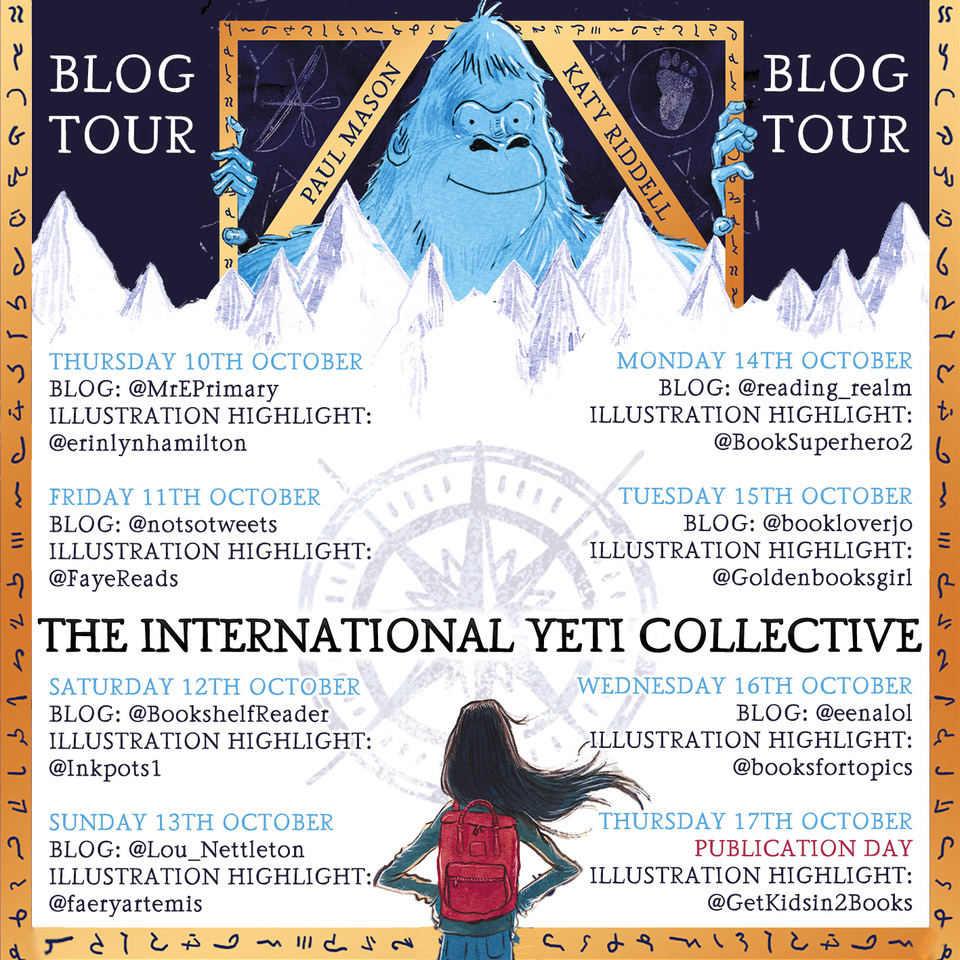
Today it’s my stop on the blog tour for this terrific middle great adventure with a powerful environmental message. The International Yeti Collective is published today. You can read my review here. The book is written by Paul Mason and illustrated by Katy Riddell. I’m delighted to be able to share one of Katy’s beautiful illustrations from The International Yeti Collective here on my blog.
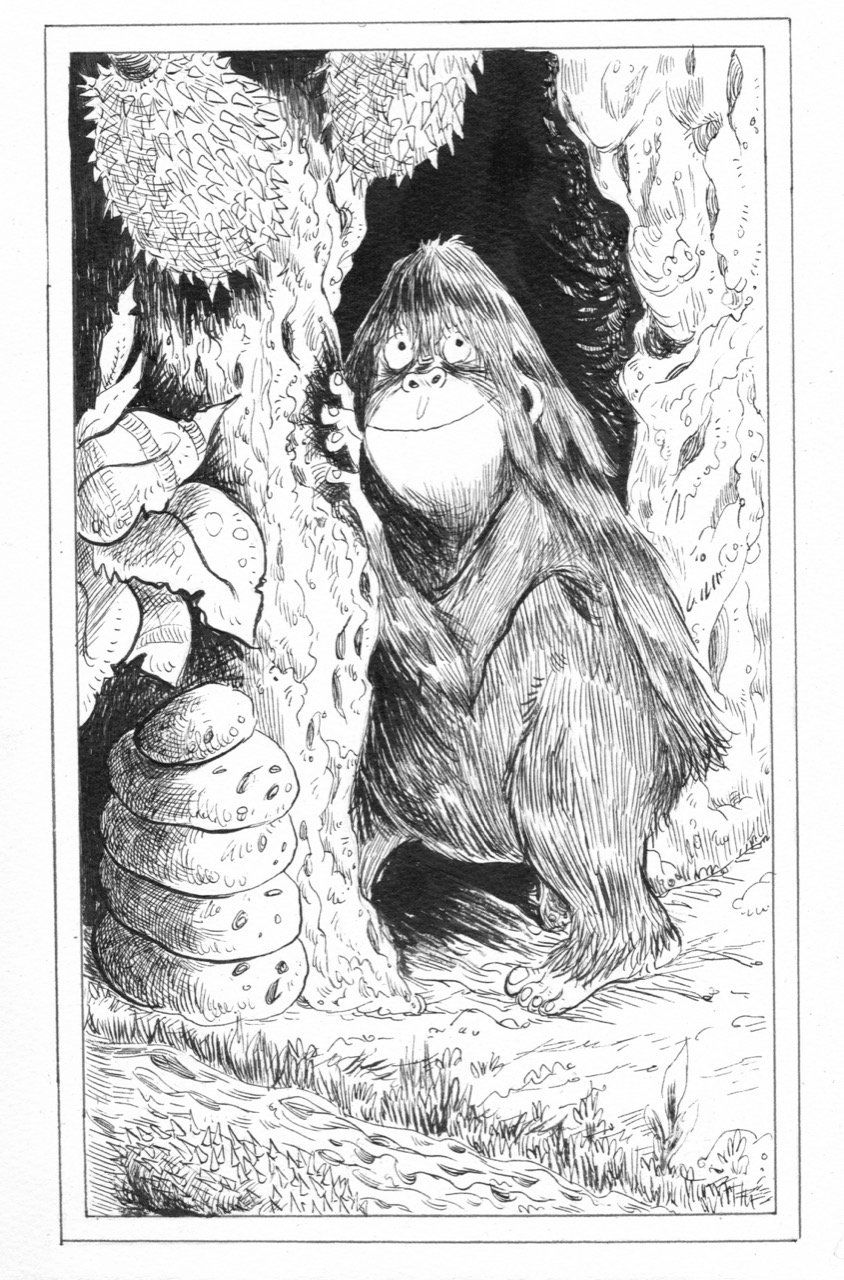
You’re Strong With Me Blog Tour
3 October 2019
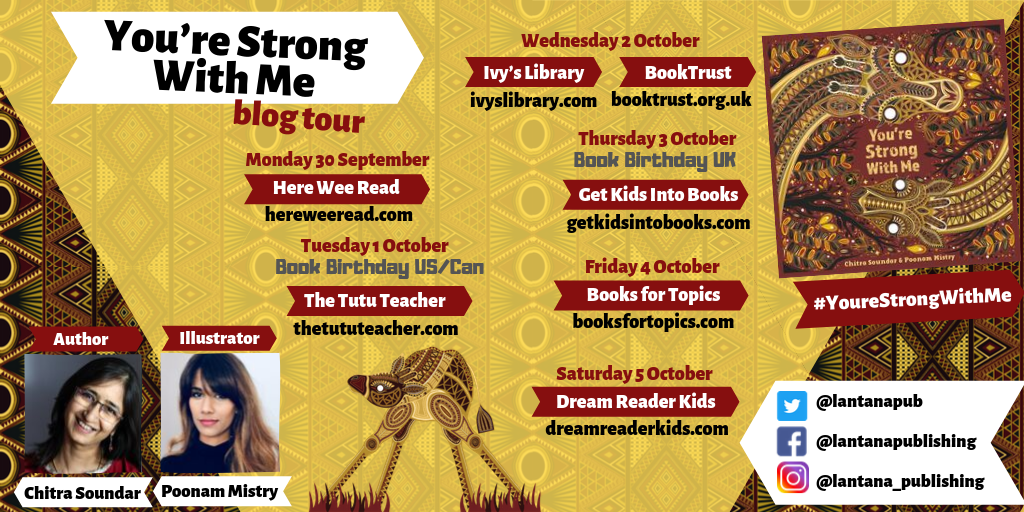
Today I’m delighted to welcome author Chitra Soundar to my blog. Her latest picture book, You’re Strong With Me, is published in the UK today. You can read my review here. Here Chitra talks to me about the central theme of the book: how children learn from their parents.
 Chitra: You’re Strong With Me is a story about a baby giraffe learning more about her habitat. She learns from her mother and she relies on her mother to keep her safe, until she’s ready to be on her own.
Chitra: You’re Strong With Me is a story about a baby giraffe learning more about her habitat. She learns from her mother and she relies on her mother to keep her safe, until she’s ready to be on her own.
Children at a young age want to do things on their own – be it tying their shoelaces to jumping off high walls or getting ready for bed. But one thing is for sure, they do love learning from their parents. Often children learn to copy and repeat gestures and phrases from their parents and that is part of their learning.
In You’re Strong With Me, the baby giraffe has to learn a lot of new skills before she can leave the herd:
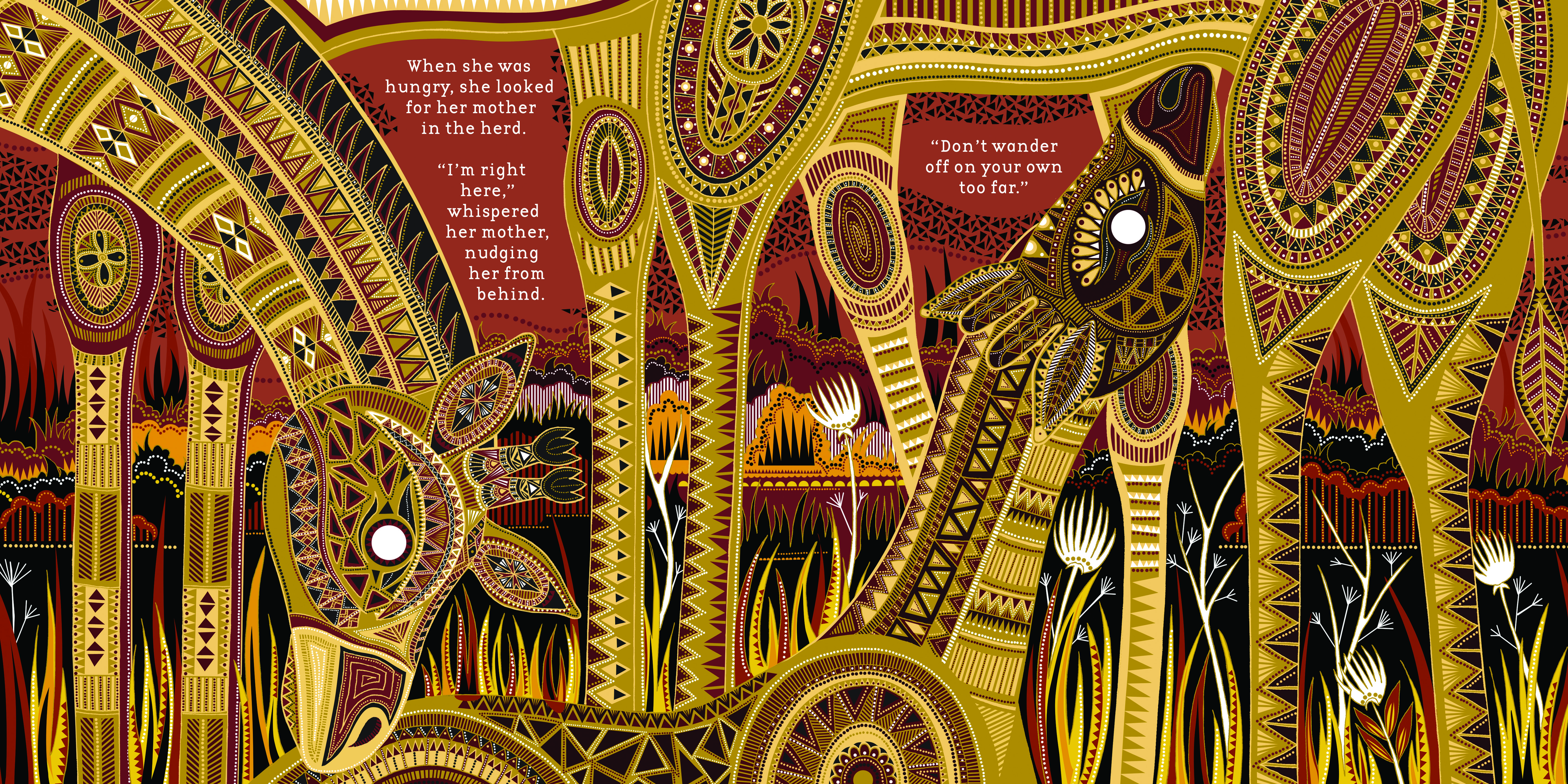
As children read through this text, I’m hoping parents and children will be inspired to talk about things they learn from each other. It will be great for parents to find out what are the things children have learnt to do on their own – maybe eating on their own or putting their toys away. And when do they have to rely on their parents to guide them – like crossing a road or riding a bike.
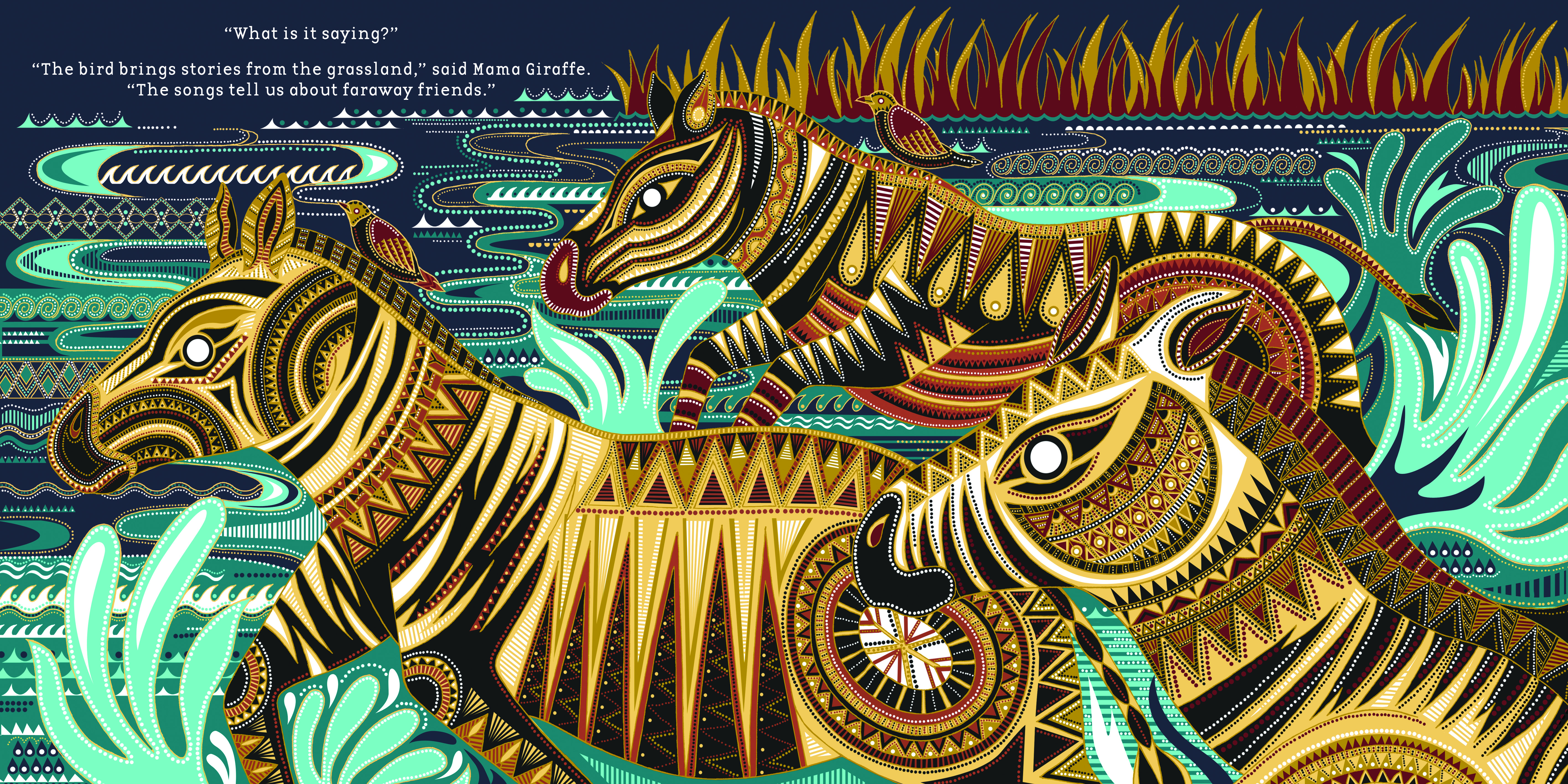
The art in this book has been lovingly created by Poonam Mistry. The patterns and colours evoke the earthy colours of the land where giraffes live. I hope it will be fun for the children to spot the tiger, the beetles, the zebras and the fishes as they read the story.
Guardians of Magic Blog Tour
15 September 2019
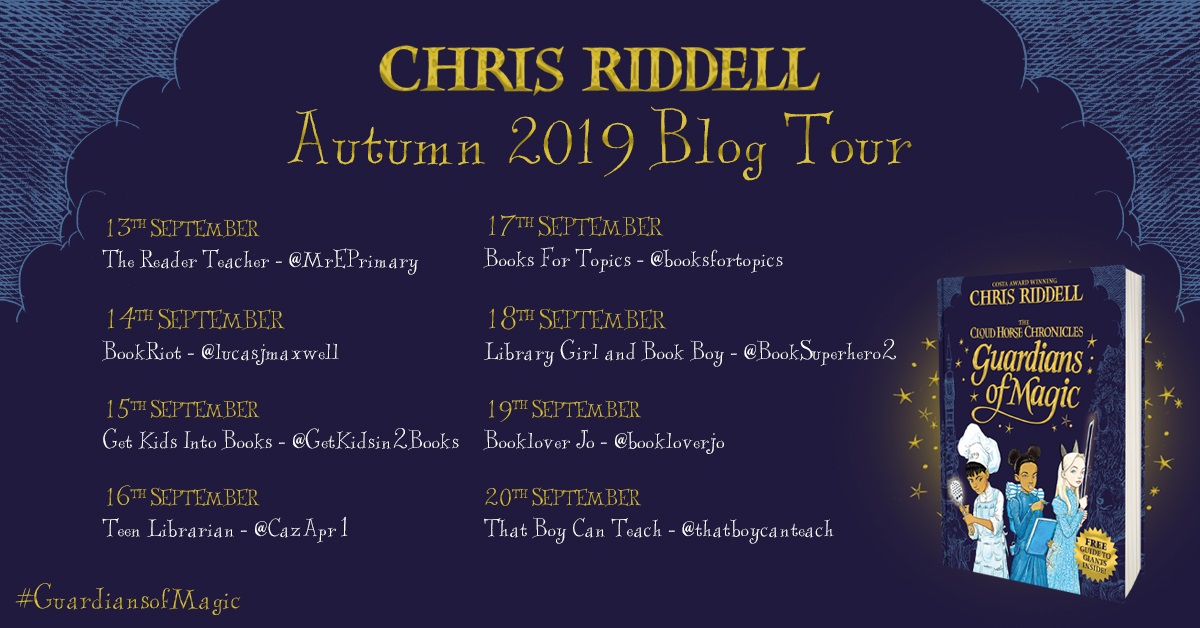
Guardians of Magic is the first book in a new fantasy series written and illustrated by Chris Riddell. It’s set in the kingdom of Thrynne, a place where fairy tales misbehave and magic is forbidden. You can read my full review here.
50th Anniversary of the First Moon Landing
July 2019

To coincide with the 50th anniversary of the Apollo 11 mission, I have spent July reviewing books about space travel and the moon. Here’s a round-up of my favourites. (Click on the italicised book titles to read my full reviews.)
In honour of the historic event, lots of terrific new non-fiction titles have been published. Pop-up Moon is a fascinating book with incredibly impressive pop-up pages. It’s bursting with different information about the moon. For slightly younger readers, there’s The Big Beyond which is written in rhyme. It’s full of awe and wonder about space flight. For a really comprehensive book about the history of flight, look no further than Balloon to the Moon. It’s a celebration of centuries of innovation, technology and endeavour.
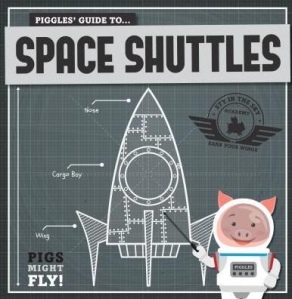 Another factual book that I’ve enjoyed, Piggles’ Guide to Space Shuttles, was published a couple of years ago. It’s pitched perfectly for the school market and would suit Key Stage 1 in particular. It gives really clear child-friendly explanations about space shuttles and how they work.
Another factual book that I’ve enjoyed, Piggles’ Guide to Space Shuttles, was published a couple of years ago. It’s pitched perfectly for the school market and would suit Key Stage 1 in particular. It gives really clear child-friendly explanations about space shuttles and how they work.
There are some gorgeous picture books about space travel too. It turns out that it’s not just humans who’ve landed on the moon… In Molly’s Moon Mission an ambitious young moth makes it there too. And there’s Armstrong the mole who manages to touch down on the moon’s surface in Rocketmole.
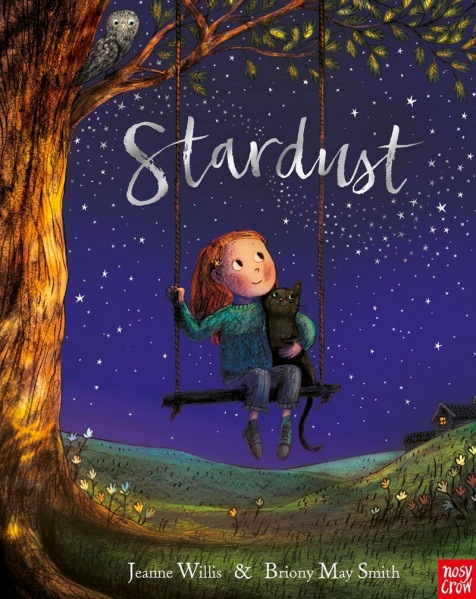 Stardust is another super story about self-belief and following your dreams; in it a young girl with a fascination for the stars grows up to be an astronaut.
Stardust is another super story about self-belief and following your dreams; in it a young girl with a fascination for the stars grows up to be an astronaut.
Sam, my young son, and I have also been enjoying reading picture books where the moon, with its quiet beauty, almost seems like a character itself. In these books, the descriptions of the moon are wonderfully poetic and lyrical. The whole swamp is bathed in brilliant moonlight as frog and his friends make music in the beautifully atmospheric In the Swamp by the Light of the Moon. Britta Teckentrup has long been one of our favourite illustrators and with Moon she’s created a stunning picture book which fills you with awe as you gaze upon the magical moonlit scenes from around the world. We also marvelled at the brilliant moon gleaming from the pages in Daddy Frog and the Moon.

Stories about the moon naturally lend themselves to being read at bedtime. Here are three that we’ve loved. One Moonlit Night is a gorgeous dream sequence narrative with elaborate pop-up pages. Luna and the Moon Rabbit is a magical bedtime tale with beautiful Japanese influences. Goodnight Baby Moon is a story that unfolds with the changing faces of the moon.
The Adventures of Harry Stevenson Blog Tour
22 June 2019
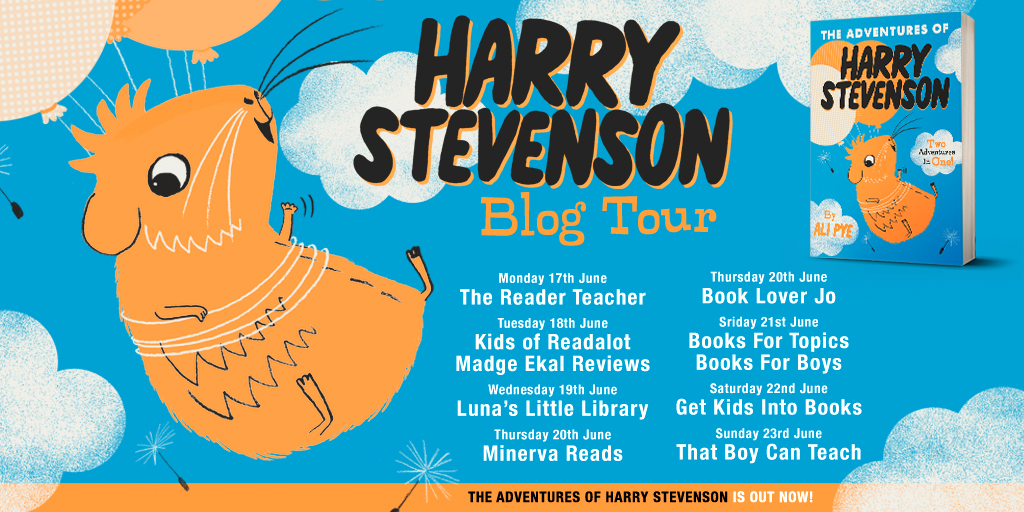
 I’m delighted to welcome author and illustrator Ali Pye to my blog today. Ali has written and illustrated a number of picture books, including You Can Never Run Out of Love and Rosie Is My Best Friend. The Adventures of Harry Stevenson is her first fiction series and was inspired by a real-life guinea pig (who turned out to be a girl and was re-named Harriet Stevenson). I loved The Adventures of Harry Stevenson (click here to read my review).
I’m delighted to welcome author and illustrator Ali Pye to my blog today. Ali has written and illustrated a number of picture books, including You Can Never Run Out of Love and Rosie Is My Best Friend. The Adventures of Harry Stevenson is her first fiction series and was inspired by a real-life guinea pig (who turned out to be a girl and was re-named Harriet Stevenson). I loved The Adventures of Harry Stevenson (click here to read my review).
Get Kids into Books: Hi Ali, thanks for joining me on my blog today. Can you introduce us to Harry?
Ali: Hi Rachel, Harry Stevenson is a plump and very ordinary-looking ginger guinea pig, who just wants quite a life. Unfortunately for Harry though, he’s very greedy and this leads him into all sorts of escapades.
Harry is based on all the guinea pigs I’ve kept over the years, and his name even comes from one of them. When I first got guinea pigs ‘for my children’, they were really into Harry Potter and Steve Backshall’s ‘Deadly 60’ programme on TV. They couldn’t decide which name to use, so we combined the two.
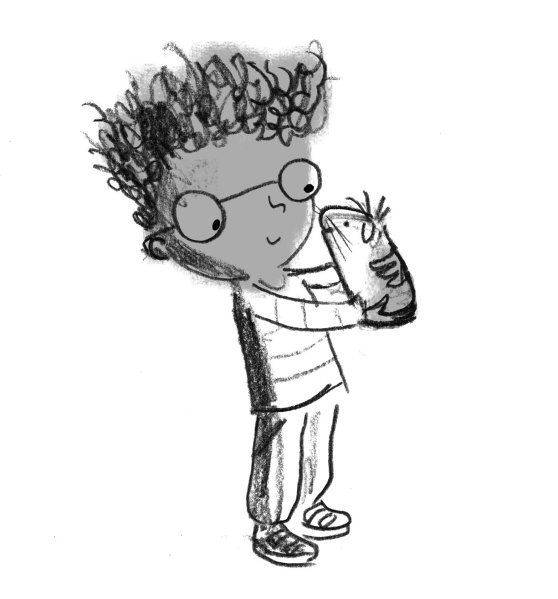 From the start I wanted Harry to have a very close relationship with his owner – or rather friend – seven-year-old Billy Smith. Here is one of the very first drawings I sketched out.
From the start I wanted Harry to have a very close relationship with his owner – or rather friend – seven-year-old Billy Smith. Here is one of the very first drawings I sketched out.
Billy and Harry have a mutual love and respect for each other. I’ve watched my children grow up with guinea pigs and seen how they respond to each other. The guinea pigs are quite happy to lie on the boys’ chests as they lounge on the sofa, and will even step onto our hands when we go to pick them up. Guinea pigs are generally very amiable creatures, as is Harry. Here’s another early picture of him: he’s just happy to be in the middle of things, watching the family bustle about him.

It’s important to point out that in real life, Harry would need to live with another guinea pig as they are very sociable animals and need each other’s company. But in fiction, Harry loves just being part of the Smith family.
We had guinea pigs when I was a child myself, and I was smitten. I can remember the smell of their hay and guinea pig food. If you’ve never known what guinea pigs are like as pets, they are simply lovely. They’re very chatty (as is Harry) and will ‘WHEEK WHEEK’ for food, loudly and shrilly – even when they just hear the fridge door open, or the rustle of a bag of spinach.
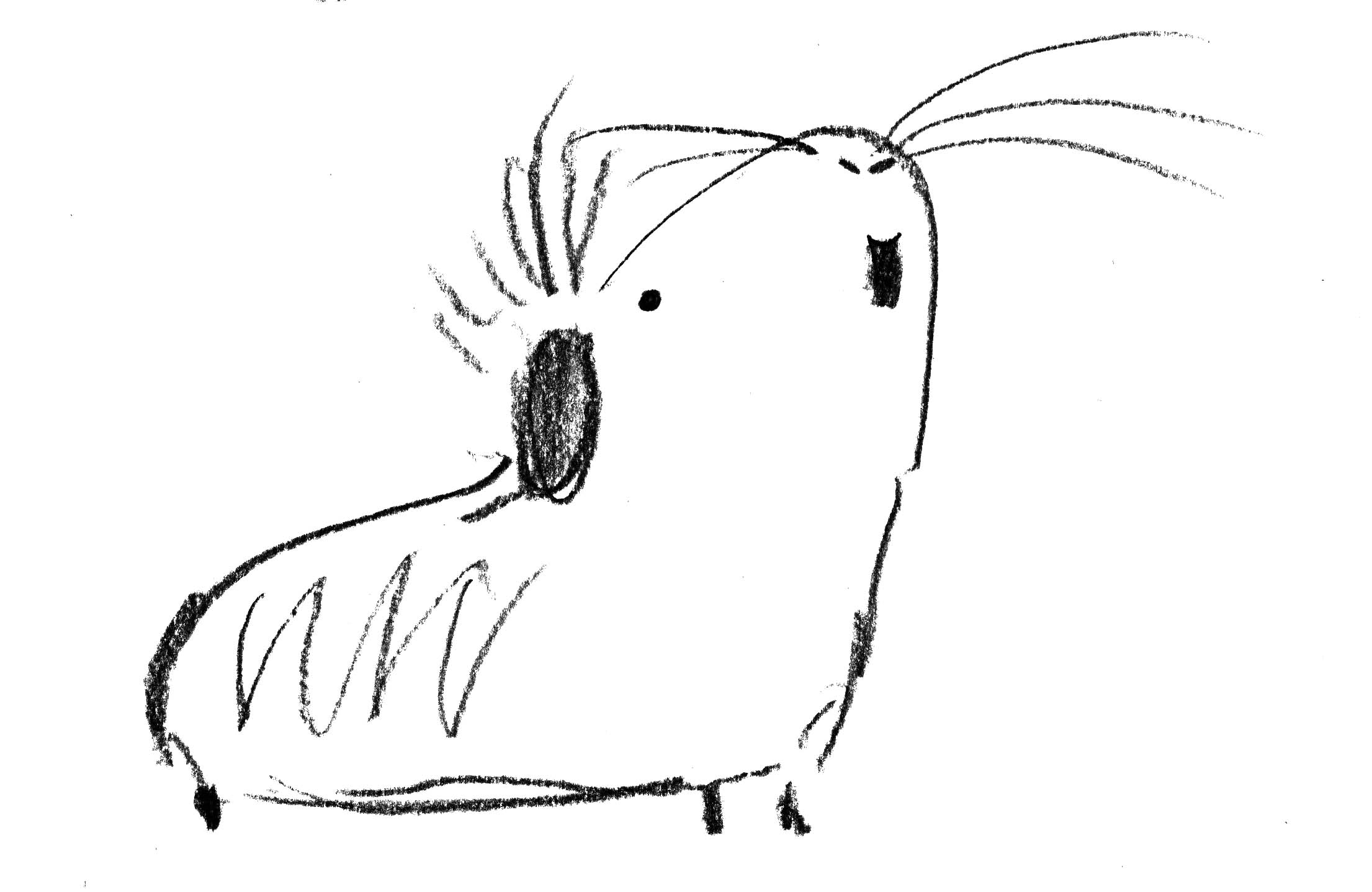
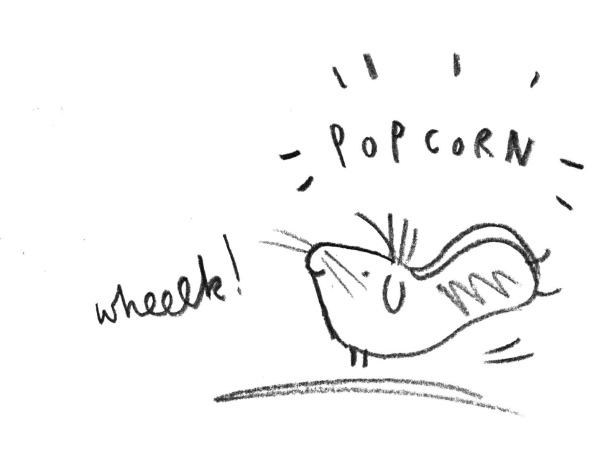 One of the sweetest things that guinea pigs do is what is known as ‘popcorning’ – they will just randomly jump up into the air when they feel happy. Harry does this quite a lot – when he imagines a full bowl of food, or once he’s got used to being outside in his new cage, and is enjoying the sunshine.
One of the sweetest things that guinea pigs do is what is known as ‘popcorning’ – they will just randomly jump up into the air when they feel happy. Harry does this quite a lot – when he imagines a full bowl of food, or once he’s got used to being outside in his new cage, and is enjoying the sunshine.
Harry has several fur-raising adventures, but there’s always a happy ending and he’s reunited with Billy. I’m hoping that children will enjoy reading about Harry Stevenson as much as I did writing about him.
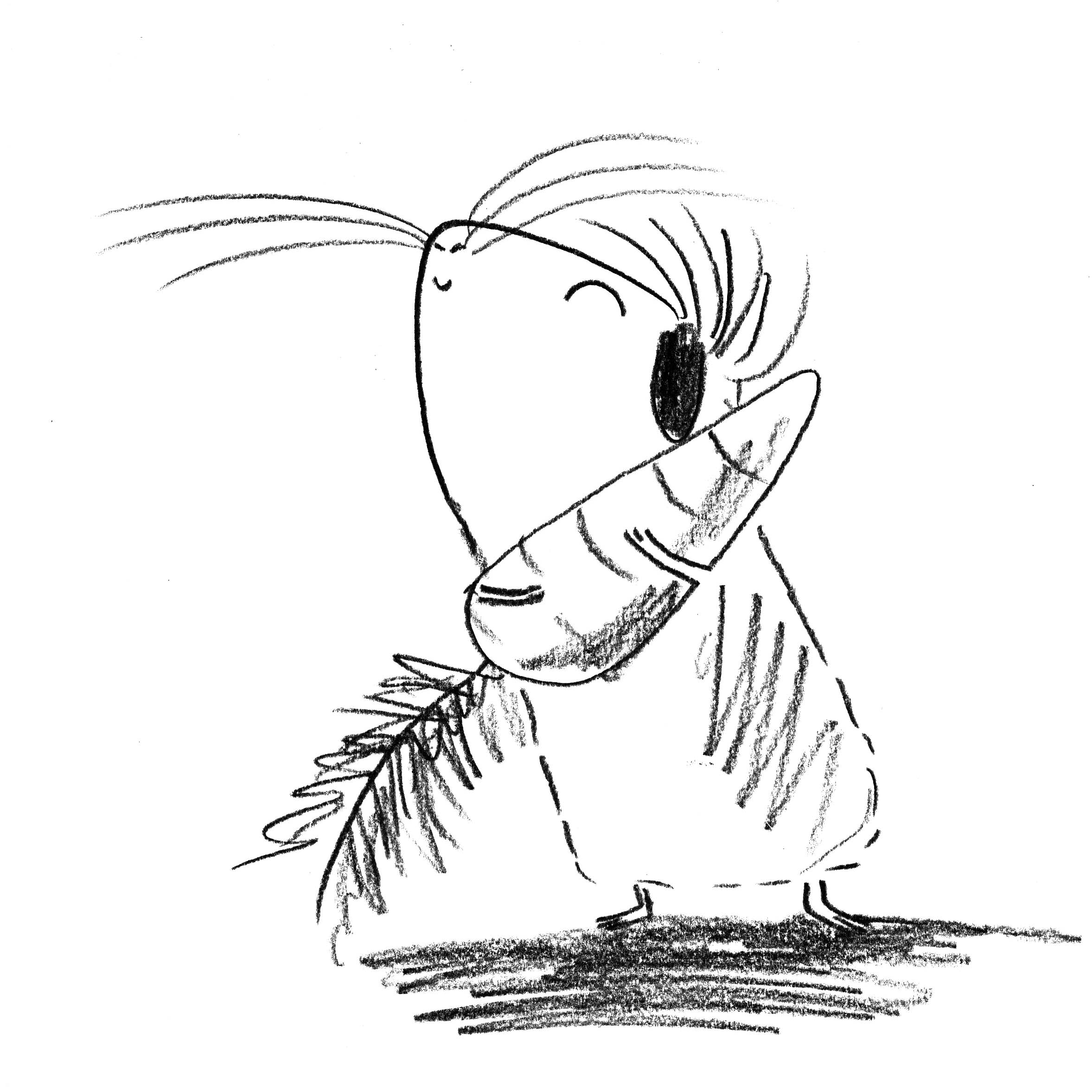
Guest Post from Morag Hood
17 June 2019

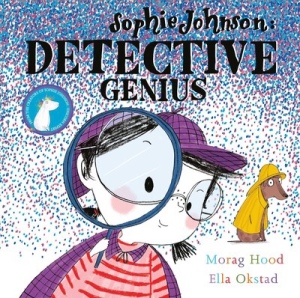 I’m delighted to welcome author Morag Hood to my blog today. Her latest picture book, Sophie Johnson: Detective Genius, is a real delight: funny, clever, and brimming with the brilliance of a young girl’s imagination. My full review is available here.
I’m delighted to welcome author Morag Hood to my blog today. Her latest picture book, Sophie Johnson: Detective Genius, is a real delight: funny, clever, and brimming with the brilliance of a young girl’s imagination. My full review is available here.
For my Blog Spotlight, Morag has written a super guest post about encouraging creativity and imagination in children.
 Morag: I think one of the joys of being a child is having the time and space to play and be creative. I remember so many happy times of playing imaginary games, whether by myself with my extensive collection of plastic animals or complicated Famous Five/Hardy Boys/Nancy Drew mashups in the garden with my friends. I am secretly delighted that as my friends have children I get the chance to play and be silly with them, and equally to watch otherwise very composed and serious adults be immersed in a bit of imaginative play. I think it is a great thing for all of us!
Morag: I think one of the joys of being a child is having the time and space to play and be creative. I remember so many happy times of playing imaginary games, whether by myself with my extensive collection of plastic animals or complicated Famous Five/Hardy Boys/Nancy Drew mashups in the garden with my friends. I am secretly delighted that as my friends have children I get the chance to play and be silly with them, and equally to watch otherwise very composed and serious adults be immersed in a bit of imaginative play. I think it is a great thing for all of us!
Fostering creativity and imagination is so important, and something I really enjoy about writing Sophie Johnson. She is a girl who is very much living in her own reality, making up stories, crafting unicorn horns and detective outfits, oblivious to her more mundane suburban surroundings. It’s a really magical time when children start to make up their own scenarios and stories and something which should be nurtured and encouraged. It gives children the chance to explore ideas and work through things they have come across, as well as to let loose, not hampered by the adult world they live in.
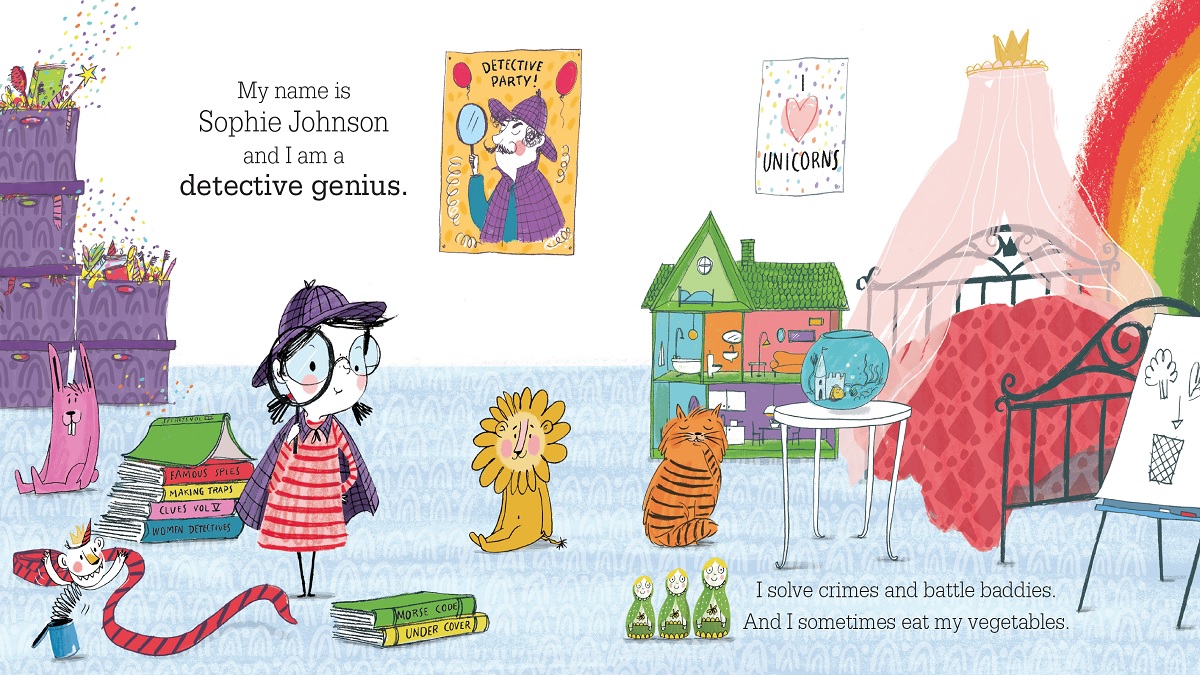
In the book we don’t see Sophie’s parents, although they are mentioned. She is being given the space to be creative on her own terms, and look how brilliant, and chaotic, that can be! A bit of direction can be a great thing, but having the space to explore and also, in Sophie’s case, be very wrong about almost nearly everything, without anyone calling you out on it, is invaluable.
Get Kids into Books: Thanks so much for visiting my blog, Morag, I agree wholeheartedly with you about the importance of fostering children’s creativity and imagination. I loved the imaginative play in Sophie Johnson: Detective Genius and can’t wait to see what Sophie dreams up next.
The #ReadforEmpathy Blog Tour
10 June
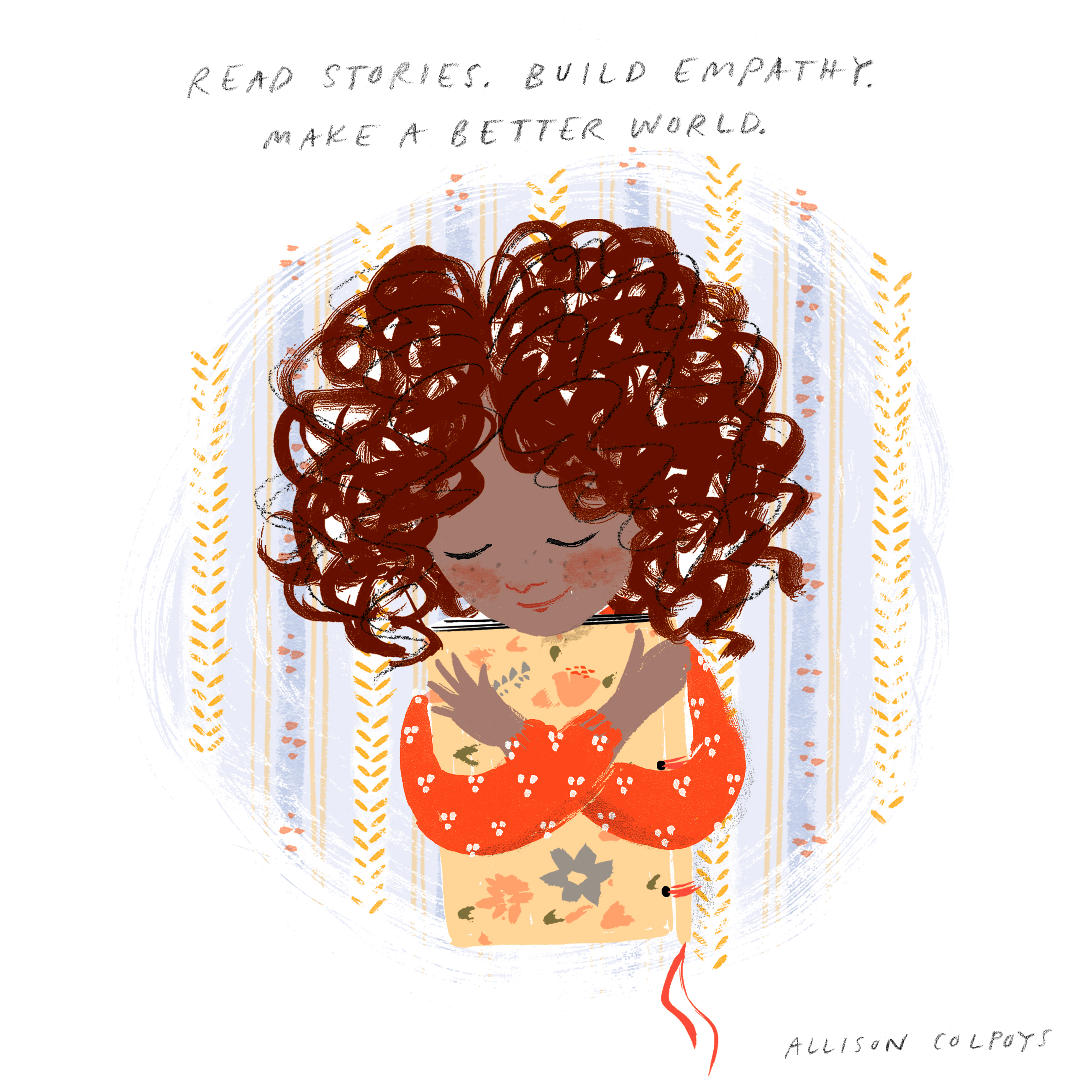
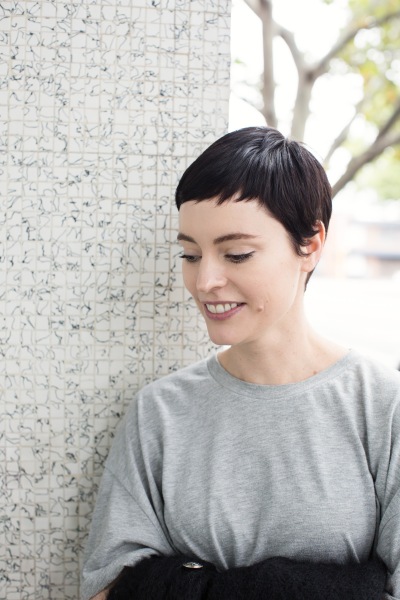
For Empathy Day 2019, I’m delighted to feature this beautiful illustration by Allison Colpoys in celebration of the power of stories to foster empathy.
The illustration is taken from the stunning and wonderfully poignant picture book If all the world were… which Allison illustrated. The story is included on Empathy Lab’s 2019 list of books recommended to develop empathy among primary-school-age children. Click here for the complete list.
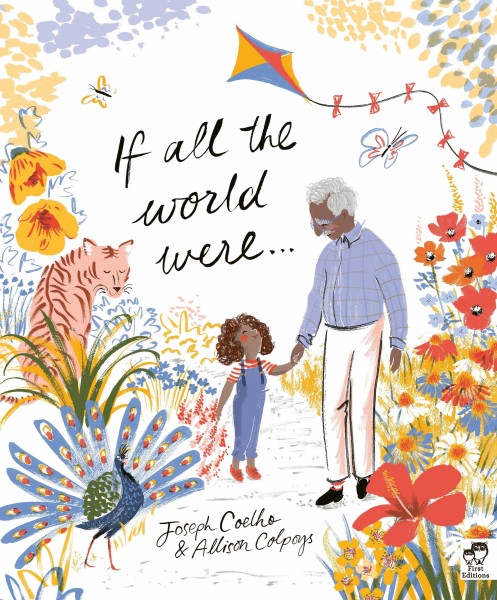 If all the world were… is an imaginative and original exploration of a girl’s feelings as she comes to terms with her grandad’s death. The book provides a gentle springboard to help children understand their own and others’ experience of loss. And this is what empathy is: feeling and understanding other people’s emotions and perspectives. It’s not the same as feeling sympathetic or sorry for someone. Having empathy means we can put ourselves in someone else’s shoes and really imagine what they’re going through.
If all the world were… is an imaginative and original exploration of a girl’s feelings as she comes to terms with her grandad’s death. The book provides a gentle springboard to help children understand their own and others’ experience of loss. And this is what empathy is: feeling and understanding other people’s emotions and perspectives. It’s not the same as feeling sympathetic or sorry for someone. Having empathy means we can put ourselves in someone else’s shoes and really imagine what they’re going through.
Stories are a powerful tool to develop empathy because in identifying with book characters we learn to see things from other points of view.
Miranda McKearney, OBE and EmpathyLab founder, has this to say about the power of reading in developing empathy:
Reading helps young minds to imagine lives beyond their own: how they would cope in a crisis, if they were a refugee or had just lost someone they loved.
In an age of suspicion and mistrust, developing empathy is key if we are to understand each other better and embrace, rather than fear, that which is unfamiliar and different.
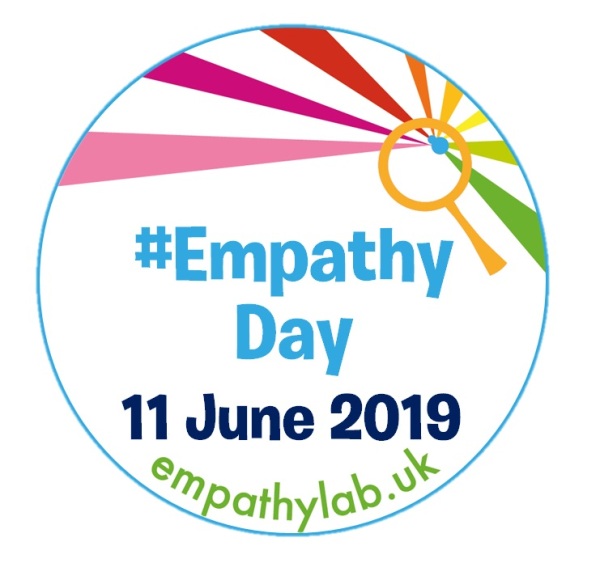 Empathy Day is an annual event. It was founded by EmpathyLab in 2017 to help children drive a new empathy movement, inspired by research showing that humans are not born with a fixed quantity of empathy – it’s a skill we can learn.
Empathy Day is an annual event. It was founded by EmpathyLab in 2017 to help children drive a new empathy movement, inspired by research showing that humans are not born with a fixed quantity of empathy – it’s a skill we can learn.
EmpathyLab’s criteria for empathy-building books
• Powerful characters you care about, whose emotions you feel and which challenge and expand the reader’s own emotional understanding.
• Builds perspective-taking – e.g. through different characters’ points of view.
• Gives the reader real insight into other people’s lives and experiences.
• Builds empathy for people in challenging circumstances (e.g. disability, migration, bereavement).
• Deepens understanding of human experience at other times in history.
• Can help expand young people’s emotional vocabulary/recognition of emotions.
• Motivates the reader to put empathy into action.
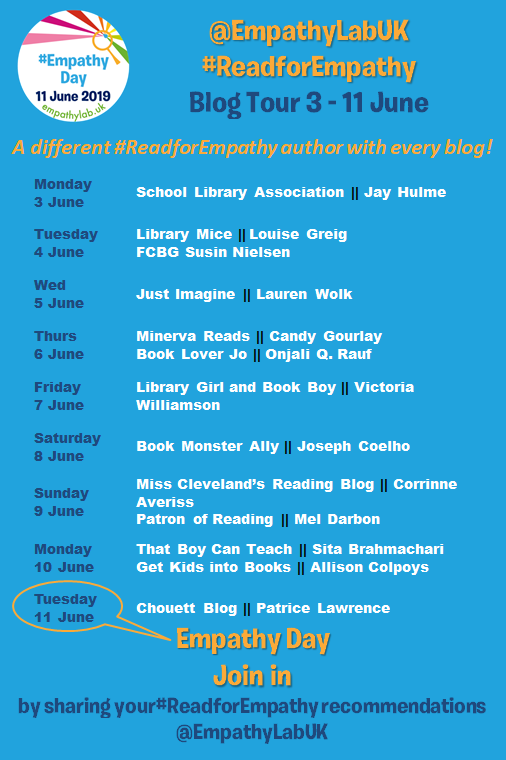
Ollie’s Magic Bunny Blog Tour
24 April 2019

Ollie’s Magic Bunny, which published last month, is a heartwarming springtime picture book by author/illustrator Nicola Killen. You can read my review here. If this sounds like a book that you or someone you know would love to read, I’m running a giveaway. Any new UK followers of my blog between 24 and 30 April 2019 will be entered into the draw.
The Titanic Detective Agency Blog Tour
21 April 2019
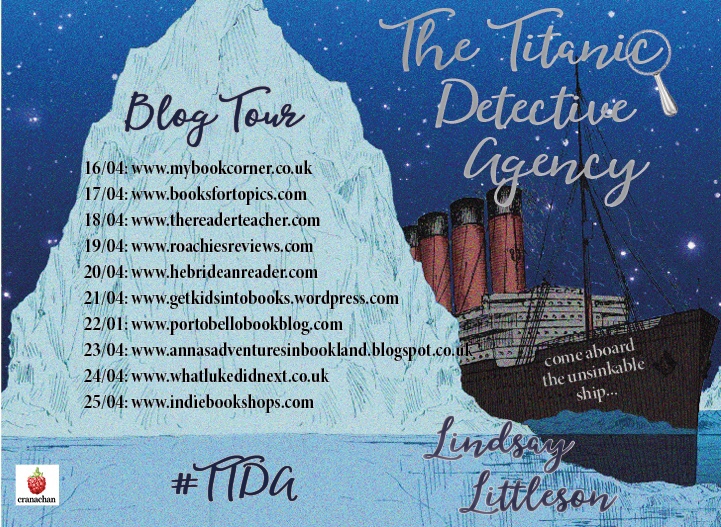
Bertha Watt, tree-climber and would-be polar explorer, is excited to be on RMS Titanic’s maiden voyage, as she leaves Aberdeen behind for the glamour of a new life in America.
But Bertha quickly realises that some passengers are behaving strangely, and she determines to unravel their secrets. With new friend, Madge, Bertha sets up her own detective agency to try and solve the mysteries onboard, but they have no idea that disaster is looming for Titanic.
Can they help Johan find the hidden treasure and unmask the identity of the enigmatic Mr Hoffman before time runs out on the ‘unsinkable’ ship?
Read my review of this exciting MG novel here.
The Children’s Book Award Blog Tour
22 March 2019

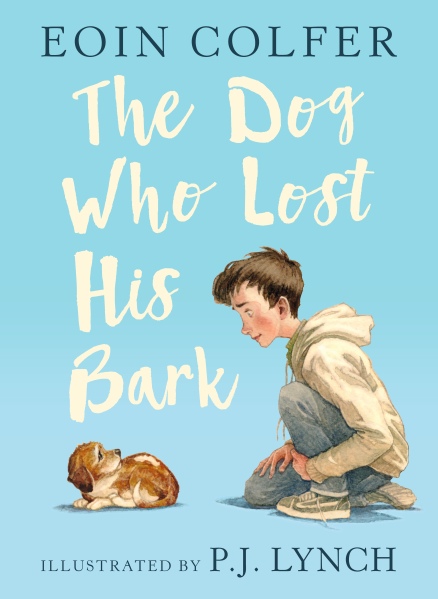 The Children’s Book Award is the only national book award voted for solely by children from start to finish. There are three categories: picture books, younger readers and older readers.
The Children’s Book Award is the only national book award voted for solely by children from start to finish. There are three categories: picture books, younger readers and older readers.
One of the books shortlisted in the younger readers category is The Dog Who Lost His Bark by Eoin Colfer and P.J. Lynch. It’s a tender story about friendship and healing. You can read my review here.
Today I’m delighted to welcome author Eoin Colfer and illustrator P.J. Lynch to my blog to talk about The Dog Who Lost His Bark. It’s the first time these two Irish Children’s Laureates have collaborated on a book together.
Photo of P.J. (on right) is by Steve Langan.
Get Kids into Books: Congratulations on your nomination in the younger readers category of the 2019 Children’s Book Award. What would it mean to you to win?
Eoin: I would be wonderful to know that our little puppy was connecting with young readers around the world. It always warms my heart to imagine a family reading our book together. On a selfish note, winning the award might convince PJ to do another book with me.
P.J. Thank you so much! It’s always thrilling to be shortlisted for a major award, but the FCBG award is really special because it is judged by young readers’ votes from start to finish. It would mean the world to Eoin and me if we were fortunate enough to win.
Get Kids into Books: What was it like working on a book with your friend?
Eoin: It was really great working with PJ. He is so talented and generous that every meeting we had was a pleasure. I suppose the real test of the working relationship is that we are still friends. Also we both have grey beards so we bonded over that.
P.J. It was a great experience to work with Eoin on The Dog Who Lost His Bark. Eoin is well known for having a great sense of humour and he is so much fun to hang out with but he is also really serious about his writing, and I found that his pushing so hard to get the story right was very inspiring to me in my efforts to make the pictures work.
Get Kids into Books: Have you ever experienced the healing power of music?
Eoin: Music has always been a great healer for me. Whenever I am upset or annoyed then I can always turn to music to calm me down. Music can not only soothe a savage beast but also an irate writer. Hardly a day goes by when I do not turn to one of my favourite artists to help me through a tense few minutes.
P.J. I certainly have! Music is very important to me and my family, especially so for one of my sons who has become a really brilliant pianist. So our house is always full of music. I think when people are grieving music can be wonderful for healing a sad heart. Music can somehow express sadness, which magically can make the sadness more bearable.
Get Kids into Books: Where did you get the idea from? Do you know any musical dogs?
Eoin: The idea came very directly from a visit to PJ’s house. I wanted us to work on a project together and was looking for a suitable topic. When I visited PJ his son was playing the piano and the dog they were fostering loved it, and I had a lightbulb moment where the character of Oz popped into my head.
Get Kids into Books: What came to you first, the plot or the characters?
Eoin: The character of Oz came to me first though he was initially called Bedlam, which we thankfully dropped. For a few weeks I moulded this character in my mind until I ended up with this poor little traumatised puppy, and then I had to figure out what had traumatised him.
Get Kids into Books: Did you have a pet dog when you were young? Or do you own a dog now?
We don’t have dogs in our house as our youngest son is allergic to most things. And now we travel so much that it wouldn’t be fair to have a dog, but maybe when our little boy is grown up and our lives settle down a bit.
Get Kids into Books: Do you have a favourite place to write?
Eoin: I love to write in a café near my home in Dublin. It is a big, friendly place where I can hide in a corner and watch life’s everyday adventure from my seat.
Get Kids into Books: How did you decide which scenes to illustrate?
P.J. When I first read a story I’ll scribble on the pages when a scene grabs me and usually those are the ones that really need to be illustrated. In this book there were so many great characters, and so many cool things happening that it was more a case of which scenes would I have to leave out?
Get Kids into Books: Did you meet with Eoin to discuss the illustrations or did you just work from the text?
P.J. We met up to talk about the project but we didn’t really discuss details like that. I left Eoin to get on with writing the story, and he left me to get on with doing the pictures.
Get Kids into Books: Did you come up with different versions of Oz before finally deciding on how he should look?
P.J. Yes, there were lots of different versions of Oz. Finally it all came good for me when my wife, Barbara, and our daughter, Evie, brought home two puppies that needed a foster home for a few months. They were gorgeous, and full of character so Oz just grew out of the sketches I did of those lovely pups. Don’t tell Oz but they were both girls! We called them Marshmallow and Popcorn.
Get Kids into Books: What’s your studio like?
P.J. It’s very messy with piles of drawings and paintings here, there and everywhere. Every few months I have to do a big clean up. But the good thing about my studio is that it’s in a shared building with lots of other artists around. So I don’t have to look far for inspiration.
Get Kids into Books: Thank you both so much for taking the time to answer my questions.
You can check out the other shortlisted titles by visiting the other blogs on the tour:
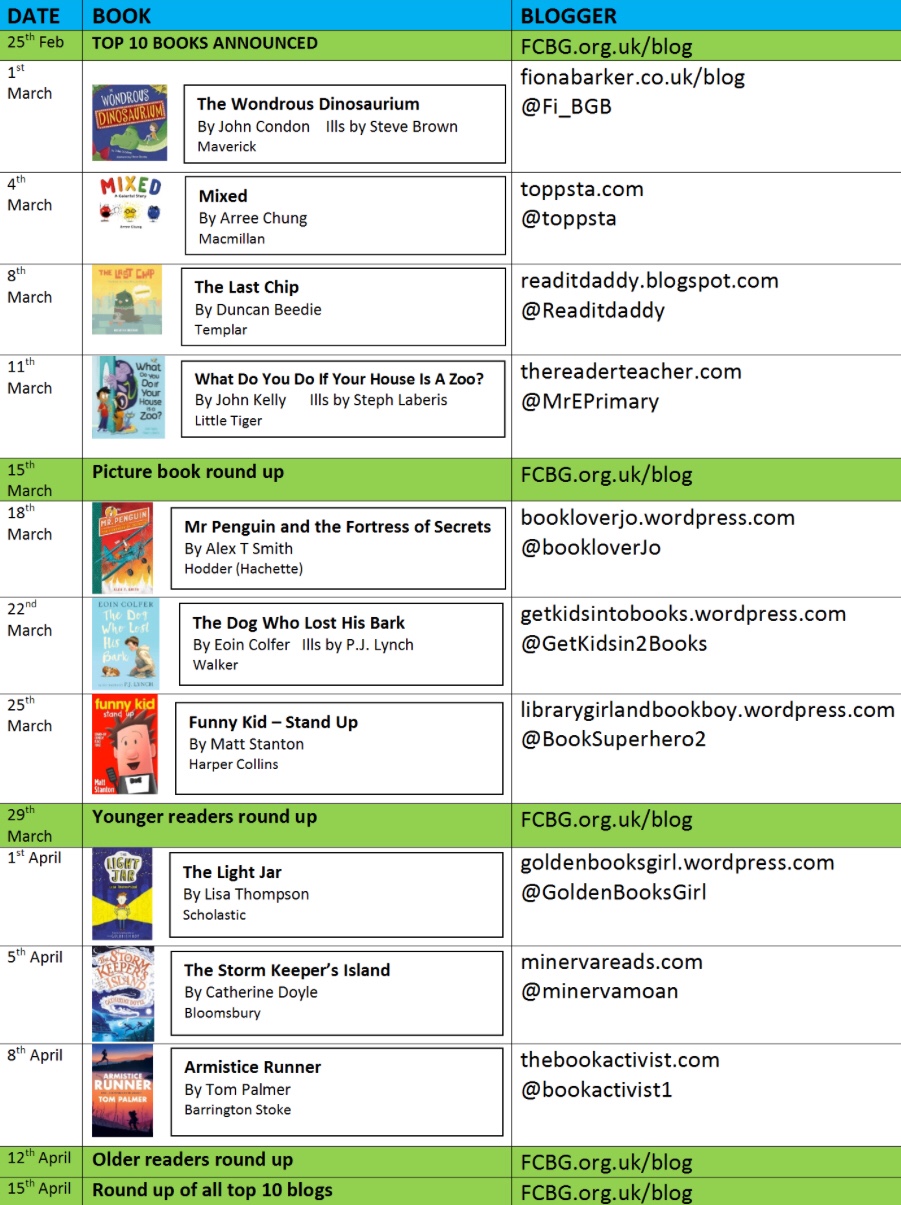
Click here to find out how you can vote for your favourite. Every online voter will also be entered into a draw to win a pair of tickets to the awards ceremony.
A Little Bit Brave Blog Tour
20 March 2019
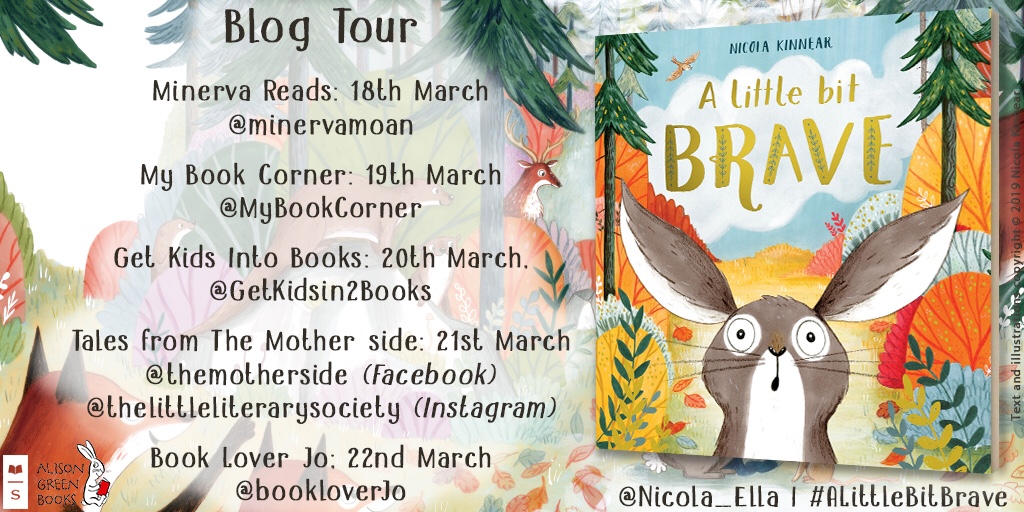
 A Little Bit Brave is the stunning new picture book by Nicola Kinnear. It’s about two rabbit friends, Logan and Luna. It’s a brilliant story of bravery, friendship and biscuits. Read my full review here.
A Little Bit Brave is the stunning new picture book by Nicola Kinnear. It’s about two rabbit friends, Logan and Luna. It’s a brilliant story of bravery, friendship and biscuits. Read my full review here.
Today I’m delighted to welcome Nicola to my blog.
Get Kids into Books: One of the things that struck me most about A Little Bit Brave was the beautiful autumnal colour palette that you used for your illustrations. The vibrant colours really bring the story to life. Can you tell me more about how you used colour to help you tell Logan’s story?

Nicola: Starting on some coloured concept art for the book, I did this piece which set me on the path to the sort of colours I wanted to use. Autumn was a great season to set the book in, for all the vibrant, interesting colours I could utilise.
Get Kids into Books: It’s such a striking image!
Nicola: I love trying to use colour to emphasise the mood of the scene and really wanted to help tell this story with my colour decisions. When Logan feels safe at home, I used warmer colours, as he first steps outside, the colours are frosty and when he gets bolder, so do the colours. I used more oranges and reds, when the wolf appears, to reflect the danger of the scene.
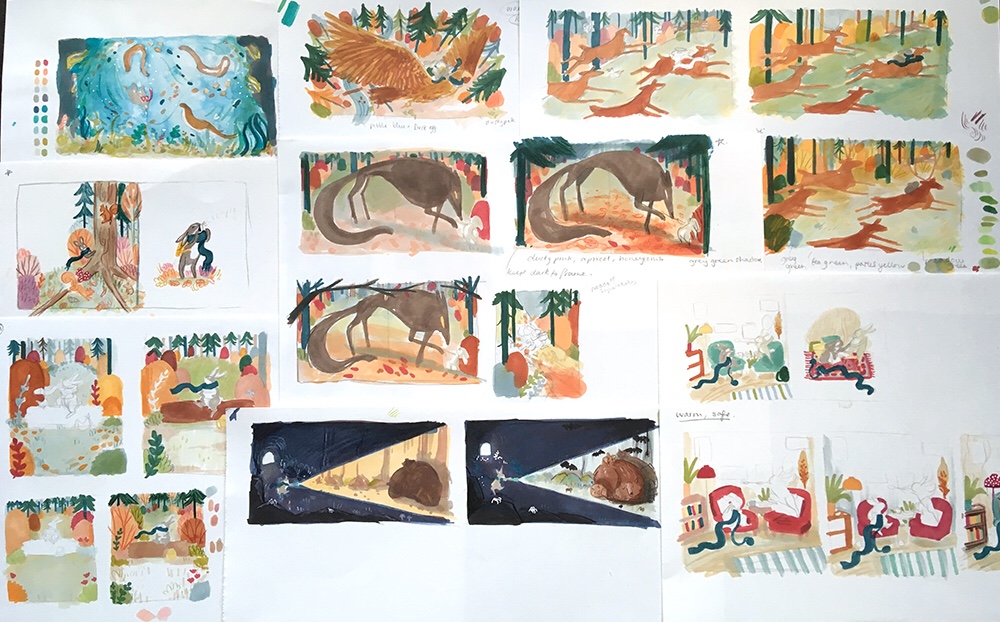
For this project, I found planning out the colour for the illustrations with quick thumbnails really helpful. This quickly showed me what was working, and what wasn’t and gave me a chance to see how colours would blend together.
Get Kids into Books: Thank you, Nicola, for this fascinating insight into how you work. I’ll look at the pictures even more closely next time my son and I read the book.
The Cosmic Atlas of Alfie Fleet Blog Tour
14 March 2019
 I’m delighted to welcome author Martin Howard to my blog today. He’s the brains behind the hilarious new MG sci-fi adventure, The Cosmic Atlas of Alfie Fleet. You can read my full review of his book here.
I’m delighted to welcome author Martin Howard to my blog today. He’s the brains behind the hilarious new MG sci-fi adventure, The Cosmic Atlas of Alfie Fleet. You can read my full review of his book here.
Get Kids into Books: Congratulations on writing such a funny book. I particularly enjoyed all the ridiculous place and character names. Was it fun dreaming them up and where did you get your inspiration?
Martin: Why thank you very much, I’m glad you laughed. It’s always a nail-biting time when you have a new book out. What if no one likes it? What if people point and jeer and throw rotten fruit? It’s a relief to know at least one person gets my sense of humour. Thank you for having me, by the way. Blogs like this make a big difference and I’m very happy to be here.
To answer the question, I do enjoy coming up with names. Some of them just appear in a flash of inspiration. Professor Bowell-Mouvemont’s happened like that, and it made me nearly wet myself when it appeared in my head so I thought it was a keeper. Others are the result of flicking through the dictionary and thesaurus, playing with words until I come up with something that sounds right.
Get Kids into Books: Are any of the people in the story based on real people that you know?
Martin: There are bits and bobs of people I know in there. The Prof has a few characteristics in common with me. Like him, I’m absent-minded (I once spent half an hour moaning that I couldn’t find my keys while I was holding my keys in my hand), and he talks in his sleep. Most of what he says is stuff I’ve actually woken my wife up with (“Emma, Emma … I’m inside a tomato!”) There are a few other character traits of friends and family mixed in to various people but once I start writing I usually find the characters have very definite views about their own personalities.
Get Kids into Books: What came to you first, the plot or the characters?
Martin: In fact, I had the idea to write a travel guide to fantastic worlds first, about fifteen years ago, but I couldn’t make it work so I shelved it for a long time. About three years ago I came up with an intergalactic map-making society called the Unusual Cartography Club. Throwing in the travel guide aspect seemed like the right thing to do, and after that everything fell into place. Alfie and the Professor came next and then the plot. I tend to be quite flexible when I’m writing fiction. I’ll have an outline of where it’s going but let it grow and change along the way. One or two of the characters arrived on the page without any planning at all. They just popped up out of nowhere while I was writing.
Get Kids into Books: This is the first book in a series, when you start a new series do you have the key plot points and characters for each book planned out in advance?
Martin: To some extent. I have ideas about what might happen, but this isn’t intended to be a Harry Potter-type series with a plot arc over x number of books and a definite end point. Each book will be a self-contained story, though of course the gang will develop and meet new people. I don’t know if you noticed but there are a lot of other derelict buildings around Wigless Square, too. If people enjoy the adventures of Alfie and the Professor, I’d like to eventually bring the whole square alive with weird clubs and societies.
Get Kids into Books: You were into books as a child, are there any particular childhood favourites that have influenced you when writing The Cosmic Atlas?
Martin: That’s a big question! I read compulsively through childhood so I have a lot of influences though I hope there’s a big dollop of me in there too. Interestingly, a lot of people have said that The Cosmic Atlas reminds them of The Hitchhiker’s Guide to the Galaxy. Obviously, I knew there were some similarities (I’ve even put in a tiny tribute) but I would have said a bigger influence was Terry Pratchett, who I loved while I was growing up. Funnily enough, we went to the same schools, though he was there a long time before me. I was also a huge PG Wodehouse fan from the age of about twelve. Though that influence might not be so obvious, it’s definitely in there somewhere. As a kid I liked comedy, too – stuff like Monty Python and Blackadder – and I think comedy shows and films have also helped shape me as a writer.
Get Kids into Books: You’ve written a lot of non-fiction, did any of the research you’ve done for your non-fiction books serve as inspiration for Alfie’s adventures?
Martin: Gosh yes! No reading ever goes to waste and you have to do a lot of research for non-fiction. I wrote a book about the world’s great historical monuments a couple of years ago and that was very useful for stuff about stone circles but I love writing about history and that’s influenced the look and feel of certain places as well as characters. For instance, the Old Verminium Bridge is very much based on old London Bridge which is long gone now but a fascinating place with houses and shops across the entire span.
Get Kids into Books: I love Chris Mould’s illustrations. Can you describe the process of working together? Did he work independently using your descriptions or was there a dialogue?
Martin: I’ve been a fan of Chris’s for a long time and from the moment I started writing I knew he would be the perfect illustrator. Luckily, Oxford University Press agreed, which made me very happy! We’ve never actually met though. Because he lives in the UK and I live in France everything had to happen over email, so for the maps I’d sketch something to the best of my abilities (which aren’t great) and he’d turn it into beautiful, Chris Mould artwork. We’re planning to do one or two events together a little later in the year though, so hopefully we’ll have a chance to sit down and talk about the next book face-to-face.
Get Kids into Books: Do you prefer writing for adults or children?
Martin: Children, definitely. I have no plans at all to write fiction for adults again. Writing for children is a completely different ball-game and one that I absolutely adore. I think children especially love exploring the far reaches of the imagination and I have a childish sense of humour, so it’s a great match for me. I’ve explored lots of different areas in writing and I think they’ve all helped me improve my skills but fiction for children is where my heart is and when I’m writing children’s fiction it feels like that’s exactly what I’m supposed to be doing, if that makes sense.
Get Kids into Books: Do you have a favourite place to write?
Martin: Ach, well I’ve tried writing under a tree in the garden because that’s the sort of thing writers ought to do, but it’s difficult to concentrate with insects crawling into your pants. I write best when I’m comfortable with no distractions so – I’m slightly ashamed to say – I usually write in bed with a laptop on my knees. I have three children and a dog so the bedroom is the quietest room in the house, and it’s comfy, too. It’s not because I’m lazy, honest!
Get Kids into Books: Thanks for such an interesting insight into your work.
Martin: Thanks again for having me, I hope this has been as entertaining for you as it has for me. I do love wittering on! Let’s do it again soon. In the meantime, toot toot as Chris Mould would say.
Molly’s Moon Mission Blog Tour
19 February 2019
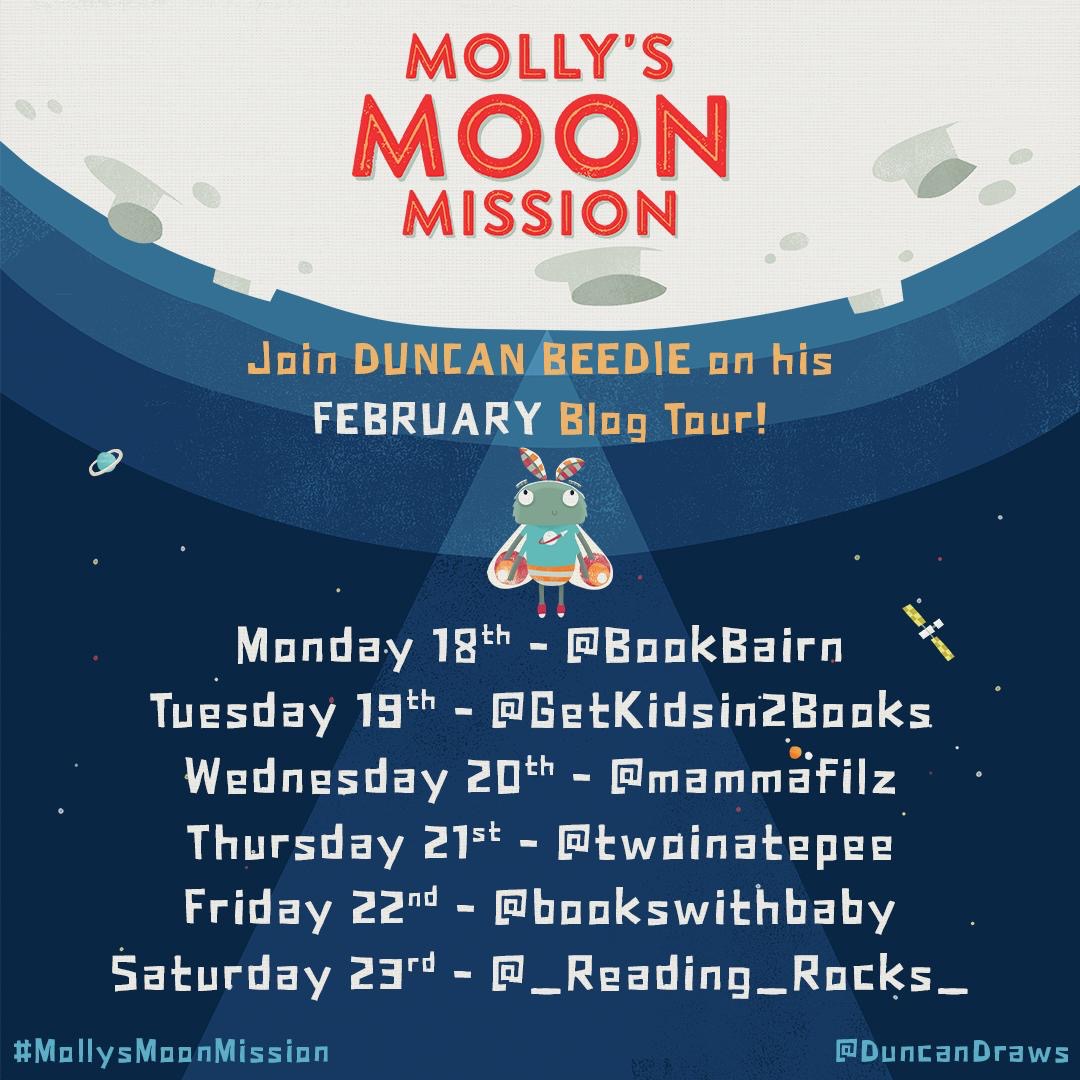

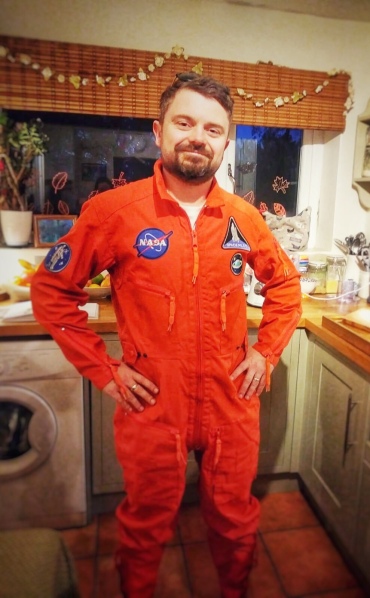
Today, I’m delighted to welcome author Duncan Beedie back to my blog. After the success of his last ‘How to Draw’ guest post, he’s here again with more drawing tips. This time it’s with brilliant step-by-step instructions for how to draw the lead character from his latest picture book, Molly’s Moon Mission. Molly is an adventurous young moth with ambitions for space travel. You can read my review of the book here.
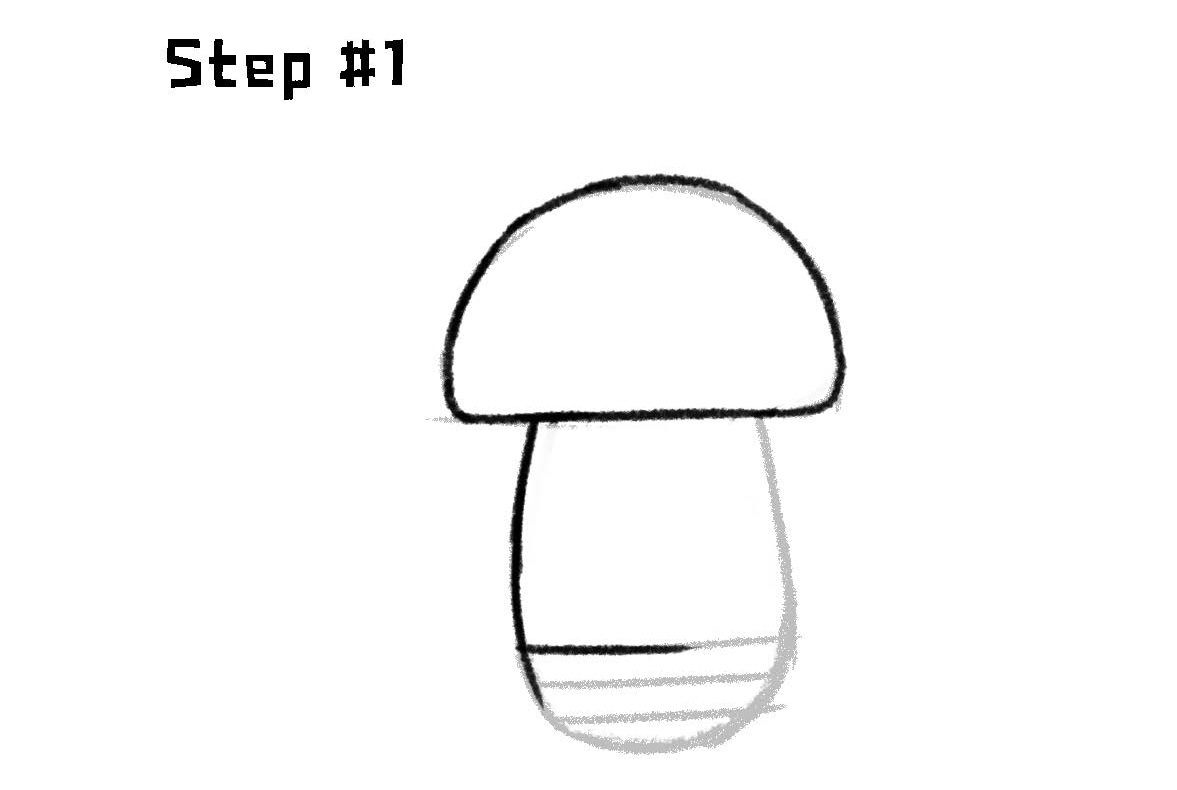
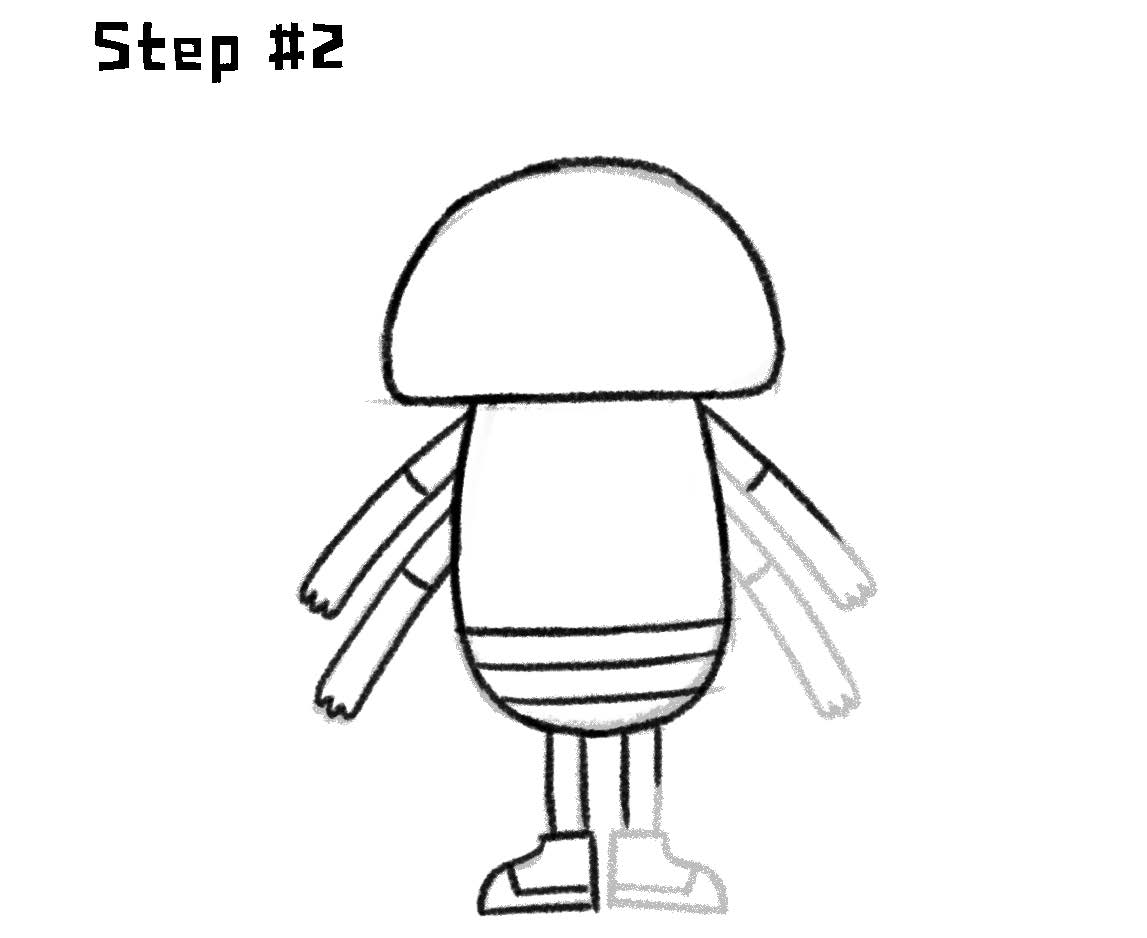
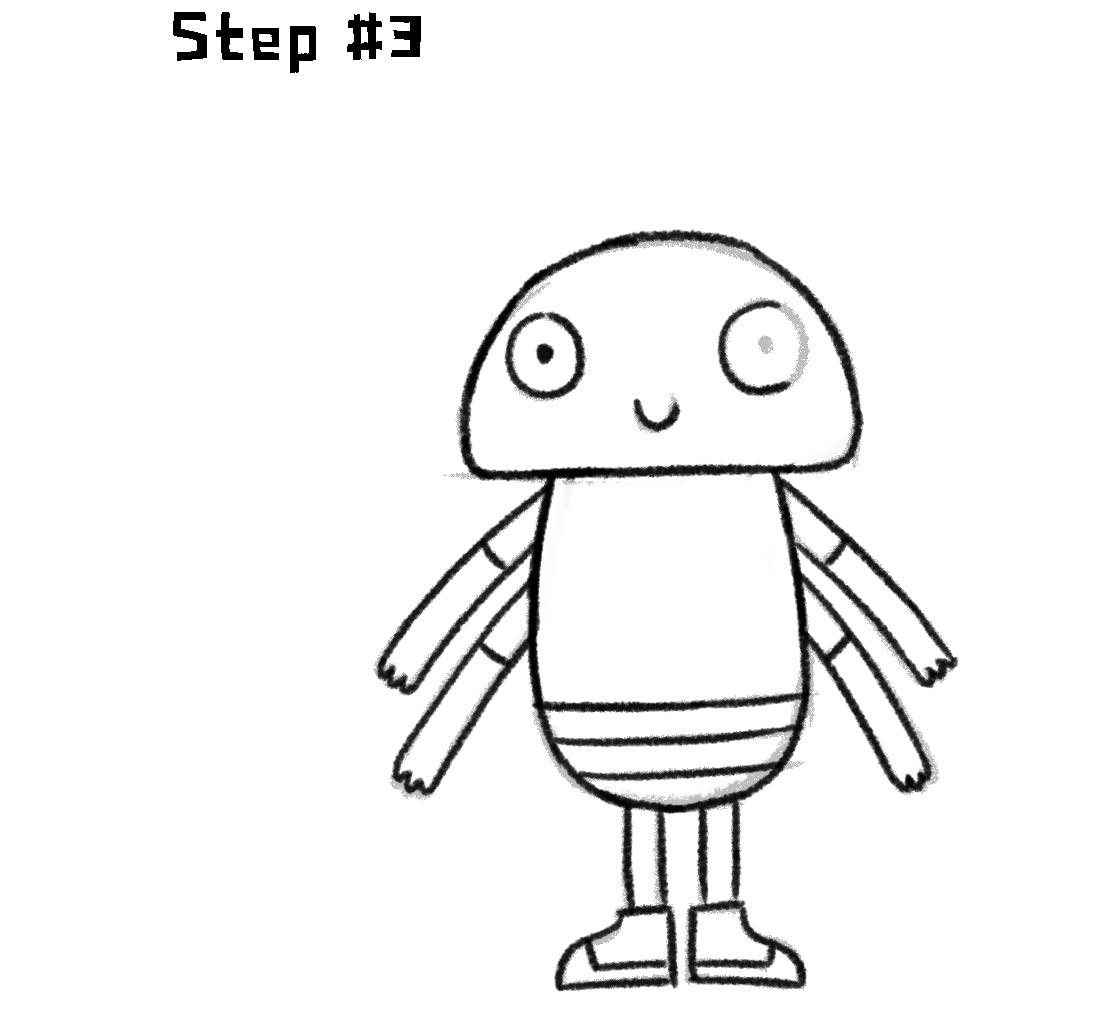
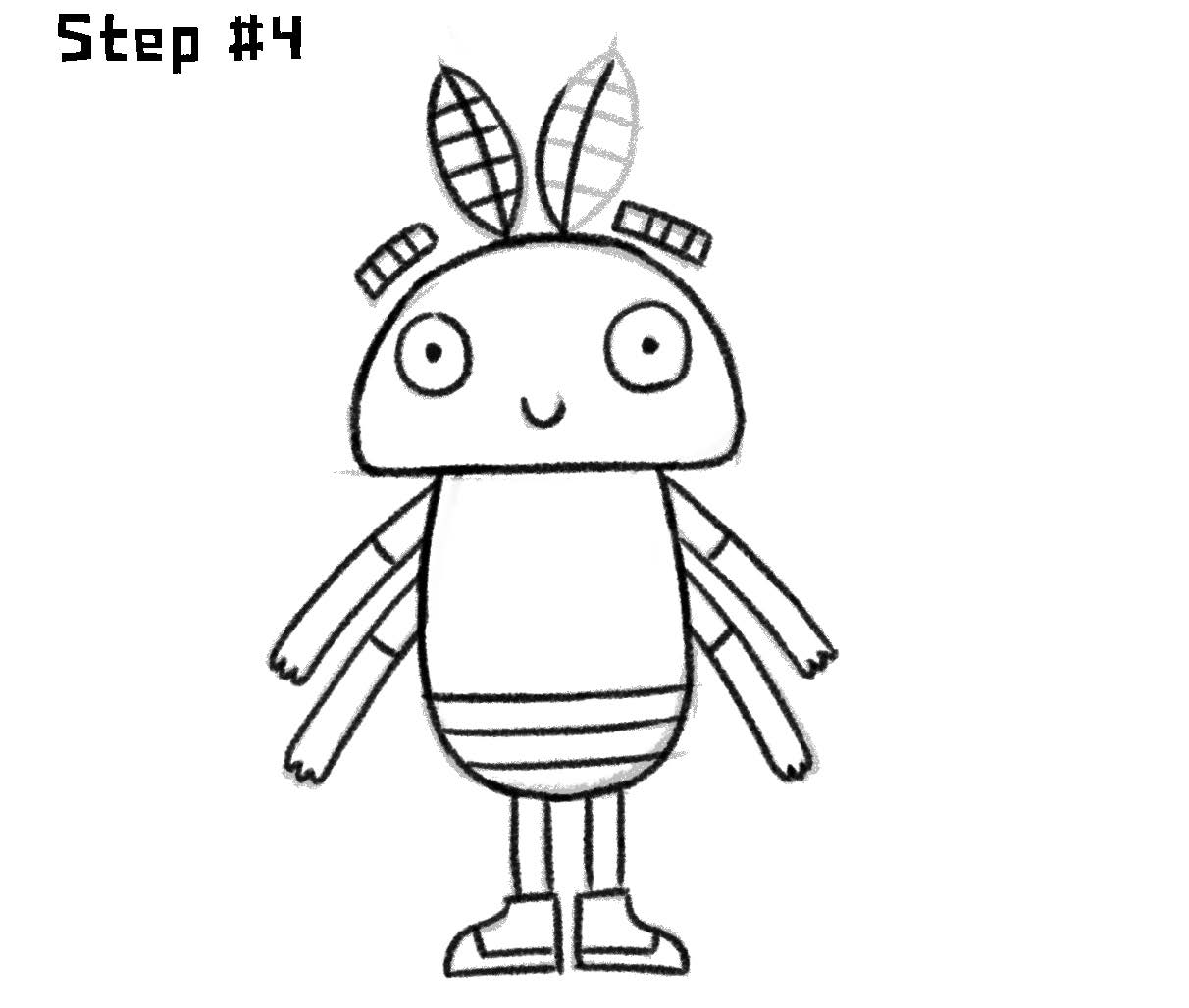
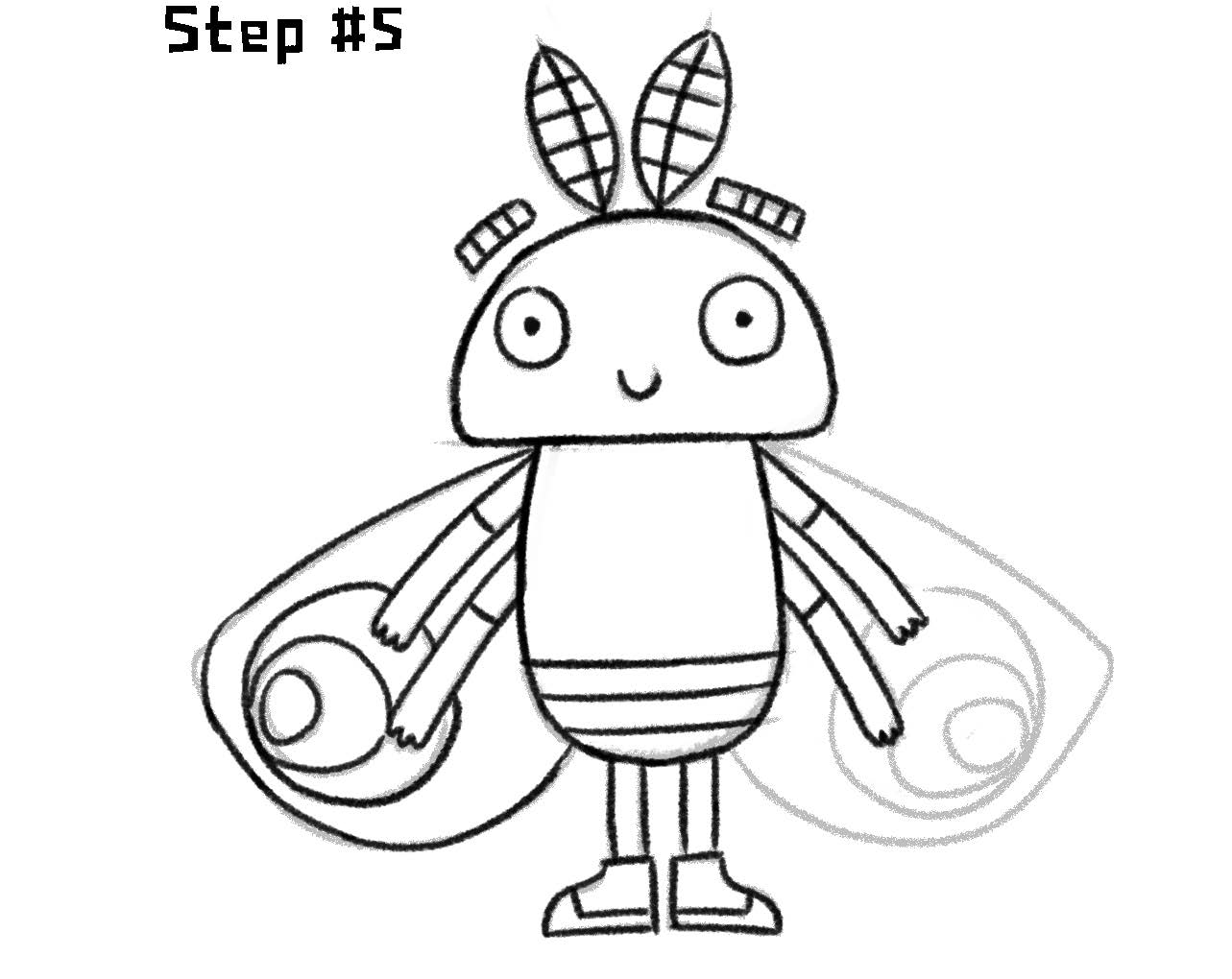
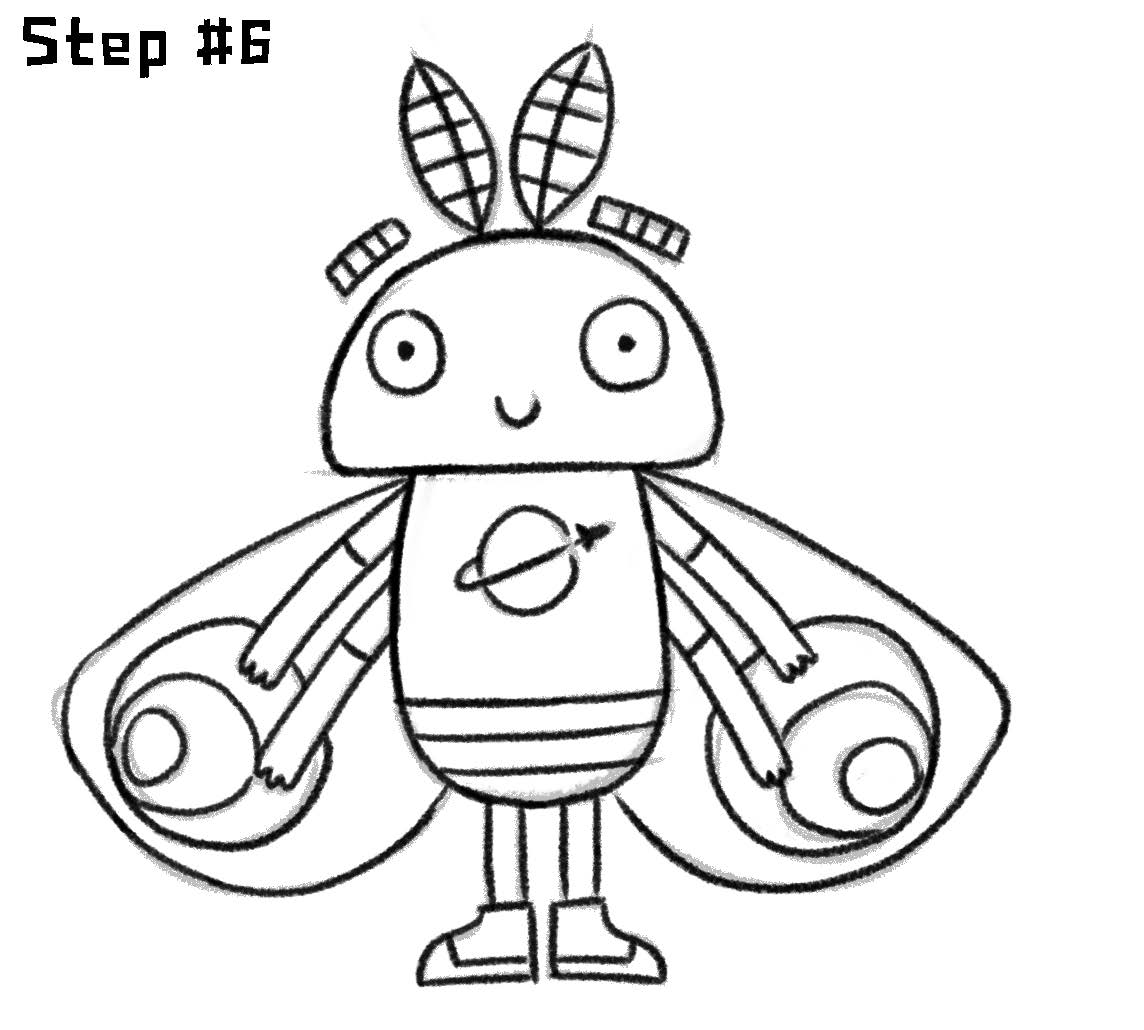
I’d love to see your drawings of Molly! Share them on Twitter with the hashtag #MollysMoonMission. Don’t forget to tag me @GetKidsin2Books and Duncan @DuncanDraws.
We didn’t quite match Duncan’s standard of illustration, but Sam and I had a go at our own art inspired by Molly’s Moon Mission.
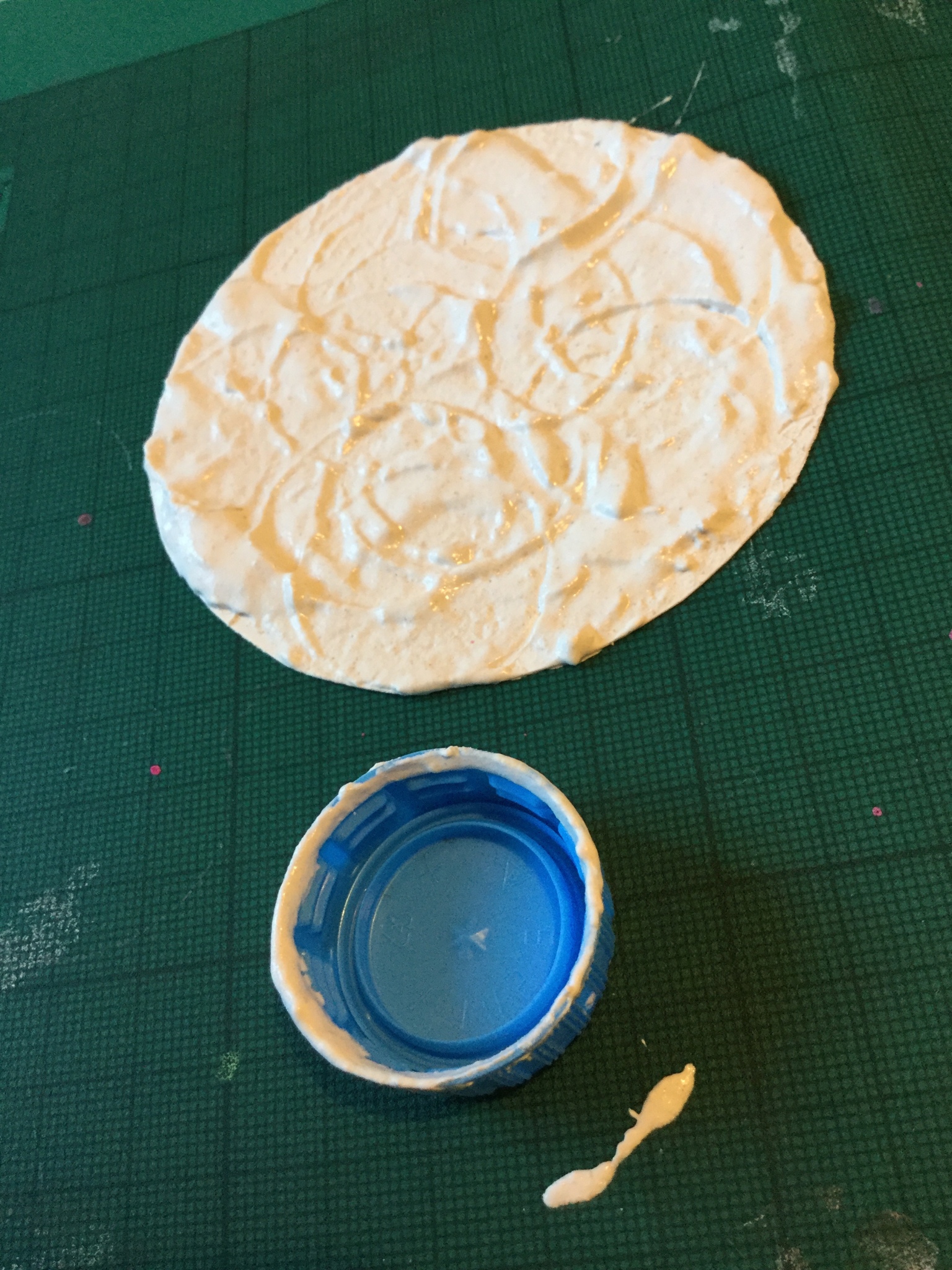
Next we used three cheerful colours to paint stripes on Sam’s hands and we made a left and a right handprint.

Finally, Sam used silver glitter glue to add the finishing touches – stars (some are shooting stars 🤣) and galaxies.
A Pinch of Magic Blog Tour
6 February 2019
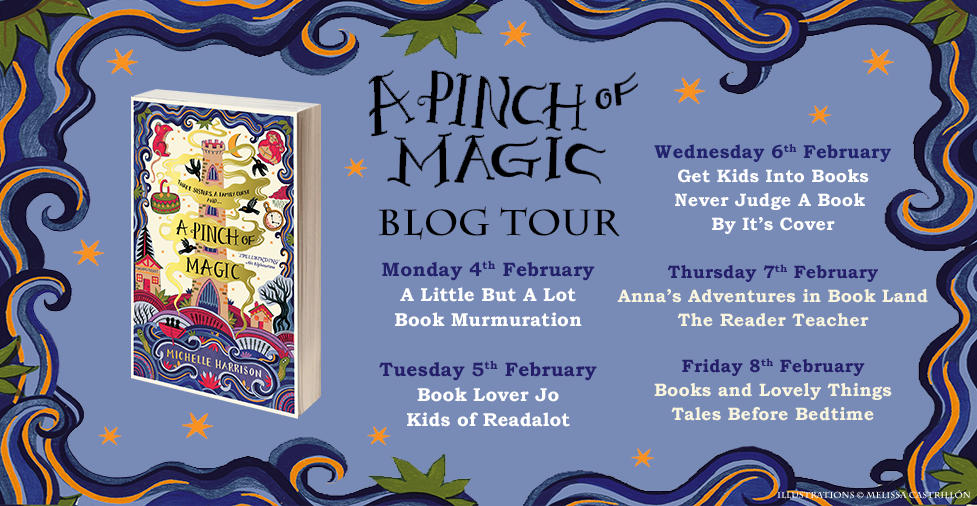
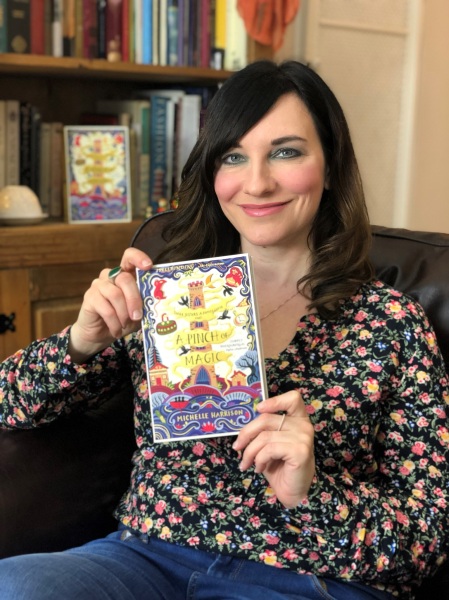 A Pinch of Magic is the brilliant new MG adventure by award-winning author Michelle Harrison. You can read my review by clicking here.
A Pinch of Magic is the brilliant new MG adventure by award-winning author Michelle Harrison. You can read my review by clicking here.
Michelle is a full time author, living in Essex. Her first novel, The Thirteen Treasures, won the Waterstones Children’s Book Prize and is published in sixteen countries. It was followed by The Thirteen Curses and The Thirteen Secrets. Michelle has also written One Wish, a prequel to the Thirteen Treasures books, Unrest, a ghost story for older readers and The Other Alice, a magical book about the power of stories. You can find out more by visiting Michelle’s website: www.michelleharrisonbooks.com
** Competition **
Between 6th and 28th February 2019, all new UK followers of my blog will be entered into a draw to win a copy of A Pinch of Magic.
EmpathyLab Announces 2019 Read for Empathy Guides
17 January 2019
I’m a huge advocate of the benefits of reading for building empathy so I’m delighted to be able to support the work that EmpathyLab is doing around this very issue. Books help us see the world from another perspective. We can start to understand life in another place, another skin, another gender. We become kinder, more compassionate and more human. EmpathyLab is spearheading a new empathy movement with books at its core, aiming to develop children’s life skills and combat society’s empathy deficit. In 2019, this starts with the announcement of the titles chosen for the 2019 Read for Empathy Guides following publisher submissions of books with strong empathy angles.
An expert, cross-disciplinary panel has chosen 45 books to strengthen children’s empathy skills, and inspire them to put empathy into action in their communities. This year there is a new trial list of fifteen books for 11-16 year olds (the Secondary Guide), in direct response to demand from adults living and working with young people. This is in addition to thirty books for 4-11 year olds (the Primary Guide).
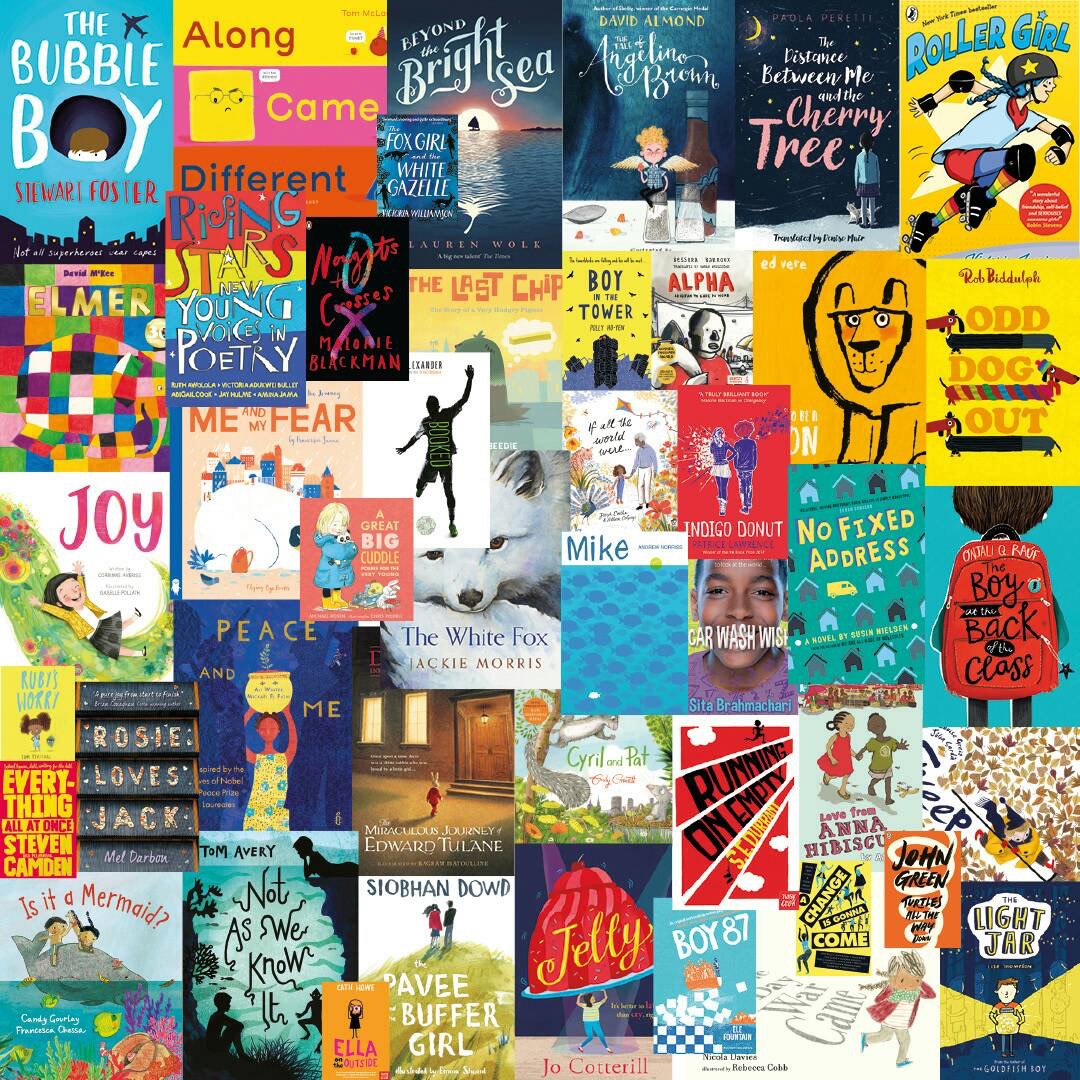
The Primary Guide features 14 picture books, 14 novels, a graphic novel and a poetry collection. The Secondary Guide includes 2 graphic novels, 3 poetry books, 9 novels and a collection of short stories. Two linked book collections are available from Peters for parents, teachers and librarians to use in the run-up to Empathy Day on 11 June, and beyond. Both guides will be available for free from 17 January by visiting the EmpathyLab website (click here).
EmpathyLab welcomed the increase in publisher submissions of books by black and minority ethnic authors/illustrators. This resulted in 29% of the included books being by BAME creators – 7 out of the 15 titles in the Secondary Guide and 6 out of 30 in the Primary Guide. Of the 45 featured titles, 44% have a BAME protagonist or cast of characters.
You can read my reviews of three of the selected titles below and I’ll be reviewing more of the books on my blog in the coming months.
The Fox Girl and the White Gazelle Victoria Williamson. Click here.
The Last Chip by Duncan Beedie. Click here.
Not As We Know It by Tom Avery. Click here.
Vote for Effie Blog Tour
8 January 2019
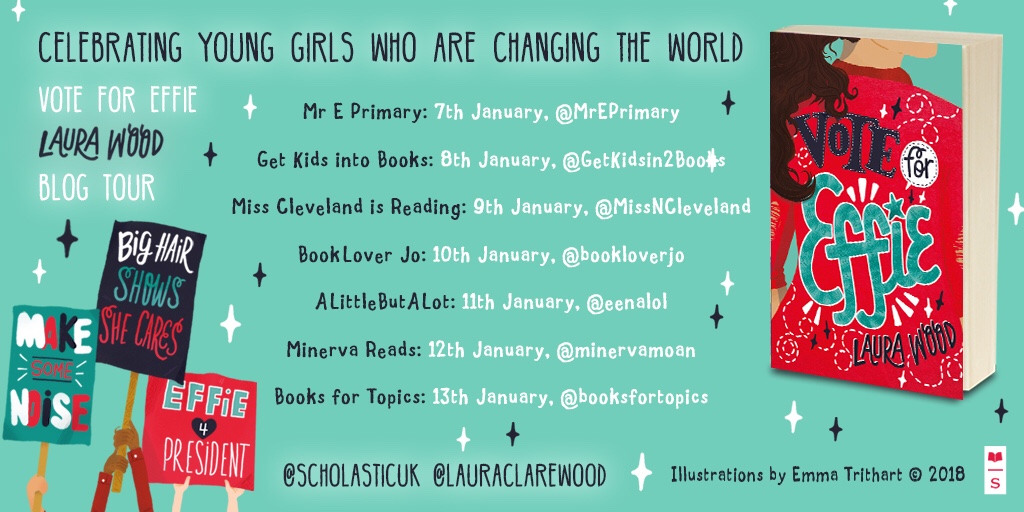
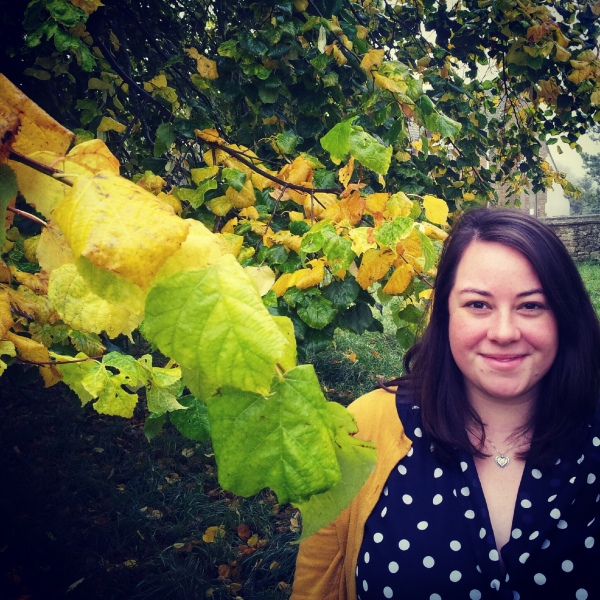
Vote for Effie is a brilliant new MG book about girl power and making a difference. You can read my review here. Today on my blog I’m joined by Vote for Effie author, Laura Wood. She’s chosen to highlight a different inspirational young woman on each day of the blog tour. Today it’s the turn of Amika George.
Get Kids into Books: Hi Laura, thanks for joining me today. Can you tell me more about Amika and why you’ve chosen to celebrate her?
Laura: Amika George is an 18-year-old fighting for rights to free sanitary products for disadvantaged teenage girls with her #FreePeriods campaign, which she founded while she was still at school. Amika began her campaign after she read a report that stated there were girls across the UK who could not afford menstrual products during their period, and who were missing school as a result. The #FreePeriods campaign isn’t just about making menstrual products readily available to all, but also about overcoming the taboo of talking about periods in the first place.
In December 2017, Amika organised a protest outside Downing Street that was attended by over 2000 people. I think she’s such a great role model for young people, showing that you don’t need to be a grown-up in a position of authority to make change happen. She saw something that she knew was wrong and she decided she wanted to do something about it. That’s an idea that’s absolutely at the heart of Vote for Effie.
You can find out more about the #FreePeriods campaign here.

Don’t miss the other stops on the tour. Each one features an inspirational young girl who’s making a positive difference to our world.
The Night I Met Father Christmas Blog Tour
4 December 2018
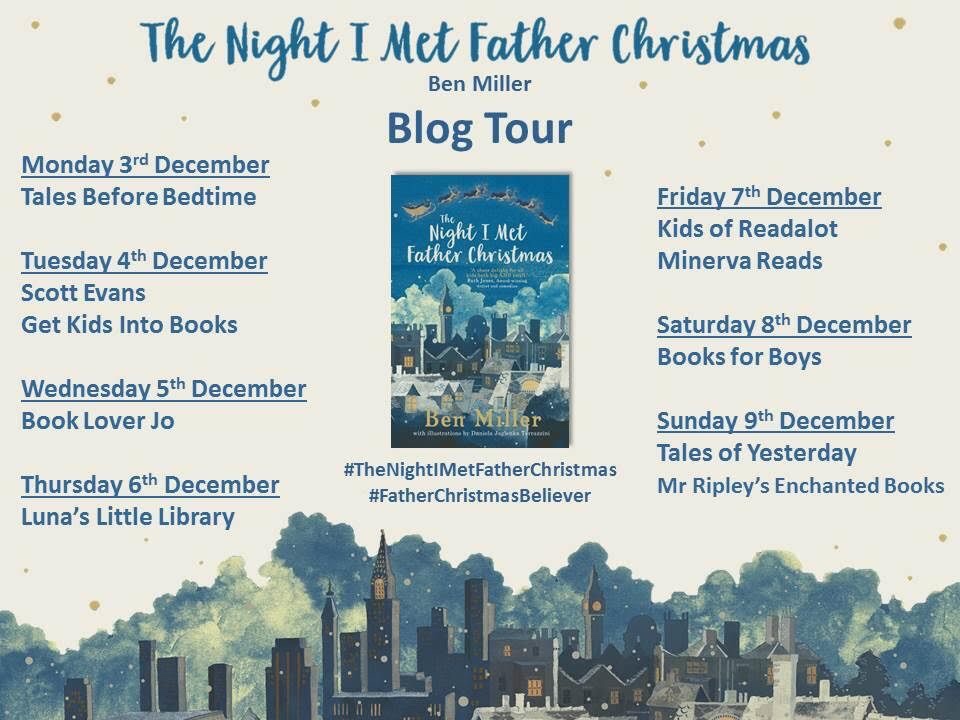
 Author, actor and comedian Ben Miller has written a fabulously festive new MG book called The Night I Met Father Christmas. You can read my review here. It’s my stop on the book’s blog tour today and Ben is here to share his top five Christmas books for children:
Author, actor and comedian Ben Miller has written a fabulously festive new MG book called The Night I Met Father Christmas. You can read my review here. It’s my stop on the book’s blog tour today and Ben is here to share his top five Christmas books for children:
- The Night Before Christmas by Clement Clarke Moore
- How the Grinch Stole Christmas by Dr Seuss
- The Snowman by Raymond Briggs
- Father Christmas by Raymond Briggs
- A Christmas Carol by Charles Dickens
The Lollies 2018 Blog Tour
🤣 19 October 2018 🤣
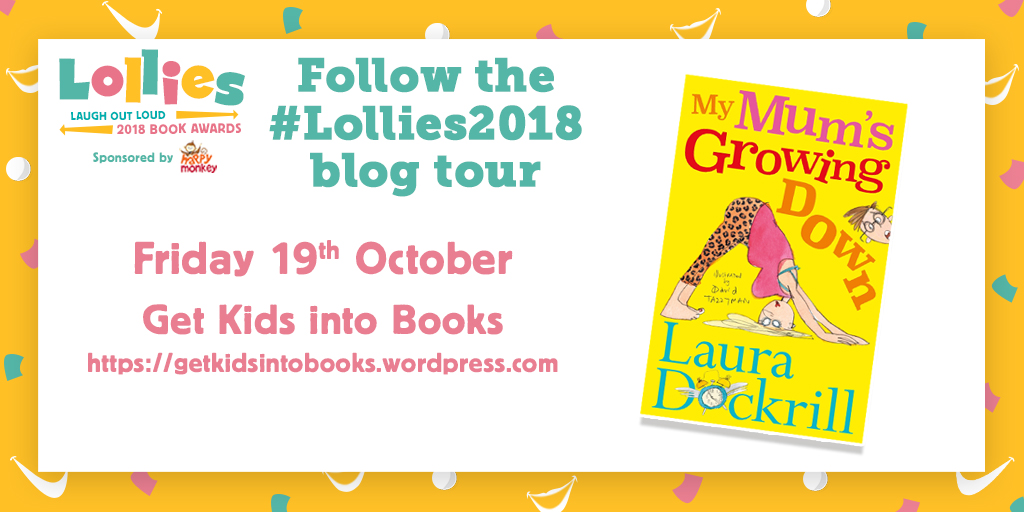
 The Laugh Out Loud Book Awards (the Lollies) is a celebration of the very best and funniest books for children, voted for by children themselves. Laura Dockrill’s hilarious and moving collection of poems, My Mum’s Growing Down, has been shortlisted in the 9-13 years category. Today I have the pleasure of welcoming Laura to my blog.
The Laugh Out Loud Book Awards (the Lollies) is a celebration of the very best and funniest books for children, voted for by children themselves. Laura Dockrill’s hilarious and moving collection of poems, My Mum’s Growing Down, has been shortlisted in the 9-13 years category. Today I have the pleasure of welcoming Laura to my blog.
Get Kids into Books: As a single mother to a son, these poems about a single mother and her son really resonated with me. My Mum Is My Dad moved me to tears. Why did you choose to write about this particular family dynamic?
Laura: Aww that’s so nice to hear. Thank you. My parents split up when I was 15 and really felt like I was torn between the two of them, I think it’s the first time I actually felt my heart break. They were my favourite people in the world and here they were splitting up. After visiting lots of schools I’ve seen how many kids come from homes where parents have broken up – it’s the first time they will know heartbreak too and the upset it causes. I wanted the poem to offer a remedy to that, something simple and bold in what can be such a confusing and difficult time, for those kids that don’t have the perfect together family, to offer an explanation for them to use for their friends and for themselves and to help others understand. The word Mum and Dad are just words- a parent is a feeling.
Get Kids into Books: The book is dedicated to your mum and there’s a note from her at the end. How much of the book is inspired by your own mum and your relationship with her?
Laura: A LOT of the book is inspired by my own mum and I found I had so much to draw from. My mum is unlike anybody else. She loves life, she lives out loud, is wild and wonderful. Both of my parents are amazing humans and the book is a celebration of that. It’s not completely autobiographical and my dad was very much a part of my life growing up but I wanted the book to shout about women. We see so much in children’s literature of dads being gross, funny, strong and silly and my mum is all of those things. Mums always seem to be the characters that sit at home and tell you to be careful and behave yourself whilst dad is on all fours being a bear in the garden- well, it’s not always like that for many kids at home.
Get Kids into Books: You’re a performance poet and these poems are a joy to read aloud – the rhythm, the rhymes, the humour and the way the words trip off your tongue – can you tell me a bit about your creative process? How do you write such performable poems?
Laura: Thank you so much, I write everything with the intention of it being read aloud because I love the art of storytelling. My first love of literature is through music so rhythm and punchlines are always in my head when writing the material. I think it’s another way of involving kids in literature.
Get Kids Into Books: Which poem was the most fun to write?
Laura: A poem called How to count to ten in Japanese but it never made the cut sadly!
Get Kids into Books: Which poems get the best response from an audience?
Laura: My Mum’s Growing Down of course! Kids love shouting out the chorus line in libraries as loud as we possibly can!
Get Kids into Books: Have you always loved poetry? What are your favourite poems?
Laura: I’ve always loved poetry since I was little, my favourite poets are Colin Mcnaugnton I adored There’s an awful lot of weirdos in our neighbourhood and have incredibly vivid memories of my mum reading these poems to me as a child. I loved Roald Dahl’s poetry, Plath, Duffy and Spike Milligan. My dad took me to see John Cooper Clarke read when I was young. But words were a great part of my growth, my dad would always shroud us in literature – books, magazines, newspapers, recipes and the art of conversation- I was taught to find poetry in the everyday. To use and cherish my imagination and enjoy language.
Get Kids into Books: Thanks so much for stopping by Laura.
You can read my review of My Mum’s Growing Down here. Check out all the other stops on the tour too for exclusive Lollies content and giveaways. Click here to find out how to vote for your favourite book.
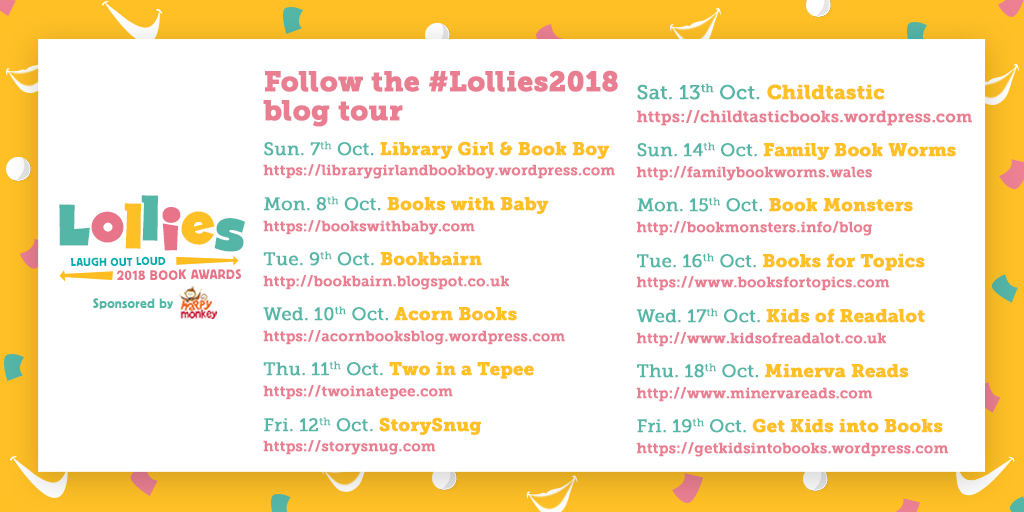
Daddy Hairdo Blog Tour
19 September 2018
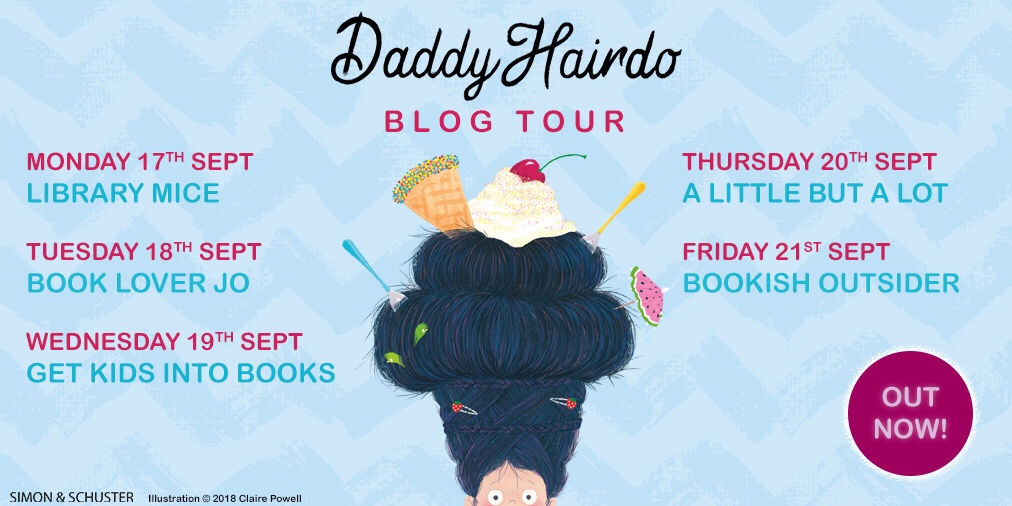
To mark the publication of this fabulous new picture book by Francis Martin and Claire Powell (read my review here), I’m delighted to welcome its author, Francis, to my blog today.
Get Kids into Books: Thanks for joining me on my blog. Were you and your daughter the inspiration for this story?
Francis: Yes, I think family life is a fantastically creative time. The only trouble is that you’re too busy to process it at the time. It’s when things have quietened down that you realise you had created a world with its own stories, in jokes and even language. My daughter is grown up now and all parents say ‘where did the time go?’. This is my attempt to hold on to it and thankfully it resonated with other people.
Get Kids into Books: What was the most ambitious hairdo that you created for her?
Francis: I love doing plaits, it’s almost therapeutic. The in out pattern looks like a flowing river. The plait is also a building block for your sculptural ambitions. Dads, if you want to replicate my best Daddy Hairdo: do a plait in each corner of the child’s head and bring them into a top knot, tie together with a bright red ribbon, et voila – the ‘Volcano’.
Get Kids into Books: Where did you find the inspiration for all the amazing hairstyles?
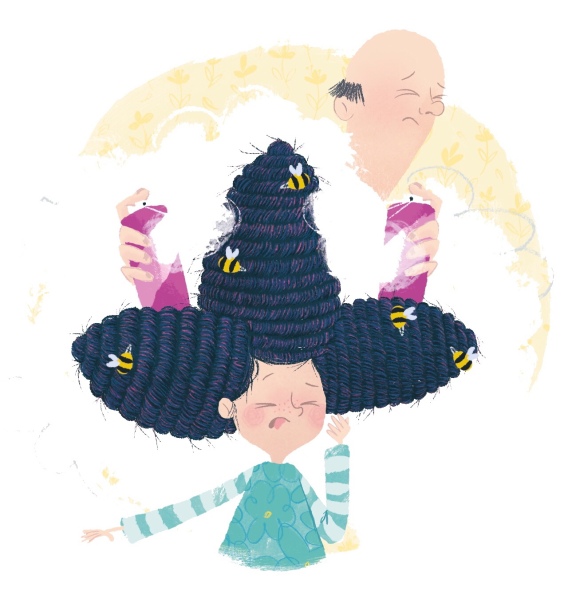 Francis: My imagination collects processes and splurges out all kinds of wild ideas. One of my favourite bands ever is The B52’s (which is the name of a fabulous hairstyle). The shape looked like the nose cone of a B52 bomber. Kate and Cindy (the singers) sported the best B52s ever, truly spectacular. This got me looking into other hairstyle names such as the Beehive. So evocative and creative. This got me on a journey and I started making up my own styles. It’s so important for a picture book to have a strong visual hook.
Francis: My imagination collects processes and splurges out all kinds of wild ideas. One of my favourite bands ever is The B52’s (which is the name of a fabulous hairstyle). The shape looked like the nose cone of a B52 bomber. Kate and Cindy (the singers) sported the best B52s ever, truly spectacular. This got me looking into other hairstyle names such as the Beehive. So evocative and creative. This got me on a journey and I started making up my own styles. It’s so important for a picture book to have a strong visual hook.
Get Kids into Books: When you were dreaming up the fabulous Daddy Hairdos did you collaborate with Claire straight away or did you provide the names of the hairstyles and then Claire came up with the creations to match?
Francis: I originally drew and experimented with the hairstyle ideas so there was quite a lot of imagining done. When Claire came on board the project she lifted it up to another level and put in new ideas which expanded the text. There was no direct collaboration; we didn’t meet up until the book was completed. We let the editors run around whilst we luxuriated in our uptown pads being all creative and arty.
Get Kids into Books: 🤣 What I loved most about the book were the hair-related puns and the incredible illustrations of all the hairdos. What was the most enjoyable part of the storytelling for you?
Francis: Picture book writing is a real challenge you have to work quite hard to make it look like no effort was involved. Everything from the perspective you choose, to write in first or third person, whether you do it in the present or past tense it’s decisions, decisions. You need to make sure that your words aren’t just repeating what the images have already said but are actually moving the narrative on or revealing something that the reader wouldn’t be aware of. When you get a gag that fits into the narrative and stays in the story that’s the best feeling. Most picture books are just 12 spreads long so tons of stuff gets cut, stuff that you are really fond of. I am really glad that a special time in my life has been turned into a story that so many other people are relating to.
Get Kids into Books: It’s such a great book. Thanks so much for answering my questions, Francis.
I Am the Seed That Grew the Tree Blog Tour
12 September 2018
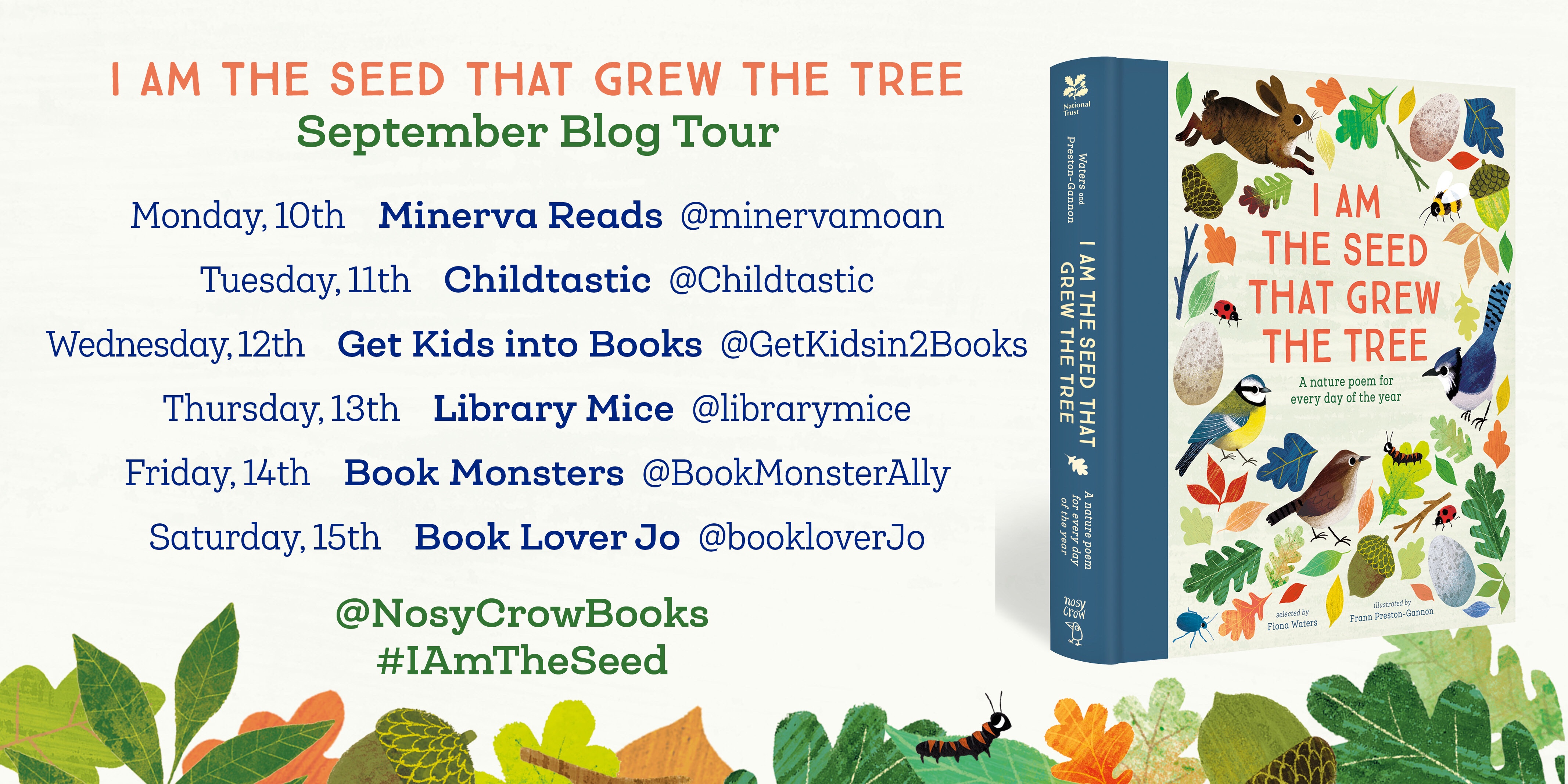
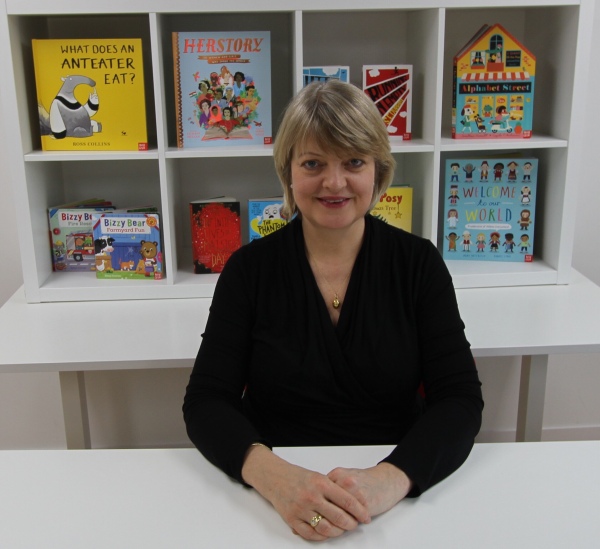 I Am the Seed That Grew the Tree is an ambitious anthology of nature poems especially selected for children. It was published this month by Nosy Crow, in association with the National Trust. Publisher Kate Wilson describes it as the book she is most proud of publishing in her thirty year career. I am delighted to welcome her to my blog today to talk about her favourite poems.
I Am the Seed That Grew the Tree is an ambitious anthology of nature poems especially selected for children. It was published this month by Nosy Crow, in association with the National Trust. Publisher Kate Wilson describes it as the book she is most proud of publishing in her thirty year career. I am delighted to welcome her to my blog today to talk about her favourite poems.
Kate Wilson: One of the joys of publishing a poetry book in which there’s a poem for every day of the year is that you get to choose the poem that is your birthday poem. I chose a silly, anonymous poem for my own birthday: I Sometimes Think I’d Rather Crow. Silly, but true: as the founder of Nosy Crow after a long career in publishing, I almost always think I’d “rather crow”.
But I can’t say that it’s my favourite poem in the book. Every time I think I have settled on a favourite, another one comes to mind, and one of the joys of this book was that, in its long, long genesis, there was plenty of time to discover and remember poems and suggest them to the brilliant, knowledgeable and terribly patient anthologiser, Fiona Waters.
But if I absolutely have to choose, my favourite remembered poem is Stopping By Woods On A Snowy Evening by Robert Frost, a poem I first read forty long years ago, and can still recite, my memory aided, I think, by the rather lovely London Gay Men’s Chorus sung version of it.
And my favourite poem that I have discovered through its inclusion in this collection is, I think, the one that gave it its name, Windsong, by Judith Nicholls:
I am the seed
that grew the tree
that gave the wood
to make the page
to fill the book
with poetry
Get Kids Into Books: Thanks Kate for sharing these personal reflections. I’ve yet to narrow my favourites down to a single poem, but I did particularly love discovering Conkers, the poem that has been chosen for my birthday.
You can read my review of I Am the Seed That Grew the Tree here. Make sure to check out the other stops on the blog tour too.
Isla and Pickle Blog Tour
23 June 2018
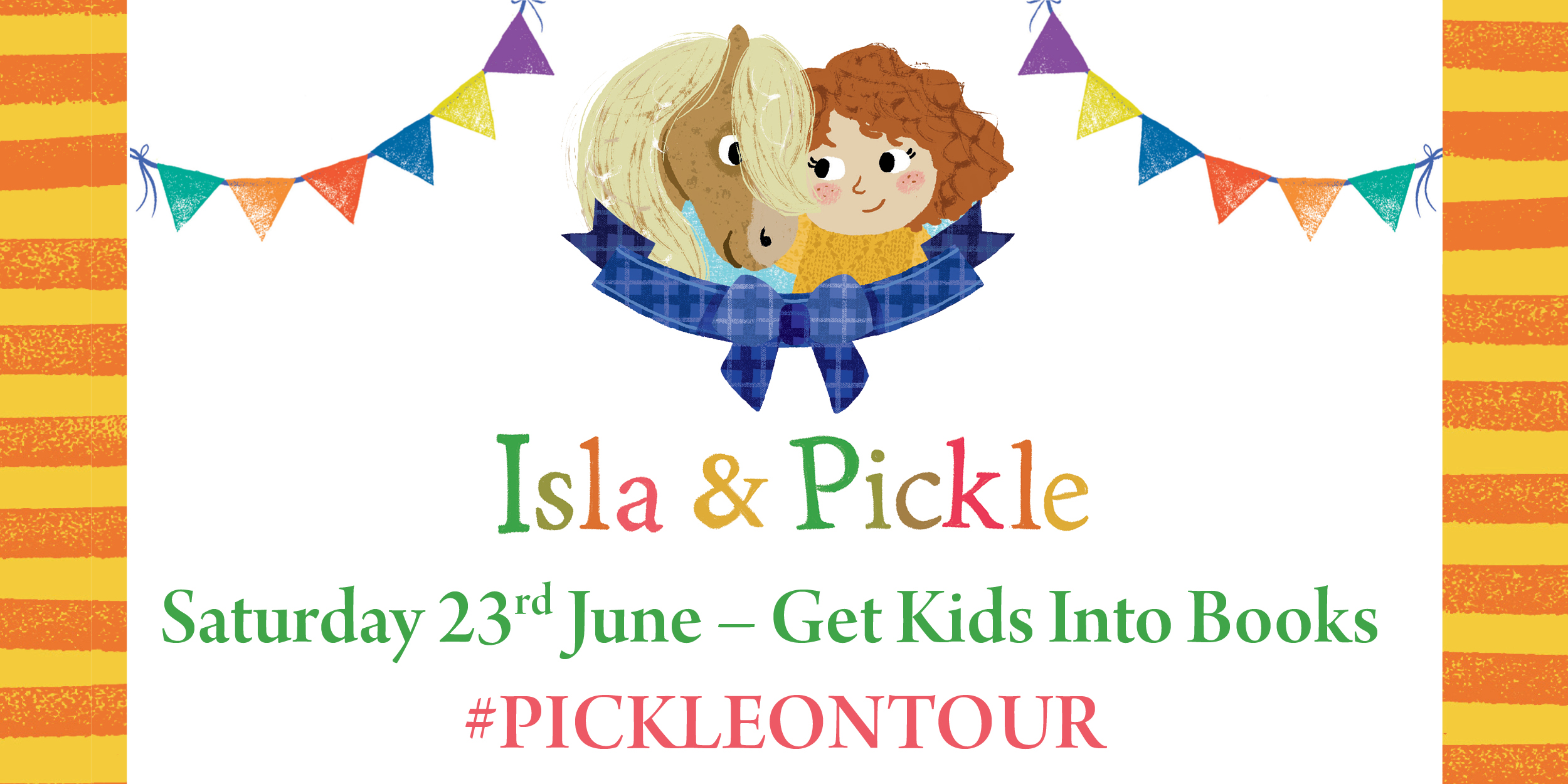
Picture book author and illustrator Kate McLelland has her own favourite picture books that have helped inspire her as a reader, writer and artist. I’m delighted to welcome her to my blog today. It’s been a tough task but Kate has managed to whittle down her bookshelf to a stack of just five of her all-time favourite picture books. Read on to find out if you share any favourites with Kate.
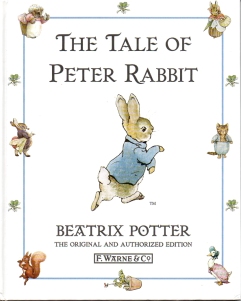 Peter Rabbit, Beatrix Potter
Peter Rabbit, Beatrix Potter
I couldn’t have a top 5 list without Beatrix. As an adult she has inspired me on many levels, but as a child I just loved her cheeky – and often dark – tales about animals wearing clothes! Peter Rabbit is the first book I remember loving, it stays with you in such a way that every time I see carrots growing, I instantly think of Peter and Mr McGregor.
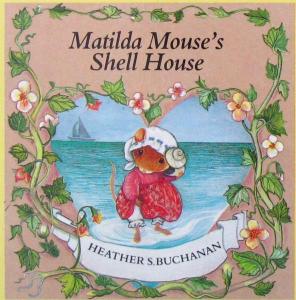 Matilda Mouse’s Shell House (Tales of George & Matilda Mouse), Heather S. Buchanan
Matilda Mouse’s Shell House (Tales of George & Matilda Mouse), Heather S. Buchanan
I had the whole series of Matilda Mouse books. They were about adventure and friendship. I loved the illustrative details and these have impacted my own work for years. In particular, there is a spread where Matilda gets her own house made from sand and decorated with shells. I have popped a version of that image in Isla and Pickle’s first adventure, Isla and Pickle: Best Friends, as a little nod to that book.
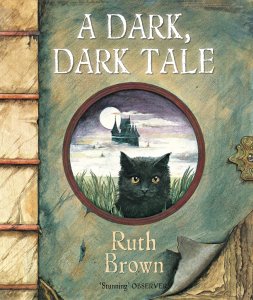 A Dark, Dark Tale, Ruth Brown
A Dark, Dark Tale, Ruth Brown
I think this was my favourite Ruth Brown book, but it is hard to pick just one as I loved them all. Ruth Brown’s illustrations are quite realistic – I can only think of The Tale of Two Mice where the animals are clothed. Generally her animals are natural, but so full of character. I think there is sometimes a feeling that animals need to be anthropomorphized to make them emotive – but Ruth Brown’s work convinced me otherwise a long time ago.
Big Baby, Jon Ward and Claudio Munoz
This was first published in 1986 and was one of my first picture books. It basically tells the story of an older sibling pinching cake from his baby sister. She starts to cry and as she cries, she gets bigger, and bigger and . . . Well, you can’t go wrong with cake and a giant baby! I recently ordered a copy all the way from America, as it is out of print, just so I could read it to my daughter. Now she loves it too and can recite the whole story. The simplicity is the key to why I loved this story and why it has stayed with me over the years.
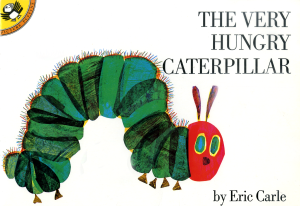 The Very Hungry Caterpiller, Eric Carle
The Very Hungry Caterpiller, Eric Carle
This book is the perfect example of when everything comes together. Carle’s energetic collage illustrations are so accessible for young readers. The story is simple, yet it tells a universal story of transformation. It is a great introduction to counting, colour and natural history and the page turns and dye cuts are just brilliant. I still remember the first time I turned the pages.
Thanks for visiting my blog today, Kate, and for sharing some of the books that have inspired you.
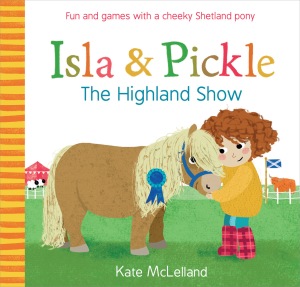 Isla & Pickle: The Highland Show is the second picture book in a new series about a feisty little girl, a cheeky Shetland pony and their adventures. They live on a Scottish island where they get up to all sorts of mischief, led by Pickle the pony, who enjoys escaping from his field and getting very messy! Perfect for any children with a penchant for ponies, this book is full of fun in the great outdoors, with bright, humorous illustrations that are sure to make grown- ups smile and give wee ones the giggles.
Isla & Pickle: The Highland Show is the second picture book in a new series about a feisty little girl, a cheeky Shetland pony and their adventures. They live on a Scottish island where they get up to all sorts of mischief, led by Pickle the pony, who enjoys escaping from his field and getting very messy! Perfect for any children with a penchant for ponies, this book is full of fun in the great outdoors, with bright, humorous illustrations that are sure to make grown- ups smile and give wee ones the giggles.
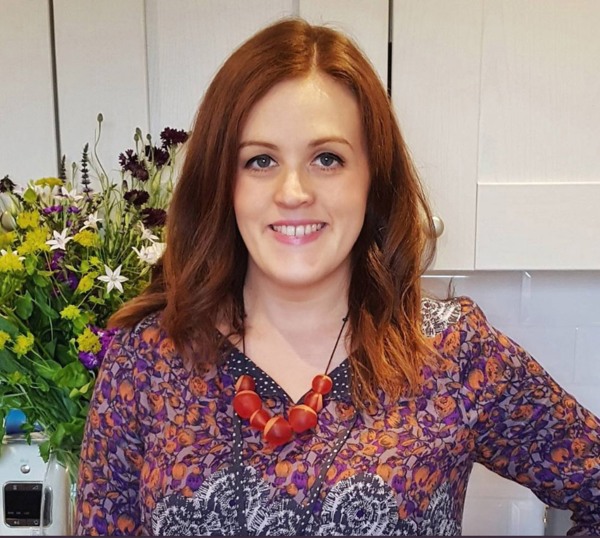 Kate McLelland is an accomplished illustrator and printmaker. She trained in illustration at Edinburgh College of Art. She is the illustrator of bestselling picture book There Was a Wee Lassie Who Swallowed a Midgie and the much-loved My First Scottish board book collection, and has received and been nominated for a range of awards.
Kate McLelland is an accomplished illustrator and printmaker. She trained in illustration at Edinburgh College of Art. She is the illustrator of bestselling picture book There Was a Wee Lassie Who Swallowed a Midgie and the much-loved My First Scottish board book collection, and has received and been nominated for a range of awards.
Check out the other stops on the tour for more exclusive content.
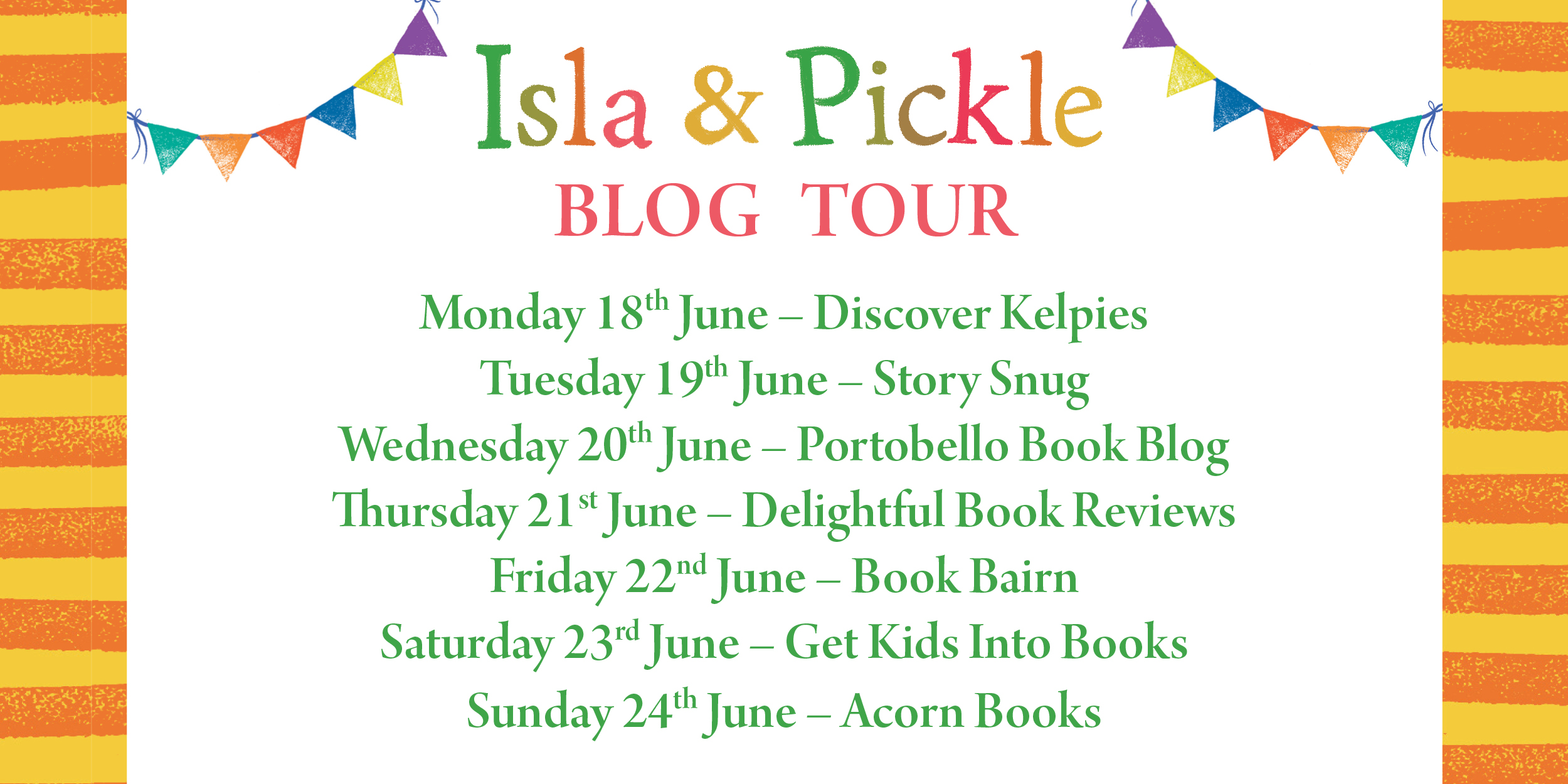
The Secret of the Night Train Blog Tour
23 May 2018
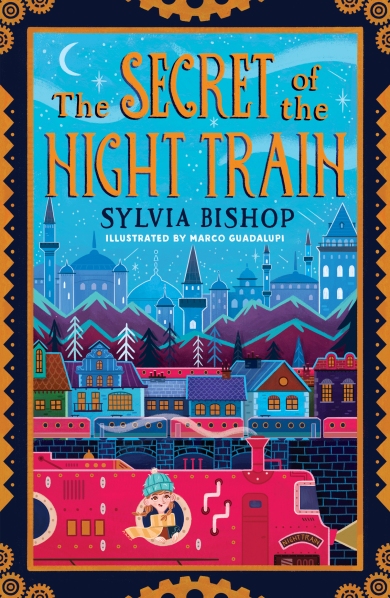 In Sylvia Bishop’s fabulous new book, The Secret of the Night Train, Max Morel takes a journey from Paris to Istanbul on four trains. She is accompanied by a nun called Sister Marguerite, and must solve the mystery of a smuggled diamond. Sylvia was lucky enough to make this journey herself, and wrote a lot of the book on board. In a series of blog posts this week, she talks about her real journey, and how it informed the book.
In Sylvia Bishop’s fabulous new book, The Secret of the Night Train, Max Morel takes a journey from Paris to Istanbul on four trains. She is accompanied by a nun called Sister Marguerite, and must solve the mystery of a smuggled diamond. Sylvia was lucky enough to make this journey herself, and wrote a lot of the book on board. In a series of blog posts this week, she talks about her real journey, and how it informed the book.
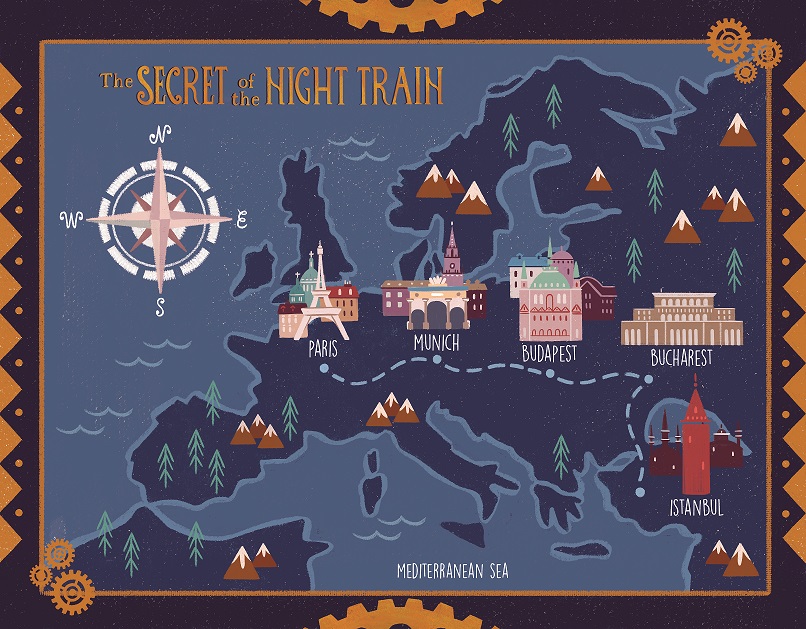
Get Kids into Books: Hi Sylvia, I’m delighted to welcome you to my blog today. I’m fascinated by the journey that you, and Max, took. We’re day three of your journey. Tell us more about Budapest.
Sylvia: If you travel from Paris to Istanbul by train without any unnecessary breaks to the journey, you can mostly catch your next train within a few hours of your last. The only city where you need to wait for any length of time is Budapest. So, on my story plan, there was a section marked out where Max would spend a day there.
This section just listed a bunch of things Max had to learn at this point in the story. I am always wary of chapters like this, that just get you from A to B. They are abstract, and you need a concrete setting or activity for the chapter itself. Concrete settings generate rules. Rules in turn produce ideas.
For example, in my book The Bookshop Girl, I set one such chapter in a posh café. Rules of a posh café include: ‘At regular intervals a waiter will ask if you need anything.’ ‘You cannot wave your arms around too much without causing a mess.’ ‘Odd-looking people and animals will arouse suspicion.’ All this is very productive – it generates ideas for a scene that is fun, and not just functional.
Seeing a real actual city with a real actual geography was a great way to set rules. If Max tries to hide here, there will be crowds, but here it would be deserted; if Max goes to these baths, then options for a nearby scene are limited to a park or an ice-rink; if Max ends up here, there is a limit on how quickly she can get back to the train station. Suddenly ideas suggest themselves.
Also, guys, spending time in Budapest was great.
All the buildings are beautiful. All of them. And because these swirling, colourful, grand buildings are no big deal, they think nothing of having fast food chains or phone repair shops with neon signs on the ground floor, so the high streets are an incredibly confusing mash-up.
Budapest is famous for its baths, and I thought that a good and sincere writer really ought to go and see those baths, for, y’know, authenticity. The baths I went to were outdoors, and Budapest is cold in February. There is a brief moment, as you are scurrying pink-skinned towards the bubbling water, when you wonder if this is maybe the stupidest thing you’ve ever done. Then you sink into those warm bubbles, and realise the answer is NO. NO, this is in fact the best thing you have ever done, and you are now blessed among men. Excellent.
In conclusion… set your abstract, plotty scenes in concrete, rule-bound places. And go to Budapest. Especially the baths.
Get Kids into Books: Thanks for such a fantastic guest post, Sylvia. *Adds Budapest to bucket list.*
Join Sylvia for the next stage of the journey tomorrow on Anna’s Adventures in Book Land.
The Secret of the Night Train by Sylvia Bishop is out now, published by Scholastic (RRP £6.99). You can read my review here.
** For a chance to win a copy of The Secret of the Night Train, start following my blog. Competition closes 15 June 2018. UK and EIRE only. **
The Treasure of the Loch Ness Monster Blog Tour
12 May 2018

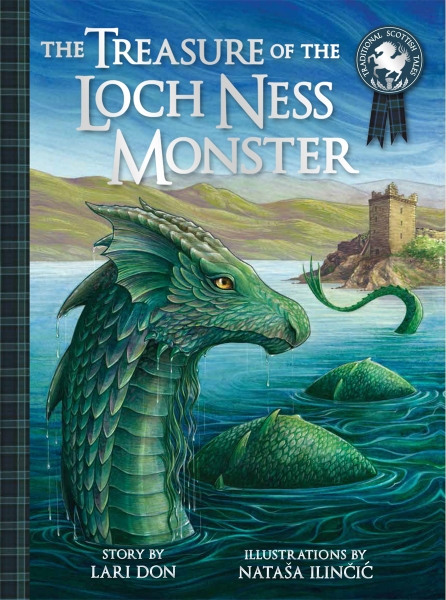 The Treasure of the Loch Ness Monster is a new picture book by Scottish children’s author Lari Don and illustrator Nataša Ilinčič. It is inspired by folklore and legend and combines two magical tales to create a new Loch Ness Monster myth.
The Treasure of the Loch Ness Monster is a new picture book by Scottish children’s author Lari Don and illustrator Nataša Ilinčič. It is inspired by folklore and legend and combines two magical tales to create a new Loch Ness Monster myth.
I’m delighted to welcome Lari Don to my blog today.
Get Kids into Books: I’m really interested to learn about how pictures and words combine in a picture book.
Lari Don: The most important elements of a picture book are… the pictures! So the role of an author writing a story for a picture book is very different from the role of an author writing a novel. When I write a novel, my aim is to put pictures – of the characters, the action, the magic – into my readers’ heads. But when I’m working on a picture book, I know that the story will be brought to life by the skill of an illustrator, so my words have a different function.
I’ve realised (albeit slowly, as I’ve worked with editors, art designers and illustrators on half a dozen picture books) that one of my responsibilities as a writer of picture books is to create opportunities for wonderful illustrations. And I’ve also learnt that I can, and should, leave spaces within the narrative for the artist to tell the story themselves, because the words and the pictures should tell the story together. The pictures are never just an afterthought, stuck in there to show what the words have already said.
When I was drafting the text for The Treasure of the Loch Ness Monster, I knew that I wanted to give the artist scope to create as full a world for Nessie as possible. That meant not only pictures of the shores of Loch Ness and the surface of Loch Ness, but also at least one underwater scene. As I played with the story, I kept circling round plot ideas that took the characters and therefore the readers down into the depths of Loch Ness. I didn’t know what Nataša Ilinčić would draw for that scene, but I did know that I had to write a plot, which gave her the chance to explore it.
So when I write a picture book, I weigh up the plot not just from the point of view of the characters and the readers, but also with the aim of offering the illustrator plenty of chances to create original, magical and dramatic pictures. After I’ve written the text, there is a long and intriguing wait while the editor and art designer brief the artist, then the artist creates their initial rough sketches. (This long wait is fine: I’m happy to leave the look of the book up to the experts; also I usually have a new novel to write…)
When the roughs come back, I used to think my job was to suggest changes to the artwork in order to fit the text, but I’ve realised that it’s often easier and sometimes better to change the text to fit the pictures. And I love it when the picture tells the story so well that I can edit words out of the draft text. In this book, for example, the expression on Nessie’s face, when she finally meets Ishbel and Kenneth, contains much more emotion than I could have written in several paragraphs.
One of the strengths of a picture book is that it’s not just the writers’ story. A picture book (unless it is created by one of those amazingly talented people who can write AND draw) is created by two people’s imaginations. The world of a picture book is not just the writer’s world, it is the illustrator’s world too: a shared world that is enhanced and deepened by both our imaginations. When the illustrator is someone as talented and wise and deeply immersed in folklore and history as Nataša, then the
illustrations bring a huge amount to the story’s world.
I love being surprised by someone else’s vision of the story. In this book, the treasure chamber that Nataša imagined under Castle Urquhart took my breath away. I’d
imagined a small dark room containing not much more than the treasure necessary for the plot, but Nataša drew a huge arched chamber filled with fascinating objects from legend and history. I see something new everything I look at it! And that’s the joy of writing picture books. I knew what I needed the room to contain for the characters and the narrative, and Nataša drew that perfectly, but then she added her own magic, her own vision, and she made the story so much stronger.
Picture books are all about teamwork, and I was privileged to work on The Treasure of the Loch Ness Monster with the wonderful team of editor Eleanor Collins, art designer Leah McDowell and the truly magical artist Nataša Ilinčić. A picture book might start with the author, but it takes a whole team to put it in your hands…
Get Kids into Books: Thanks for such a fascinating insight into the process, Lari. Good luck with the book and the rest of the tour.

Lari Don grew up in the north-east of Scotland, and lives in Edinburgh. She has worked in politics and broadcasting, but is now a full-time writer and storyteller. Lari is the author of more than 30 books for children of all ages, including The Fabled Beast Chronicles and Spellchasers trilogy for middle grade readers, Mind Blind for young teens, and picture books The Tale of Tam Linn and The Secret of the Kelpie, and she regularly visits schools and libraries to share her stories. Almost all her books are inspired by her love of traditional tales, and absolutely all her manuscripts are covered in muddy paw prints from her helpful cats. Find out more by visiting her website: www.laridon.co.uk
 Nataša Ilinčić is an artist and illustrator originally from Croatia, now living and working in Edinburgh. Nataša was brought up on the foot of the Italian Alps where she spent much of her childhood befriending ancient trees and exploring ruins. Following her academic studies in Archaeology and Cultural Anthropology, she moved to Edinburgh to pursue a career in art and illustration, drawing inspiration from mythology and folklore. Her work has been shortlisted for the Folio Society Book Illustration Competition 2017, and has been exhibited in various galleries, including the London House of Illustration.
Nataša Ilinčić is an artist and illustrator originally from Croatia, now living and working in Edinburgh. Nataša was brought up on the foot of the Italian Alps where she spent much of her childhood befriending ancient trees and exploring ruins. Following her academic studies in Archaeology and Cultural Anthropology, she moved to Edinburgh to pursue a career in art and illustration, drawing inspiration from mythology and folklore. Her work has been shortlisted for the Folio Society Book Illustration Competition 2017, and has been exhibited in various galleries, including the London House of Illustration.
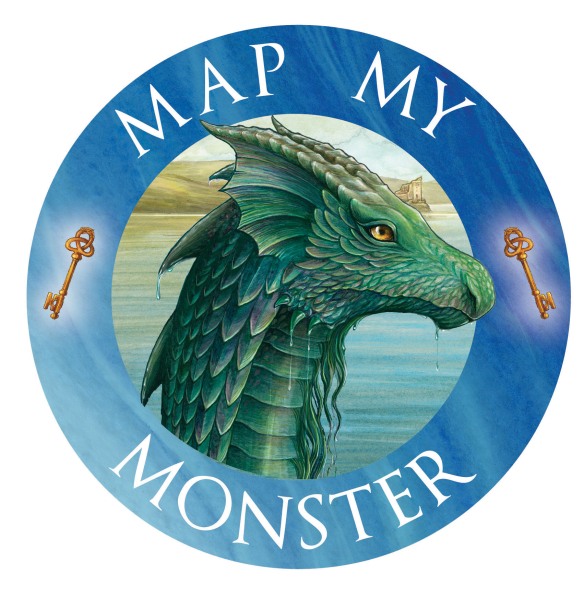 The Discover Kelpies team are looking for young monster spotters to enter their Map My Monster art competition. To enter the competition for a chance to win a bundle of signed books by Lari Don just draw a picture of your local mythical monster on their
The Discover Kelpies team are looking for young monster spotters to enter their Map My Monster art competition. To enter the competition for a chance to win a bundle of signed books by Lari Don just draw a picture of your local mythical monster on their
special Map My Monster sheet. Don’t worry if you don’t have a local monster – you
can borrow one from another place, or create your own! For more details visit
https://discoverkelpies.co.uk/picture-kelpies/map-my-monster
Luna and the Moon Rabbit Blog Tour
1 May 2018
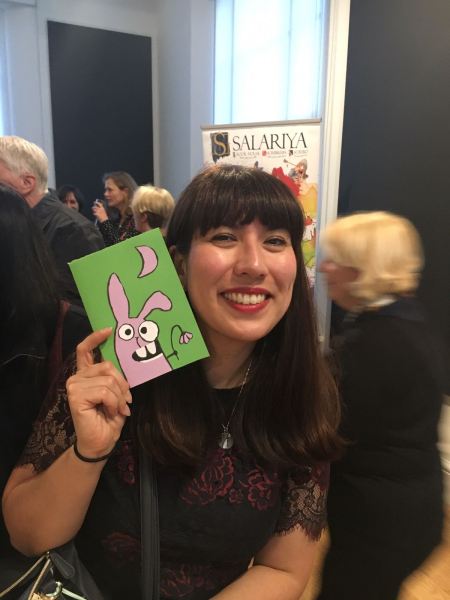 I’m delighted to welcome author/illustrator Camille Whitcher to my blog today.
I’m delighted to welcome author/illustrator Camille Whitcher to my blog today.
Camille: Hello and thank you for inviting me to write here!
Get Kids into Books: My pleasure. I’m really interested to hear about the influences on your work.
Camille: My work is undeniably influenced and inspired by my Japanese background. Although I was born and brought up in London and had one English parent, I didn’t really feel like an English kid, always an “other”. Of the few books I had growing up, most were Japanese stories such as Momotarō (Peach Boy) and Shita-kiri Suzume (Tongue-cut Sparrow) or Western stories written in Japanese such as Aesop’s Fables. For quite a while, I didn’t know that Arnold Lobel’s Frog and Toad wasn’t a Japanese story!
However, I actually didn’t spend much time reading as a child. Most of my time was spent watching tv, drawing and making things, no bit of scrap paper or cereal box was safe from my clutches! Quite a lot of what I drew or made was based on things I’d seen on TV such as cartoons, animation or art programmes like Hartbeat. Now that I think about it, one of my favourite programmes as a child was Mooncat with Beryl Reid! Mooncat…Moon Rabbit….Hmmmm…
My other favourite subject to draw as a child was my toys. My beloved Sindy doll featured heavily in my pictures as well as my Monchicchi dolls. I didn’t have a lot of possessions as a child but most of what I did have, toys and stationery etc., were from Japan and were always decorated with some cute character or other which I would then try to draw. After some practice, I think I’d got how to draw ‘Doraemon’ down pat!
As I grew up and even now, I continued to love these “fancy goods”, and when I moved to Japan to teach English, I think I spent more money than was wise on collecting such kitsch, particularly cute stationery.
It was at this time, while living and working in Japan, I fell in love with picture books. Japan seemed to embrace picture books far more than in the UK. There are quite a few museums dedicated to picture books and picture book makers such as the Inori-No-Oka Picture Book Museum in Nagasaki, the Picture Book Museum in Iwaki, and The Chihiro Art Museum in Tokyo, which commemorates the work of artist, Chihiro Iwasaki.
I can’t deny the influence on my work by my Japanese background but I am wary about being penned in by it. My work will probably always have a Japanese tinge to it but I’d say I’m more influenced by stories, folk tales and myths, wherever they may be from. Of course the best stories come from Japan, especially the Grimm Brother’s Fairy Tales… wait… what?!
Get Kids into Books: Thanks for such a fascinating insight, Camille.
You can read my review of Luna and the Moon Rabbit here. Check out the other stops on the blog tour below.
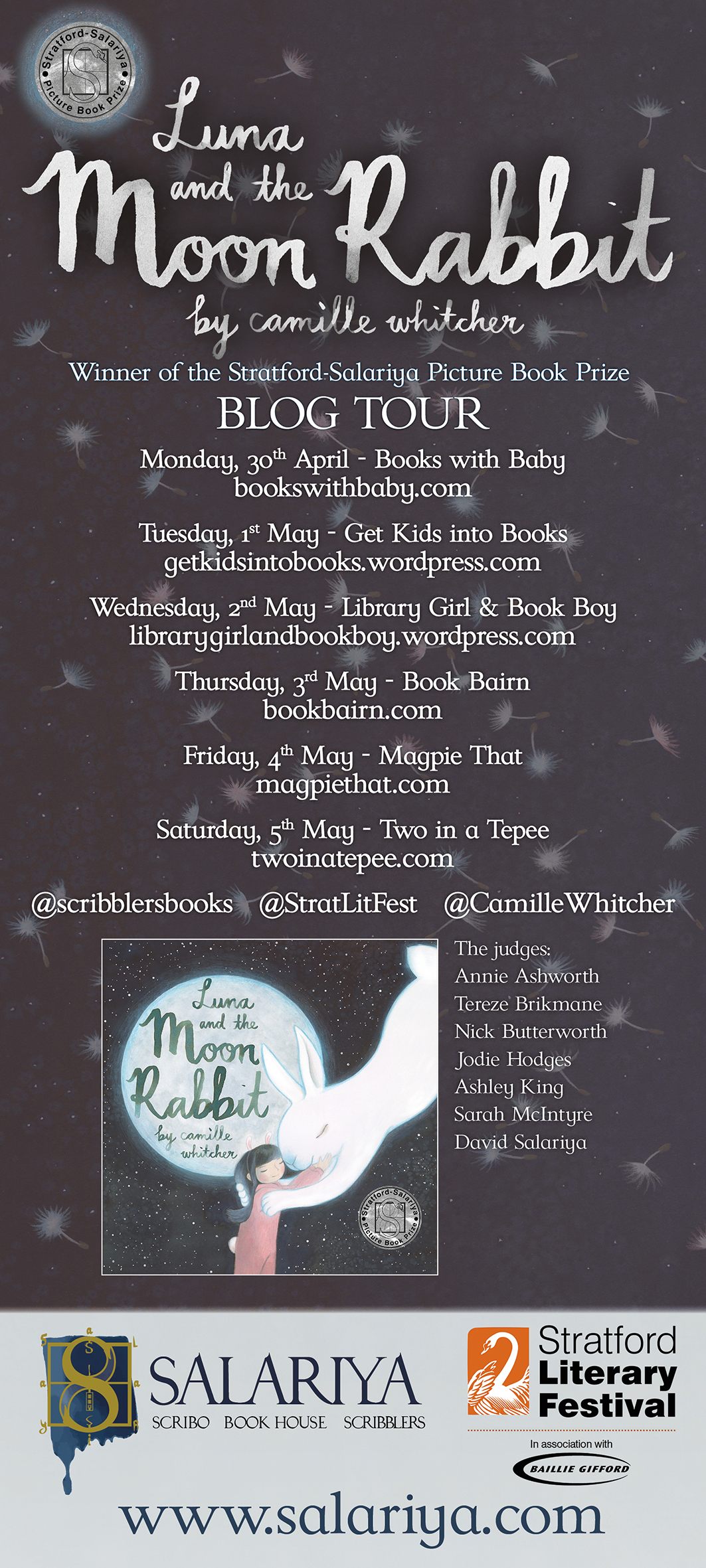
Sam’s First Book Festival
Bournville BookFest, 16 March 2018
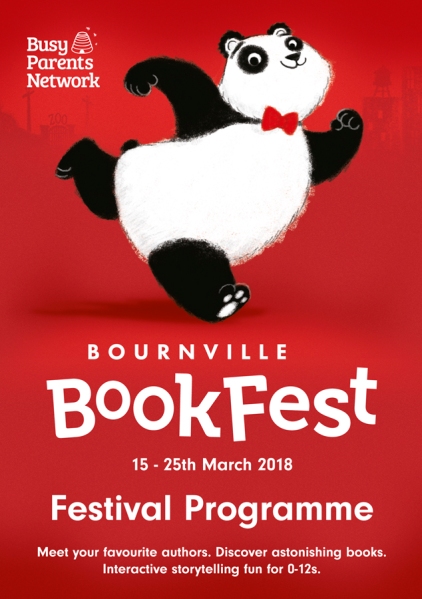
I was very excited when I found out about the Bournville BookFest (I had never been before) and I bought our tickets the day they went on sale. It turns out that this was the fifth year of the annual Birmingham children’s book festival. Bournville BookFest has grown every year since it began and this year it hosted 150 book events in venues across the city. It welcomed lots of fabulous children’s authors and illustrators, including Michael Rosen and Lucy Worsley. Over 10,000 visitors attended the ten-day festival, with lots of events selling out weeks in advance.
 I booked tickets for Sam and I to hear author-illustrator Steve Lenton read his fabulous picture book, Let’s Find Fred. The book has long been a bedtime favourite of Sam’s and so I was excited for him to hear it read by its creator. We bagged ourselves seats at the front and we took our copy of the book so we could read along. Steve had a great rapport with the children and after the story he showed us, step by step, how to draw Fred.
I booked tickets for Sam and I to hear author-illustrator Steve Lenton read his fabulous picture book, Let’s Find Fred. The book has long been a bedtime favourite of Sam’s and so I was excited for him to hear it read by its creator. We bagged ourselves seats at the front and we took our copy of the book so we could read along. Steve had a great rapport with the children and after the story he showed us, step by step, how to draw Fred.
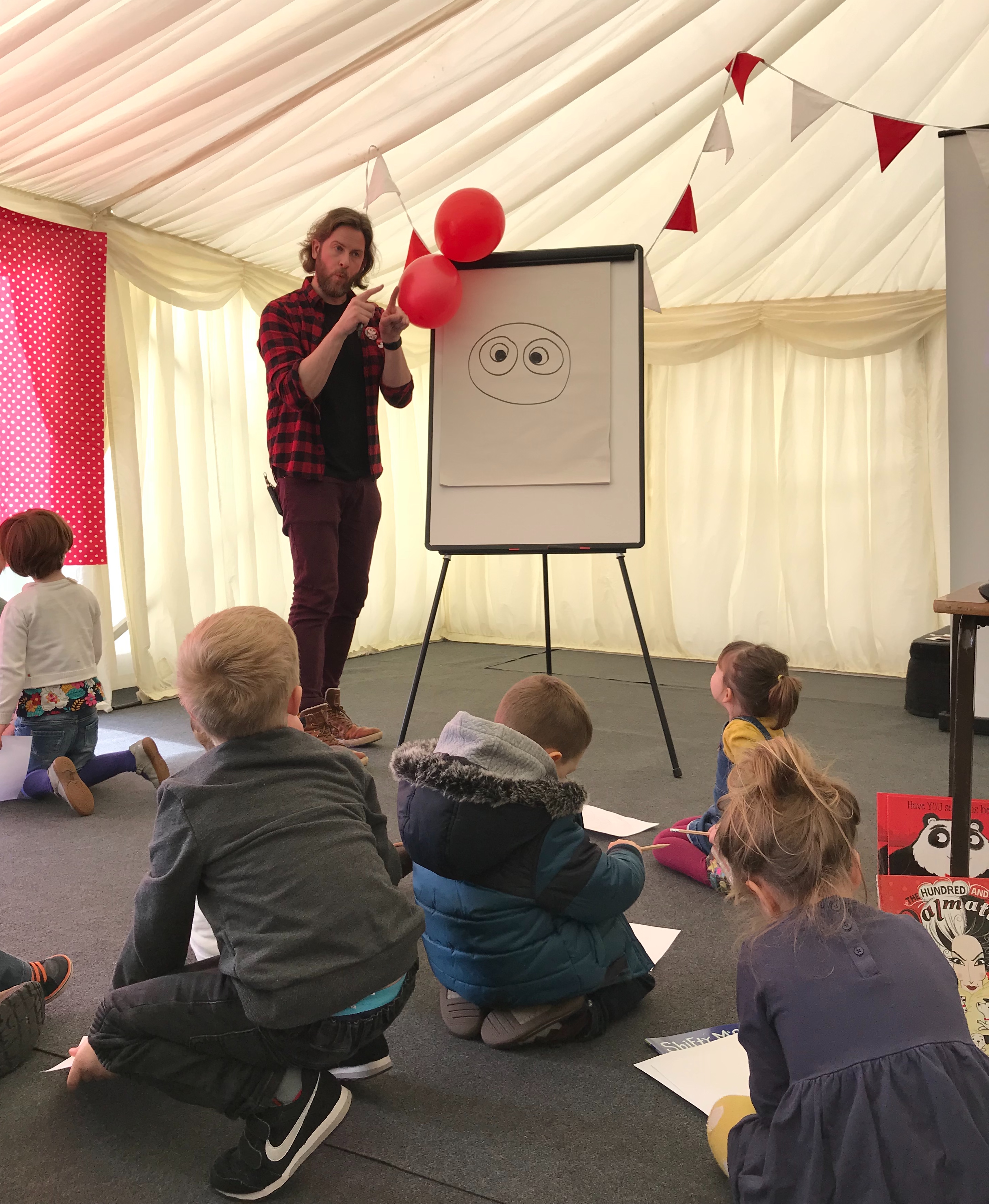
We then got to make our own Fred masks. The festival team had set up tables at the back of the room with mask making packs (very well organised), and Steve guided us through the different stages. Sam and I were pretty pleased with the results!
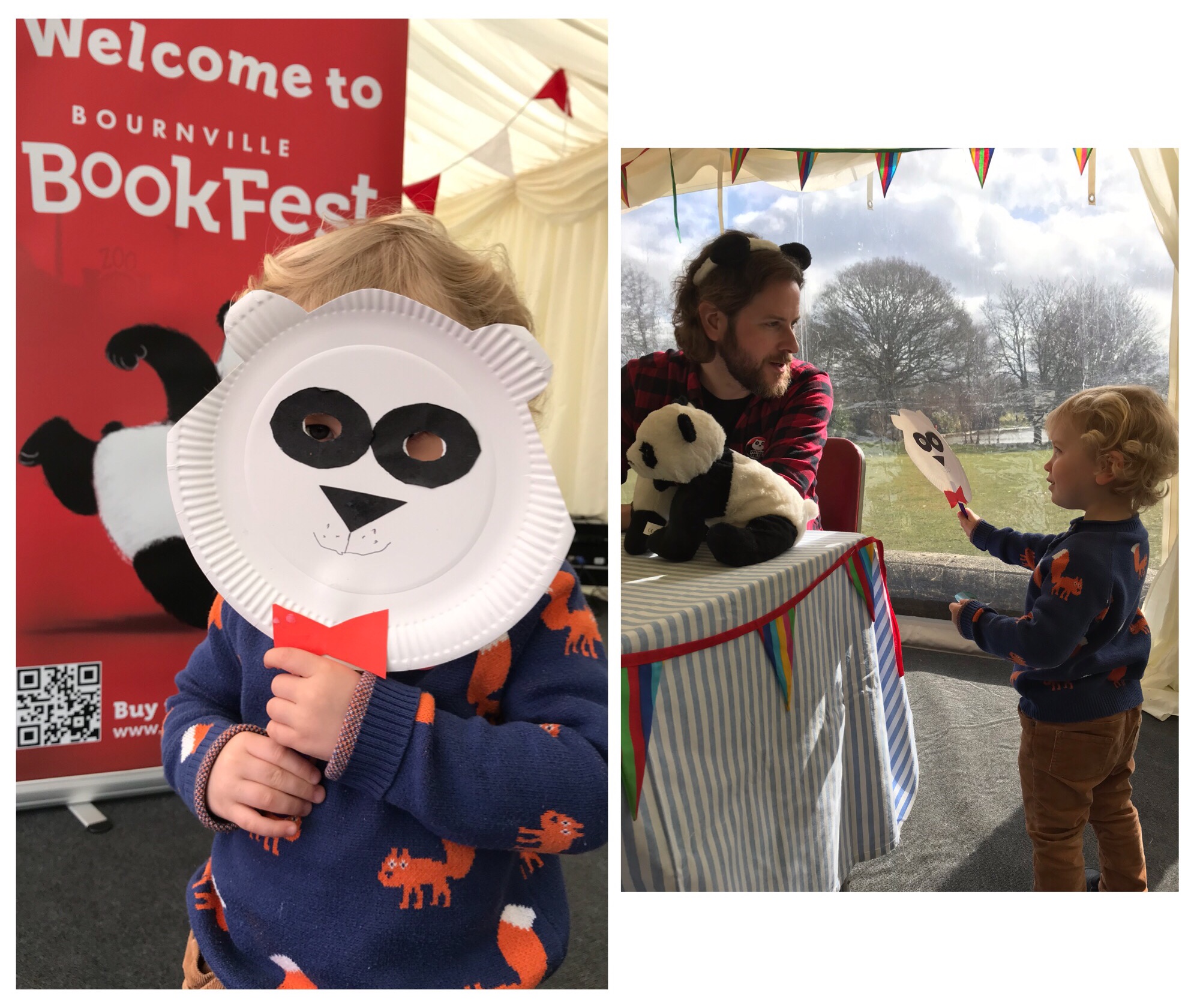
The event was great fun and the perfect introduction to a book festival for Sam. You can read my review of Let’s Find Fred here.
There was a fairly long gap until our second event and Sam and I had lots of fun playing in the lovely big park next to the venue. However, it did mean that Sam was worn out when our 4pm big sing-along with Nick Cope began. Next year I’ll remember to book events closer together. Sam enjoyed listening to Nick sing and play his guitar but he did nod off 15 minutes into the 45-minute set! I giggled along to the rest of Nick’s songs though. Particular favourites were I’m just a little green bogey (absolutely hilarious lyrics) and Hugh the Hedgehog (which had a nice Country vibe).
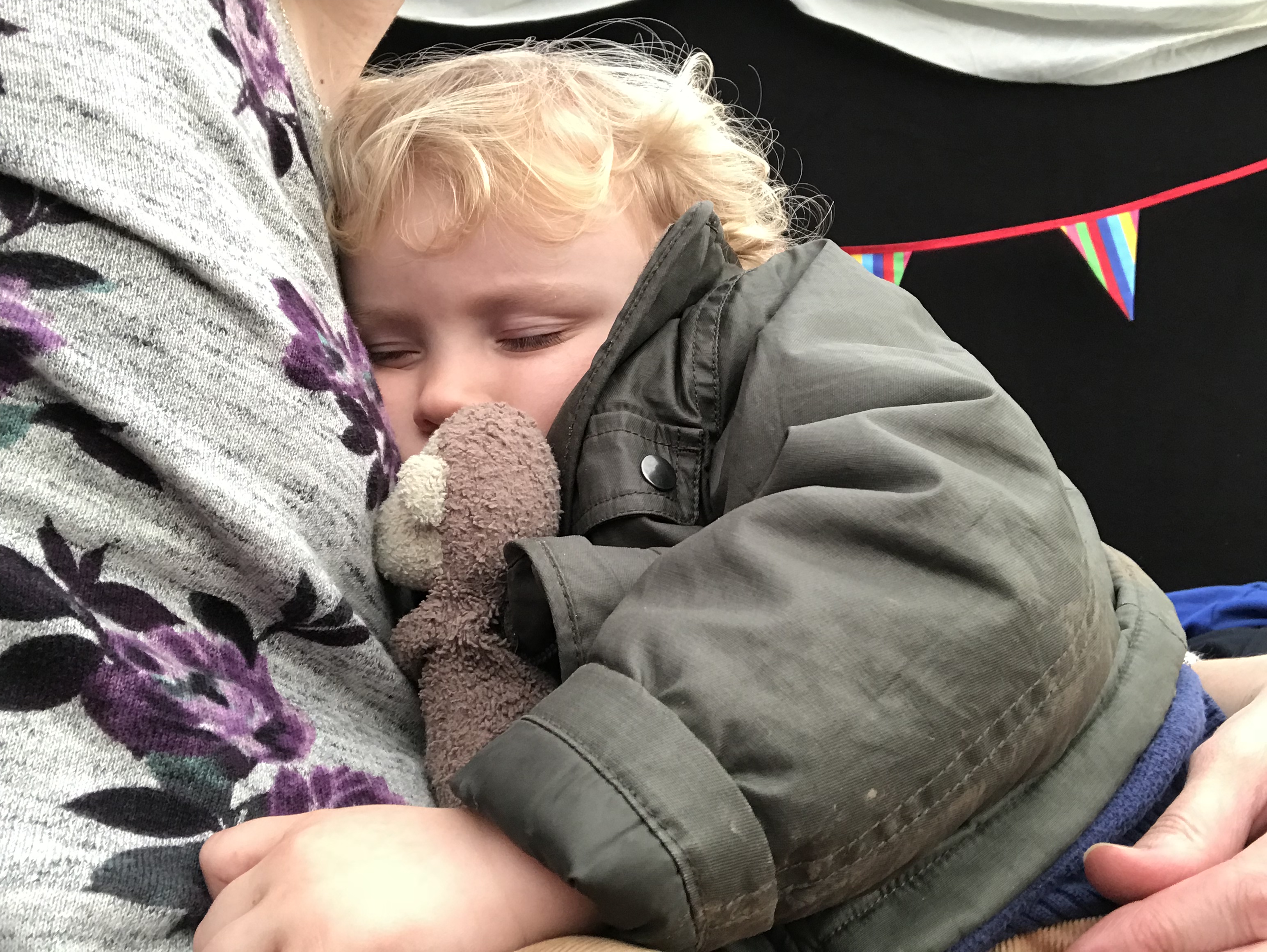
Tickets for Sam and I for both events cost £10 in total. I think this is brilliant value. The festival also organises lots of free events at libraries and other venues across the city. It makes the festival open to all, and helps make the arts inclusive not élitist.
We had lots of fun at Bournville BookFest. We even made it on to the local news later that evening. We’ll definitely be back again next year.

Bear Child Blog Tour
14 March 2018
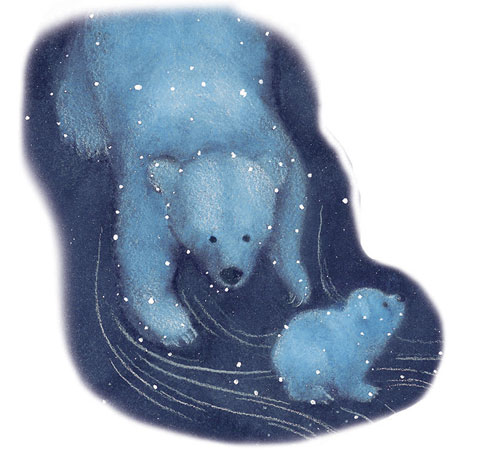 Bear Child is the début picture book from Geoff Mead. It’s an inspirational story of parental love, belief in mythical creatures, and the importance of embracing individuality. This beautiful picture book weaves together Geoff Mead’s charming words with Sanne Dufft’s ethereal illustrations to create a truly timeless folktale.
Bear Child is the début picture book from Geoff Mead. It’s an inspirational story of parental love, belief in mythical creatures, and the importance of embracing individuality. This beautiful picture book weaves together Geoff Mead’s charming words with Sanne Dufft’s ethereal illustrations to create a truly timeless folktale.
The story is a bedtime tale told by a father to his daughter. It’s with great pleasure that I welcome Geoff Mead to my blog today to talk about representations of strong girls in children’s fiction.
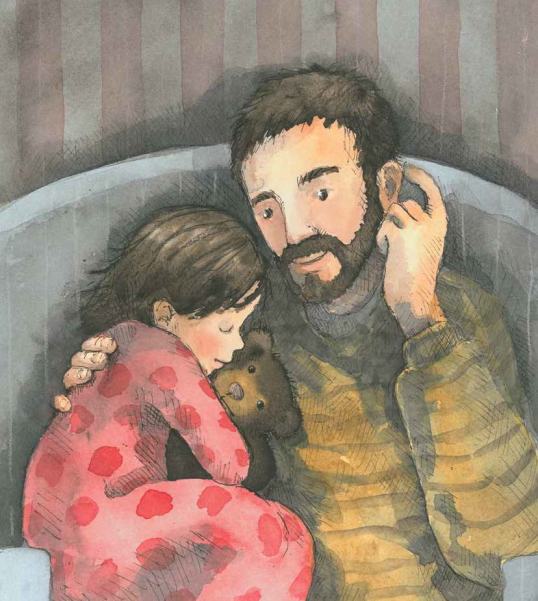 Geoff Mead: Sometimes they do and sometimes they don’t… This is what Ursula’s daddy tells her in Bear Child when she asks him if girls like her get married and have children when they grow up, and then he adds: …but they are all adventurous and they have extraordinary lives.
Geoff Mead: Sometimes they do and sometimes they don’t… This is what Ursula’s daddy tells her in Bear Child when she asks him if girls like her get married and have children when they grow up, and then he adds: …but they are all adventurous and they have extraordinary lives.
For me, this exchange is at the heart of the book. The story invites us – without judgement – to imagine the possibility that we can become the authors of our own lives. Girls can be strong and bear-like as well as feminine. They can be cooks and clowns and artists and teachers; they can travel far and wide and read lots of books; they can run and swim and ski as well as grow things in their gardens and take care of the world.
Of course, there are many strong girl characters in recent literature: Philip Pullman’s Lyra, for example; J.K. Rowling’s brainy Hermione; and the intrepid Hazel and Daisy in Robin Stevens’ Murder Most Unladylike series. But young girls today are still bombarded with images of Disney princesses and Barbies. As parents and teachers we have to work hard to redress the balance, so my story shows a father encouraging his daughter to believe that she only has to be herself.
We owe it to our children, both girls and boys to expose them to generative stories that give them the confidence both to embrace their unique characters and expand their possible life choices.
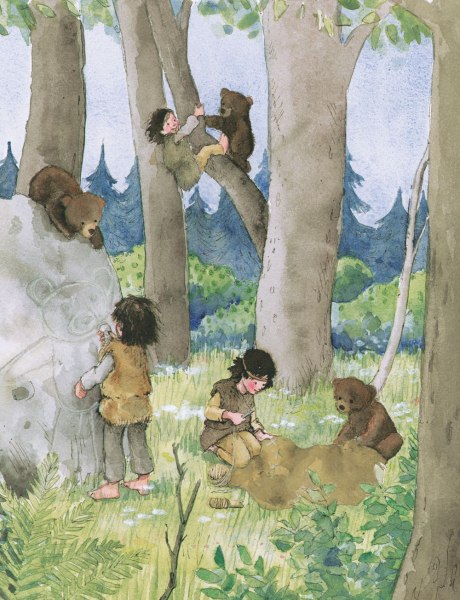 I originally wrote the story of Bear Child as a gift for my late wife, Chris, when she was in hospital having treatment for a brain tumour. Her lifelong love of bears and her fiercely independent spirit were the inspirations for Ursula. Her own father had been wonderfully supportive of his eccentric, intelligent and precociously talented daughter and I wanted to reflect some of his qualities in the character of Ursula’s daddy.
I originally wrote the story of Bear Child as a gift for my late wife, Chris, when she was in hospital having treatment for a brain tumour. Her lifelong love of bears and her fiercely independent spirit were the inspirations for Ursula. Her own father had been wonderfully supportive of his eccentric, intelligent and precociously talented daughter and I wanted to reflect some of his qualities in the character of Ursula’s daddy.
Perhaps because of its origins, I think I’ve somehow written a story that is bigger than me. It seems to touch everyone who reads it. A few months ago, I fell into conversation with a young woman sitting next to me on a coach journey. She told me that she had just finished her studies at Oxford University and asked me what I did. I told her I was a writer and showed her the proofs of Bear Child on my laptop. When she finished, she was in tears. “Every girl should read this story,” she said. “Because we are all different.”
Spyder Blog Tour
8 February 2018
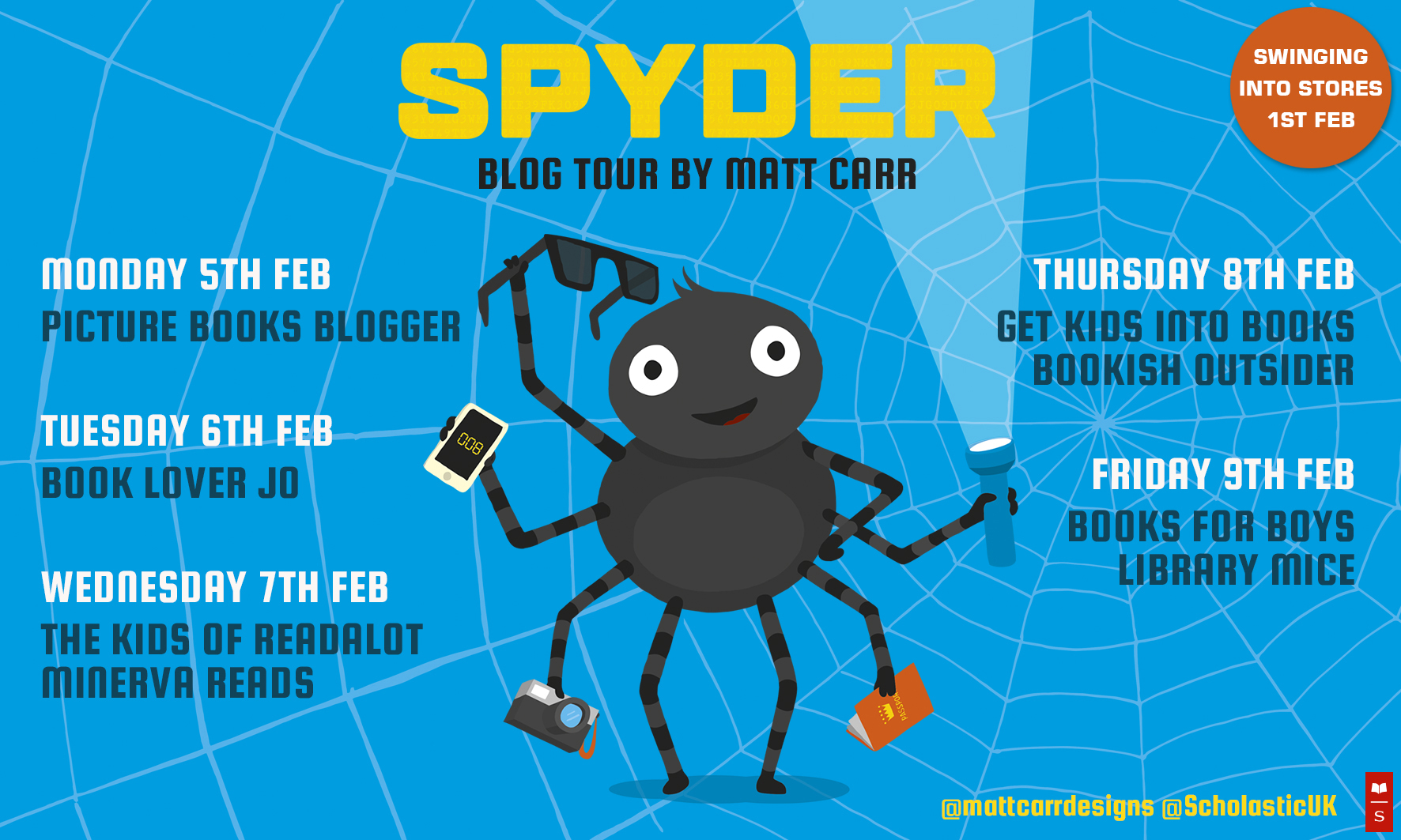
Matt Carr is an incredibly talented graphic designer and author-illustrator whose début picture book, Superbat, was published to international acclaim and is currently shortlisted for a number of upcoming awards. We spotted yesterday that it’s up for the 2018 Waterstones Children’s Book Prize. I’m thrilled to be able to welcome Matt to the blog today to talk about the creative process involved in creating his latest picture book, Spyder.
 THE IDEA
THE IDEA
I’m not sure how other people go about making a picture book, but with me it usually starts when I go for an early run up on the downs. When I say a run, it’s more of a slow plod but it does the trick. As I live in a tiny house with my other half, three daughters and two cats and my studio is a 6 x 3 lean to at the back of the kitchen, it’s the only time I get a bit of proper peace and quiet thinking time! So usually I’d think of something that makes me laugh and go from there, working it out in my head as I jog about. Then I’ll come home and jot it down so I don’t forget any of the gags etc. SPYDER actually started life as a sidekick for another character but she turned out to be a lot cooler!
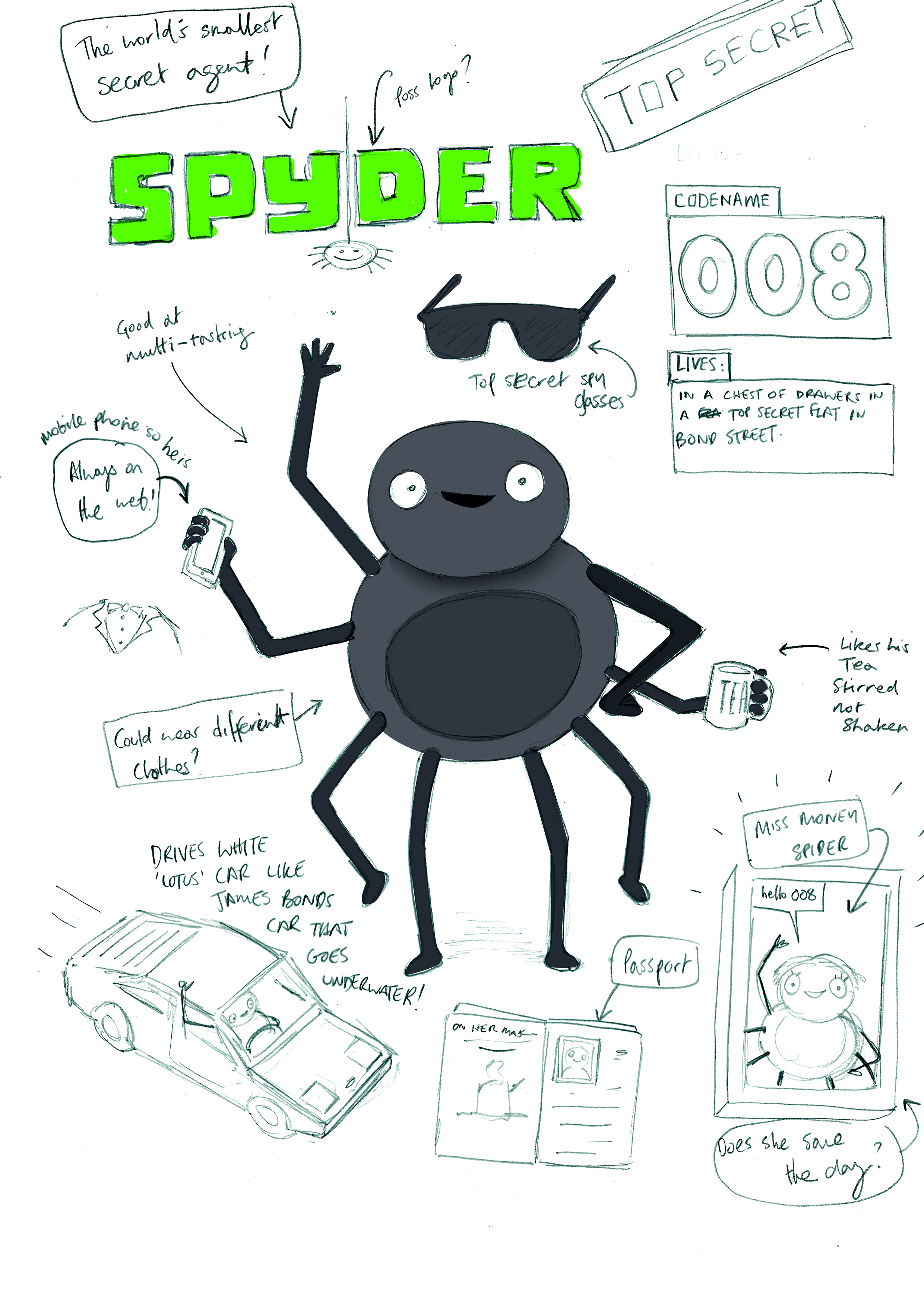 I usually then have to get on with my day job of designing things for people so I have to develop my books in my spare time but…
I usually then have to get on with my day job of designing things for people so I have to develop my books in my spare time but…
THE STORYBOARD
If I get something I really like then I like to get the storyboard finished as soon as possible and get it off to see if anyone likes it… For me this is the best bit as it’s when it’s at its purest and there’s no pressure so you can play about and put in gags and funny bits and see if they work. I think of each spread like a movie still and I like to play about with scale, just like they do on a movie. I also try out the idea on my kids, especially my youngest as if she doesn’t get it then it’s not going to work! The rest of my family are also a good sounding board too.
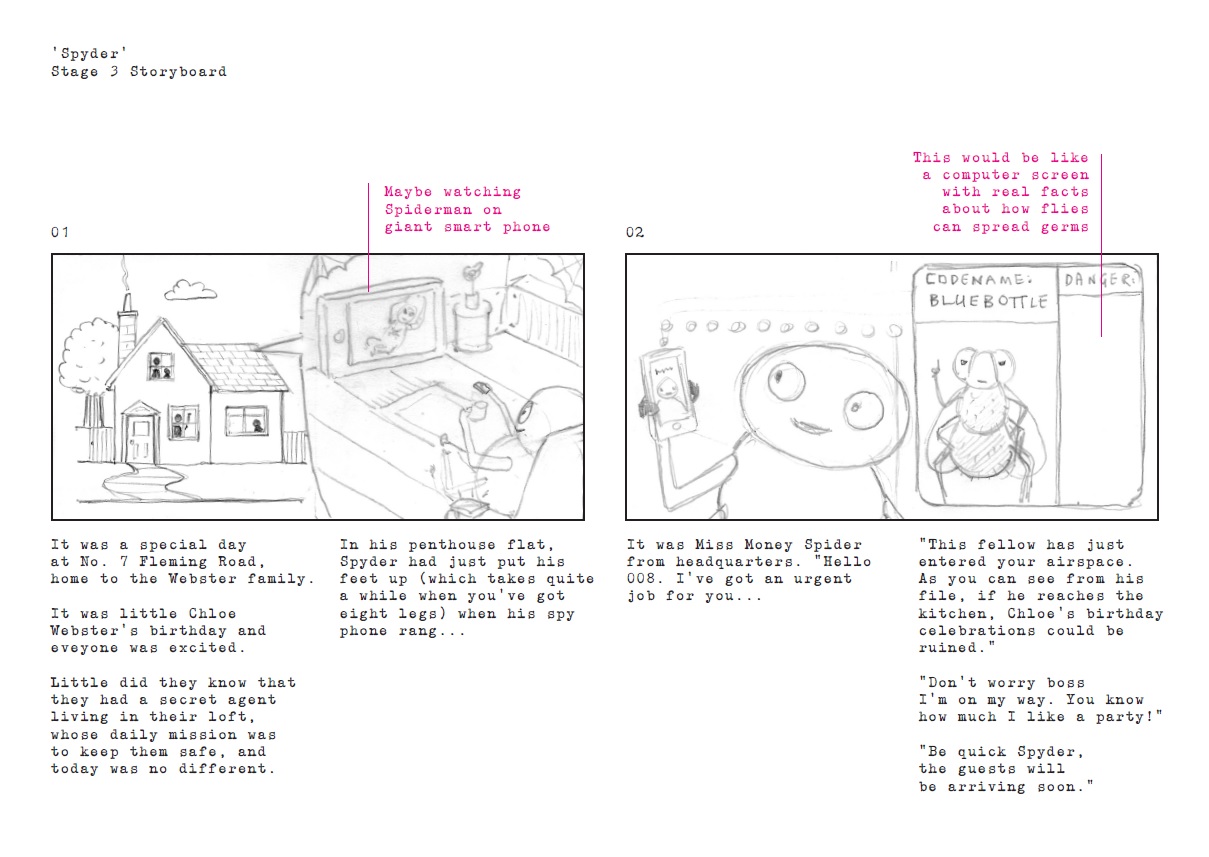 At this stage I like to do a cover visual to help bring the character to life… then I send it to my agent Stephanie and then my art director Strawberrie and editor Pauliina at Scholastic. They are all fantastic at taking the idea and improving it and making it work better… when I first started doing books (my first one I published on my own) I didn’t take on any comments or changes but now I realise that making a kids book is a real team effort and it’s great to go through different ideas / suggestions on how to speed up / slow down the story or add little things that make a big difference.
At this stage I like to do a cover visual to help bring the character to life… then I send it to my agent Stephanie and then my art director Strawberrie and editor Pauliina at Scholastic. They are all fantastic at taking the idea and improving it and making it work better… when I first started doing books (my first one I published on my own) I didn’t take on any comments or changes but now I realise that making a kids book is a real team effort and it’s great to go through different ideas / suggestions on how to speed up / slow down the story or add little things that make a big difference.
THE DUMMY
So once everyone is happy with the storyboards I’ll start doing full size spread sketches to make up the whole book. I like this stage too as its lovely seeing the book come together to make up the dummy. Then once everyone is happy with that stage then it’s the final stage, doing the illustrations. Now I’m not really an illustrator (I do lots of different styles of illustration for my day job but they are usually in a style a client requests) and it took me quite a while to come up with a style that worked for me. This style is very graphic and uses big type and simple bold colours… My publishers have been amazing at making the colours zing out even more…
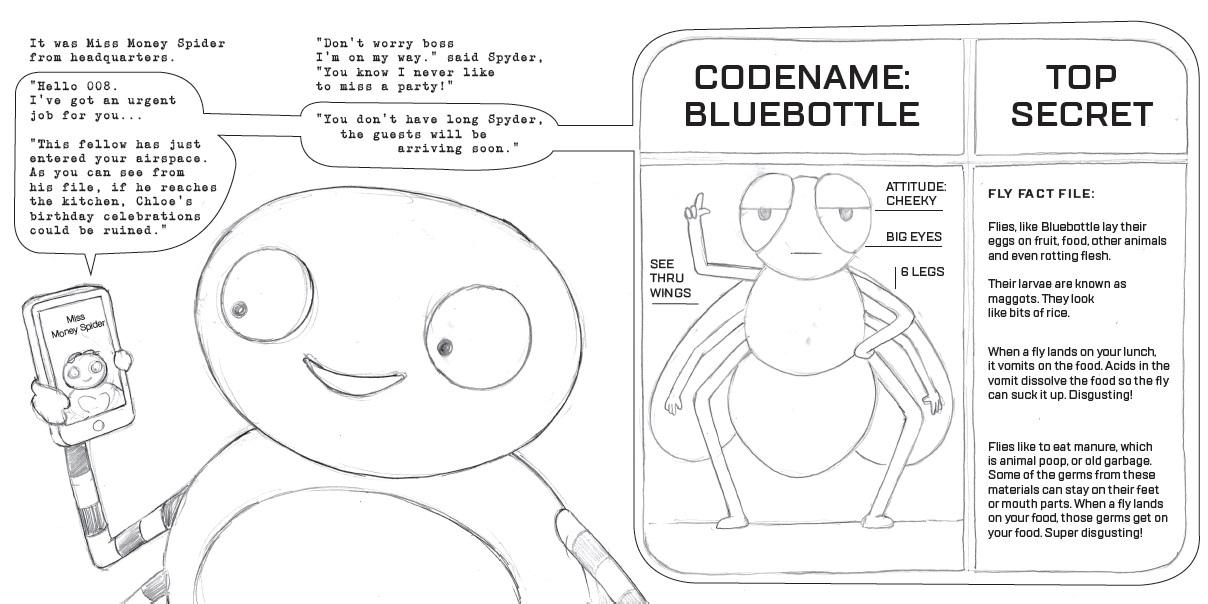
THE FINAL FRONTIER
I have no idea how I got to this method but what I do is draw everything up in sections in black pen then scan them in and then put everything together like a jigsaw puzzle. It seems to work well as I can then experiment with colours positions etc. and make up the final illustrations. Even though my illustrations look very simple they do take ages. Each stripy spider leg or hairy fly leg has to be individually made up! That’s a lot of legs! I think my next book will be about Slugs (only joking!) Once everything is done I have to go through it all really close up to iron out any glitches, this takes a while too, but it’s worth it for peace of mind. Then there is a proof version to go through with final checks and then it’s all done!!!
After years of being a jobbing graphic designer for other people it has been a real thrill to see something with your name on it sitting in a bookshop, although it’s also quite daunting as you always keep your fingers crossed that everyone will like it!
I Swapped My Brother on the Internet Blog Tour
21 January 2018
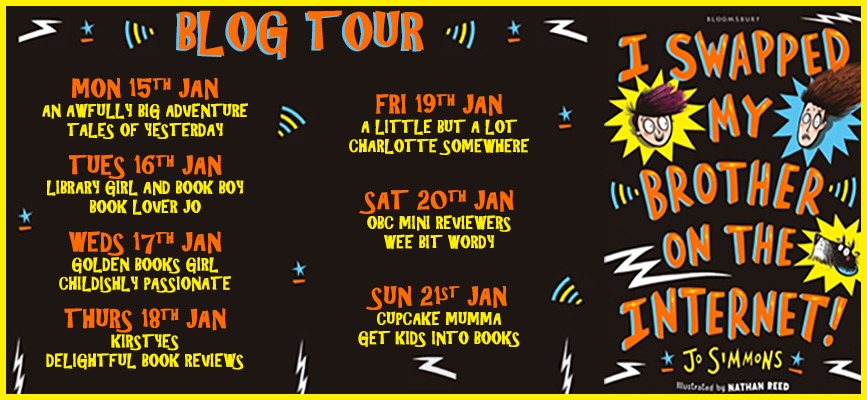
You can read my review of this laugh-out-loud madcap adventure here.
The Last Chip Blog Tour: How to Draw Percy in Seven Steps
19 January 2018
 Today it’s my stop on The Last Chip blog tour and I’m delighted to welcome its author and illustrator Duncan Beedie to my blog. Duncan has written and illustrated three picture books and his latest, The Last Chip, was published on 11 January. You can read my review here. Duncan has been a keen doodler from a very early age and has fond memories of being sprawled out on his parents’ living room floor with his trusty felt tip in hand for hours at a time. Today he’s sharing his drawing tips so you can learn to draw like him.
Today it’s my stop on The Last Chip blog tour and I’m delighted to welcome its author and illustrator Duncan Beedie to my blog. Duncan has written and illustrated three picture books and his latest, The Last Chip, was published on 11 January. You can read my review here. Duncan has been a keen doodler from a very early age and has fond memories of being sprawled out on his parents’ living room floor with his trusty felt tip in hand for hours at a time. Today he’s sharing his drawing tips so you can learn to draw like him.
Get Kids into Books: Can you tell us a bit about Percy, the star of your new book, and how to draw him?
Duncan: Percy the pigeon is the plucky, pint-sized protagonist of The Last Chip. I like to keep my characters fairly simple shapes, making them easy to draw. Here’s how…
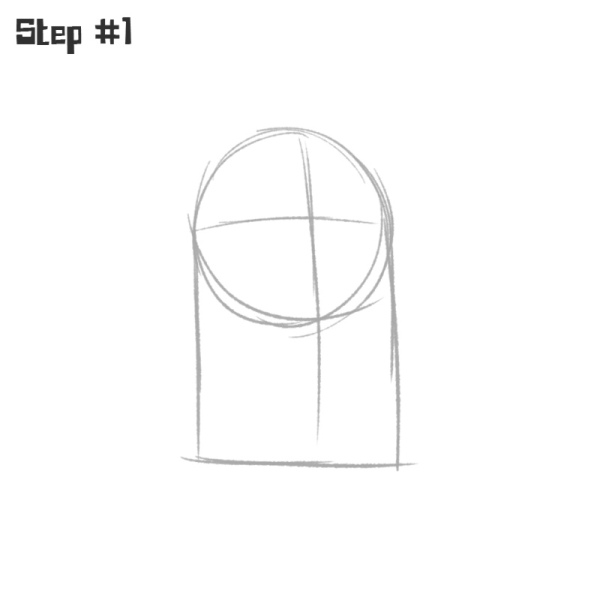
Firstly, I start with the rough shape outline. Percy has a rounded head and squared off torso, like a tic-tac with one end nibbled off.
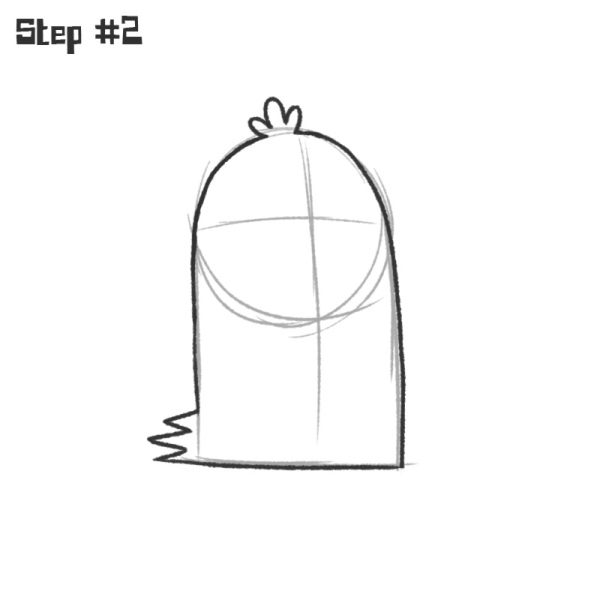
Next, I add the solid outline, adding his tuft of hair and spiky tail feathers.
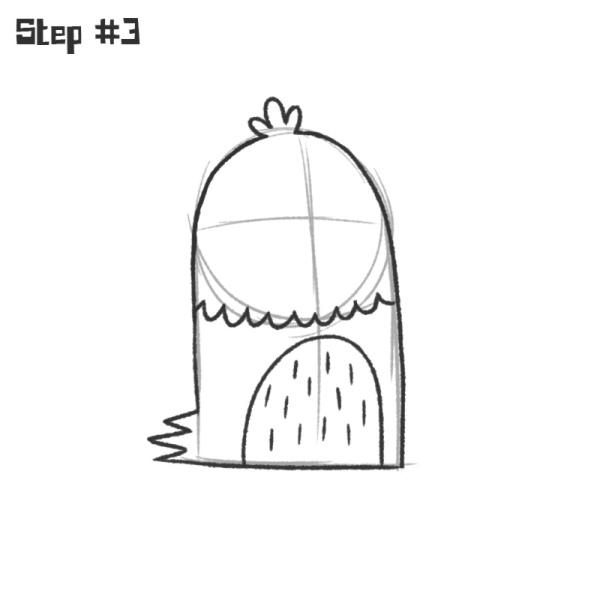
More detail in the form of his feathered neckline and furry tummy.
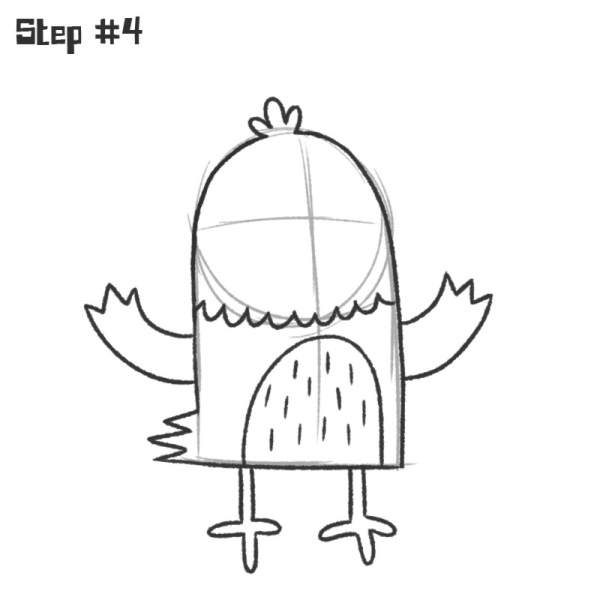
Now to add his wings and legs. I say wings but, in Percy’s case, they double up as his arms with the tapered feathers making fingers when called for. His legs, like most pigeons, are scrawny.
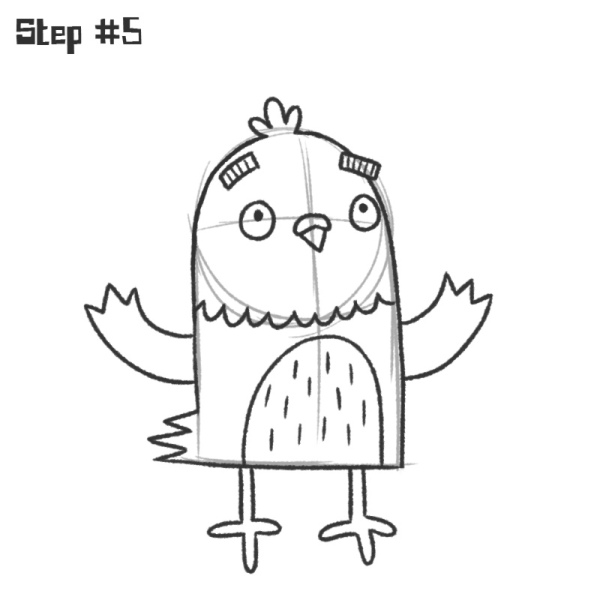
Now for the important part – his face. Due to the simple style of my characters, all of the expression comes from the face – most importantly, the eyes. Feel free to vary expression as you see fit: surprised, sad, scared, happy, etc.
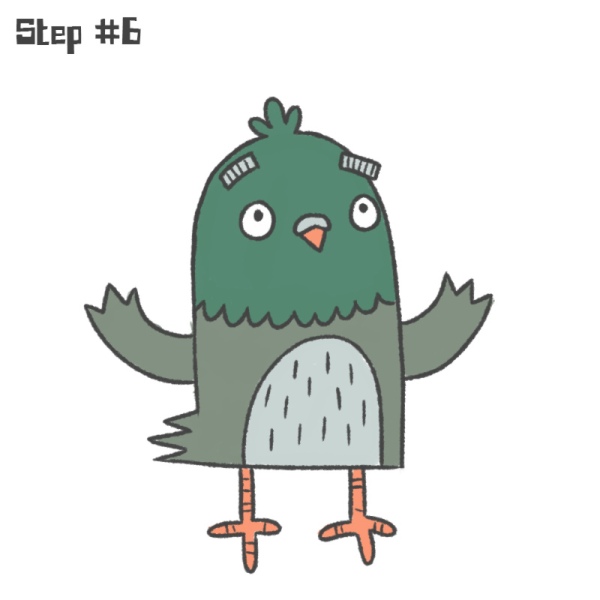
Time to colour in. I’ve stuck to his traditional pigeon colours here, but feel free to experiment.
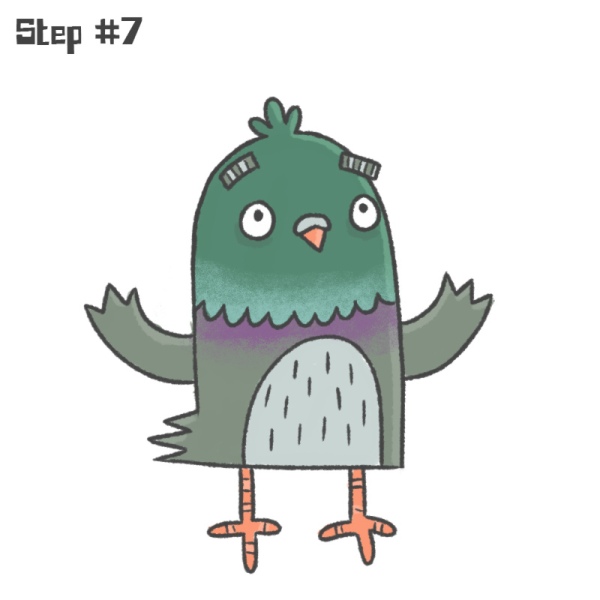
And finally, some highlights and shading, just to finish him off. That’s how to draw Percy the pigeon in seven simple steps.
Get Kids into Books: Fantastic! Thanks so much for stopping by, Duncan.
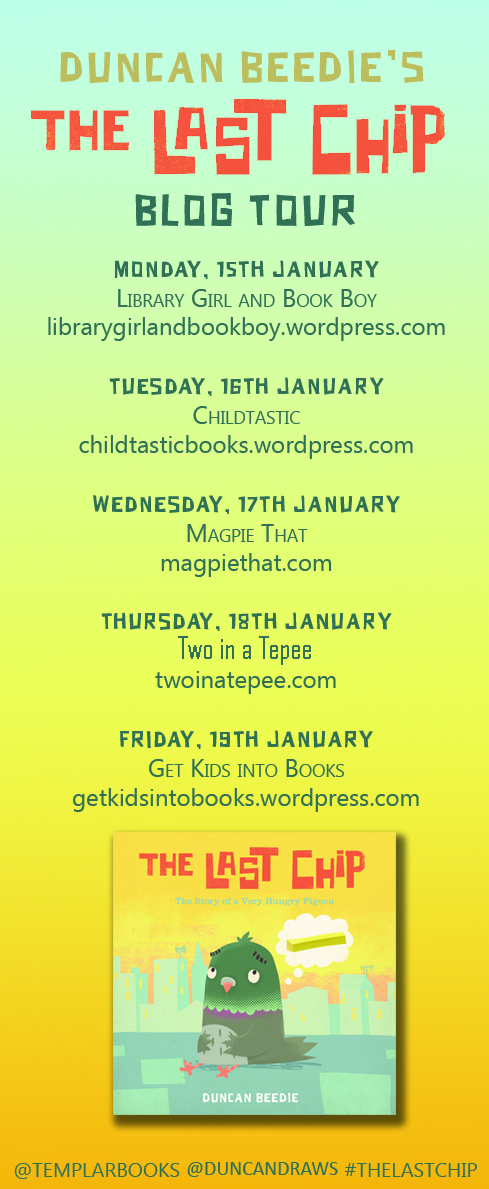
Dinosaurium Blog Tour: Ten Steps to a T-Rex
2 December 2017
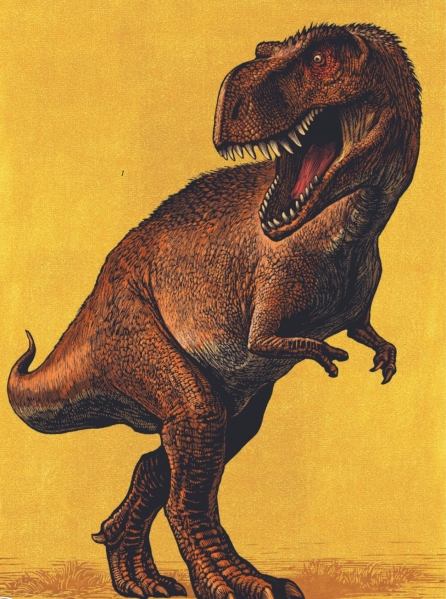 I’m delighted to welcome Chris Wormell to my blog today. He’s the talented illustrator of the magnificent Dinosaurium, a beautiful and informative book which is part of the Welcome to the Museum series published by Big Picture Press. Chris’s dinosaur illustrations are amazing and now you too can draw like him! Here are his ten steps to drawing a T-Rex.
I’m delighted to welcome Chris Wormell to my blog today. He’s the talented illustrator of the magnificent Dinosaurium, a beautiful and informative book which is part of the Welcome to the Museum series published by Big Picture Press. Chris’s dinosaur illustrations are amazing and now you too can draw like him! Here are his ten steps to drawing a T-Rex.
1. Start by drawing a some rough guide shapes and lines, not too darkly as you may want to rub some of these out. Two overlapping circles to begin with.
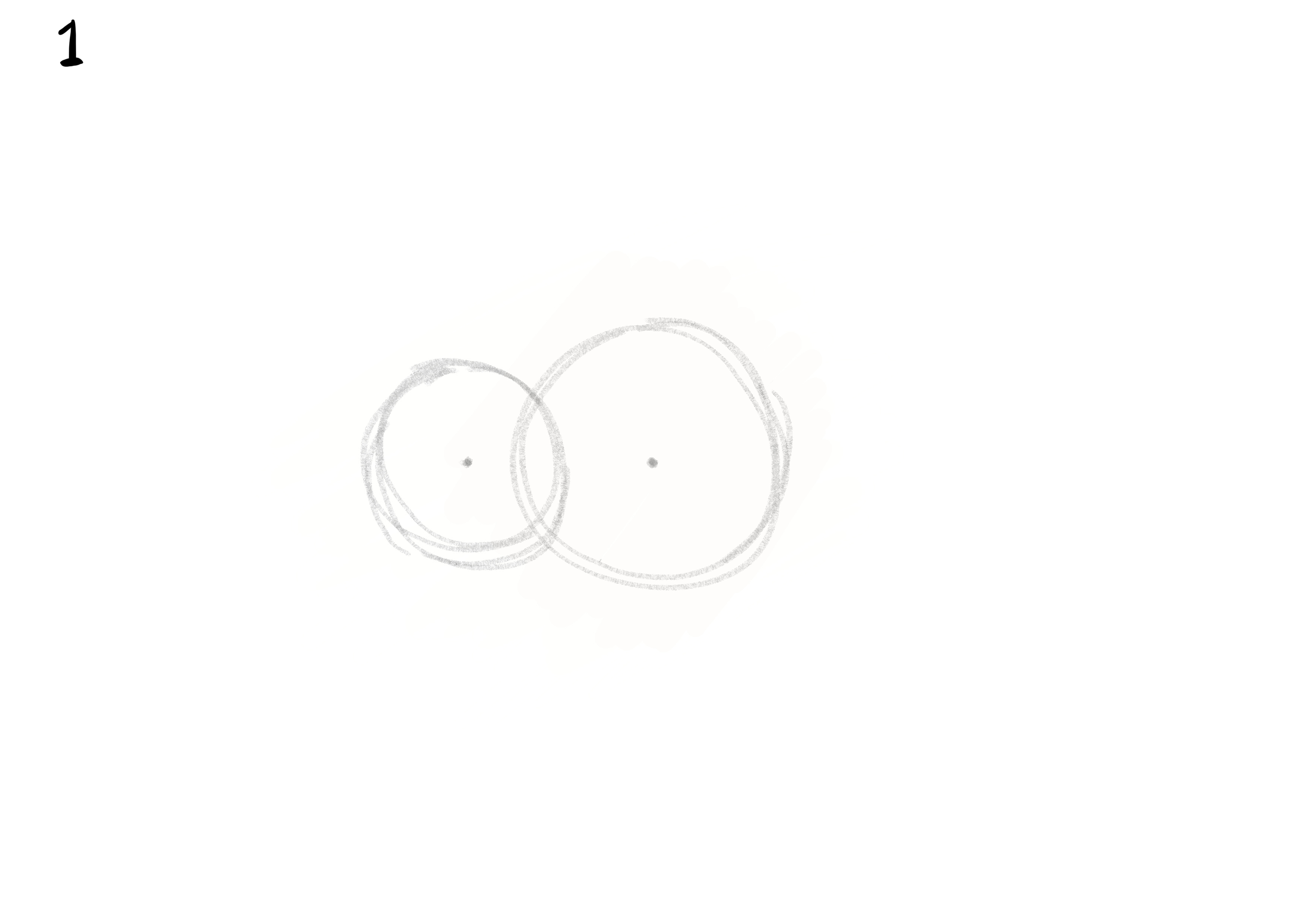
2. Add some more shapes and lines to these, like this.
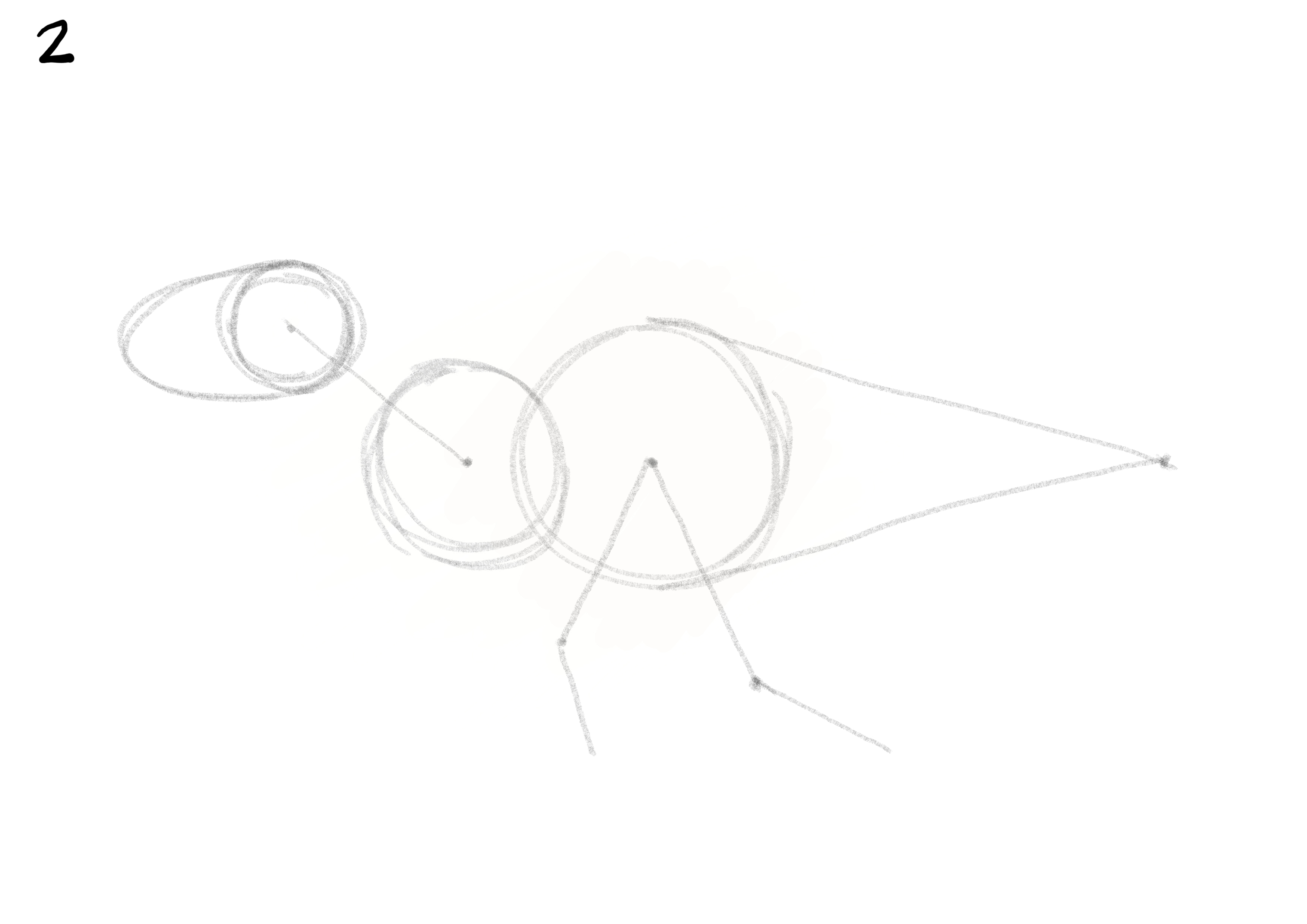
3. Put some ovals on the lines which will become the back legs, and some little lines where the arms will be.
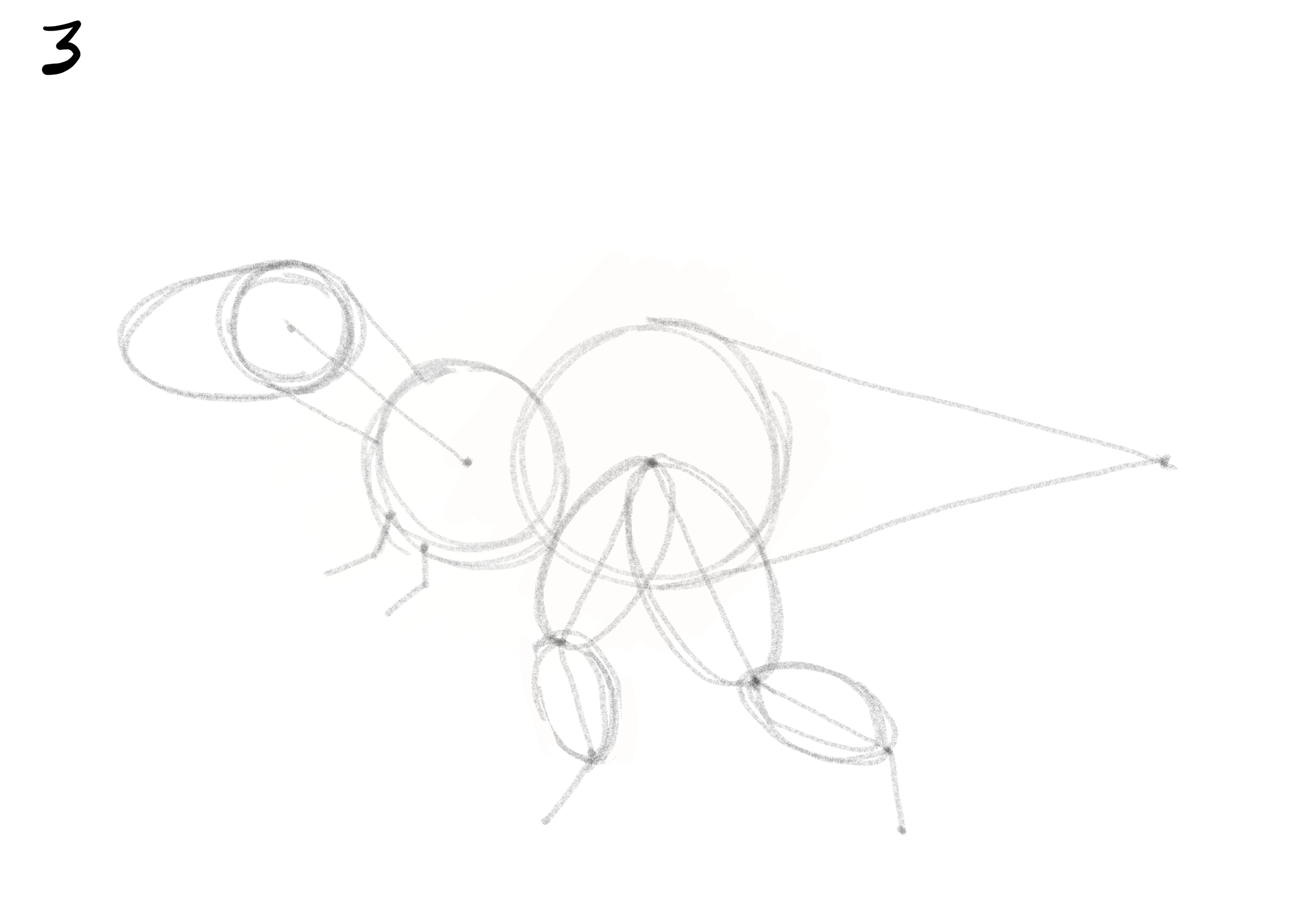
4. Now start the outline. Not always following the rough shapes and lines but using them as a guide. Don’t forget the little bump above where the eye will be and the curve down and up of the mouth.
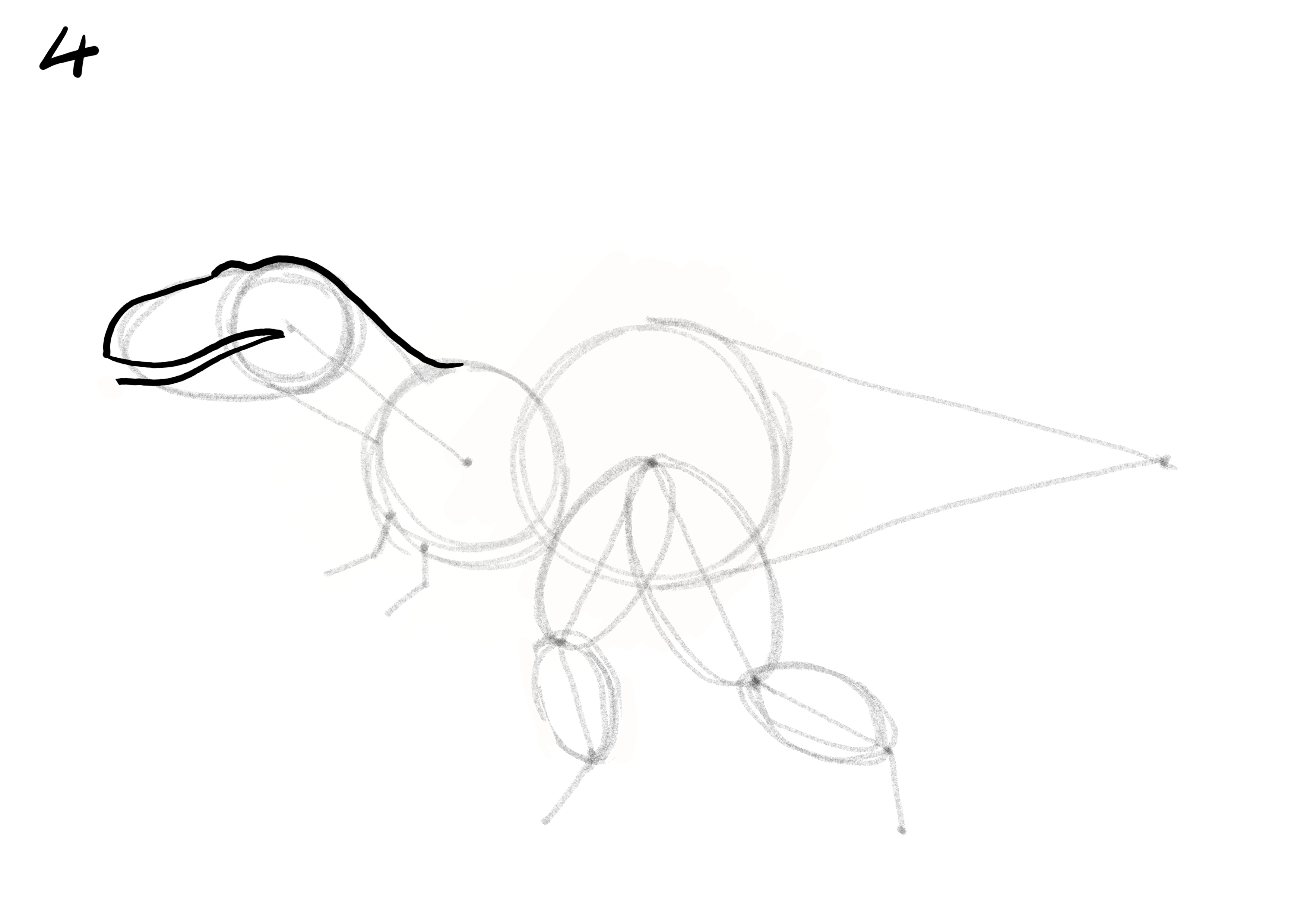
5. Carry the line along all the way around the underside of the dinosaur, making sure to leave a little gap at the second arm line and another at the second leg shape. My paper is not long enough so I’ve curled the tail up a bit.
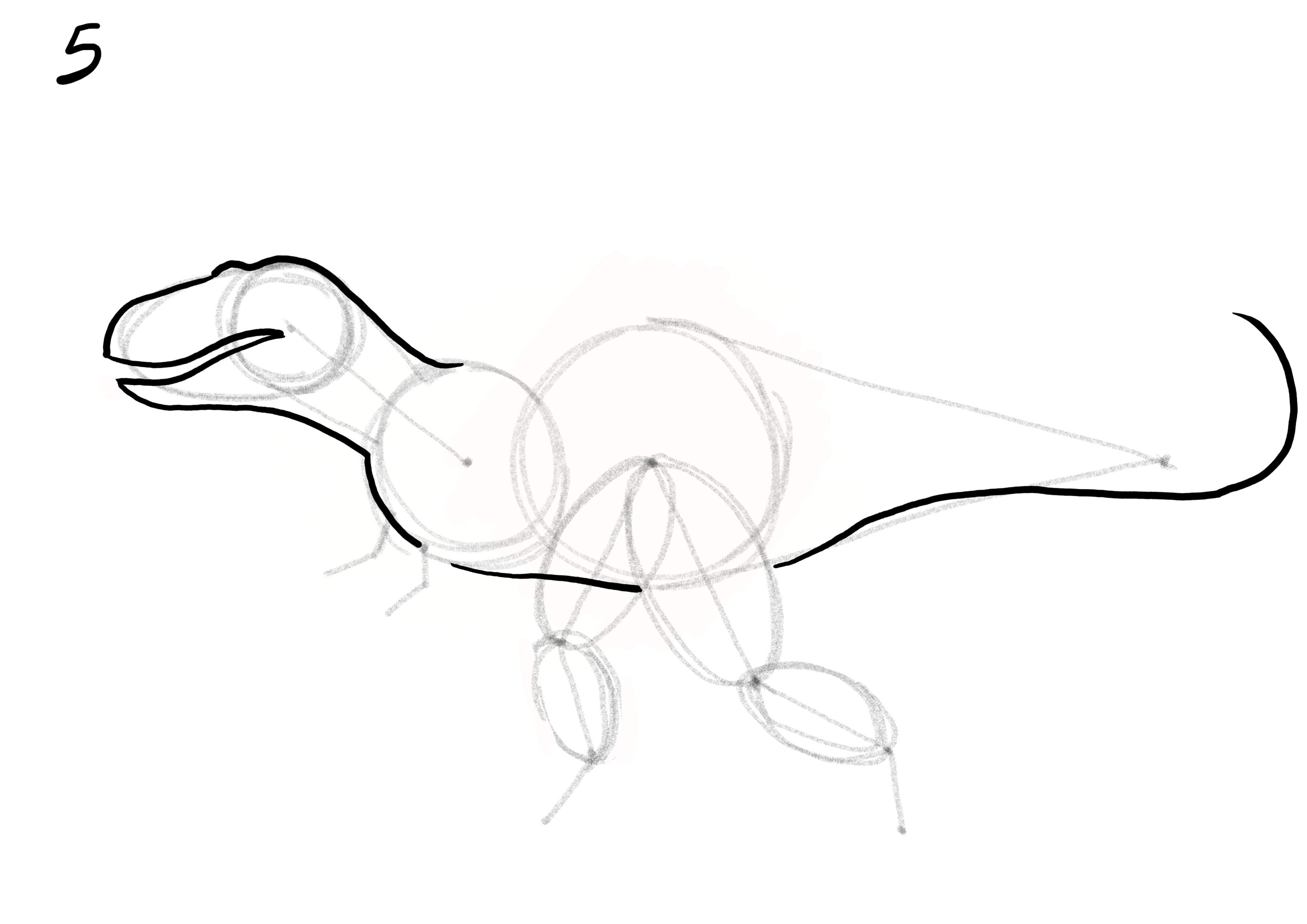
6. Now take the line all the way along the top of the dinosaur back to where you began.
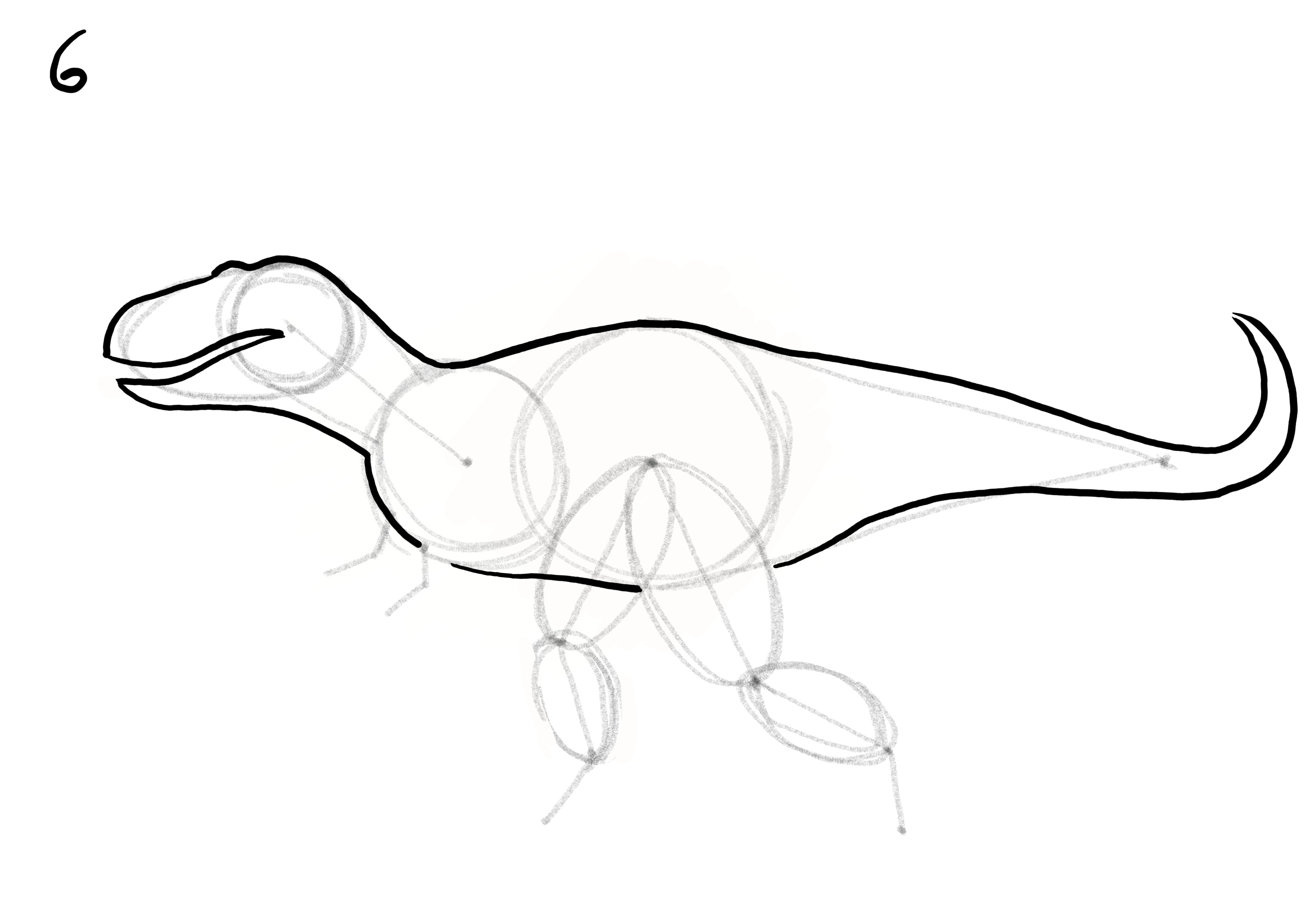
7. Next comes the first leg. Look at the way the line curves in and bulges out – this helps to give our dinosaur some muscles!
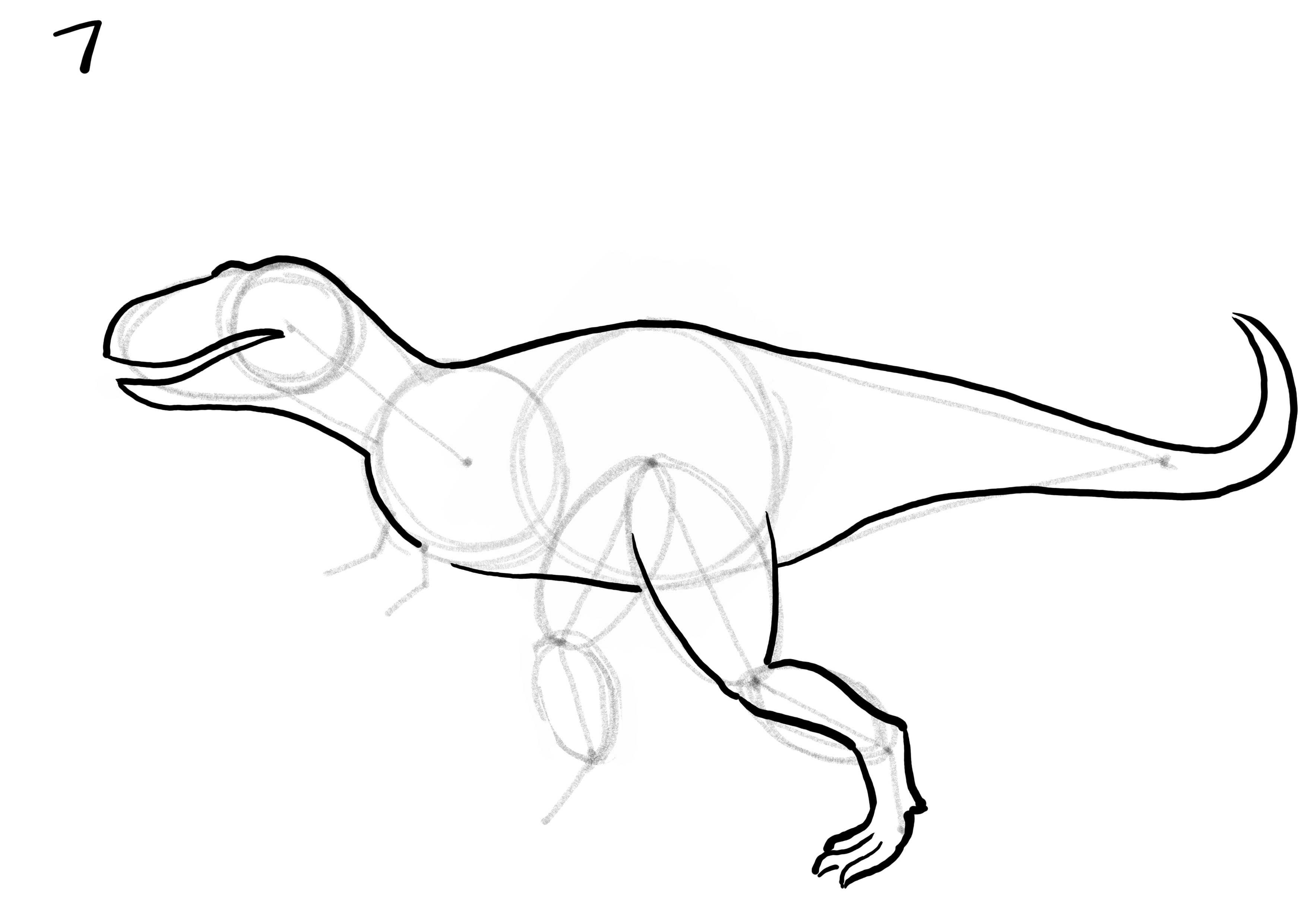
8. The second leg is much the same as the first.
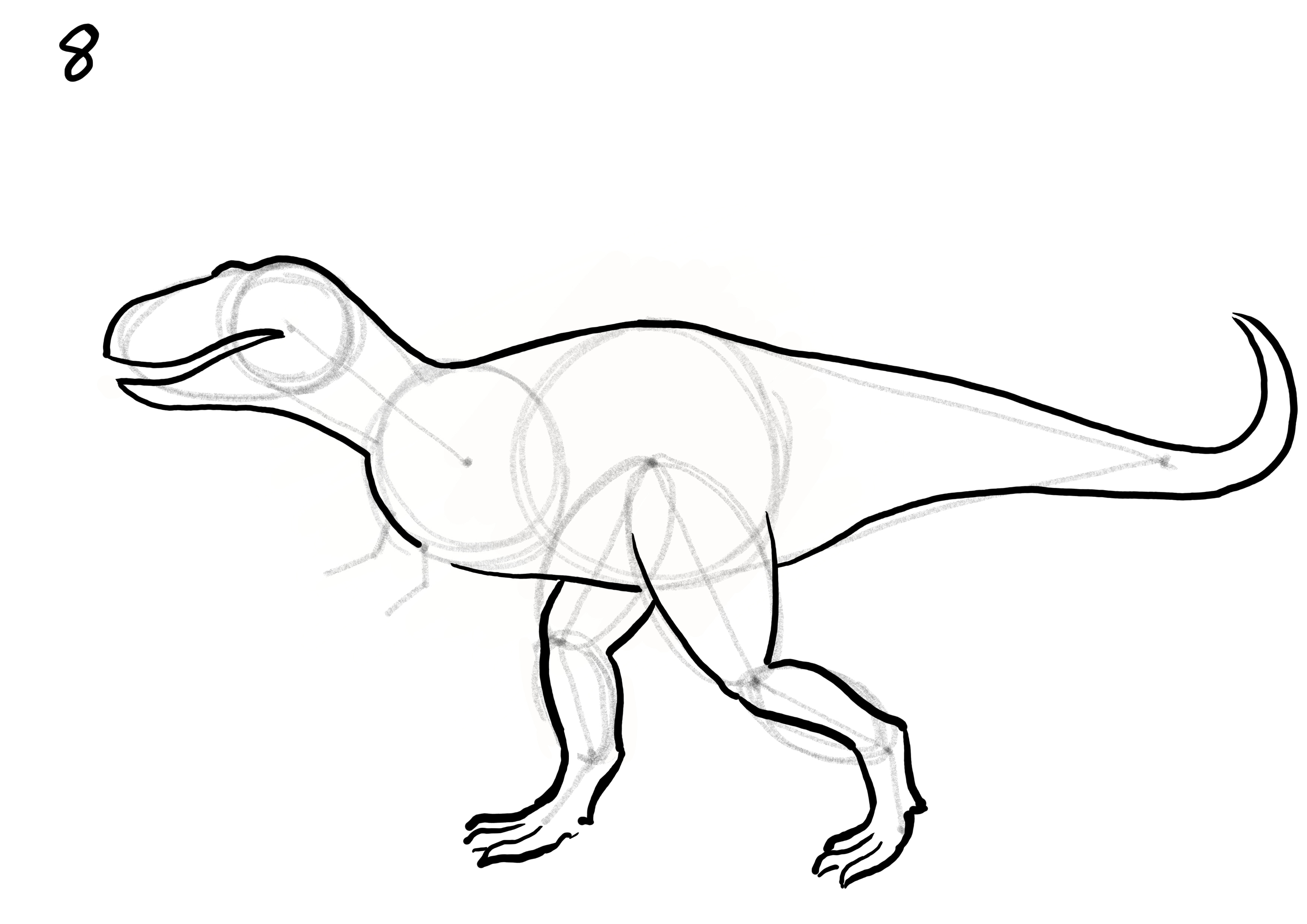
9. Next are the arms – the one on this side fits into the gap left in the outline. Only two clawed fingers, remember.
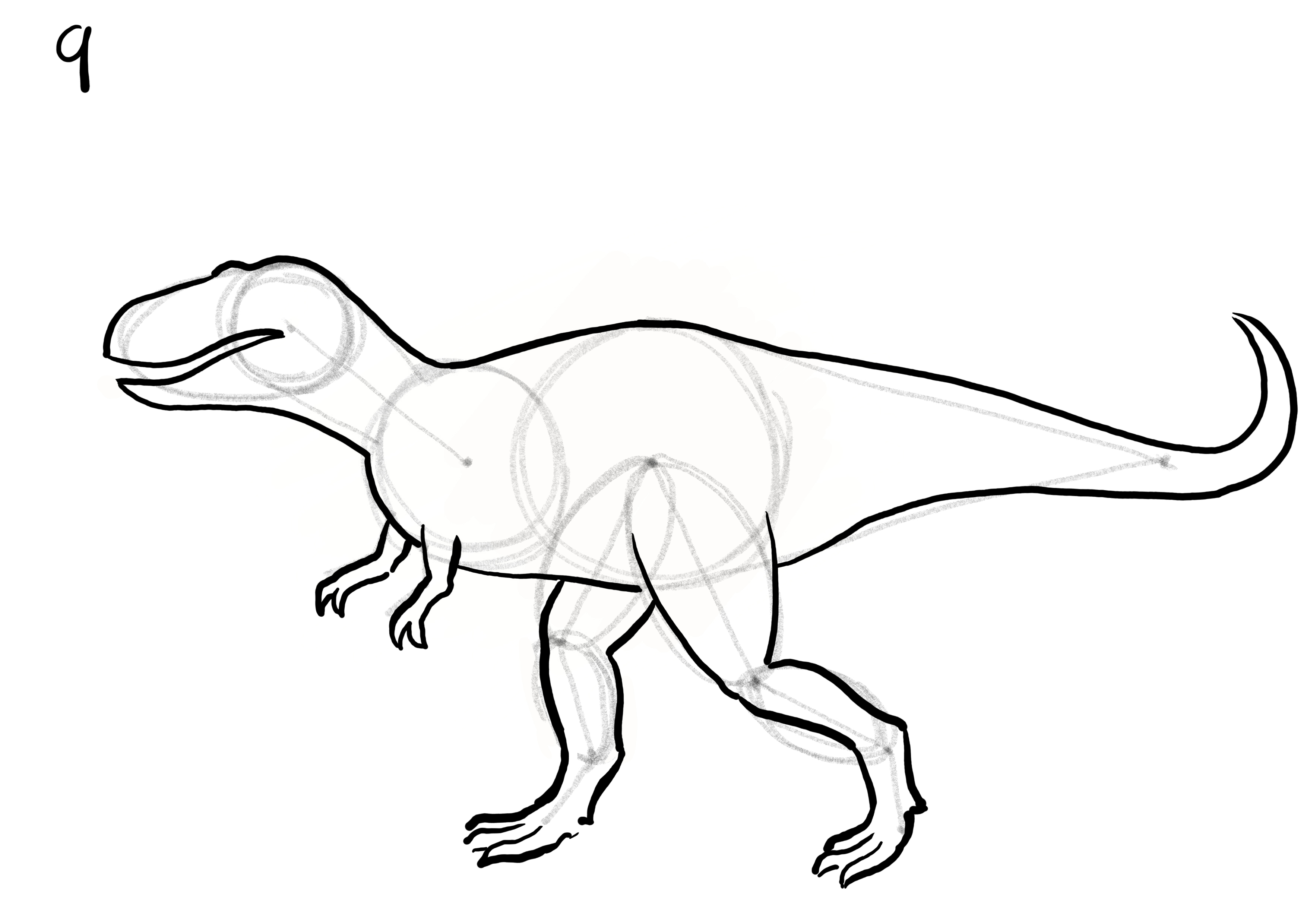
10. Finally, teeth and an eye. And we have T-Rex!
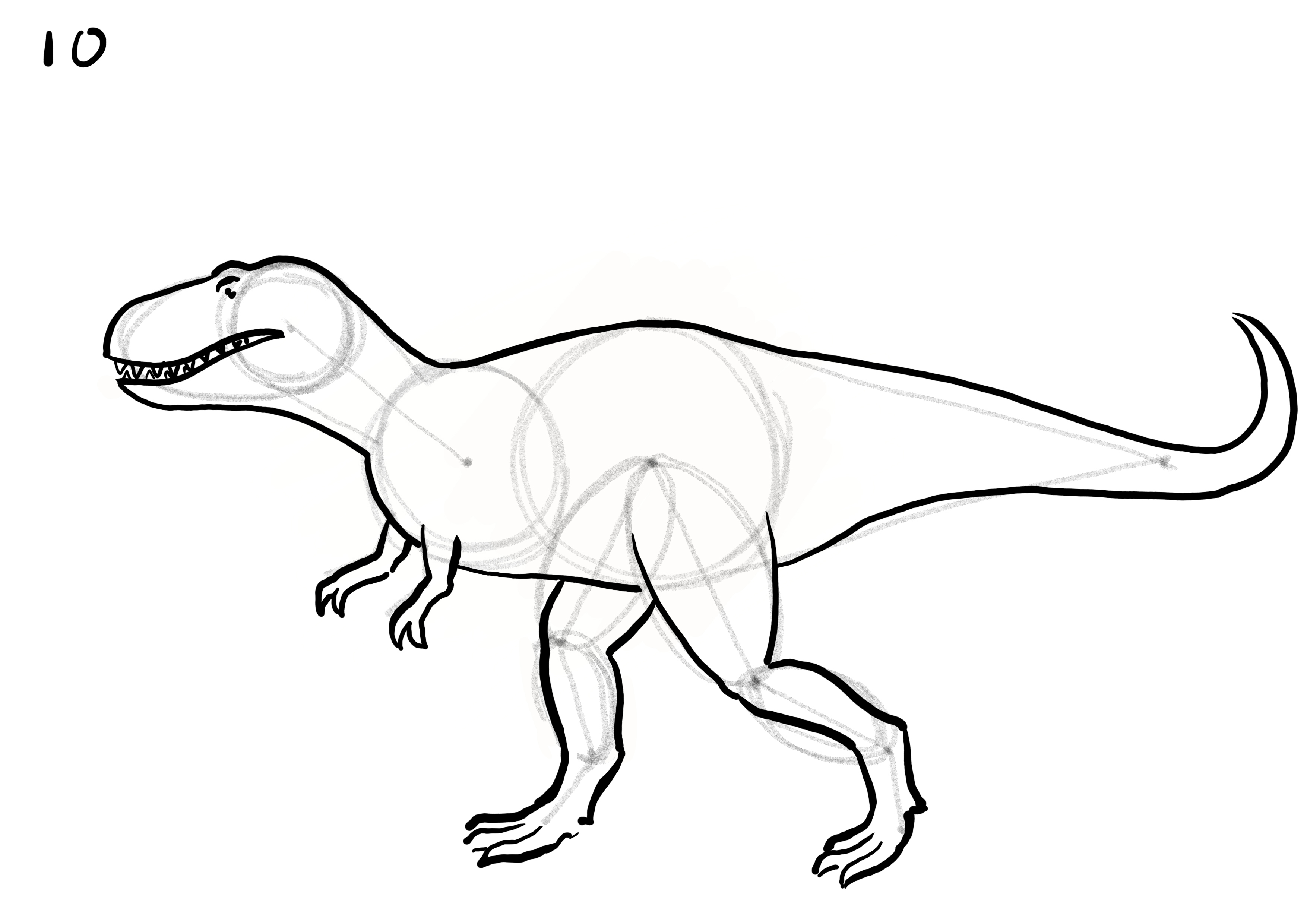
I’d love to see how your dinosaurs turn out. Why not share yours on my Twitter feed? It’s @GetKidsin2Books. There’s loads more to discover on the rest of the blog tour too. Here are details of all the other fabulous bloggers:
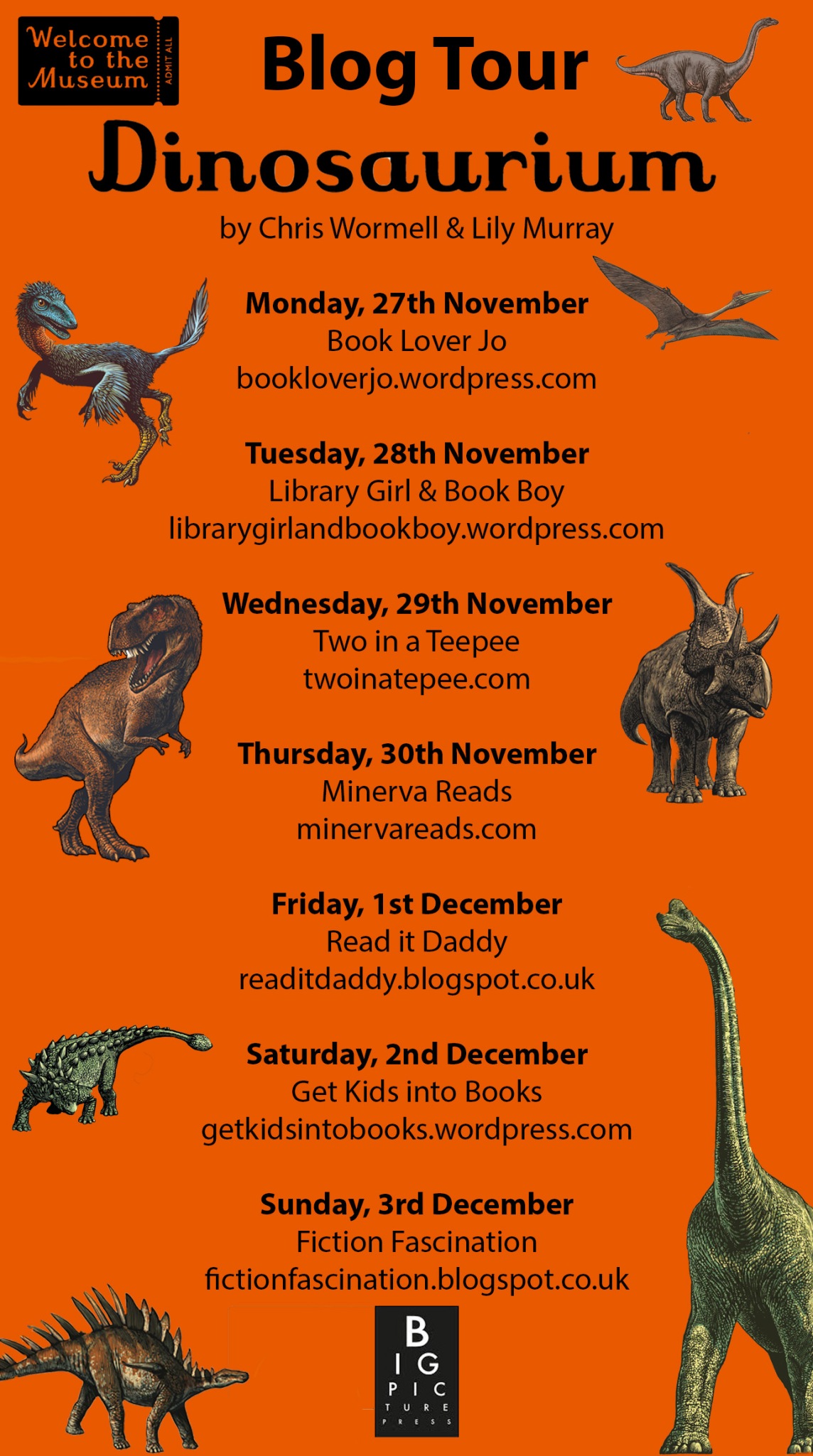
Curse of the Werewolf Boy Blog Tour
5 November 2017
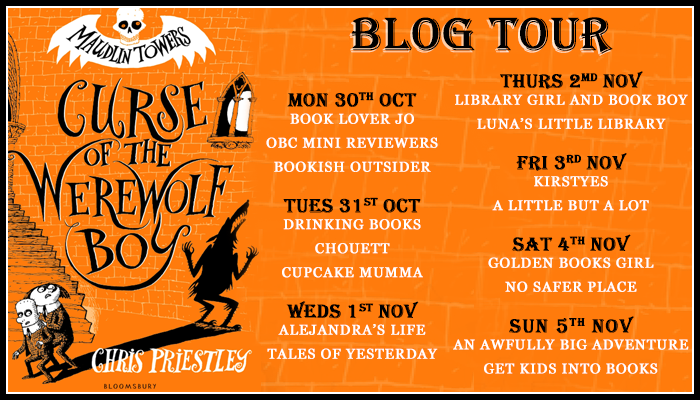
Read my review of the hilarious first book in this new series by Chris Priestley here.
When I Grow Up Blog Tour
12 October 2017
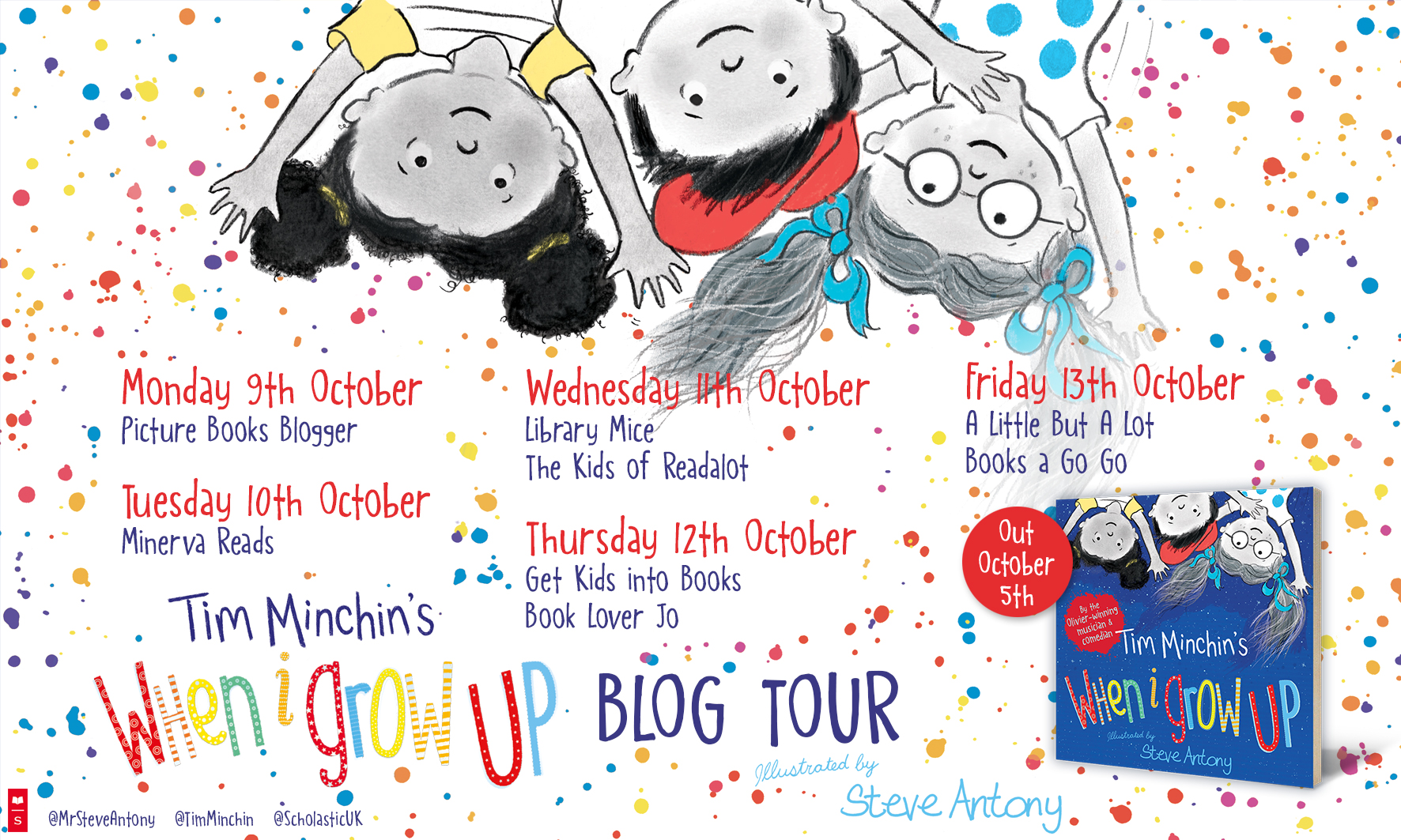
Read my review of this fabulous picture book collaboration between Tim Minchin and Steve Antony here. Anyone in the UK subscribing (for free) to my blog by 20 October 2017 will be entered into a competition to win a copy of the book.
Special Guest Post from Holly Webb
5 October 2017
Get Kids into Books: When I found out that Holly Webb was writing a sequel to one of my favourite childhood books, A Little Princess by Frances Hodgson Burnett, I was really excited. I was doubly excited to discover that her book, The Princess and the Suffragette, was being published on my birthday! Holly and I both grew up in the 80s when A Little Princess was dramatised for TV (I loved that too) and we both hold the book very dear. I’m thrilled to be able to welcome Holly to my blog today to talk about the challenge and the pressures of writing a sequel to such a treasured classic.
 Holly Webb: A Little Princess was one of my absolute favourite books as a child. I can still picture the copy I had exactly. I have to admit that one of the reasons I loved it so much was that the illustrations (by Margery Gill) gave Sara hair very like mine, and I thought it made us similar. I desperately wanted to be like Sara.
Holly Webb: A Little Princess was one of my absolute favourite books as a child. I can still picture the copy I had exactly. I have to admit that one of the reasons I loved it so much was that the illustrations (by Margery Gill) gave Sara hair very like mine, and I thought it made us similar. I desperately wanted to be like Sara.
I was a terribly shy child, and I could never think what to say when people teased me. I’m pretty sure that the time I spent rerunning scenes in my head and working out what I should have said to the mean girls in my class helped me become a writer…Sara Crewe always knew what to say, and at just the right time. It was blissful, seeing her skewer the obnoxious Lavinia.
A Little Princess is such a rich book. It has the most sumptuous descriptions of clothes, and dolls (I longed for my own Emily). Then it’s so easy to picture the awful contrast of Sara’s servant days. But real strength of the book is the sense of friendship between the girls. I wanted to be at Sara’s party with Ermengarde and Becky in the attic – and it horrified me every time when Miss Minchin came rushing up the stairs to catch them.
I really wanted to capture that same sense of girls growing up together, and starting to understand the world together in my sequel. This isn’t the first sequel I’ve written – Return to the Secret Garden came out two years ago – and in fact the idea of a sequel first came up five years before that. I was talking to my editor about our favourite books, and we both loved Frances Hodgson Burnett’s The Secret Garden. She suggested that I should write a sequel, and I was horrified! How could I possibly? But the idea stayed in the back of my mind. Return to the Secret Garden was set thirty years after the original book, with a completely new main character. I wasn’t quite brave enough to carry on the story of Mary, Colin and Dickon, and I wanted to write about the effect of the garden on a different child.
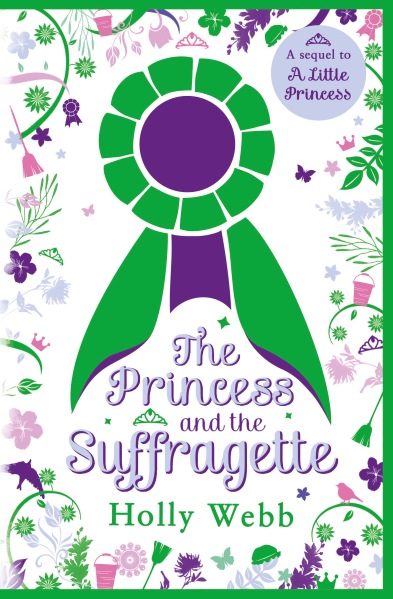 The Princess and the Suffragette is far more of a direct sequel, which meant that it was even more daunting to write. It’s set only a few years after A Little Princess, and the main character is Lottie, the spoiled baby from the original book. Sara is still living next door to the school, and is one of Lottie’s closest friends. One of the hardest parts of writing The Princess and the Suffragette was trying to work out how Sara would feel about the fight for the vote – but I loved it. Even the complicated bits (trying to work out how old everybody was at the end of the book took me days, and in the end I decided that FHB had contradicted herself!) The chance to go back to characters I adored, and to think about the wider world around them, was incredible.
The Princess and the Suffragette is far more of a direct sequel, which meant that it was even more daunting to write. It’s set only a few years after A Little Princess, and the main character is Lottie, the spoiled baby from the original book. Sara is still living next door to the school, and is one of Lottie’s closest friends. One of the hardest parts of writing The Princess and the Suffragette was trying to work out how Sara would feel about the fight for the vote – but I loved it. Even the complicated bits (trying to work out how old everybody was at the end of the book took me days, and in the end I decided that FHB had contradicted herself!) The chance to go back to characters I adored, and to think about the wider world around them, was incredible.
Get Kids into Books: Thanks for giving us this insight into what it means to tackle a sequel, Holly. It’s wonderful to be able to be part of Sara’s world once more.
My review of The Princess and the Suffragette will be up on my blog soon.
The Lollies 2017 Blog Tour,
🤣 17 September 2017 🤣
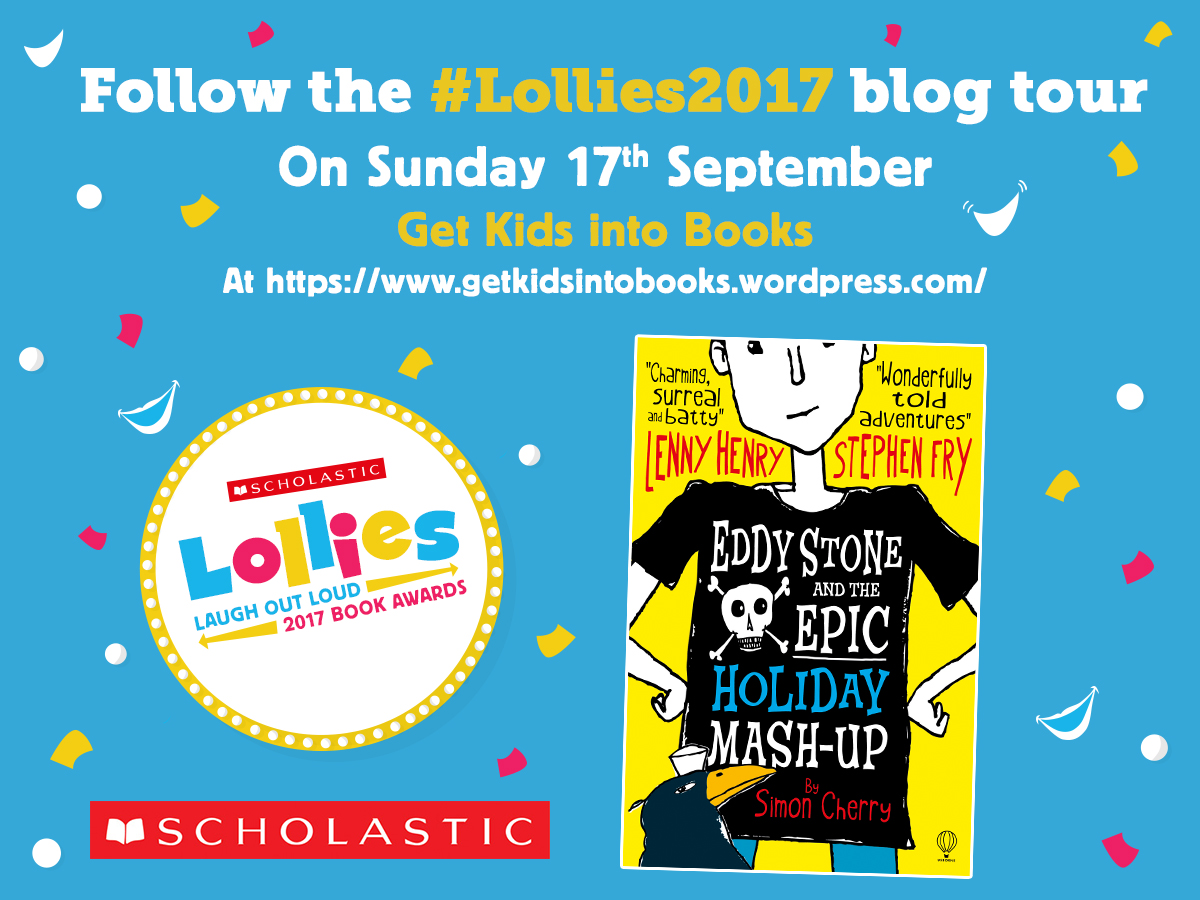
 I’m thrilled to be able to welcome Simon Cherry, author of Eddy Stone and the Epic Holiday Mash-Up to my blog today. Simon is an experienced television producer, writer and director who worked in Melvyn Bragg’s Arts Department at ITV for almost twenty years. Simon lives in Surrey with his wife, two teenage sons and a ginger cat, and hopes that one day his shed might also turn into a sailing ship. Eddy Stone and the Epic Holiday Mash-Up was Simon’s first book for children. You can read my review here. If you like the sound of that, Simon’s also written a follow-up: Eddy Stone and the Alien Cat Mash-Up.
I’m thrilled to be able to welcome Simon Cherry, author of Eddy Stone and the Epic Holiday Mash-Up to my blog today. Simon is an experienced television producer, writer and director who worked in Melvyn Bragg’s Arts Department at ITV for almost twenty years. Simon lives in Surrey with his wife, two teenage sons and a ginger cat, and hopes that one day his shed might also turn into a sailing ship. Eddy Stone and the Epic Holiday Mash-Up was Simon’s first book for children. You can read my review here. If you like the sound of that, Simon’s also written a follow-up: Eddy Stone and the Alien Cat Mash-Up.
Get Kids into Books: What inspired you to write?
Simon Cherry: Having children. We’ve two of them, non-identical twin boys. Since they were little, there were always books for them to read or have read to them. I got to know The Gruffalo by heart, riffed comedy around the pictures in Richard Scarry’s timeless books, and worked through Mr Gum and Roald Dahl and Tintin and my own childhood favourite Just William.
Always books. Until one day they came home from the local library, and mournfully announced that they had read everything there was to read. They hadn’t, of course. Not quite. Fairy princesses and magic ponies had never featured, for a start. But when we went back and looked along the shelves there was nothing new that hit the spot for a couple of eight year olds. They wanted stories – long ones, not short. Adventure. Thrills. We moved up an age group and tried Alex Ryder and young Bond. But at eight they weren’t ready for the death and the gore.
It struck me that there was a gap for books that were properly funny and properly exciting but not violent. Pirates were good, I thought. Kids love pirates. And you could have a lot of fun playing about with the stuff of pirate stories. I began to scribble down ideas, sketch out scenes.
Two weeks later I wrote myself a note. “You have no plot,” it said. “No characters. No jokes.” So then I started work in earnest. Twisted a plot into shape. Developed the characters and how they reacted to each other. I had a childhood memory of the lighthouse that blinked into the night when we were on holiday in Cornwall. The Eddystone Light – break that in half and there was my hero’s name.
Then there were the jokes – or the spaces in the first draft where I scribbled ‘put something funny here’. Odd things, jokes. You never quite know where they come from. Sometimes they spring into your head so fully formed that you are laughing as you write them down. At other times it’s hard labour to turn expectations upside down, or escalate situations to absurdity, or nail the killer word.
And you still don’t know if they are funny. I was reasonably confident about using some daft things that I had done with the kids, like playing How Many Monkeys Have I Got In My Pocket?, in which – as you may already have worked out – you have to try to guess how many monkeys the other players have in their pockets. But there’s always doubt when you send a joke out into the world. What if it falls flat? How embarrassing. “What kind of weird person,” you can imagine the reader thinking, “could ever have though that would get a laugh?”
So I’m delighted that the judges have chosen Eddy for the shortlist for the Lollies Award. And I hope that anyone who picks the book up will find it as funny as they did.
Get Kids into Books: Thanks for joining me on my blog today Simon and good luck with the Lollies. Eddy Stone and the Epic Holiday Mash-Up certainly had me laughing out loud and I’ll be rooting for you.
Check out the other shortlisted books on the tour:
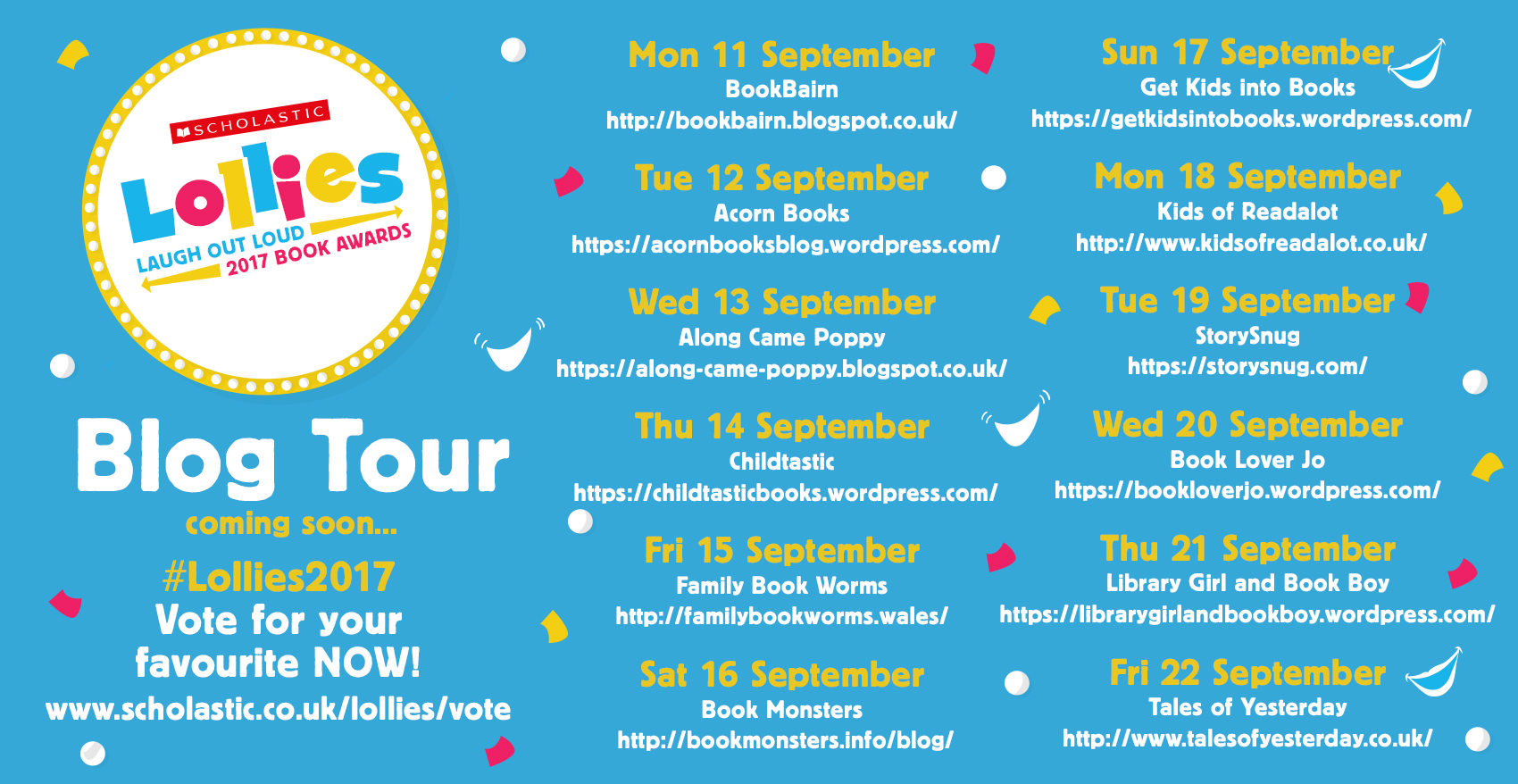
The Laugh Out Loud Awards (the Lollies) are a set of awards, now in their second year, created by Scholastic (the world’s largest publisher and distributor of children’s books) to celebrate the funniest children’s books.
The Lollies are awarded in three categories: Best Laugh Out Loud Picture Book, Best Laugh Out Loud Book for 6-8s and Best Laugh Out Loud Book for 9-13s. The shortlisted books in each category are as follows:
Best Laugh Out Loud Picture Book
Oi Dog by Kes Gray and Jim Field (Hodder Children’s Books)
Eat Your People by Lou Kuenzler and David Wojtowycz (Orchard Books)
Prince of Pants by Alan Macdonald and Sarah McIntyre (Scholastic)
Danny McGee Drinks the Sea by Andy Stanton and Neal Layton (Hodder Children’s Books)
Best Laugh Out Loud Book for 6-8 year olds
Thimble Monkey Superstar by Jon Blake and Martin Chatterton (Firefly Press)
Hamish and the Neverpeople by Danny Wallace and Jamie Littler (Simon and Schuster)
Eddy Stone and the Epic Holiday Mash-Up by Simon Cherry (Usborne)
Future Ratboy and the Invasion of the Nom Noms by Jim Smith (Egmont)
Best Laugh Out Loud Book for 9-13 year olds
I Don’t Like Poetry by Joshua Seigal (Bloomsbury)
The Best Medicine by Christine Hamil (Little Island Books)
My Gym Teacher is an Alien Overlord by David Solomons and Laura Ellen Anderson (Nosy Crow)
AniMalcolm by David Baddiel and Jim Field (Harper Collins)
The winning book in each category will be decided solely by children’s votes, with schools and parents encouraged to help kids get involved and vote via the Lollies website or via the Scholastic channel on the PopJam app. Voting is open until 8 December 2017 and the winning books will be announced at an awards ceremony in London in January 2018.
Prisoner of Ice and Snow Blog Tour,
❄️ 16 September 2017 ❄️
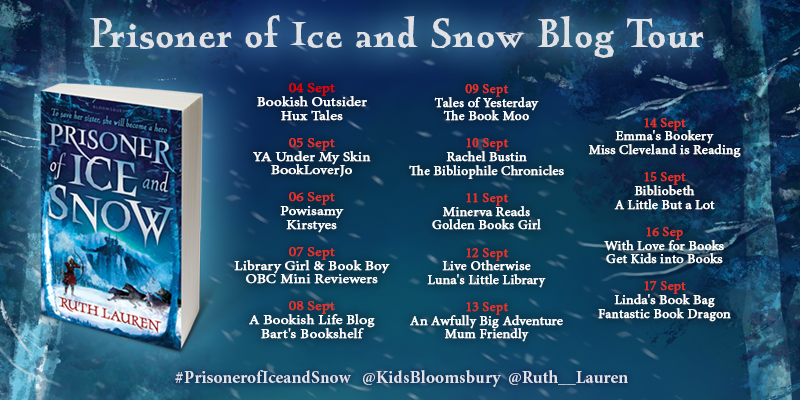
 I’m delighted to be able to welcome Ruth Lauren, author of the fabulous Prisoner of Ice and Snow, to my blog today. Prisoner of Ice and Snow is the first book in an exciting new MG series. I asked Ruth about her favourite MG books and authors.
I’m delighted to be able to welcome Ruth Lauren, author of the fabulous Prisoner of Ice and Snow, to my blog today. Prisoner of Ice and Snow is the first book in an exciting new MG series. I asked Ruth about her favourite MG books and authors.
Ruth Lauren: Hi, and thanks for having me along to tell you about five of my recent favourite MG books and authors!
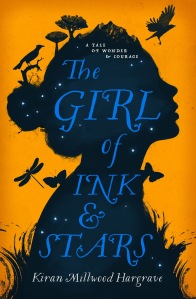
The Girl of Ink and Stars by Kiran Millwood Hargrave
Maps, stars, a gorgeous and vividly described fantasy island setting and an intrepid girl determined to save her best friend and maybe her home. Lush, lyrical writing and a Moana-esque vibe. Not in the least surprised it won the Waterstone’s Children’s Book Prize 2017.
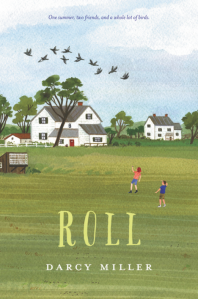
Roll by Darcy Miller
When Lauren (but call him “Ren,” pretty please) Hall sees birds falling from the sky, he knows something is wrong. But just as he’s starting to worry, he realizes that the birds are plummeting toward the ground on purpose.
Turns out they’re Birmingham Roller Pigeons, and his new neighbor Sutton is training them for a competition.
Sure, it’s strange, but Ren’s best and only friend Aiden has picked this summer to start hanging with the popular kids. So Ren starts training pigeons with Sutton—what’s the worst that could happen? A bird falls on his head?
This book is charming and compelling and Ren’s voice is a complete delight!
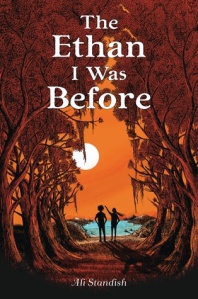 The Ethan I was Before by Ali Standish
The Ethan I was Before by Ali Standish
Beautifully written, heartfelt and moving, this is classic middle grade at its best.
Ethan had been many things. He was always ready for adventure and always willing to accept a dare, especially from his best friend, Kacey. But that was before. Before the accident that took Kacey from him. Before his family moved from Boston to the small town of Palm Knot, Georgia.
Palm Knot may be tiny, but it’s the home of possibility and second chances. It’s also home to Coralee, a girl with a big personality and even bigger stories. Coralee may be just the friend Ethan needs, except Ethan isn’t the only one with secrets. Coralee’s are catching up with her, and what she’s hiding might be putting both their lives at risk.
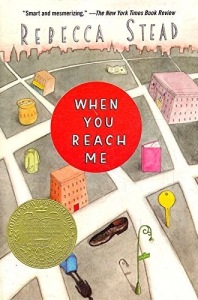
Rebecca Stead: everything she writes, but particularly When You Reach Me
This is one of the best children’s books I’ve ever read. Part mystery, part sci-fi, part realistic. Entirely clever and nuanced. Good for your head and your heart.
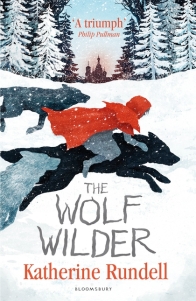 Katherine Rundell: I’ve picked out The Wolf Wilder for this post because it’s tough and whimsical at the same time and I adore a cold, snowy setting and a brave girl on an adventure.
Katherine Rundell: I’ve picked out The Wolf Wilder for this post because it’s tough and whimsical at the same time and I adore a cold, snowy setting and a brave girl on an adventure.
Feodora and her mother live in the snowbound woods of Russia, in a house full of food and fireplaces. Ten minutes away, in a ruined chapel, lives a pack of wolves. Feodora’s mother is a wolf wilder, and Feo is a wolf wilder in training. A wolf wilder is the opposite of an animal tamer: it is a person who teaches tamed animals to fend for themselves, and to fight and to run, and to be wary of humans.
When the murderous hostility of the Russian Army threatens her very existence, Feo is left with no option but to go on the run. What follows is a story of revolution and adventure, about standing up for the things you love and fighting back. And, of course, wolves.
I can’t wait to get my hands on The Explorer! (Katherine’s latest novel.)
Get Kids into Books: Thanks so much for stopping by, Ruth, and sharing these books with us. There are a couple of our favourites there and we can’t wait to check out your other recommendations too.
Perfectly Norman Blog Tour,
9 August 2017
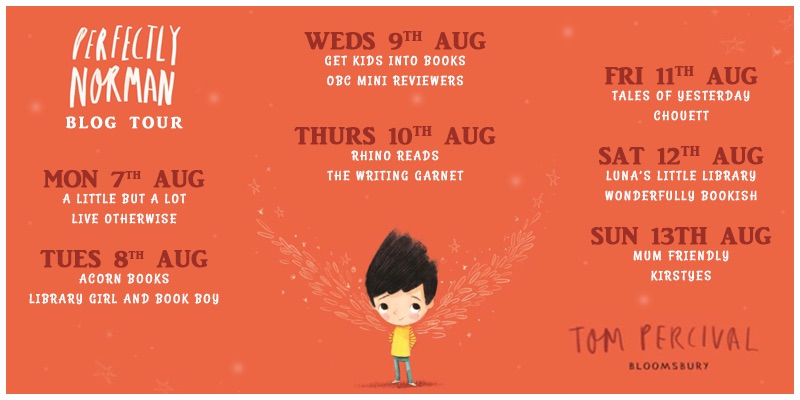
Read my review of this positive and uplifting story here.
The Adventures of the Owl and the Pussycat Blog Tour,
6 May 2017
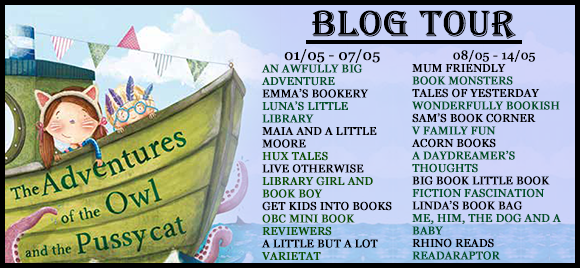
The Owl and the Pussycat went to sea, in a box on the living room floor. They sailed away for a year and a day and these are the things that they saw… Join two curious children on a quirky adventure, loosely based on the classic Edward Lear poem, The Owl and the Pussycat.
The Adventures of the Owl and the Pussycat is a picture book collaboration between mother and daughter. You can read my review here.
🐰 Bunny Books for Easter 🐰
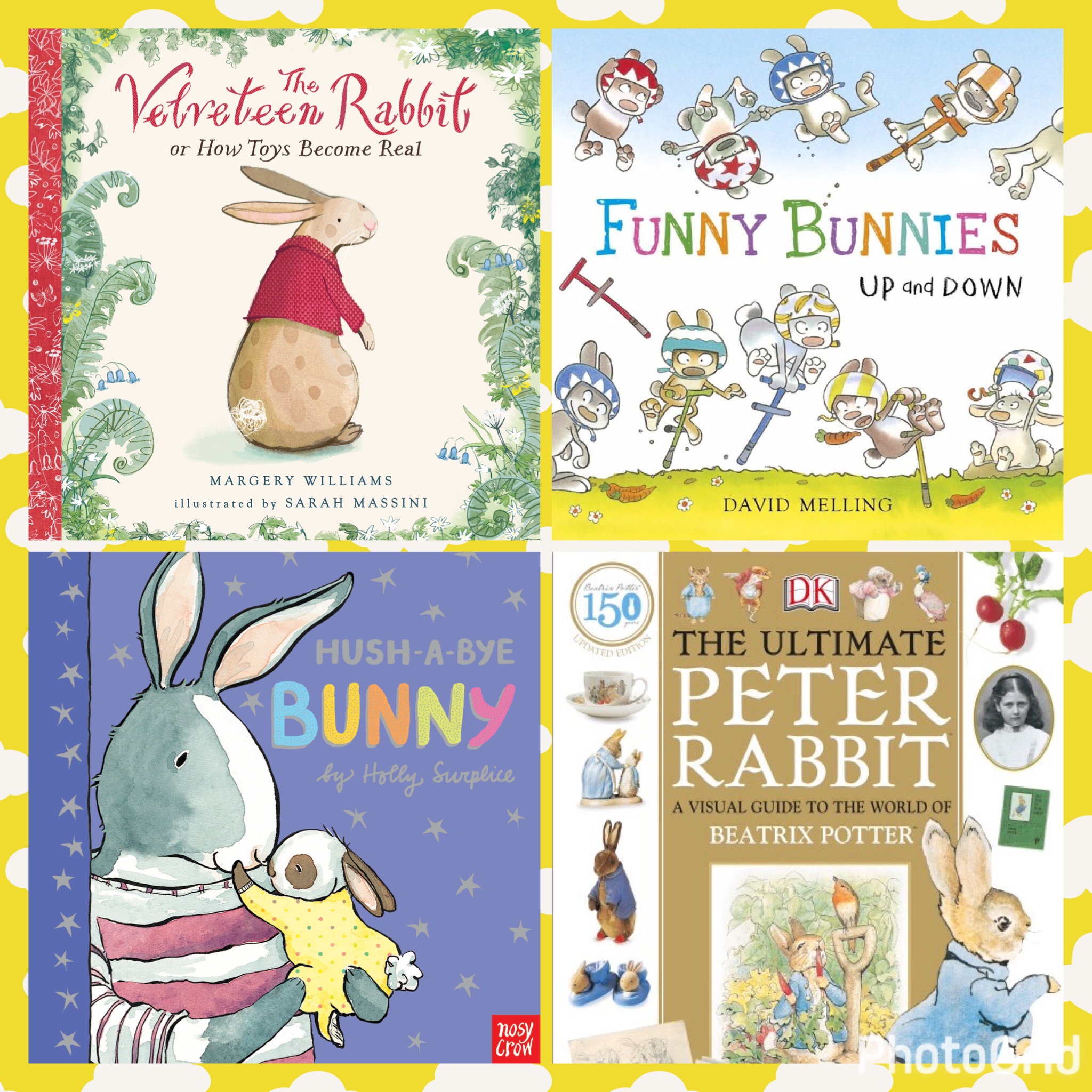
Celebrate Easter with these fabulous bunny books. Babies and younger children will love Funny Bunnies Up and Down, a humorous board book of opposites, and Hush-a-Bye Bunny, a tender bedtime story. The Velveteen Rabbit is a classic that has been recently re-published and, with its gorgeous new illustrations, will enchant the next generation of readers. The Ultimate Peter Rabbit is the perfect book for fans of one of the most famous rabbits in children’s literature.
Pilot Jane and the Runaway Plane Blog Tour & Giveaway, 19 March 2017
You can read my review of this exciting aeroplane adventure here. To be in with a chance of winning a copy of the book, follow my blog before 31 March 2017. The competition is only open to residents of the UK.
More Harry Potter Magic from Studio Press
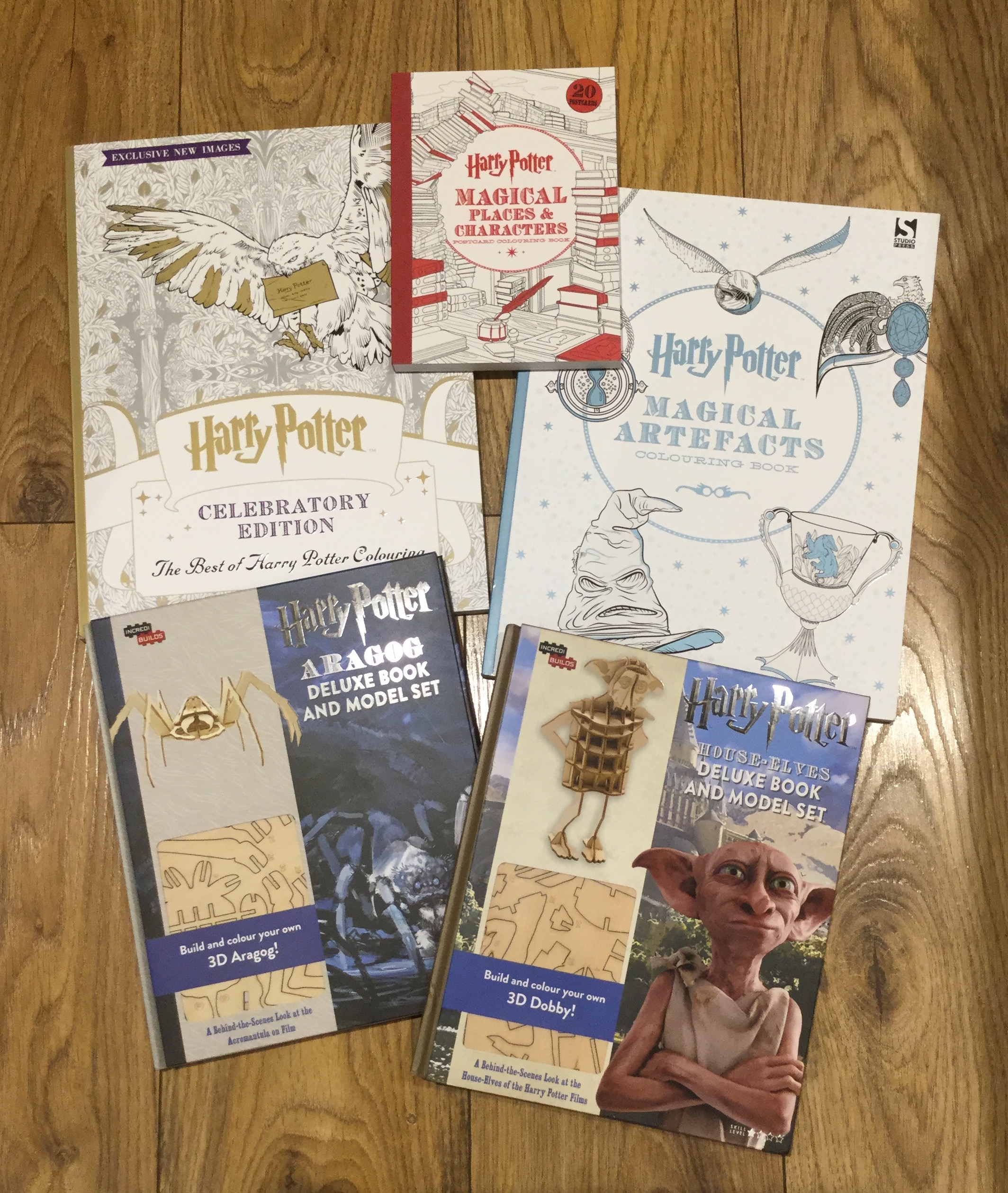
Studio Press, an imprint of Kings Road Publishing and a division of Bonnier Publishing, have teamed up with Warner Bros. to produce these fabulous activity books for Harry Potter fans.
Two of the books are model making sets. No glue or tools are needed: the pre-cut pieces just pop out and then slot together. The instructions (numbered diagrams) are easy to follow and attractively presented. The idea is that you colour and customise the model yourself; the untreated natural wood can be decorated with paints, pencils, pens, beads or sequins – anything you wish! I received the 3D Dobby and the 3D Aragog. There are a further two models in the series. The models are aimed at children aged 8 and upwards and are not suitable for children under 3 years. A full-colour book accompanies each model making set. There are sketches detailing the design process of the character, behind the scenes photos and film production stills. The accompanying text gives lots of insights into the development of the character and the special effects used in the film. There’s also a page at the end of the book with tips on decorating your model.
The other three books are colouring books: The Best of Harry Potter Colouring, a Celebratory Edition; Harry Potter: Magical Artefacts Colouring Book; and Harry Potter: Magical Places and Characters Postcard Colouring Book. The images are very detailed and will keep whoever’s doing the colouring entertained for hours. Pictures include: characters and sets from the films, some of the enchanted objects and magical creations, and the creatures and beasts from Harry’s wizarding world. At the back of the two larger books, there are several glossy, full-colour pages of concept art and film stills. The little book of postcards contains 20 postcards for you to colour and send.
Each of these books would make a magical gift for the Harry Potter fan in your life.
Thank you to Kings Road Publishing for sending me this great selection of books to review.
1 February 2017: my first year of Toppsta giveaways
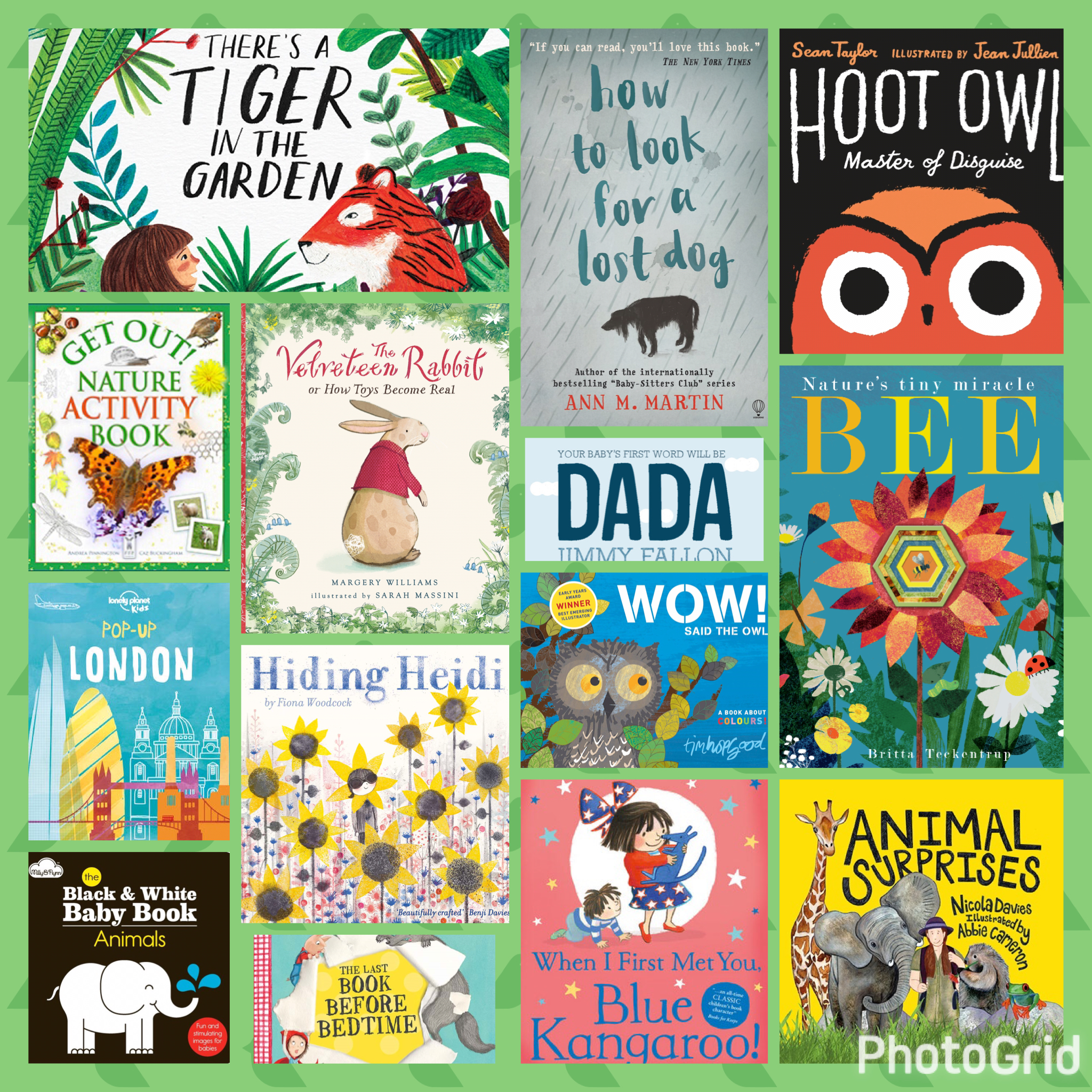
I can’t remember exactly how I found out about Toppsta but I’m glad that I did. Toppsta is a website packed full of children’s book reviews. The reviews are written by parents, teachers and children. You can search for book recommendations according to the age of your child and there’s a wide range of suggestions covering fiction and non-fiction.
However, it’s their giveaways that make Toppsta really special. If you have registered (for free) with the site then you are eligible to enter giveaways to win books. All you have to do in return is post a review online if you win. In the year since I first won a Toppsta giveaway, I have won a total of 14 books. My first was Ann M Martin’s incredibly moving How to Look for a Lost Dog. It is a warm and honest portrayal of life with autism, told from the point of view of 12 year old Rose. I have won two very different books about owls. The owl in Tim Hopwood’s Wow! said the Owl is a curious little bird who stays up during the daytime to see what she’s been missing out on. Sean Taylor and Jean Jullien’s Hoot Owl, by contrast, is a master of disguise and uses the cover of darkness to go out hunting, with hilarious consequences. Four of my books were non-fiction: the fun-packed Get Out! Nature Activity Book by Andrea Pinnington and Caz Buckingham, Andy Mansfield’s impressive Pop-Up London, Nicola Davies and Abbie Cameron’s gorgeous and informative Animal Surprises and the stunning Bee by Britta Teckentrup. I’ve won and reviewed much-loved children’s classics, Margery Williams’s The Velveteen Rabbit, newly illustrated by Sarah Massini, and When I First Met You, Blue Kangaroo by Emma Chichester Clark. I’ve had the pleasure of discovering new author/illustrators too: Lizzy Stewart who wrote and illustrated There’s a Tiger in the Garden and Fiona Woodcock who created the beautiful Hiding Heidi. The Last Book Before Bedtime by Nicola O’Byrne is a clever twist on traditional fairy tales while Jimmy Fallon and Miguel Ordóñez humorously relate how Your Baby’s First Word will be Dada. I kept my own baby amused with the eye-catching Black and White Baby Book – Animals by Laura Seaby.
Thank you to Toppsta and to all of the publishers for a year of fabulous freebies!
My One Year Bloggerversary,
16 January 2017
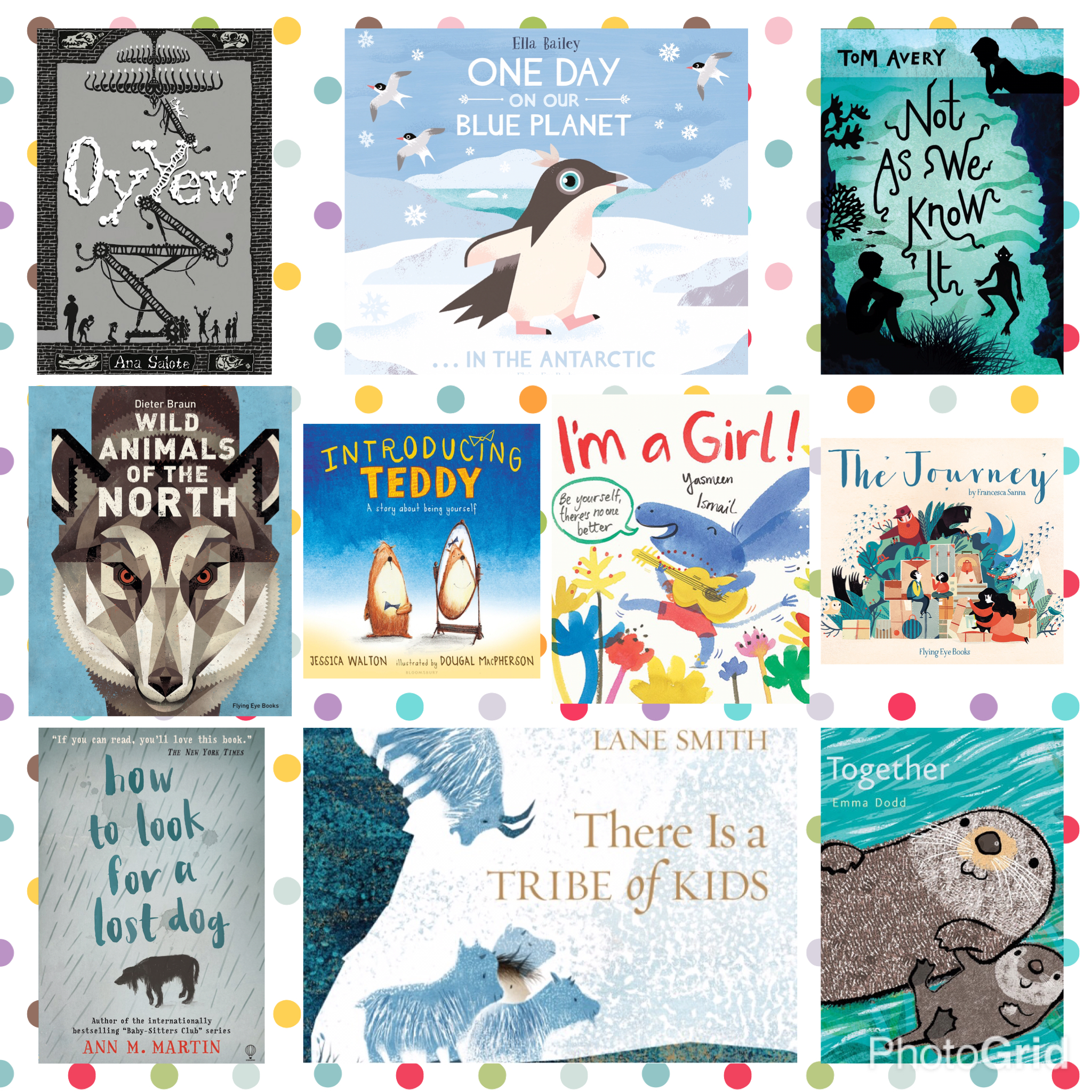
Today marks my first anniversary as a book blogger. Over the course of this year, I have reviewed 80 children’s books: board books, picture books, illustrated books and middle grade books, fiction and non-fiction. I’ve reviewed classics and new titles, books we’ve bought and books we’ve borrowed from the library. I’ve also been really lucky to receive review copies from several publishers – a book post day is always one of great excitement in our house!
I created my blog a week before I gave birth and many of my early posts were written while my son breastfed. Now that Sam is a toddler, I find that I have much less time for blogging but, thankfully, no less time for reading. Sam loves books. He loves to listen to stories and already has his favourites. To my immense joy, he loves to read to himself too. Many a time, he has gone suspiciously quiet and I have crept into the room only to find him reading contentedly to himself – cue very happy mommy moment. Indeed, one of my proudest achievements has been raising a book baby.
I love writing my blog. In amongst the whirl of new motherhood, it has provided some craved-for ‘me time’. It has reignited a passion for writing that had been lying dormant. I have loved discovering new authors and illustrators, and the feeling that I’ve got my finger on the pulse of children’s literature. On our quest for new books, Sam and I have become frequent borrowers at our local libraries; the staff know us and welcome us and we feel at home there.
I don’t blog in isolation either. There’s a whole community of book bloggers who I interact with through their blogs, Twitter and Instagram accounts. It’s a friendly place. Publishers, authors and illustrators are very supportive and accessible too. Thank you to everyone who’s made me feel welcome.
To celebrate this exciting first year, I’ve selected my ten favourite books from those that I’ve reviewed so far. There are books that have moved me and had a huge emotional impact. Not As We Know It by Tom Avery deals sensitively and poignantly with the heartbreak of losing a sibling. Emma Dodd’s Together made me weep tears of love and joy as I shared its heartfelt sentiments with my newborn son. In How to Look for a Lost Dog Ann M Martin gives us an utterly absorbing, warm and honest portrayal of what it’s like to live with autism. For its unadulterated storytelling magic, my favourite book was Oy Yew by Ana Salote. My three favourite picture books stood out because of the power of their message. The Journey by Francesca Sanna is told with sensitivity and compassion and gives a human face to forced migration. Introducing Teddy by Jessica Walton and Dougal MacPherson also nurtures empathy and understanding as it gently explores gender identity. While Yasmeen Ismail’s I’m a Girl! exuberantly challenges preconceived ideas about what is typical behaviour for a girl or a boy. Finally, one of my most exciting discoveries since I began blogging has been the fabulously rich world of children’s non-fiction. Wow! There are some glorious books out there. It’s been very hard to narrow it down to just three. Ella Bailey’s One Day on our Blue Planet in the Antarctic is aimed at a young audience and is packed full of beautiful penguins. Wild Animals of the North is a design-led visual delight from Dieter Braun. Lane Smith’s There is a Tribe of Kids is an exquisitely illustrated masterpiece celebrating the weird and wonderful collective nouns of the animal kingdom.
While still in its infancy, my blog has taken off in ways I could only have dreamt of this time last year and I’m excited about the year ahead. Children have read books because of my recommendations and this makes me happy. My blog has served its purpose: to get kids into books.
Unicorn Day, 12 January 2017
🦄 Special Unicorns of Blossom Wood giveaway, in association with Scholastic 🦄
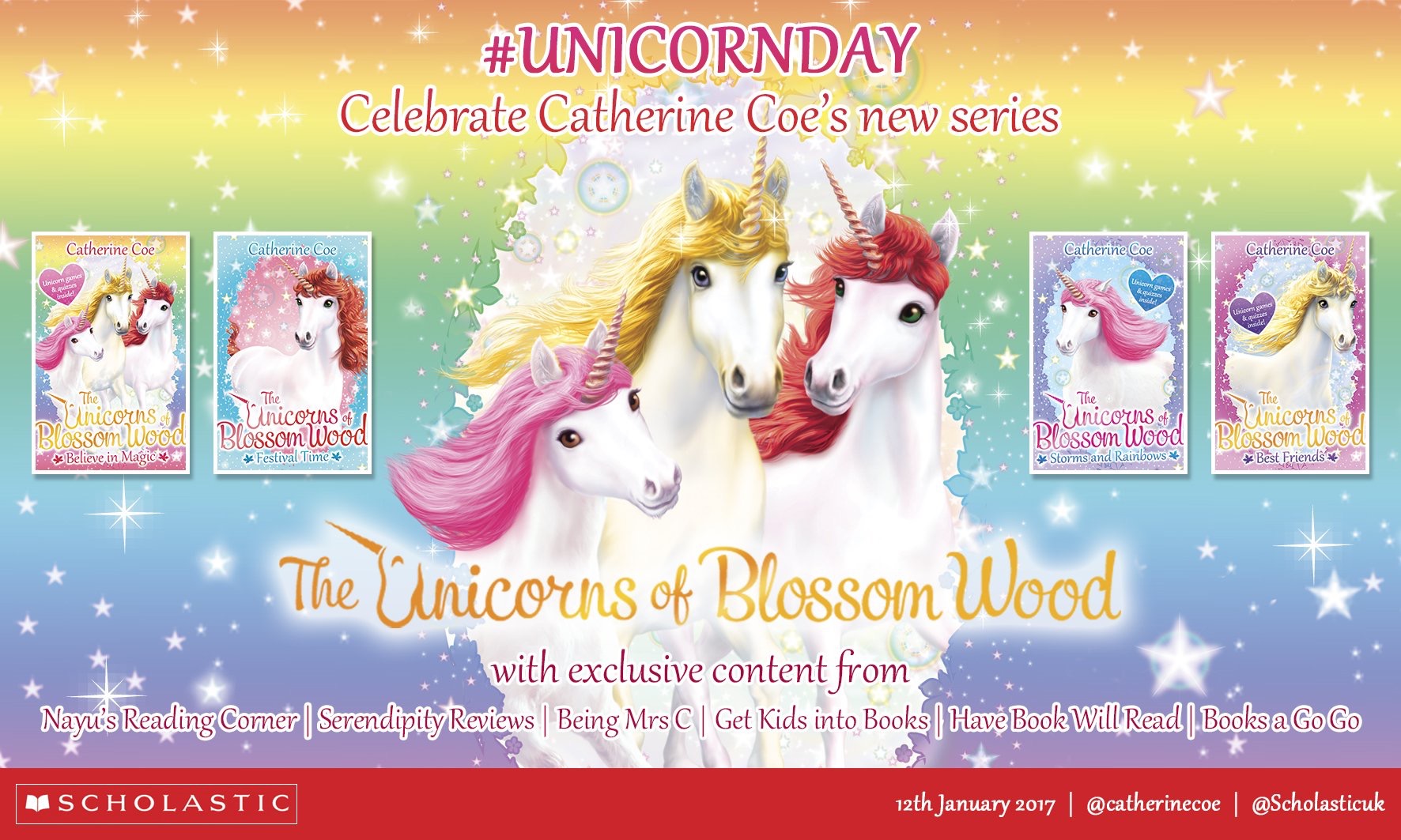
** Just follow my blog by 28/01/17 to be in with a chance of winning all four books in the Unicorns of Blossom Wood series. **
Finding Black Beauty Blog Tour, 13 October 2016
Special Guest Post from Lou Kuenzler
Today I’m thrilled to be able to welcome author Lou Kuenzler to my blog. She is known for her Shrinking Violet, Bella Broomstick and Princess DisGrace books. Her latest story, Finding Black Beauty, was published on 6 October. It’s a re-telling of the classic novel but it is told from the point of view of Joe, the inexperienced groom from the original tale.
Get Kids into Books: Could you tell me about how you approached adapting a classic – your motivation, any challenges and how you’ve made the story appeal to a new, modern audience?
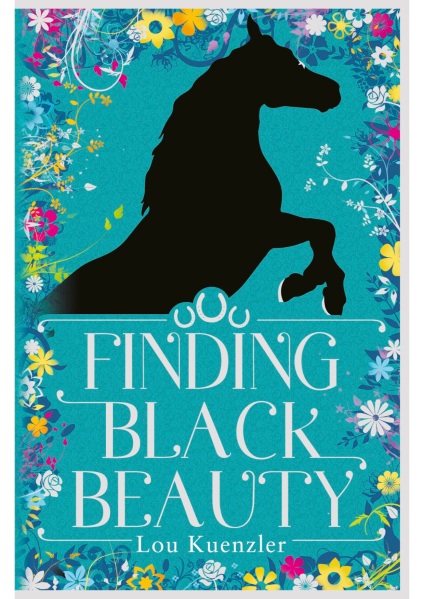 Lou Kuenzler: For my latest children’s book, I took inspiration from Anna Sewell’s classic animal adventure, Black Beauty. At first I was daunted, tiptoeing around the subject a bit, wondering how I could do justice to such an established text when reimagining it for modern readers. I think I was especially awed as Black Beauty was one of my own favourite childhood books.
Lou Kuenzler: For my latest children’s book, I took inspiration from Anna Sewell’s classic animal adventure, Black Beauty. At first I was daunted, tiptoeing around the subject a bit, wondering how I could do justice to such an established text when reimagining it for modern readers. I think I was especially awed as Black Beauty was one of my own favourite childhood books.
In spite of that, I felt strongly that it was worth bringing to a fresh audience in a new way – especially a young readership, in the middle to second half of primary school, who might feel daunted by the some of the old-fashioned language and episodic structure of the original. Anna Sewell was never so much interested in writing a novel as in providing a much-needed platform to shed light on the terrible cruelty to horses suffered during the Victorian period. It can make for a very harsh read! In spite of this, she offers a glimpse of many intriguing characters – not least the eponymous and wonderful black horse, of course – but people too.
My interest was immediately drawn to Joe, the stable lad. I wondered what life would be like for a young outdoor servant in 1877. I knew he would live and sleep amongst the horses, making his bed in the hay loft and getting up at dawn to tend to their needs. This, I felt, was something contemporary readers would be interested in. I knew my own children had loved studying the Victorians at primary school, dressing up in period costume and going on trips to authentic museums which showed all elements of nineteenth century life.
Anna Sewell only mentions Joe twice, in no more than two or three short paragraphs. Yet his role is an important one: very nearly killing Beauty due to inexperience in the early chapters and instantly recognising the once magnificent horse when he spots him, worn out and broken through ill-use, at the end of the book. It seemed to me that young Joe framed the story. That was my starting point.
I wanted to know why the poor lad made his terrible mistake, cooling Beauty down too quickly when he was hot, and nearly costing the horse his life. Surely someone who had worked in a stable, even for a short time, would know not to deal with an overheated horse in this way? That is when my story really took off. What if Joe was actually a girl? I wondered. What if young if Joseph was really Josephine in disguise?
Once I had made the decision to go with this change, my story came to life. As a girl, Josephine would never have had the chance to work with horses before. Girl servants were limited to the house, or the dairy if outside. But I decided my Josephine was not a servant at all – she was the orphaned daughter of a squire – now forced to make her own way in the world. In this way, she would know how to ride a horse but would have been far too sheltered and privileged to learn how to look after one for herself. Her own servants would always have done this …
Josephine’s drive in Finding Black Beauty is not only about keeping track of her beloved horse but also reevaluating the positions of class and gender which have shaped her life as a young Victorian girl. I hope that this central journey – physical and emotional – which lies at the heart of my adventure story, will grab young readers and draw them in to my reimagining of Anna Sewell’s wonderful, heart-wrenching classic. It was so much fun to write as everything is out of kilter for Josephine: she was once spoiled and wealthy but must now learn to serve others in order to survive; she once had family and friends but is now alone in the world; and she must now dress up and pretend to be a boy!
I hope also that those who do enjoy my Finding Black Beauty will use it as a gateway to discover Anna Sewell’s original, heart-breaking story for themselves.
Fir for Luck Blog Tour, 23 September 2016
Special Guest Post from Barbara Henderson
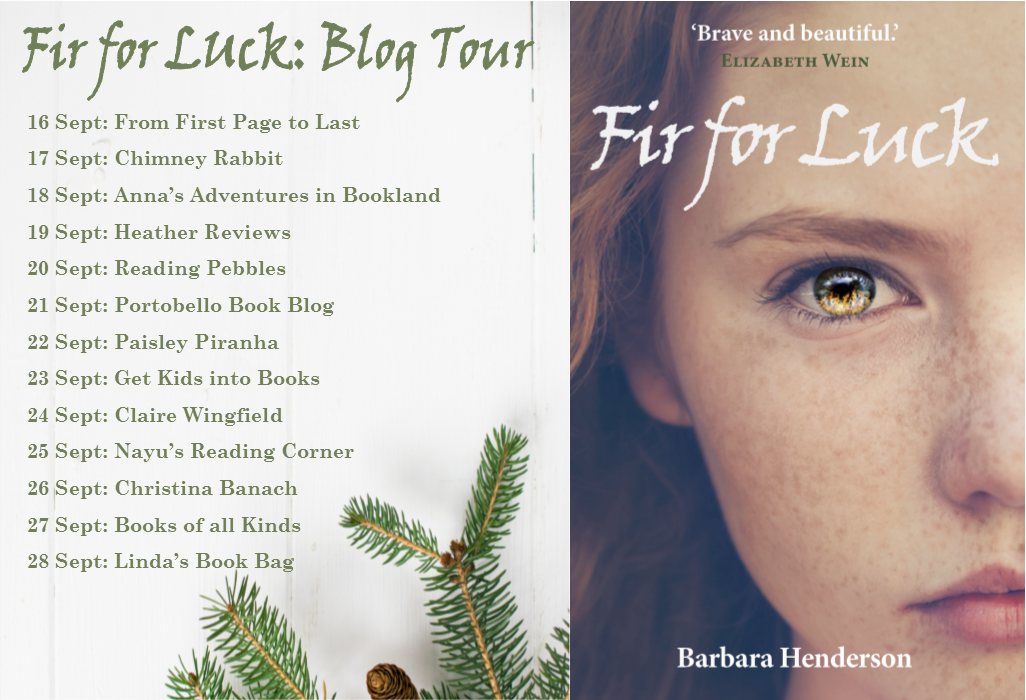
 It’s my stop on the Fir forLuck blog tour today and I’m delighted to welcome Barbara Henderson to my blog. Fir for Luck is set during the Highland Clearances, a particularly brutal period in Scottish history. I asked Barbara to tell me about how she struck the balance between historical accuracy and age-appropriate content in a children’s book.
It’s my stop on the Fir forLuck blog tour today and I’m delighted to welcome Barbara Henderson to my blog. Fir for Luck is set during the Highland Clearances, a particularly brutal period in Scottish history. I asked Barbara to tell me about how she struck the balance between historical accuracy and age-appropriate content in a children’s book.
Barbara: Children’s books should be uplifting, right?
Teenage books can be depressing, but children’s books; they should be squeaky clean and nice and wholesome, shouldn’t they?
Not sure about that.
When I wrote Fir for Luck, a story of the 19th Century Highland Clearances, it became clear pretty quickly – this local rebellion of Ceannabeinne, fictional Janet’s real-life village, did not happen in isolation. A lot of these villagers would have had baggage: trauma carried with them since the horrendous clearances of the Strathnaver Glen. I needed to flag up what the stakes were. Readers, however young, need to know what could happen to Janet and her family before I can expect them to care.
There were compromises, of course: the violence, the ruthlessness, the deaths – most of this is firmly placed in the flash-back strand of the narrative, experienced through Anna, Janet’s grandmother as a young woman. Young readers are less likely to recognise themselves in her than in Janet, so there is a little protective distance there. They know that Janet could be next, that the process could repeat itself with her.
There was a particular bit in Fir for Luck which I agonised over: again it’s in the flashback section, but it involves pretty severe cruelty to an animal, and kids do find that hard to cope with. Nevertheless, it was a historically documented part of the plot, not an episode I invented. I felt that it might be a cop-out to avoid it when it was there for the including. In addition, it is effective in showing the sheer ruthlessness and heartlessness of the back story’s villain, Patrick Sellar, and his henchmen. It is a brief episode, one which stayed with me from my research reading, but I needed to be careful not to dwell on it for too long.
The balance is sometimes hard to find. After all, a book needs to entertain. Doesn’t it? It can teach, as long as that is not too obvious. Of course a good book is like a dating agency, matching the reader up with a character they can relate to and identify with. There needs to be light in a story for children, but it doesn’t mean that you can’t have a bit (or even a lot) of darkness, too, especially when depicting a dark period in history. As best as I could, I tried to balance any suffering or angst with positives: Janet’s friendship with Wee Donald and Catherine, her loyalty to her Granna, the family unit and the village community. The satirical elements, of the haughty Top House Mackays and the arrogant Schoolmaster, add a slightly more light-hearted tone to parts of the novel – which it badly needed in the face of the constant threat.
In general, however, I feel that we do not do children any favours by patronising them. Young people are often more resilient than adults. I am no fan of grit for grit’s sake, but neither do I think that by pretending injustice and suffering do not exist do we give ourselves the best chance of a juster world and less suffering in the future. Young people who feel righteous outrage NOW will be the adults who will press for change in the years to come.
If we as writers can play our part to make that happen, I’ll settle for that very gladly.
Fir for Luck was published yesterday. You can read my review here.
Chloe’s Secret Princess Club Blog Tour, 9 September 2016
Special Guest Post from Emma Barnes
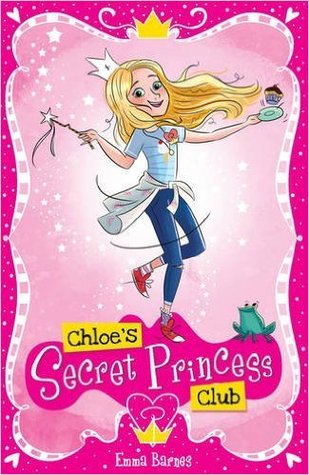
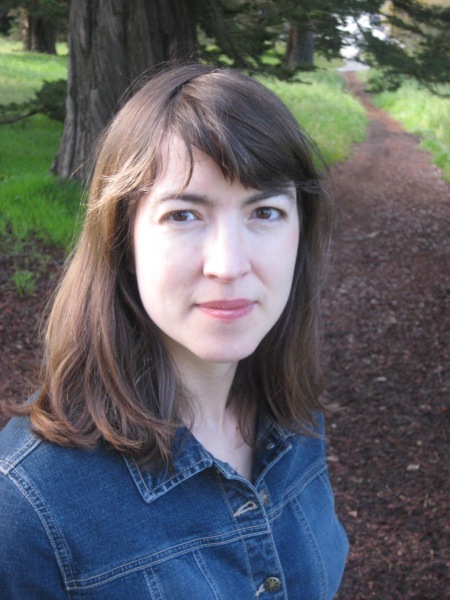
Today is my stop on the Chloe’s Secret Princess Club blog tour and I’m delighted to welcome author Emma Barnes to my blog. She’s centred her new series around Chloe, who dreams of becoming a princess. I asked Emma to tell me more about Chloe.
Top Five Things About Chloe
1) She’s imaginative. It gets her into trouble but it also makes for a lot of fun. When she sees an open door to the classroom cupboard she can’t resist investigating, because she’s convinced that, just like for Lucy in The Lion, the Witch and the Wardrobe, it might be the way to another world…
2) She’s a twin. Arthur, her brother, is very down-to-earth, and often ends up amazed by her adventures.
3) She’s a good friend. She can’t imagine being a princess without her friends becoming princesses too, which means that her best friend Aisha gets dragged in, as does their classmate Eliza, and together they form the Secret Princess Club.
4) She loves animals. Hammy, her pet hamster, often gets involved in her adventures, and she chats to him about her problems.

5) She loves to act – and dress up. When her school does a workshop on the Ancient Egyptians, Chloe is thrilled to be Cleopatra in a wonderful golden dress and black wig.
Chloe’s Secret Princess Club was published in the UK by Scholastic on 1 September 2016.
Unicorn Day, 1 September 2016
Special Guest Post from Catherine Coe
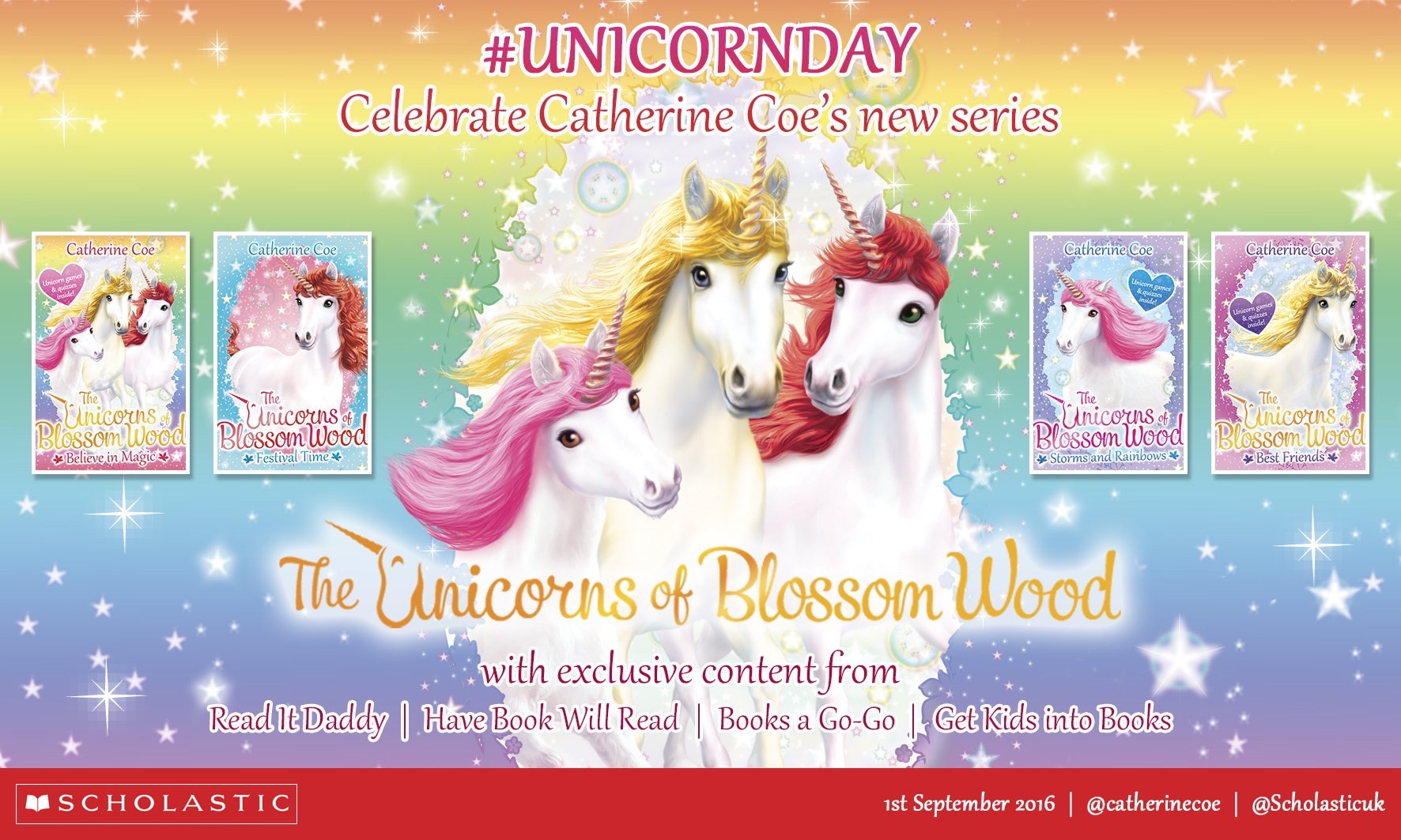
I’m delighted to welcome author Catherine Coe to my blog today. The first two books in her new series, The Unicorns of Blossom Wood, publish today.
Get Kids into Books: You’ve written about girls who become unicorns in your new books. What are your favourite mythical creatures in literature?
Catherine: As a child I loved being taken to fantastical worlds where my imagination could run riot. Actually, I still love this now – which is most definitely one of the reasons I write children’s fantasy books. I remember the magic of being transported to different worlds, with mythical characters, and I use these memories to write books that I think my childhood self would’ve liked to have read.
The mythical creatures I was introduced to as a child by favourite authors such as Roald Dahl, C. S. Lewis and E Nesbit have stayed with me from the very moment I first read about them – they were so vividly written and felt so real, I wanted to believe they really might exist. And that’s I aim to do with my mythical characters, such as the unicorns in the Blossom Wood series. In fact, these characters are girls who turn into unicorns when they visit Blossom Wood – because I thought it would be huge fun for readers to imagine that they could turn into something so wonderfully different and have magical powers. Because everyone wants to believe in magic, right?
My top five favourite mythical creatures in literature:
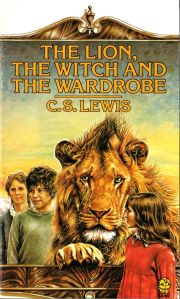 5: Mr Tumnus from The Lion, the Witch and the Wardrobe by C. S. Lewis
5: Mr Tumnus from The Lion, the Witch and the Wardrobe by C. S. Lewis
I fell in love with Mr Tumnus the first moment I met him – even though we find out later that he was deceiving Lucy. It was partly his flaws that drew me to him – that and his bravery at defying the White Witch, and his often unintentionally funny, matter-of-fact dialogue.
4: The Psammead from Five Children and It by C. S. Nesbit
The Psammead is a sand-fairy who grants wishes, but other than that it’s not the usual type of fairy! It’s grouchy and somewhat ‘different’ to look at – with ‘long horns like a snail’s eyes’, ‘ears like a bat’s’ and a ‘tubby body…shaped like a spider’s and covered with thick soft fur’. But the main reason why the Psammead makes this list is Nesbit’s wonderful writing – because even now, many years since last reading the book, I can quite clearly imagine it rustling up from the sand and speaking in its fed-up yet brilliantly observant manner: ‘Does she always talk nonsense, or is it only the rubbish on her head that makes her silly?’
3: BFG from The BFG by Roald Dahl
Who doesn’t love the BFG? Taking Lucy from the orphanage is merely the first in a long line of kind-hearted acts that even his passion for disgusting snozzcumbers can’t out way. I have yet to watch the film – because I’m not sure I want to risk it changing exactly how I remember him from the book.
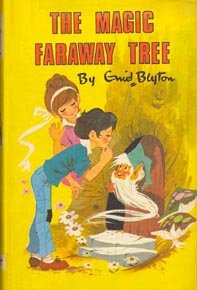 2: The Faraway Tree in The Magic Faraway Tree by Enid Blyton
2: The Faraway Tree in The Magic Faraway Tree by Enid Blyton
OK, so technically a tree isn’t a character, but I had to include it as in my mind it IS a creature – leading as it does to a fantastically different land in every adventure. Of course it’s also the home of many brilliant characters such as Moonface and Saucepan-Man; an integral part of the book that shapes almost every page. The Faraway Tree certainly influenced the books I write – in the Blossom Wood series there’s a tree called the Moon Chestnut, which is believed to be magical because it’s the oldest and tallest tree in the wood.
1: Bilbo Baggins from The Hobbit by J. R. R. Tolkien
Ah, Bilbo Baggins, a lover of home comforts, of food and his pipe, and absolutely no adventures thank you very much. Except that’s exactly what he must do – undertake the greatest of adventures – and that’s when Bilbo’s character starts to really shine in his growing ingenuity and eventual bravery. He’s a hero for the non-heroic – a character who learns and grows in confidence, but who deep down never changes because he’s happy with who he is.
The first two books in Catherine’s new Unicorns of Blossom Wood series, Believe in Magic and Festival Time, publish on 1 September. You can read my reviews here. Catherine also has a brilliant website that accompanies the series.

Dylan the Doctor Blog Tour & Giveaway

 20.8.16 Today is my stop on the Dylan the Doctor blog tour. I really enjoyed this fun playtime adventure. You can read my review here. Dylan the Doctor is the first Dylan story in an exciting new series of picture books for toddlers written by Guy Parker-Rees, author of the wonderful Giraffes Can’t Dance.
20.8.16 Today is my stop on the Dylan the Doctor blog tour. I really enjoyed this fun playtime adventure. You can read my review here. Dylan the Doctor is the first Dylan story in an exciting new series of picture books for toddlers written by Guy Parker-Rees, author of the wonderful Giraffes Can’t Dance.
Competition! Would you like a chance to win a copy of Dylan the Doctor? Follow my blog to be entered into the draw. Deadline: midnight on Saturday 27 August 2016. Giveaway open to residents of the UK and IRL only.
Visit the other stops on the tour for more reviews and giveaways.
The Velveteen Rabbit, the first title in a new series of Nosy Crow classics
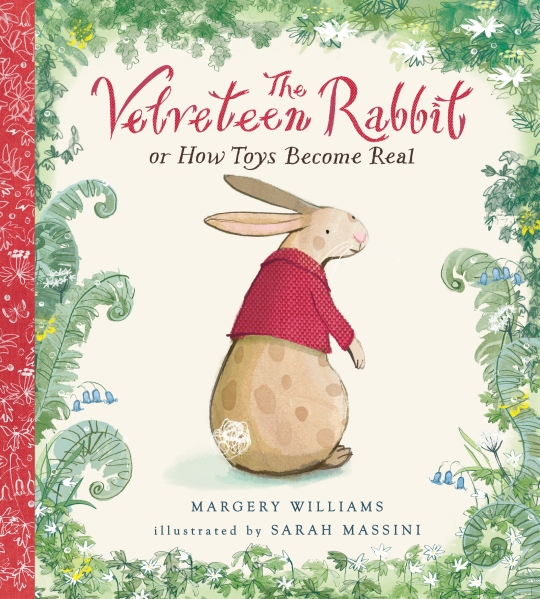
The Velveteen Rabbit was one of my favourite books as a child and so I was delighted when I found out that Nosy Crow were re-publishing it. It means that a whole new generation of children will be able to enjoy its magic. The Velveteen Rabbit will be the first book in Nosy Crow’s new series of classics (Peter Pan is also confirmed) and is published in hardback on 1 September 2016. It will be a glorious edition – printed on munken paper with foiled cloth binding and a foiled dust jacket – making it perfect for a special gift.
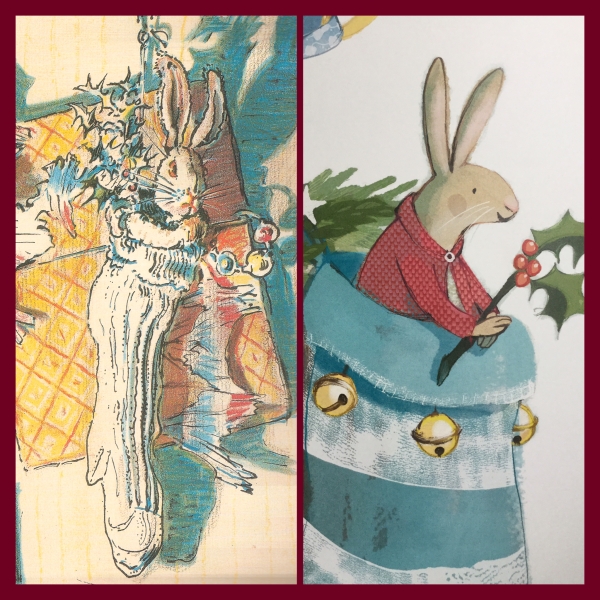
The story, by Margery Williams, is almost 100 years old; it was first published in 1922. Nosy Crow are keeping the original text, with some minor alterations that you can read about here, but the illustrations have been changed. As much as I have a soft spot for the original illustrations by William Nicholson, today they do look rather dated and might not appeal to a modern audience. Illustrator Sarah Massini has had the task of reimagining the Velveteen Rabbit for this new audience and she’s done a wonderful job. There are seven illustrations in the original book and these have all been lovingly recreated for the new edition. As well as updating the illustrations themselves, the way they are used in the book is also now more in keeping with modern children’s books. In the original, the illustrations stood alone on a page or a double page whereas in the Nosy Crow version the illustrations tend to be interwoven with the text.
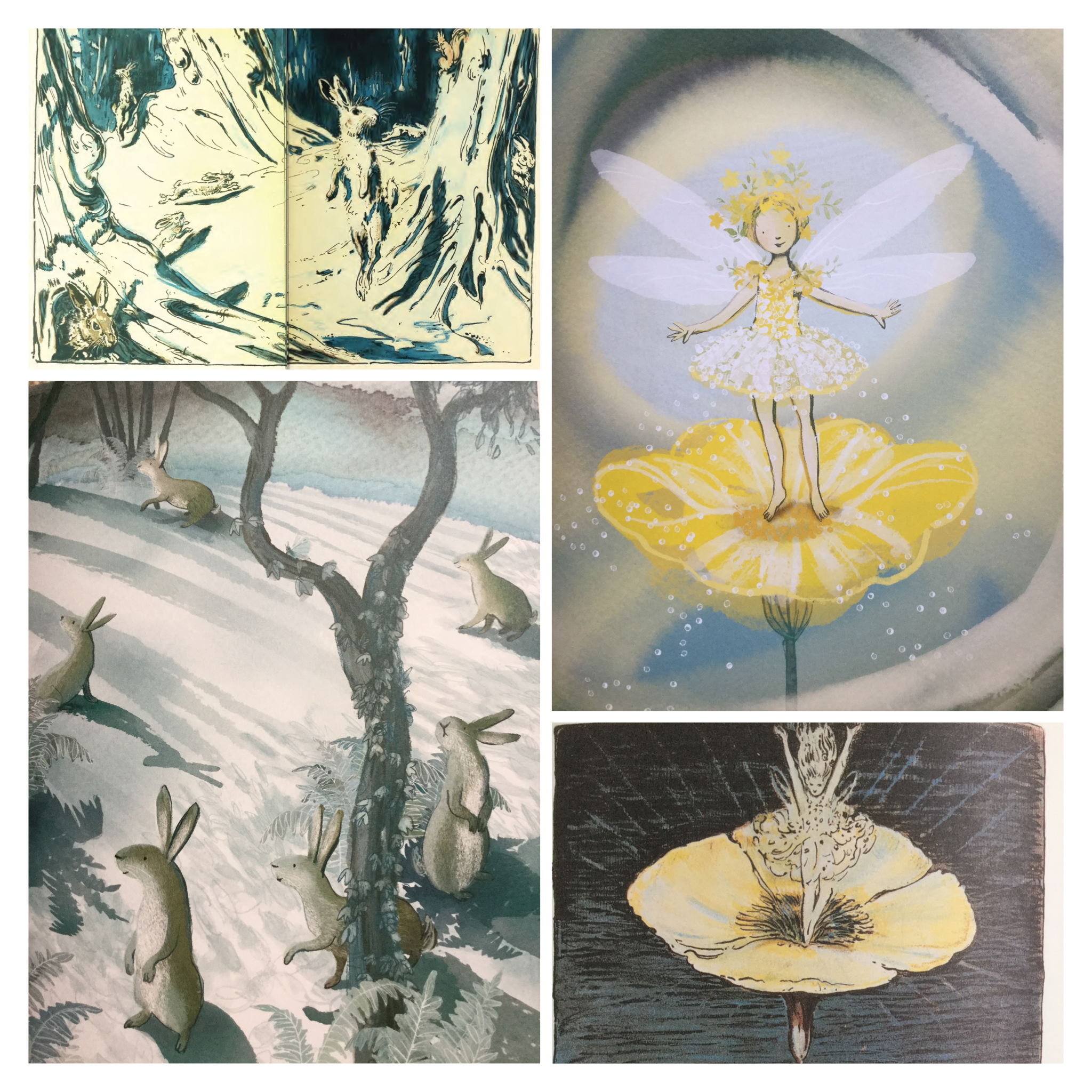
The Velveteen Rabbit is the story of how toys become real. It’s a timeless tale of friendship and love and that special bond between a child and their favourite toy. It is joyful, heartbreaking, wise and magical. The story is one to treasure, as is this beautiful new edition.
Reading with your baby
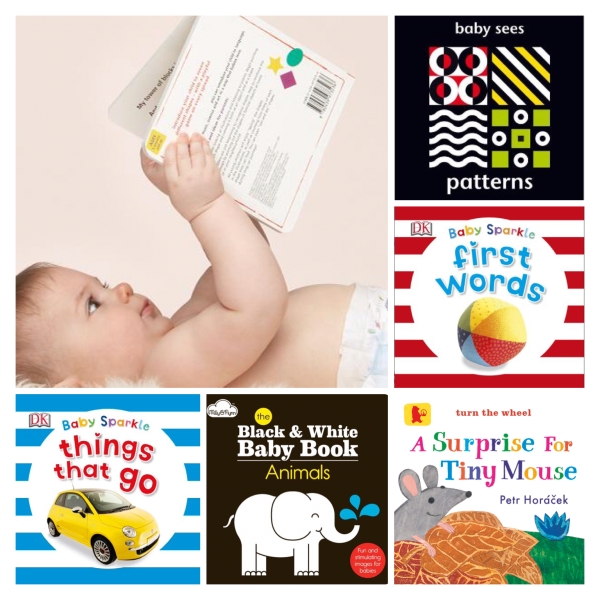
I’m a keen advocate of reading with children from a very young age. We started reading to Sam when he was in the womb and he was a member of the library at the age of six weeks. Sharing books with a baby has so many benefits:
- It’s a wonderful way to bond. Even if your baby is too young to understand the story that you’re reading, by reading with them each day they begin to make positive associations with books: reading is fun, it’s a time for closeness and cuddles. It’s special one-to-one time.
- You are nurturing from an early age what will, hopefully, become a lifelong love of reading.
- Listening to stories and poems helps with language development. Children hear the rhythms and undulations of speech – sounds that they can start to imitate – and thereby begin the process of learning to talk. Re-reading favourite books really helps with vocabulary acquisition. So many baby books are rhyming; hearing and recognising rhymes is very important for early phonics awareness and will be invaluable later when your child begins to read on their own.
- Baby books, particularly those with black and white illustrations or bold patterns, help a baby’s developing eyesight.
- By letting your baby hold the board book and turn the pages, they are honing their fine motor skills.
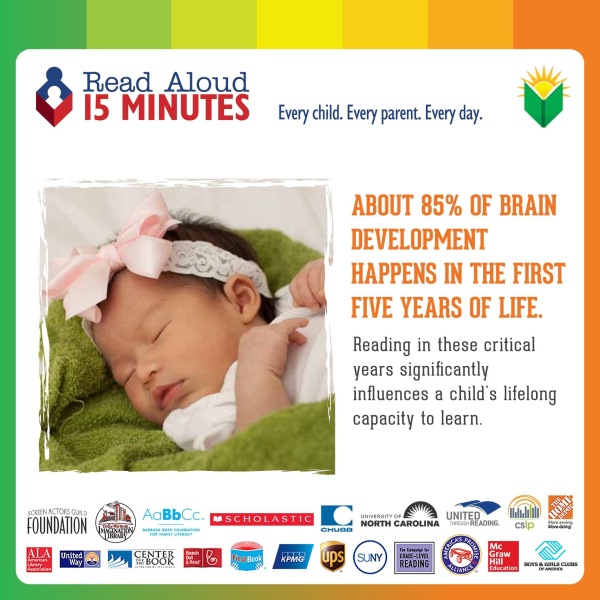
There are lots of brilliant organisations that support early reading:
- BookTrust runs Bookstart which encourages parents to give their children a flying start by reading with them every day, starting from when they’re babies. Their website is packed with resources to help parents choose books and find places locally that run reading activities. There are also loads of story apps and fun games to play. Bookstart offers free books to all children before they start school. The first free book pack is handed out via your health visitor at some point in your baby’s first year. Bookstart supports reading initiatives at your local library too, such as Bear’s Reading Adventure. It also runs the Bookstart bear club.
- Words for Life, an initiative of the National Literacy Trust, has tips for games, songs and stories to share with your baby.
- The Scottish Book Trust runs Bookbug, aimed at parents with babies. There are book recommendations, competitions, ideas for bookish activities and hints and tips about sharing stories and rhymes with your baby. Plus, if you live in Scotland, Bookbug provides free book packs and runs free events for babies and their families to enjoy together.
Read my reviews of some of the baby board books that we’ve enjoyed by clicking on the book covers below.
Caleb Krisp
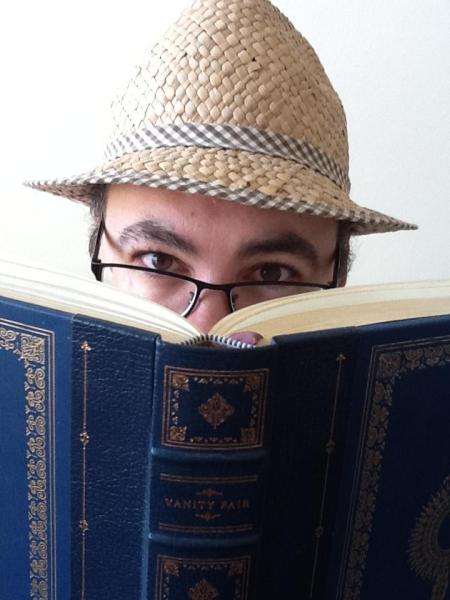
Caleb Krisp is the author of the brilliant Ivy Pocket trilogy. Two books have been published so far, Anyone but Ivy Pocket and Somebody Stop Ivy Pocket. They tell the adventures and misadventures of Ivy, a feisty, fearless and slightly deluded 12-year-old maid. You can read my review of Somebody Stop Ivy Pocket by clicking on the book cover below.
Bloomsbury Kids kindly arranged for me to ask Caleb a few questions. Here are his replies.
Do you get children to read and comment on your story drafts before submitting them to your publisher?
I have a small group of readers that I give the manuscript to before I send it to my publishers – but they are all grown ups. While children give me the most honest reviews, and in the end they are the only readers that matter, I use adults because I often want very detailed feedback.
What is your writing environment like? Do you have props and objects to inspire you?
My writing environment is awful – a room adjacent to my garage with no windows, a very low ceiling and a great deal of rubbish in it, including Christmas decorations and old suitcases. I don’t have any props or objects and that is deliberate because I want to vanish into the story as I write it. If I was surrounded by anything even a tiny bit interesting, I would become horribly distracted!
Why did you choose to set the book in Victorian London?
I grew up reading and loving nineteenth century literature and because of those brilliant books, Victorian London is thrillingly alive in my imagination. I also wanted to place my lead character, Ivy Pocket, in a society where she was forced to work as a maid at twelve years old. Victorian London proved to be a dangerous and exciting place to tell parts of Ivy’s story.
What are your plans once the Ivy Pocket trilogy is finished? What are you working on next?
I’m am working on the final book in in the Ivy Pocket trilogy now and it’s been a great deal of fun bringing Ivy’s story to a conclusion. As for what I’m working on next, I have several ideas swirling around my head but the only thing I know for certain is that my next book will be very different from Ivy Pocket.
Emma Dodd

Emma Dodd is one of my favourite children’s author/illustrators. My son Sam and I are fans of her baby animals series in particular. These gorgeous books are published as baby friendly board books and in hardback and paperback format; the paperback and hardback editions have a lovely foil finish. This heartfelt series is all about the unconditional love between a parent and their child, and each book explores a different aspect of this incredible bond. The series conveys the sentiments of parenthood perfectly. The stories are incredibly poignant and moving. Since I’ve had my son, I find they bring a tear to my eye when I read them. From a child’s point of view, Emma tells super stories that are both comforting and reassuring.
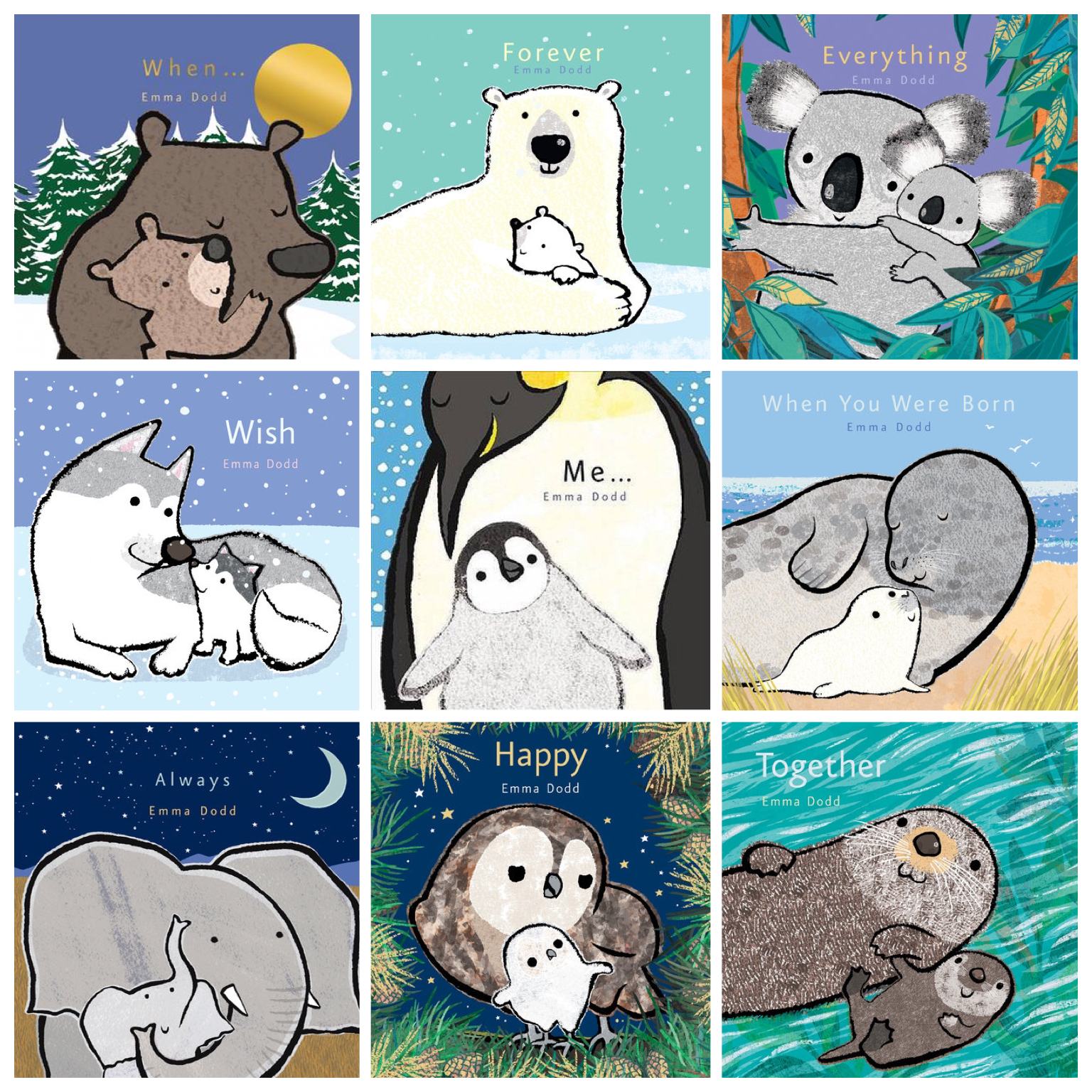
Find out more about Emma by visiting her website here.
Read my reviews of some of her books by clicking on the book covers below.
